00018245022023FYFALSE0.6667P3YP3D00018245022023-01-012023-12-310001824502us-gaap:CommonClassAMember2023-01-012023-12-310001824502us-gaap:WarrantMember2023-01-012023-12-3100018245022023-06-30iso4217:USD0001824502us-gaap:CommonClassAMember2024-02-23xbrli:shares0001824502us-gaap:CommonClassBMember2024-02-2300018245022023-12-3100018245022022-12-31iso4217:USDxbrli:shares0001824502us-gaap:CommonClassAMember2023-12-310001824502us-gaap:CommonClassAMember2022-12-310001824502us-gaap:CommonClassBMember2022-12-310001824502us-gaap:CommonClassBMember2023-12-3100018245022022-01-012022-12-3100018245022021-01-012021-12-310001824502us-gaap:CommonClassAMemberus-gaap:CommonStockMember2020-12-310001824502us-gaap:CommonClassBMemberus-gaap:CommonStockMember2020-12-310001824502us-gaap:AdditionalPaidInCapitalMember2020-12-310001824502us-gaap:RetainedEarningsMember2020-12-310001824502us-gaap:AccumulatedOtherComprehensiveIncomeMember2020-12-3100018245022020-12-310001824502us-gaap:CommonClassAMemberus-gaap:CommonStockMember2021-01-012021-12-310001824502us-gaap:CommonClassBMemberus-gaap:CommonStockMember2021-01-012021-12-310001824502us-gaap:AdditionalPaidInCapitalMember2021-01-012021-12-310001824502us-gaap:RetainedEarningsMember2021-01-012021-12-310001824502us-gaap:CommonClassAMemberus-gaap:CommonStockMember2021-12-310001824502us-gaap:CommonClassBMemberus-gaap:CommonStockMember2021-12-310001824502us-gaap:AdditionalPaidInCapitalMember2021-12-310001824502us-gaap:RetainedEarningsMember2021-12-310001824502us-gaap:AccumulatedOtherComprehensiveIncomeMember2021-12-3100018245022021-12-310001824502us-gaap:CommonClassAMemberus-gaap:CommonStockMember2022-01-012022-12-310001824502us-gaap:CommonClassBMemberus-gaap:CommonStockMember2022-01-012022-12-310001824502us-gaap:AdditionalPaidInCapitalMember2022-01-012022-12-310001824502us-gaap:RetainedEarningsMember2022-01-012022-12-310001824502us-gaap:AccumulatedOtherComprehensiveIncomeMember2022-01-012022-12-310001824502us-gaap:CommonClassAMemberus-gaap:CommonStockMember2022-12-310001824502us-gaap:CommonClassBMemberus-gaap:CommonStockMember2022-12-310001824502us-gaap:AdditionalPaidInCapitalMember2022-12-310001824502us-gaap:RetainedEarningsMember2022-12-310001824502us-gaap:AccumulatedOtherComprehensiveIncomeMember2022-12-310001824502us-gaap:CommonClassAMemberus-gaap:CommonStockMember2023-01-012023-12-310001824502us-gaap:CommonClassBMemberus-gaap:CommonStockMember2023-01-012023-12-310001824502us-gaap:AdditionalPaidInCapitalMember2023-01-012023-12-310001824502us-gaap:RetainedEarningsMember2023-01-012023-12-310001824502us-gaap:AccumulatedOtherComprehensiveIncomeMember2023-01-012023-12-310001824502us-gaap:CommonClassAMemberus-gaap:CommonStockMember2023-12-310001824502us-gaap:CommonClassBMemberus-gaap:CommonStockMember2023-12-310001824502us-gaap:AdditionalPaidInCapitalMember2023-12-310001824502us-gaap:RetainedEarningsMember2023-12-310001824502us-gaap:AccumulatedOtherComprehensiveIncomeMember2023-12-31achr:lineOfBusiness0001824502us-gaap:MoneyMarketFundsMember2023-12-310001824502us-gaap:FairValueInputsLevel1Memberus-gaap:MoneyMarketFundsMemberus-gaap:FairValueMeasurementsRecurringMember2023-12-310001824502us-gaap:MoneyMarketFundsMember2022-12-310001824502us-gaap:FairValueInputsLevel1Memberus-gaap:MoneyMarketFundsMemberus-gaap:FairValueMeasurementsRecurringMember2022-12-310001824502us-gaap:FairValueInputsLevel2Memberus-gaap:MoneyMarketFundsMemberus-gaap:FairValueMeasurementsRecurringMember2023-12-310001824502us-gaap:MoneyMarketFundsMemberus-gaap:FairValueMeasurementsRecurringMemberus-gaap:FairValueInputsLevel3Member2023-12-310001824502us-gaap:MoneyMarketFundsMemberus-gaap:FairValueMeasurementsRecurringMember2023-12-310001824502us-gaap:FairValueInputsLevel1Memberachr:PublicWarrantsMemberus-gaap:FairValueMeasurementsRecurringMember2023-12-310001824502us-gaap:FairValueInputsLevel2Memberachr:PublicWarrantsMemberus-gaap:FairValueMeasurementsRecurringMember2023-12-310001824502achr:PublicWarrantsMemberus-gaap:FairValueMeasurementsRecurringMemberus-gaap:FairValueInputsLevel3Member2023-12-310001824502achr:PublicWarrantsMemberus-gaap:FairValueMeasurementsRecurringMember2023-12-310001824502us-gaap:FairValueInputsLevel1Memberachr:PrivatePlacementWarrantsMemberus-gaap:FairValueMeasurementsRecurringMember2023-12-310001824502us-gaap:FairValueInputsLevel2Memberachr:PrivatePlacementWarrantsMemberus-gaap:FairValueMeasurementsRecurringMember2023-12-310001824502achr:PrivatePlacementWarrantsMemberus-gaap:FairValueMeasurementsRecurringMemberus-gaap:FairValueInputsLevel3Member2023-12-310001824502achr:PrivatePlacementWarrantsMemberus-gaap:FairValueMeasurementsRecurringMember2023-12-310001824502us-gaap:FairValueInputsLevel1Memberus-gaap:FairValueMeasurementsRecurringMember2023-12-310001824502us-gaap:FairValueInputsLevel2Memberus-gaap:FairValueMeasurementsRecurringMember2023-12-310001824502us-gaap:FairValueMeasurementsRecurringMemberus-gaap:FairValueInputsLevel3Member2023-12-310001824502us-gaap:FairValueMeasurementsRecurringMember2023-12-310001824502us-gaap:FairValueInputsLevel2Memberus-gaap:MoneyMarketFundsMemberus-gaap:FairValueMeasurementsRecurringMember2022-12-310001824502us-gaap:MoneyMarketFundsMemberus-gaap:FairValueMeasurementsRecurringMemberus-gaap:FairValueInputsLevel3Member2022-12-310001824502us-gaap:MoneyMarketFundsMemberus-gaap:FairValueMeasurementsRecurringMember2022-12-310001824502us-gaap:FairValueInputsLevel1Memberus-gaap:USTreasurySecuritiesMemberus-gaap:FairValueMeasurementsRecurringMember2022-12-310001824502us-gaap:FairValueInputsLevel2Memberus-gaap:USTreasurySecuritiesMemberus-gaap:FairValueMeasurementsRecurringMember2022-12-310001824502us-gaap:USTreasurySecuritiesMemberus-gaap:FairValueMeasurementsRecurringMemberus-gaap:FairValueInputsLevel3Member2022-12-310001824502us-gaap:USTreasurySecuritiesMemberus-gaap:FairValueMeasurementsRecurringMember2022-12-310001824502us-gaap:FairValueInputsLevel1Memberus-gaap:CorporateDebtSecuritiesMemberus-gaap:FairValueMeasurementsRecurringMember2022-12-310001824502us-gaap:FairValueInputsLevel2Memberus-gaap:CorporateDebtSecuritiesMemberus-gaap:FairValueMeasurementsRecurringMember2022-12-310001824502us-gaap:CorporateDebtSecuritiesMemberus-gaap:FairValueMeasurementsRecurringMemberus-gaap:FairValueInputsLevel3Member2022-12-310001824502us-gaap:CorporateDebtSecuritiesMemberus-gaap:FairValueMeasurementsRecurringMember2022-12-310001824502us-gaap:FairValueInputsLevel1Memberus-gaap:CommercialPaperNotIncludedWithCashAndCashEquivalentsMemberus-gaap:FairValueMeasurementsRecurringMember2022-12-310001824502us-gaap:FairValueInputsLevel2Memberus-gaap:CommercialPaperNotIncludedWithCashAndCashEquivalentsMemberus-gaap:FairValueMeasurementsRecurringMember2022-12-310001824502us-gaap:CommercialPaperNotIncludedWithCashAndCashEquivalentsMemberus-gaap:FairValueMeasurementsRecurringMemberus-gaap:FairValueInputsLevel3Member2022-12-310001824502us-gaap:CommercialPaperNotIncludedWithCashAndCashEquivalentsMemberus-gaap:FairValueMeasurementsRecurringMember2022-12-310001824502us-gaap:FairValueInputsLevel1Memberachr:PublicWarrantsMemberus-gaap:FairValueMeasurementsRecurringMember2022-12-310001824502us-gaap:FairValueInputsLevel2Memberachr:PublicWarrantsMemberus-gaap:FairValueMeasurementsRecurringMember2022-12-310001824502achr:PublicWarrantsMemberus-gaap:FairValueMeasurementsRecurringMemberus-gaap:FairValueInputsLevel3Member2022-12-310001824502achr:PublicWarrantsMemberus-gaap:FairValueMeasurementsRecurringMember2022-12-310001824502us-gaap:FairValueInputsLevel1Memberachr:PrivatePlacementWarrantsMemberus-gaap:FairValueMeasurementsRecurringMember2022-12-310001824502us-gaap:FairValueInputsLevel2Memberachr:PrivatePlacementWarrantsMemberus-gaap:FairValueMeasurementsRecurringMember2022-12-310001824502achr:PrivatePlacementWarrantsMemberus-gaap:FairValueMeasurementsRecurringMemberus-gaap:FairValueInputsLevel3Member2022-12-310001824502achr:PrivatePlacementWarrantsMemberus-gaap:FairValueMeasurementsRecurringMember2022-12-310001824502us-gaap:USTreasurySecuritiesMember2022-12-310001824502us-gaap:CorporateDebtSecuritiesMember2022-12-310001824502us-gaap:CommercialPaperNotIncludedWithCashAndCashEquivalentsMember2022-12-310001824502achr:PublicWarrantsMemberus-gaap:MeasurementInputSharePriceMember2023-12-310001824502achr:PublicWarrantsMemberus-gaap:MeasurementInputSharePriceMember2022-12-310001824502us-gaap:MeasurementInputSharePriceMember2023-12-310001824502us-gaap:MeasurementInputSharePriceMember2022-12-310001824502us-gaap:MeasurementInputExercisePriceMember2023-12-310001824502us-gaap:MeasurementInputExercisePriceMember2022-12-310001824502us-gaap:MeasurementInputExpectedDividendRateMember2023-12-31xbrli:pure0001824502us-gaap:MeasurementInputExpectedDividendRateMember2022-12-310001824502us-gaap:MeasurementInputPriceVolatilityMember2023-12-310001824502us-gaap:MeasurementInputPriceVolatilityMember2022-12-310001824502us-gaap:MeasurementInputRiskFreeInterestRateMember2023-12-310001824502us-gaap:MeasurementInputRiskFreeInterestRateMember2022-12-310001824502achr:PrivatePlacementWarrantsAndAccruedTechnologyAndDisputeResolutionAgreementMemberus-gaap:FairValueInputsLevel3Member2021-12-310001824502achr:PrivatePlacementWarrantsAndAccruedTechnologyAndDisputeResolutionAgreementMemberus-gaap:FairValueInputsLevel3Member2022-01-012022-12-310001824502achr:PrivatePlacementWarrantsAndAccruedTechnologyAndDisputeResolutionAgreementMemberus-gaap:FairValueInputsLevel3Member2022-12-310001824502achr:PrivatePlacementWarrantsAndAccruedTechnologyAndDisputeResolutionAgreementMemberus-gaap:FairValueInputsLevel3Member2023-01-012023-12-310001824502achr:PrivatePlacementWarrantsAndAccruedTechnologyAndDisputeResolutionAgreementMemberus-gaap:FairValueInputsLevel3Member2023-12-310001824502achr:PrivatePlacementWarrantsAndAccruedTechnologyAndDisputeResolutionAgreementMember2023-12-310001824502achr:WarrantSubjectToVestingCriteriaMember2023-12-310001824502us-gaap:GeneralAndAdministrativeExpenseMemberachr:AccruedTechnologyAndDisputeResolutionAgreementMember2023-01-012023-12-310001824502us-gaap:FurnitureAndFixturesMember2023-12-310001824502us-gaap:VehiclesMember2023-12-310001824502us-gaap:ComputerEquipmentMember2023-12-310001824502us-gaap:SoftwareAndSoftwareDevelopmentCostsMember2023-12-310001824502achr:WebsiteDesignMember2023-12-310001824502achr:UnitedAirlinesIncMember2023-01-012023-12-310001824502achr:UnitedStatesAirForceMember2023-01-012023-12-310001824502achr:UnitedAirlinesIncMember2022-01-012022-12-310001824502achr:UnitedAirlinesIncMember2021-01-012021-12-310001824502us-gaap:EmployeeStockOptionMember2023-01-012023-12-310001824502us-gaap:EmployeeStockOptionMember2022-01-012022-12-310001824502us-gaap:EmployeeStockOptionMember2021-01-012021-12-310001824502us-gaap:RestrictedStockUnitsRSUMember2023-01-012023-12-310001824502us-gaap:RestrictedStockUnitsRSUMember2022-01-012022-12-310001824502us-gaap:RestrictedStockUnitsRSUMember2021-01-012021-12-310001824502us-gaap:WarrantMember2023-01-012023-12-310001824502us-gaap:WarrantMember2022-01-012022-12-310001824502us-gaap:WarrantMember2021-01-012021-12-310001824502us-gaap:EmployeeStockMember2023-01-012023-12-310001824502us-gaap:EmployeeStockMember2022-01-012022-12-310001824502us-gaap:EmployeeStockMember2021-01-012021-12-31achr:segment00018245022021-09-1600018245022021-09-162021-09-160001824502us-gaap:CommonStockMember2021-09-162021-09-160001824502us-gaap:CommonClassAMemberus-gaap:CommonStockMember2021-09-162021-09-160001824502us-gaap:CommonClassBMemberus-gaap:CommonStockMember2021-09-162021-09-160001824502achr:AtlasCrestInvestmentLLCMember2021-09-162021-09-16achr:trading_day0001824502achr:SeriesSeedAndSeriesARedeemableConvertiblePreferredStockMember2021-09-162021-09-160001824502us-gaap:CommonClassBMember2021-09-162021-09-160001824502achr:LegacyArcherMember2021-07-0100018245022021-07-022021-09-1500018245022021-09-150001824502us-gaap:AdditionalPaidInCapitalMember2021-09-162021-09-160001824502achr:A2019EquityIncentivePlanMember2021-09-160001824502achr:A2019EquityIncentivePlanMember2021-09-162021-09-160001824502achr:A2019EquityIncentivePlanMemberus-gaap:RestrictedStockUnitsRSUMember2021-09-162021-09-160001824502achr:PublicWarrantsMember2021-09-160001824502achr:PrivateWarrantsMember2021-09-160001824502us-gaap:CommonClassAMember2021-09-162021-09-160001824502us-gaap:FurnitureAndFixturesMember2022-12-310001824502us-gaap:VehiclesMember2022-12-310001824502us-gaap:ComputerEquipmentMember2022-12-310001824502achr:ComputerSoftwareMember2023-12-310001824502achr:ComputerSoftwareMember2022-12-310001824502achr:WebsiteDesignMember2022-12-310001824502us-gaap:LeaseholdImprovementsMember2023-12-310001824502us-gaap:LeaseholdImprovementsMember2022-12-310001824502us-gaap:ConstructionInProgressMember2023-12-310001824502us-gaap:ConstructionInProgressMember2022-12-310001824502us-gaap:ResearchAndDevelopmentExpenseMember2023-01-012023-12-310001824502us-gaap:ResearchAndDevelopmentExpenseMember2022-01-012022-12-310001824502us-gaap:ResearchAndDevelopmentExpenseMember2021-01-012021-12-310001824502us-gaap:GeneralAndAdministrativeExpenseMember2023-01-012023-12-310001824502us-gaap:GeneralAndAdministrativeExpenseMember2022-01-012022-12-310001824502us-gaap:GeneralAndAdministrativeExpenseMember2021-01-012021-12-310001824502achr:SynovusBankLoansMemberachr:CreditFacilityMember2023-12-310001824502achr:SynovusBankLoansMemberachr:CreditFacilityMember2022-12-310001824502us-gaap:SecuredDebtMemberachr:SVBTermLoansMember2023-12-310001824502us-gaap:SecuredDebtMemberachr:SVBTermLoansMember2022-12-310001824502us-gaap:SecuredDebtMember2023-10-050001824502achr:SynovusBankLoansMemberus-gaap:SecuredDebtMember2023-11-14achr:interest0001824502achr:SynovusBankLoansMemberus-gaap:SecuredDebtMembersrt:ScenarioForecastMember2026-11-14achr:installment0001824502us-gaap:SecuredDebtMemberachr:SecuredOvernightFinancingRateSOFRMember2023-10-052023-10-050001824502achr:SynovusBankLoansMemberus-gaap:SecuredDebtMember2023-10-052023-10-050001824502achr:SynovusBankLoansMemberachr:CreditFacilityMember2023-01-012023-12-310001824502achr:SynovusBankLoansMemberachr:CreditFacilityMembersrt:MinimumMember2023-12-310001824502achr:SynovusBankLoansMemberachr:CreditFacilityMembersrt:MaximumMember2023-12-310001824502us-gaap:SecuredDebtMemberachr:SVBTermLoansMember2021-07-090001824502us-gaap:SecuredDebtMemberachr:SVBTermLoansMember2022-01-010001824502us-gaap:SecuredDebtMemberachr:SVBTermLoansMember2023-01-012023-12-310001824502us-gaap:SecuredDebtMemberachr:SVBTermLoansMember2021-12-310001824502us-gaap:SecuredDebtMemberachr:SVBTermLoansMember2022-01-012022-12-310001824502us-gaap:SecuredDebtMemberachr:SVBTermLoansMember2021-01-012021-12-310001824502achr:SiliconValleyBankSVBMemberachr:WarrantsForConsiderationOfTermLoanMember2021-07-092021-07-090001824502achr:SVBInnovationCreditFundVIIILPSVBInnovationMemberachr:WarrantsForConsiderationOfTermLoanMember2021-07-092021-07-090001824502achr:WarrantsForConsiderationOfTermLoanMember2021-07-092021-07-090001824502achr:WarrantsForConsiderationOfTermLoanMember2021-07-090001824502us-gaap:LineOfCreditMemberus-gaap:StandbyLettersOfCreditMember2023-02-280001824502us-gaap:LineOfCreditMemberus-gaap:StandbyLettersOfCreditMember2023-12-310001824502achr:FirstBoeingInvestmentMemberus-gaap:CommonClassAMemberus-gaap:PrivatePlacementMember2023-08-100001824502us-gaap:PrivatePlacementMember2023-08-100001824502achr:InitialVestedShareTrancheMemberus-gaap:PrivatePlacementMember2023-08-100001824502achr:SecondTrancheMemberus-gaap:PrivatePlacementMember2023-08-100001824502achr:InitialVestedShareTrancheMemberus-gaap:PrivatePlacementMember2023-01-012023-12-310001824502us-gaap:PrivatePlacementMemberachr:WarrantSubjectToVestingCriteriaMember2023-01-012023-12-31achr:vote0001824502us-gaap:CommonClassBMember2023-01-012023-12-310001824502us-gaap:PrivatePlacementMember2023-08-102023-08-100001824502achr:AtTheMarketOfferingsMember2023-11-012023-11-300001824502srt:MaximumMemberachr:AtTheMarketOfferingsMember2023-11-012023-11-300001824502achr:AtTheMarketOfferingsMemberus-gaap:CommonClassAMemberus-gaap:CommonStockMember2023-01-012023-12-310001824502achr:AtTheMarketOfferingsMember2023-01-012023-12-310001824502achr:A2021EquityIncentivePlanMemberus-gaap:CommonClassAMember2022-04-300001824502achr:A2021EquityIncentivePlanMemberus-gaap:CommonClassAMember2022-06-012022-06-300001824502achr:A2021EquityIncentivePlanMemberus-gaap:CommonClassAMember2023-01-010001824502us-gaap:EmployeeStockMember2021-08-012021-08-310001824502us-gaap:CommonClassAMemberachr:A2021EmployeeStockPurchasePlanMember2023-01-012023-01-010001824502us-gaap:CommonClassAMemberachr:A2021EmployeeStockPurchasePlanMember2023-12-310001824502achr:A2021EmployeeStockPurchasePlanMember2023-05-312023-05-310001824502achr:A2021EmployeeStockPurchasePlanMember2023-05-310001824502achr:A2021EmployeeStockPurchasePlanMember2023-11-302023-11-300001824502achr:A2021EmployeeStockPurchasePlanMember2023-11-300001824502us-gaap:EmployeeStockMember2023-12-010001824502us-gaap:EmployeeStockMember2023-12-012023-12-010001824502us-gaap:EmployeeStockMember2023-01-012023-12-310001824502us-gaap:EmployeeStockMember2022-01-012022-12-310001824502us-gaap:EmployeeStockMember2023-12-310001824502achr:AnnualEquityAwardsMember2023-01-012023-12-310001824502achr:AnnualEquityAwardsMember2022-01-012022-12-310001824502achr:AnnualEquityAwardsMember2021-01-012021-12-310001824502us-gaap:ShareBasedPaymentArrangementEmployeeMember2022-12-310001824502us-gaap:ShareBasedPaymentArrangementEmployeeMember2022-01-012022-12-310001824502us-gaap:ShareBasedPaymentArrangementEmployeeMember2023-01-012023-12-310001824502us-gaap:ShareBasedPaymentArrangementEmployeeMember2023-12-310001824502achr:A2019StockPlanMember2021-01-012021-12-310001824502us-gaap:EmployeeStockOptionMember2021-01-012021-12-310001824502achr:NonEmployeeStockOptionMember2021-01-012021-12-310001824502us-gaap:EmployeeStockOptionMember2023-01-012023-12-310001824502us-gaap:EmployeeStockOptionMember2022-01-012022-12-310001824502us-gaap:EmployeeStockOptionMember2023-12-310001824502us-gaap:RestrictedStockUnitsRSUMember2022-12-310001824502us-gaap:RestrictedStockUnitsRSUMember2023-01-012023-12-310001824502us-gaap:RestrictedStockUnitsRSUMember2023-12-310001824502achr:AmendedAndRestated2021PlanMemberus-gaap:RestrictedStockUnitsRSUMemberachr:QuarterlyEquityAwardsMember2023-01-012023-12-310001824502achr:AmendedAndRestated2021PlanMemberachr:QuarterlyEquityAwardsMember2023-01-012023-12-310001824502achr:A2021EquityIncentivePlanMemberus-gaap:RestrictedStockUnitsRSUMember2023-01-012023-12-310001824502achr:AmendedAndRestated2021PlanMembersrt:MinimumMemberus-gaap:RestrictedStockUnitsRSUMember2023-01-012023-12-310001824502achr:AmendedAndRestated2021PlanMembersrt:MaximumMemberus-gaap:RestrictedStockUnitsRSUMember2023-01-012023-12-310001824502achr:AmendedAndRestated2021PlanMemberus-gaap:ShareBasedCompensationAwardTrancheOneMember2023-01-012023-12-310001824502achr:AmendedAndRestated2021PlanMember2023-01-012023-12-310001824502us-gaap:RestrictedStockUnitsRSUMember2021-09-162021-09-160001824502us-gaap:RestrictedStockUnitsRSUMember2021-09-16achr:tranche0001824502us-gaap:CommonClassBMemberus-gaap:RestrictedStockUnitsRSUMember2021-09-152021-09-150001824502us-gaap:CommonClassBMemberus-gaap:RestrictedStockUnitsRSUMember2022-04-142022-04-140001824502us-gaap:CommonClassBMemberus-gaap:RestrictedStockUnitsRSUMember2022-04-130001824502us-gaap:CommonClassBMemberus-gaap:RestrictedStockUnitsRSUMember2022-04-132022-04-130001824502us-gaap:CommonClassBMemberus-gaap:RestrictedStockUnitsRSUMember2023-07-132023-07-130001824502us-gaap:CommonClassBMemberus-gaap:RestrictedStockUnitsRSUMember2023-07-130001824502us-gaap:CommonClassBMemberus-gaap:RestrictedStockUnitsRSUMember2023-12-310001824502us-gaap:GeneralAndAdministrativeExpenseMemberus-gaap:RestrictedStockUnitsRSUMember2023-01-012023-12-310001824502us-gaap:GeneralAndAdministrativeExpenseMemberus-gaap:RestrictedStockUnitsRSUMember2022-01-012022-12-310001824502us-gaap:GeneralAndAdministrativeExpenseMemberus-gaap:RestrictedStockUnitsRSUMember2021-01-012021-12-310001824502us-gaap:GeneralAndAdministrativeExpenseMemberachr:ReversedInJuly2023Memberus-gaap:RestrictedStockUnitsRSUMember2023-01-012023-12-310001824502us-gaap:GeneralAndAdministrativeExpenseMemberachr:ReversedInJuly2023Memberus-gaap:RestrictedStockUnitsRSUMember2022-01-012022-12-310001824502us-gaap:GeneralAndAdministrativeExpenseMemberachr:ReversedInJuly2023Memberus-gaap:RestrictedStockUnitsRSUMember2021-01-012021-12-310001824502us-gaap:RestrictedStockUnitsRSUMember2022-01-012022-12-310001824502us-gaap:RestrictedStockUnitsRSUMember2021-01-012021-12-310001824502us-gaap:CommonClassAMemberus-gaap:CommonStockMember2023-08-012023-08-310001824502achr:VendorMember2023-08-310001824502us-gaap:WarrantMember2022-12-310001824502us-gaap:WarrantMember2022-01-012022-12-310001824502us-gaap:WarrantMember2023-01-012023-12-310001824502us-gaap:WarrantMember2023-12-3100018245022021-01-29achr:aircraft0001824502achr:WarrantAgreementMemberachr:UnitedAirlinesIncMember2021-01-292021-01-290001824502us-gaap:CommonClassAMemberachr:WarrantAgreementMemberachr:UnitedAirlinesIncMember2021-01-290001824502achr:WarrantAgreementMemberachr:UnitedAirlinesIncMember2021-01-290001824502achr:UnitedAirlinesIncMember2022-08-090001824502achr:SubMilestoneOneMemberachr:UnitedAirlinesIncMemberachr:AmendedUnitedWarrantAgreementMember2022-08-092022-08-090001824502achr:SubMilestoneTwoMemberachr:UnitedAirlinesIncMemberachr:AmendedUnitedWarrantAgreementMember2022-08-092022-08-090001824502achr:UnitedAirlinesIncMemberachr:AmendedUnitedWarrantAgreementMemberachr:SubMilestoneThreeMember2022-08-092022-08-090001824502achr:UnitedAirlinesIncMemberachr:AmendedUnitedWarrantAgreementMemberachr:SubMilestoneThreeMember2022-08-090001824502achr:UnitedAirlinesIncMemberachr:SubMilestoneFourMemberachr:AmendedUnitedWarrantAgreementMember2022-08-092022-08-090001824502achr:UnitedAirlinesIncMemberachr:SubMilestoneFourMemberachr:AmendedUnitedWarrantAgreementMember2022-08-09achr:milestone0001824502achr:SubMilestoneOneAndTwoMember2022-08-090001824502achr:SubMilestoneTwoMember2023-01-012023-12-310001824502achr:WarrantAgreementMember2023-01-012023-12-310001824502achr:SubMilestoneOneAndTwoMember2022-01-012022-12-310001824502achr:WarrantAgreementMember2022-01-012022-12-310001824502achr:UnitedMember2023-08-012023-08-310001824502achr:StellantisNVMemberus-gaap:CommonClassAMember2023-01-032023-01-030001824502achr:StellantisNVMemberus-gaap:CommonClassAMember2023-01-030001824502achr:StellantisNVMember2023-01-030001824502achr:StellantisNVMemberachr:WarrantExercisablePeriodOneMember2023-01-032023-01-030001824502achr:StellantisNVMemberachr:WarrantExercisablePeriodTwoMember2023-01-032023-01-030001824502achr:StellantisNVMemberachr:WarrantExercisablePeriodThreeMember2023-01-032023-01-030001824502achr:WarrantsForCollaborationAgreementMemberachr:StellantisNVMember2023-01-012023-12-310001824502achr:StellantisNVMemberus-gaap:CommonClassAMember2023-06-232023-06-230001824502achr:StellantisNVMemberus-gaap:CommonClassAMember2023-06-230001824502achr:StellantisNVMemberus-gaap:CommonStockMember2023-08-102023-08-100001824502achr:FCAUSLLCMemberachr:WarrantsForCollaborationAgreementMember2020-11-060001824502achr:FCAUSLLCMember2020-11-060001824502achr:FCAUSLLCMemberachr:WarrantsForCollaborationAgreementMember2022-01-012022-12-310001824502achr:FCAUSLLCMemberachr:WarrantsForCollaborationAgreementMember2021-01-012021-12-310001824502achr:FCAUSLLCMemberachr:WarrantsForCollaborationAgreementMember2022-12-310001824502achr:ManufacturingConsultingAgreementMemberachr:FCAItalySpAMember2021-07-190001824502achr:FCAItalySpAMember2021-07-190001824502achr:ManufacturingConsultingAgreementMemberachr:FCAItalySpAMember2021-07-192021-07-190001824502achr:ManufacturingConsultingAgreementMemberus-gaap:ResearchAndDevelopmentExpenseMember2022-01-012022-12-310001824502achr:ManufacturingConsultingAgreementMemberachr:FCAItalySpAMember2021-01-012021-12-310001824502achr:ManufacturingConsultingAgreementMemberachr:FCAItalySpAMember2022-01-012022-12-310001824502us-gaap:DomesticCountryMember2023-12-310001824502us-gaap:DomesticCountryMember2022-12-310001824502us-gaap:StateAndLocalJurisdictionMember2023-12-310001824502us-gaap:StateAndLocalJurisdictionMember2022-12-310001824502us-gaap:DomesticCountryMemberus-gaap:ResearchMember2023-12-310001824502us-gaap:DomesticCountryMemberus-gaap:ResearchMember2022-12-310001824502us-gaap:ResearchMemberus-gaap:StateAndLocalJurisdictionMember2023-12-310001824502us-gaap:ResearchMemberus-gaap:StateAndLocalJurisdictionMember2022-12-310001824502achr:PublicWarrantsMember2023-12-310001824502achr:PublicWarrantsMember2023-01-012023-12-310001824502achr:PublicWarrantsMemberus-gaap:CommonClassAMember2023-12-310001824502achr:PrivatePlacementWarrantsMember2023-12-310001824502achr:PrivatePlacementWarrantsMember2023-01-012023-12-3100018245022023-10-012023-12-31
UNITED STATES
SECURITIES AND EXCHANGE COMMISSION
Washington, D.C. 20549
FORM 10-K
|
|
|
|
|
|
☒ |
ANNUAL REPORT PURSUANT TO SECTION 13 OR 15(d) OF THE SECURITIES EXCHANGE ACT OF 1934 |
For the fiscal year ended December 31, 2023
OR
|
|
|
|
|
|
| ☐ |
TRANSITION REPORT PURSUANT TO SECTION 13 OR 15(d) OF THE SECURITIES EXCHANGE ACT OF 1934 |
Commission file number 001-39668
Archer Aviation Inc.
(Exact name of registrant as specified in its charter)
|
|
|
|
|
|
|
|
|
|
|
|
| Delaware |
|
|
85-2730902 |
| (State or other jurisdiction of incorporation or organization) |
|
|
(I.R.S. Employer Identification No.) |
|
|
|
|
190 West Tasman Drive, San Jose, CA |
|
|
95134 |
| (Address of principal executive offices) |
|
|
(Zip Code) |
(650) 272-3233
Registrant's telephone number, including area code
N/A
(Former name, former address, and former fiscal year, if changed since last report)
Securities registered pursuant to Section 12(b) of the Act:
|
|
|
|
|
|
|
|
|
Title of each class |
Trading Symbol(s) |
Name of each exchange on which registered |
Class A common stock, par value $0.0001 per share |
ACHR |
New York Stock Exchange |
Warrants, each whole warrant exercisable for one share of Class A common stock at an exercise price of $11.50 per share |
ACHR WS |
New York Stock Exchange |
Securities registered pursuant to Section 12(g) of the Act: None
Indicate by check mark if the registrant is a well-known seasoned issuer, as defined in Rule 405 of the Securities Act. Yes ☐ No ☒
Indicate by check mark if the registrant is not required to file reports pursuant to Section 13 or Section 15(d) of the Act. Yes ☐ No ☒
Indicate by check mark whether the registrant: (1) has filed all reports required to be filed by Section 13 or 15(d) of the Securities Exchange Act of 1934 during the preceding 12 months (or for such shorter period that the registrant was required to file such reports); and (2) has been subject to such filing requirements for the past 90 days. Yes ☒ No ☐
Indicate by check mark whether the registrant has submitted electronically every Interactive Data File required to be submitted and posted pursuant to Rule 405 of Regulation S-T (§232.405 of this chapter) during the preceding 12 months (or for such shorter period that the registrant was required to submit and post such files). Yes ☒ No ☐
Indicate by check mark whether the registrant is a large accelerated filer, an accelerated filer, a non-accelerated filer, a smaller reporting company, or an emerging growth company. See the definitions of “large accelerated filer,” “accelerated filer,” “smaller reporting company,” and “emerging growth company” in Rule 12b-2 of the Exchange Act.
|
|
|
|
|
|
|
|
|
|
|
|
| Large accelerated filer |
☒ |
Accelerated filer |
☐ |
| Non-accelerated filer |
☐ |
Smaller reporting company |
☒ |
|
|
Emerging growth company |
☐ |
If an emerging growth company, indicate by check mark if the registrant has elected not to use the extended transition period for complying with any new or revised financial accounting standards provided pursuant to Section 13(a) of the Exchange Act. ☐
Indicate by check mark whether the registrant has filed a report on and attestation to its management’s assessment of the effectiveness of its internal control over financial reporting under Section 404(b) of the Sarbanes-Oxley Act (15 U.S.C. 7262(b)) by the registered public accounting firm that prepared or issued its audit report. ☒
If securities are registered pursuant to Section 12(b) of the Act, indicate by check mark whether the financial statements of the registrant included in the filing reflect the correction of an error to previously issued financial statements. ☐
Indicate by check mark whether any of those error corrections are restatements that required a recovery analysis of incentive-based compensation received by any of the registrant’s executive officers during the relevant recovery period pursuant to § 240.10D-1(b). ☐
Indicate by check mark whether the registrant is a shell company (as defined in Rule 12b-2 of the Exchange Act). Yes ☐ No ☒
The aggregate market value of the voting and non-voting common stock held by non-affiliates of the registrant as of June 30, 2023, the last business date of the registrant’s recently completed second fiscal quarter, was approximately $839.9 million, based on the closing price reported for such date on the New York Stock Exchange.
As of February 23, 2024, the number of shares of the registrant’s Class A common stock outstanding was 272,319,871, and the number of shares of the registrant’s Class B common stock outstanding was 38,254,915.
Documents Incorporated by Reference
Part III of this Form 10-K (the “Annual Report”) incorporates by reference certain information from the Registrant's Definitive Proxy Statement (“Proxy Statement”) relating to the 2024 Annual Meeting of Stockholders or an amendment to this report under cover of Form 10-K/A to be filed within 120 days of the end of its fiscal year ended December 31, 2023.
Archer Aviation Inc.
10-K
For the Fiscal Year Ended December 31, 2023
Table of Contents
SPECIAL NOTE REGARDING FORWARD-LOOKING STATEMENTS
This Annual Report contains forward-looking statements. All statements, other than statements of present or historical fact, included in or incorporated by reference in this Annual Report regarding our future financial performance, as well as our strategy, future operations, financial position, estimated revenues and losses, projected costs, prospects, plans, and objectives of management are forward-looking statements. When used in this Annual Report, the words “anticipate,” “believe,” “continue,” “could,” “estimate,” “expect,” “future,” “intends,” “may,” “might,” “plan,” “possible,” “potential,” “predict,” “project,” “seek,” “should,” “will,” “would,” the negative of such terms and other similar expressions are intended to identify forward-looking statements, although not all forward-looking statements contain such identifying words.
These forward-looking statements are based on information available as of the date of this Annual Report, and current expectations, assumptions, hopes, beliefs, intentions, and strategies regarding future events. Accordingly, forward-looking statements in this Annual Report and in any document incorporated herein by reference should not be relied upon as representing our views as of any subsequent date, and we do not undertake any obligation to update forward-looking statements to reflect events or circumstances after the date they were made, whether as a result of new information, future events or otherwise, except as may be required under applicable securities laws.
As a result of a number of known and unknown risks and uncertainties, our actual results or performance may be materially different from those expressed or implied by these forward-looking statements. Some factors that could cause actual results to differ include those described in Part I, Item 1A, “Risk Factors” in this Annual Report. Readers are urged to carefully review and consider the various disclosures made in this Annual Report and in other documents we file from time to time with the Securities and Exchange Commission (“SEC”) that disclose risks and uncertainties that may affect our business. Moreover, new risks emerge from time to time. It is not possible for us to predict all risks, nor can we assess the impact of all factors on our business or the extent to which any factor, or combination of factors, may cause actual results to differ materially from those contained in any forward-looking statements we may make. In light of these risks and uncertainties, the future events and circumstances discussed in this Annual Report may not occur and actual results could differ materially and adversely from those anticipated or implied in the forward-looking statements.
In addition, statements that “we believe” and similar statements reflect our beliefs and opinions on the relevant subject. These statements are based upon information available to us as of the date of this Annual Report, and while we believe such information forms a reasonable basis for such statements, such information may be limited or incomplete, and our statements should not be read to indicate that we have conducted an exhaustive inquiry into, or review of, all potentially available relevant information. These statements are inherently uncertain, and investors are cautioned not to unduly rely upon these statements.
As used herein, “Archer,” the “Company,” “Registrant,” “we,” “us,” “our,” and similar terms include Archer Aviation Inc. and its subsidiaries, unless the context indicates otherwise.
“Archer” and our other registered and common law trade names and trademarks of ours appearing in this Annual Report are our property. This Annual Report contains additional trade names and trademarks of other companies. We do not intend our use or display of other companies’ trade names or trademarks to imply an endorsement or sponsorship of us by such companies, or any relationship with any of these companies.
RISK FACTOR SUMMARY
Our business is subject to numerous risks and uncertainties, including those described in Part I, Item 1A, “Risk Factors” in this Annual Report. You should carefully consider these risks and uncertainties when investing in our Class A common stock. Some of the principal risks and uncertainties include the following:
•We are an early-stage company with a history of losses, and we expect to incur significant expenses and continuing losses for the foreseeable future.
•We are still developing our eVTOL aircraft, have not yet obtained FAA certification of our eVTOL aircraft under development and we have yet to manufacture or deliver any aircraft to customers, which makes evaluating our business and future prospects difficult and increases the risk of investment.
•Our business plan requires a significant amount of capital. In addition, our future capital needs may require us to issue additional equity or debt securities that may dilute our stockholders or introduce covenants that may restrict our operations or our ability to pay dividends.
•Failure to comply with the covenants in our Credit Agreement could result in our inability to borrow additional funds and adversely impact our business.
•The markets for our offerings are still in development, and if such markets do not materialize, or grow more slowly than we expect or fail to grow as large as we expect, our business, financial condition and results of operations could be harmed.
•The eVTOL aircraft industry may not continue to develop, eVTOL aircraft may not be adopted by the market, eVTOL aircraft may not be certified by government authorities or eVTOL aircraft may not be an attractive alternative to existing modes of transportation, any of which could adversely affect our prospects, business, financial condition and results of operations.
•Our future success depends on the continuing efforts of our key personnel and on our ability to attract and retain highly skilled personnel and senior management.
•We may be unable to manage our future growth effectively, which could make it difficult to execute our business strategy.
•Operation of aircraft involves a degree of inherent risk. We could suffer losses and adverse publicity stemming from any accident involving small aircraft, helicopters or charter flights and in particular from any accident involving eVTOL aircraft.
•We currently rely and will continue to rely on third-party partners to provide and store the parts and components required to manufacture our aircraft, and to supply critical components and systems, which exposes us to a number of risks and uncertainties outside our control.
•We are or may be subject to risks associated with strategic relationships or other opportunities and may not be able to identify adequate strategic relationship opportunities, or form strategic relationships, in the future.
•We are party to certain purchase agreements and other contract orders for our Midnight aircraft and the provision of related services that contain conditions with respect to the purchase of our aircraft or that require us to perform and provide certain deliverables. If the conditions to or performance obligations under such contracts are not met, or if such contracts are otherwise canceled, modified or delayed, our prospects, results of operations, liquidity and cash flow will be harmed.
•Some of the contract orders for our Midnight aircraft are with U.S. government entities, which are subject to unique risks.
•Our business may be adversely affected by the current global political and macroeconomic challenges, including the effects of inflation, rising interest rates or an economic downturn or recession.
•Our aerial ride sharing operations will initially be concentrated in a small number of urban areas, which makes our business particularly susceptible to infrastructure, economic, social, weather, regulatory conditions or other circumstances affecting these metropolitan areas.
•Our long-term success and ability to significantly grow our revenue will depend, in part, on our ability to establish and expand into international markets and/or expand market segments.
•If we experience harm to our reputation and brand, our business, financial condition and results of operations could be adversely affected.
•Our ability to effectively compete and generate revenue from our products and services depends upon our ability to distinguish our products and services from our competitors and their products and services.
•Our business may be adversely affected by labor and union activities.
•We expect that the purchase agreements with Archer Direct customers could be subject to indexed price escalation clauses which would subject us to losses if we have cost overruns or if increases in our costs exceed the applicable escalation rate.
•We have been, and may in the future be, adversely affected by health epidemics and pandemics, the duration and economic, governmental and social impact of which is difficult to predict, which may significantly harm our business, prospects, financial condition and operating results.
•Failure to comply with applicable laws and regulations relating to the aviation business in general and eVTOL aircraft specifically, could adversely affect our business and our financial condition.
•We are subject to cybersecurity risks to our operational systems, security systems, infrastructure, integrated software in our aircraft and customer data processed by us or third-party vendors.
•Failure to comply with laws and regulations relating to privacy, data protection and consumer protection, or the expansion of current laws and regulations or the enactment of new laws or regulations in these areas, could adversely affect our business and our financial condition.
•We currently have a subsidiary located outside of the United States and plan for international operations in the future, which could subject us to political, operational and regulatory challenges.
•We are subject to risks associated with climate change, including the potential increased impacts of severe weather events on our operations and infrastructure.
•We intend to retain certain personal information about our customers, employees or others that, if compromised, could harm our financial performance and results of operations or prospects.
•The requirements of being a public company may strain our resources, divert management’s attention and affect our ability to attract and retain additional executive management and qualified board members.
•We are, and may in the future become, subject to legal proceedings, which may be time-consuming and expensive and, if adversely determined, could delay, limit or prevent our ability to commercialize our aircraft or otherwise execute on our business plans.
•Our business may be adversely affected if we are unable to protect our intellectual property rights from unauthorized use by third parties.
•Our management team has limited experience managing a public company.
•Our amended and restated certificate of incorporation requires, to the fullest extent permitted by law, that derivative actions brought in our name, actions against our directors, officers, other employees or stockholders for breach of fiduciary duty and other similar actions may be brought only in the Court of Chancery in the State of Delaware, which may have the effect of discouraging lawsuits against our directors, officers, other employees or stockholders.
•The warrants originally issued by Atlas are accounted for as liabilities and changes in the value of these warrants could have a material effect on our financial results.
•Changes in financial accounting standards may cause adverse unexpected fluctuations and affect our reported results of operations.
•The price of our Class A common stock and warrants may be volatile, and you could lose all or part of your investment as a result.
•The dual-class structure of our common stock has the effect of concentrating voting power with certain shareholders of our Class B common stock, which could limit other shareholders’ ability to influence the outcome of important transactions, including a change in control.
•Future sales, or the perception of future sales, by us or our stockholders in the public market could cause the market price for our Class A common stock to decline.
Part I
Item 1. Business
Overview
We are designing and developing electric vertical takeoff and landing (“eVTOL”) aircraft for use in urban air mobility (“UAM”) networks. Our mission is to unlock the skies, freeing everyone to reimagine how they move and spend time. Our eVTOL aircraft are designed to be safe, sustainable, and quiet. Our production aircraft, Midnight, which we unveiled in November of 2022, is designed around our proprietary 12-tilt-6 aircraft configuration. This means that it has 12 propellers attached to 6 booms on a fixed wing with all 12 propellers providing vertical lift during take-off and landing and the forward 6 propellers tilting forward to cruise position to provide propulsion during forward flight with the wing providing aerodynamic lift like a conventional airplane.
Midnight is designed to carry 4 passengers plus a pilot optimized for back-to-back short distance trips of around 20-miles, with minimal charging time between trips. We are working to certify Midnight with the Federal Aviation Administration (“FAA”) so that we can then enter into commercial service as soon as possible. In August 2023, we received the Special Airworthiness Certificate from the FAA for our first Midnight aircraft and began its flight testing program in October 2023.
Midnight is the evolution of our demonstrator eVTOL aircraft, Maker, which through its flight test program has helped validate our proprietary 12-tilt-6 aircraft configuration and certain key enabling technologies. The design of Midnight marries what we believe to be cutting-edge electric propulsion technology with state-of-the-art aircraft systems to deliver the key attributes of our eVTOL aircraft:
•Safety. High redundancy and simplified propulsion systems make for a significantly safer aircraft compared to a helicopter. Midnight has no single critical point of failure, meaning that should any single component fail, the aircraft can still safely complete its flight.
•Low noise. With its intended cruising altitude at approximately 2,000 feet, the design of Midnight is such that the noise that reaches the ground is expected to measure around 45 A-weighted decibels, approximately 100 times quieter than that of a helicopter. During forward flight, the aircraft’s tilt propellers spin on axes that are aligned with the oncoming air flow, rather than edge-wise to the flow, as is the case with traditional helicopters - further decreasing noise levels. Since Archer’s aircraft is spinning 12 small propellers rather than one large rotor, it can also spin them at significantly lower tip speeds, resulting in much lower noise levels.
•Sustainable. Midnight is all electric, resulting in zero operating emissions. Archer is committed to sourcing renewable energy wherever possible to power its aircraft. Archer’s design and engineering teams are working to integrate materials into this aircraft that have their own unique sustainability stories.
We continue to work to optimize our eVTOL aircraft design for both manufacturing and certification. The development of an eVTOL aircraft that meets our business requirements demands significant design and development efforts on all facets of the aircraft. We believe that by bringing together a mix of talent with eVTOL, traditional commercial aerospace, as well as electric propulsion backgrounds, we have built a team that enables us to move through the design, development, and certification of our eVTOL aircraft with the FAA in an efficient manner, thus allowing us to achieve our end goal of bringing to market our eVTOL aircraft as efficiently as possible.
Our Planned Lines of Business
Upon receipt of all necessary FAA certifications and any other government approvals necessary for us to manufacture and operate our aircraft, we intend to operate two complementary lines of business: a direct-to-consumer aerial ride share service (“Archer UAM”) and the sale of our aircraft to other operators (“Archer Direct”).
•Archer UAM. We plan to operate our own UAM ecosystem initially in select major cities. Our UAM ecosystem will operate using our eVTOL aircraft, which is currently in development. Consumers will be able to book rides directly through our service through an app-based platform. We project that the cost to manufacture and operate our eVTOL aircraft will be such that it will be able to enter the UAM ride-sharing market at a price point that is competitive with ground-based ride sharing services today. We will continue to evaluate our go-to-market strategy based on, among other things, estimated demand, readiness of the required infrastructure, and our ability to scale our aircraft fleet.
•Archer Direct. We also plan to selectively sell our aircraft to third parties. We have entered into a purchase agreement with United Airlines Inc. (“United”) for the conditional purchase of up to $1.0 billion worth of aircraft, with an option for another $500.0 million worth of aircraft (as amended, the “United Purchase Agreement”). In August 2023, we entered into two new contracts with the U.S. Air Force worth up to $142.0 million, which includes the purchase of aircraft, as well as the sharing of additional flight test data and certification related test reports, pilot training, and the development of maintenance and repair operations.
As we get closer to commercialization, we will look to determine the right mix of selling our aircraft versus using them as part of our UAM ecosystem based on, among other factors, our capital needs, our manufacturing volumes, our ability to ramp Archer UAM operations, and the purchase demand from our Archer Direct customers.
To date, we have not generated revenue from either of these planned categories, as we continue to design, develop, and seek the governmental approvals necessary for our eVTOL aircraft to enter into service. We will use our cash and cash equivalents for the foreseeable future to continue to fund our efforts to bring our eVTOL aircraft to market. The amount and timing of any future capital requirements will depend on many factors, including the pace and results of the design and development of our aircraft and manufacturing operations, as well as our progress in obtaining necessary FAA certifications and other government approvals. For example, any significant delays in obtaining such FAA certifications and other government approvals will likely require us to raise additional capital above our existing cash on hand and delay our generation of revenues.
Manufacturing Operations & Supply Chain Build-Out
We are in the process of developing the infrastructure necessary to manufacture Midnight reliably, at scale, and in a cost effective manner. That involves two main aspects: developing the necessary component supply chain and building out our manufacturing operations.
With regards to the sourcing of our components, a key aspect of our strategy has been to focus our internal component development efforts on only the key enabling technologies like our electric propulsion system and flight control software. For those areas that are not differentiating technologies we aim to leverage the existing aerospace supply base to supply us with components that are already being used in certified aircraft today. Throughout 2023, we continued to expand our portfolio of suppliers that will provide us with components for Midnight. We have also matured the design, development and manufacturing capabilities for our aircraft and proprietary electric propulsion system.
With regards to our manufacturing operations, we completed the build out of a production facility in San Jose, California, which we will utilize to produce the initial Midnight aircraft used as part of our FAA certification program, as well as a high-volume production facility in Covington, Georgia. We have begun our Covington facility build-out and target substantial completion of the first phase in 2024, which is a 350,000 square-foot facility that is designed to be capable of supporting production of up to 650 aircraft per year. We are designing that facility so that it can be expanded to approximately 900,000 square feet to support our long-term production targets of over 2,000 aircraft per year. In connection with our Covington facility, we received an incentive package with the State of Georgia, Newton County and City of Covington, which included land conveyance, tax incentives and Georgia REBA grant. In October 2023, we entered into a credit agreement (the “Credit Agreement”) with Synovus Bank, the largest bank headquartered in the State of Georgia, for up to $65.0 million, which represents a substantial majority of the estimated total cost of construction for the first phase. For additional information regarding the Synovus credit agreement, see the section titled “Management’s Discussion and Analysis of Financial Condition and Results of Operations—Liquidity and Capital Resources.” As discussed in more detail below, we plan to work alongside Stellantis N.V. (“Stellantis”) on the build out and stand up this facility and our operations there.
Key Strategic Partners
Archer was founded with a focus on commercializing the eVTOL aircraft industry. As we prepare for commercialization, we continue to deepen our partnerships with our long-standing partners and develop new relationships with industry leaders in urban centers around the world.
Stellantis
In 2020, we established a key strategic relationship with Stellantis, one of the world’s leading automakers including brands Jeep®, Ram, Maserati, Dodge, and Chrysler. The goal was to allow us to leverage Stellantis’ deep manufacturing, supply chain, and design expertise in connection with our efforts to design, develop, and commercialize our eVTOL aircraft.
In January 2023, we announced a significant expansion of our partnership by entering into a manufacturing collaboration arrangement and strategic funding agreement. As a result, Stellantis is working with us to stand up our manufacturing facility in Covington. This unique approach will continue to leverage each company’s respective strengths and competencies in an effort to bring our Midnight aircraft to market at scale to support our commercialization plans. The goal over the long term is for Stellantis to mass produce our eVTOL aircraft as our contract manufacturer. In 2021, Stellantis invested in Archer as part of the Business Combination (as defined below) and has continued to increase its investment in Archer through its strategic funding agreement and open market purchases. In 2023, we drew down on $95.0 million of funding available under our strategic funding agreement and currently have $55.0 million available to draw down at our discretion, subject to achievement of a business milestone which we expect to occur in the first half of 2024.
United
In 2021, we established a key strategic relationship with United as part of the airline's broader effort to invest in emerging technologies that decarbonize air travel. The goal has been for United, as our flagship customer, to contribute its expertise in aircraft operations as we work together to commercialize our eVTOL aircraft. As part of establishing that relationship, we entered into a purchase agreement with United covering their purchase of up to $1.5 billion of our eVTOL aircraft. United has indicated its plans to acquire a fleet of our eVTOL aircraft that would be deployed in a manner to give their customers a quick, economical and low-carbon way to get to and from United's hub airports and commute in dense urban environments. United also invested in Archer as part of the Business Combination, as well as our private placement completed in August 2023.
Since 2021, we have also been working closely with United on commercialization efforts. In April 2022, we formed a joint eVTOL Advisory Committee to support operations of our eVTOL aircraft, including maintenance and operational standards and in August 2022, United paid us $10.0 million in pre-delivery payments for 100 aircraft covered under our purchase agreement. We’ve jointly announced two domestic UAM routes: Downtown Manhattan Heliport to Newark Liberty International Airport and O’Hare International Airport to Vertiport Chicago. Our shared purpose is connecting people, and we continue to work closely to ensure our eVTOL aircraft will amplify their broader efforts to do that in a sustainable way.
Market Opportunity
In 2023, 56% of the world’s population lived in urban areas according to the World Bank, and their projection is that the urban population will double its current size by 2050 where nearly 7 of 10 people will live in cities.1 This migration has led to unprecedented traffic congestion, with a noticeable struggle to scale ground infrastructure. A 2021 study by researchers from MIT concluded that ground-based ride share has intensified urban transport challenges since their debut in the U.S.2 According to a 2021 report by Morgan Stanley, the urban air mobility sector’s total addressable market is projected to reach $1 trillion globally by 2040 and then $9 trillion by 2050.3 UAM offers a potential solution by expanding travel into the air. To date, the electrification of aircraft has lagged the adoption of electric automobiles in large part because of the greater technical challenges. However, over the last few years there have been significant advancements in the key enabling technologies for eVTOL aircraft, such as high-energy batteries and high-performance electric motors. We anticipate that the initial market opportunity will be focused in high-density metropolitan areas where traffic congestion is particularly acute and operating conditions are suitable for early eVTOL aircraft operations. While we believe the market for eVTOL aircraft and UAM services will be large, it remains undeveloped and there is no guarantee of future demand.
We believe the primary drivers for adoption of UAM services will be the time savings and value proposition offered by UAM relative to more traditional ground-based transportation options. We expect that the following additional factors will also impact the pace of adoption of UAM: regulatory requirements for eVTOL aircraft and UAM network operations, public acceptance of eVTOL aircraft (including perception regarding the safety of eVTOL aircraft) and access to the infrastructure necessary to enable UAM services. If the market for UAM does not develop as expected, this would impact our ability to generate revenue or grow our business.
For additional information, see “Risk Factors” in Part I, Item 1A of this Annual Report.
1 “Urban Development Overview,” by the World Bank, dated April 3, 2023, available at: https://www.worldbank.org/en/topic/urbandevelopment/overview.
2 “Impacts of transportation network companies on urban mobility,” by Nature Sustainability, dated February 1, 2021, available at: https://www.nature.com/articles/s41893-020-00678-z.
3 “eVTOL/Urban Air Mobility TAM Update,” by Morgan Stanley, dated May 6, 2021, available at: https://advisor.morganstanley.com/the-busot-group/documents/field/b/bu/busot-group/Electric%20Vehicles.pdf.
Competition
We believe our main sources of competition fall into three categories:
•ground-based vehicle transportation, including personal vehicles and ride-sharing services;
•other eVTOL manufacturers and UAM service providers; and
•existing incumbent aircraft and helicopter charter services.
We believe the primary competitive factors between us and other eVTOL manufacturers and UAM service providers will be the following:
•eVTOL aircraft performance, including payload, noise, charging time, quality, reliability and safety;
•cost of the UAM service offering;
•eVTOL aircraft manufacturing capacity and efficiency, including the availability of raw materials and supplier parts necessary to manufacture eVTOL aircraft at scale;
•UAM service capabilities, including overall customer experience; and
•hiring the talent necessary to effectively design, develop, certify and commercialize eVTOL aircraft.
While we believe we will be able to compete favorably across these factors, we expect this industry to be dynamic and increasingly competitive and it is possible that our competitors could get to market before us, either generally or in specific markets. For additional information about competition, see “Risk Factors” in Item 1A of this Annual Report.
Government Regulation and Compliance
We continue to focus our efforts on obtaining certification from the FAA of our aircraft in the U.S. and engaging with key decision makers in the U.S. cities in which we plan to initially operate our aircraft. Additionally, in 2023 we began exploring international opportunities for commercializing our aircraft with a focus on the United Arab Emirates and India. We will continue to mature those opportunities as we get closer to production. Globally, our aircraft will be required to comply with regulations governing aircraft design, production and airworthiness. In the U.S., the regulations are put forth by the FAA and Department of Transportation (“DOT”). Outside the U.S., similar requirements are generally administered by the national civil aviation and transportation authorities of each country. The following describes the key certifications necessary for us to design, manufacture, sell and operate our eVTOL aircraft in the United States:
•Designing our aircraft: Type Certification in the United States is the FAA’s approval process for new aircraft designs and covers the design of the aircraft and all required components and parts. Our initial aircraft type certification will be required to meet the criteria set forth by the FAA through a “special class” definition under 14 CFR Part 21.17(b). The first step is agreeing to the certification basis. In November of 2022, we finalized our agreement to that certification basis with the FAA through an approved Stage 4 G-1 Issue Paper. As part of the FAA’s Type Certification process for a special class aircraft, the Airworthiness Criteria (i.e., the certification requirements or rules for the particular aircraft) must then be published in the Federal Register for public comment. In December of 2022, the proposed Airworthiness Criteria for our Midnight aircraft were published in the Federal Register by the FAA. This Federal Register notice was then open for a period of time for review and public comment. Following the comment period, the FAA has been working to review and dispose of those comments will approve the finalized set of Airworthiness Criteria by means of a Final Rule publication. In parallel, we have been working with the FAA to agree on the Means of Compliance with the FAA, which is the detailed list of design, analysis and testing standards that will be used to demonstrate that the aircraft is safe and complies with the Airworthiness Criteria. We initially submitted a comprehensive proposal for Midnight’s Means of Compliance to the FAA back in December of 2021. We are continuing to work with the FAA to close out our remaining Means of Compliance and we do not see any significant design risks with the remaining Means of Compliance areas that have not yet been agreed to. Lastly, we are also working with the FAA to review and agree on our subject specific certification plans (“SSCPs”). SSCPs provide precise detail on each of the specific tests and analyses that will be completed during the implementation phase of our Type Certification program, in which we actually demonstrate to the FAA that Midnight meets all relevant FAA requirements necessary to receive Type Certification.
•Producing our aircraft: Production certification is the FAA’s approval for us to be able to manufacture our Midnight aircraft as approved by the FAA per its Type Certified design. To obtain production certification from the FAA, we must demonstrate that our organization and our personnel, facilities, and quality system can produce our aircraft such that they conform to its approved design. As discussed above, we are working to develop the systems and processes we will need to obtain our FAA production certification with the goal of obtaining such certification shortly following receipt of Midnight’s Type Certification approval.
•Selling our aircraft: Airworthiness certification from the FAA signifies that an aircraft meets its approved design and is in a condition for safe operation in the U.S. National Airspace System. As is the industry standard, each of the aircraft manufactured by us will need to be issued an airworthiness certificate. We expect that the airworthiness certificates issued to our aircraft will be a Standard Airworthiness certificate in the Normal Category, as defined by the FAA.
•Operating our UAM service: The FAA and the DOT have regulatory authority over air transportation operations in the United States. To operate our UAM service, we will be required to hold a Part 135 Air Carrier and Operator Certification and register as an air taxi operator with the DOT. In addition, takeoff and landing locations (e.g., airports and heliports) typically require state and local approval for zoning and land use and their ongoing use are subject to regulations by local authorities in addition to the FAA requirements. Lastly, we will need to ensure we have sufficient commercial pilots available for our planned operations. We expect that as we build out our UAM service there will be additional federal, state and local laws, regulations and other requirements that will cover our operations. Therefore, we have already begun, and will continue to grow, our engagement and collaboration with the cities in which we intend to operate our UAM service in an effort to ensure that it operates in a safe manner. We received our Part 145 Repair Station Certificate in February 2024, which perform specialized aircraft maintenance and repair services and lays the foundation for us to operate repair stations that perform maintenance, repair, and overhaul services on our Midnight aircraft once it is certified for commercial operations.
We believe we are in material compliance with laws and regulations currently applicable to our business. We continue to monitor existing and pending laws and regulations and while the impact of regulatory changes cannot be predicted with certainty, we do not expect compliance to have a material adverse effect on our business. See Part I, Item 1A, “Risk Factors” in this Annual Report for a more comprehensive description of risks related to government regulation affecting our business.
Facilities
We are currently headquartered in San Jose, California with additional offices, research and development facilities, flight test facilities and manufacturing facilities in Santa Clara, Mountain View, and Salinas, California, as well as our facility under construction in Covington, Georgia.
Our Employees and Human Capital
Our strategy has been and continues to be to hire top talent across various disciplines to build the best eVTOL aircraft and UAM service possible. We believe we have assembled a world-class team with extensive experience in aerodynamics, electric propulsion, batteries, and aircraft manufacturing, as well as key personnel necessary to help us ensure that we progress efficiently through the certification of our aircraft and towards the commercialization of our business. The fabric of this team is that we are curious, talented, and passionate people. We embrace collaboration and creativity and encourage the iteration of ideas to address the complex challenges our industry faces. We believe our team and culture differentiates us versus our competitors and will be a key driver of our long-term success.
Because we recognize that our people are critical for our continued success, we work hard to create an environment where employees can have fulfilling careers, and be happy, healthy, and productive. Furthermore, we are committed to making diversity, equity, and inclusion a part of everything we do and to growing a workforce that is representative of the cities we plan to serve.
As of December 31, 2023, we had a workforce of 691 people, including 578 full-time employees and 113 contingent workers. We have not experienced any work stoppages and generally consider our relationship with our employees to be good. None of our employees are subject to a collective bargaining agreement or represented by a labor union.
Intellectual Property
We rely on various intellectual property laws, confidentiality procedures and contractual terms to protect our proprietary technology and our brand. We have registered and applied for the registration of U.S. and international trademarks, service marks and domain names. We have also filed patent applications in the United States and foreign countries covering certain of our technology. In general, our issued patents expire between 2040 and 2044.
Raw Materials, Parts and Suppliers
We are dependent on the ability of a number of U.S. and non-U.S. suppliers and service providers to meet performance specifications, quality standards and delivery schedules at our anticipated costs as we work towards developing and manufacturing our aircraft and commercialization. The most important raw materials required in our production aircraft Midnight include aluminum and composites.
Business Combination
On September 16, 2021 (the “Closing Date”), Archer Aviation Inc., a Delaware corporation (prior to the closing of the Business Combination (as defined below), “Legacy Archer”), Atlas Crest Investment Corp., a Delaware corporation (“Atlas”), and Artemis Acquisition Sub Inc., a Delaware corporation and a direct, wholly-owned subsidiary of Atlas (“Merger Sub”), consummated the closing of the transactions contemplated by the Business Combination Agreement, dated February 10, 2021, as amended and restated on July 29, 2021, by and among Atlas, Legacy Archer and Merger Sub (the “Business Combination Agreement”), following approval at a special meeting of the stockholders of Atlas held on September 14, 2021 (the “Special Meeting”). Unless otherwise specified or unless the context otherwise requires, references herein to Legacy Archer refer to Archer prior to the Business Combination (as defined below) and references herein to “New Archer” refer to Archer following the Business Combination.
Pursuant to the terms of the Business Combination Agreement, a business combination of Legacy Archer and Atlas was effected by the merger of Merger Sub with and into Legacy Archer, with Legacy Archer surviving the merger (the “Surviving Entity”) as a wholly-owned subsidiary of Atlas (the “Merger,” and, collectively with the other transactions described in the Business Combination Agreement, the “Business Combination”). Following the consummation of the Merger on the Closing Date, the Surviving Entity changed its name from Archer Aviation Inc. to Archer Aviation Operating Corp., and Atlas changed its name from Atlas Crest Investment Corp. to Archer Aviation Inc. and it became the successor registrant with the SEC. Prior to the closing of the Business Combination, the Class A common stock and public warrants of Atlas were listed on the New York Stock Exchange (“NYSE”) under the symbols “ACIC” and “ACIC WS,” respectively. New Archer Class A common stock and public warrants are currently listed on the NYSE under the symbols “ACHR” and “ACHR WS,” respectively.
Available Information
Our website is located at www.archer.com and our investor relations website is located at investors.archer.com. Our Annual Reports on Form 10-K, Quarterly Reports on Form 10-Q, Current Reports on Form 8-K, and our Proxy Statements, and any amendments to these reports, are and will be available through our investor relations website, free of charge, after we file them with the SEC.
Webcasts of our earnings calls are made available via our investor relations website. Our investor relations website also provides notifications of news or announcements regarding our financial performance and certain other news and information that may be material or of interest to our investors, including SEC filings, investor events, press and earnings releases. We also share news and business updates about Archer that may be material or of interest to our investors on the investor relations section of our website (investors.archer.com) and the news portion of our website (www.archer.com/news), which includes our blog posts, as well as on social media, including Facebook (https://www.facebook.com/FlyArcher), X (formerly known as Twitter) (@ArcherAviation and @adamgoldstein13), LinkedIn (https://www.linkedin.com/company/flyarcher and https://www.linkedin.com/in/adam-goldstein-7b662121/) and YouTube (https://www.youtube.com/c/ArcherAviation).
Further, corporate governance information, including our amended and restated certificate of incorporation, amended and restated bylaws, corporate governance guidelines, board committee charters, and code of business conduct and ethics, and other policies, are also available on our investor relations website under the heading “Governance Documents.”
The contents of the websites referred to above are not incorporated by reference into this Annual Report or in any other report or document we file with the SEC, and any references to our website are intended to be inactive textual references only.
Item 1A. Risk Factors
Investing in our securities involves risks. You should consider carefully the risks and uncertainties described below, together with all of the other information in this Annual Report, including Part II, Item 7 “Management’s Discussion and Analysis of Financial Condition and Results of Operations” and our consolidated financial statements and related notes, before deciding whether to purchase any of our securities. Our business, results of operations, financial condition, and prospects could also be harmed by risks and uncertainties that are not presently known to us or that we currently believe are not material. If any of these risks actually occur, our business, results of operations, financial condition, and prospects could be materially and adversely affected. Unless otherwise indicated, references in these risk factors to our business being harmed will include harm to our business, reputation, brand, financial condition, results of operations, and prospects. In any such event, the market price of our securities could decline, and you could lose all or part of your investment.
Risks Related to Our Business and Industry
We are an early-stage company with a history of losses, and we expect to incur significant expenses and continuing losses for the foreseeable future.
As of December 31, 2023, we incurred a net loss of $457.9 million, and we have incurred a net loss of approximately $1,148.8 million since inception. We believe that we will continue to incur operating and net losses each quarter until at least the time we begin generating significant revenues from our planned lines of business. Even if we are able to successfully launch our Archer UAM or Archer Direct lines of business, there can be no assurance that such lines of business will be financially viable.
We expect the rate at which we will incur losses could be significantly higher in future periods as we:
•continue to design, develop, manufacture, certify and market our aircraft;
•continue to design and develop the Archer UAM network;
•continue to utilize third parties to assist us with the design, development, manufacturing, certification and marketing of our aircraft and UAM network;
•continue to attract, retain and motivate talented employees;
•expand our aircraft manufacturing capabilities, including costs associated with the manufacturing of our aircraft;
•build up inventories of parts and components for our aircraft;
•manufacture an inventory of our aircraft;
•expand our design, development and servicing capabilities;
•increase our sales and marketing activities and develop our distribution infrastructure;
•work with third-party partners to develop pilot training programs; and
•increase our general and administrative functions to support our growing operations and operations as a public company.
Because we expect to incur the costs and expenses from these efforts before we receive any significant revenues with respect thereto, our losses in future periods are expected to be significant. In addition, we may find that these efforts are more expensive than we currently anticipate or that these efforts may not result in the revenues we expect, which could further increase our losses.
We are still developing our eVTOL aircraft, have not yet obtained FAA certification of our eVTOL aircraft under development and we have yet to manufacture or deliver any aircraft to customers, which makes evaluating our business and future prospects difficult and increases the risk of investment.
We were incorporated in October 2018 and have a limited operating history in designing, developing, and working to certify an eVTOL aircraft. Our eVTOL aircraft is in the development stage and we do not expect our first production aircraft to be certified by the FAA until late 2025 or later. We are still working with the FAA in an attempt to obtain Type Certification of our eVTOL aircraft.
As a result, we have no experience as an organization in volume manufacturing of aircraft. Some of our current and potential competitors are larger and have substantially greater resources than we have and expect to have in the future. As a result, those competitors may be able to devote greater resources to the development of their current and future technologies, the promotion and sale of their offerings, and/or offer their technologies at lower prices. In particular, our competitors may be able to receive Type, Airworthiness or Production certification from the FAA covering their eVTOL aircraft prior to us receiving such certifications. Our current and potential competitors may also establish cooperative or strategic relationships amongst themselves or with third parties that may further enhance their resources and offerings. Further, it is possible that domestic or foreign companies or governments, some with greater experience in the aerospace industry or greater financial resources than we possess, will seek to provide products or services that compete directly or indirectly with ours in the future. Any such foreign competitor, for example, could benefit from subsidies from, or other protective measures by, its home country.
We cannot assure you that we or our partners will be able to develop manufacturing and supply chain capabilities that will enable us to meet the quality, price, engineering, design and production standards, as well as the production volumes, required to successfully commercialize our aircraft. You should consider our business and prospects in light of the risks and significant challenges we face as a new entrant into a new industry, including, among other things, with respect to our ability to:
•design and manufacture safe, reliable and quality aircraft on an ongoing basis;
•obtain the necessary regulatory approvals in a timely manner, including receipt of FAA certifications covering our aircraft and, in turn, any other government approvals necessary for manufacturing, marketing, selling and operating the Archer UAM network or selling our aircraft through Archer Direct;
•build a well-recognized and respected brand;
•establish and expand our customer base;
•successfully market not just our aircraft but also the other services we intend to provide, such as aerial ride sharing services;
•successfully service our aircraft after sales and maintain a good flow of spare parts and customer goodwill;
•improve and maintain our operational efficiency;
•successfully execute our manufacturing and production model and maintain a reliable, secure, and scalable technology infrastructure;
•predict our future revenues and appropriately budget for our expenses;
•attract, retain and motivate talented employees;
•anticipate trends that may emerge and affect our business;
•anticipate and adapt to changing market conditions, including technological developments and changes in competitive landscape; and
•navigate an evolving and complex regulatory environment.
If we fail to adequately address any or all of these risks and challenges, our business may be harmed.
Our business plan requires a significant amount of capital. In addition, our future capital needs may require us to issue additional equity or debt securities that may dilute our stockholders or introduce covenants that may restrict our operations or our ability to pay dividends.
We expect our capital expenditures and operating expenses to continue to be significant in the foreseeable future as we develop our aircraft and business, and that our level of capital expenditures and operating expenses will be significantly affected by the aircraft development and certification process as well as subsequent customer demand for our aircraft. We believe our current cash and cash equivalents and other sources of liquidity, including the Forward Purchase Agreement, dated as of January 3, 2023, by and between us and Stellantis N.V. (“Stellantis Forward Purchase Agreement”) and borrowings under our Credit Agreement, will be sufficient to fund our current operating plan for at least the next 12 months.
However, we expect that over the coming years we will continue to make significant investments in our business, including development of our aircraft, bring up of manufacturing capabilities, the infrastructure to support Archer UAM, and investments in our brand.
Our investments and expenses may be greater than currently anticipated or there may be investments or expenses that are unforeseen, and we may not succeed in acquiring sufficient capital to offset these expenses and achieve significant revenue generation. We have a limited operating history and no historical data on the demand for our planned Archer UAM and Archer Direct businesses. As a result, our future capital requirements are difficult to predict and our actual capital requirements may be different from those we currently anticipate. We may need to seek equity or debt financing to finance a portion of our future capital requirements. Such financing might not be available to us when needed or on terms that are acceptable, or at all.
Our ability to obtain the necessary capital to carry out our business plan is subject to a number of factors, including general economic and market conditions, as well as investor sentiment regarding our planned business. These factors may make the timing, amount, terms and conditions of any such financing unattractive or unavailable to us. The current macroeconomic environment may increase our cost of financing or make it more difficult to raise additional capital on favorable terms, if at all. If we are unable to raise sufficient capital, we may have to significantly reduce our spending and/or delay or cancel our planned activities. We might not be able to obtain any financing, and we might not have sufficient capital to conduct our business as projected, both of which could mean that we would be forced to curtail or discontinue our operations.
Actual events involving limited liquidity, defaults, non-performance or other adverse developments that affect financial institutions, transactional counterparties or other companies in the financial services industry or the financial services industry generally, or concerns or rumors about any events of these kinds or other similar risks, have in the past and may in the future lead to market-wide liquidity problems. For example, on March 10, 2023, the Federal Deposit Insurance Corporation, or the FDIC, took control and was appointed receiver of Silicon Valley Bank, or SVB. Similarly, on March 12, 2023, Signature Bank and Silvergate Capital Corp. were each swept into receivership. If any of our counterparties to our financial instruments, including funds held in uninsured deposit accounts, credit agreements, letters of credit and certain other financial instruments, were to be placed into receivership, we may be unable to access such funds. If other banks and financial institutions enter receivership or become insolvent in the future in response to financial conditions affecting the banking system and financial markets, our ability to access our existing cash, cash equivalents and investments may be threatened and could have a material adverse effect on our business and financial condition.
In addition, our future capital needs and other business needs or plans could require us to issue additional equity or debt securities or obtain a credit facility. The issuance of additional equity or equity-linked securities could dilute our stockholders. The incurrence of indebtedness would result in increased debt service obligations and could result in operating and financing covenants that would restrict our operations or our ability to pay dividends to our stockholders.
If we cannot raise additional capital when we need or want to, our operations and prospects could be negatively affected.
Failure to comply with the covenants in our Credit Agreement could result in our inability to borrow additional funds and adversely impact our business.
Our Credit Agreement with Synovus Bank imposes numerous financial and other restrictive covenants on our operations, including covenants relating to our liquidity. As of December 31, 2023, we were in compliance with the covenants imposed by the Credit Agreement. If we violate these or any other covenants, any loan under the Credit Agreement could become due and payable prior to their stated maturity dates, and Synovus Bank could proceed against the collateral in our collateral account and our ability to borrow funds under the Credit Agreement in the future may be restricted or eliminated. These restrictions may also limit our ability to borrow additional funds and pursue other business opportunities or strategies that we would otherwise consider to be in our best interests.
The markets for our offerings are still in development, and if such markets do not materialize, or grow more slowly than we expect or fail to grow as large as we expect, our business, financial condition and results of operations could be harmed.
The markets for eVTOL aircraft are still in development, and our success in these markets is dependent upon our ability to effectively design, develop, and certify eVTOL aircraft, market and gain traction of air UAM as a substitute for existing methods of transportation and the effectiveness of our other marketing and growth strategies. If the public does not perceive UAM as beneficial, or chooses not to adopt UAM as a result of concerns regarding safety, noise, affordability or for other reasons, then the market for our offerings may not materialize, may develop more slowly than we expect or may not achieve the growth potential we expect, any of which could harm our business, financial condition and results of operations.
Growth of our business will require significant investments in our infrastructure, technology, and sales and marketing efforts. If our business does not have sufficient capital required to support these investments, our results of operations will be negatively affected.
Further, our ability to effectively manage growth and expansion of our operations will also require us to enhance our operational systems, internal controls and infrastructure, human resources policies and reporting systems. These enhancements will require significant capital expenditures and allocation of valuable management and employee resources.
The eVTOL aircraft industry may not continue to develop, eVTOL aircraft may not be adopted by the market, eVTOL aircraft may not be certified by government authorities or eVTOL aircraft may not be an attractive alternative to existing modes of transportation, any of which could adversely affect our prospects, business, financial condition and results of operations.
eVTOL aircraft involve a complex set of technologies, which we must continue to further develop and rely on our Archer Direct and Archer UAM customers to adopt. However, before eVTOL aircraft can fly passengers, we must receive requisite certifications and approvals from applicable governmental authorities. There are currently no eVTOL aircraft certified by the FAA for commercial operations in the United States, and there is no assurance that our design, development and certification efforts will result in our receiving FAA certification of our aircraft. In order to achieve FAA certification, the performance, reliability and safety of eVTOL aircraft must be established, none of which can be assured. In particular, there is a risk that we will not obtain one or more certifications from the FAA that are required for ultimate commercial use of our aircraft, or will experience delays in receiving one or more of these certifications. Even if our eVTOL aircraft receive type certification, production certification, and airworthiness certification, eVTOL aircraft operators must conform eVTOL aircraft to their operational licenses, which requires FAA approval, and individual pilots also must be licensed and approved by the FAA to fly eVTOL aircraft, which could contribute to delays in any widespread use of eVTOL aircraft and potentially limit the number of eVTOL aircraft operators available to purchase aircraft from or partner with us.
Additional challenges to the adoption of our eVTOL aircraft and UAM network, all of which are outside of our control, include:
•market acceptance of eVTOL aircraft;
•state, federal or municipal regulatory and licensing requirements for our eVTOL aircraft and UAM network operations;
•necessary changes to existing infrastructure to enable adoption, including installation of necessary charging and other equipment; and
•public perception regarding the safety of eVTOL aircraft.
There are a number of existing laws, regulations and standards that may apply to eVTOL aircraft, including standards that were not originally intended to apply to electric aircraft. The promulgation of additional federal, state, and local laws and regulations that address eVTOL aircraft more specifically could delay our ability to commercially launch our eVTOL aircraft and UAM network. In addition, depending on the nature of any revised regulations, we may need to modify our approach to certification, it may be difficult for us to timely comply with such regulations, and we may not be able to timely achieve FAA type certification for our aircraft. Further, we have designed our aircraft to be certified under the current FAA regulatory framework. If the applicable FAA regulations are substantially changed or new regulations are adopted, we may need to modify the design of our aircraft to comply with the new regulations, which could cause us to incur significant expenses and scheduling delays in commercializing our aircraft and launching UAM services, which could adversely affect our prospects, business, financial condition and results of operations.
In addition, there can be no assurance that the market will accept eVTOL aircraft, that we will be able to execute on our business strategy, or that our offerings utilizing eVTOL aircraft will obtain the necessary government approvals or be successful in the market. There may be heightened public skepticism of this nascent technology and its adopters. In particular, there could be negative public perception surrounding eVTOL aircraft, including the overall safety and the potential for injuries or death occurring as a result of accidents involving eVTOL aircraft, regardless of whether any such safety incidents occur involving us. Any of the foregoing risks and challenges could adversely affect our prospects, business, financial condition and results of operations.
Our future success depends on the continuing efforts of our key personnel and on our ability to attract and retain highly skilled personnel and senior management.
Our future success depends, in part, on our ability to continue to attract and retain highly skilled personnel. In particular, we are highly dependent on the contributions of Adam Goldstein, our founder and CEO, as well as other members of our management team. The loss of any key personnel could make it more difficult to achieve our business plans.
Although we have generally entered into employment offer letters with our key personnel, these letters have no specific duration and provide for at-will employment, which means our key personnel may terminate their employment relationship with us at any time.
Compensation packages for highly skilled personnel have increased over time and will likely continue to increase, and competition for highly skilled personnel is often intense, especially in the San Francisco Bay Area market where our headquarters is located, and we may incur significant costs to attract and retain our personnel. We may not be successful in attracting, integrating, or retaining qualified personnel to fulfill our current or future needs. We have, from time to time, experienced, and we expect to continue to experience, difficulty in hiring and retaining highly skilled personnel with appropriate qualifications. In addition, job candidates and existing personnel often consider the value of the equity awards they receive in connection with their service. If the perceived value of our equity or equity awards declines, it may adversely affect our ability to retain highly skilled personnel. If we fail to attract new personnel or fail to retain and motivate our current personnel, our business, operating results, financial condition and future growth prospects could be harmed.
We may be unable to manage our future growth effectively, which could make it difficult to execute our business strategy.
If our business grows as planned, of which there can be no assurance, we will need to expand our sales, marketing, operations, and the number of partners with whom we do business. Our continued growth could increase the strain on our resources, and we could experience operating difficulties, including difficulties in hiring, training and managing an increasing number of personnel. These difficulties may result in the erosion of our brand image, divert the attention of management and key personnel and impact financial and operational results. The continued expansion of our business may also require additional office space for administrative support. If we are unable to drive commensurate growth, these costs, which include lease commitments, marketing costs and headcount, could result in decreased margins, which could have an adverse effect on our business, financial condition and results of operations.
Operation of aircraft involves a degree of inherent risk. We could suffer losses and adverse publicity stemming from any accident involving small aircraft, helicopters or charter flights and in particular from any accident involving eVTOL aircraft.
The operation of aircraft is subject to various risks, and demand for air transportation, including our UAM offerings, has and may in the future be impacted by accidents or other safety issues regardless of whether such accidents or issues involve our eVTOL aircraft or third-party eVTOL aircraft. Air transportation hazards, such as adverse weather conditions and fire and mechanical failures, may result in death or injury to personnel and passengers, which could impact client or passenger confidence in a particular aircraft type or the air transportation services industry as a whole and could lead to a reduction in passenger volume, particularly if such accidents or disasters were due to a safety fault. Safety statistics for air travel are reported by multiple parties, including the DOT and National Transportation Safety Board, and are often separated into categories of transportation. Because our UAM offerings may include a variety of transportation methods, fliers may have a hard time determining how safe UAM services are and their confidence in UAM may be impacted by, among other things, the classification of accidents in ways that reflect poorly on UAM services or the transportation methods UAM services utilize.
We believe that safety and reliability are two of the primary attributes fliers consider when selecting air transportation services. Our failure to maintain standards of safety and reliability that are satisfactory to fliers may adversely impact our ability to attract and retain customers. We are at risk of adverse publicity stemming from any public incident involving us, our people or our brand. Such an incident could involve the actual or alleged behavior of our employees, contractors, or partners. Further, if our eVTOL aircraft, whether operated by us or a third party, is involved in a public incident, accident, catastrophe or regulatory enforcement action, we could be exposed to significant reputational harm and potential legal liability. The insurance we carry may be inapplicable or inadequate to cover any such incident, accident, catastrophe or action. In the event that our insurance is inapplicable or inadequate, we may be forced to bear substantial losses from an incident or accident. In addition, any such incident, accident, catastrophe or action involving our eVTOL aircraft or eVTOL aircraft generally could create an adverse public perception, which could harm our reputation, result in air travelers being reluctant to use our services, and adversely impact our business, results of operations and financial condition. If we or one of our third-party aircraft operators were to suffer an accident or lose the ability to fly certain aircraft due to safety concerns or investigations, we or such operators may be required to cancel or delay certain flights until replacement aircraft and personnel are obtained.
Our operations may also be negatively impacted by accidents or other safety-related events or investigations that occur in or near the take off and landing infrastructure we plan to utilize for our UAM services. For example, if an accident were to occur at a heliport we rely on for certain flights in the future (assuming we are granted government operating authority to do so), we may be unable to fly into or out of that heliport until the accident has been cleared, any damage to the facilities have been repaired and any insurance, regulatory or other investigations have been completed.
Additionally, the battery packs in our aircraft are expected to use lithium-ion cells. On rare occasions, lithium-ion cells can rapidly release the energy they contain by venting smoke and flames in a manner that can ignite nearby materials as well as other lithium-ion cells. While we have taken measures to enhance the safety of our electric propulsion system, a field or testing failure of our aircraft could occur in the future, which could subject us to lawsuits, product recalls, or redesign efforts, all of which would be time-consuming and expensive. Also, negative public perceptions regarding the suitability of lithium-ion cells for aerospace applications or any future incident involving lithium-ion cells such as an aircraft or other fire, even if such incident does not involve our aircraft, could seriously harm our business.
From time to time, we are expected to store varying amounts of lithium-ion cells at our facilities. In addition, our manufacturing partners and suppliers are expected to store a significant number of lithium-ion cells at their facilities. Any mishandling of battery cells may cause disruption to the operation of our facilities or our manufacturers. A safety issue or fire related to the cells could disrupt operations or cause manufacturing delays. Such damage or injury could lead to adverse publicity and potentially a safety recall. Moreover, any such failure of a competitor’s eVTOL aircraft may cause indirect adverse publicity for us and our aircraft. Such adverse publicity could negatively affect our brand and harm our business, prospects, financial condition and operating results.
We currently rely and will continue to rely on third-party partners to provide and store the parts and components required to manufacture our aircraft, and to supply critical components and systems, which exposes us to a number of risks and uncertainties outside our control.
We are substantially reliant on our relationships with our suppliers and service providers for the parts and components in our aircraft. If any of these suppliers or service partners were to experience delays, disruptions, capacity constraints or quality control problems in their manufacturing operations, or if they choose to not do business with us, we would have significant difficulty in procuring and producing our aircraft, and our business prospects would be significantly harmed. These disruptions would negatively impact our certification timeline, timing and amount of revenues, competitive position and reputation. In addition, our suppliers or service providers may rely on certain tax incentives that may be subject to change or elimination in the future, which could result in additional costs and delays in production if a new manufacturing site must be obtained. Further, if we are unable to successfully manage our relationship with our suppliers or service providers, the quality and availability of our aircraft may be harmed. Our suppliers or service providers could, under some circumstances, decline to accept new purchase orders from or otherwise reduce their business with us. If our suppliers or service providers stopped manufacturing our aircraft components for any reason or reduced manufacturing capacity, we may be unable to replace the lost manufacturing capacity on a timely and comparatively cost-effective basis, which would adversely impact our operations.
The manufacturing facilities of our suppliers or service providers and the equipment used to manufacture the components for our aircraft would be costly to replace and could require substantial lead time to replace and qualify for use. The manufacturing facilities of our suppliers or service providers may be harmed or rendered inoperable by natural or man-made disasters, including earthquakes, flooding, fire and power outages, or by public health issues, such as pandemics or epidemics, which may render it difficult or impossible for us to manufacture our aircraft for some period of time. The inability to manufacture our aircraft components or the backlog that could develop if the manufacturing facilities of our suppliers or service providers are inoperable for even a short period of time may result in a delay in our certification timeline, as well as the loss of customers or harm to our reputation.
We do not control our suppliers or service providers or such parties’ labor and other legal compliance practices, including their environmental, health and safety practices. If our current suppliers or service providers, or any other suppliers or service providers which we may use in the future, violate U.S. or foreign laws or regulations, we may be subjected to extra duties, significant monetary penalties, adverse publicity, the seizure and forfeiture of products that we are attempting to import or the loss of our import privileges. The effects of these factors could render the conduct of our business in a particular country undesirable or impractical and have a negative impact on our operating results.
We are or may be subject to risks associated with strategic relationships or other opportunities and may not be able to identify adequate strategic relationship opportunities, or form strategic relationships, in the future.
We have entered into strategic relationships, and may in the future enter into additional strategic relationships or joint ventures or minority equity investments, in each case with various third parties for the production or operation of our aircraft as well as with other collaborators with capabilities on data and analytics and engineering. In October 2023, we announced that we were planning to build our first international headquarters and an engineering Center of Excellence in the UAE and plan to collaborate with local manufacturing companies and Maintenance, Repair, and Overhaul providers in Abu Dhabi. These alliances subject us to a number of risks, including risks associated with sharing proprietary information, non-performance by the third-party and increased expenses in establishing new strategic relationships, any of which may adversely affect our business.
We may have limited ability to monitor or control the actions of these third parties and, to the extent any of these strategic third parties suffer negative publicity or harm to their reputation from events relating to their business, we may also suffer negative publicity or harm to our reputation by virtue of our association with any such third party.
Strategic business relationships will be an important factor in the growth and success of our business. However, there are no assurances that we will be able to continue to identify or secure suitable business relationship opportunities in the future or our competitors may capitalize on such opportunities before we do. Moreover, identifying such opportunities could require substantial management time and resources, and negotiating and financing relationships involves significant costs and uncertainties. If we are unable to successfully source and execute on strategic relationship opportunities in the future, our overall growth could be impaired, and our business, prospects, financial condition and operating results could be adversely affected.
When appropriate opportunities arise, we may acquire or license additional assets, products, technologies or businesses that are complementary to our existing business. In addition to possible stockholder approval, we may need approvals and licenses from relevant government authorities for the acquisitions or licenses and to comply with any applicable laws and regulations, which could result in increased delay and costs, and may disrupt our business strategy if we fail to do so. Furthermore, acquisitions or licenses and the subsequent integration of new assets and businesses into our own would likely require significant attention from our management and could result in a diversion of resources from our existing business, which in turn could have an adverse effect on our operations. Acquired or licensed assets or businesses may not generate the financial results we expect. Acquisitions or licenses could result in the use of substantial amounts of cash, potentially dilutive issuances of equity securities, the occurrence of significant goodwill impairment charges, amortization expenses for other intangible assets and exposure to potential unknown liabilities of the acquired business. Moreover, the costs of identifying and consummating acquisitions may be significant.
We are party to certain purchase agreements and other contract orders for our Midnight aircraft and the provision of related services that contain conditions with respect to the purchase of our aircraft or that require us to perform and provide certain deliverables. If the conditions to or performance obligations under such contracts are not met, or if such contracts are otherwise canceled, modified or delayed, our prospects, results of operations, liquidity and cash flow will be harmed.
We are party to certain purchase agreements, including the United Purchase Agreement, as well as other contract orders for our Midnight aircraft and the provision of related services, including with the United States Air Force (the “USAF Contracts”), that contain conditions with respect to the purchase of our aircraft or that require us to perform and deliver certain test, certificates and other services. Payment obligations under the United Purchase Agreement, for example, are conditioned upon, among other things, us receiving certification of our aircraft by the FAA and further negotiation and reaching mutual agreement on certain material terms, such as aircraft specifications, warranties, usage and transfer of the aircraft, performance guarantees, delivery periods, most favored nation provisions, the type and extent of assistance to be provided by United in obtaining certification of the aircraft for its intended use, territorial restrictions, rights to jointly developed intellectual property, escalation adjustments and other matters. The obligations of United to consummate an order pursuant to the United Purchase Agreement will arise only after all such material terms are agreed by the parties. Payment obligations under the USAF Contracts are predicated upon, among other things, our ability to complete the design, development and ground test of our Midnight aircraft, our delivery of certain test reports and certificates, the receipt of an FAA Airworthiness Certificate, the development of pilot and maintenance training workshops, the completion of flight tests and the delivery of a certain number of our Midnight production aircraft. The obligations of the United States Air Force to provide funding will arise only after a particular deliverable has been received and accepted by the United States Air Force. Further, with respect to the United Purchase Agreement, in addition to other termination rights set forth in the United Purchase Agreement and the Collaboration Agreement with United (the “United Collaboration Agreement”), if the parties do not agree on such material terms, either party will have the right to terminate the agreements if such party determines in its discretion that it is not likely that such material terms will be agreed in a manner that is consistent with such party’s business and operational interests (as those interests may change from time to time). The USAF Contracts may be terminated by the United States Air Force upon advanced written notice, and may also be subject to stop orders issued by the United States Air Force. If the United Purchase Agreement, the USAF Contracts or any future purchase agreements or contracts are canceled, modified or delayed, or otherwise not consummated, or if we are otherwise unable to convert our strategic relationships or collaborations into revenue, our prospects, results of operations, liquidity and cash flow will be affected.
Some of the contract orders for our Midnight aircraft are with U.S. government entities, which are subject to unique risks.
We have purchase agreements with the United States Air Force, a U.S. governmental organization, and may enter into contracts with other governmental organizations in the future. Sales to governmental organizations are subject to a number of challenges and risks that may adversely affect our business and operating results, including the following risks:
•new regulations, or changes to existing regulations, could result in increased compliance costs, and we could be subject to withheld payments and/or reduced future business if we fail to comply with new or existing requirements in the future;
•government demand and payment for our aircraft may be impacted by public sector budgetary cycles and funding authorizations, with funding reductions or delays adversely affecting public sector demand for our aircraft, including as a result of sudden, unforeseen and disruptive events such as government shut downs, governmental defaults on indebtedness, war, regional geopolitical conflicts around the world, incidents of terrorism, natural disasters, and public health concerns or epidemics;
•governments routinely investigate and audit government contractors’ administrative processes, and any unfavorable audit could result in the government refusing to continue buying our aircraft, which would adversely impact our revenue and operating results, or institute fines or civil or criminal liability if an investigation, audit, or other review, were to uncover improper or illegal activities;
•governments may require certain products to be manufactured, produced, or offered solely in their country or in other relatively high-cost locations, and we may not produce or offer all products in locations that meet these requirements, affecting our ability to sell these products to governmental agencies; and
•refusal to grant certain certifications or clearance by one government agency, or decision by one government agency that our products do not meet certain standards, may cause reputational harm and cause concern with other government agencies.
The occurrence of any of the foregoing could cause governmental organizations to delay or refrain from purchasing our aircraft in the future or otherwise adversely affect our business and operating results.
Our business may be adversely affected by the current global political and macroeconomic challenges, including the effects of inflation, rising interest rates or an economic downturn or recession.
Current global political and macroeconomic conditions and the effects thereof, including inflation, volatile interest rates, uncertainty with respect to the federal budget and federal debt ceiling and potential government shutdowns related thereto, actual or perceived instability in the global banking sector, the war in Ukraine and the Israel-Hamas war, supply chain issues, and any economic downturn or recession in certain regions or worldwide have, and may continue to, adversely affect our business, financial condition and results of operations. The existence of inflation in certain economies has resulted in, and may continue to result in, rising interest rates and capital costs, supply shortages, increased costs of labor, components, manufacturing and shipping, as well as weakening exchange rates and other similar effects. As a result, we have experienced and may continue to experience cost increases. Although we take measures to mitigate the effects of macroeconomic challenges, if these measures are not effective, our business, financial condition, results of operations and liquidity could be materially adversely affected. Even if such measures are effective, there could be a difference between the timing of when those beneficial actions impact our results or operations and when the cost of inflation is incurred.
Our aerial ride sharing operations will initially be concentrated in a small number of urban areas, which makes our business particularly susceptible to infrastructure, economic, social, weather, regulatory conditions or other circumstances affecting these metropolitan areas.
We expect to initially launch our aerial ride sharing offering in limited jurisdictions subject to receipt of the necessary approvals. Accordingly, our business and results of operations are particularly susceptible to adverse infrastructure, economic, social, weather, regulatory, and other conditions in these markets. As a result of our geographic concentration, our business and financial results relating to our aerial ride sharing operations will be particularly susceptible to the impacts of these conditions or other circumstances in each of these metropolitan areas. In addition, any changes to local laws or regulations within these urban areas that affect our ability to operate or increase our operating expenses in these markets would have an adverse effect on our business, financial condition and operating results.
Disruption of operations at the locations where our take off and landing facilities are expected to initially be located, whether caused by labor relations, utility or communications issues or challenges with obtaining charging infrastructure, could harm our business. Certain locations may regulate flight operations, such as limiting the number of take offs and landings, which could reduce our aerial ride sharing operations. Bans on eVTOL aircraft operations or the introduction of any new permitting requirements would significantly disrupt our operations. In addition, demand for our Archer UAM services could be impacted if drop-offs or pick-ups of fliers become inconvenient because of take off and landing rules or regulations, or more expensive for fliers because of take off and landing related fees, which would adversely affect our business, financial condition and operating results.
We expect concentration in large metropolitan areas and heavily trafficked airports also makes our business susceptible to an outbreak of a contagious disease, such as the Ebola virus, Middle East Respiratory Syndrome, Severe Acute Respiratory Syndrome, H1N1 influenza virus, avian flu, Zika virus, and COVID-19, both due to the risk of a contagious disease affecting the urban area through the high volume of travelers flying into and out of such areas and the ease at which contagious diseases can spread through densely populated areas.
Natural disasters, including tornados, hurricanes, floods and earthquakes, and severe weather conditions, such as heavy rains, strong winds, dense fog, blizzards or snowstorms, may damage our facilities or those of our Archer Direct customers or otherwise disrupt flights into or out of the vertiports from which our aircraft arrive or depart.
Major urban areas, including those in which we expect to operate, are also at risk of terrorist attacks, actual or threatened acts of war, political disruptions and other disruptions. The occurrence of one or more natural disasters, severe weather events, epidemic or pandemic outbreaks, terrorist attacks or disruptive political events in regions where our facilities are or will be located, or where our Archer Direct customers’ facilities are located, could adversely affect our business.
Our long-term success and ability to significantly grow our revenue will depend, in part, on our ability to establish and expand into international markets and/or expand market segments.
Our future results will depend, in part, on our ability to establish and expand our presence within international markets and may also depend on our expansion into additional market segments, such as defense or logistics/cargo. Our ability to expand into these markets will depend upon our ability to obtain the necessary government approvals, adapt to international markets and new market segments, understand the local customer base, and address any unique local technological requirements. Our ability to expand internationally involves various risks, including, but not limited to, the need to invest significant resources in such expansion, and the possibility that returns on such investments will not be achieved in the near future or at all in these less familiar competitive environments. We may also choose to conduct our international business through joint ventures, minority investments or other partnerships with local companies as well as co-marketing with other established brands. If we are unable to identify partners or negotiate favorable terms, our international growth may be limited. In addition, we may incur significant expenses in advance of generating significant revenues as we attempt to establish our presence in particular international markets or market segments outside of aircraft sales and operating a UAM network to carry passengers.
If we experience harm to our reputation and brand, our business, financial condition and results of operations could be adversely affected.
Continuing to increase the strength of our reputation and brand for achieving our business plans is critical to our ability to attract and retain personnel, customers, investors, and other business partners. In addition, our growth strategy may include expansion through joint ventures, minority investments or other partnerships with strategic business partners, which may include event activities and cross-marketing with other established brands, all of which may be dependent on our ability to build our reputation and brand recognition. The successful development of our reputation and brand will depend on a number of factors, many of which are outside our control. Negative perception of our technology, industry or our company may harm our reputation and brand, including as a result of:
•complaints or negative publicity or reviews about our aircraft or service offerings from either our Archer UAM or Archer Direct customers or negative publicity reviews about other brands or events we are associated with, even if factually incorrect or based on isolated incidents;
•changes to our operations, safety and security, privacy or other policies that users or others perceive as overly restrictive, unclear or inconsistent with our values;
•illegal, negligent, reckless or otherwise inappropriate behavior by our management team or other employees, our Archer Direct customers, our Archer UAM customers or our other business partners;
•actual or perceived disruptions or defects in our aircraft or aerial ride sharing platform, such as data security incidents, platform outages, payment processing disruptions or other incidents that impact the availability, reliability or security of our offerings;
•litigation over, or investigations by regulators into, our aircraft or our operations or those of our Archer Direct customers or other business partners;
•a failure to operate our business in a way that is consistent with our values;
•negative responses by our Archer Direct or Archer UAM customers to UAM offerings;
•perception of our treatment of employees, contractors, Archer Direct or Archer UAM customers or our other business partners and our response to their sentiment related to political or social causes or actions of management; or
•any of the foregoing with respect to our competitors, to the extent such resulting negative perception affects the public’s perception of us or our industry as a whole.
In addition, changes we may make to enhance and improve our offerings and balance the needs and interests of our Archer Direct and Archer UAM customers may be viewed positively from one group’s perspective (such as our Archer UAM customers) but negatively from another’s perspective (such as third-party companies that purchase and operate our aircraft), or may not be viewed positively by either our Archer Direct or Archer UAM customers. If we fail to balance the interests of these two different customer bases or make changes that they view negatively, our customers may stop purchasing our aircraft or stop using our Archer UAM service or take fewer flights, any of which could adversely affect our reputation, brand, business, financial condition and results of operations.
Our ability to effectively compete and generate revenue from our products and services depends upon our ability to distinguish our products and services from our competitors and their products and services.
Our ability to compete effectively is dependent on many factors, including, without limitation, the following:
•speed to market of our initial aircraft and UAM services;
•effective strategy and execution of aircraft and service offerings;
•product and service safety and performance;
•product and service pricing; and
•quality of customer support.
We will have to demonstrate to potential customers that our products and services are attractive alternatives to other transportation offerings, by differentiating our products and services on the basis of such factors as innovation, performance, brand name, service, and price. This is difficult to do, especially in a competitive market. Some of our competitors may have more established customer relationships than we do, which could inhibit our market penetration efforts. If we are unable to compete effectively, our revenue and profitability will be adversely impacted.
Our business may be adversely affected by labor and union activities.
Although none of our employees are currently represented by a labor union, it is common throughout the aerospace industry generally for many employees at aerospace companies to belong to a union, which can result in higher employee costs and increased risk of work stoppages. We may also directly and indirectly depend upon other companies with unionized work forces, such as parts suppliers and trucking and freight companies, and work stoppages or strikes organized by such unions could harm our business, financial condition or operating results.
We expect that the purchase agreements with Archer Direct customers could be subject to indexed price escalation clauses which would subject us to losses if we have cost overruns or if increases in our costs exceed the applicable escalation rate.
Commercial aircraft sales contracts are often entered into years before the aircraft are delivered. In order to help account for economic fluctuations between the contract date and delivery date, aircraft pricing generally consists of a fixed amount as modified by price escalation formulas derived from labor, commodity and other price indices. Our revenue estimates are based on current expectations with respect to these escalation formulas, but the actual escalation amounts are outside of our control. Escalation factors can fluctuate significantly from period to period and changes in escalation amounts can significantly impact revenues and operating margins in our business. We can make no assurance that any customer, current or future, will exercise purchase options, fulfill existing purchase commitments or purchase additional products or services from us. The terms and conditions of the United Purchase Agreement regarding price escalation clauses are yet to be determined, and there is no assurance that they will be determined in a manner that will mitigate the risks described above.
As a public company, beginning with this Annual Report, we are required, pursuant to Section 404 of the Sarbanes-Oxley Act, to furnish a report by management on, among other things, the effectiveness of our internal control over financial reporting for each annual report on Form 10-K to be filed with the SEC. This assessment needs to include disclosure of any material weaknesses identified by our management in our internal control over financial reporting. Additionally, commencing with this Annual Report, our independent registered public accounting firm is required to attest to the effectiveness of our internal control over financial reporting. An adverse report may be issued in the event our auditor is not satisfied with the level at which our controls are documented, designed, or operating.
In connection with the preparation and audit of our financial statements for the year ended December 31, 2020, certain material weaknesses were identified in our internal control over financial reporting. A material weakness is a deficiency, or a combination of deficiencies, in internal control over financial reporting such that there is a reasonable possibility that a material misstatement of our annual or interim financial statements will not be prevented or detected on a timely basis. As a result of the material weaknesses, we took a number of steps to remediate these material weaknesses to comply with the rules and regulations of the SEC regarding compliance with Section 404(a) of the Sarbanes-Oxley Act. For a discussion of management’s consideration of the material weaknesses and the remediation measures, see Part II, Item 9A, “Controls and Procedures” included in this Annual Report. As of December 31, 2023, the material weaknesses had been remediated.
While we believe our efforts have remediated the material weaknesses, we cannot assure you that the measures we have taken to date and may take in the future, will be sufficient to remediate the control deficiencies that led to our material weaknesses in internal control over financial reporting or that they will prevent or avoid potential future material weaknesses. The effectiveness of our internal control over financial reporting is subject to various inherent limitations, including cost limitations, judgments used in decision making, assumptions about the likelihood of future events, the possibility of human error and the risk of fraud. Any failure to design or maintain effective internal control over financial reporting or any difficulties encountered in their implementation or improvement could increase compliance costs, negatively impact the market price of our common stock, or otherwise harm our operating results or cause us to fail to meet our reporting obligations.
We have been, and may in the future be, adversely affected by health epidemics and pandemics, the duration and economic, governmental and social impact of which is difficult to predict, which may significantly harm our business, prospects, financial condition and operating results.
We face various risks related to public health issues, including epidemics, pandemics and other outbreaks. The impact of the COVID-19 pandemic, including changes in consumer and business behavior, pandemic fears and market downturns, supply shortages and restrictions on business and individual activities, created significant volatility in the global economy. The spread of COVID-19 also created a disruption in the manufacturing, delivery and overall supply chain of aircraft manufacturers and suppliers. The extent to which the health epidemics or pandemics can impact our business, prospects and results of operations will depend on future developments, which are highly uncertain and cannot be predicted, including, but not limited to, the duration and spread of such health epidemics or pandemics, their severity, the actions taken by governments and others in response to such health epidemics and pandemics and how quickly and to what extent normal economic and operating activities can resume. Even after health epidemics or pandemics have subsided, we may continue to experience an adverse impact to our business as a result of such health epidemics or pandemics, including ongoing supply chain shortages.
Failure to comply with applicable laws and regulations relating to the aviation business in general and eVTOL aircraft specifically, could adversely affect our business and our financial condition.
Our eVTOL aircraft and the operation of our UAM services will be subject to substantial regulation in the jurisdictions in which we intend our eVTOL aircraft to operate. We expect to incur significant costs in complying with these regulations. Regulations related to the eVTOL industry, including aircraft certification, production certification, passenger operation, flight operation, airspace operation, security regulation and infrastructure regulation are currently evolving, and we face risks associated with the development and evolution of these regulations.
Our aircraft must be certified with the FAA in the United States. Operating our aircraft in the United States and providing our passenger transportation services must comply with U.S. laws, regulations, safety standards, and customer service regulations.
Rigorous testing and the use of approved materials and equipment are among the requirements for achieving certification. Our failure to obtain or maintain certification for our aircraft or infrastructure would have a material adverse effect on our business and operating results. In addition to obtaining and maintaining certification of our aircraft, we will need to obtain and maintain operational authority necessary to provide our envisioned UAM services. A transportation or aviation authority may determine that we cannot manufacture, provide, or otherwise engage in those services as we have contemplated. The inability to implement our envisioned services could materially and adversely affect our results of operations, financial condition, and prospects.
To the extent the laws change, our aircraft and our services may not comply with those laws, which would have an adverse effect on our business. Complying with changing laws could be burdensome, time consuming, and expensive. To the extent compliance with new laws is cost prohibitive, our business, prospects, financial condition and operating results would be adversely affected.
When we expand beyond the United States, such as into the Middle East, Asia, Europe and/or South America, there will be additional laws and regulations we must comply with, and there may be laws and regulations in other jurisdictions we have not yet entered or laws we are unaware of in jurisdictions we have entered that may restrict our operations or business practices or that are difficult to interpret and change rapidly.
Continued regulatory limitations and other obstacles interfering with our business operations could have a negative and material impact on our business, prospects, financial condition and results of operations.
We are subject to cybersecurity risks to our operational systems, security systems, infrastructure, integrated software in our aircraft and customer data processed by us or third-party vendors.
We are at risk for interruptions, outages and breaches of our: (a) operational systems, including business, financial, accounting, product development, data processing or production processes, owned by us or our third-party vendors or suppliers; (b) facility security systems, owned by us or our third-party vendors or suppliers; (c) aircraft technology, including powertrain and avionics and flight control software, owned by us or our third-party vendors or suppliers; (d) the integrated software in our aircraft; or (e) customer data that we process or our third-party vendors or suppliers process on our behalf. Such incidents could: disrupt our operational systems; result in loss of intellectual property, trade secrets or other proprietary or competitively sensitive information; compromise certain information of customers, employees, suppliers, or others; jeopardize the security of our facilities; or affect the performance of in-product technology and the integrated software in our aircraft.
We plan to include avionics and flight control software services and functionality that utilize data connectivity to monitor aircraft performance and to enhance safety and enable cost-saving preventative maintenance. The availability and effectiveness of our services depend on the continued operation of information technology and communications systems. Our systems will be vulnerable to damage or interruption from, among others, physical theft, fire, terrorist attacks, natural disasters, power loss, war, telecommunications failures, viruses, worms, trojan horses, denial or degradation of service attacks, ransomware, social engineering schemes, insider theft or misuse or other attempts to harm our systems. We intend to use our avionics and flight control software and functionality to log information about each aircraft’s use in order to aid us in aircraft diagnostics and servicing. Our customers may object to the use of this data, which may increase our vehicle maintenance costs and harm our business prospects.
Moreover, there are inherent risks associated with developing, improving, expanding and updating our current systems, such as the disruption of our data management, procurement, production execution, finance, supply chain and sales and service processes. These risks may affect our ability to manage our data and inventory, procure parts or supplies or manufacture, deploy, deliver and service our aircraft, adequately protect our intellectual property or achieve and maintain compliance with, or realize available benefits under, applicable laws, regulations and contracts. We cannot be sure that these systems upon which we rely, including those of our third-party vendors or suppliers, will be effectively implemented, maintained or expanded as planned. If we do not successfully implement, maintain or expand these systems as planned, our operations may be disrupted and our ability to accurately and timely report our financial results could be impaired. Moreover, our proprietary information or intellectual property could be compromised or misappropriated, and our reputation may be adversely affected. If these systems do not operate as we expect them to, we may be required to expend significant resources to make corrections or find alternative sources for performing these functions.
The landscape of laws, regulations, and industry standards related to cybersecurity is evolving globally. We may be subject to increased compliance burdens by regulators and customers with respect to our aircraft, as well as additional costs to oversee and monitor security risks. Many jurisdictions have enacted laws mandating companies to inform individuals, stockholders, regulatory authorities, and others of security breaches. For example, the SEC recently adopted cybersecurity risk management and disclosure rules, which require the disclosure of information pertaining to cybersecurity incidents and cybersecurity risk management, strategy, and governance. In addition, certain of our customer agreements may require us to promptly report security breaches involving their data on our systems or those of subcontractors processing such data on our behalf. This mandatory disclosure can be costly, harm our reputation, erode customer trust, and require significant resources to mitigate issues stemming from actual or perceived security breaches.
Failure to comply with laws and regulations relating to privacy, data protection and consumer protection, or the expansion of current laws and regulations or the enactment of new laws or regulations in these areas, could adversely affect our business and our financial condition.
We are subject to or affected by a number of laws and regulations, as well as contractual obligations and industry standards, that impose certain obligations and restrictions with respect to data privacy and security, and govern our collection, storage, retention, protection, use, processing, transmission, sharing and disclosure of personal information including that of our employees, customers and others. Most jurisdictions have enacted laws requiring companies to notify individuals, regulatory authorities and others of security breaches involving certain types of data. Such laws may be inconsistent or may change or additional laws may be adopted. In addition, our agreements with certain customers may require us to notify them in the event of a security breach. Such mandatory disclosures are costly, could lead to negative publicity, result in penalties or fines, result in litigation, may cause our customers to lose confidence in the effectiveness of our security measures and require us to expend significant capital and other resources to respond to and/or alleviate problems caused by the actual or perceived security breach.
The global data protection landscape is rapidly evolving, and implementation standards and enforcement practices are likely to remain uncertain for the foreseeable future. We may not be able to monitor and react to all developments in a timely manner. For example, California adopted the California Consumer Privacy Act (the “CCPA”), which became effective in January 2020 and which was recently amended and expanded by the California Privacy Rights Act (the “CPRA”) as of January 1, 2023. The CCPA establishes a privacy framework for covered businesses, including an expansive definition of personal information and data privacy rights for California residents. The CCPA includes a framework with potentially severe statutory damages and private rights of action. The CCPA requires covered businesses to provide new disclosures to California residents, provide them new ways to opt-out of certain disclosures of personal information, and allow for a new cause of action for data breaches. As we expand our operations, the CCPA and CPRA may increase our compliance costs and potential liability. Some observers have noted that the CCPA and CPRA could mark the beginning of a trend toward more stringent privacy legislation in the United States. Other states have adopted similar laws, many of which have gone into effect. Compliance with any applicable privacy and data security laws and regulations is a rigorous and time-intensive process, and we may be required to put in place additional mechanisms to comply with such laws and regulations.
In addition, we are or may become subject to a variety of foreign laws and regulations regarding privacy, data protection, and data security. These laws and regulations are continuously evolving and developing. The scope and interpretation of the laws that are or may be applicable to us are often uncertain and may be conflicting, particularly with respect to foreign laws. Such laws and regulations often have changes in scope, may be subject to differing interpretations, and may be inconsistent among different jurisdictions. For example, the European General Data Protection Regulation (“GDPR”), which became effective in May 2018, includes operational requirements for companies that receive or process personal data of residents of the European Union that are broader and more stringent than those previously in place in the European Union. The GDPR includes significant penalties for non-compliance, including fines of up to €20 million or 4% of total worldwide revenue. Further, following the United Kingdom’s exit from the European Union, the GDPR was implemented in the United Kingdom (the “UK GDPR”)—non-compliance with which may lead to similar compliance and operational costs as the GDPR with potential fines up to £17 million or 4% of global turnover. The UK GDPR sits alongside the UK Data Protection Act 2018 which implements certain derogations in the EU GDPR into UK law. Under the UK GDPR, companies not established in the UK but who process personal information in relation to the offering of goods or services to individuals in the UK, or to monitor their behavior will be subject to the UK GDPR—the requirements of which are largely aligned with those under the GDPR but still require specific compliance under UK law that we must monitor and with which we must comply.
Additionally, we may be subject to evolving laws and regulations regarding the transfer of personal data outside of the European Economic Area (“EEA”). Recently, the Court of Justice of the European Union ruled that the EU-U.S. Privacy Shield is an invalid transfer mechanism, but upheld standard contractual clauses as a valid transfer mechanism. The validity of data transfer mechanisms remains subject to legal, regulatory, and political developments in both Europe and the United States. The invalidation of the EU-U.S. Privacy Shield and potential invalidation of other data transfer mechanisms could have a significant adverse impact on our ability to process and transfer personal data outside of the EEA.
Governments are continuing to focus on privacy and data security, and it is possible that new privacy or data security laws will be enacted or existing laws will be amended in a way that is material to our business. Any significant change to applicable laws, regulations, or industry practices regarding our users’ data could require us to modify our services and features, possibly in a material manner, and may limit our ability to develop new products, services, and features. Although we have made efforts to design our policies, procedures, and systems to comply with the current requirements of applicable state, federal, and foreign laws, changes to applicable laws and regulations in this area could subject us to additional regulation and oversight, any of which could significantly increase our operating costs.
We publish privacy policies and other documentation regarding our collection, processing, use and disclosure of personal information and/or other confidential information. Although we endeavor to comply with our published policies and other documentation, we may at times fail to do so or may be perceived to have failed to do so. Moreover, despite our efforts, we may not be successful in achieving compliance if our employees, contractors, service providers or vendors fail to comply with our published policies and documentation. Such failures can subject us to potential local, state and federal action if we are found to be deceptive, unfair, or misrepresentative of our actual practices. Claims that we have violated individuals’ privacy rights or failed to comply with data protection laws or applicable privacy notices even if we are not found liable, could be expensive and time-consuming to defend and could result in adverse publicity that could harm our business.
We currently have a subsidiary located outside of the United States and plan for international operations in the future, which could subject us to political, operational and regulatory challenges.
We currently have a subsidiary in Brazil engaged in limited test manufacturing, research and development and other activities and plan to eventually expand our business outside of the United States. International operations are subject to a number of risks, including regulations that may differ from or be more stringent than analogous U.S. regulations, local political or economic instability, cross-border political tensions, import and export compliance, privacy, data protection, information security, labor and employment matters, and exposure to potential liabilities under anti-corruption or anti-bribery laws, including the U.S. Foreign Corrupt Practices Act and similar laws and regulations. If any of these risks materialize, it could adversely impact our business.
We are subject to risks associated with climate change, including the potential increased impacts of severe weather events on our operations and infrastructure.
The potential physical effects of climate change, such as increased frequency and severity of high wind conditions, storms, floods, fires, fog, mist, freezing conditions, sea-level rise and other climate-related events, could affect our operations, infrastructure and financial results. Climate change risks could result in but are not limited to operational risk from the physical effect of climate events on our terminal facilities, production facilities and other assets, as well as transitional risks, including new or more stringent regulatory requirements, increased monitoring and disclosure requirements, and potential effects on our reputation and/or changes in our business. We could incur significant costs to improve the climate resiliency of our aircraft or infrastructure and otherwise prepare for, respond to, and mitigate such physical effects of climate change. We are not able to accurately predict the materiality of any potential losses or costs associated with the physical effects of climate change.
We intend to retain certain personal information about our customers, employees or others that, if compromised, could harm our financial performance and results of operations or prospects.
We are subject to a wide variety of laws in the United States and other jurisdictions related to privacy, data protection and consumer protection that are often complex and subject to varying interpretations. As a result, these privacy, data protection and consumer protection laws may change or develop over time through judicial decisions or as new guidance or interpretations are provided by regulatory and governing bodies and such changes or developments may be contrary to our existing practices. This may cause us to expend resources on updating, changing or eliminating some of our privacy and data protection practices.
We plan to collect, store, transmit and otherwise process data from our aircraft, our customers, our employees and others as part of our business and operations, which may include personal data or confidential or proprietary information. We also work with partners and third-party service providers or vendors that collect, store and process such data on our behalf and in connection with our aircraft. There can be no assurance that any security measures that we or our third-party service providers or vendors have implemented will be effective against current or future security threats. If a compromise of data were to occur, we may become liable under our contracts with other parties and under applicable law for damages and incur penalties and other costs to respond to, investigate and remedy such an incident. Our systems, networks and physical facilities could be breached, or personal information could otherwise be compromised due to employee error or malfeasance, if, for example, third parties attempt to fraudulently induce our employees or our customers to disclose information or usernames and/or passwords. Third parties may also exploit vulnerabilities in, or obtain unauthorized access to, platforms, systems, networks and/or physical facilities utilized by our third-party service providers and vendors.
Our aircraft contain complex information technology systems and built-in data connectivity to share aircraft data with ground operations infrastructure. We plan to design, implement and test security measures intended to prevent unauthorized access to our information technology networks, our aircraft and related systems. However, hackers may attempt to gain unauthorized access to modify, alter and use such networks, aircraft and systems to gain control of or to change our aircraft’s functionality, performance characteristics, or to gain access to data stored in or generated by the aircraft. A significant breach of our third-party service providers’ or vendors’ or our own network security and systems could have serious negative consequences for our business and future prospects, including possible fines, penalties and damages, reduced customer demand for our aircraft or urban aerial ride sharing services and harm to our reputation and brand.
We may not have adequate insurance coverage. The successful assertion of one or more large claims against us that exceeds our available insurance coverage, or results in changes to our insurance policies (including premium increases or the imposition of large deductible or co-insurance requirements), could have an adverse effect on our business. In addition, we cannot be sure that our existing insurance coverage will continue to be available on acceptable terms or that our insurers will not deny coverage as to any future claim.
The requirements of being a public company may strain our resources, divert management’s attention and affect our ability to attract and retain additional executive management and qualified board members.
We are subject to the reporting requirements of the Exchange Act, the Sarbanes-Oxley Act, the Dodd-Frank Wall Street Reform and Consumer Protection Act of 2010, the listing requirements of the NYSE and other applicable securities rules and regulations. Compliance with these rules and regulations has increased, and will continue to increase, our legal and financial compliance costs, make some activities more difficult, time-consuming, or costly, and increase demand on our systems and resources. The Exchange Act requires, among other things, that we file annual, quarterly, and current reports with respect to our business and operating results. The Sarbanes-Oxley Act requires, among other things, that we maintain effective disclosure controls and procedures and internal control over financial reporting. In order to maintain and improve our disclosure controls and procedures and internal control over financial reporting to meet this standard, significant resources and management oversight have been and may in the future be required. As a result, management’s attention may be diverted from other business concerns, which could adversely affect our business and operating results. Although we have already hired additional employees to comply with these requirements, we may need to hire more employees in the future or engage outside consultants, which would increase our costs and expenses.
In the future, changes in laws or regulations governing our operations, changes in the interpretation thereof or newly enacted laws or regulations and any failure by us to comply with these laws or regulations, could have a materially adverse effect on our business. In addition, changing laws, regulations, and standards relating to corporate governance and public disclosure are creating uncertainty for public companies, increasing legal and financial compliance costs, and making some activities more time consuming. These laws, regulations, and standards are subject to varying interpretations, in many cases due to their lack of specificity, and, as a result, their application in practice may evolve or otherwise change over time as new guidance is provided by regulatory and governing bodies. This could result in continuing uncertainty regarding compliance matters and higher costs necessitated by ongoing revisions to disclosure and governance practices. We intend to invest resources to comply with evolving laws, regulations, and standards (or changing interpretations of them), and this investment may result in increased selling, general and administrative expenses and a diversion of management’s time and attention from revenue-generating activities to compliance activities. If our efforts to comply with new laws, regulations, and standards differ from the activities intended by regulatory or governing bodies due to ambiguities related to their application and practice, regulatory authorities may initiate legal proceedings against us, and our business may be adversely affected. As a public company, we have also had to incur increased expenses in order to obtain director and officer liability insurance, and we may be required to accept reduced coverage or incur substantially higher costs to maintain the same or similar coverage or obtain coverage in the future. These factors could also make it more difficult for us to attract and retain qualified members of our board of directors, particularly to serve on our audit committee, compensation committee, and nominating and governance committee, and qualified executive officers.
As a result of disclosure of information in the filings required of a public company, our business and financial condition is more visible, which may result in threatened or actual litigation, including by competitors. If such claims are successful, our business and operating results could be adversely affected, and even if the claims do not result in litigation or are resolved in our favor, these claims, and the time and resources necessary to resolve them, could divert the resources of our management and adversely affect our business and operating results. In addition, as a result of our disclosure obligations as a public company, we have reduced flexibility and are under pressure to focus on short-term results, which may adversely affect our ability to achieve long-term profitability.
We are, and may in the future become, subject to legal proceedings, which may be time-consuming and expensive and, if adversely determined, could delay, limit or prevent our ability to commercialize our aircraft or otherwise execute on our business plans.
Pending legal proceedings and other future legal proceedings against us or our employees, regardless of outcome or merit, could be time consuming and expensive to defend or resolve, result in substantial diversion of management and technical resources, delay, limit or prevent our ability to make, develop, commercialize or deploy our aircraft and aerial ride sharing services and deteriorate our reputation and our business relationships, any of which could make it more difficult or impossible for us to operate our business or otherwise execute on our business plan and significantly adversely affect our business, financial condition, or results of operations.
In the event of an adverse outcome of litigation, we may have to cease developing and/or using the asserted intellectual property, which could significantly adversely impact our business, financial condition, or results of operation.
Our business may be adversely affected if we are unable to protect our intellectual property rights from unauthorized use by third parties.
Failure to adequately protect our intellectual property rights could result in our competitors offering similar products or services, potentially resulting in the loss of some of our competitive advantage and a decrease in our revenue, which could adversely affect our business, prospects, financial condition and operating results. Our success depends, at least in part, on our ability to protect our key technology and intellectual property. To accomplish this, we will rely on a combination of patents, trade secrets (including know-how), employee and third-party non-disclosure agreements, copyrights, trademarks, intellectual property licenses and other contractual rights to establish and protect our rights in our technology.
The protection of our intellectual property rights will be important to our future business opportunities. However, the measures we take to protect our intellectual property from unauthorized use by others may not be effective for various reasons, including the following:
•any patent applications we submit may not result in the issuance of patents (and patents have not yet issued to us based on our pending applications);
•the scope of our patents that may subsequently issue may not be broad enough to protect our proprietary rights;
•our issued patents may be challenged or invalidated by third parties;
•our employees or business partners may breach their confidentiality, non-disclosure and non-use obligations to us;
•third parties may independently develop technologies that are the same or similar to ours;
•the costs associated with enforcing patents, confidentiality and invention agreements or other intellectual property rights may make enforcement impracticable; and
•current and future competitors may circumvent or otherwise design around our patents.
Patent, trademark, copyright and trade secret laws vary throughout the world. The laws in some foreign countries do not protect intellectual property rights to the same extent as the laws of the United States. Furthermore, policing the unauthorized use of our intellectual property rights in foreign jurisdictions may be difficult. Therefore, our intellectual property rights may not be as strong or as easily enforced outside of the United States.
Also, while we have registered and applied for trademarks in an effort to protect our investment in our brand and goodwill with customers, competitors may challenge the validity of those trademarks and other brand names in which we have invested. Such challenges can be expensive and may adversely affect our ability to maintain the goodwill gained in connection with a particular trademark.
To the extent we expand our international activities, our exposure to unauthorized use of our technologies and proprietary information may increase. We may also fail to detect unauthorized use of our intellectual property, or be required to expend significant resources to monitor and protect our intellectual property rights, including engaging in litigation, which may be costly, time-consuming, and divert the attention of management and resources, and may not ultimately be successful. If we fail to meaningfully establish, maintain, protect and enforce our intellectual property rights internationally, our business, financial condition and results of operations could be adversely affected.
We were previously a “smaller reporting company”, and we are able to take advantage of certain exemptions from disclosure requirements available to “smaller reporting companies” through the filing of our Quarterly Report on Form 10-Q for the three months ended March 31, 2024, which could make our Class A common stock less attractive to investors.
We were previously a “smaller reporting company” as defined in Item 10(f)(1) of Regulation S-K and we are therefore able to take advantage of certain reduced disclosure obligations in this Annual Report, including reduced disclosure obligations regarding executive compensation in the Proxy Statement for our 2024 Annual Meeting of Stockholders. As a result, our stockholders may not have access to certain information they may deem important, and we cannot predict whether investors will find our Class A common stock less attractive because we will have been able to rely on this exemption.
If some investors find our Class A common stock less attractive as a result of our reliance on this exemption, the trading price of our Class A common stock may be lower than it otherwise would be, there may be a less active trading market for our Class A common stock and the trading price of our Class A common stock may be more volatile.
Our management team has limited experience managing a public company.
Most members of our management team have limited experience managing a publicly traded company, interacting with public company investors and regulators, and complying with the increasingly complex laws pertaining to public companies. Our management team may not successfully or efficiently manage our transition to being a public company subject to significant regulatory oversight and reporting obligations under the federal securities laws and the continuous scrutiny of securities analysts and investors. These new obligations and constituents require significant attention from our senior management and could divert their attention away from the day-to-day management of our business, which could adversely impact our business, operating results, and financial condition.
Our amended and restated certificate of incorporation requires, to the fullest extent permitted by law, that derivative actions brought in our name, actions against our directors, officers, other employees or stockholders for breach of fiduciary duty and other similar actions may be brought only in the Court of Chancery in the State of Delaware, which may have the effect of discouraging lawsuits against our directors, officers, other employees or stockholders.
Our amended and restated certificate of incorporation provides that (i) unless we consent in writing to the selection of an alternative forum, to the fullest extent permitted by the applicable law, the Court of Chancery of the State of Delaware will be the sole and exclusive forum for any stockholder (including a beneficial owner) to bring (1) any derivative action or proceeding brought on behalf of us, (2) any action or proceeding asserting a claim of breach of a fiduciary duty owed by any current or former director, officer or other employee of ours or any stockholder of ours to us or our stockholders, (3) any action or proceeding asserting a claim against us or any of our current or former directors, officers or other employees or any stockholder arising pursuant to any provision of the Delaware General Corporation Law (the “DGCL”), our amended and restated certificate of incorporation or our amended and restated bylaws, (4) any action or proceeding to interpret, apply, enforce or determine the validity of our amended and restated certificate of incorporation or amended and restated bylaws (or any right, obligation or remedy thereunder), (5) any action or proceeding as to which the DGCL confers jurisdiction to the Court of Chancery of the State of Delaware, and (6) any action asserting a claim against us or any director, officer or other employee of ours or any stockholder, governed by the internal affairs doctrine, in all cases to the fullest extent permitted by law and subject to the court’s having personal jurisdiction over the indispensable parties named as defendants, and (ii) unless we consent in writing to the selection of an alternative forum, the federal district courts of the United States shall, to the fullest extent permitted by law, be the exclusive forum for the resolution of any complaint asserting a cause of action arising under the Securities Act or the rules and regulations promulgated thereunder. Any person holding, owning or otherwise acquiring any interest in shares of our capital stock will be deemed to have notice of and to have consented to this forum selection provision.
This choice of forum provision may limit a stockholder’s ability to bring a claim in a judicial forum that it finds favorable for disputes with us or any of our directors, officers, other employees or stockholders, which may discourage lawsuits with respect to such claims, although such stockholders will not be deemed to have waived our compliance with federal securities laws and the rules and regulations thereunder. However, there is no assurance that a court would enforce the choice of forum provision contained in our amended and restated certificate of incorporation. If a court were to find such provision to be inapplicable or unenforceable in an action, we may incur additional costs associated with resolving such action in other jurisdictions, which could harm our business, operating results and financial condition.
The warrants originally issued by Atlas are accounted for as liabilities and changes in the value of these warrants could have a material effect on our financial results.
On April 12, 2021, the staff of the SEC (the “SEC Staff”) expressed its view that certain terms and conditions common to special purpose acquisition company (“SPAC”) warrants may require the warrants to be classified as liabilities instead of equity on a SPAC’s balance sheet. As a result of the SEC Staff’s statement, Atlas reevaluated the accounting treatment of its public warrants and private placement warrants, and determined to classify the warrants as derivative liabilities measured at fair value, with changes in fair value reported in its statement of operations for each reporting period.
See Note 12 - Liability Classified Warrants to our audited consolidated financial statements for the year ended December 31, 2023, for additional information about our public and private warrants that were originally issued by Atlas. Accounting Standards Codification (“ASC”) 815-40 provides for the remeasurement of the fair value of such derivatives at each balance sheet date, with a resulting non-cash gain or loss related to the change in the fair value being recognized in the consolidated statements of operations.
As a result of the recurring fair value measurement, our financial statements and results of operations may fluctuate quarterly based on factors which are outside of our control. Due to the recurring fair value measurement, we expect that we will recognize non-cash gains or losses on our warrants each reporting period and that the amount of such gains or losses could be material.
Investors’ expectations of our performance relating to environmental, social and governance (“ESG”) factors may impose additional costs and expose us to new risks.
There is an increasing focus from investors, customers, regulators, employees and other stakeholders concerning corporate responsibility, specifically related to ESG matters. Some investors may use these non-financial performance factors to guide their investment strategies and, in some cases, may choose not to invest in us if they believe our policies and actions relating to corporate responsibility are inadequate. The growing investor demand for measurement of non-financial performance is addressed by third-party providers of sustainability assessment and ratings on companies. The criteria by which our corporate responsibility practices are assessed may change due to the constant evolution of the sustainability landscape, which could result in greater expectations of us and cause us to undertake costly initiatives to satisfy such new criteria. If we elect not to or are unable to satisfy such new criteria, investors may conclude that our policies and/or actions with respect to corporate social responsibility are inadequate. We may face reputational damage in the event that we do not meet the ESG standards set by various constituencies.
Furthermore, in the event that we communicate certain initiatives and goals regarding ESG matters, we could fail, or be perceived to fail, in our achievement of such initiatives or goals, or we could be criticized for the scope of such initiatives or goals. In addition, California recently adopted a number of new climate-related bills, including bills which require companies doing business in California that meet certain revenue thresholds to publicly disclose certain greenhouse gas emissions data and climate-related financial risk reports. The SEC has also proposed disclosure requirements regarding, among other ESG topics, the impact our business has on the environment. If we fail to satisfy the expectations of investors, customers, regulators, employees and other stakeholders or our initiatives are not executed as planned, our reputation and business, operating results and financial condition could be adversely impacted.
Changes in financial accounting standards may cause adverse unexpected fluctuations and affect our reported results of operations.
A change in accounting standards or practices, and varying interpretations of existing or new accounting pronouncements, as well as significant costs incurred or that may be incurred to adopt and to comply with these new pronouncements, could have a significant effect on our reported financial results or the way we conduct our business. If we do not ensure that our systems and processes are aligned with the new standards, we could encounter difficulties generating quarterly and annual financial statements in a timely manner, which could have an adverse effect on our business, our ability to meet our reporting obligations and compliance with internal control requirements.
Management will continue to make judgments and assumptions based on our interpretation of new standards. If our circumstances change or if actual circumstances differ from our assumptions, our operating results may be adversely affected and could fall below our publicly announced guidance or the expectations of securities analysts and investors, resulting in a decline in the market price of our Class A common stock.
Risks Related to Ownership of Our Securities
The price of our Class A common stock and warrants may be volatile, and you could lose all or part of your investment as a result.
The price of our Class A common stock and warrants may fluctuate due to a variety of factors, including:
•changes in macroeconomic or market conditions or trends in our industry or markets, such as inflation, recessions, volatility in interest rates, ongoing supply chain shortages, local and national elections, international currency fluctuations, uncertainty with respect to the federal budget and federal debt ceiling and potential government shutdowns related thereto, actual or perceived instability in the global banking sector, political instability and acts of war, such as the war in Ukraine and the Israel-Hamas war, or terrorism;
•results of operations that vary from the expectations of securities analysts and investors;
•results of operations that vary from those of our competitors;
•changes in expectations as to our future financial performance, including financial estimates and investment recommendations by securities analysts and investors;
•declines in the market prices of stocks generally;
•strategic actions by us or our competitors;
•announcements by us or our competitors of significant contracts, acquisitions, joint ventures, other strategic relationships or capital commitments;
•any significant change in our management;
•changes in business or regulatory conditions, including new laws or regulations or new interpretations of existing laws or regulations applicable to our business;
•future sales of our Class A common stock or other equity or debt securities;
•investor perceptions or the investment opportunity associated with our Class A common stock relative to other investment alternatives;
•the public’s response to press releases or other public announcements by us or third parties, including our filings with the SEC;
•litigation involving us, our industry, or both, or investigations by regulators into our operations or those of our competitors;
•guidance, if any, that we provide to the public, any changes in this guidance or our failure to meet this guidance;
•the development and sustainability of an active trading market for our securities;
•actions by institutional or activist stockholders;
•changes in accounting standards, policies, guidelines, interpretations or principles; and
•other events or factors, including those resulting from natural disasters, war, acts of terrorism or responses to these events.
These broad market and industry fluctuations may adversely affect the market price of our Class A common stock and warrants, regardless of our actual operating performance. In addition, price volatility may be greater if the public float and trading volume of our Class A common stock is low.
In the past, following periods of market volatility, stockholders have instituted securities class action litigation. If we were involved in securities litigation, it could have a substantial cost and divert resources and the attention of executive management from our business regardless of the outcome of such litigation.
The dual-class structure of our common stock has the effect of concentrating voting power with certain shareholders of our Class B common stock, which could limit other shareholders’ ability to influence the outcome of important transactions, including a change in control.
Shares of our Class B common stock have ten votes per share, while shares of our Class A common stock have one vote per share. Adam Goldstein, our founder, as well as certain other stockholders, hold the issued and outstanding shares of our Class B common stock. These shares represent a substantial majority of the voting power of our capital stock on an outstanding basis and if voted together are able to control matters submitted to our shareholders for approval, including the election of directors, amendments of our organizational documents and any merger, consolidation, sale of all or substantially all of our assets or other major corporate transactions for so long as the shares of Class B common stock represent at least 9.1% of all outstanding shares of our capital stock. These holders may have interests that differ from other shareholders and may vote in a way which may be adverse to other shareholders or with which our other shareholders may disagree. This concentrated control may have the effect of delaying, preventing or deterring a change in control, could deprive our shareholders of an opportunity to receive a premium for their capital stock as part of a sale, and might ultimately affect the market price of our Class A common stock.
We cannot predict the impact that our dual-class structure may have on the stock price of our Class A common stock.
We cannot predict whether our dual-class structure will result in a lower or more volatile market price of Class A common stock or in adverse publicity or other adverse consequences. For example, certain index providers have announced restrictions on including companies with multiple-class share structures in certain of their indexes. Due to these policies, our dual-class capital structure may make us ineligible for inclusion in certain indexes, and as a result, mutual funds, exchange-traded funds and other investment vehicles that attempt to passively track those indexes will not be investing in our stock. These policies are still new, and it remains unclear what effect, if any, they will have on the valuations of publicly traded companies excluded from such indexes, but it is possible that they may depress these valuations compared to those of other similar companies that are included. Because of our dual-class structure, we are likely excluded from certain of these indexes and we cannot assure you that other stock indexes will not take similar actions. Given the sustained flow of investment funds into passive strategies that seek to track certain indexes, exclusion from stock indexes likely precludes investment by many of these funds and could make our Class A common stock less attractive to other investors. As a result, the market price of our Class A common stock could be adversely affected.
We may be required to take write-downs or write-offs, or may be subject to restructuring, impairment or other charges that could have a significant negative effect on our financial condition, results of operations and the price of our Class A common stock, which could cause you to lose some or all of your investment.
Factors outside of our control may, at any time, arise. As a result of these factors, we may be forced to later write-down or write-off assets, restructure operations, or incur impairment or other charges that could result in reporting losses. Unexpected risks may arise, and previously known risks may materialize. Even though these charges may be non-cash items and therefore not have an immediate impact on our liquidity, we must report charges of this nature which could contribute to negative market perceptions about us or our securities. In addition, charges of this nature may cause us to be unable to obtain future financing on favorable terms or at all.
There can be no assurance that we will be able to comply with the continued listing standards of the NYSE. The NYSE may delist our securities from trading on its exchange, which could limit investors’ ability to make transactions in our securities and subject us to additional trading restrictions.
Our Class A common stock and public warrants are listed on the NYSE under the symbols “ACHR” and “ACHR WS,” respectively. We cannot assure you that our securities will continue to be listed on the NYSE. We are required to demonstrate compliance with the NYSE’s continued listing requirements in order to continue to maintain the listing of our securities on the NYSE. If the NYSE delists our securities from trading on its exchange and we are not able to list our securities on another national securities exchange, our securities could be quoted on an over-the-counter market. If this were to occur, we could face significant adverse consequences, including:
•a limited availability of market quotations for our securities;
•reduced liquidity for our securities;
•a determination that our Class A common stock is a “penny stock” which will require brokers trading in our Class A common stock to adhere to more stringent rules and possibly result in a reduced level of trading activity in the secondary trading market for our securities;
•a limited amount of news and analyst coverage; and
•a decreased ability to issue additional securities or obtain additional financing in the future.
Because there are no current plans to pay cash dividends on our common stock for the foreseeable future, you may not receive any return on investment unless you sell your common stock for a price greater than that which you paid for it.
We intend to retain future earnings, if any, for future operations, expansion and debt repayment and there are no current plans to pay any cash dividends for the foreseeable future. The declaration, amount and payment of any future dividends on shares of our common stock will be at the sole discretion of our board of directors. Our board of directors may take into account general and economic conditions, our financial condition and results of operations, our available cash and current and anticipated cash needs, capital requirements, contractual, legal, tax, and regulatory restrictions, implications on the payment of dividends by us to our stockholders or by our subsidiaries to us and such other factors as our board of directors may deem relevant. In addition, our ability to pay dividends is limited by covenants of our existing and outstanding indebtedness and may be limited by covenants of any future indebtedness we incur.
As a result, you may not receive any return on an investment in our common stock unless you sell our common stock for a price greater than that which you paid for it.
If securities analysts do not publish research or reports about our business or if they downgrade our Class A common stock or our sector, our Class A common stock price and trading volume could decline.
The trading market for our Class A common stock will rely in part on the research and reports that industry or financial analysts publish about us or our business. We will not control these analysts. In addition, some financial analysts may have limited expertise with our model and operations. Furthermore, if one or more of the analysts who do cover us downgrade our Class A common stock or industry, or the stock of any of our competitors, or publish inaccurate or unfavorable research about our business, the price of our Class A common stock could decline. If one or more of these analysts ceases to cover us or fails to initiate coverage or publish reports on us regularly, we could lose visibility in the market, which in turn could cause our Class A common stock price or trading volume to decline.
Future sales, or the perception of future sales, by us or our stockholders in the public market could cause the market price for our Class A common stock to decline.
The sale of shares of our Class A common stock in the public market, or the perception that such sales could occur, could harm the prevailing market price of shares of our Class A common stock. These sales, or the possibility that these sales may occur, also might make it more difficult for us to sell equity securities in the future at a time and at a price that we deem appropriate.
All shares issued in the Business Combination that were registered on our registration statement on Form S-4, which was declared effective on August 11, 2021, are freely tradable without restriction by persons other than our “affiliates,” (as defined under Rule 144 of the Securities Act (“Rule 144”)), including our directors, executive officers and other affiliates.
We filed a registration statement (as subsequently amended and supplemented) on Form S-3 relating to the offer and sale from time to time by the selling security holders named therein of up to 110,742,480 shares of Class A common stock, was declared effective by the SEC on November 15, 2022. We filed another registration statement on Form S-3 relating to the offer and sale from time to time by selling stockholders named therein of up to 94,671,586 shares of Class A common stock, which was declared effective by the SEC on August 21, 2023. In addition, pursuant to our registration rights agreements, certain substantial holders of Legacy Archer’s common stock and our Class A common stock have the right, subject to certain conditions, to require us to register their shares of our Class A common stock for resale under the Securities Act. By exercising their registration rights and selling a large number of shares in reliance on the registration statements, these stockholders could cause the prevailing market price of our Class A common stock to decline.
As restrictions on resale end or if these stockholders exercise their registration rights, the market price of our Class A common stock could drop significantly if the holders of these shares sell them or are perceived by the market as intending to sell them. These factors could also make it more difficult for us to raise additional funds through future offerings of our Class A common stock or other securities.
In November 2023, we filed a registration statement on Form S-3 relating to the offer and sale of up to $70.0 million of our Class A common stock, preferred stock, debt securities, warrants to purchase our Class A common stock, preferred stock or debt securities, subscription rights to purchase our Class A common stock, preferred stock or debt securities and/or units consisting of some or all of these securities, which was declared effective on November 22, 2023. As of December 31, 2023, we had sold approximately $20.7 million pursuant to the Sale Agreement.
In addition, outstanding warrants to purchase an aggregate of 25,398,947 shares of our Class A common stock became exercisable on October 30, 2021. Each warrant entitles the holder thereof to purchase one (1) share of our Class A common stock at a price of $11.50 per whole share, subject to adjustment. Moreover, as of December 31, 2023, we have an additional 20,788,247 outstanding warrants issued to certain parties, 17,948,354 of which remain subject to vesting conditions. These warrants may be exercised only for a whole number of shares of our Class A common stock. To the extent such warrants are exercised, additional shares of our Class A common stock will be issued, which will result in dilution to the then existing holders of our Class A common stock and increase the number of shares eligible for resale in the public market.
In addition, the shares of our common stock reserved for future issuance under our equity incentive plans will become eligible for sale in the public market once those shares are issued, subject to provisions relating to various vesting agreements and, in some cases, limitations on volume and manner of sale applicable to affiliates under Rule 144, as applicable. We have filed registration statements on Form S-8 to register shares of our common stock or securities convertible into or exchangeable for shares of our common stock issued pursuant to our equity incentive plans. We expect to file additional registration statements on Form S-8 in the future to register additional shares reserved for future issuance under our equity incentive plans, and Form S-8 registration statements automatically become effective upon filing.
Accordingly, shares registered under such registration statements will be available for sale in the open market.
In the future, we may also issue our securities in connection with investments or acquisitions. The number of shares of our common stock issued in connection with an investment or acquisition could constitute a material portion of our then-outstanding Class A common stock. Any issuance of additional securities in connection with investments or acquisitions may result in additional dilution to our stockholders.
Anti-takeover provisions in our governing documents could delay or prevent a change of control.
Certain provisions of our amended and restated certificate of incorporation and our amended and restated bylaws have an anti-takeover effect and may delay, defer or prevent a merger, acquisition, tender offer, takeover attempt or other change of control transaction that a stockholder might consider in its best interest, including those attempts that might result in a premium over the market price for the shares held by our stockholders.
These provisions provide for, among other things:
•the ability of our board of directors to issue one or more series of preferred stock;
•a classified board;
•a dual-class share structure;
•advance notice for nominations of directors by stockholders and for stockholders to include matters to be considered at our annual meetings;
•certain limitations on convening special stockholder meetings;
•limiting the ability of stockholders to act by written consent; and
•our board of directors has the express authority to make, alter or repeal our amended and restated bylaws.
These anti-takeover provisions could make it more difficult for a third party to acquire us, even if the third party’s offer may be considered beneficial by many of our stockholders. As a result, our stockholders may be limited in their ability to obtain a premium for their shares. These provisions could also discourage proxy contests and make it more difficult for you and other stockholders to elect directors of your choosing and to cause us to take other corporate actions you desire.
Item 1B. Unresolved Staff Comments
None.
Item 1C. Cybersecurity
We understand the importance of maintaining an active cybersecurity risk management and strategy program. As an emerging technology company, we understand that we may face cyber threats that range from common cyberattacks, such as ransomware, to more advanced attacks such as advanced persistent threats perpetrated by nation-state actors and other highly organized actors. Our cybersecurity risk management program is guided by industry standards, such as the National Institute of Standards and Technology (“NIST”). We strategically partner with industry leading external vendors to perform cybersecurity assessments, as well as regular penetration testing to better understand our potential vulnerabilities, threat vectors, and impact on critical assets or operations. As part of these processes, our cybersecurity team identifies and prioritizes risks to devise our annual cybersecurity mitigation strategy and address operational risks. Our cybersecurity program is organized around the following key areas:
Risk Management and Strategy
Insider Risk Management. We recognize that not all threats are external. We have an insider risk management program and are working to improve our data loss protection technology to protect our critical data.
Security Awareness Education. Understanding the need for regular cybersecurity training, we have instituted a mandatory training program for all employees.
Technical Safeguards. We have improved our endpoint security postures through the implementation of an Enterprise Mobile Management system, and continue to increase our investment in strengthening email, DNS, and other network security services.
Threat Detection and Response. In addition to aligning our cybersecurity risk management program to NIST standards, we have also engaged with third party providers of security information and event management and cybersecurity services to provide continuous monitoring and operational threat detection and response. Our partners integrate threat intelligence into their platforms, providing us with a proactive view of possible threats.
Incident Response. We have implemented a holistic review of incident response, with workflows in place for cybersecurity incidents, including provisions for assessing materiality, and defined escalation procedures.
Third Party Risk Management. To manage third-party risks, our cybersecurity team evaluates our partners, to provide an additional layer of scrutiny, and supervises and identifies material risks associated with the use of third-party service providers. These processes include a review of security controls and supplier contractual obligations for security and data protection requirements.
Governance
Our Audit Committee is primarily responsible for assisting our Board of Directors in fulfilling its ultimate oversight responsibilities relating to risk assessment and management, including with respect to risks and incidents relating to cybersecurity threats, compliance with disclosure requirements, cooperation with law enforcement, cybersecurity and other information securities policies and practices and related internal controls. The Audit Committee reports any findings and recommendations, as appropriate, to the full Board of Directors for consideration. In that capacity, our Audit Committee conducts quarterly reviews of, and meets with our Chief Information Officer and other senior management to discuss, technology and cybersecurity risks and the risk assessment and risk management policies, practices, programs and/or procedures that we have adopted to monitor, control, mitigate and manage such risks. Our Board of Directors is committed to maintaining a well-informed and cybersecurity-aware posture, regularly engaging by receiving scheduled and requested updates on our strategy and evolving threat landscape as well as bolstering existing cybersecurity knowledge and continued education of recent cybersecurity trends.
We are developing processes to continuously monitor, analyze emerging threats, and to develop and implement risk mitigation strategies and our management team plays a pivotal role in assessing and managing material risks from cybersecurity threats. As our first key investment, we have hired our Director of Information Security with over 20 plus years of information security experience to oversee our cybersecurity program. Our Director of Information Security reports up to our Chief Information Officer.
Together our Director of Information Security and Chief Information Officer have over 40 years of combined experience.
Item 2. Properties
We currently lease our headquarters in San Jose, California. We lease additional offices, research and development facilities, and manufacturing facilities in Santa Clara and Mountain View, California and flight test facilities at Salinas Municipal Airport in Salinas, California. We also lease a property for our high-volume manufacturing facility in Covington, Georgia that is under construction. We believe our existing leased facilities are in good condition and suitable for the conduct of our business.
Item 3. Legal Proceedings
For a description of our material pending legal proceedings, see Note 8 - Commitments and Contingencies of the notes to the consolidated financial statements included in Part II, Item 8 of this Annual Report, which is incorporated herein by reference.
Item 4. Mine Safety Disclosures
Not applicable.
Part II
Item 5. Market for Registrants’ Common Equity, Related Stockholder Matters and Issuer Purchases of Equity Securities
Market Information for Common Stock
Following the closing of the Business Combination, our Class A common stock and warrants began trading on the New York Stock Exchange under the symbols “ACHR” and “ACHR WS” on September 17, 2021.
Our Class B common stock is not listed or traded on any stock exchange.
Holders of Record
As of February 23, 2024, there were 121 stockholders of record of our Class A common stock and 7 stockholders of record of our Class B common stock. The actual number of holders of our Class A and Class B common stock is greater than the number of record holders and includes stockholders who are beneficial owners, but whose shares are held in street name by brokers or other nominees. The number of holders of record presented here also does not include stockholders whose shares may be held in trust by other entities.
Dividend Policy
We have never declared nor paid any cash dividends on our capital stock. We anticipate that we will retain all of our future earnings, if any, for use in the operation and expansion of our business and do not anticipate paying cash dividends in the foreseeable future. Any decision to declare and pay dividends in the future will be made at the sole discretion of our board of directors and will depend on, among other things, our results of operations, cash requirements, financial condition, contractual restrictions and other factors that our board of directors may deem relevant.
Sales of Unregistered Securities
None.
Use of Proceeds
On October 30, 2020, Atlas consummated its initial public offering of 50,000,000 units. The units were sold at a price of $10.00 per unit, generating total gross proceeds of $500.0 million from the initial public offering. The securities sold in the offering were registered under the Securities Act on a registration statement on Form S-1 (No. 333-249289). The registration statement became effective on October 27, 2020.
Simultaneously with the consummation of the initial public offering, Atlas consummated the sale of 8,000,000 private placement warrants, at a price of $1.50 per warrant, to the Sponsor, generating gross proceeds to Atlas of $12.0 million. Such securities were issued pursuant to the exemption from registration contained in Section 4(a)(2) of the Securities Act.
Atlas incurred $10.5 million in offering costs for its initial public offering including $10.0 million of underwriting fees and $0.5 million of other costs. Following the initial public offering and the sale of the private placement warrants, a total of $500.0 million was deposited into the trust account for the purpose of effecting an initial business combination. As of August 5, 2021, the record date of the Business Combination, there was $500.1 million held in the trust account. After deducting payments to existing Atlas unit holders of $242.2 million in connection with their exercise of redemption rights, the remainder of the trust account totaling $257.6 million is now held on our balance sheet to fund our operations and continued growth.
The Business Combination generated $857.6 million in gross cash proceeds to Archer, inclusive of $600.0 million in proceeds from a private placement (the “PIPE Financing”) and $257.6 million transferred from the trust account. Total direct and incremental transaction costs aggregated $81.8 million, of which $10.9 million was expensed as part of the Business Combination, $55.8 million was recorded to additional paid-in capital as equity issuance costs, and the remaining $15.1 million was settled through the issuance of shares of New Archer Class A common stock.
There has been no material change in the planned use of proceeds noted above from those disclosed in the final prospectus (File No. 333-254007), dated August 11, 2021, which was declared effective by the SEC on August 11, 2021.
Issuer Purchases of Equity Securities
None.
Item 6. [Reserved]
Item 7. Management’s Discussion and Analysis of Financial Condition and Results of Operations
The following discussion and analysis of our financial condition and results of operations should be read in conjunction with our consolidated financial statements and related accompanying notes included elsewhere in this Annual Report. Refer to
Item 7. Management's Discussion and Analysis of Financial Condition and Results of Operations located in our Annual Report on Form 10-K for the year ended December 31, 2022, filed on March 15, 2023, for a comparison of our results of operations for the years ended December 31, 2022 and 2021. In addition to historical consolidated financial information, the following discussion includes forward-looking statements. These forward-looking statements are based on our current expectations and beliefs concerning future developments and their potential effects on us. There can be no assurance that future developments affecting us will be those that we have anticipated. See the section titled “Special Note Regarding Forward-Looking Statements” in this Annual Report. Our actual results could differ materially from such forward-looking statements. Factors that could cause or contribute to those differences include, but are not limited to, those set forth in Part I, Item 1A, “Risk Factors” in this Annual Report.
Overview
We are designing and developing eVTOL aircraft for use in UAM networks. Our mission is to unlock the skies, freeing everyone to reimagine how they move and spend time. Our eVTOL aircraft are designed to be safe, sustainable, and quiet. Our production aircraft, Midnight, which we unveiled in November of 2022, is designed around our proprietary 12-tilt-6 aircraft configuration. This means that it has 12 propellers attached to 6 booms on a fixed wing with all 12 propellers providing vertical lift during take-off and landing, and the forward 6 propellers tilting forward to cruise position to provide propulsion during forward flight with the wing providing aerodynamic lift like a conventional airplane.
Midnight is designed to carry 4 passengers plus a pilot optimized for back-to-back short distance trips of around 20-miles, with minimal charging time between trips. We are working to certify Midnight with the FAA so that we can then enter into commercial service as soon as possible. In August 2023, we received the Special Airworthiness Certificate from the FAA for our first Midnight aircraft and began its flight testing program in October 2023.
Midnight is the evolution of our demonstrator eVTOL aircraft, Maker, which through its flight test program has helped validate our proprietary 12-tilt-6 aircraft configuration and certain key enabling technologies. The design of Midnight marries what we believe to be cutting-edge electric propulsion technology with state-of-the-art aircraft systems to deliver the key attributes of our eVTOL aircraft:
•Safety. High redundancy and simplified propulsion systems make for a significantly safer aircraft compared to a helicopter. Midnight has no single critical point of failure, meaning that should any single component fail, the aircraft can still safely complete its flight.
•Low noise. With its intended cruising altitude at approximately 2,000 feet, the design of Midnight is such that the noise that reaches the ground is expected to measure around 45 A-weighted decibels, approximately 100 times quieter than that of a helicopter. During forward flight, the aircraft’s tilt propellers spin on axes that are aligned with the oncoming air flow, rather than edge-wise to the flow, as is the case with traditional helicopters - further decreasing noise levels. Since Archer’s aircraft is spinning 12 small propellers rather than one large rotor, it can also spin them at significantly lower tip speeds, resulting in much lower noise levels.
•Sustainable. Midnight is all electric, resulting in zero operating emissions. Archer is committed to sourcing renewable energy wherever possible to power its aircraft. Archer’s design and engineering teams are working to integrate materials into this aircraft that have their own unique sustainability stories.
We continue to work to optimize our eVTOL aircraft design for both manufacturing and certification. The development of an eVTOL aircraft that meets our business requirements demands significant design and development efforts on all facets of the aircraft. We believe that by bringing together a mix of talent with eVTOL, traditional commercial aerospace, as well as electric propulsion backgrounds, we have built a team that enables us to move through the design, development, and certification of our eVTOL aircraft with the FAA in an efficient manner, thus allowing us to achieve our end goal of bringing to market our eVTOL aircraft as efficiently as possible.
Our Planned Lines of Business
Upon receipt of all necessary FAA certifications and any other government approvals necessary for us to manufacture and operate our aircraft, we intend to operate two complementary lines of business: Archer UAM and Archer Direct.
Archer UAM
We plan to operate our own UAM ecosystem initially in select major cities. Our UAM ecosystem will operate using our eVTOL aircraft, which is currently in development. Consumers will be able to book rides directly through our service through an app-based platform. We project that the cost to manufacture and operate our eVTOL aircraft will be such that it will be able to enter the UAM ride-sharing market at a price point that is competitive with ground-based ride sharing services today. We will continue to evaluate our go-to-market strategy based on, among other things, estimated demand, readiness of the required infrastructure, and our ability to scale of our aircraft fleet.
Archer Direct
We also plan to selectively sell our aircraft to third parties. We have entered into the United Purchase Agreement for the conditional purchase of up to $1.0 billion worth of aircraft, with an option for another $500.0 million worth of aircraft. In August 2023, we entered into two new contracts with the U.S. Air Force, worth up to $142.0 million, which includes the purchase of aircraft, as well as the sharing of additional flight test data certification related reports, pilot training, and the development of maintenance and repair operations.
As we get closer to commercialization, we will look to determine the right mix of selling our aircraft versus using them as part of our UAM ecosystem based on, among other factors, our capital needs, our manufacturing volumes, our ability to ramp Archer UAM operations, and the purchase demand from our Archer Direct customers.
To date, we have not generated revenue from either of these planned categories, as we continue to design, develop, and seek the governmental approvals necessary for our eVTOL aircraft to enter into service. We will use our cash and cash equivalents for the foreseeable future to continue to fund our efforts to bring our eVTOL aircraft to market. The amount and timing of any future capital requirements will depend on many factors, including the pace and results of the design and development of our aircraft and manufacturing operations, as well as our progress in obtaining necessary FAA certifications and other government approvals. For example, any significant delays in obtaining such FAA certifications and other government approvals will likely require us to raise additional capital above our existing cash on hand and delay our generation of revenues.
Components of Results of Operations
Revenue
We are still working to design, develop, certify, and bring up manufacturing of our eVTOL aircraft and thus have not generated any revenues from either of our planned lines of business. We do not expect to begin generating significant revenues until we are able to complete the design, development, certification, and manufacturing bring up of our eVTOL aircraft.
Operating Expenses
Research and Development
Research and development activities represent a significant part of our business. Our research and development efforts focus on the design and development of our eVTOL aircraft, including certain of the systems that are used in it. As part of those activities, we continue to work closely with the FAA towards our goal of achieving certification of our eVTOL aircraft on an efficient timeline. Research and development expenses consist primarily of personnel-related costs (including salaries, bonuses, benefits, and stock-based compensation) for employees focused on research and development activities, costs associated with developing and building prototype aircraft, associated facilities costs, and depreciation. We expect research and development expenses to increase significantly as we progress towards the certification and manufacturing of our eVTOL aircraft.
We cannot determine with certainty the timing, duration or the costs necessary to complete the design, development, certification, and manufacturing bring up of our eVTOL aircraft due to the inherently unpredictable nature of our research and development activities. Development timelines, the probability of success, and development costs may differ materially from expectations.
General and Administrative
General and administrative expenses consist primarily of personnel-related costs (including salaries, bonuses, benefits, and stock-based compensation) for employees associated with administrative services such as finance, legal, human resources, information technology, associated facilities costs, depreciation, and non-cash technology and dispute resolution agreements expense. We expect our general and administrative expenses to increase as we hire additional personnel and consultants to support our operations and comply with applicable regulations, including the Sarbanes-Oxley Act and other SEC rules and regulations.
Other Warrant Expense
Other warrant expense consists entirely of non-cash expense related to the vesting of warrants issued in conjunction with the execution of the United Purchase Agreement and the Warrant to Purchase Shares Agreement (the “United Warrant Agreement”) with United.
Other (Expense) Income, Net
Other (expense) income, net consists of miscellaneous income and expense items, including the change in fair value of our warrant liabilities.
Interest Income (Expense), Net
Interest income (expense), net primarily consists of interest income from our cash and cash equivalents and short-term investments in marketable securities, net of interest on notes payable.
Results of Operations
The following table sets forth our consolidated statements of operations for the periods indicated:
|
|
|
|
|
|
|
|
|
|
|
|
|
|
|
|
|
|
|
|
|
|
|
|
|
Year Ended December 31, |
|
|
|
|
|
2023 |
|
2022 |
|
Change $ |
|
Change % |
|
(In millions) |
|
|
| Operating expenses: |
|
|
|
|
|
|
|
Research and development (1) |
$ |
276.4 |
|
|
$ |
171.5 |
|
|
$ |
104.9 |
|
|
61 |
% |
General and administrative (1) |
168.4 |
|
|
165.1 |
|
|
3.3 |
|
|
2 |
% |
| Other warrant expense |
2.1 |
|
|
10.8 |
|
|
(8.7) |
|
|
(81) |
% |
| Total operating expenses |
446.9 |
|
|
347.4 |
|
|
99.5 |
|
|
29 |
% |
| Loss from operations |
(446.9) |
|
|
(347.4) |
|
|
(99.5) |
|
|
29 |
% |
Other (expense) income, net |
(26.9) |
|
|
27.8 |
|
|
(54.7) |
|
|
NM |
Interest income (expense), net |
16.4 |
|
|
2.3 |
|
|
14.1 |
|
|
NM |
| Loss before income taxes |
(457.4) |
|
|
(317.3) |
|
|
(140.1) |
|
|
44 |
% |
| Income tax expense |
(0.5) |
|
|
— |
|
|
(0.5) |
|
|
100 |
% |
| Net loss |
$ |
(457.9) |
|
|
$ |
(317.3) |
|
|
$ |
(140.6) |
|
|
44 |
% |
NM=Not Meaningful.
(1) Includes stock-based compensation expense as follows:
|
|
|
|
|
|
|
|
|
|
|
|
|
Year Ended December 31, |
|
2023 |
|
2022 |
| Research and development |
$ |
28.9 |
|
|
$ |
26.1 |
|
| General and administrative |
16.3 |
|
|
76.7 |
|
| Total stock-based compensation expense |
$ |
45.2 |
|
|
$ |
102.8 |
|
Comparison of the Year Ended December 31, 2023 and 2022
Research and Development
Research and development expenses increased by $104.9 million, or 61%, for the year ended December 31, 2023, compared to the year ended December 31, 2022, as we invested in people and materials to advance our technology development. The increase was primarily due to an increase of $40.9 million in costs related to professional services and tools and materials to support our increased research and development activities, an increase of $38.1 million in personnel-related expenses due to a significant increase in our workforce from the prior year, and an increase of $14.7 million in warrant expenses related to the warrants issued to Stellantis in connection with the manufacturing and collaboration agreement between us and Stellantis. See Note 10 - Stock-Based Compensation to our consolidated financial statements for further details on our warrants. The remainder of the increase was made up of other incidental items.
General and Administrative
General and administrative expenses increased by $3.3 million, or 2%, for the year ended December 31, 2023, compared to the year ended December 31, 2022. The increase was primarily due to a $70.3 million non-cash charge comprised of a $26.3 million non-cash charge associated with the Initial Vested Share Tranche and a $44.0 million non-cash charge for the unvested portion of the Warrant that is contingent and may never be realized, relating to a series of agreements between us, Boeing and Wisk on August 10, 2023, providing for, among other things, certain investments and warrant issuances, as well as an autonomous flight technology agreement and the resolution of certain federal and state court litigation between the parties (the “Technology and Dispute Resolution Agreements”). The increase was partially offset by a reversal of previously recognized stock-based compensation expense of $59.1 million associated with the forfeiture of the unvested portion of the restricted stock units (“RSUs”) granted to our founders pursuant to the terms and conditions of the Business Combination Agreement immediately prior to closing (the “Founder Grant”) issued to the Company’s co-founder and former co-CEO. See Note 8 - Commitments and Contingencies and Note 10 - Stock-Based Compensation to our consolidated financial statements for further details on our commitments and contingencies and stock-based compensation, respectively.
The remainder of the offset was made up of other incidental items.
Other Warrant Expense
Other warrant expense decreased by $8.7 million, or 81%, for the year ended December 31, 2023, compared to the year ended December 31, 2022. The decrease was primarily due to the vesting of United warrants associated with specific milestones during the year ended December 31, 2022. The warrants associated with the specific milestones fully vested in the first quarter of 2023. See Note 10 - Stock-Based Compensation to our consolidated financial statements for further details on our warrants.
Other (Expense) Income, Net
Other (expense) income, net decreased by $54.7 million for the year ended December 31, 2023, compared to the year ended December 31, 2022. The decrease was primarily due to changes in fair value of our warrant liabilities. See Note 3 - Summary of Significant Accounting Policies to our consolidated financial statements for further details.
Interest Income (Expense), Net
Interest income (expense), net increased by $14.1 million for the year ended December 31, 2023, compared to the year ended December 31, 2022. The increase was primarily due to interest income from our cash and cash equivalents and short-term investments in marketable securities.
Liquidity and Capital Resources
As of December 31, 2023, our principal sources of liquidity were cash and cash equivalents of $464.6 million. We have incurred net losses since our inception and to date have not generated any revenues. We expect to incur additional losses and higher operating expenses for the foreseeable future. We believe that our existing cash and cash equivalents will be sufficient for at least the next 12 months to meet our requirements and plans for cash, including meeting our working capital requirements and capital expenditure requirements.
On August 10, 2023, we entered into subscription agreements with certain investors providing for the private placement of 26,173,286 shares of our Class A common stock for net proceeds of approximately $139.0 million, after deducting offering costs.
On June 23, 2023, we issued 6,337,039 shares of Class A common stock to Stellantis at a price of $3.94506 per share in connection with the first milestone under the Stellantis Forward Purchase Agreement and received approximately $25.0 million in gross proceeds. On August 10, 2023, Stellantis waived certain conditions provided for in the Stellantis Forward Purchase Agreement relating to our actual achievement pursuant to Milestone 2 (as defined in the Stellantis Forward Purchase Agreement). In connection with this, we submitted an election notice to draw down upon the $70.0 million applicable to Milestone 2, which equals 12,313,234 shares of our Class A common stock. On October 16, 2023, we issued 12,313,234 shares of our Class A common stock to Stellantis, at a price per share of $5.68, for gross proceeds of approximately $70.0 million.
On October 5, 2023, we entered into the Credit Agreement with Synovus Bank, as administrative agent and lender, and the additional lenders (the “Lenders”) from time to time. We may request the Lenders to provide multiple delayed term loan advances (together, the “Loan”) in an aggregate principal amount of up to $65.0 million for the construction and development of our manufacturing facility in Covington, Georgia. The Loan under the Credit Agreement shall accrue interest from and including the date the applicable advance is made but excluding the repayment date at a rate of the secured overnight financing rate (“SOFR”), plus 2.00% subject to a SOFR floor of 0.00%. We are required to make interest-only payments for 36 months on the Loan starting on November 14, 2023, followed by monthly interest and principal payments for the remaining maturity, with any outstanding principal, interest and other then outstanding indebtedness due at maturity. The Credit Agreement matures on the earlier of October 5, 2033 or the date on which the outstanding Loan has been declared or automatically becomes due and payable pursuant to the terms of the Credit Agreement. Our obligations under the Credit Agreement are jointly and severally guaranteed by our current and future wholly-owned domestic subsidiaries, and are secured by cash, general intangibles, instruments, securities, financial assets, security entitlements and other property maintained in a money market account at Synovus Bank.
In November 2023, we filed a shelf registration statement on Form S-3 (the “Shelf Registration Statement”), which became effective in November 2023. The Shelf Registration Statement permits the offering of up to $70.0 million aggregate dollar amount of shares of our Class A common stock or preferred stock, debt securities, warrants to purchase our Class A common stock, preferred stock or debt securities, subscription rights to purchase our Class A common stock, preferred stock or debt securities and/or units consisting of some or all of these securities, in one or more offerings and in any combination. In connection with the Shelf Registration Statement, we entered into an Open Market Sales AgreementSM (the “Sales Agreement”), with Cantor Fitzgerald & Co., as the sales agent, pursuant to which we may offer and sell shares of our Class A common stock having an aggregate offering amount of up to $70.0 million. The $70.0 million of Class A common stock that may be issued and sold pursuant to the Sales Agreement is included in the $70.0 million of securities that may be issued and sold pursuant to the Shelf Registration Statement. We will pay Cantor Fitzgerald & Co. a commission rate of up to 3.0% of the gross proceeds from the sale of any shares of Class A common stock pursuant to the Sales Agreement. As of December 31, 2023, we had $49.3 million remaining under the Sales Agreement.
In the long term, our ability to support our working capital and capital expenditure requirements will depend on many factors, including:
•the level of research and development expenses we incur as we continue to develop our eVTOL aircraft;
•capital expenditures needed to bring up our aircraft manufacturing capabilities, including for both the build out of our manufacturing facilities and component purchases necessary to build our aircraft;
•general and administrative expenses as we scale our operations; and
•sales, marketing and distribution expenses as we build, brand and market our eVTOL aircraft and UAM network.
Until such time as we can generate significant revenue from our business operations, we expect to finance our cash needs primarily through existing cash on hand, pre-delivery payments, equity financing and debt financing.
The following includes our short-term and long-term material cash requirements from known contractual obligations as of December 31, 2023:
Notes Payable
See Note 7 - Notes Payable to our consolidated financial statements for further details on our debt.
Leases
We lease office, lab, hangar, and storage facilities in the normal course of business. Under our operating leases as noted in Note 8 - Commitments and Contingencies to our consolidated financial statements, we have current obligations of $5.5 million and long-term obligations of $18.5 million.
Cash Flows
The following table summarizes our cash flows for the periods indicated:
|
|
|
|
|
|
|
|
|
|
|
|
|
Year Ended December 31, |
|
2023 |
|
2022 |
|
(In millions) |
Net cash provided by (used in): |
Operating activities |
$ |
(271.6) |
|
|
$ |
(200.4) |
|
Investing activities |
420.7 |
|
|
(464.3) |
|
Financing activities |
250.1 |
|
|
(9.9) |
|
Cash Flows Used in Operating Activities
We continue to experience negative cash flows from operations as we are still working to design, develop, certify, and bring up manufacturing of our eVTOL aircraft and thus have not generated any revenues from either of our planned lines of business. Our cash flows from operating activities are significantly affected by our cash investments to support the growth of our research and development activities related to our eVTOL aircraft, as well as the general and administrative functions necessary to support those activities and operations as a publicly traded company.
Our operating cash flows are also impacted by the working capital requirements to support growth and fluctuations in personnel-related expenditures, accounts payable, accrued interest and other current liabilities, and other current assets.
Net cash used in operating activities during the year ended December 31, 2023 was $271.6 million, resulting from a net loss of $457.9 million, adjusted for non-cash items consisting primarily of a $70.3 million non-cash charge comprised of a $26.3 million non-cash charge associated with the Initial Vested Share Tranche and a $44.0 million non-cash charge for the unvested portion of the Warrant that is contingent and may never be realized, relating to the Technology and Dispute Resolution Agreements, $45.2 million in stock-based compensation which includes the reversal of $59.1 million of stock-based compensation expense related to the forfeiture of one of the Founder Grants, a loss of $32.9 million due to a change in fair value of our warrant liabilities, and $17.5 million of research and development warrant expense related to the warrants issued to Stellantis (see Note 10 - Stock-Based Compensation to our consolidated financial statements). The net cash provided by changes in our net operating assets and liabilities of $13.2 million was primarily related to a $9.2 million increase in accounts payable due to timing of payments.
Net cash used in operating activities during the year ended December 31, 2022 was $200.4 million, resulting from a net loss of $317.3 million, adjusted for non-cash items consisting primarily of $102.8 million in stock-based compensation primarily related to the Founder Grants and $10.8 million in other warrant expense related to the United warrants (see Note 10 - Stock-Based Compensation), partially offset by a gain of $22.9 million primarily due to the change in fair value of our warrant liabilities. The net cash related to changes in our net operating assets and liabilities of $19.2 million was primarily related to a $15.6 million increase in accrued expenses and other current liabilities mainly due to legal fees and expenses and a $10.1 million increase in other long-term liabilities mainly due to the $10.0 million pre-delivery payment from United (see Note 10 - Stock-Based Compensation), partially offset by a $3.4 million increase in operating lease right-of-use assets and lease liabilities, net driven by lease payments and a $2.2 million increase in prepaid expenses primarily due to prepaid research and development-related expenses.
Cash Flows Provided by (Used in) Investing Activities
Net cash provided by investing activities during the year ended December 31, 2023 was $420.7 million, driven by proceeds from maturities of short-term investments of $465.0 million, offset by purchases of property and equipment of $44.3 million within the period.
Net cash used in investing activities during the year ended December 31, 2022 was $464.3 million, driven by purchases of short-term investments of $487.4 million and purchases of property and equipment of $6.9 million, offset by proceeds from maturities of short-term investments of $30.0 million.
Cash Flows Provided by (Used in) Financing Activities
Net cash provided by financing activities during the year ended December 31, 2023 was $250.1 million, driven by gross proceeds from the PIPE financing of $145.0 million, proceeds from the issuance of common stock to Stellantis of $95.0 million, and proceeds from shares issued under an at-the-market offering of $20.7 million, partially offset by the repayment of term loans to Silicon Valley Bank, a division of First-Citizens Bank, for $10.0 million.
Net cash used in financing activities during the year ended December 31, 2022 was $9.9 million, consisting primarily of the repayment of debt for $10.0 million.
Critical Accounting Policies and Estimates
Our consolidated financial statements and accompanying notes have been prepared in accordance with accounting principles generally accepted in the United States. The preparation of these consolidated financial statements requires us to make estimates and assumptions that affect the reported amounts of assets, liabilities, and expenses, and related disclosures. We base our estimates on historical experience and on various other assumptions that we believe are reasonable under the circumstances. We evaluate our estimates and assumptions on an ongoing basis. Actual results may differ from these estimates. To the extent that there are material differences between these estimates and our actual results, our future financial statements will be affected.
The SEC has defined a company’s critical accounting policies as the ones that are most important to the portrayal of the company’s financial condition and results of operations, and which require the company to make its most difficult and subjective judgements, often as a result of the need to make estimates of matters that are inherently uncertain.
We believe that the following critical accounting policies involve a greater degree of judgment or complexity than our other accounting policies. Accordingly, these are the policies we believe are the most critical to a full understanding and evaluation of our consolidated financial statements. For additional information, refer to Note 3 - Summary of Significant Accounting Policies to our consolidated financial statements.
Common Stock Valuation
Prior to the Business Combination, there was no public market for our common stock, and our board of directors determined the fair value of our common stock by taking into account input from management and independent third-party valuation analyses. The determinations of the fair value of our common stock were made using methodologies, approaches, and assumptions consistent with the American Institute of Certified Public Accountants Accounting and Valuation Guide: Valuation of Privately-Held-Company Equity Securities Issued as Compensation. In valuing our common stock, we determined the equity value of our business using a combination of the market and income approach valuation methods. The total enterprise value was then allocated to our various share classes using a hybrid approach consisting of the option pricing model (“OPM”) and probability-weighted expected return method (“PWERM”). The OPM considers preferred stockholders’ liquidation preferences, participation rights, dividend policy, and conversion rights to determine how proceeds from a liquidity event shall be distributed among the various ownership classes at a future date, whereas the PWERM estimates the fair market value of the common stock based on an analysis of future values for various potential liquidity outcomes. Since there was no active market for our common stock, we also applied a discount for lack of marketability for both OPM and PWERM scenarios. Application of these approaches and methods involves the use of estimates, judgments, and assumptions, such as future revenue, expenses and cash flows, selections of comparable companies, probabilities and timing of exit events, and other factors. The fair value of our common stock, utilizing the above methodology prior to the closing of the Business Combination, was used to determine the fair value of the United warrants, and was a key input in the estimation of the fair value of our stock options (as discussed below).
Since the closing of the Business Combination in September 2021, the fair value of our common stock is based on the closing price of our Class A common stock, as quoted on the NYSE, on the date of grant.
Stock-Based Compensation
We account for stock-based compensation awards granted to employees and non-employees by recording compensation expense based on each award’s grant date estimated fair value over the vesting period, in accordance with ASC 718, Compensation — Stock Compensation. We estimate the fair value of RSUs based on the fair value of our common stock on the date of grant. We estimate the fair value of stock options using the Black-Scholes option-pricing model. Determining the fair value of stock options under this model requires highly subjective assumptions, including the fair value of the underlying common stock, risk-free interest rate, expected term of the award, expected volatility of the price of our common stock, and expected dividend yield of our common stock. These estimates involve inherent uncertainties and the application of management’s judgment. If we had made different assumptions, our stock-based compensation expense could have been materially different. We have not issued any stock options since the closing of the Business Combination.
The fair value of RSUs that vest based on service conditions is determined based on the value of the underlying common stock at the date of grant. The Founder Grants vest when either a market condition or performance condition is satisfied. We determined the fair value of the performance award by utilizing the trading price on the Closing Date. When the applicable performance milestone is deemed probable of being achieved, we will recognize compensation expense for the portion earned to date over the requisite period. For the market condition award, we estimated the fair value using a Monte Carlo simulation model. We recognize compensation expense for the market award on a straight-line basis over the derived service period. Determining the fair value for the market condition award under this model requires subjective assumptions, including the expected volatility of the price of our common stock. If the applicable performance condition is not probable of being achieved, compensation cost for the value of the award incorporating the market condition is recognized, so long as the requisite service is provided. If the performance milestone becomes probable of being achieved, the full fair value of the award will be recognized, and any remaining expense for the market award will be cancelled.
Income Taxes
We are subject to income taxes in the United States and other jurisdictions. Our income tax provision consists of an estimate of federal, state and foreign income taxes based on enacted federal, state and foreign tax rates, as adjusted for allowable credits, deductions, uncertain tax positions, changes in the valuation of our deferred tax assets and liabilities, and changes in tax laws.
We recognize tax benefits from uncertain tax positions only if we believe that it is more-likely-than-not that the tax position will be sustained on examination by the taxing authorities based on the technical merits of the position. Although we believe that we have adequately reserved for our uncertain tax positions, we can provide no assurance that the final tax outcome of these matters will not be materially different. We make adjustments to these reserves when facts and circumstances change, such as the closing of issues under audit or expiration of statute of limitation, changes in or interpretations of tax law. To the extent that the final tax outcome of these matters is different than the amounts recorded, such differences may affect the provision for income taxes in the period in which such determination is made and could have a material impact on our financial condition and results of operations.
Significant judgment is applied when assessing the need for valuation allowances and includes the evaluation of historical income (loss) adjusted for the effects of non-recurring items. Areas of estimation include consideration of future taxable income. We have placed a full valuation allowance against our federal and state deferred tax assets since the recovery of the assets is uncertain. Should a change in circumstances lead to a change in judgment about the utilization of deferred tax assets in future years, the adjustment related to valuation allowances would be reported as an increase to income.
Recent Accounting Pronouncements
See Note 3 - Summary of Significant Accounting Policies to our consolidated financial statements for a discussion about accounting pronouncements recently adopted and recently issued and not yet adopted.
Credit Risk
Financial instruments, which subject us to concentrations of credit risk, consist primarily of cash, cash equivalents, and short-term investments. Our cash and cash equivalents are held at several long-standing financial institutions located in the United States. At times, cash account balances with any one financial institution may exceed Federal Deposit Insurance Corporation insurance limits ($250 thousand per depositor per institution). We have not experienced any losses due to these excess deposits and believe this risk is not significant. Our short-term investments consisted of high quality, investment grade marketable securities and were held at a major financial institution located in the United States. We have established guidelines regarding diversification of our investments and their maturities that are designed to preserve principal and achieve liquidity requirements. We review these guidelines and modify them as necessary based on updated liquidity needs and changes in our operations and financial position.
Item 7A. Quantitative and Qualitative Disclosures about Market Risk
Interest Rate Risk
We are exposed to market risk for changes in interest rates applicable to our borrowings and short-term investments. The Loan under the Credit Agreement accrues interest from and including the date the applicable advance is made but excluding the repayment date at a rate of the SOFR, plus 2.00% subject to a SOFR floor of 0.00%. Additionally, we had cash, cash equivalents, and restricted cash totaling $471.5 million as of December 31, 2023. Cash equivalents were invested in money market funds. The primary objectives of our investment activities are to preserve principal and achieve liquidity requirements. We do not enter into investments for trading or speculative purposes. A hypothetical 100 basis point change in interest rates applicable to the Loan under the Credit Agreement or with respect to our investment portfolio would not have had a material impact on the fair value of our portfolio for the periods presented.
Item 8. Financial Statements and Supplementary Data
Index to Consolidated Financial Statements
Report of Independent Registered Public Accounting Firm
To the Board of Directors and Stockholders of Archer Aviation Inc.
Opinions on the Financial Statements and Internal Control over Financial Reporting
We have audited the accompanying consolidated balance sheets of Archer Aviation Inc. and its subsidiaries (the “Company”) as of December 31, 2023 and 2022, and the related consolidated statements of operations, of comprehensive loss, of stockholders’ equity and of cash flows for each of the three years in the period ended December 31, 2023, including the related notes (collectively referred to as the “consolidated financial statements”). We also have audited the Company's internal control over financial reporting as of December 31, 2023, based on criteria established in Internal Control - Integrated Framework (2013) issued by the Committee of Sponsoring Organizations of the Treadway Commission (COSO).
In our opinion, the consolidated financial statements referred to above present fairly, in all material respects, the financial position of the Company as of December 31, 2023 and 2022, and the results of its operations and its cash flows for each of the three years in the period ended December 31, 2023 in conformity with accounting principles generally accepted in the United States of America. Also in our opinion, the Company maintained, in all material respects, effective internal control over financial reporting as of December 31, 2023, based on criteria established in Internal Control - Integrated Framework (2013) issued by the COSO.
Basis for Opinions
The Company's management is responsible for these consolidated financial statements, for maintaining effective internal control over financial reporting, and for its assessment of the effectiveness of internal control over financial reporting, included in Management’s Report on Internal Control over Financial Reporting appearing under Item 9A. Our responsibility is to express opinions on the Company’s consolidated financial statements and on the Company's internal control over financial reporting based on our audits. We are a public accounting firm registered with the Public Company Accounting Oversight Board (United States) (PCAOB) and are required to be independent with respect to the Company in accordance with the U.S. federal securities laws and the applicable rules and regulations of the Securities and Exchange Commission and the PCAOB.
We conducted our audits in accordance with the standards of the PCAOB. Those standards require that we plan and perform the audits to obtain reasonable assurance about whether the consolidated financial statements are free of material misstatement, whether due to error or fraud, and whether effective internal control over financial reporting was maintained in all material respects.
Our audits of the consolidated financial statements included performing procedures to assess the risks of material misstatement of the consolidated financial statements, whether due to error or fraud, and performing procedures that respond to those risks. Such procedures included examining, on a test basis, evidence regarding the amounts and disclosures in the consolidated financial statements. Our audits also included evaluating the accounting principles used and significant estimates made by management, as well as evaluating the overall presentation of the consolidated financial statements. Our audit of internal control over financial reporting included obtaining an understanding of internal control over financial reporting, assessing the risk that a material weakness exists, and testing and evaluating the design and operating effectiveness of internal control based on the assessed risk. Our audits also included performing such other procedures as we considered necessary in the circumstances. We believe that our audits provide a reasonable basis for our opinions.
Definition and Limitations of Internal Control over Financial Reporting
A company’s internal control over financial reporting is a process designed to provide reasonable assurance regarding the reliability of financial reporting and the preparation of financial statements for external purposes in accordance with generally accepted accounting principles. A company’s internal control over financial reporting includes those policies and procedures that (i) pertain to the maintenance of records that, in reasonable detail, accurately and fairly reflect the transactions and dispositions of the assets of the company; (ii) provide reasonable assurance that transactions are recorded as necessary to permit preparation of financial statements in accordance with generally accepted accounting principles, and that receipts and expenditures of the company are being made only in accordance with authorizations of management and directors of the company; and (iii) provide reasonable assurance regarding prevention or timely detection of unauthorized acquisition, use, or disposition of the company’s assets that could have a material effect on the financial statements.
Because of its inherent limitations, internal control over financial reporting may not prevent or detect misstatements. Also, projections of any evaluation of effectiveness to future periods are subject to the risk that controls may become inadequate because of changes in conditions, or that the degree of compliance with the policies or procedures may deteriorate.
Critical Audit Matters
The critical audit matter communicated below is a matter arising from the current period audit of the consolidated financial statements that was communicated or required to be communicated to the audit committee and that (i) relates to accounts or disclosures that are material to the consolidated financial statements and (ii) involved our especially challenging, subjective, or complex judgments. The communication of critical audit matters does not alter in any way our opinion on the consolidated financial statements, taken as a whole, and we are not, by communicating the critical audit matter below, providing a separate opinion on the critical audit matter or on the accounts or disclosures to which it relates.
Accounting for the Wisk Settlement and Valuation of the Second Tranche Warrant
As described in Notes 3 and 8 to the consolidated financial statements, on August 10, 2023, the Company, the Boeing Company (“Boeing”) and Wisk Aero LLC (“Wisk”) (a wholly-owned subsidiary of Boeing) entered into a series of agreements that provide for, among other things, certain investments by Boeing into the Company and an autonomous flight technology collaboration between Wisk and the Company, the issuance of certain warrants to Wisk and resolution of the federal and state court litigation between the parties (the “Technology and Dispute Resolution Agreements” or “Wisk Settlement”). Under the Wisk Settlement, management agreed to issue Wisk a warrant to purchase up to 13,176,895 shares of the Company’s Common Stock with an exercise price of $0.01 per share (the “Wisk Warrant”). The Wisk Warrant shall vest and be exercisable as follows: (i) immediately as to 4,512,636 shares, underlying the Warrant (the “Initial Vested Share Tranche”) and (ii) for up to 8,664,259 shares (the “Second Tranche”) underlying the Wisk Warrant as determined six months from the effective date of the Warrant (the “Specified Date”). The extent to which the Second Tranche vests is based on the value of the First Boeing Investment and the shares underlying the Initial Vested Share Tranche as of the Specified Date. Management recorded the Initial Vested Share Tranche within equity at its fair value. Management recorded the Second Tranche as liabilities at their fair value and adjusts the warrants to fair value at each reporting period. Management utilizes a Monte Carlo simulation model for the accrued technology and dispute resolution agreements liability at each reporting period, with changes in fair value recognized in the consolidated statements of operations. As of December 31, 2023, management recorded a $70.3 million non-cash charge in general and administrative expenses consisting of a $26.3 million non-cash charge associated with the Initial Vested Share Tranche and a $44.0 million non-cash charge for the unvested portion of the Wisk Warrant. At December 31, 2023, the associated liability was $44.0 million.
The principal considerations for our determination that performing procedures relating to the accounting for the Wisk Settlement and valuation of the Second Tranche Warrant liability is a critical audit matter are (i) a high degree of auditor effort in performing procedures and evaluating audit evidence related to the accounting for the Wisk Settlement and valuation of the Second Tranche Warrant liability and (ii) the audit effort involved the use of professionals with specialized skill and knowledge.
Addressing the matter involved performing procedures and evaluating audit evidence in connection with forming our overall opinion on the consolidated financial statements. These procedures included testing the effectiveness of controls relating to significant unusual transactions, including controls over management’s accounting for the Wisk Settlement and valuation of the Second Tranche Warrant. These procedures also included, among others, (i) reading the agreements related to the Wisk Settlement and evaluating the accounting implications of such agreements, (ii) the involvement of professionals with specialized skill and knowledge to assist in developing an independent estimate for the Second Tranche Warranty liability, (iii) comparing the independent estimate to management's estimate to evaluate the reasonableness of management's estimate of the Second Tranche Warrant liability, and (iv) testing the completeness and accuracy of underlying data used by management in the Monte Carlo simulation model. Professionals with specialized skill and knowledge were also used to assist in evaluating the appropriateness of the Monte Carlo simulation model used by management to develop the fair value estimate of the Second Tranche Warrant liability.
/s/ PricewaterhouseCoopers LLP
Irvine, California
February 29, 2024
We have served as the Company’s auditor since 2020.
Archer Aviation Inc.
Consolidated Balance Sheets
(In millions, except share and per share data)
|
|
|
|
|
|
|
|
|
|
|
|
|
As of December 31, |
|
2023 |
|
2022 |
| Assets |
|
|
|
| Current assets |
|
|
|
| Cash and cash equivalents |
$ |
464.6 |
|
|
$ |
69.4 |
|
| Restricted cash |
6.9 |
|
|
2.9 |
|
| Short-term investments |
— |
|
|
461.8 |
|
| Prepaid expenses |
7.9 |
|
|
9.8 |
|
| Other current assets |
0.8 |
|
|
1.6 |
|
| Total current assets |
480.2 |
|
|
545.5 |
|
| Property and equipment, net |
57.6 |
|
|
11.5 |
|
| Intangible assets, net |
0.4 |
|
|
0.4 |
|
| Right-of-use assets |
8.9 |
|
|
11.9 |
|
| Other long-term assets |
7.2 |
|
|
4.5 |
|
| Total assets |
$ |
554.3 |
|
|
$ |
573.8 |
|
| Liabilities and Stockholders’ Equity |
|
|
|
| Current liabilities |
|
|
|
| Accounts payable |
$ |
14.3 |
|
|
$ |
3.6 |
|
| Current portion of lease liabilities |
2.8 |
|
|
3.7 |
|
| Current portion of notes payable |
— |
|
|
9.3 |
|
| Accrued expenses and other current liabilities |
96.9 |
|
|
36.7 |
|
| Total current liabilities |
114.0 |
|
|
53.3 |
|
| Notes payable, net of current portion |
7.2 |
|
|
— |
|
| Lease liabilities, net of current portion |
13.2 |
|
|
9.2 |
|
| Warrant liabilities |
39.9 |
|
|
7.0 |
|
| Other long-term liabilities |
12.9 |
|
|
11.0 |
|
| Total liabilities |
187.2 |
|
|
80.5 |
|
Commitments and contingencies (Note 8) |
|
|
|
| Stockholders’ equity |
|
|
|
Preferred stock, $0.0001 par value; 10,000,000 shares authorized; no shares issued and outstanding as of December 31, 2023 and 2022 |
— |
|
|
— |
|
Class A common stock, $0.0001 par value; 700,000,000 shares authorized; 265,617,341 and 177,900,738 shares issued and outstanding as of December 31, 2023 and 2022, respectively |
— |
|
|
— |
|
Class B common stock, $0.0001 par value; 300,000,000 shares authorized; 38,165,615 and 63,738,197 shares issued and outstanding as of December 31, 2023 and 2022, respectively |
— |
|
|
— |
|
| Additional paid-in capital |
1,515.9 |
|
|
1,185.0 |
|
| Accumulated deficit |
(1,148.8) |
|
|
(690.9) |
|
| Accumulated other comprehensive loss |
— |
|
|
(0.8) |
|
| Total stockholders’ equity |
367.1 |
|
|
493.3 |
|
Total liabilities and stockholders’ equity |
$ |
554.3 |
|
|
$ |
573.8 |
|
See accompanying notes to consolidated financial statements.
Archer Aviation Inc.
Consolidated Statements of Operations
(In millions, except share and per share data)
|
|
|
|
|
|
|
|
|
|
|
|
|
|
|
|
|
|
|
Year Ended December 31, |
|
2023 |
|
2022 |
|
2021 |
| Operating expenses |
|
|
|
|
|
| Research and development |
$ |
276.4 |
|
|
$ |
171.5 |
|
|
$ |
64.3 |
|
| General and administrative |
168.4 |
|
|
165.1 |
|
|
176.7 |
|
| Other warrant expense |
2.1 |
|
|
10.8 |
|
|
117.3 |
|
| Total operating expenses |
446.9 |
|
|
347.4 |
|
|
358.3 |
|
| Loss from operations |
(446.9) |
|
|
(347.4) |
|
|
(358.3) |
|
| Gain on forgiveness of PPP loan |
— |
|
|
— |
|
|
0.9 |
|
Other (expense) income, net |
(26.9) |
|
|
27.8 |
|
|
10.6 |
|
| Interest income (expense), net |
16.4 |
|
|
2.3 |
|
|
(1.0) |
|
| Loss before income taxes |
(457.4) |
|
|
(317.3) |
|
|
(347.8) |
|
| Income tax expense |
(0.5) |
|
|
— |
|
|
— |
|
| Net loss |
$ |
(457.9) |
|
|
$ |
(317.3) |
|
|
$ |
(347.8) |
|
|
|
|
|
|
|
| Net loss per share, basic and diluted |
$ |
(1.69) |
|
|
$ |
(1.32) |
|
|
$ |
(3.14) |
|
| Weighted-average shares outstanding, basic and diluted |
270,408,132 |
|
|
240,476,894 |
|
|
110,836,238 |
|
See accompanying notes to consolidated financial statements.
Archer Aviation Inc.
Consolidated Statements of Comprehensive Loss
(In millions)
|
|
|
|
|
|
|
|
|
|
|
|
|
|
|
|
|
|
|
Year Ended December 31, |
|
2023 |
|
2022 |
|
2021 |
| Net loss |
$ |
(457.9) |
|
|
$ |
(317.3) |
|
|
$ |
(347.8) |
|
Other comprehensive income (loss): |
|
|
|
|
|
Unrealized gain (loss) on available-for-sale securities, net of tax |
0.8 |
|
|
(0.8) |
|
|
— |
|
| Comprehensive loss |
$ |
(457.1) |
|
|
$ |
(318.1) |
|
|
$ |
(347.8) |
|
See accompanying notes to consolidated financial statements.
Archer Aviation Inc.
Consolidated Statements of Stockholders’ Equity
(In millions, except share data)
|
|
|
|
|
|
|
|
|
|
|
|
|
|
|
|
|
|
|
|
|
|
|
|
|
|
|
|
|
|
|
|
|
|
|
|
|
|
|
|
|
|
|
|
|
|
|
|
|
Common Stock |
|
Additional
Paid-in
Capital
|
|
Accumulated
Deficit
|
|
Accumulated
Other
Comprehensive
Loss
|
|
Total |
|
Class A |
|
Class B |
|
|
|
|
|
Shares |
|
Amount |
|
Shares |
|
Amount |
|
|
|
|
| Balance as of December 31, 2020 |
49,828,517 |
|
|
$ |
— |
|
|
66,714,287 |
|
|
$ |
— |
|
|
$ |
61.7 |
|
|
$ |
(25.8) |
|
|
$ |
— |
|
|
$ |
35.9 |
|
| Conversion of Class B common stock to Class A common stock |
5,337,446 |
|
|
— |
|
|
(5,337,446) |
|
|
— |
|
|
— |
|
|
— |
|
|
— |
|
|
— |
|
| Issuance of restricted stock and restricted stock expense |
20,833 |
|
|
— |
|
|
10,004,612 |
|
|
— |
|
|
118.1 |
|
|
— |
|
|
— |
|
|
118.1 |
|
| Exercise of stock options |
859,544 |
|
|
— |
|
|
3,556,492 |
|
|
— |
|
|
0.5 |
|
|
— |
|
|
— |
|
|
0.5 |
|
| Issuance of warrants and warrant expense |
— |
|
|
— |
|
|
— |
|
|
— |
|
|
124.3 |
|
|
— |
|
|
— |
|
|
124.3 |
|
| Exercise of warrants |
8,845,058 |
|
|
— |
|
|
— |
|
|
— |
|
|
0.1 |
|
|
— |
|
|
— |
|
|
0.1 |
|
| Stock-based compensation |
— |
|
|
— |
|
|
— |
|
|
— |
|
|
5.5 |
|
|
— |
|
|
— |
|
|
5.5 |
|
| Issuance of Class A common stock pursuant to the Business Combination Agreement |
36,385,693 |
|
|
— |
|
|
— |
|
|
— |
|
|
162.3 |
|
|
— |
|
|
— |
|
|
162.3 |
|
| PIPE financing |
61,512,500 |
|
|
— |
|
|
— |
|
|
— |
|
|
600.0 |
|
|
— |
|
|
— |
|
|
600.0 |
|
| Net loss |
— |
|
|
— |
|
|
— |
|
|
— |
|
|
— |
|
|
(347.8) |
|
|
— |
|
|
(347.8) |
|
| Balance as of December 31, 2021 |
162,789,591 |
|
|
— |
|
|
74,937,945 |
|
|
— |
|
|
1,072.5 |
|
|
(373.6) |
|
|
— |
|
|
698.9 |
|
| Conversion of Class B common stock to Class A common stock |
8,406,170 |
|
|
— |
|
|
(8,406,170) |
|
|
— |
|
|
— |
|
|
— |
|
|
— |
|
|
— |
|
| Issuance of restricted stock and restricted stock expense |
5,269,553 |
|
|
— |
|
|
— |
|
|
— |
|
|
71.3 |
|
|
— |
|
|
— |
|
|
71.3 |
|
| Exercise of stock options |
1,435,424 |
|
|
— |
|
|
2,208,728 |
|
|
— |
|
|
0.4 |
|
|
— |
|
|
— |
|
|
0.4 |
|
| Issuance of warrants and warrant expense |
— |
|
|
— |
|
|
— |
|
|
— |
|
|
14.1 |
|
|
— |
|
|
— |
|
|
14.1 |
|
| Cancellation of Class B common stock (Note 10) |
— |
|
|
— |
|
|
(5,002,306) |
|
|
— |
|
|
— |
|
|
— |
|
|
— |
|
|
— |
|
| Stock-based compensation |
— |
|
|
— |
|
|
— |
|
|
— |
|
|
26.7 |
|
|
— |
|
|
— |
|
|
26.7 |
|
| Net loss |
— |
|
|
— |
|
|
— |
|
|
— |
|
|
— |
|
|
(317.3) |
|
|
— |
|
|
(317.3) |
|
| Other comprehensive loss |
— |
|
|
— |
|
|
— |
|
|
— |
|
|
— |
|
|
— |
|
|
(0.8) |
|
|
(0.8) |
|
Balance as of December 31, 2022 |
177,900,738 |
|
|
— |
|
|
63,738,197 |
|
|
— |
|
|
1,185.0 |
|
|
(690.9) |
|
|
(0.8) |
|
|
493.3 |
|
| Conversion of Class B common stock to Class A common stock |
26,449,869 |
|
|
— |
|
|
(26,449,869) |
|
|
— |
|
|
— |
|
|
— |
|
|
— |
|
|
— |
|
| Issuance of Class A common stock |
1,985,559 |
|
|
— |
|
|
— |
|
|
— |
|
|
11.6 |
|
|
— |
|
|
— |
|
|
11.6 |
|
| Issuance of restricted stock and restricted stock expense |
7,405,542 |
|
|
— |
|
|
— |
|
|
— |
|
|
(6.6) |
|
|
— |
|
|
— |
|
|
(6.6) |
|
| Exercise of stock options |
1,149,934 |
|
|
— |
|
|
877,287 |
|
|
— |
|
|
0.2 |
|
|
— |
|
|
— |
|
|
0.2 |
|
| Issuance of warrants and warrant expense |
— |
|
|
— |
|
|
— |
|
|
— |
|
|
46.0 |
|
|
— |
|
|
— |
|
|
46.0 |
|
| Exercise of warrants |
2,942,778 |
|
|
— |
|
|
— |
|
|
— |
|
|
— |
|
|
— |
|
|
— |
|
|
— |
|
|
|
|
|
|
|
|
|
|
|
|
|
|
|
|
|
|
|
|
|
|
|
|
|
|
|
|
|
|
|
|
|
|
|
|
|
|
|
|
|
|
|
|
|
|
|
|
|
|
Common Stock |
|
Additional
Paid-in
Capital
|
|
Accumulated
Deficit
|
|
Accumulated
Other
Comprehensive
Loss
|
|
Total |
|
Class A |
|
Class B |
|
|
|
|
|
Shares |
|
Amount |
|
Shares |
|
Amount |
|
|
|
|
| Common stock withheld related to net share settlement of equity awards |
(1,378,367) |
|
|
— |
|
|
— |
|
|
— |
|
|
(3.5) |
|
|
— |
|
|
— |
|
|
(3.5) |
|
| Common stock issued under employee stock purchase plan |
1,228,632 |
|
|
— |
|
|
— |
|
|
— |
|
|
2.9 |
|
|
— |
|
|
— |
|
|
2.9 |
|
| Common stock issued under stock purchase agreement |
18,650,273 |
|
|
— |
|
|
— |
|
|
— |
|
|
89.6 |
|
|
— |
|
|
— |
|
|
89.6 |
|
| Common stock issued under at-the-market offering |
3,109,097 |
|
|
— |
|
|
— |
|
|
— |
|
|
19.5 |
|
|
— |
|
|
— |
|
|
19.5 |
|
| PIPE financing |
26,173,286 |
|
|
— |
|
|
— |
|
|
— |
|
|
139.0 |
|
|
— |
|
|
— |
|
|
139.0 |
|
| Stock-based compensation |
— |
|
|
— |
|
|
— |
|
|
— |
|
|
32.2 |
|
|
— |
|
|
— |
|
|
32.2 |
|
| Net loss |
— |
|
|
— |
|
|
— |
|
|
— |
|
|
— |
|
|
(457.9) |
|
|
— |
|
|
(457.9) |
|
| Other comprehensive income |
— |
|
|
— |
|
|
— |
|
|
— |
|
|
— |
|
|
— |
|
|
0.8 |
|
|
0.8 |
|
Balance as of December 31, 2023 |
265,617,341 |
|
|
$ |
— |
|
|
38,165,615 |
|
|
$ |
— |
|
|
$ |
1,515.9 |
|
|
$ |
(1,148.8) |
|
|
$ |
— |
|
|
$ |
367.1 |
|
See accompanying notes to consolidated financial statements.
Archer Aviation Inc.
Consolidated Statements of Cash Flows
(In millions)
|
|
|
|
|
|
|
|
|
|
|
|
|
|
|
|
|
|
|
Year Ended December 31, |
|
2023 |
|
2022 |
|
2021 |
| Cash flows from operating activities |
|
|
|
|
|
| Net loss |
$ |
(457.9) |
|
|
$ |
(317.3) |
|
|
$ |
(347.8) |
|
| Adjustments to reconcile net loss to net cash used in operating activities: |
|
|
|
|
|
| Depreciation, amortization and other |
6.5 |
|
|
4.4 |
|
|
1.3 |
|
| Debt discount and issuance cost amortization |
0.7 |
|
|
0.5 |
|
|
0.2 |
|
| Stock-based compensation |
45.2 |
|
|
102.8 |
|
|
123.6 |
|
| Change in fair value of warrant liabilities and other warrant costs |
32.9 |
|
|
(22.9) |
|
|
(10.4) |
|
Gain on issuance of common stock |
(3.6) |
|
|
— |
|
|
— |
|
| Non-cash lease expense |
3.8 |
|
|
4.6 |
|
|
1.7 |
|
| Research and development warrant expense |
17.5 |
|
|
2.9 |
|
|
7.0 |
|
| Other warrant expense |
2.1 |
|
|
10.8 |
|
|
117.3 |
|
Technology and dispute resolution agreements expense |
70.3 |
|
|
— |
|
|
— |
|
| Interest income on short-term investments |
— |
|
|
(0.5) |
|
|
— |
|
| Accretion and amortization income of short-term investments |
(2.3) |
|
|
(4.9) |
|
|
— |
|
| Gain on forgiveness of PPP loan |
— |
|
|
— |
|
|
(0.9) |
|
| Changes in operating assets and liabilities: |
|
|
|
|
|
| Prepaid expenses |
1.9 |
|
|
(2.2) |
|
|
(6.8) |
|
| Other current assets |
0.8 |
|
|
(1.2) |
|
|
(0.3) |
|
| Other long-term assets |
(5.0) |
|
|
0.4 |
|
|
(2.7) |
|
| Accounts payable |
9.2 |
|
|
(0.1) |
|
|
(0.8) |
|
| Accrued expenses and other current liabilities |
2.3 |
|
|
15.6 |
|
|
12.1 |
|
| Operating lease right-of-use assets and lease liabilities, net |
2.4 |
|
|
(3.4) |
|
|
(1.9) |
|
| Other long-term liabilities |
1.6 |
|
|
10.1 |
|
|
— |
|
| Net cash used in operating activities |
(271.6) |
|
|
(200.4) |
|
|
(108.4) |
|
| Cash flows from investing activities |
|
|
|
|
|
| Purchase of short-term investments |
— |
|
|
(487.4) |
|
|
— |
|
| Proceeds from maturities of short-term investments |
465.0 |
|
|
30.0 |
|
|
— |
|
| Purchase of property and equipment |
(44.3) |
|
|
(6.9) |
|
|
(3.5) |
|
Net cash provided by (used in) investing activities |
420.7 |
|
|
(464.3) |
|
|
(3.5) |
|
| Cash flows from financing activities |
|
|
|
|
|
| Proceeds from issuance of debt |
7.5 |
|
|
— |
|
|
20.0 |
|
Repayment of long-term debt |
(10.0) |
|
|
(10.0) |
|
|
— |
|
| Payment of debt issuance costs |
(0.3) |
|
|
— |
|
|
(0.2) |
|
Payments for taxes related to net share settlement of equity awards |
(3.5) |
|
|
— |
|
|
— |
|
| Proceeds from PIPE financing |
145.0 |
|
|
— |
|
|
600.0 |
|
Payment of offering costs in connection with PIPE financing |
(6.0) |
|
|
— |
|
|
— |
|
Proceeds from shares issued under at-the-market offering |
20.7 |
|
|
— |
|
|
— |
|
Payment of offering costs in connection with at-the-market offering |
(1.2) |
|
|
— |
|
|
— |
|
| Recapitalization transaction |
— |
|
|
— |
|
|
257.6 |
|
| Recapitalization transaction costs |
— |
|
|
— |
|
|
(55.8) |
|
| Proceeds from exercise of stock options |
— |
|
|
0.1 |
|
|
0.5 |
|
| Proceeds from exercise of stock warrants |
— |
|
|
— |
|
|
0.1 |
|
Proceeds from shares issued under employee stock purchase plan |
2.9 |
|
|
— |
|
|
— |
|
Proceeds from issuance of common stock |
95.0 |
|
|
— |
|
|
— |
|
Net cash provided by (used in) financing activities |
250.1 |
|
|
(9.9) |
|
|
822.2 |
|
Net increase (decrease) in cash, cash equivalents, and restricted cash |
399.2 |
|
|
(674.6) |
|
|
710.3 |
|
| Cash, cash equivalents, and restricted cash, beginning of period |
72.3 |
|
|
746.9 |
|
|
36.6 |
|
| Cash, cash equivalents, and restricted cash, end of period |
$ |
471.5 |
|
|
$ |
72.3 |
|
|
$ |
746.9 |
|
|
|
|
|
|
|
|
|
|
|
|
|
|
|
|
|
|
|
|
|
|
|
|
|
| Supplemental Cash Flow Information: |
|
|
|
|
|
| Cash paid for interest |
$ |
0.8 |
|
|
$ |
1.5 |
|
|
$ |
0.7 |
|
| Non-cash investing and financing activities: |
|
|
|
|
|
| Purchases of property and equipment included in accounts payable and accrued expenses |
10.8 |
|
|
3.1 |
|
|
2.1 |
|
| Allocation of debt proceeds to stock warrants |
— |
|
|
— |
|
|
1.2 |
|
| Conversion of convertible preferred stock to common stock in connection with the reverse recapitalization |
— |
|
|
— |
|
|
61.5 |
|
| PIPE financing issuance costs settled with the issuance of Class A common stock |
— |
|
|
— |
|
|
7.0 |
|
| Recapitalization transaction costs settled with the issuance of Class A common stock |
— |
|
|
— |
|
|
8.1 |
|
See accompanying notes to consolidated financial statements.
Archer Aviation Inc.
Notes to Consolidated Financial Statements
Note 1 - Organization and Nature of Business
Organization and Nature of Business
Archer Aviation Inc. (the “Company”), a Delaware corporation, with its headquarters located in San Jose, California, is an aerospace company. The Company is designing and developing electric vertical takeoff and landing (“eVTOL”) aircraft for use in urban air mobility (“UAM”) networks. The Company’s mission is to unlock the skies, freeing everyone to reimagine how they move and spend time.
The Company’s Planned Lines of Business
Upon receipt of all necessary Federal Aviation Administration (“FAA”) certifications and any other government approvals necessary for the Company to manufacture and operate its aircraft, the Company intends to operate two complementary lines of business. The Company’s core focus is direct-to-consumer offerings (“Archer UAM”) with its secondary focus being business-to-business offerings (“Archer Direct”).
Archer UAM
The Company plans to operate its own UAM ecosystem initially in select major cities. The Company’s UAM ecosystem will operate using its eVTOL aircraft which is currently in development.
Archer Direct
The Company also plans to selectively sell a certain amount of its eVTOL aircraft along with ancillary products and services to third parties.
Business Combination
On September 16, 2021 (the “Closing Date”), Archer Aviation, Inc., a Delaware corporation (prior to the closing of the Business Combination (as defined below), “Legacy Archer”), Atlas Crest Investment Corp., a Delaware corporation (“Atlas”), and Artemis Acquisition Sub Inc., a Delaware corporation and a direct, wholly-owned subsidiary of Atlas (“Merger Sub”), consummated the closing of the transactions contemplated by the Business Combination Agreement, dated February 10, 2021, as amended and restated on July 29, 2021, by and among Atlas, Legacy Archer and Merger Sub (the “Business Combination Agreement”), following approval at a special meeting of the stockholders of Atlas held on September 14, 2021 (the “Special Meeting”). Unless otherwise specified or unless the context otherwise requires, references in these notes to Legacy Archer refer to Archer prior to the Business Combination and references in these notes to “New Archer” refer to Archer following the Business Combination.
Pursuant to the terms of the Business Combination Agreement, a business combination of Legacy Archer and Atlas was effected by the merger of Merger Sub with and into Legacy Archer, with Legacy Archer surviving the merger (the “Surviving Entity”) as a wholly-owned subsidiary of Atlas (the “Merger,” and, collectively with the other transactions described in the Business Combination Agreement, the “Business Combination”). Following the consummation of the Merger on the Closing Date, the Surviving Entity changed its name from Archer Aviation, Inc. to Archer Aviation Operating Corp., and Atlas changed its name from Atlas Crest Investment Corp. to Archer Aviation Inc. and it became the successor registrant with the U.S. Securities and Exchange Commission (the “SEC”). Prior to the closing of the Business Combination, the Class A common stock and public warrants of Atlas were listed on the New York Stock Exchange (“NYSE”) under the symbols “ACIC” and “ACIC WS,” respectively. New Archer Class A common stock and public warrants are currently listed on the NYSE under the symbols “ACHR” and “ACHR WS,” respectively.
The financial statements included in this report reflect (i) the historical operating results of Legacy Archer prior to the Business Combination; (ii) the combined results of Atlas and Legacy Archer following the closing of the Business Combination; (iii) the assets and liabilities of Legacy Archer at their historical cost; and (iv) the Company’s equity structure for all periods presented.
Archer Aviation Inc.
Notes to Consolidated Financial Statements
Note 2 - Liquidity and Going Concern
Since the Company’s formation, the Company has devoted substantial effort and capital resources to the design and development of its planned eVTOL aircraft and UAM network. Funding of these activities has primarily been through the net proceeds received from the issuance of related and third-party debt (Note 7 - Notes Payable), and the sale of preferred and common stock to related and third parties (Note 9 - Preferred and Common Stock). Through December 31, 2023, the Company has incurred cumulative losses from operations, negative cash flows from operating activities, and has an accumulated deficit of $1,148.8 million. Following the closing of the Business Combination on the Closing Date, the Company received net cash proceeds of $801.8 million. As of December 31, 2023, the Company had cash and cash equivalents of $464.6 million, which management believes will be sufficient to fund the Company’s current operating plan for at least the next 12 months from the date these consolidated financial statements were issued.
There can be no assurance that the Company will be successful in achieving its business plans, that the Company’s current capital will be sufficient to support its ongoing business plans, or that any additional financing will be available in a timely manner or on acceptable terms, if at all. If the Company’s business plans require it to raise additional capital, but the Company is unable to do so, it may be required to alter, or scale back its aircraft design, development and certification programs, as well as its manufacturing capabilities, or be unable to fund capital expenditures. Any such events would have a material adverse effect on the Company’s financial position, results of operations, cash flows, and ability to achieve the Company’s intended business plans.
Note 3 - Summary of Significant Accounting Policies
Basis of Presentation
The accompanying consolidated financial statements have been prepared in conformity with U.S. GAAP and include the accounts of the Company.
Use of Estimates
The preparation of the consolidated financial statements in conformity with U.S. GAAP requires management to make estimates and assumptions that affect the reported amounts of assets and liabilities and disclosures of contingent liabilities at the date of the consolidated financial statements and the reported amounts of expenses during the reporting period.
On an ongoing basis, management evaluates its estimates, including those related to the: (i) realization of deferred tax assets and estimates of tax liabilities, (ii) fair value of debt, (iii) fair value of share-based payments, (iv) valuation of leased assets and liabilities, and (v) estimated useful lives of long-lived assets. These estimates are based on historical data and experience, as well as various other factors that management believes to be reasonable under the circumstances, the results of which form the basis for making judgments about the carrying value of assets and liabilities that are not readily apparent from other sources. Such estimates often require the selection of appropriate valuation methodologies and models and may involve significant judgment in evaluating ranges of assumptions and financial inputs. Actual results may differ from those estimates under different assumptions, financial inputs, or circumstances.
Retroactive Application of Reverse Recapitalization
As discussed in Note 4 - Reverse Recapitalization and Related Transactions, the Business Combination was accounted for as a reverse recapitalization of equity structure. Pursuant to U.S. GAAP, the Company retrospectively recast its weighted-average outstanding shares within the Company’s consolidated statement of operations for the year ended December 31, 2021. As part of the closing, all of Legacy Archer’s issued Series Seed redeemable convertible preferred stock and Series A redeemable convertible preferred stock were converted into Legacy Archer common stock, which were converted again, along with all other issued and outstanding common stock of Legacy Archer, into New Archer Class A common stock and New Archer Class B common stock. The basic and diluted weighted-average Legacy Archer common stock were retroactively converted to New Archer Class A common stock and New Archer Class B common stock to conform to the recast in the consolidated statements of stockholders’ equity.
Archer Aviation Inc.
Notes to Consolidated Financial Statements
Cash, Cash Equivalents, and Restricted Cash
Cash consists of cash on deposit with financial institutions. Cash equivalents consist of short-term, highly liquid financial instruments that are readily convertible to cash and have maturities of three months or less from the date of purchase. As of December 31, 2023 and 2022, the Company’s cash and cash equivalents included money market funds of $339.6 million and $6.1 million, respectively.
Restricted cash consists primarily of cash held as security for the Company’s standby letters of credit. Refer to Note 8 - Commitments and Contingencies for further details.
The following table provides a reconciliation of cash, cash equivalents, and restricted cash reported in the consolidated balance sheets that sum to amounts reported on the consolidated statements of cash flows (in millions):
|
|
|
|
|
|
|
|
|
|
|
|
|
As of December 31, |
|
2023 |
|
2022 |
| Cash and cash equivalents |
$ |
464.6 |
|
|
$ |
69.4 |
|
| Restricted cash |
6.9 |
|
|
2.9 |
|
| Total cash, cash equivalents, and restricted cash |
$ |
471.5 |
|
|
$ |
72.3 |
|
Short-Term Investments
The Company had short-term investments in marketable securities with original maturities of less than one year, including U.S. Treasury securities, corporate debt securities and commercial paper. The Company classifies its marketable securities as available-for-sale at the time of purchase and reevaluates such classification at each balance sheet date. These marketable securities are carried at fair value, and unrealized gains and losses are recorded in other comprehensive loss in the consolidated statements of comprehensive loss, which is reflected as a component of stockholders’ equity. These marketable securities are assessed as to whether those with unrealized loss positions are other than temporarily impaired. The Company considers impairments to be other than temporary if they are related to deterioration in credit risk or if it is likely the securities will be sold before the recovery of their cost basis. If the impairment is deemed other than temporary, the security is written down to its fair value and a loss is recognized in other (expense) income, net. Realized gains and losses from the sale of marketable securities and from declines in value deemed to be other than temporary are determined based on the specific identification method and recognized in other (expense) income, net in the consolidated statements of operations.
Fair Value Measurements
The Company applies the provisions of Accounting Standards Codification (“ASC”) 820, Fair Value Measurement, which defines a single authoritative definition of fair value, sets out a framework for measuring fair value, and expands on required disclosures about fair value measurements. The provisions of ASC 820 relate to financial assets and liabilities as well as other assets and liabilities carried at fair value on a recurring and nonrecurring basis. The standard clarifies that fair value is an exit price, representing the amount that would be received to sell an asset or paid to transfer a liability in an orderly transaction between market participants. As such, fair value is a market-based measurement that should be determined based on assumptions that market participants would use in pricing an asset or liability. As a basis for considering such assumptions, the standard establishes a three-tier value hierarchy, which prioritizes the inputs used in measuring fair value as follows:
Level 1Unadjusted quoted prices in active markets for identical assets or liabilities accessible to the reporting entity at the measurement date.
Level 2Other than quoted prices included in Level 1 inputs that are observable for the asset or liability, either directly or indirectly, for substantially the full term of the asset or liability.
Level 3Unobservable inputs for the asset or liability used to measure fair value to the extent that observable inputs are not available, thereby allowing for situations in which there is little, if any, market activity for the asset or liability at the measurement date.
The carrying amounts of the Company’s cash, accounts payable, accrued compensation, and accrued liabilities approximate their fair values due to the short-term nature of these instruments.
Archer Aviation Inc.
Notes to Consolidated Financial Statements
The following tables present information about the Company’s assets and liabilities that are measured at fair value on a recurring basis as of December 31, 2023 and 2022 and indicate the fair value hierarchy of the valuation inputs the Company utilized to determine such fair value (in millions):
|
|
|
|
|
|
|
|
|
|
|
|
|
|
|
|
|
|
|
|
|
|
|
|
|
|
|
|
|
As of December 31, 2023 |
| Description |
|
Level 1 |
|
Level 2 |
|
Level 3 |
|
Total |
| Assets: |
|
|
|
|
|
|
|
|
Cash equivalents: |
|
|
|
|
|
|
|
|
| Money market funds |
|
$ |
339.6 |
|
|
$ |
— |
|
|
$ |
— |
|
|
$ |
339.6 |
|
|
|
|
|
|
|
|
|
|
| Liabilities: |
|
|
|
|
|
|
|
|
Warrant liability – public warrants |
|
$ |
25.4 |
|
|
$ |
— |
|
|
$ |
— |
|
|
$ |
25.4 |
|
Warrant liability – private placement warrants |
|
$ |
— |
|
|
$ |
— |
|
|
$ |
14.5 |
|
|
$ |
14.5 |
|
Accrued technology and dispute resolutions agreements liability |
|
$ |
— |
|
|
$ |
— |
|
|
$ |
44.0 |
|
|
$ |
44.0 |
|
|
|
|
|
|
|
|
|
|
|
|
|
|
|
|
|
|
|
|
|
|
|
|
|
|
|
|
|
|
As of December 31, 2022 |
| Description |
|
Level 1 |
|
Level 2 |
|
Level 3 |
|
Total |
| Assets: |
|
|
|
|
|
|
|
|
Cash equivalents: |
|
|
|
|
|
|
|
|
| Money market funds |
|
$ |
6.1 |
|
|
$ |
— |
|
|
$ |
— |
|
|
$ |
6.1 |
|
Short-term investments: |
|
|
|
|
|
|
|
|
| U.S. Treasury securities |
|
$ |
316.6 |
|
|
$ |
— |
|
|
$ |
— |
|
|
$ |
316.6 |
|
| Corporate debt securities |
|
$ |
— |
|
|
$ |
20.1 |
|
|
$ |
— |
|
|
$ |
20.1 |
|
| Commercial paper |
|
$ |
— |
|
|
$ |
125.1 |
|
|
$ |
— |
|
|
$ |
125.1 |
|
|
|
|
|
|
|
|
|
|
| Liabilities: |
|
|
|
|
|
|
|
|
Warrant liability – public warrants |
|
$ |
4.5 |
|
|
$ |
— |
|
|
$ |
— |
|
|
$ |
4.5 |
|
Warrant liability – private placement warrants |
|
$ |
— |
|
|
$ |
— |
|
|
$ |
2.5 |
|
|
$ |
2.5 |
|
Cash Equivalents
The Company’s cash equivalents consist of short-term, highly liquid financial instruments that are readily convertible to cash and have maturities of three months or less from the date of purchase. The Company classifies its money market funds as Level 1, because they are valued based on quoted market prices in active markets.
Short-Term Investments
The Company’s short-term investments consisted of high quality, investment grade marketable securities and were classified as available-for-sale. The Company classifies its investments in U.S. Treasury securities as Level 1, because they are valued using quoted market prices in active markets. The Company classifies its investments in corporate debt securities and commercial paper as Level 2, because they are valued using inputs other than quoted prices which are directly or indirectly observable in the market, including readily available pricing sources for the identical underlying security which may not be actively traded.
The following tables present a summary of the Company’s cash equivalents and short-term investments as of December 31, 2023 and 2022 (in millions):
Archer Aviation Inc.
Notes to Consolidated Financial Statements
|
|
|
|
|
|
|
|
|
|
|
|
|
|
|
|
|
|
|
|
|
|
|
|
|
|
|
|
|
As of December 31, 2023 |
| Description |
|
Amortized Cost |
|
Unrealized Gains |
|
Unrealized Losses |
|
Fair Value |
Cash equivalents: |
|
|
|
|
|
|
|
|
| Money market funds |
|
$ |
339.6 |
|
|
$ |
— |
|
|
$ |
— |
|
|
$ |
339.6 |
|
| Total |
|
$ |
339.6 |
|
|
$ |
— |
|
|
$ |
— |
|
|
$ |
339.6 |
|
|
|
|
|
|
|
|
|
|
|
|
|
|
|
|
|
|
|
|
|
|
|
|
|
|
|
|
|
|
As of December 31, 2022 |
| Description |
|
Amortized Cost |
|
Unrealized Gains |
|
Unrealized Losses |
|
Fair Value |
Cash equivalents: |
|
|
|
|
|
|
|
|
| Money market funds |
|
$ |
6.1 |
|
|
$ |
— |
|
|
$ |
— |
|
|
$ |
6.1 |
|
Short-term investments: |
|
|
|
|
|
|
|
|
| U.S. Treasury securities |
|
317.4 |
|
|
— |
|
|
(0.8) |
|
|
316.6 |
|
| Corporate debt securities |
|
20.1 |
|
|
— |
|
|
— |
|
|
20.1 |
|
| Commercial paper |
|
125.1 |
|
|
— |
|
|
— |
|
|
125.1 |
|
| Total |
|
$ |
468.7 |
|
|
$ |
— |
|
|
$ |
(0.8) |
|
|
$ |
467.9 |
|
The unrealized losses related to the Company’s short-term investments were primarily due to changes in interest rates and not due to increased credit risk or other valuation concerns. The Company had no other-than-temporary impairments for the years ended December 31, 2023, 2022 and 2021.
Public Warrants
The measurement of the public warrants as of December 31, 2023 is classified as Level 1 due to the use of an observable market quote in an active market under the ticker “ACHR WS”. The quoted price of the public warrants was $1.46 and $0.26 per warrant as of December 31, 2023 and 2022, respectively.
Private Placement Warrants
The Company utilizes a Monte Carlo simulation model for the private placement warrants at each reporting period, with changes in fair value recognized in the consolidated statements of operations. The estimated fair value of the private placement warrant liability is determined using Level 3 inputs. Inherent in a Monte Carlo simulation model are assumptions related to expected share-price volatility, expected life, risk-free interest rate, and dividend yield.
The key inputs into the Monte Carlo simulation model for the private placement warrants are as follows:
|
|
|
|
|
|
|
|
|
|
|
|
|
|
|
| Input |
|
December 31,
2023 |
|
December 31,
2022 |
| Stock price |
|
$ |
6.14 |
|
|
$ |
1.87 |
|
| Strike price |
|
$ |
11.50 |
|
|
$ |
11.50 |
|
| Dividend yield |
|
0.00 |
% |
|
0.00 |
% |
| Term (in years) |
|
2.71 |
|
3.71 |
| Volatility |
|
70.15 |
% |
|
75.00 |
% |
| Risk-free rate |
|
4.03 |
% |
|
4.14 |
% |
Accrued Technology and Dispute Resolution Agreements Liability
Under the Technology and Dispute Resolution Agreements, the Company recognized an accrued technology and dispute resolution agreements liability related to the unvested warrants for the Second Tranche (capitalized terms defined below). See Note 8 - Commitments and Contingencies for further details. The Company utilizes a Monte Carlo simulation model for the accrued technology and dispute resolution agreements liability at each reporting period, with changes in fair value recognized in the consolidated statements of operations. The estimated fair value of the accrued technology and dispute resolution agreements liability is determined using Level 3 inputs.
Archer Aviation Inc.
Notes to Consolidated Financial Statements
Inherent in a Monte Carlo simulation model are assumptions related to expected share-price volatility, expected life, risk-free interest rate, and dividend yield.
The key inputs into the Monte Carlo simulation model for the accrued technology and dispute resolution agreements liability are as follows:
|
|
|
|
|
|
|
|
|
| Input |
|
December 31,
2023 |
| Stock price |
|
$ |
6.14 |
|
| Strike price |
|
$ |
0.01 |
|
| Dividend yield |
|
0.00 |
% |
| Term (in years) |
|
0.11 |
| Volatility |
|
60.00 |
% |
| Risk-free rate |
|
5.40 |
% |
The following table presents the change in fair value of the Company’s Level 3 private placement warrants and accrued technology and dispute resolution agreements liability during the years ended December 31, 2023 and 2022 (in millions):
|
|
|
|
|
|
| Balance as of December 31, 2021 |
$ |
10.1 |
|
| Change in fair value |
(7.6) |
|
| Balance as of December 31, 2022 |
2.5 |
|
Additions: accrued technology and dispute resolution agreements liability |
48.0 |
|
| Change in fair value |
8.0 |
|
Balance as of December 31, 2023 (1) |
$ |
58.5 |
|
(1) As of December 31, 2023, $14.5 million and $44.0 million were recorded within warrant liabilities and accrued expenses and other current liabilities, respectively, in the consolidated balance sheets.
In connection with changes in the fair value of the Company’s public and private placement warrants, the Company recognized a loss of $32.9 million during the year ended December 31, 2023 and a gain of $23.3 million and $10.4 million during the years ended December 31, 2022 and 2021, respectively, within other (expense) income, net in the consolidated statements of operations. Refer to Note 12 - Liability Classified Warrants for additional information about the public and private placement warrants.
In connection with the change in fair value of the accrued technology and dispute resolution agreements liability, the Company recognized a gain of $4.0 million within general and administrative expenses in the consolidated statements of operations during the year ended December 31, 2023. Refer to Note 8 - Commitments and Contingencies for additional information about the accrued technology and dispute resolution agreements liability.
Financial Instruments Not Recorded at Fair Value on a Recurring Basis
Certain financial instruments, including debt, are not measured at fair value on a recurring basis in the consolidated balance sheets. The fair value of debt as of December 31, 2023 approximates its carrying value (Level 2). Refer to Note 7 - Notes Payable for additional information.
Assets and Liabilities Recorded at Fair Value on a Non-Recurring Basis
Certain assets and liabilities are subject to measurement at fair value on a non-recurring basis if there are indicators of impairment or if they are deemed to be impaired as a result of an impairment review.
Intangible Assets, Net
Intangible assets consist solely of domain names and are recorded at cost, net of accumulated amortization, and if applicable, impairment charges. Amortization of domain names is provided over a 15-year estimated useful life on a straight-line basis or based on the pattern in which economic benefits are consumed, if reliably determinable. The Company reviews intangible assets for impairment whenever events or changes in circumstances indicate that the carrying amount of an asset may not be recoverable.
Archer Aviation Inc.
Notes to Consolidated Financial Statements
The Company has analyzed a variety of factors to determine if any circumstance could trigger an impairment loss, and, at this time and based on the information presently known, no event has occurred and indicated that it is more likely than not that an impairment loss has been incurred. Therefore, the Company did not record any impairment charges for its intangible assets for the years ended December 31, 2023, 2022 and 2021.
As of December 31, 2023 and 2022, the net carrying amounts for domain names were $0.4 million and $0.4 million, respectively, and were recorded in the Company’s consolidated balance sheets.
Property and Equipment, Net
Property and equipment are stated at historical cost less accumulated depreciation. Expenditures for major renewals and betterment are capitalized, while minor replacements, maintenance, and repairs, which do not extend the asset lives, are charged to operations as incurred. Upon sale or disposition, the cost and related accumulated depreciation is removed from the accounts, and any difference between the selling price and net carrying amount is recorded as a gain or loss in the consolidated statements of operations.
Depreciation on property and equipment is calculated using the straight-line method over the estimated useful lives of the assets as follows:
|
|
|
|
|
|
|
Useful Life
(In years)
|
| Furniture, fixtures, and equipment |
5 |
Vehicles |
5 |
| Computer hardware |
3 |
| Computer software |
3 |
| Website design |
2 |
| Leasehold improvements |
Shorter of lease term or the asset standard life |
Impairment of Long-Lived Assets
The Company reviews its long-lived assets, consisting primarily of property and equipment, for impairment whenever events or changes in circumstances indicate that the carrying amount of such assets may not be recoverable. Such triggering events or changes in circumstances may include: a significant decrease in the market price of a long-lived asset, a significant adverse change in the extent or manner in which a long-lived asset is being or intended to be used, a significant adverse change in legal factors or in the business climate, the impact of competition or other factors that could affect the value of a long-lived asset, a significant adverse deterioration in the amount of revenue or cash flows expected to be generated from an asset group, an accumulation of costs significantly in excess of the amount originally expected for the acquisition or development of a long-lived asset, current or future operating or cash flow losses that demonstrate continuing losses associated with the use of a long-lived asset, or a current expectation that, more likely than not, a long-lived asset will be sold or otherwise disposed of significantly before the end of its previously estimated useful life. The Company performs impairment testing at the asset group level that represents the lowest level for which identifiable cash flows are largely independent of the cash flows of other assets and liabilities. Recoverability of these assets is determined by comparing the forecasted undiscounted cash flows attributable to such assets including any cash flows upon their eventual disposition to their carrying value. If the carrying value of the assets exceeds the forecasted undiscounted cash flows, then the assets are written down to their fair value. The Company did not identify any events or changes in circumstances that would indicate that the Company’s long-lived assets may be impaired and therefore determined there was no impairment of long-lived assets during all periods presented.
Cloud Computing Arrangements
The Company capitalizes certain implementation costs incurred in the application development stage of projects related to its cloud computing arrangements that are service contracts. Capitalized implementation costs are recognized in other long-term assets in the consolidated balance sheets and amortized on a straight-line basis over the fixed, noncancellable term of the associated hosting arrangement plus any reasonably certain renewal periods.
Archer Aviation Inc.
Notes to Consolidated Financial Statements
Costs related to preliminary project activities and post-implementation activities are expensed as incurred. As of December 31, 2023 and 2022, the net carrying amounts of the Company’s capitalized cloud computing implementation costs were $6.4 million and $3.7 million, respectively.
Contract Liabilities
The Company records contract liabilities related to differences between the timing of cash receipts from the customer and the recognition of revenue. As of December 31, 2023 and 2022, the Company’s contract liability balances were $10.8 million and $10.0 million, respectively, and recorded in other long-term liabilities in the Company’s consolidated balance sheets. As of December 31, 2023, the Company’s contract liabilities consisted of a $10.0 million pre-delivery payment received from United Airlines, Inc. (“United”) under the terms of the Amended United Purchase Agreement (defined below) (see Note 10 - Stock-Based Compensation), and a $0.8 million installment payment received under a contract order with the United States Air Force for the design, development, and ground test of the Company’s production aircraft, Midnight. As of December 31, 2022, the Company’s contract liabilities consisted of the $10.0 million pre-delivery payment received from United, as discussed above. No revenues were recognized during the years ended December 31, 2023, 2022 and 2021.
Operating Expenses
Research and Development
Research and development (“R&D”) costs are expensed as incurred and are primarily comprised of personnel-related costs including salaries, bonuses, benefits, and stock-based compensation for employees focused on R&D activities, costs associated with building prototype aircraft, other related costs, depreciation, and an allocation of general overhead. R&D efforts focus on the design and development of the Company’s eVTOL aircraft, including certain of the systems that are used in it.
General and Administrative
General and administrative expenses are primarily comprised of personnel-related costs including salaries, bonuses, benefits, and stock-based compensation for employees associated with the Company’s administrative services such as finance, legal, human resources, and information technology, other related costs, depreciation, and an allocation of general overhead. General and administrative expenses include non-cash charges relating to the Technology and Dispute Resolution Agreements (defined below) for the year ended December 31, 2023 and stock-based compensation expense related to restricted stock units (“RSUs”) granted to the Company’s founders pursuant to the terms and conditions of the Business Combination Agreement immediately prior to closing (the “Founder Grants”) for the years ended December 31, 2023, 2022 and 2021. Refer to Note 8 - Commitments and Contingencies and Note 10 - Stock-Based Compensation for additional information.
Other Warrant Expense
Other warrant expense consists entirely of non-cash expense related to the warrants issued in conjunction with the execution of the purchase agreement (“United Purchase Agreement”), collaboration agreement (“United Collaboration Agreement”), and warrant agreement (“United Warrant Agreement”) with United. Refer to Note 10 - Stock-Based Compensation for additional information.
Stock-Based Compensation
The Company’s stock-based compensation awards consist of options granted to employees and non-employees and RSUs granted to employees, directors, and non-employees that convert into shares of the Company’s Class A common stock upon vesting. The Company recognizes stock-based compensation expense in accordance with the provisions of ASC 718, Compensation - Stock Compensation. ASC 718 requires the measurement and recognition of compensation expense for all stock-based compensation awards made to employees, directors, and non-employees to be based on the grant date fair values of the awards.
The Company estimates the fair value of stock options using the Black-Scholes option-pricing model. The value of the award is recognized as expense over the requisite service period on a straight-line basis.
Archer Aviation Inc.
Notes to Consolidated Financial Statements
Determining the grant date fair value of the awards using the Black-Scholes option-pricing model requires management to make assumptions and judgments, including but not limited to the following:
Expected term — The estimate of the expected term of employee awards is determined in accordance with the simplified method, which estimates the term based on an averaging of the vesting period and contractual term of the option grant. The Company uses the contractual term for non-employee awards.
Expected volatility — Since the Company does not have sufficient historical data on the volatility of its common stock, the expected volatility used is based on the volatility of similar entities (referred to as “guideline companies”) for a period consistent with the expected term of the award.
Risk-free interest rate — The risk-free interest rate used to value awards is based on the United States Treasury yield in effect at the time of grant for a period consistent with the expected term of the award.
Dividend yield — The Company has never declared or paid any cash dividends and does not presently plan to pay cash dividends in the foreseeable future.
Forfeiture rate — The Company has elected to account for forfeitures as they occur and will record stock-based compensation expense assuming all option holders will complete the requisite service period. If an employee forfeits an award because they fail to complete the requisite service period, the Company will reverse stock-based compensation expense previously recognized in the period the award is forfeited.
The Company has not issued any stock options since the closing of the Business Combination.
Fair Value of Common Stock
The Company’s Board of Directors grants stock options with exercise prices equal to the fair value of the Company’s common stock on the date of grant.
Prior to the closing of the Business Combination, the Company determined the fair value of its common stock at the time of the grant of stock options in accordance with the American Institute of Certified Public Accountants (“AICPA”) Accounting and Valuation Guide: Valuation of Privately-Held-Company Equity Securities Issued as Compensation (the “AICPA Practice Aid”). The Company determined the fair value of its common stock based on a variety of factors including, but not limited to (i) the results of contemporaneous independent third-party valuations of the Company’s common stock and the prices, rights, preferences and privileges of the Company’s redeemable convertible preferred stock relative to those of the Company’s common stock; (ii) the lack of marketability of the Company’s common stock; (iii) actual operating and financial results; (iv) current business conditions and projections; (v) the likelihood of achieving a liquidity event, such as an IPO or sale of the Company, given prevailing market conditions; and (vi) precedent transactions involving the Company’s shares.
As provided in the AICPA Practice Aid, there are several approaches for setting the value of an enterprise and various methodologies for allocating the value of an enterprise to its outstanding equity. The Company determined the fair value of equity awards using a combination of the market and income approach. Within the market approach, the guideline public company method was used, which employs the use of ratios developed from the market price of traded shares from publicly traded companies considered reasonably similar to the Company. Under the income approach, the enterprise value was estimated using the discounted cash flow method, which involves estimating the future cash flows of a business for a discrete period and discounting them to their present value. In allocating enterprise value to the Company’s outstanding equity, the Company applied a hybrid approach, which consisted of the option pricing method (“OPM”) and probability-weighted expected return method (“PWERM”). The OPM treats securities, including debt, common and preferred stock, as call options on the enterprise’s value, with exercise prices based on the securities’ respective liquidation preferences and conversion values. The PWERM estimates the fair market value of the common stock based on an analysis of future values for the enterprise assuming various exit scenarios, such as IPO, merger or sale, staying private, and liquidation. Since there was no active market for the Company’s common stock, the Company also applied a discount for lack of marketability for both OPM and PWERM scenarios.
In conducting the valuations, the Company considered all objective and subjective factors that the Company believed to be relevant in the valuation conducted, including management’s best estimate of the Company’s business condition, and prospects and operating performance at the valuation dates. There are significant judgments and estimates inherent in these valuations.
Archer Aviation Inc.
Notes to Consolidated Financial Statements
Since the closing of the Business Combination, the fair value of the Company’s common stock is based on the closing price of the Company’s Class A common stock, as quoted on the NYSE, on the date of grant.
Leases
The Company accounts for leases in accordance with ASC 842, Leases, and determines if an arrangement is a lease at its inception. Right-of-use (“ROU”) assets and liabilities are recognized at the lease commencement date based on the present value of lease payments over the lease term. The Company uses its estimated incremental borrowing rate in determining the present value of lease payments considering the term of the lease, which is derived from information available at the lease commencement date. The incremental borrowing rate is the rate of interest the Company would have to pay to borrow, on a collateralized basis, an amount equal to the lease payments for a term similar to the lease term in a similar economic environment as the lease. The lease term includes renewal options when it is reasonably certain that the option will be exercised and excludes termination options. To the extent that the Company’s agreements have variable lease payments, the Company includes variable lease payments that depend on an index or a rate and excludes those that depend on facts or circumstances occurring after the commencement date, other than the passage of time.
Lease expense for leases is recognized on a straight-line basis over the lease term. The Company has elected not to recognize ROU assets and lease liabilities that arise from short-term (12 months or less) leases for any class of underlying asset. In addition, the Company has elected as an accounting policy, the practical expedient to not separate lease and non-lease components within a contract and instead treat it as a single lease component. Operating leases are included in ROU assets, current portion of lease liabilities, and lease liabilities, net of current portion in the Company’s consolidated balance sheets.
Income Taxes
The Company accounts for its income taxes using the asset and liability method whereby deferred tax assets and liabilities are determined based on temporary differences between the basis used for financial reporting and income tax reporting purposes. Deferred income taxes are provided based on the enacted tax rates in effect at the time such temporary differences are expected to reverse. A valuation allowance is provided for deferred tax assets if it is more-likely-than-not that the Company will not realize those tax assets through future operations. Significant judgment is applied when assessing the need for valuation allowances and includes the evaluation of historical income (loss) adjusted for the effects of non-recurring items. Areas of estimation include consideration of future taxable income. The Company has placed a full valuation allowance against its federal and state deferred tax assets since the recovery of the assets is uncertain. Should a change in circumstances lead to a change in judgment about the utilization of deferred tax assets in future years, the adjustment related to valuation allowances would be reported as an increase to income.
The Company utilizes the guidance in ASC 740-10, Income Taxes, to account for uncertain tax positions. ASC 740-10 contains a two-step approach to recognizing and measuring uncertain tax positions. The first step is to evaluate the tax position for recognition by determining if the weight of available evidence indicates it is more-likely-than-not that the positions will be sustained on audit, including resolution of related appeals or litigation processes, if any. The second step is to measure the tax benefit as the largest amount which is more-likely-than-not of being realized and effectively settled. An uncertain income tax position will not be recognized if it has less than a 50% likelihood of being sustained. The Company considers many factors when evaluating and estimating its tax positions and tax benefits, which may require periodic adjustments and which may not accurately forecast actual outcomes. The Company’s policy is to recognize interest and penalties related to uncertain tax positions, if any, in the income tax provision.
Net Loss Per Share
Basic net loss per share is calculated by dividing net loss attributable to common stockholders by the weighted-average number of common shares outstanding. For all periods presented, the calculation of basic net loss per share excludes shares issued upon the early exercise of stock options where the vesting conditions have not been satisfied. Common stock purchased pursuant to an early exercise of stock options is not deemed to be outstanding for accounting purposes until those shares vest. The Company also excludes unvested shares subject to repurchase in the number of shares outstanding in the consolidated balance sheets and statements of stockholders’ equity.
Because the Company reported net losses for all periods presented, diluted loss per share is the same as basic loss per share.
Archer Aviation Inc.
Notes to Consolidated Financial Statements
Contingently issuable shares, including equity awards with performance conditions, are considered outstanding common shares and included in the computation of basic net loss per share as of the date that all necessary conditions to earn the awards have been satisfied. Prior to the end of the contingency period, the number of contingently issuable shares included in diluted net loss per share is based on the number of shares, if any, that would be issuable under the terms of the arrangement at the end of the reporting period.
Because the Company reported net losses for all periods presented, all potentially dilutive common stock equivalents are antidilutive and have been excluded from the calculation of net loss per share. The diluted net loss per common share was the same for Class A and Class B common shares because they are entitled to the same liquidation and dividend rights.
The following table presents the number of antidilutive shares excluded from the calculation of diluted net loss per share:
|
|
|
|
|
|
|
|
|
|
|
|
|
|
|
|
|
|
|
Year Ended December 31, |
|
2023 |
|
2022 |
|
2021 |
| Options to purchase common stock |
3,174,114 |
|
|
5,335,974 |
|
|
9,444,221 |
|
| Unvested restricted stock units |
33,397,483 |
|
|
45,021,632 |
|
|
38,124,396 |
|
| Warrants |
52,011,560 |
|
|
30,558,565 |
|
|
32,519,357 |
|
Shares issuable under the employee stock purchase plan (Note 10) |
931,412 |
|
|
712,838 |
|
|
— |
|
| Total |
89,514,569 |
|
|
81,629,009 |
|
|
80,087,974 |
|
Segments
Operating segments are defined as components of an entity for which separate financial information is available and that is regularly reviewed by the Chief Operating Decision Maker (“CODM”) in deciding how to allocate resources to an individual segment and in assessing performance. The Company’s CODM is its Chief Executive Officer. The Company has determined that it operates as a single operating segment and one reportable segment, as the CODM reviews financial information presented on a consolidated basis for purposes of making operating decisions, allocating resources, and evaluating financial performance. Given the Company’s pre-revenue operating stage, it currently has no concentration exposure to products, services, or customers.
Comprehensive Loss
Comprehensive loss includes all changes in equity during the period from non-owner sources. The Company’s comprehensive loss consists of its net loss and its unrealized gains or losses on available-for-sale securities.
Recent Accounting Pronouncements
Recently Adopted Accounting Pronouncements
In August 2020, the Financial Accounting Standards Board (“FASB”) issued Accounting Standards Update (“ASU”) 2020-06, Accounting for Convertible Instruments and Contracts in an Entity’s Own Equity. The ASU simplifies the accounting for convertible instruments by removing certain separation models in ASC 470-20, Debt—Debt with Conversion and Other Options, for convertible instruments. The ASU updates the guidance on certain embedded conversion features that are not required to be accounted for as derivatives under Topic 815, Derivatives and Hedging, or that do not result in substantial premiums accounted for as paid-in capital, such that those features are no longer required to be separated from the host contract. The convertible debt instruments will be accounted for as a single liability measured at amortized cost. Further, the ASU made amendments to the Earnings Per Share (“EPS”) guidance in Topic 260, Earnings Per Share for convertible instruments, the most significant impact of which is requiring the use of the if-converted method for diluted EPS calculation, and no longer allowing the net share settlement method. The ASU also made revisions to Topic 815-40, which provides guidance on how an entity must determine whether a contract qualifies for a scope exception from derivative accounting. The amendments to Topic 815-40 change the scope of contracts that are recognized as assets or liabilities. The Company adopted ASU 2020-06 effective January 1, 2023. The adoption of this guidance did not have a material impact on the Company’s consolidated financial statements.
Archer Aviation Inc.
Notes to Consolidated Financial Statements
Recently Issued Accounting Pronouncements Not Yet Adopted
In November 2023, the FASB issued ASU 2023-07, Segment Reporting (Topic 280): Improvements to Reportable Segment Disclosures, which expands reportable segment disclosure requirements through enhanced disclosures about significant segment expenses, interim segment profit or loss and assets, and how the CODM uses reported segment profit or loss information in assessing segment performance and allocating resources. The update is effective for annual periods beginning after December 15, 2023, and interim periods within fiscal years beginning after December 15, 2024 on a retrospective basis. Early adoption is permitted. The Company is currently evaluating the impact of ASU 2023-07 on its disclosures within its consolidated financial statements.
In December 2023, the FASB issued ASU 2023-09, Income Taxes (Topic 740): Improvements to Income Tax Disclosures, which requires disclosure of incremental income tax information related to the income tax rate reconciliation and expanded disclosures of income taxes paid, among other disclosure requirements. ASU 2023-09 is effective for annual periods beginning after December 15, 2024 on a prospective basis, and retrospective application is permitted. The Company is currently evaluating the impact of ASU 2023-09 on its disclosures within its consolidated financial statements.
Note 4 - Reverse Recapitalization and Related Transactions
Upon the consummation of the Business Combination on September 16, 2021, in accordance with the terms and conditions of the Business Combination Agreement, all issued and outstanding Legacy Archer common stock was converted into shares of common stock of New Archer at an exchange ratio of 1.00656519 (the “Exchange Ratio”). Additionally, upon closing the Business Combination, Legacy Archer received $257.6 million in cash proceeds released from Atlas’ trust account, after redemptions of $242.4 million. At the closing of the Business Combination, each non-redeemed outstanding share of Atlas Class A common stock was converted into one share of Class A common stock of New Archer.
Upon consummation of the Business Combination, the shares of Legacy Archer held by Legacy Archer stockholders converted into 124,735,762 shares of common stock of New Archer, including 54,987,838 shares of Class A common stock and 69,747,924 shares of Class B common stock.
While the legal acquirer in the Business Combination was Atlas, for accounting and financial reporting purposes under U.S. GAAP, Legacy Archer is the accounting acquirer and the Business Combination was accounted for as a “reverse recapitalization.” A reverse recapitalization does not result in a new basis of accounting, and the financial statements of the combined entity represent the continuation of the financial statements of Legacy Archer in many respects. Under this method of accounting, Atlas was treated as the “acquired” company. Accordingly, the consolidated assets, liabilities, and results of operations of Legacy Archer became the historical financial statements of New Archer, and Atlas’ assets and liabilities were consolidated with Legacy Archer’s on the Closing Date. Operations prior to the Business Combination are presented as those of New Archer in reports subsequent to the Closing Date. The net assets of Atlas were recognized at their carrying value immediately prior to the closing of the Business Combination with no goodwill or other intangible assets recorded and were as follows, net of transaction costs (in millions):
|
|
|
|
|
|
| Cash |
$ |
201.8 |
|
| Warrant liability |
(39.5) |
|
| Net assets acquired |
$ |
162.3 |
|
The Company accounted for the Business Combination as a tax-free reorganization.
Additionally, as part of the recapitalization, 1,875,000 shares of Atlas Class A common stock held by Atlas Crest Investment LLC (the “Atlas Sponsor”) were exchanged with 1,875,000 shares of New Archer Class A common stock that will be subject to forfeiture if the vesting condition is not met over the three-year term following the Closing Date. The vesting condition states that these earn-out shares of New Archer Class A common stock will vest if the New Archer’s Class A common stock volume weighted-average price, as defined in the Amended and Restated Sponsor Letter Agreement, by and among Atlas Sponsor, Atlas, Legacy Archer, and the individuals named therein, is greater than or equal to $12.00 per share for any period of ten (10) trading days out of twenty (20) consecutive trading days.
Archer Aviation Inc.
Notes to Consolidated Financial Statements
The earn-out shares were recognized at fair value upon the closing of the Business Combination and classified in stockholders’ equity (with no net impact to additional paid-in-capital) since the earn-out shares were determined to be indexed to the Company’s own equity and meet the requirements for equity classification.
Pursuant to the terms of the Business Combination Agreement, all of the issued and outstanding series seed redeemable convertible preferred stock and series A redeemable convertible preferred stock converted into 64,884,120 shares of Legacy Archer common stock immediately prior to the Business Combination. Then, as of the closing of the Business Combination, all outstanding shares of Legacy Archer common stock converted into 124,735,762 shares of New Archer Class A and B common stock. Additionally, each of Legacy Archer options, RSUs, and warrants that were outstanding immediately prior to the closing of the Business Combination remained outstanding and converted into options, RSUs, and warrants for New Archer Class A and Class B common stock equal to the number of the Company’s common stock, subject to such options, RSUs, or warrants, multiplied by the Exchange Ratio at an exercise price per share equal to the current exercise price per share for such option or warrant divided by the Exchange Ratio, with the aggregate number of shares of New Archer Class A and B common stock issuable upon exercise of such options, RSUs, and warrants to be 60,260,483. Additionally, 10,004,612 of outstanding RSUs vested at the closing of the Business Combination into New Archer Class B common stock.
Substantially concurrently with the execution of the Business Combination Agreement, Atlas entered into Subscription Agreements (the “Subscription Agreements”) with certain investors in the PIPE Financing (the “Subscription Investors”). Pursuant to the Subscription Agreements, the Subscription Investors agreed to purchase, and Atlas agreed to sell to the Subscription Investors, an aggregate of 60,000,000 shares of New Archer Class A common stock for a purchase price of $10.00 per share, or an aggregate of $600.0 million in gross cash proceeds. Pursuant to the Subscription Agreements, Atlas granted certain registration rights to the Subscription Investors with respect to the shares issued and sold in the PIPE Financing. The closing of the PIPE Financing occurred immediately prior to the closing of the Business Combination. In conjunction with the PIPE Financing, 1,512,500 shares of New Archer Class A common stock were issued to satisfy certain fees related to the Business Combination and PIPE Financing.
The number of shares of common stock issued immediately following the consummation of the Business Combination were as follows:
|
|
|
|
|
|
|
|
|
|
|
|
|
|
|
|
|
Number of shares |
| Class A and B common stock outstanding on July 1, 2021 |
|
52,572,374 |
|
|
| Common stock issued through option exercises between July 1, 2021 and September 16, 2021 |
|
4,738,344 |
|
|
| Vesting of unvested shares between July 1, 2021 and September 16, 2021 |
|
2,540,925 |
|
|
| Common stock outstanding prior to the Business Combination |
|
|
|
59,851,643 |
| Conversion of preferred stock |
|
64,884,120 |
|
|
| Common stock attributable to Atlas |
|
36,385,693 |
|
|
| Adjustment related to reverse recapitalization* |
|
|
|
101,269,813 |
| Restricted stock units vested at closing |
|
|
|
10,004,612 |
| Common stock attributable to PIPE Financing |
|
|
|
61,512,500 |
| Total shares of common stock as of closing of the Business Combination and related transactions as of September 16, 2021 |
|
|
|
232,638,568 |
* The corresponding adjustment to additional paid-in-capital related to the reverse recapitalization was comprised of (i) $162.3 million which represents the fair value of the consideration transferred in the Business Combination, less the excess of the fair value of the shares issued over the value of the net monetary assets of Atlas, net of transaction costs and (ii) $61.5 million which represents the conversion of the convertible preferred stock into New Archer Class A and Class B common stock.
At the Closing Date, Legacy Archer had 56,390,023 outstanding options and RSUs under the 2019 Plan (as defined below) in addition to 13,112,602 outstanding warrants, which remained outstanding and converted into 70,265,095 options, RSUs, and warrants in New Archer Class A or B common stock, as derived by multiplying the number of Legacy Archer common stock subject to such option or warrant by the Exchange Ratio. In addition, of the RSUs outstanding immediately prior to the closing of the Business Combination, 10,004,612 vested at closing into New Archer Class B common stock. The options and warrants shall be exercised at an exercise price per share equal to the current exercise price per share for such option or warrant divided by the Exchange Ratio.
Archer Aviation Inc.
Notes to Consolidated Financial Statements
Following the Business Combination, Atlas’ warrants to purchase 24,666,667 shares of New Archer Class A common stock, consisting of (i) 16,666,667 public warrants listed on the NYSE and (ii) 8,000,000 private warrants, each with an exercise price of $11.50 per share, remained outstanding.
As part of the closing, total direct and incremental transaction costs aggregated $81.8 million, of which $10.9 million was expensed as part of the Business Combination, $55.8 million was recorded to additional paid-in-capital as equity issuance costs, and the remaining $15.1 million was settled through the issuance of shares of New Archer Class A common stock.
Note 5 - Property and Equipment, Net
Property and equipment, net, consisted of the following (in millions):
|
|
|
|
|
|
|
|
|
|
|
|
|
As of December 31, |
|
2023 |
|
2022 |
| Furniture, fixtures, and equipment |
$ |
7.9 |
|
|
$ |
1.5 |
|
Vehicles |
0.1 |
|
|
— |
|
| Computer hardware |
5.3 |
|
|
4.5 |
|
| Computer software |
1.5 |
|
|
0.7 |
|
| Website design |
0.8 |
|
|
0.7 |
|
| Leasehold improvements |
33.0 |
|
|
2.9 |
|
| Construction in progress |
18.4 |
|
|
4.8 |
|
| Total property and equipment |
67.0 |
|
|
15.1 |
|
| Less: Accumulated depreciation |
(9.4) |
|
|
(3.6) |
|
| Total property and equipment, net |
$ |
57.6 |
|
|
$ |
11.5 |
|
Construction in progress includes costs incurred for the Company’s manufacturing facilities to be constructed in Covington, Georgia and other assets that have not yet been placed in service.
The following table presents depreciation expense included in each respective expense category in the consolidated statements of operations (in millions):
|
|
|
|
|
|
|
|
|
|
|
|
|
|
|
|
|
|
|
Year Ended December 31, |
|
2023 |
|
2022 |
|
2021 |
| Research and development |
$ |
5.3 |
|
|
$ |
2.3 |
|
|
$ |
0.9 |
|
| General and administrative |
0.5 |
|
|
0.8 |
|
|
0.4 |
|
| Total depreciation expense |
$ |
5.8 |
|
|
$ |
3.1 |
|
|
$ |
1.3 |
|
Archer Aviation Inc.
Notes to Consolidated Financial Statements
Note 6 - Accrued Expenses and Other Current Liabilities
Accrued expenses and other current liabilities consisted of the following (in millions):
|
|
|
|
|
|
|
|
|
|
|
|
|
As of December 31, |
|
2023 |
|
2022 |
| Accrued professional fees |
$ |
9.5 |
|
|
$ |
17.2 |
|
| Accrued employee costs |
16.7 |
|
|
7.8 |
|
| Accrued parts and materials |
12.1 |
|
|
5.2 |
|
| Taxes payable |
1.4 |
|
|
0.3 |
|
| Accrued capital expenditures |
9.2 |
|
|
2.9 |
|
| Accrued cloud computing implementation costs |
0.3 |
|
|
2.0 |
|
| Accrued marketing fees |
— |
|
|
0.2 |
|
Accrued technology and dispute resolution agreements liability (Note 8) |
44.0 |
|
|
— |
|
| Other current liabilities |
3.7 |
|
|
1.1 |
|
| Total |
$ |
96.9 |
|
|
$ |
36.7 |
|
Note 7 - Notes Payable
The Company’s notes payable consisted of the following (in millions):
|
|
|
|
|
|
|
|
|
|
|
|
|
As of December 31, |
|
2023 |
|
2022 |
Synovus Bank Loan |
$ |
7.5 |
|
|
$ |
— |
|
Loan unamortized discount and loan issuance costs |
(0.3) |
|
|
— |
|
| Silicon Valley Bank (“SVB”) Term Loans |
— |
|
|
10.0 |
|
| Term Loans unamortized discount and loan issuance costs |
— |
|
|
(0.7) |
|
| Total debt, net of discount and loan issuance costs |
7.2 |
|
|
9.3 |
|
| Less current portion, net of discount and loan issuance costs |
— |
|
|
(9.3) |
|
| Total long-term notes payable, net of discount and loan issuance costs |
$ |
7.2 |
|
|
$ |
— |
|
Synovus Bank Loan
On October 5, 2023, the Company entered into a credit agreement (the “Credit Agreement”) with Synovus Bank, as administrative agent and lender, and the additional lenders (the “Lenders”) from time to time. The Company may request the Lenders to provide multiple term loan advances (together, the “Loan”) in an aggregate principal amount of up to $65.0 million for the construction and development of the Company’s manufacturing facility in Covington, Georgia.
The Company is required to make 120 monthly interest payments from November 14, 2023 until maturity, and 84 equal monthly principal installments from November 14, 2026 until maturity. The Credit Agreement matures on the earlier of October 5, 2033 or the date on which the outstanding Loan has been declared or automatically becomes due and payable pursuant to the terms of the Credit Agreement.
The interest rate on the Loan is a floating rate per annum equal to secured overnight financing rate (“SOFR”) Rate (as defined in the Credit Agreement) plus the applicable margin of 2.00%, which increases by 5% per annum upon the occurrence of an event of default.
The Company’s obligations under the Credit Agreement are secured by funds in a collateral account. Two of its direct subsidiaries are required to guarantee the Credit Agreement. The Company may prepay with certain premium that links to the passage of time, and in certain circumstances would be required to prepay the Loan under the Credit Agreement without payment of a premium. The Credit Agreement contains customary representations and warranties, customary affirmative and negative covenants, and customary events of default.
Archer Aviation Inc.
Notes to Consolidated Financial Statements
As of December 31, 2023, the Company was in compliance with all the covenants of the Credit Agreement.
The Company has drawn down $7.5 million of the Loan as of December 31, 2023. The effective interest rate for the draw downs ranged from 7.66% to 8.17% as of December 31, 2023. The Company incurred issuance costs of $0.3 million related to the loan outstanding as of December 31, 2023. The loan issuance costs will be amortized to interest expense over the contractual term of the Loan. During the year ended December 31, 2023, the Company recognized interest expense of $0.1 million, including an immaterial amount related to the amortization of issuance costs within interest income (expense), net in the consolidated statements of operations. The carrying value of the Loan, net of unamortized issuance costs of $0.3 million was $7.2 million as of December 31, 2023.
The future scheduled principal maturities of the Loan as of December 31, 2023 are as follows (in millions):
|
|
|
|
|
|
2024 |
$ |
— |
|
2025 |
— |
|
2026 |
0.1 |
|
2027 |
0.3 |
|
2028 |
0.3 |
|
2029 and thereafter |
6.8 |
|
|
$ |
7.5 |
|
SVB Loan
On July 9, 2021, the Company, as the borrower, entered into a Loan and Security Agreement (the “Loan and Security Agreement”) with SVB and SVB Innovation Credit Fund VIII, L.P. (“SVB Innovation”) as the lenders, and SVB as the collateral agent. The total principal amount of the loans is $20.0 million (the “Term Loans”), and all obligations due under the Term Loans are collateralized by all of the Company’s right, title, and interest in and to its specified personal property in favor of the collateral agent. The Term Loans include events of default and covenant provisions, whereby accelerated repayment may result if the Company were to default. On January 1, 2022, the Company began repaying the Term Loans, which are payable in 24 equal monthly installments, including principal and interest. The interest rate on the loans is a floating rate per annum equal to the greater of (i) 8.5% and (ii) the Prime Rate plus the Prime Rate Margin (each as defined in the Loan and Security Agreement), which increases by 2% per annum upon the occurrence of an event of default. The effective interest rate as of December 31, 2023, 2022 and 2021 were 10.20%, 9.40% and 9.02%, respectively. For the years ended December 31, 2023, 2022 and 2021, the Company recognized interest expense of $0.6 million, $1.5 million and $0.9 million, respectively.
Additionally, in conjunction with the issuance of the Term Loans, the Company issued 366,140 warrants to SVB and 366,140 warrants to SVB Innovation, totaling 732,280 warrants. The Company issued the warrants to the lenders as consideration for entering into the Term Loans, representing a loan issuance fee. Each warrant provides SVB and SVB Innovation with the right to purchase one share of the Company’s Class A common stock. The Company recorded the warrants as liabilities at their fair value and adjusts the warrants to fair value at each reporting period. This liability is subject to remeasurement at each balance sheet date until exercised, and any change in fair value is recognized as a gain or loss in the Company’s consolidated statements of operations. The initial offsetting entry to the warrant liability was a debt discount recorded to reflect the loan issuance fee. See Note 12 - Liability Classified Warrants for further details. Effective March 27, 2023, the Term Loans and warrants were assigned to and assumed by First-Citizens Bank & Trust Company on the original terms and conditions of the financial instruments.
Upon the closing of the Business Combination, the SVB warrants became public warrants. The subsequent measurement of the SVB warrants as of December 31, 2023 is classified as Level 1 due to the use of an observable market quote in an active market under the ticker “ACHR WS”. The quoted price of the public warrants was $1.46 as of December 31, 2023.
During the years ended December 31, 2023, 2022 and 2021, the Company recognized interest expense of $0.7 million, $0.5 million and $0.2 million related to the amortization of the discount and loan issuance costs, respectively. As of December 31, 2023, the Term Loans were fully repaid and the discount and loan issuance costs were fully amortized.
Archer Aviation Inc.
Notes to Consolidated Financial Statements
Note 8 - Commitments and Contingencies
Operating Leases
The Company leases office, lab, hangar, and storage facilities under various operating lease agreements with lease periods expiring between 2024 and 2030 and generally containing periodic rent increases and various renewal and termination options.
The Company’s lease costs were as follows (in millions):
|
|
|
|
|
|
|
|
|
|
|
|
|
|
|
|
|
|
|
Year Ended December 31, |
|
2023 |
|
2022 |
|
2021 |
| Operating lease cost |
$ |
5.7 |
|
|
$ |
5.8 |
|
|
$ |
2.1 |
|
| Short-term lease cost |
0.6 |
|
|
0.2 |
|
|
— |
|
| Total lease cost |
$ |
6.3 |
|
|
$ |
6.0 |
|
|
$ |
2.1 |
|
The Company’s weighted-average remaining lease term and discount rate as of December 31, 2023 and 2022 were as follows:
|
|
|
|
|
|
|
|
|
|
|
|
|
2023 |
|
2022 |
| Weighted-average remaining lease term (in months) |
58 |
|
46 |
| Weighted-average discount rate |
14.74 |
% |
|
13.78 |
% |
The minimum aggregate future obligations under the Company’s non-cancelable operating leases as of December 31, 2023 were as follows (in millions):
|
|
|
|
|
|
| 2024 |
$ |
5.5 |
|
| 2025 |
5.1 |
|
| 2026 |
4.6 |
|
| 2027 |
2.2 |
|
| 2028 |
2.2 |
|
| Thereafter |
4.4 |
|
| Total future lease payments |
24.0 |
|
| Less: leasehold improvement allowance |
(0.7) |
|
| Total net future lease payments |
23.3 |
|
| Less: imputed interest |
(7.3) |
|
| Present value of future lease payments |
$ |
16.0 |
|
Supplemental cash flow information and non-cash activities related to right-of-use assets and lease liabilities were as follows (in millions):
|
|
|
|
|
|
|
|
|
|
|
|
|
|
|
|
|
|
|
Year Ended December 31, |
|
2023 |
|
2022 |
|
2021 |
| Operating cash outflows from operating leases |
$ |
5.0 |
|
|
$ |
4.3 |
|
|
$ |
1.9 |
|
| Operating lease liabilities from obtaining right-of-use assets |
0.6 |
|
|
11.7 |
|
|
3.6 |
|
Finance Lease
In February 2023, the Company entered into a lease arrangement with the Newton County Industrial Development Authority (the “Authority”) for the Company’s manufacturing facilities to be constructed in Covington, Georgia. In connection with the lease arrangement, the Authority issued a taxable revenue bond (the “Bond”), which was acquired by the Company. The arrangement is structured so that the Company’s lease payments to the Authority equal and offset the Authority’s bond payments to the Company.
Archer Aviation Inc.
Notes to Consolidated Financial Statements
Accordingly, the Company offsets the finance lease obligation and the Bond on its consolidated balance sheets.
Letters of Credit
On February 28, 2023, in conjunction with a project agreement that the Company entered into with the City of Covington and the Authority for the Company’s manufacturing facilities to be constructed in Covington, Georgia, the Company entered into a standby letter of credit in the amount of $3.5 million in favor of the City of Covington, to guarantee certain performance obligations. The standby letter of credit expires on March 31, 2035.
As of December 31, 2023, the Company had standby letters of credit in the aggregate outstanding amount of $5.9 million, secured with restricted cash.
Litigation
During the ordinary course of the business, the Company may be subject to legal proceedings, various claims, and litigation. Such proceedings can be costly, time consuming, and unpredictable, and therefore, no assurance can be given that the final outcome of such proceedings will not materially impact the Company’s financial condition or results of operations.
Wisk Litigation and Settlement
On April 6, 2021, Wisk Aero LLC (“Wisk”) brought a lawsuit against the Company in the United States District Court for the Northern District of California (the “District Court”) alleging misappropriation of trade secrets and patent infringement. The Company has filed certain counterclaims for defamation, tortious interference and unfair competition.
On August 10, 2023, the Company, the Boeing Company (“Boeing”) and Wisk entered into the Technology and Dispute Resolution Agreements (as defined below), which provided for, among other things, the resolution of the federal and state court litigation between the parties.
On August 10, 2023, the Company, Boeing and Wisk entered into a series of agreements that provide for, among other things, for certain investments by Boeing into the Company and an autonomous flight technology collaboration between Wisk and the Company, the issuance of certain warrants to Wisk and resolution of the federal and state court litigation between the parties (the “Technology and Dispute Resolution Agreements”).
Pursuant to a private placement transaction entered into by the Company on August 10, 2023, Boeing subscribed to purchase shares of the Company’s Class A common stock, par value $0.0001 per share (the “Common Stock”) (the “First Boeing Investment”), and received registration rights with respect to such shares of Common Stock and the shares of Common Stock underlying the Warrant (as defined below) pursuant to a registration rights agreement.
Pursuant to the Technology and Dispute Resolution Agreements, the Company issued Wisk a warrant to purchase up to 13,176,895 shares of Common Stock with an exercise price of $0.01 per share (the “Wisk Warrant”). The Wisk Warrant shall vest and be exercisable as follows: (i) immediately as to 4,512,636 shares, underlying the Wisk Warrant (the “Initial Vested Share Tranche”) and (ii) for up to 8,664,259 shares (the “Second Tranche”) underlying the Wisk Warrant as determined six months from the effective date of the Warrant (the “Specified Date”). The extent to which the Second Tranche vests is based on the value of the First Boeing Investment and the shares underlying the Initial Vested Share Tranche as of the Specified Date. The companies are in discussions regarding certain terms under the Technology and Dispute Resolution Agreements, including any vesting under the Second Tranche and what, if any, additional value may be provided to Wisk.
The Company recorded the Initial Vested Share Tranche within equity at its fair value. The Company recognized technology and dispute resolution agreements expense for the Initial Vested Share Tranche upon issuance. The Company recorded the Second Tranche as liabilities at their fair value and adjusts the warrants to fair value at each reporting period. This liability is subject to remeasurement at each balance sheet date until exercised, and any change in fair value is recognized as a gain or loss in the Company’s consolidated statements of operations. The initial offsetting entry to the warrant liability was technology and dispute resolution agreements expense. During the year ended December 31, 2023, the Company recorded a $70.3 million non-cash charge in general and administrative expenses consisting of a $26.3 million non-cash charge associated with the Initial Vested Share Tranche and a $44.0 million non-cash charge for the unvested portion of the Wisk Warrant that is subject to the vesting criteria described above and may never be realized.
Archer Aviation Inc.
Notes to Consolidated Financial Statements
Note 9 - Preferred and Common Stock
Preferred Stock
As of December 31, 2023, no shares of preferred stock were outstanding, and the Company has no present plans to issue any shares of preferred stock.
Class A and Class B Common Stock
Except for voting rights and conversion rights, or as otherwise required by applicable law, the shares of the Company’s Class A common stock and Class B common stock have the same powers, preferences, and rights and rank equally, share ratable and are identical in all respects as to all matters. The rights, privileges, and preferences are as follows:
Voting
Holders of the Company’s Class A common stock are entitled to one vote per share on all matters to be voted upon by the stockholders, and holders of Class B common stock are entitled to ten votes per share on all matters to be voted upon by the stockholders. The holders of Class A common stock and Class B common stock will generally vote together as a single class on all matters submitted to a vote of the stockholders, unless otherwise required by Delaware law or the Company’s amended and restated certificate of incorporation.
Dividends
Holders of Class A common stock and Class B common stock are entitled to receive such dividends, if any, as may be declared from time to time by the Company’s Board of Directors in its discretion out of funds legally available therefor. No dividends on common stock have been declared by the Company’s Board of Directors through December 31, 2023, and the Company does not expect to pay dividends in the foreseeable future.
Preemptive Rights
Stockholders have no preemptive or other subscription rights and there are no sinking fund or redemption provisions applicable to Class A common stock and Class B common stock.
Conversion
Each share of Class B common stock is convertible at any time at the option of the holder into one share of Class A common stock. In addition, each share of Class B common stock will automatically convert into one share of Class A common stock upon transfer to a non-authorized holder. In addition, Class B common stock is subject to “sunset” provisions, under which all shares of Class B common stock will automatically convert into an equal number of shares of Class A common stock upon the earliest to occur of (i) the ten-year anniversary of the closing of the Business Combination, (ii) the date specified by the holders of two-thirds of the then outstanding Class B common stock, voting as a separate class, and (iii) when the number of Class B common stock represents less than 10% of the aggregate number of Class A common stock and Class B common stock then outstanding. In addition, each share of Class B common stock will automatically convert into an equal number of Class A common stock upon the earliest to occur of (a) in the case of a founder of the Company, the date that is nine months following the death or incapacity of such founder, and, in the case of any other holder, the date of the death or incapacity of such holder, (b) in the case of a founder of the Company, the date that is 12 months following the date that such founder ceases to provide services to the Company and its subsidiaries as an executive officer, employee or director of the Company, and, in the case of any other holder, immediately at the occurrence of any such event, and (c) in the case of a founder of the Company or any other holder, at least 80% (subject to customary capitalization adjustments) of the Class B common stock held by such founder or holder (on a fully as converted/as exercised basis) as of immediately following the closing of the Business Combination having been transferred (subject to exceptions for certain permitted transfers).
During the years ended December 31, 2023, 2022 and 2021, 26,449,869, 8,406,170 and 5,337,446 shares of Class B common stock were converted into Class A common stock, respectively.
Archer Aviation Inc.
Notes to Consolidated Financial Statements
Liquidation
In the event of the Company’s voluntary or involuntary liquidation, dissolution, distribution of assets or winding-up, subject to preferences that may apply to any shares of preferred stock outstanding at the time, the holders of the Company’s common stock will be entitled to receive an equal amount per share of all of the Company’s assets of whatever kind available for distribution to stockholders, after the rights of the holders of any preferred stock have been satisfied.
PIPE Financing
On August 10, 2023, the Company entered into subscription agreements with certain investors providing for the private placement of 26,173,286 shares of the Company’s Class A common stock for net proceeds of approximately $139.0 million, after deducting offering costs.
At-The-Market Offerings
In November 2023, the Company entered into an Open Market Sales AgreementSM (the “Sales Agreement”) with Cantor Fitzgerald & Co., as the sales agent, pursuant to which the Company may offer and sell shares of the Company’s Class A common stock having an aggregate offering amount of up to $70.0 million. The Company will pay Cantor Fitzgerald & Co. a commission rate of up to 3.0% of the gross proceeds from the sale of any shares of Class A common stock pursuant to the Sales Agreement. During the year ended December 31, 2023, the Company sold 3,109,097 shares of Class A common stock for net proceeds of $19.5 million. As of December 31, 2023, the Company had $49.3 million remaining under the Sales Agreement.
Note 10 - Stock-Based Compensation
Amended and Restated 2021 Plan
In August 2021, the Company adopted the 2021 Equity Incentive Plan (the “2021 Plan”), which was approved by the stockholders of the Company in September 2021 and became effective immediately upon the closing of the Business Combination. In April 2022, the Company amended and restated the 2021 Plan (the “Amended and Restated 2021 Plan”), which was approved by the stockholders of the Company in June 2022. The aggregate number of shares of Class A common stock that may be issued under the plan increased to 34,175,708. In addition, the number of shares of Class A common stock reserved for issuance under the Amended and Restated 2021 Plan will automatically increase on January 1st of each year following this amendment, starting on January 1, 2023 and ending on (and including) January 1, 2031, in an amount equal to the lesser of (i) 5.0% of the total number of shares of Class A and Class B common stock outstanding on December 31 of the preceding year, or (ii) a lesser number of shares of Class A common stock determined by the Board of Directors prior to the date of the increase (the “EIP Evergreen Provision”). The EIP Evergreen Provision is calculated using the number of legally outstanding shares of common stock and includes shares, such as unvested shares pursuant to early exercised stock options, that are not considered outstanding for accounting purposes. In accordance therewith, the number of shares of Class A common stock reserved for issuance under the Amended and Restated 2021 Plan increased by 12,292,155 shares on January 1, 2023. The Amended and Restated 2021 Plan provides for the grant of incentive and non-statutory stock options, stock appreciation rights, restricted stock awards, restricted stock units, performance awards, and other awards to employees, directors, and non-employees.
In connection with the adoption of the 2021 Plan, the Company ceased issuing awards under its 2019 Equity Incentive Plan (the “2019 Plan”). Following the closing of the Business Combination, the Company assumed the outstanding stock options under the 2019 Plan and converted such stock options into options to purchase the Company’s common stock. Such stock options will continue to be governed by the terms of the 2019 Plan and the stock option agreements thereunder, until such outstanding options are exercised or until they terminate or expire.
Employee Stock Purchase Plan
In August 2021, the Company adopted the 2021 Employee Stock Purchase Plan (the “ESPP”), which became effective immediately upon the closing of the Business Combination. The ESPP permits eligible employees to purchase shares of Class A common stock at a price equal to 85% of the lower of the fair market value of Class A common stock on the first day of an offering or on the date of purchase. Additionally, the number of shares of Class A common stock reserved for issuance under the ESPP will automatically increase on January 1st of each year, beginning on January 1, 2022 and continuing through and including January 1, 2031, by the lesser of (i) 1.0% of the total number of shares of Class A common stock outstanding on December 31 of the preceding year; (ii) 9,938,118 shares of Class A common stock; or (iii) a lesser number of shares of Class A common stock determined by the Board of Directors prior to the date of increase (the “ESPP Evergreen Provision”).
Archer Aviation Inc.
Notes to Consolidated Financial Statements
The ESPP Evergreen Provision is calculated using the number of legally outstanding shares of common stock and includes shares, such as unvested shares pursuant to early exercised stock options, that are not considered outstanding for accounting purposes. In accordance therewith, the number of shares of Class A common stock reserved for issuance under the ESPP increased by 1,809,383 on January 1, 2023. As of December 31, 2023, the maximum number of shares authorized for issuance under the ESPP was 8,406,337, of which 7,177,705 shares remained available under the ESPP.
The Company currently offers six-month offering periods, and at the end of each offering period, which occurs every six months on May 31 and November 30, employees can elect to purchase shares of the Company’s Class A common stock with contributions of up to 15% of their base pay, accumulated via payroll deductions, subject to certain limitations.
During the year ended December 31, 2023, for the six-month ESPP offering periods that ended on May 31, 2023 and November 30, 2023, employees purchased 601,105 shares at a price of $2.19 per share and 627,527 shares at a price of $2.54 per share, respectively.
The Company uses the Black-Scholes option pricing model to calculate the grant date fair value of each award granted under the ESPP. The following table sets forth the key assumptions and fair value results for each award granted in the Company’s six-month offering period that started on December 1, 2023:
|
|
|
|
|
|
|
|
|
| Input |
|
December 1, 2023 |
| Stock price |
|
$ |
6.30 |
|
| Risk-free interest rate |
|
5.26 |
% |
| Term (in years) |
|
0.50 |
| Volatility |
|
97.50 |
% |
| Dividend yield |
|
0.00 |
% |
| Grant date fair value per share |
|
$ |
2.62 |
|
During the years ended December 31, 2023 and 2022, the Company recognized stock-based compensation expense of $1.2 million and $0.1 million for the ESPP, respectively. There were no ESPP offerings for the year ended December 31, 2021.
As of December 31, 2023, the total remaining stock-based compensation expense was $1.2 million for the ESPP, which is expected to be recognized over the current six-month offering period until May 31, 2024.
Annual Equity Awards
Subject to the achievement of certain performance goals established by the Company from time to time, the Company’s employees are eligible to receive an annual incentive bonus that will entitle them to an annual grant of a number of RSUs determined by dividing the annual bonus target amount by the closing price of the Company’s Class A common stock on the date of grant. The RSUs will be fully vested on the date of grant. Furthermore, all the annual equity awards are contingent and issued only upon approval by the Company’s Board of Directors or the Compensation Committee. During the years ended December 31, 2023 and 2022, the Company recognized stock-based compensation expense of $11.5 million and $9.5 million, respectively, related to these annual equity awards. There were no annual equity awards granted during the year ended December 31, 2021.
Archer Aviation Inc.
Notes to Consolidated Financial Statements
Stock Options
A summary of the Company’s stock option activity is as follows:
|
|
|
|
|
|
|
|
|
|
|
|
|
|
|
|
|
|
|
|
|
|
|
|
|
Number of
Shares
|
|
Weighted
Average
Exercise
Price
|
|
Weighted
Average
Remaining
Contractual
Life (Years)
|
|
Aggregate
Intrinsic
Value
(In millions)
|
Outstanding as of January 1, 2023 |
5,335,974 |
|
|
$ |
0.12 |
|
|
7.66 |
|
$ |
9.4 |
|
|
|
|
|
|
|
|
|
| Exercised |
(2,027,221) |
|
|
0.12 |
|
|
|
|
7.8 |
|
| Expired/forfeited |
(134,639) |
|
|
0.12 |
|
|
|
|
|
Outstanding as of December 31, 2023 |
3,174,114 |
|
|
0.12 |
|
|
6.66 |
|
19.1 |
|
|
|
|
|
|
|
|
|
Exercisable as of December 31, 2023 |
1,346,269 |
|
|
$ |
0.13 |
|
|
6.75 |
|
$ |
8.1 |
|
Vested and expected to vest as of December 31, 2023 |
3,174,114 |
|
|
0.12 |
|
|
6.66 |
|
19.1 |
|
There were no options granted for the years ended December 31, 2023 and 2022. During the year ended December 31, 2021, the Company granted 1,277,622 incentive and non-statutory stock options under the 2019 Plan.
Determination of Fair Value
The assumptions used in the Black-Scholes option pricing model to estimate the fair value of the stock options granted during the year ended December 31, 2021 are provided in the following table:
|
|
|
|
|
|
|
December 31, 2021 |
| Risk-free interest rate: |
|
| Employee stock options |
0.62 |
% |
| Non-employee stock options |
1.08 |
% |
| Expected term (in years): |
|
| Employee stock options |
6.32 |
| Non-employee stock options |
10.00 |
| Expected volatility: |
|
| Employee stock options |
87.94 |
% |
| Non-employee stock options |
88.03 |
% |
| Dividend yield: |
|
| Employee stock options |
0.00 |
% |
| Non-employee stock options |
0.00 |
% |
| Grant date fair value per share: |
|
| Employee stock options |
$ |
13.65 |
|
| Non-employee stock options |
$ |
13.68 |
|
The Company recognized stock-based compensation expense of $2.8 million, $3.8 million and $3.9 million for stock options for the years ended December 31, 2023, 2022 and 2021, respectively.
As of December 31, 2023, the total remaining stock-based compensation expense for unvested stock options was $4.9 million, which is expected to be recognized over a weighted-average period of 0.8 years.
Archer Aviation Inc.
Notes to Consolidated Financial Statements
Restricted Stock Units
A summary of the Company’s RSU activity is as follows:
|
|
|
|
|
|
|
|
|
|
|
|
|
Number of
Shares
|
|
Weighted
Average
Grant Price
|
Outstanding as of January 1, 2023 |
43,146,632 |
|
|
$ |
5.72 |
|
| Granted |
11,864,674 |
|
|
3.36 |
|
| Vested |
(7,555,232) |
|
|
3.95 |
|
| Forfeited |
(15,933,591) |
|
|
6.26 |
|
Outstanding as of December 31, 2023 |
31,522,483 |
|
|
4.99 |
|
During the year ended December 31, 2023, the Company granted 998,364 RSUs under the Amended and Restated 2021 Plan, representing the quarterly equity awards for the Company’s fourth fiscal quarter of 2022. The RSUs were fully vested on the date of grant and settled in Class A common stock on a one-for-one basis. In addition, the Company granted 10,866,310 RSUs under the Amended and Restated 2021 Plan, which generally vest over a three- or four-year period with a one-year cliff and remain subject to forfeiture if vesting conditions are not met. Upon vesting, RSUs are settled in Class A common stock on a one-for-one basis. The shares of Class A common stock underlying RSU grants are not issued and outstanding until the applicable vesting date.
Immediately prior to closing of the Business Combination, each of the Company’s founders was granted 20,009,224 RSUs under the 2019 Plan pursuant to the terms and conditions of the Business Combination Agreement. Considering each of the founder’s existing equity ownership and assuming the Founder Grants fully vest, it would result in each of the founders owning approximately 18% of all outstanding shares of the Total Outstanding Capitalization of the Company (as defined in the Business Combination Agreement). One-quarter of each of the Founder Grants vests upon the achievement of the earlier to occur of (i) a price-based milestone or (ii) a performance-based milestone, with a different set of such price and performance-based milestones applying to each quarter of each of the Founder Grants and so long as the achievement occurs within seven years following the closing of the Business Combination.
The Company accounts for the Founder Grants as four separate tranches, with each tranche consisting of two award grants, a performance award grant and market award grant. Each tranche vests when either the market condition or performance condition is satisfied (only one condition is satisfied). The Company determined the fair value of the performance award by utilizing the trading price on the Closing Date. When the applicable performance milestone is deemed probable of being achieved, the Company will recognize compensation expense for the portion earned to date over the requisite period. For the market award, the Company determined both the fair value and derived service period using a Monte Carlo simulation model on the Closing Date. The Company will recognize compensation expense for the market award on a straight-line basis over the derived service period. If the applicable performance condition is not probable of being achieved, compensation cost for the value of the award incorporating the market condition is recognized, so long as the requisite service is provided. If the performance milestone becomes probable of being achieved, the full fair value of the award will be recognized, and any remaining expense for the market award will be canceled.
The following assumptions were used to estimate the fair value, using the Monte Carlo simulation, of the market award grant:
|
|
|
|
|
|
|
|
|
|
|
September 16, 2021 |
| Stock price |
|
$ |
9.92 |
|
| Term (in years) |
|
7 |
| Volatility |
|
55.00 |
% |
| Risk-free interest rate |
|
1.13 |
% |
| Dividend yield |
|
0.00 |
% |
One-quarter of each of the Founder Grants, totaling 5,002,306 shares each of Class B common stock, vested immediately prior to the Closing Date pursuant to the terms and conditions of the Business Combination Agreement. On April 14, 2022, the vested 5,002,306 shares of Class B common stock of the Company’s co-founder and former co-CEO, were cancelled.
Archer Aviation Inc.
Notes to Consolidated Financial Statements
Following the separation of the officer from the Company on April 13, 2022 (the “Separation Date”), the officer’s unvested 15,006,918 shares of Class B common stock for the remaining three tranches remain outstanding and eligible for vesting upon the achievement of the milestones as described above for 15 months from the Separation Date pursuant to the original terms of the Founder Grants.
On July 13, 2023, 15 months following the separation of the officer from the Company, the officer’s unvested 15,006,918 shares of Class B common stock for the remaining three tranches of the Founder Grants were forfeited. The Company reversed the previously recognized stock-compensation expense associated with these shares for $59.1 million. As of December 31, 2023, there were 15,006,918 shares of Class B common stock outstanding for the remaining Founder Grants.
For the years ended December 31, 2023, 2022 and 2021, the Company recorded $49.7 million, $64.9 million and $118.1 million, respectively, of stock-based compensation expense for the amortized portion of the market award for the remaining three tranches of the outstanding Founder Grants in general and administrative expenses in the consolidated statements of operations. Of the amounts recorded during the years ended December 31, 2023, 2022 and 2021, approximately $17.3 million, $32.4 million and $9.4 million, respectively, of stock-based compensation expense associated with the forfeiture were reversed in July 2023 and recorded during the year ended December 31, 2023.
For the years ended December 31, 2023, 2022 and 2021, the Company recorded $27.0 million, $22.8 million and $1.6 million of stock-based compensation expense, respectively, related to RSUs (excluding the Founder Grants).
As of December 31, 2023, the total remaining stock-based compensation expense for unvested RSUs (including the remaining Founder Grants) was $128.5 million, which is expected to be recognized over a weighted-average period of 1.0 year.
Restricted Stock
In August 2023, the Company issued 1,985,559 shares of Class A common stock to an outside vendor to satisfy $11.0 million of the Company’s outstanding payable to that vendor. Accordingly, the Company reclassified $11.6 million, representing the grant date fair value of the award, of legal expense to stock-based compensation expense within general and administrative expenses in the consolidated statements of operations during the year ended December 31, 2023.
The Company records stock-based compensation expense for stock-based compensation awards based on the fair value on the date of grant. The stock-based compensation expense is recognized ratably over the course of the requisite service period.
The Company has elected to account for forfeitures as they occur and will record stock-based compensation expense assuming all stockholders will complete the requisite service period. If an employee forfeits an award because they fail to complete the requisite service period, the Company will reverse stock-based compensation expense previously recognized in the period the award is forfeited.
Archer Aviation Inc.
Notes to Consolidated Financial Statements
The following table presents stock-based compensation expense included in each respective expense category in the consolidated statements of operations (in millions):
|
|
|
|
|
|
|
|
|
|
|
|
|
|
|
|
|
|
|
Year Ended December 31, |
|
2023 |
|
2022 |
|
2021 |
| Research and development |
$ |
28.9 |
|
|
$ |
26.1 |
|
|
$ |
3.7 |
|
| General and administrative |
16.3 |
|
|
76.7 |
|
|
119.9 |
|
| Total stock-based compensation expense |
$ |
45.2 |
|
|
$ |
102.8 |
|
|
$ |
123.6 |
|
Warrants
A summary of the Company’s warrant activity is as follows:
|
|
|
|
|
|
|
|
|
|
|
|
|
|
|
|
|
|
|
|
|
|
|
|
|
Number of
Shares
|
|
Weighted
Average
Exercise
Price
|
|
Weighted
Average
Remaining
Contractual
Life (Years)
|
|
Aggregate
Intrinsic
Value
(In millions)
|
Outstanding as of January 1, 2023 |
8,736,599 |
|
|
$ |
0.01 |
|
|
7.84 |
|
$ |
16.3 |
|
| Issued |
15,000,000 |
|
|
0.01 |
|
|
|
|
|
| Exercised |
(2,948,352) |
|
|
0.01 |
|
|
|
|
17.0 |
|
Outstanding as of December 31, 2023 |
20,788,247 |
|
|
0.01 |
|
|
4.48 |
|
127.4 |
|
|
|
|
|
|
|
|
|
Vested as of December 31, 2023 |
2,839,893 |
|
|
$ |
0.01 |
|
|
2.17 |
|
$ |
17.4 |
|
United Airlines
On January 29, 2021, the Company entered into the United Purchase Agreement, United Collaboration Agreement, and United Warrant Agreement. Under the terms of the United Purchase Agreement, United has a conditional purchase order for up to 200 of the Company’s aircraft, with an option to purchase an additional 100 aircraft. Those purchases are conditioned upon the Company meeting certain conditions that include, but are not limited to, the certification of the Company’s aircraft by the FAA and further negotiation and reaching of mutual agreement on certain material terms related to the purchases. The Company issued 14,741,764 warrants to United to purchase shares of the Company’s Class A common stock. Each warrant provides United with the right to purchase one share of the Company’s Class A common stock at an exercise price of $0.01 per share. The warrants were initially expected to vest in four installments in accordance with the following milestones: the execution of the United Purchase Agreement and the United Collaboration Agreement, the completion of the Business Combination, the certification of the aircraft by the FAA, and the sale of aircraft to United.
On August 9, 2022, the Company entered into Amendment No. 1 to the United Purchase Agreement (the “Amended United Purchase Agreement”) and Amendment No. 1 to the United Warrant Agreement (the “Amended United Warrant Agreement”). In association with the Amended United Purchase Agreement, the Company received a $10.0 million pre-delivery payment from United for 100 of the Company’s aircraft (the “Pre-Delivery Payment”), which was recognized as a contract liability in other long-term liabilities in the Company’s consolidated balance sheets. Pursuant to the Amended United Warrant Agreement, the vesting condition of the fourth milestone of the United Warrant Agreement was modified, and the warrants now vest in four installments in accordance with the following sub-milestones: (i) 737,088 warrants vested upon receipt by the Company of the Pre-Delivery Payment on August 9, 2022; (ii) 2,211,264 warrants vested on February 9, 2023 upon the six-month anniversary of the amendment date; (iii) 3,685.45 warrants shall vest upon the acceptance and delivery of each of the Company’s 160 aircraft; and (iv) 22,112.65 warrants shall vest upon the acceptance and delivery of each of the Company’s 40 aircraft.
The Company accounts for the Amended United Purchase Agreement and the United Collaboration Agreement under ASC 606, Revenue from Contracts with Customers. The Company identified the sale of each aircraft ordered by United as a separate performance obligation in the contract. As the performance obligations have not been satisfied, the Company has not recognized any revenue as of December 31, 2023.
Archer Aviation Inc.
Notes to Consolidated Financial Statements
With respect to the warrant vesting milestones outlined above, the Company accounts for them as consideration payable to a customer under ASC 606 related to the future purchase of aircraft by United. The Company determined that the warrants are classified as equity awards based on the criteria of ASC 480, Distinguishing Liabilities from Equity and ASC 718, Compensation — Stock Compensation. Pursuant to ASC 718, the Company measured the grant date fair value of the warrants to be recognized upon the achievement of each of the original four milestones and the vesting of the related warrants.
On January 29, 2021, a valuation of the Company’s common stock was performed, valuing the Company’s common stock at $13.35 per share. The value of the common stock was determined using a hybrid approach of the OPM and PWERM, with the PWERM weighted at 80% primarily based on management’s expectation of the planned merger as described in Note 1 and the OPM weighted at 20% due to uncertainties in the timing of other possible scenarios. The Company used the OPM to allocate value in a stay private scenario. Given the $0.01 exercise price, each warrant also had a fair value of $13.35 at the grant date.
For the first milestone, issuance of warrants in conjunction with the execution of the United Purchase Agreement and the United Collaboration Agreement, the Company recorded the grant date fair value of the respective warrant tranche at the vesting date upon satisfaction of the milestone, and the related costs were recorded in other warrant expense due to the absence of historical or probable future revenue. For the second milestone, the completion of the Business Combination transaction, the related costs were also recorded in other warrant expense due to the absence of historical or probable future revenue. For the third milestone, the certification of the aircraft by the FAA, the Company will assess whether it is probable that the award will vest at the end of every reporting period. If and when the award is deemed probable of vesting, the Company will begin capitalizing the grant date fair value of the associated warrants as an asset through the vesting date and subsequently amortize the asset as a reduction to revenue as it sells the new aircraft to United.
For the original fourth milestone, the sale of aircraft to United, the Company was initially expected to record the cost associated with the vesting of each portion of warrants within this milestone as a reduction of the transaction price as revenue is recognized for each sale of the aircraft. In connection with the Amended United Warrant Agreement, the Company evaluated the accounting implications associated with the amendment to the fourth milestone in accordance with ASC 606 and ASC 718. For the first sub-milestone, the receipt of the Pre-Delivery Payment, the Company accounted for it as a modification under ASC 718 and recorded the modification date fair value of the associated warrants in other warrant expense upon satisfaction of the sub-milestone on August 9, 2022. For the second sub-milestone, the vesting of warrants on February 9, 2023, the Company accounted for it as a modification under ASC 718 and recorded the modification date fair value of the associated warrants in other warrant expense on a straight-line basis over six months following the amendment date. The modification date fair value of each warrant associated with the first and second sub-milestones was determined to be $4.37, which was the closing price of the Company’s Class A common stock on the modification date. For the third and fourth sub-milestones, the sale of 160 aircraft and 40 aircraft, respectively, the Company determined that the amendment does not represent a modification under ASC 718. The Company will record the cost associated with the vesting of each portion of the associated warrants as a reduction of the transaction price based on the original grant date fair value as revenue is recognized for each sale of the aircraft.
For the year ended December 31, 2023, the Company recorded $2.1 million in other warrant expense in the consolidated statements of operations related to the second sub-milestone under the fourth milestone, and a total of 2,211,264 warrants vested from achievement of this milestone.
For the year ended December 31, 2022, the Company recorded $10.8 million in other warrant expense in the consolidated statements of operations related to the first two sub-milestones under the fourth milestone, and a total of 737,088 warrants vested from achievement of the first sub-milestone under the fourth milestone.
In August 2023, the Company issued 2,942,778 shares of Class A common stock to United, who cashless net exercised 2,948,352 warrants related to the achievement of the first two sub-milestones under the fourth milestone.
For the year ended December 31, 2021, the Company recorded $117.3 million in other warrant expense in the consolidated statements of operations related to the achievement of the first two milestones. A total of 8,845,058 warrants vested from achievement of the first two milestones and were exercised during the year ended December 31, 2021.
Stellantis N.V.
On January 3, 2023, the Company entered into a manufacturing and collaboration agreement with Stellantis N.V. (“Stellantis”), pursuant to which the Company and Stellantis will collaborate on the development and implementation of the Company’s manufacturing operations for the production of its eVTOL aircraft products (the “Stellantis Collaboration Agreement”).
Archer Aviation Inc.
Notes to Consolidated Financial Statements
In connection with the Stellantis Collaboration Agreement, the Company entered into a forward purchase agreement (as amended, the “Stellantis Forward Purchase Agreement”) and a warrant agreement (the “Stellantis Warrant Agreement”) with Stellantis on January 3, 2023.
Under the terms of the Stellantis Forward Purchase Agreement, the Company may elect, in the Company’s sole discretion, to issue and sell to Stellantis up to $150.0 million of shares of the Company’s Class A common stock, following the satisfaction of certain Milestones (as defined in the Stellantis Forward Purchase Agreement) and pursuant to the terms and conditions of the Stellantis Forward Purchase Agreement. As any issuance of Class A common stock by the Company to Stellantis pursuant to the Stellantis Forward Purchase Agreement is at the election of the Company, the Company will recognize any share issuance at the time it elects to issue and sell shares to Stellantis.
Under the terms of the Stellantis Warrant Agreement, Stellantis is entitled to purchase up to 15.0 million shares of the Company’s Class A common stock, at an exercise price of $0.01 per share (the “Stellantis Warrant”). The Stellantis Warrant will vest and become exercisable in three equal tranches upon 12, 24 and 36 months of the grant date, provided that (i) Stellantis has performed certain undertakings set forth in the Stellantis Collaboration Agreement and/or (ii) the VWAP (as defined in the Stellantis Warrant Agreement) for the Class A common stock exceeding certain specified amounts. Pursuant to the terms and conditions of the Stellantis Collaboration Agreement, Stellantis is deemed to have performed the undertakings if the Stellantis Collaboration Agreement has not been terminated by the Company as of the specified vesting date for each tranche.
As the Company is currently in pre-revenue stage and is not generating any revenue from the Stellantis Collaboration Agreement, all costs incurred with third parties are recorded based on the nature of the costs incurred. The Company accounts for the warrant in accordance with the provisions of ASC 718. The grant date fair value of each warrant was determined to be $1.93, which was the closing price of the Company’s Class A common stock on January 3, 2023. For each tranche of the warrant, the Company will recognize compensation costs as the related services are received from Stellantis on a straight-line basis over the associated service period. During the year ended December 31, 2023, the Company recorded $17.5 million of R&D expense in the consolidated statements of operations in connection with the Stellantis Collaboration Agreement.
On June 23, 2023, the Company issued 6,337,039 shares of Class A common stock to Stellantis at a price of $3.94506 per share in connection with the first milestone under the Stellantis Forward Purchase Agreement and received approximately $25.0 million in gross proceeds. The Company recognized the issued shares at a fair value of $3.38 per share, which was the closing price of the Company’s Class A common stock on June 23, 2023, and recognized a gain of $3.6 million within other (expense) income, net in the consolidated statements of operations during the year ended December 31, 2023, to account for the difference between the amount of cash proceeds and the fair value of the issued shares.
On August 10, 2023, Stellantis waived certain conditions provided for in the Stellantis Forward Purchase Agreement relating to the Company’s actual achievement pursuant to Milestone 2 (as defined in the Stellantis Forward Purchase Agreement). In connection with this waiver, the Company submitted an election notice to draw down upon the $70.0 million applicable to Milestone 2, which equals 12,313,234 shares of the Company’s Class A common stock. This drawdown was completed on October 16, 2023.
FCA US LLC
On November 6, 2020, the Company entered into a collaboration agreement with FCA US LLC (“FCA”) (the “FCA Collaboration Agreement”), in which both parties agreed to work together to complete a series of fixed duration collaboration projects related to the Company’s ongoing efforts to design, develop, and bring up production capabilities for its aircraft. In conjunction with the FCA Collaboration Agreement, the Company issued a warrant to FCA on November 6, 2020, in which FCA has the right to purchase up to 1,671,202 shares of the Company’s Class A common stock at an exercise price of $0.01 per share. The Company performed a valuation and determined each warrant had a fair value of $0.15 per share at the grant date. Shares under the warrant vest based on the completion of specific aircraft development milestones identified under the FCA Collaboration Agreement.
As the Company is currently in pre-revenue stage and is not generating any revenue from the FCA Collaboration Agreement, all costs incurred with third parties are recorded based on the nature of the cost incurred. The Company accounts for the warrant in accordance with ASC 718. The Company assessed whether it was probable that the award vested for each of the seven milestones at the end of every reporting period. If and when the award was deemed probable of vesting, the Company recognized compensation expense for the portion of the grant determined probable of vesting on a straight-line basis over the duration of each milestone.
Archer Aviation Inc.
Notes to Consolidated Financial Statements
If services had been provided by FCA prior to management determining the milestone was probable of being achieved, a cumulative catch-up adjustment was recorded for services performed in prior periods. During the years ended December 31, 2022 and 2021, the Company recorded $0.1 million and $0.2 million of R&D expense, respectively, in the consolidated statements of operations related to the completion of certain milestones. As of December 31, 2022, all seven milestones have been completed, amounting to 1,671,202 shares that have vested.
FCA Italy S.p.A.
On July 19, 2021, the Company entered into a manufacturing consulting agreement with an affiliate of FCA, FCA Italy S.p.A. (“FCA Italy”) (the “Manufacturing Consulting Agreement”), in which both parties agreed to work together to complete a series of fixed duration projects to develop manufacturing and production processes in connection with the Company’s ongoing efforts to bring up production capabilities for its aircraft. In conjunction with the Manufacturing Consulting Agreement, the Company issued a warrant to FCA Italy, in which FCA Italy has the right to purchase up to 1,077,024 shares of the Company’s Class A common stock at an exercise price of $0.01 per share. The Company performed a valuation and determined each warrant had a fair value of $8.98 per share at the grant date. The shares underlying the warrant vest in two equal installments in accordance with two time-based milestones.
The Company accounts for the warrant in accordance with ASC 718. The Company recognized compensation cost for half of the shares that were fully vested upon execution of the Manufacturing Consulting Agreement. The Company recognized compensation cost for the remaining half of the warrant as the related services were received from FCA Italy on a straight-line basis over the service period of 12 months. During the year ended December 31, 2022, the Company recorded $2.8 million of R&D expense in the consolidated statements of operations related to services received for the second milestone. During the year ended December 31, 2021, the Company recorded $6.8 million of R&D expense in the consolidated statements of operations related to the achievement of the first milestone and services received for the second milestone. As of December 31, 2022, both of the milestones have been completed, amounting to 1,077,024 shares that have vested.
Note 11 - Income Taxes
The Company's loss before income taxes consisted of the following (in millions):
|
|
|
|
|
|
|
|
|
|
|
|
|
|
|
|
|
|
|
Year Ended December 31, |
|
2023 |
|
2022 |
|
2021 |
United States |
$ |
(458.7) |
|
|
$ |
(317.3) |
|
|
$ |
(347.8) |
|
International |
1.3 |
|
|
— |
|
|
— |
|
Total |
$ |
(457.4) |
|
|
$ |
(317.3) |
|
|
$ |
(347.8) |
|
The Company recognized foreign current income tax provision of $0.5 million during the year ended December 31, 2023. The Company did not recognize any current income tax provision during the years ended December 31, 2022 and 2021. The Company did not record any deferred income tax provision for the years ended December 31, 2023, 2022 and 2021. The related increase in the deferred tax assets was offset by the increase in valuation allowance.
Archer Aviation Inc.
Notes to Consolidated Financial Statements
A reconciliation of the Company’s effective income tax rate to the expected income tax rate, computed by applying the federal statutory income tax rate of 21% to the Company’s loss before income taxes, is as follows:
|
|
|
|
|
|
|
|
|
|
|
|
|
|
|
|
|
|
|
Year Ended December 31, |
|
2023 |
|
2022 |
|
2021 |
Federal income tax (benefit) at statutory tax rate |
21.0 |
% |
|
21.0 |
% |
|
21.0 |
% |
| State and local income taxes (net of federal benefit) |
(2.7) |
% |
|
2.5 |
% |
|
2.6 |
% |
| Nondeductible expenses |
(0.1) |
% |
|
(0.2) |
% |
|
(0.2) |
% |
| Warrant expense |
(1.6) |
% |
|
0.8 |
% |
|
(6.5) |
% |
| Nondeductible officers’ compensation |
0.1 |
% |
|
(4.7) |
% |
|
(6.9) |
% |
| Other |
0.0 |
% |
|
(0.7) |
% |
|
0.2 |
% |
| Credits |
4.4 |
% |
|
4.9 |
% |
|
1.3 |
% |
| Change in valuation allowance |
(21.2) |
% |
|
(23.6) |
% |
|
(11.5) |
% |
| Effective tax rate |
(0.1) |
% |
|
0.0 |
% |
|
0.0 |
% |
Differences between the state statutory rate and state effective tax rate for the year ended December 31, 2023 primarily relate to the limitations imposed on certain share-based compensation under Section 162(m), R&D tax credits and an increase in the valuation allowance.
The tax effects of temporary differences that give rise to significant portions of the deferred tax assets and deferred tax liabilities are provided below (in millions):
|
|
|
|
|
|
|
|
|
|
|
|
|
As of December 31, |
|
2023 |
|
2022 |
Deferred tax assets: |
|
|
|
| Net operating loss carryforwards |
$ |
84.1 |
|
|
$ |
43.4 |
|
| Accrued expenses |
12.4 |
|
|
1.5 |
|
| Operating lease liabilities |
3.5 |
|
|
3.3 |
|
| Stock-based compensation |
1.9 |
|
|
3.7 |
|
| Warrants |
6.0 |
|
|
2.5 |
|
| Capitalized R&D expenses |
77.8 |
|
|
51.7 |
|
| Credits |
41.7 |
|
|
21.1 |
|
| Start-up costs |
3.8 |
|
|
4.7 |
|
| Other |
0.7 |
|
|
0.9 |
|
| Gross deferred tax assets |
231.9 |
|
|
132.8 |
|
| Less: valuation allowance |
(226.3) |
|
|
(129.7) |
|
| Deferred tax assets, net of valuation allowance |
5.6 |
|
|
3.1 |
|
Deferred tax liabilities: |
|
|
|
| Depreciation and amortization |
(3.7) |
|
|
— |
|
| Right-of-use assets |
(1.9) |
|
|
(3.1) |
|
| Total deferred tax liabilities |
(5.6) |
|
|
(3.1) |
|
| Total net deferred tax assets |
$ |
— |
|
|
$ |
— |
|
In assessing the realizability of deferred tax assets, management considers whether it is more-likely-than-not that some portion or all of the deferred tax assets will not be realized. The ultimate realization of deferred tax assets is dependent upon the generation of future taxable income during the period in which those temporary differences become deductible. Based upon the analysis of federal and state deferred tax balances and future tax projections and the Company’s lack of taxable income in the carryback period, the Company recorded a valuation allowance of $226.3 million against the federal and state deferred tax assets.
Archer Aviation Inc.
Notes to Consolidated Financial Statements
The valuation allowance increased by $96.6 million, $82.6 million and $39.9 million during the years ended December 31, 2023, 2022 and 2021, respectively.
On August 16, 2022, the U.S. government enacted the Inflation Reduction Act of 2022. The Company does not currently expect the Inflation Reduction Act to impact its estimated effective tax rate due to a full valuation allowance against deferred tax assets.
As of December 31, 2023 and 2022, the Company has U.S. federal net operating loss (“NOL”) carryforwards of $389.9 million and $173.5 million, respectively, which can be carried forward indefinitely. As of December 31, 2023 and 2022, the Company has state NOL carryforwards of $40.5 million and $120.1 million, respectively, which will both begin to expire in 2038.
In the ordinary course of its business, the Company incurs costs that, for tax purposes, are determined to be qualified R&D expenditures within the meaning of IRC §41 and are, therefore, eligible for the Increasing Research Activities credit under IRC §41. The U.S. federal R&D tax credit carryforward is $31.4 million and $14.9 million for December 31, 2023 and 2022, respectively. The U.S. federal R&D tax credit carryforward begins to expire in 2039. The state R&D tax credit carryforward is $15.7 million and $9.3 million for December 31, 2023 and 2022, respectively, which can be carried forward indefinitely.
The following table summarizes the activity related to the Company’s unrecognized tax benefits during the years ended December 31, 2023, 2022 and 2021 (in millions):
|
|
|
|
|
|
| Balance as of December 31, 2020 |
$ |
2.0 |
|
| Increases related to current year tax positions |
0.3 |
|
| Decreases based on tax positions related to prior years |
(2.0) |
|
| Balance as of December 31, 2021 |
0.3 |
|
| Increases related to current year tax positions |
1.2 |
|
| Balance as of December 31, 2022 |
1.5 |
|
| Increases related to current year tax positions |
0.5 |
|
Balance as of December 31, 2023 |
$ |
2.0 |
|
The total amount of unrecognized tax benefits that, if recognized, would affect the effective tax rate as of December 31, 2023 and 2022 is zero due to the valuation allowance that would otherwise be recorded on the deferred tax asset associated with the recognized position. During the years ended December 31, 2023, 2022 and 2021, the Company recognized no interest and penalties related to uncertain tax positions. It is not expected that there will be a significant change in uncertain tax positions in the next 12 months.
In accordance with Section 382 and Section 383 of the Internal Revenue Code of 1986, as amended (the “Code”), a corporation that undergoes an “ownership change” (generally defined as a cumulative change of more than 50% in the equity ownership of certain stockholders over a rolling three-year period) is subject to limitations on its ability to utilize its pre-change NOLs and R&D tax credits to offset post-change taxable income and post-change tax liabilities, respectively. The Company’s existing NOLs and R&D credits may be subject to limitations arising from previous ownership changes, and the ability to utilize NOLs could be further limited by Section 382 and Section 383 of the Code. In addition, future changes in the Company’s stock ownership, some of which may be outside of the Company’s control, could result in an ownership change under Section 382 and Section 383 of the Code. The amount of such limitations, if any, has not been determined.
The Company is subject to taxation and files income tax returns with the U.S. federal government and the states of California and Florida. The tax years ended December 31, 2018 through December 31, 2023 remain open to examination for federal purposes, and the tax years ended December 31, 2018 through December 31, 2023 remain open to examination for state purposes. In addition, the utilization of NOL and R&D credit carryforwards is subject to federal and state review for the periods in which those net losses were incurred. The Company is not under audit by any tax jurisdictions at this time.
Note 12 - Liability Classified Warrants
As of December 31, 2023, there were 17,398,947 public warrants outstanding. Public warrants may only be exercised for a whole number of shares. No fractional shares are issued upon exercise of the public warrants. The public warrants became exercisable on October 30, 2021, 12 months after the closing of the initial public offering of Atlas.
Archer Aviation Inc.
Notes to Consolidated Financial Statements
The public warrants will expire five years from the consummation of the Business Combination or earlier upon redemption or liquidation.
Once the public warrants become exercisable, the Company may redeem the public warrants for redemption:
•in whole and not in part;
•at a price of $0.01 per public warrant;
•upon not less than 30 days’ prior written notice of redemption to each warrant holder; and
•if, and only if, the closing price of the Class A common stock equals or exceeds $18.00 per share (as adjusted for stock splits, stock dividends, reorganizations, recapitalizations and the like) for any 20 trading days within a 30-trading day period commencing after the warrants become exercisable and ending three business days before the Company sends the notice of redemption to the warrant holders.
If and when the warrants become redeemable by the Company, the Company may exercise its redemption right even if the Company is unable to register or qualify the underlying securities for sale under all applicable state securities laws.
Each public warrant entitles the registered holder to purchase one share of Class A common stock at a price of $11.50 per share. The exercise price and number of Class A common stock issuable upon exercise of the public warrants may be adjusted in certain circumstances including in the event of a share dividend, extraordinary dividend or recapitalization, reorganization, merger, or consolidation. The public warrants will not be adjusted for issuances of Class A common stock at a price below its exercise price. Additionally, in no event will the Company be required to net cash settle the public warrants.
As of December 31, 2023, there were 8,000,000 private placement warrants outstanding. The private placement warrants are identical to the public warrants underlying the shares sold in the initial public offering of Atlas, except that the private placement warrants and the shares of Class A common stock issuable upon the exercise of the private placement warrants became transferable, assignable, and salable on October 16, 2021, 30 days after the completion of the Business Combination, subject to certain limited exceptions. Additionally, the private placement warrants will be exercisable on a cashless basis and will be non-redeemable so long as they are held by the initial purchasers or their permitted transferees. If the private placement warrants are held by someone other than the initial purchasers or their permitted transferees, the private placement warrants will be redeemable by the Company and exercisable by such holders on the same basis as the public warrants.
Note 13 - Subsequent Events
The Company evaluated subsequent events and transactions that occurred after the balance sheet date through the date of the issuance of these consolidated financial statements. The Company did not identify any subsequent events that would have required adjustment or disclosure in the consolidated financial statements.
Item 9. Changes in and Disagreements with Accountants on Accounting and Financial Disclosure
None.
Item 9A. Controls and Procedures
Evaluation of Disclosure Controls and Procedures
Our management, with the participation of our Chief Executive Officer and Chief Financial Officer, evaluated, as of the end of the period covered by this Annual Report, the effectiveness of our disclosure controls and procedures (as defined in Rules 13a-15(e) and 15d-15(e) under the Securities Exchange Act of 1934, as amended (the “Exchange Act”)) as required by Rules 13a-15(b) and 15d-15(b) of the Exchange Act. Based on this evaluation, our Chief Executive Officer and Chief Financial Officer concluded that, as of December 31, 2023, our disclosure controls and procedures were effective to provide reasonable assurance that information required to be disclosed by us in reports we file or submit under the Exchange Act is recorded, processed, summarized and reported within the time periods specified in the SEC rules and forms and that information required to be disclosed by us in the reports we file or submit under the Exchange Act is accumulated and communicated to our management, including our Chief Executive Officer and Chief Financial Officer, as appropriate to allow timely decisions regarding required disclosure.
Management’s Report on Internal Control over Financial Reporting
Our management is responsible for establishing and maintaining adequate internal control over financial reporting (as defined in Rules 13a-15(f) and 15d-15(f) under the Exchange Act). Our management, with the participation of our Chief Executive Officer and Chief Financial Officer, conducted an assessment of the effectiveness of our internal control over financial reporting based on the criteria set forth in the Internal Control—Integrated Framework (2013) issued by the Committee of Sponsoring Organizations of the Treadway Commission. Based on the assessment, management concluded that our internal control over financial reporting was effective as of December 31, 2023. The effectiveness of our internal control over financial reporting as of December 31, 2023 has been audited by PricewaterhouseCoopers LLP, an independent registered public accounting firm, as stated in its report which appears within Item 8 of this Annual Report on Form 10-K.
Limitations on Effectiveness of Controls and Procedures
In designing and evaluating our disclosure controls and procedures, management, including the Chief Executive Officer and Chief Financial Officer, recognizes that our disclosure controls and procedures or our internal control over financial reporting cannot prevent or detect all possible instances of errors and all fraud. A control system, no matter how well designed and operated, can provide only reasonable, not absolute, assurance that the control system's objectives will be met. The design of a control system must reflect the fact that there are resource constraints, and management is required to apply judgment in evaluating the benefits of possible controls and procedures relative to their costs.
Remediation of Prior Year Material Weaknesses
We previously identified and disclosed in our 2022 Annual Report on Form 10-K as well as in our Quarterly Report on Form 10-Q for each interim period in fiscal 2023, the following material weaknesses in our internal control over financial reporting:
▪We did not design and maintain an effective control environment commensurate with our financial reporting requirements. We lacked a sufficient number of trained professionals with (i) an appropriate level of accounting knowledge, training and experience to appropriately analyze, record and disclose accounting matters timely and accurately, and (ii) an appropriate level of knowledge and experience to establish effective processes and controls. Additionally, the limited personnel resulted in an inability to consistently establish appropriate authorities and responsibilities in pursuit of financial reporting objectives, as demonstrated by, among other things, insufficient segregation of duties in our finance and accounting functions.
▪We did not design and maintain an effective risk assessment process at a precise enough level to identify new and evolving risks of material misstatement in our financial statements. Specifically, changes to existing controls or the implementation of new controls have not been sufficient to respond to changes to the risks of material misstatement to financial reporting.
▪We did not design and maintain formal accounting policies, procedures and controls to achieve complete, accurate and timely financial accounting, reporting and disclosures, including controls over the preparation and review of business performance reviews, account reconciliations and journal entries.
▪We did not design and maintain effective controls over IT general controls for information systems that are relevant to the preparation of our financial statements. Specifically, we did not design and maintain:
•user access controls to ensure appropriate segregation of duties and that adequately restrict user and privileged access to financial applications, programs, and data to appropriate company personnel;
•program change management controls to ensure that IT program and data changes affecting financial IT applications and underlying accounting records are identified, tested, authorized, and implemented appropriately; and
•computer operations controls to ensure that data backups are authorized and monitored.
We have taken the steps we believe are necessary to remediate these material weaknesses to comply with the rules and regulations of the SEC regarding compliance with Section 404(a) of the Sarbanes-Oxley Act. Those remediation measures included the following:
▪We prepared a remediation plan for each of the material weaknesses and trained process owners, developed new controls, enhanced existing controls and evaluated process adoption, and are monitoring results;
▪We hired a new Chief Financial Officer in February 2022 and hired additional accounting, human resources and payroll, and IT personnel to bolster our accounting and IT capabilities and capacity, in order to establish and maintain our internal controls;
▪We implemented controls to formalize roles and review responsibilities that align with our team’s skills and experience and to ensure segregation of duties;
▪We engaged third-party professionals to aid in the design and implementation of a formal risk assessment process and identified and evaluated changes in our internal controls;
▪We implemented formal processes, policies, and procedures supporting our financial close process, including establishing and reviewing thresholds for business performance reviews, formalizing procedures over the review of financial statements, and creation of standard balance sheet reconciliation templates and journal entry controls;
▪We designed and implemented IT general controls, including controls over the review and updating of user access rights and privileges and segregation of duties, and implemented more robust IT policies and procedures over change management, data backup authorization and computer operations; and
▪We implemented a new enterprise resource planning system in February 2023 that automated some of our manual financial reporting processes, enhanced our information technology control environment, and mitigated necessary internal control gaps and limitations that previously resulted in the material weaknesses noted above.
As of December 31, 2023, management has concluded that the actions described above were satisfactorily implemented and have been in place for a sufficient period of time to demonstrate the previously identified material weaknesses have been remediated.
Changes in Internal Control Over Financial Reporting
There were no changes in our internal control over financial reporting (as defined in Rules 13a-15(f) and 15d-15(f) under the Exchange Act) during the quarter ended December 31, 2023 that have materially affected, or are reasonably likely to materially affect, our internal control over financial reporting.
Item 9B. Other Information
Rule 105b5-1 Trading Plans. During the three months ended December 31, 2023, none of the Company’s directors or executive officers adopted or terminated any contract, instruction or written plan for the purchase or sale of Company securities that was intended to satisfy the affirmative defense conditions of Rule 10b5-1(c) or any “non-Rule 10b5-1 trading arrangement” as defined in Item 408(c) of Regulation S-K.
Item 9C. Disclosure Regarding Foreign Jurisdictions that Prevent Inspections
Not applicable.
Part III
Item 10. Directors, Executive Officers and Corporate Governance
The information required by this item is incorporated herein by reference to our Proxy Statement to be filed with the SEC within 120 days of the end of the fiscal year covered by this Annual Report.
Item 11. Executive Compensation
The information required by this item is incorporated herein by reference to our Proxy Statement, and is incorporated herein by reference.
Item 12. Security Ownership of Certain Beneficial Owners and Management and Related Stockholder Matters
The information required by this item is incorporated herein by reference to our Proxy Statement, and is incorporated herein by reference.
Item 13. Certain Relationships and Related Transactions, and Director Independence
The information required by this item is incorporated herein by reference to our Proxy Statement, and is incorporated herein by reference.
Item 14. Principal Accountant Fees and Services
The information required by this item is incorporated herein by reference to our Proxy Statement, and is incorporated herein by reference.
Part IV
Item 15. Exhibits and Financial Statement Schedules
(a) The following documents are filed as part of this Annual Report:
1. Financial Statements
See Index to Consolidated Financial Statements under Part II, Item 8 of this Annual Report.
2. Financial Statement Schedules
Schedules not listed above have been omitted because they are not required, not applicable, or the required information is otherwise included.
(b) Exhibits
The exhibits listed below are filed as part of this Annual Report or are incorporated by reference as indicated.
|
|
|
|
|
|
|
|
|
| Exhibit |
|
Description |
| 2.1†† |
|
|
| 3.1 |
|
|
| 3.2 |
|
|
| 4.1* |
|
|
| 4.2 |
|
|
| 10.1 |
|
|
| 10.2 |
|
|
| 10.3† |
|
|
| 10.4† |
|
|
| 10.5† |
|
|
| 10.6† |
|
|
| 10.7† |
|
|
| 10.8† |
|
|
| 10.9† |
|
|
| 10.10† |
|
|
|
|
|
|
|
|
|
|
|
| Exhibit |
|
Description |
| 10.11† |
|
|
10.12† |
|
|
10.13† |
|
|
10.14† |
|
|
10.15** |
|
|
10.16†† |
|
|
10.17** |
|
|
| 10.18 |
|
|
| 10.19 |
|
|
| 10.20 |
|
|
| 10.21 |
|
|
| 10.22 |
|
|
| 10.23 |
|
|
| 10.24 |
|
|
| 10.25 |
|
|
| 10.26 |
|
|
| 10.27 |
|
|
| 10.28 |
|
Loan and Security Agreement, dated July 9, 2021, by and among Silicon Valley Bank, in its capacity as administrative agent and collateral agent, Silicon Valley Bank and SVB Innovation Credit Fund VIII, L.P., as lenders, and Legacy Archer (incorporated by reference to Exhibit 10.10 to Registration Statement on Form S-4 (File No. 333-254007), filed August 3, 2021)
|
10.29***†† |
|
|
10.30† |
|
|
10.31† |
|
|
| 10.32 |
|
|
|
|
|
|
|
|
|
|
|
| Exhibit |
|
Description |
| 10.33 |
|
|
| 10.34 |
|
|
| 10.35 |
|
|
10.36***†† |
|
|
| 10.37 |
|
|
| 21.1* |
|
|
| 23.1* |
|
|
| 24.1* |
|
|
| 31.1* |
|
|
| 31.2* |
|
|
| 32.1# |
|
|
| 32.2# |
|
|
| 97.1 |
|
|
| 101.INS* |
|
Inline XBRL Instance Document |
| 101.SCH* |
|
Inline XBRL Taxonomy Extension Schema Document |
| 101.CAL* |
|
Inline XBRL Taxonomy Extension Calculation Linkbase Document |
| 101.DEF* |
|
Inline XBRL Taxonomy Extension Definition Linkbase Document |
| 101.LAB* |
|
Inline XBRL Taxonomy Extension Label Linkbase Document |
| 101.PRE* |
|
Inline XBRL Taxonomy Extension Presentation Linkbase Document |
| 104* |
|
Cover Page Interactive Data File (formatted as Inline XBRL and contained in Exhibit 101) |
____________________
*Filed herewith.
** Portions of this exhibit are redacted pursuant to Regulation S-K Item 601(b)(10)(iv)
†Indicates management contract or compensatory plan or arrangement.
†† Certain of the exhibits and schedules to these exhibits have been omitted in accordance with Regulation S-K Item 601(a)(5). The registrant agrees to furnish a copy of all omitted exhibits and schedules to the SEC upon its request.
# This certification is deemed not filed for the purpose of section 18 of the Exchange Act or otherwise subject to the liability of that section, nor shall it be deemed incorporated by reference into any filing under the Securities Act or the Exchange Act.
(c) Financial Statement Schedules
Reference is made to Item 15(a) 2 above.
Item 16. Form 10-K Summary
Not applicable.
SIGNATURES
Pursuant to the requirements of Section 13 or 15(d) of the Securities Exchange Act of 1934, as amended, the Registrant has duly caused this Annual Report to be signed on its behalf by the undersigned, thereunto duly authorized.
|
|
|
|
|
|
|
|
|
|
ARCHER AVIATION INC. |
|
|
|
| February 29, 2024 |
By: |
/s/ Mark Mesler |
|
|
Mark Mesler |
|
|
Chief Financial Officer
(Principal Financial and Accounting Officer) |
POWER OF ATTORNEY
KNOW ALL PERSONS BY THESE PRESENTS, that each person whose signature appears below constitutes and appoints Adam Goldstein and Mark Mesler, and each of them, as his or her true and lawful attorneys-in-fact, proxies and agents, each with full power of substitution and resubstitution, for him or her and in his or her name, place and stead, in any and all capacities, to sign any and all amendments to this report and to file the same, with any exhibits thereto and other documents in connection therewith, with the Securities and Exchange Commission, granting unto such attorneys-in-fact, proxies and agents full power and authority to do and perform each and every act and thing requisite and necessary to be done in and about the premises, as fully to all intents and purposes as he might or could do in person, hereby ratifying and confirming all that said attorneys-in-fact, proxies and agents, or their or his or her substitutes, may lawfully do or cause to be done by virtue hereof.
Pursuant to the requirements of the Securities Exchange Act of 1934, as amended, this Annual Report has been signed by the following persons in the capacities and on the dates indicated:
|
|
|
|
|
|
|
|
|
|
|
|
|
|
|
Signature |
|
Title |
|
Date |
|
|
|
|
|
| /s/ Adam Goldstein |
|
Chief Executive Officer and Director
(Principal Executive Officer)
|
|
February 29, 2024 |
| Adam Goldstein |
|
|
|
/s/ Mark Mesler |
|
Chief Financial Officer
(Principal Financial and Accounting Officer)
|
|
February 29, 2024 |
Mark Mesler |
|
|
|
|
|
|
|
/s/ Deborah Diaz |
|
Director |
|
February 29, 2024 |
Deborah Diaz |
|
|
|
|
|
|
|
/s/ Fred Diaz |
|
Director |
|
February 29, 2024 |
Fred Diaz |
|
|
|
|
|
|
|
/s/ Oscar Munoz |
|
Director |
|
February 29, 2024 |
Oscar Munoz |
|
|
|
|
|
|
|
/s/ Barbara J. Pilarski |
|
Director |
|
February 29, 2024 |
Barbara J. Pilarski |
|
|
|
|
|
|
|
/s/ Maria Pinelli |
|
Director |
|
February 29, 2024 |
Maria Pinelli |
|
|
|
|
|
|
|
/s/ Michael Spellacy |
|
Director |
|
February 29, 2024 |
Michael Spellacy |
|
|
|
|
|
|
|
|
|
|
|
|
EX-4.1
2
achr-10xkxex41180488432.htm
EX-4.1
Document
DESCRIPTION OF THE REGISTRANT’S SECURITIES
The following description of capital stock of Archer Aviation Inc. (“Archer,” the “Company,” “we,” “us,” and “our”) and certain provisions of our amended and restated certificate of incorporation (the “Certificate of Incorporation”), amended and restated bylaws (the “Bylaws”), and the agreements governing the warrants described herein are summaries and are qualified in their entirety by reference to the full text of the Certificate of Incorporation, the Bylaws, and the agreements that have been filed with the Securities and Exchange Commission, and applicable provisions of the General Corporation Law of the State of Delaware (the “DGCL”).
As of December 31, 2023, we had three classes of securities registered under Section 12 of the Securities Exchange Act of 1934, as amended (the “Exchange Act”): Class A common stock, par value $0.0001 per share (the “Class A common stock”), Class B common stock, par value $0.0001 per share (the “Class B common stock” and, together with the Class A common stock, the “common stock”) and certain warrants to purchase shares of common stock. All shares of our common stock are fully paid and non-assessable. Defined terms used and not defined herein shall have the meaning ascribed to such terms in our Annual Report on Form 10-K.
General
Our Certificate of Incorporation authorizes us to issue up to 700,000,000 shares of our Class A common stock, 300,000,000 shares of our Class B common stock, and 10,000,000 shares of our preferred stock, par value $0.0001 per share.
Common Stock
Voting Power
Holders of our Class A common stock are entitled to one vote per share on all matters to be voted upon by the stockholders, and holders of Class B common stock are entitled to ten votes per share on all matters to be voted upon by the stockholders. The holders of Class A common stock and Class B common stock will generally vote together as a single class on all matters submitted to a vote of our stockholders, unless otherwise required by Delaware law or our Certificate of Incorporation. Delaware law could require either holders of Class A common stock or Class B common stock to vote separately as a single class in the following circumstances:
•if we were to seek to amend our Certificate of Incorporation to increase or decrease the par value of a class of our capital stock, then that class would be required to vote separately to approve the proposed amendment; and
•if we were to seek to amend our Certificate of Incorporation in a manner that alters or changes the powers, preferences, or special rights of a class of our capital stock in a manner that affected its holders adversely, then that class would be required to vote separately to approve the proposed amendment.
As a result, in these limited instances, the holders of a majority of Class A common stock could defeat an amendment to our Certificate of Incorporation.
Dividends
Holders of Class A common stock and Class B common stock are entitled to receive such dividends, if any, as may be declared from time to time by our board of directors in its discretion out of funds legally available therefor. We do not anticipate paying any cash dividends in the foreseeable future.
Liquidation, Dissolution and Winding Up
In the event of our voluntary or involuntary liquidation, dissolution, distribution of assets or winding-up, subject to preferences that may apply to any shares of preferred stock outstanding at the time, the holders of our common stock will be entitled to receive an equal amount per share of all of our assets of whatever kind available for distribution to stockholders, after the rights of the holders of the preferred stock have been satisfied.
Conversion
Each share of Class B common stock is convertible at any time at the option of the holder into one share of Class A common stock. In addition, each share of Class B common stock will automatically convert into one share of Class A common stock upon transfer to a non-authorized holder. In addition, Class B common stock is subject to “sunset” provisions, under which all shares of Class B common stock will automatically convert into an equal number of shares of Class A common stock upon the earliest to occur of (i) September 16, 2031, (ii) the date specified in writing by the holders of two-thirds of the then outstanding Class B common stock, voting as a separate class, and (iii) when the number of then outstanding shares of Class B common stock represents less than 10% of the aggregate number of Class A common stock and Class B common stock then outstanding. In addition, each share of Class B common stock will automatically convert into an equal number of shares of Class A common stock upon the earliest to occur of (a) in the case of either Brett Adcock or Adam Goldstein (each, an “Archer Founder”), the date that is nine months following the death or incapacity of such Archer Founder, and, in the case of any other holder, the date of the death or incapacity of such holder, (b) in the case of an Archer Founder, the date that is 12 months following the date that such Archer Founder ceases to provide services to the Company and its subsidiaries as an executive officer, employee or director of the Company, and, in the case of any other holder, immediately at the occurrence of any such event, and (c) in the case of an Archer Founder or any other holder, at least 80% (subject to customary capitalization adjustments) of the shares of Class B common stock held by such Archer Founder (on a fully as converted/as exercised basis) as of immediately following the closing of the Business Combination having been transferred (subject to the exceptions described above).
Preemptive or Other Rights
Stockholders have no preemptive or other subscription rights and there are no sinking fund or redemption provisions applicable to Class A common stock and Class B common stock.
Election of Directors
Our board of directors will remain divided into three classes, Class I, Class II and Class III, with only one class of directors being elected in each year and each class serving a three-year term. There will be no cumulative voting with respect to the election of directors.
Preferred Stock
Under our Certificate of Incorporation, shares of preferred stock may be issued from time to time in one or more series. The board of directors is authorized to fix the voting rights, if any, designations, powers and preferences, the relative, participating, optional or other special rights, and any qualifications, limitations and restrictions thereof, applicable to the shares of each series of preferred stock. The board of directors is able to, without stockholder approval, issue preferred stock with voting and other rights that could adversely affect the voting power and other rights of the holders of the common stock and could have anti-takeover effects. The ability of the board of directors to issue preferred stock without stockholder approval could have the effect of delaying, deferring or preventing a change of control or the removal of existing management. We have no present plans to issue any shares of preferred stock.
Warrants
SVB Warrants
On July 9, 2021, we entered into a Loan and Security Agreement (the “Loan and Security Agreement”), as borrower, with Silicon Valley Bank (“SVB”) and SVB Innovation Credit Fund VIII, L.P. (“SVB Innovation”) as the lenders, and SVB as the collateral agent. In connection with the Loan and Security Agreement, we issued SVB a warrant to purchase 211,642 shares of Legacy Archer common stock, par value $0.0001 per share (the “Legacy Archer Common Stock”) (such warrant, “SVB Warrant I”). At the effective time of the Merger (the “Effective Time”), SVB Warrant I was automatically exchanged for a warrant to purchase 366,140 shares of Class A common stock at an exercise price of $11.50 per share.
In connection with the Loan and Security Agreement, the Company and SVB Innovation entered into a warrant to purchase 211,641 shares of Legacy Archer Common Stock (“SVB Warrant II”) per the warrant agreement with SVB Innovation. At the Effective Time, SVB Warrant II was automatically exchanged for a warrant to purchase 366,140 shares of Class A common stock at an exercise price of $11.50 per share.
Mesa Warrant
On January 29, 2021, we entered into a Purchase Agreement, as amended on August 9, 2022, (the “Purchase Agreement”) and Collaboration Agreement (the “Collaboration Agreement”) with United Airlines, Inc. (“United”). On February 26, 2021, we entered into an Assignment and Assumption Agreement (the “Assignment and Assumption Agreement”) with Mesa Airlines, Inc. (“Mesa”). In connection with the Collaboration Agreement and the Assignment and Assumption Agreement, Legacy Archer issued Mesa a warrant to purchase 1,171,649 shares of Legacy Archer Common Stock at an exercise price of $0.01 (the “Mesa Warrant”). The Mesa Warrant was adjusted by the application of the Exchange Ratio (as defined in the Business Combination Agreement) at the Effective Time, whereby the number of shares underlying the Mesa Warrant was adjusted to 1,179,381.
United Warrant
In connection with the Purchase Agreement and Collaboration Agreement, Legacy Archer issued to United a warrant to purchase up to 14,645,614 shares of Legacy Archer Common Stock at an exercise price of $0.01 (the “United Warrant”), of which 1,171,649 shares subject to such warrant were assigned to Mesa pursuant to an Assignment and Assumption Agreement between Legacy Archer, United and Mesa. The United Warrant was assigned by United to United Airlines Ventures, Ltd. and shall vest and become exercisable upon the achievement of certain milestones. The United Warrant was adjusted by the application of the Exchange Ratio at the Effective Time, whereby the number of shares underlying the United Warrant was adjusted to 14,741,764.
FCA Warrant
In November 2020, we entered into certain agreements (the “FCA Agreements”) with FCA US LLC. In connection with the FCA Agreements, Legacy Archer issued FCA US LLC a warrant to purchase up to 1,671,202 shares of Legacy Archer Common Stock at an exercise price of $0.01 per share (the “Initial FCA Warrant”). The Initial FCA Warrant shall vest and become exercisable upon the achievement of certain milestones. As of December 31, 2022, all seven milestones have been completed, amounting to 1,671,202 shares that have vested. The Initial FCA Warrant was adjusted by the application of the Exchange Ratio at the Effective Time.
In July 2021, we entered into a Consulting Agreement (the “Consulting Agreement”) with FCA Italy S.p.A. In connection with the Consulting Agreement, Legacy Archer issued FCA Italy S.p.A. a warrant to purchase up to 1,077,024 shares of Class B common stock at an exercise price of $0.01 per share (the “Second FCA Warrant”).
The Second FCA Warrant shall vest and become exercisable upon the achievement of certain milestones. As of December 31, 2022, both of the milestones have been completed, amounting to 1,077,024 shares that have vested. The Second FCA Warrant was adjusted by the application of the Exchange Ratio at the Effective Time.
Stellantis Forward Purchase Agreement and Warrant
On January 3, 2023, the Company entered into a Manufacturing Collaboration Agreement (the “Stellantis Collaboration Agreement”) with Stellantis N.V (“"Stellantis”). In connection with the Stellantis Collaboration Agreement, the Company entered into a Forward Purchase Agreement (the “Forward Purchase Agreement”) with Stellantis, pursuant to which the Company may elect, in the Company’s sole discretion, to issue and sell Stellantis up to $150.0 million of shares of Class A common stock upon the achievement of certain milestones (the “Forward Purchase Shares”).
From January 3, 2023 on, Stellantis will maintain the right to nominate one individual for election to our board of directors as a Class II director at the Company’s annual meeting of stockholders in 2023 through the date of the Company’s annual meeting of stockholders to occur in 2026 (which initial designee shall be Barbara J. Pilarski who currently serves as a Class II director on our board of directors) and, so long as Stellantis or its affiliates beneficially own shares of Class A common stock equal to at least 12.5% of the outstanding Class A common stock, will have the right to continue to nominate one individual for election to our board of directors as a Class II director at the Company’s annual meeting of stockholders to occur in 2026 through the date of the Company’s annual meeting of stockholders in 2029.
On June 23, 2023, we issued 6,337,039 shares of Class A common stock to Stellantis in connection with the first milestone under the Forward Purchase Agreement. On August 10, 2023, Stellantis waived certain conditions relating to the second milestone of the Forward Purchase Agreement. On the same date, we submitted an election notice to draw down the $70.0 million associated with the second milestone, which equals 12,313,234 shares of Class A common stock. We completed the draw down and share issuance on October 16, 2023.
In connection with the Stellantis Collaboration Agreement, the Company issued Stellantis a warrant to purchase up to 15,000,000 shares of Class A common stock, at an exercise price of $0.01 per share (the “Stellantis Warrant”), which shall vest and become exercisable upon the achievement of certain milestones. The number of shares of Class A common stock for which the Stellantis Warrant is exercisable, as well as the exercise price, may be adjusted upon certain qualifying events, including but not limited to a merger, sales of assets, reclassification or recapitalization. The Stellantis Warrant is exercisable until (i) immediately prior to the closing of a Liquidation Event (as defined in the Stellantis Warrant Agreement), and (ii) January 3, 2028.
Wisk Warrant
On August 10, 2023, we entered into an agreement with The Boeing Company (“Boeing”) and Wisk Aero LLC (“Wisk”) (a wholly owned subsidiary of Boeing) that provides for, among other things, certain investments by Boeing into the Company, an autonomous flight collaboration between the parties, the issuance of certain warrants to Wisk and the resolution of the federal and state court litigation between the parties (the “Agreement”). As part of the Agreement, we agreed to designate Wisk as our exclusive provider of autonomous technology for future variants of Archer’s aircraft, with commercial terms to be agreed upon by the parties at a later date.
As part of the parties’ collaboration, Boeing subscribed to purchase 1,263,538 shares of Class A common stock in a private placement pursuant to Section 4(a)(2) of the Securities Act of 1933, as amended (the “Securities Act”).
Boeing is making this investment to support the integration of Wisk’s autonomous technology in future variants of our aircraft.
In connection with the Agreement, we issued a warrant to Wisk to purchase up to 13,176,895 shares of Class A common stock with an exercise price of $0.01 per share (the “Wisk Warrant”) in a private placement pursuant to Section 4(a)(2) of the Securities Act. Pursuant to the Wisk Warrant, 4,512,636 shares of Class A common stock are exercisable, and 8,664,259 shares of Class A common stock shall vest and be exercisable upon the achievement of certain milestones.
Reef Warrant
On June 17, 2022, we issued 91,667 warrants to Reef US Investments LLC in a private placement pursuant to Section 4(a)(2) of the Securities Act (the “Reef Warrants”). The Reef Warrants have an exercise price of $0.01 per share in exchange for shares of our Class A common stock.
Redeemable Warrants
In connection with Atlas’ initial public offering, Atlas issued: (i) 8,000,000 warrants at a price of $1.50 per warrant issued to the Sponsor in a private placement (the “Private Warrants”) and (ii) and warrants for the issuance of up to 16,666,667 shares of Class A common stock (the “Public Warrants” and, together with the Private Warrants, the “Warrants”). Each Warrant entitles the registered holder to purchase one share of Class A common stock at a price of $11.50 per share at any time commencing October 16, 2021. The Warrants will expire at 5:00 p.m., New York City time, on September 16, 2026, or earlier upon redemption or liquidation.
Holders of Public Warrants cannot pay cash to exercise their Public Warrants unless we have an effective and current registration statement covering the issuance of the shares underlying such Warrants and a current prospectus relating thereto. Notwithstanding the foregoing, if a registration statement covering the Class A common stock issuable upon exercise of the Public Warrants is not effective within a specified period following the consummation of the Business Combination, Warrant holders may, until such time as there is an effective registration statement and during any period when we will have failed to maintain an effective registration statement, exercise Public Warrants on a cashless basis pursuant to the exemption provided by Section 3(a)(9) of the Securities Act, provided that such exemption is available. If that exemption, or another exemption, is not available, holders will not be able to exercise their Public Warrants on a cashless basis. In the event of such cashless exercise, each holder would pay the exercise price by surrendering the Warrants for that number of shares of Class A common stock equal to the quotient obtained by dividing (x) the product of the number of shares of Class A common stock underlying the Public Warrants, multiplied by the difference between the exercise price of the Public Warrants and the “fair market value” (defined below) by (y) the fair market value. The “fair market value” for this purpose will mean the average reported last sale price of the shares of Class A common stock for the 10 trading days ending on the third trading day prior to the date on which the notice of redemption is sent to holders of Warrants. As used herein, “Public Warrants” refers to the 16,666,667 warrants included as a component of the Atlas units sold in the Atlas IPO, each of which is exercisable for one share of Class A common stock, in accordance with its terms.
The Private Warrants are identical to the Public Warrants except that such Public Warrants will be exercisable for cash or on a cashless basis, at the holder’s option, and will not be redeemable by us, in each case so long as they are still held by the initial stockholders of Atlas, including Atlas’ officers and directors, or their permitted transferees.
We may call the Public Warrants for redemption, in whole and not in part, at a price of $0.01 per Public Warrant:
•at any time after the Public Warrants become exercisable;
•upon not less than 30 days’ prior written notice of redemption to each Public Warrant holder;
•if, and only if, the last reported sale price of the shares of Class A common stock equals or exceeds $18.00 per share (as adjusted for stock splits, stock dividends, reorganizations and recapitalizations) for any 20 trading days within a 30-trading day period commencing at any time after the Public Warrants become exercisable and ending on the third business day prior to the notice of redemption to Public Warrant holders; and
•if, and only if, there is a current registration statement in effect with respect to the shares of Class A common stock underlying such Public Warrants.
The right to exercise will be forfeited unless the Warrants are exercised prior to the date specified in the notice of redemption. On and after the redemption date, a record holder of a Warrant will have no further rights except to receive the redemption price for such holder’s Warrant upon surrender of such Warrant.
The redemption criteria for our Warrants was established at a price which is intended to provide Warrant holders a reasonable premium to the initial exercise price and provide a sufficient differential between the then-prevailing share price and the Warrant exercise price so that if the share price declines as a result of our redemption call, the redemption will not cause the share price to drop below the exercise price of the Warrants.
If we call the Warrants for redemption as described above, our management will have the option to require all holders that wish to exercise Warrants to do so on a “cashless basis.” In such event, each holder would pay the exercise price by surrendering the Warrants for that number of shares of Class A common stock equal to the quotient obtained by dividing (x) the product of the number of shares of Class A common stock underlying the Warrants, multiplied by the difference between the exercise price of the Warrants and the “fair market value” (defined below) by (y) the fair market value. The “fair market value” for this purpose shall mean the average reported last sale price of the shares of Class A common stock for the 10 trading days ending on the third trading day prior to the date on which the notice of redemption is sent to the holders of Warrants.
The Warrants were issued in registered form under a warrant agreement between Continental Stock Transfer & Trust Company, as warrant agent, and us. The warrant agreement provides that the terms of the Warrants may be amended without the consent of any holder to cure any ambiguity or correct any defective provision, but requires the approval, by written consent or vote, of the holders of at least a majority of the then outstanding Public Warrants and Private Warrants, if such modification or amendment is being undertaken prior to, or in connection with, the closing of the Business Combination, or Warrants, if such modification or amendment is being undertaken after the closing of the Business Combination, in order to make any change that adversely affects the interests of the registered holders. The exercise price and number of shares of Class A common stock issuable upon exercise of the Warrants may be adjusted in certain circumstances including in the event of a stock dividend, extraordinary dividend or our recapitalization, reorganization, merger or consolidation. The Warrants will not be adjusted for issuances of shares of Class A common stock at a price below their respective exercise prices.
The Warrants may be exercised upon surrender of the Warrant certificate on or prior to the expiration date at the office of the warrant agent, with the subscription form, as set forth in the Warrant, duly executed, accompanied by full payment of the exercise price, by certified or official bank check payable to the order of the warrant agent, for the number of Warrants being exercised. The Warrant holders do not have the rights or privileges of holders of shares of Class A common stock and any voting rights until they exercise their Warrants and receive shares of Class A common stock. After the issuance of shares of Class A common stock upon exercise of the Warrants, each holder will be entitled to one vote for each share held of record on all matters to be voted on by stockholders.
Anti-Takeover Provisions
Section 203 of the DGCL
We are subject to Section 203 of the DGCL, which generally prohibits a publicly held Delaware corporation from engaging in any business combination with any interested stockholder for a period of three years after the date that such stockholder became an interested stockholder, with the following exceptions:
•before such date, the board of directors of the corporation approved either the business combination or the transaction that resulted in the stockholder becoming an interested stockholder;
•upon completion of the transaction that resulted in the stockholder becoming an interested stockholder, the interested stockholder owned at least 85% of the voting stock of the corporation outstanding at the time the transaction began, excluding for purposes of determining the voting stock outstanding, but not the outstanding voting stock owned by the interested stockholder, those shares owned (1) by persons who are directors and also officers and (2) employee stock plans in which employee participants do not have the right to determine confidentially whether shares held subject to the plan will be tendered in a tender or exchange offer; or
•on or after such date, the business combination is approved by the board of directors and authorized at an annual or special meeting of the stockholders, and not by written consent, by the affirmative vote of at least 662∕3% of the outstanding voting stock that is not owned by the interested stockholder.
In general, Section 203 defines a “business combination” to include the following:
•any merger or consolidation involving the corporation and the interested stockholder;
•any sale, transfer, pledge or other disposition of 10% or more of the assets of the corporation involving the interested stockholder;
•subject to certain exceptions, any transaction that results in the issuance or transfer by the corporation of any stock of the corporation to the interested stockholder;
•any transaction involving the corporation that has the effect of increasing the proportionate share of the stock or any class or series of the corporation beneficially owned by the interested stockholder; or
•the receipt by the interested stockholder of the benefit of any loans, advances, guarantees, pledges or other financial benefits by or through the corporation.
In general, Section 203 defines an “interested stockholder” as an entity or person who, together with the person’s affiliates and associates, beneficially owns or within three years prior to the time of determination of interested stockholder status did own, 15% or more of the outstanding voting stock of the corporation.
A Delaware corporation may “opt out” of these provisions with an express provision in its original certificate of incorporation or an express provision in its amended and restated certificate of incorporation or amended and restated bylaws resulting from a stockholders’ amendment approved by at least a majority of the outstanding voting shares. We have not opted out of these provisions. As a result, mergers or other takeover or change in control attempts of us may be discouraged or prevented.
Certificate of Incorporation and Bylaws
Among other things, our Certificate of Incorporation and our Bylaws:
•permit our board of directors to issue up to 10,000,000 shares of preferred stock, with any rights, preferences and privileges as they may designate, including the right to approve an acquisition or other change of control;
•provide that the authorized number of directors may be changed only by resolution of our board of directors;
•provide that, subject to the rights of any series of preferred stock to elect directors, directors may only be removed with or without cause, which removal may be effected, subject to any limitation imposed by law, by the holders of at least 662∕3% of the voting power of all of our then-outstanding shares of capital stock entitled to vote generally at an election of directors;
•provide that all vacancies, including newly created directorships, may, except as otherwise required by law, be filled by the affirmative vote of a majority of directors then in office, even if less than a quorum;
•require that any action to be taken by our stockholders must be effected at a duly called annual or special meeting of stockholders and not be taken by written consent or electronic transmission;
•provide that stockholders seeking to present proposals before a meeting of stockholders or to nominate candidates for election as directors at a meeting of stockholders must provide advance notice in writing, and also specify requirements as to the form and content of a stockholder’s notice;
•provide that special meetings of our stockholders may be called only by the chairperson of our board of directors, our chief executive officer or by our board of directors pursuant to a resolution adopted by a majority of the total number of authorized directors; and
•do not provide for cumulative voting rights, therefore allowing the holders of a majority of the shares of Class A common stock entitled to vote in any election of directors to elect all of the directors standing for election, if they should so choose.
The amendment of any of these provisions would require approval by the holders of at least 662∕3% of the voting power of all of our then-outstanding capital stock entitled to vote generally in the election of directors, voting together as a single class.
The combination of these provisions may make it more difficult for our existing stockholders to replace our board of directors as well as for another party to obtain control of us by replacing our board of directors. Since our board of directors has the power to retain and discharge our officers, these provisions could also make it more difficult for existing stockholders or another party to effect a change in management. In addition, the authorization of undesignated preferred stock makes it possible for our board of directors to issue preferred stock with voting or other rights or preferences that could impede the success of any attempt to change our control.
These provisions are intended to enhance the likelihood of continued stability in the composition of our board of directors and its policies and to discourage coercive takeover practices and inadequate takeover bids. These provisions are also designed to reduce our vulnerability to hostile takeovers and to discourage certain tactics that may be used in proxy fights. However, such provisions could have the effect of discouraging others from making tender offers for our shares and may have the effect of delaying changes in our control or management.
As a consequence, these provisions may also inhibit fluctuations in the market price of our stock.
Our Certificate of Incorporation provides that the Court of Chancery of the State of Delaware will be the exclusive forum for the following actions or proceedings brought under Delaware statutory or common law:
•any derivative action or proceeding brought on our behalf;
•any action asserting a breach of fiduciary duty owed by any current or former director, officer or stockholder of the Company, to the Company or the Company’s stockholders;
•any action asserting a claim against us arising under the DGCL;
•any action regarding our Certificate of Incorporation or our Bylaws (as either may be amended from time to time);
•any action as to which the DGCL confers jurisdiction to the Court of Chancery of the State of Delaware; and
•any action asserting a claim against us that is governed by the internal affairs doctrine, in all cases to the fullest extent permitted by law and subject to the court having personal jurisdiction over the indispensable parties named as defendants.
Our Certificate of Incorporation further provides that the federal district courts of the United States of America will be the exclusive forum for resolving any complaint asserting a cause of action arising under the Securities Act.
Section 27 of the Exchange Act creates exclusive federal jurisdiction over all suits brought to enforce any duty or liability created by the Exchange Act or the rules and regulations thereunder. As a result, the exclusive forum provision of our Certificate of Incorporation will not apply to suits brought to enforce any duty or liability created by the Exchange Act or any other claim for which the federal courts have exclusive jurisdiction.
Although we believe this provision benefits us by providing increased consistency in the application of Delaware law in the types of lawsuits to which it applies, a court may determine that this provision is unenforceable, and to the extent it is enforceable, the provision may have the effect of discouraging lawsuits against our directors and officers, although our stockholders will not be deemed to have waived our compliance with federal securities laws and the rules and regulations thereunder and therefore may bring a claim in another appropriate forum. Additionally, we cannot be certain that a court will decide that this provision is either applicable or enforceable, and if a court were to find the choice of forum provision contained in our Certificate of Incorporation to be inapplicable or unenforceable in an action, we may incur additional costs associated with resolving such action in other jurisdictions, which could harm our business, operating results and financial condition.
Limitations of Liability and Indemnification
Our Certificate of Incorporation limits a director’s liability to the fullest extent permitted under the DGCL. The DGCL provides that directors of a corporation will not be personally liable for monetary damages for breach of their fiduciary duties as directors, except for liability:
•for any transaction from which the director derives an improper personal benefit;
•for any act or omission not in good faith or that involves intentional misconduct or a knowing violation of law;
•for any unlawful payment of dividends or redemption of shares; or
•for any breach of a director’s duty of loyalty to the corporation or its stockholders.
If the DGCL is amended to authorize corporate action further eliminating or limiting the personal liability of directors, then the liability of the directors will be eliminated or limited to the fullest extent permitted by the DGCL, as so amended.
Delaware law and our Bylaws provide that we will, in certain situations, indemnify our directors and officers and may indemnify other employees and other agents, to the fullest extent permitted by law. Any indemnified person is also entitled, subject to certain limitations, to advancement, direct payment, or reimbursement of reasonable expenses (including attorneys’ fees and disbursements) in advance of the final disposition of the proceeding.
In addition, we have entered into separate indemnification agreements with our directors and officers. These agreements, among other things, require us to indemnify our directors and officers for certain expenses, including attorneys’ fees, judgments, fines, and settlement amounts incurred by a director or officer in any action or proceeding arising out of their services as one of our directors or officers or any other company or enterprise to which the person provides services at our request.
Registration Rights Agreements
In connection with the closing of the Business Combination, we entered into that certain amended and restated Registration Rights Agreement, dated September 16, 2021, with certain securityholders who are parties thereto (the “2021 Registration Rights Agreement”) pursuant to which the holders of Registrable Securities (as defined therein) became entitled to, among other things, customary registration rights, including demand, piggy-back and shelf registration rights. The 2021 Registration Rights Agreement also provides that we will pay certain expenses relating to such registrations and indemnify the registration rights holders against (or make contributions in respect of) certain liabilities which may arise under the Securities Act. The registration rights terminate seven years after the closing date of the Business Combination.
In connection with the Forward Purchase Agreement, the Company and Stellantis entered into the Stellantis Registration Rights Agreement, dated January 3, 2023 (the “Stellantis Registration Rights Agreement”) pursuant to which the Company has granted Stellantis certain demand, piggyback and resale shelf registration rights with respect to the Forward Purchase Shares (as defined therein) and shares of Class A common stock issuable upon exercise of the Stellantis Warrant. The registration rights terminate after Stellantis no longer holds any Registrable Securities (as defined in the Stellantis Registration Rights Agreement) or with respect to any Registrable Securities, seven years after the date such Registrable Securities were issued to Stellantis.
In August 2023, we entered into subscription agreements with certain accredited investors, in a private placement transaction (the “2023 Private Placement”), pursuant to which we agreed to sell and issue, in the 2023 Private Placement, 26,173,286 shares of Class A common stock at a purchase price of $5.54 per share. In connection with the 2023 Private Placement, we granted to the participating accredited investors certain registration rights with respect to the shares of Class A common stock issued in the 2023 Private Placement pursuant to the 2023 Registration Rights Agreement.
Transfer Agent
The transfer agent for our securities is Continental Stock Transfer & Trust Company. The transfer agent’s address is One State Street Plaza, 30th Floor New York, NY 10004.
EX-10.29
3
exhibit1029.htm
EX-10.29
exhibit1029
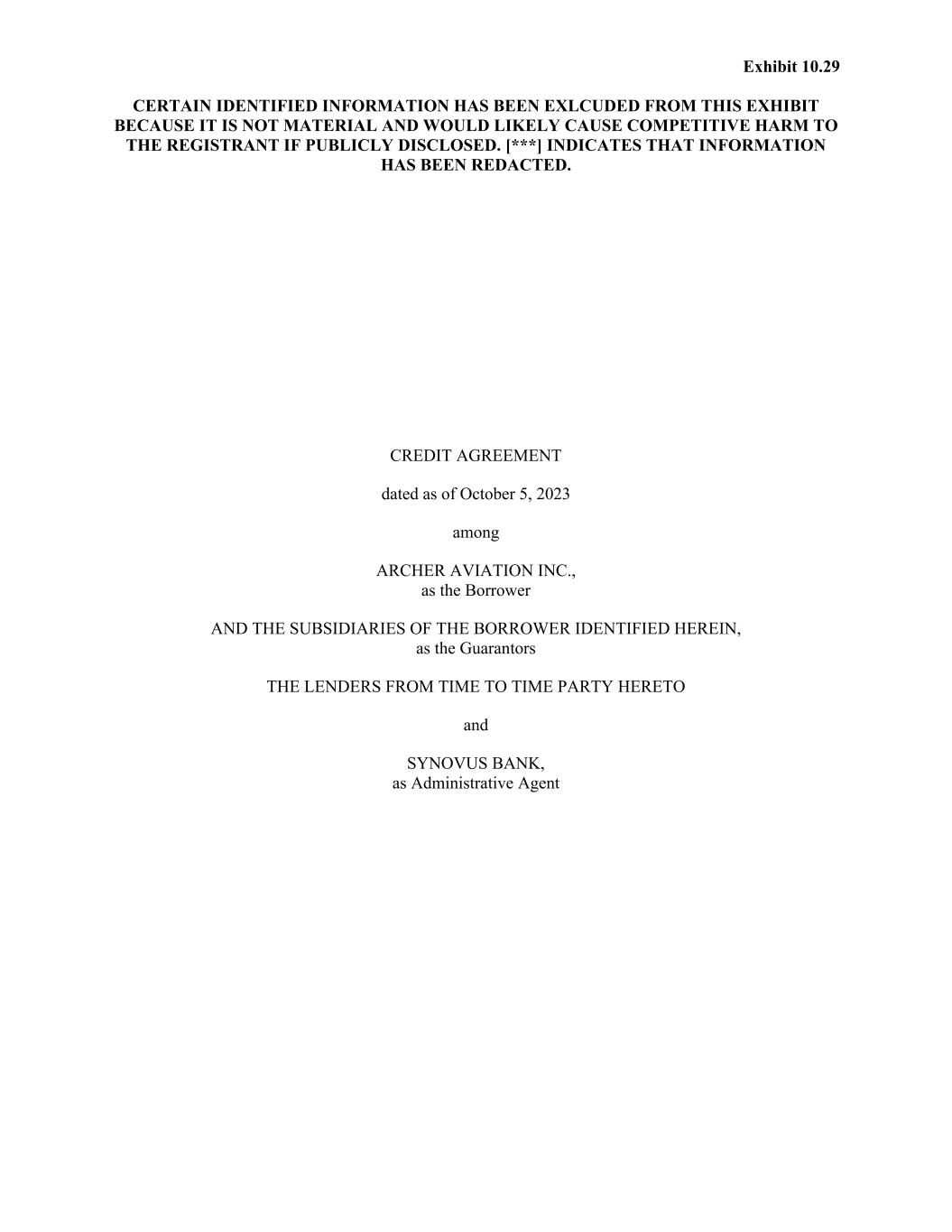
Exhibit 10.29 CERTAIN IDENTIFIED INFORMATION HAS BEEN EXLCUDED FROM THIS EXHIBIT BECAUSE IT IS NOT MATERIAL AND WOULD LIKELY CAUSE COMPETITIVE HARM TO THE REGISTRANT IF PUBLICLY DISCLOSED. [***] INDICATES THAT INFORMATION HAS BEEN REDACTED. CREDIT AGREEMENT dated as of October 5, 2023 among ARCHER AVIATION INC., as the Borrower AND THE SUBSIDIARIES OF THE BORROWER IDENTIFIED HEREIN, as the Guarantors THE LENDERS FROM TIME TO TIME PARTY HERETO and SYNOVUS BANK, as Administrative Agent
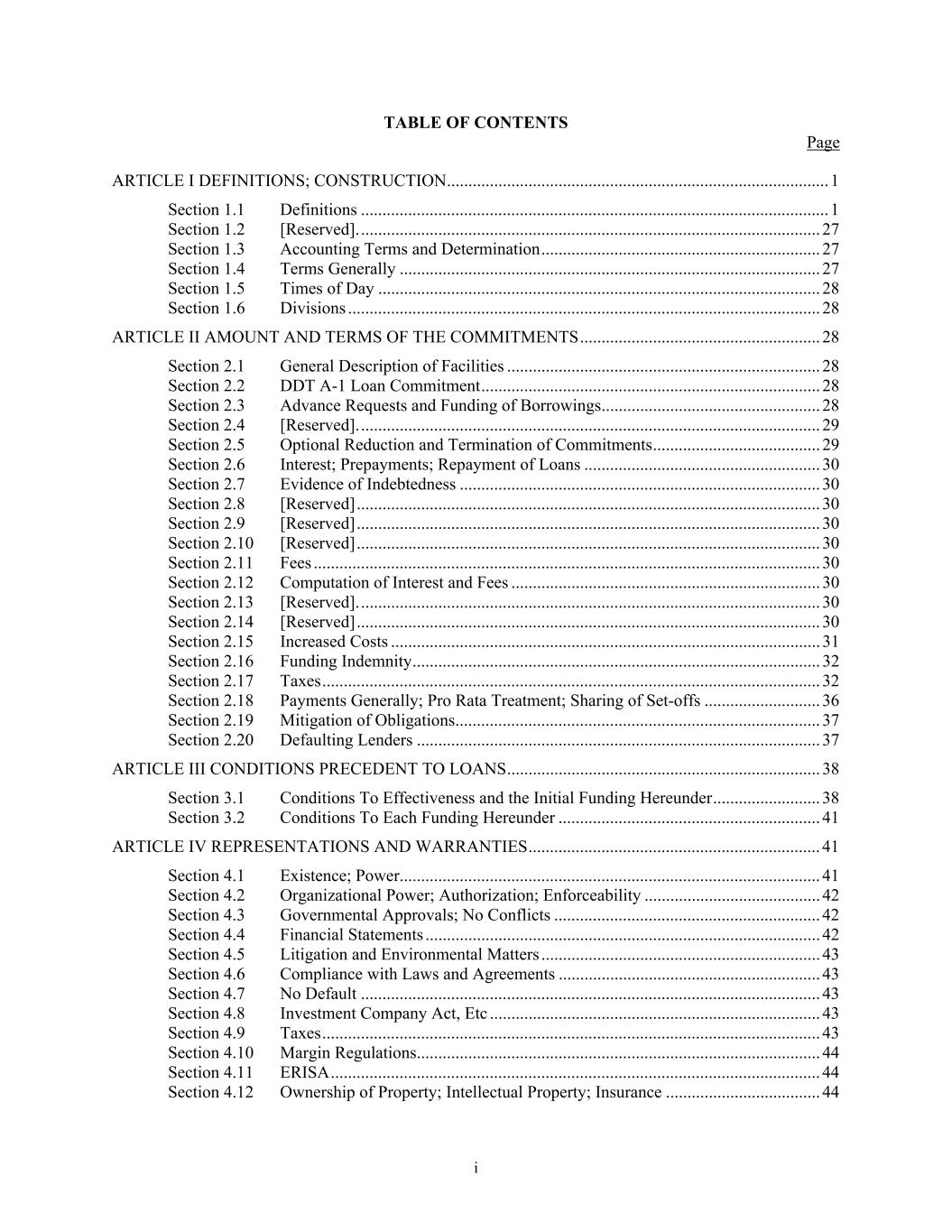
i TABLE OF CONTENTS Page ARTICLE I DEFINITIONS; CONSTRUCTION ......................................................................................... 1 Section 1.1 Definitions ............................................................................................................. 1 Section 1.2 [Reserved]. ........................................................................................................... 27 Section 1.3 Accounting Terms and Determination ................................................................. 27 Section 1.4 Terms Generally .................................................................................................. 27 Section 1.5 Times of Day ....................................................................................................... 28 Section 1.6 Divisions .............................................................................................................. 28 ARTICLE II AMOUNT AND TERMS OF THE COMMITMENTS ........................................................ 28 Section 2.1 General Description of Facilities ......................................................................... 28 Section 2.2 DDT A-1 Loan Commitment ............................................................................... 28 Section 2.3 Advance Requests and Funding of Borrowings ................................................... 28 Section 2.4 [Reserved]. ........................................................................................................... 29 Section 2.5 Optional Reduction and Termination of Commitments ....................................... 29 Section 2.6 Interest; Prepayments; Repayment of Loans ....................................................... 30 Section 2.7 Evidence of Indebtedness .................................................................................... 30 Section 2.8 [Reserved] ............................................................................................................ 30 Section 2.9 [Reserved] ............................................................................................................ 30 Section 2.10 [Reserved] ............................................................................................................ 30 Section 2.11 Fees ...................................................................................................................... 30 Section 2.12 Computation of Interest and Fees ........................................................................ 30 Section 2.13 [Reserved]. ........................................................................................................... 30 Section 2.14 [Reserved] ............................................................................................................ 30 Section 2.15 Increased Costs .................................................................................................... 31 Section 2.16 Funding Indemnity ............................................................................................... 32 Section 2.17 Taxes .................................................................................................................... 32 Section 2.18 Payments Generally; Pro Rata Treatment; Sharing of Set-offs ........................... 36 Section 2.19 Mitigation of Obligations ..................................................................................... 37 Section 2.20 Defaulting Lenders .............................................................................................. 37 ARTICLE III CONDITIONS PRECEDENT TO LOANS ......................................................................... 38 Section 3.1 Conditions To Effectiveness and the Initial Funding Hereunder ......................... 38 Section 3.2 Conditions To Each Funding Hereunder ............................................................. 41 ARTICLE IV REPRESENTATIONS AND WARRANTIES .................................................................... 41 Section 4.1 Existence; Power.................................................................................................. 41 Section 4.2 Organizational Power; Authorization; Enforceability ......................................... 42 Section 4.3 Governmental Approvals; No Conflicts .............................................................. 42 Section 4.4 Financial Statements ............................................................................................ 42 Section 4.5 Litigation and Environmental Matters ................................................................. 43 Section 4.6 Compliance with Laws and Agreements ............................................................. 43 Section 4.7 No Default ........................................................................................................... 43 Section 4.8 Investment Company Act, Etc ............................................................................. 43 Section 4.9 Taxes .................................................................................................................... 43 Section 4.10 Margin Regulations .............................................................................................. 44 Section 4.11 ERISA .................................................................................................................. 44 Section 4.12 Ownership of Property; Intellectual Property; Insurance .................................... 44
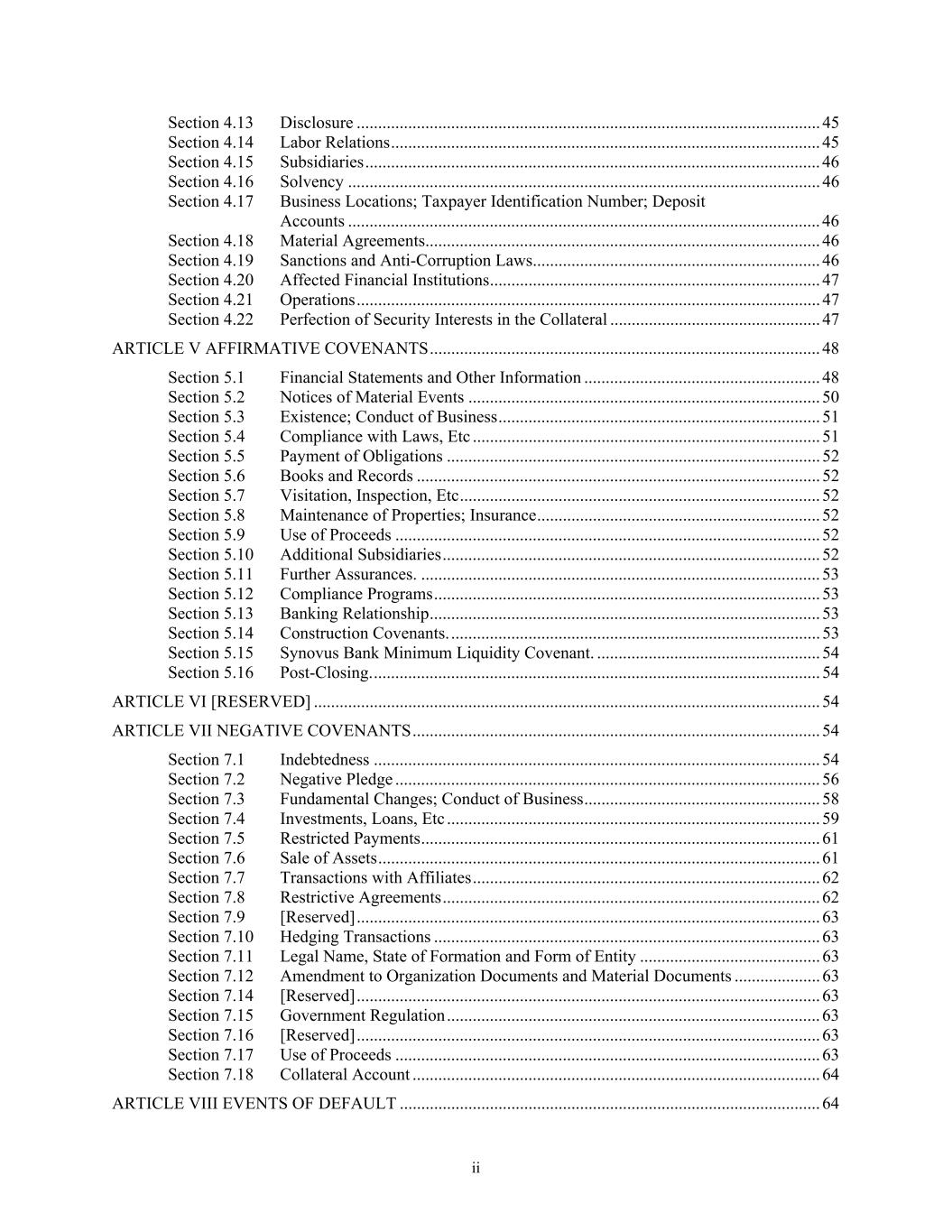
ii Section 4.13 Disclosure ............................................................................................................ 45 Section 4.14 Labor Relations .................................................................................................... 45 Section 4.15 Subsidiaries .......................................................................................................... 46 Section 4.16 Solvency .............................................................................................................. 46 Section 4.17 Business Locations; Taxpayer Identification Number; Deposit Accounts .............................................................................................................. 46 Section 4.18 Material Agreements ............................................................................................ 46 Section 4.19 Sanctions and Anti-Corruption Laws ................................................................... 46 Section 4.20 Affected Financial Institutions ............................................................................. 47 Section 4.21 Operations ............................................................................................................ 47 Section 4.22 Perfection of Security Interests in the Collateral ................................................. 47 ARTICLE V AFFIRMATIVE COVENANTS ........................................................................................... 48 Section 5.1 Financial Statements and Other Information ....................................................... 48 Section 5.2 Notices of Material Events .................................................................................. 50 Section 5.3 Existence; Conduct of Business ........................................................................... 51 Section 5.4 Compliance with Laws, Etc ................................................................................. 51 Section 5.5 Payment of Obligations ....................................................................................... 52 Section 5.6 Books and Records .............................................................................................. 52 Section 5.7 Visitation, Inspection, Etc .................................................................................... 52 Section 5.8 Maintenance of Properties; Insurance .................................................................. 52 Section 5.9 Use of Proceeds ................................................................................................... 52 Section 5.10 Additional Subsidiaries ........................................................................................ 52 Section 5.11 Further Assurances. ............................................................................................. 53 Section 5.12 Compliance Programs .......................................................................................... 53 Section 5.13 Banking Relationship ........................................................................................... 53 Section 5.14 Construction Covenants. ...................................................................................... 53 Section 5.15 Synovus Bank Minimum Liquidity Covenant. .................................................... 54 Section 5.16 Post-Closing. ........................................................................................................ 54 ARTICLE VI [RESERVED] ...................................................................................................................... 54 ARTICLE VII NEGATIVE COVENANTS ............................................................................................... 54 Section 7.1 Indebtedness ........................................................................................................ 54 Section 7.2 Negative Pledge ................................................................................................... 56 Section 7.3 Fundamental Changes; Conduct of Business ....................................................... 58 Section 7.4 Investments, Loans, Etc ....................................................................................... 59 Section 7.5 Restricted Payments ............................................................................................. 61 Section 7.6 Sale of Assets ....................................................................................................... 61 Section 7.7 Transactions with Affiliates ................................................................................. 62 Section 7.8 Restrictive Agreements ........................................................................................ 62 Section 7.9 [Reserved] ............................................................................................................ 63 Section 7.10 Hedging Transactions .......................................................................................... 63 Section 7.11 Legal Name, State of Formation and Form of Entity .......................................... 63 Section 7.12 Amendment to Organization Documents and Material Documents .................... 63 Section 7.14 [Reserved] ............................................................................................................ 63 Section 7.15 Government Regulation ....................................................................................... 63 Section 7.16 [Reserved] ............................................................................................................ 63 Section 7.17 Use of Proceeds ................................................................................................... 63 Section 7.18 Collateral Account ............................................................................................... 64 ARTICLE VIII EVENTS OF DEFAULT .................................................................................................. 64
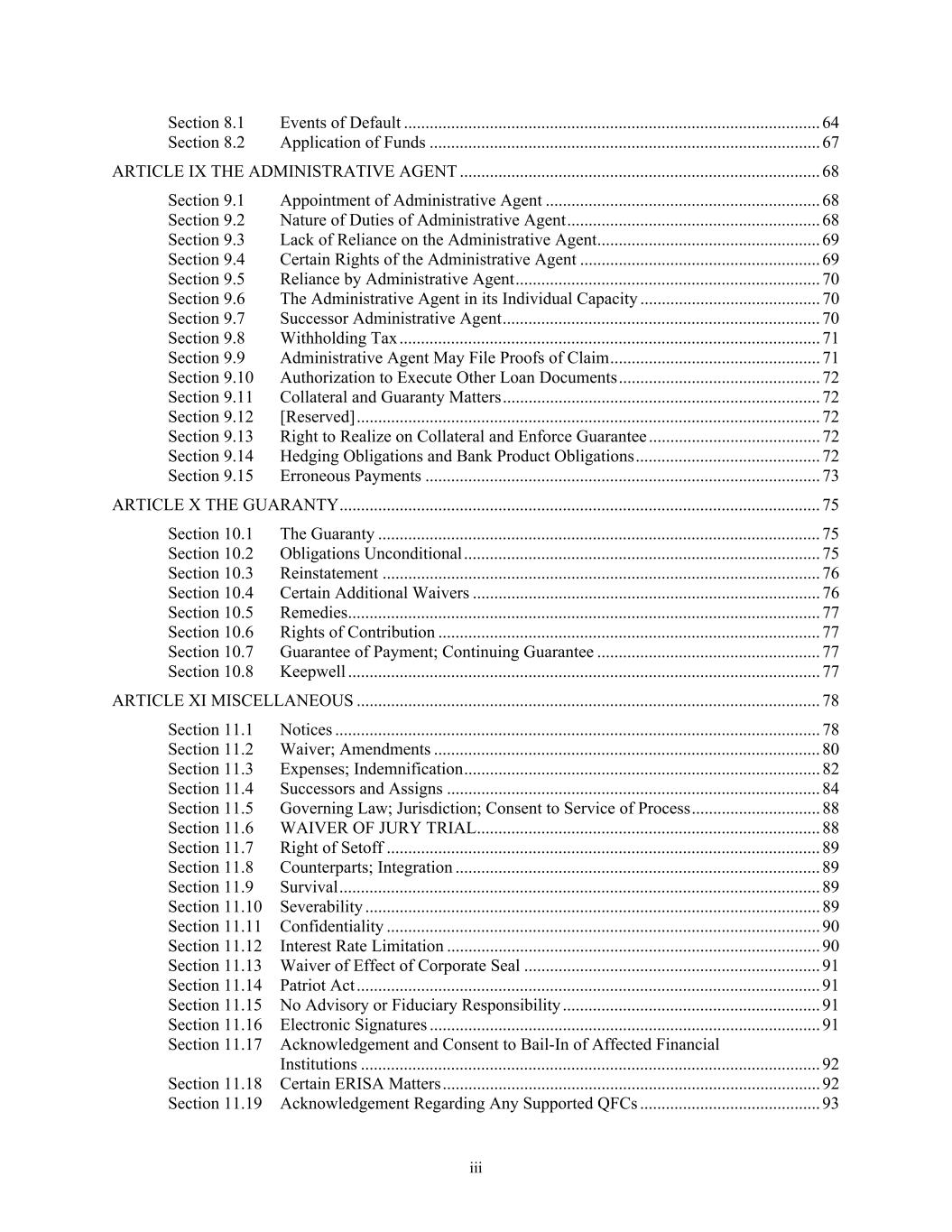
iii Section 8.1 Events of Default ................................................................................................. 64 Section 8.2 Application of Funds ........................................................................................... 67 ARTICLE IX THE ADMINISTRATIVE AGENT .................................................................................... 68 Section 9.1 Appointment of Administrative Agent ................................................................ 68 Section 9.2 Nature of Duties of Administrative Agent ........................................................... 68 Section 9.3 Lack of Reliance on the Administrative Agent .................................................... 69 Section 9.4 Certain Rights of the Administrative Agent ........................................................ 69 Section 9.5 Reliance by Administrative Agent ....................................................................... 70 Section 9.6 The Administrative Agent in its Individual Capacity .......................................... 70 Section 9.7 Successor Administrative Agent .......................................................................... 70 Section 9.8 Withholding Tax .................................................................................................. 71 Section 9.9 Administrative Agent May File Proofs of Claim ................................................. 71 Section 9.10 Authorization to Execute Other Loan Documents ............................................... 72 Section 9.11 Collateral and Guaranty Matters .......................................................................... 72 Section 9.12 [Reserved] ............................................................................................................ 72 Section 9.13 Right to Realize on Collateral and Enforce Guarantee ........................................ 72 Section 9.14 Hedging Obligations and Bank Product Obligations ........................................... 72 Section 9.15 Erroneous Payments ............................................................................................ 73 ARTICLE X THE GUARANTY ................................................................................................................ 75 Section 10.1 The Guaranty ....................................................................................................... 75 Section 10.2 Obligations Unconditional ................................................................................... 75 Section 10.3 Reinstatement ...................................................................................................... 76 Section 10.4 Certain Additional Waivers ................................................................................. 76 Section 10.5 Remedies .............................................................................................................. 77 Section 10.6 Rights of Contribution ......................................................................................... 77 Section 10.7 Guarantee of Payment; Continuing Guarantee .................................................... 77 Section 10.8 Keepwell .............................................................................................................. 77 ARTICLE XI MISCELLANEOUS ............................................................................................................ 78 Section 11.1 Notices ................................................................................................................. 78 Section 11.2 Waiver; Amendments .......................................................................................... 80 Section 11.3 Expenses; Indemnification ................................................................................... 82 Section 11.4 Successors and Assigns ....................................................................................... 84 Section 11.5 Governing Law; Jurisdiction; Consent to Service of Process .............................. 88 Section 11.6 WAIVER OF JURY TRIAL ................................................................................ 88 Section 11.7 Right of Setoff ..................................................................................................... 89 Section 11.8 Counterparts; Integration ..................................................................................... 89 Section 11.9 Survival ................................................................................................................ 89 Section 11.10 Severability .......................................................................................................... 89 Section 11.11 Confidentiality ..................................................................................................... 90 Section 11.12 Interest Rate Limitation ....................................................................................... 90 Section 11.13 Waiver of Effect of Corporate Seal ..................................................................... 91 Section 11.14 Patriot Act ............................................................................................................ 91 Section 11.15 No Advisory or Fiduciary Responsibility ............................................................ 91 Section 11.16 Electronic Signatures ........................................................................................... 91 Section 11.17 Acknowledgement and Consent to Bail-In of Affected Financial Institutions ........................................................................................................... 92 Section 11.18 Certain ERISA Matters ........................................................................................ 92 Section 11.19 Acknowledgement Regarding Any Supported QFCs .......................................... 93
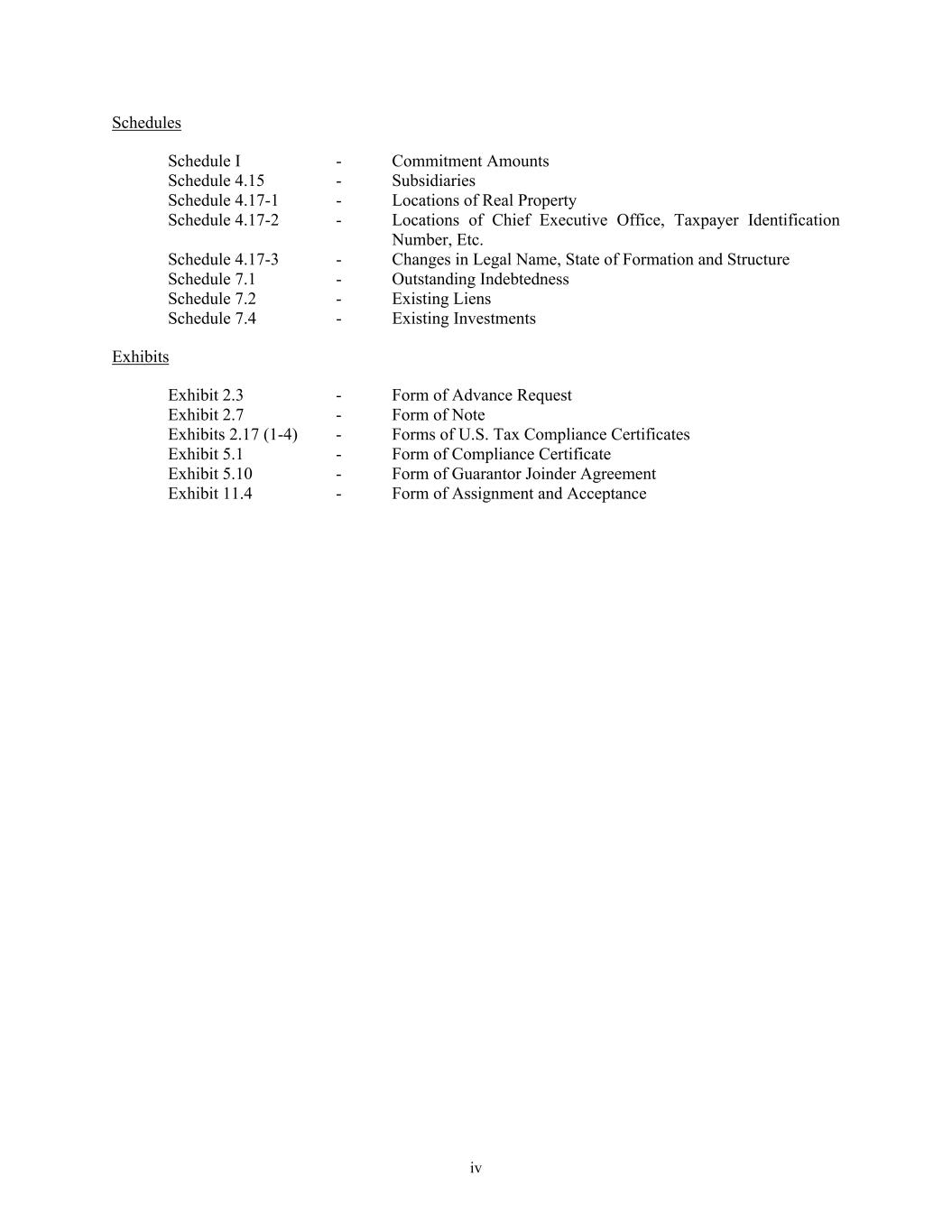
iv Schedules Schedule I - Commitment Amounts Schedule 4.15 - Subsidiaries Schedule 4.17-1 - Locations of Real Property Schedule 4.17-2 - Locations of Chief Executive Office, Taxpayer Identification Number, Etc. Schedule 4.17-3 - Changes in Legal Name, State of Formation and Structure Schedule 7.1 - Outstanding Indebtedness Schedule 7.2 - Existing Liens Schedule 7.4 - Existing Investments Exhibits Exhibit 2.3 - Form of Advance Request Exhibit 2.7 - Form of Note Exhibits 2.17 (1-4) - Forms of U.S. Tax Compliance Certificates Exhibit 5.1 - Form of Compliance Certificate Exhibit 5.10 - Form of Guarantor Joinder Agreement Exhibit 11.4 - Form of Assignment and Acceptance
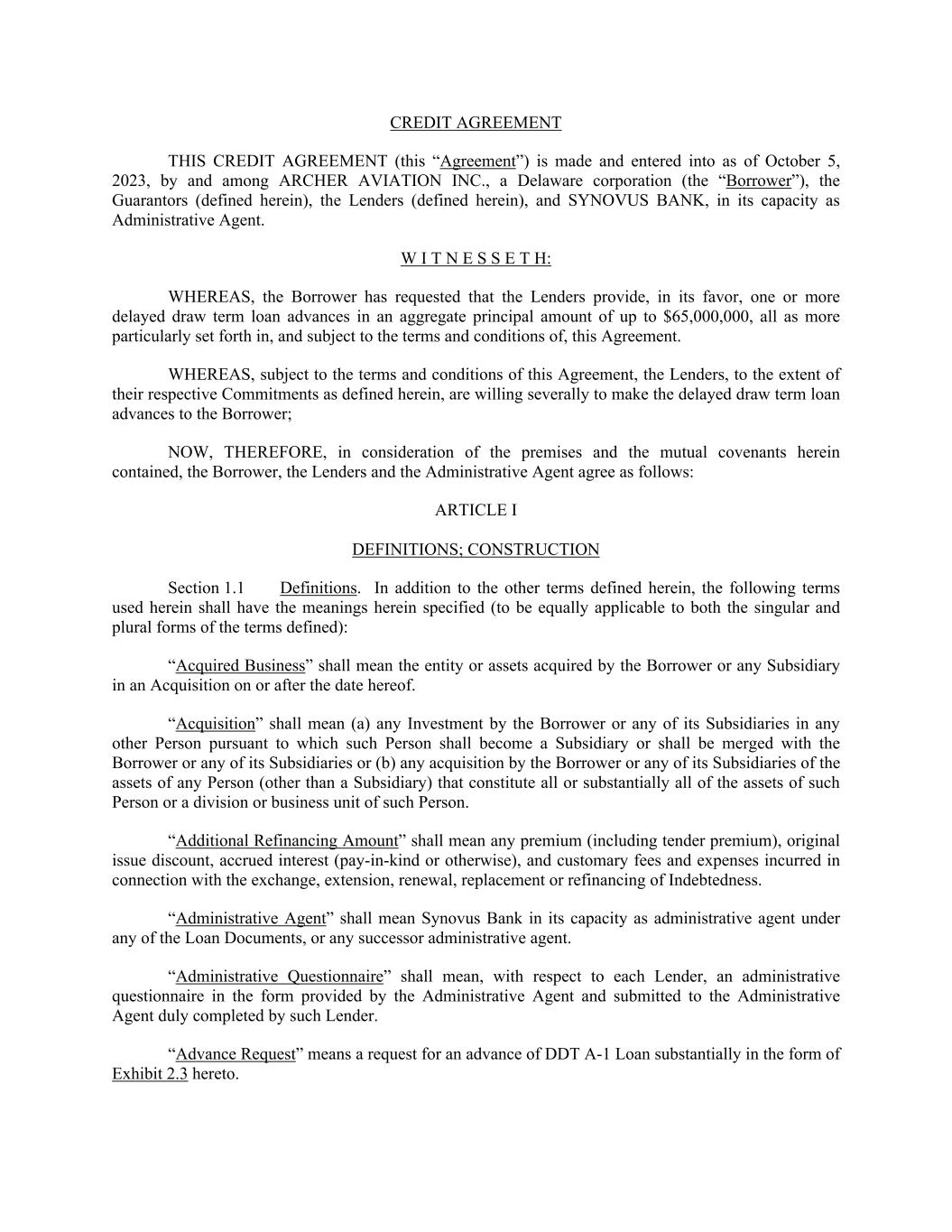
CREDIT AGREEMENT THIS CREDIT AGREEMENT (this “Agreement”) is made and entered into as of October 5, 2023, by and among ARCHER AVIATION INC., a Delaware corporation (the “Borrower”), the Guarantors (defined herein), the Lenders (defined herein), and SYNOVUS BANK, in its capacity as Administrative Agent. W I T N E S S E T H: WHEREAS, the Borrower has requested that the Lenders provide, in its favor, one or more delayed draw term loan advances in an aggregate principal amount of up to $65,000,000, all as more particularly set forth in, and subject to the terms and conditions of, this Agreement. WHEREAS, subject to the terms and conditions of this Agreement, the Lenders, to the extent of their respective Commitments as defined herein, are willing severally to make the delayed draw term loan advances to the Borrower; NOW, THEREFORE, in consideration of the premises and the mutual covenants herein contained, the Borrower, the Lenders and the Administrative Agent agree as follows: ARTICLE I DEFINITIONS; CONSTRUCTION Section 1.1 Definitions. In addition to the other terms defined herein, the following terms used herein shall have the meanings herein specified (to be equally applicable to both the singular and plural forms of the terms defined): “Acquired Business” shall mean the entity or assets acquired by the Borrower or any Subsidiary in an Acquisition on or after the date hereof. “Acquisition” shall mean (a) any Investment by the Borrower or any of its Subsidiaries in any other Person pursuant to which such Person shall become a Subsidiary or shall be merged with the Borrower or any of its Subsidiaries or (b) any acquisition by the Borrower or any of its Subsidiaries of the assets of any Person (other than a Subsidiary) that constitute all or substantially all of the assets of such Person or a division or business unit of such Person. “Additional Refinancing Amount” shall mean any premium (including tender premium), original issue discount, accrued interest (pay-in-kind or otherwise), and customary fees and expenses incurred in connection with the exchange, extension, renewal, replacement or refinancing of Indebtedness. “Administrative Agent” shall mean Synovus Bank in its capacity as administrative agent under any of the Loan Documents, or any successor administrative agent. “Administrative Questionnaire” shall mean, with respect to each Lender, an administrative questionnaire in the form provided by the Administrative Agent and submitted to the Administrative Agent duly completed by such Lender. “Advance Request” means a request for an advance of DDT A-1 Loan substantially in the form of Exhibit 2.3 hereto.
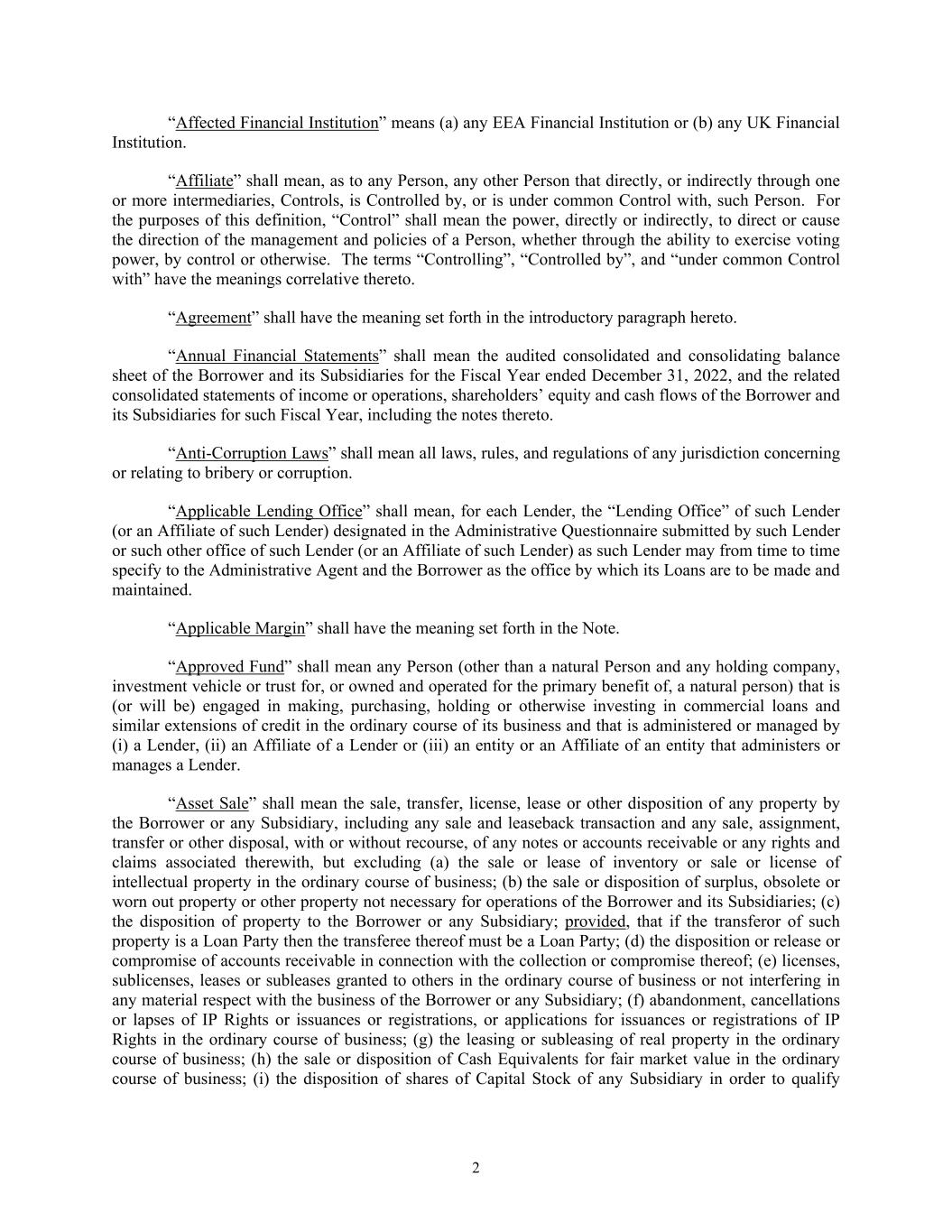
2 “Affected Financial Institution” means (a) any EEA Financial Institution or (b) any UK Financial Institution. “Affiliate” shall mean, as to any Person, any other Person that directly, or indirectly through one or more intermediaries, Controls, is Controlled by, or is under common Control with, such Person. For the purposes of this definition, “Control” shall mean the power, directly or indirectly, to direct or cause the direction of the management and policies of a Person, whether through the ability to exercise voting power, by control or otherwise. The terms “Controlling”, “Controlled by”, and “under common Control with” have the meanings correlative thereto. “Agreement” shall have the meaning set forth in the introductory paragraph hereto. “Annual Financial Statements” shall mean the audited consolidated and consolidating balance sheet of the Borrower and its Subsidiaries for the Fiscal Year ended December 31, 2022, and the related consolidated statements of income or operations, shareholders’ equity and cash flows of the Borrower and its Subsidiaries for such Fiscal Year, including the notes thereto. “Anti-Corruption Laws” shall mean all laws, rules, and regulations of any jurisdiction concerning or relating to bribery or corruption. “Applicable Lending Office” shall mean, for each Lender, the “Lending Office” of such Lender (or an Affiliate of such Lender) designated in the Administrative Questionnaire submitted by such Lender or such other office of such Lender (or an Affiliate of such Lender) as such Lender may from time to time specify to the Administrative Agent and the Borrower as the office by which its Loans are to be made and maintained. “Applicable Margin” shall have the meaning set forth in the Note. “Approved Fund” shall mean any Person (other than a natural Person and any holding company, investment vehicle or trust for, or owned and operated for the primary benefit of, a natural person) that is (or will be) engaged in making, purchasing, holding or otherwise investing in commercial loans and similar extensions of credit in the ordinary course of its business and that is administered or managed by (i) a Lender, (ii) an Affiliate of a Lender or (iii) an entity or an Affiliate of an entity that administers or manages a Lender. “Asset Sale” shall mean the sale, transfer, license, lease or other disposition of any property by the Borrower or any Subsidiary, including any sale and leaseback transaction and any sale, assignment, transfer or other disposal, with or without recourse, of any notes or accounts receivable or any rights and claims associated therewith, but excluding (a) the sale or lease of inventory or sale or license of intellectual property in the ordinary course of business; (b) the sale or disposition of surplus, obsolete or worn out property or other property not necessary for operations of the Borrower and its Subsidiaries; (c) the disposition of property to the Borrower or any Subsidiary; provided, that if the transferor of such property is a Loan Party then the transferee thereof must be a Loan Party; (d) the disposition or release or compromise of accounts receivable in connection with the collection or compromise thereof; (e) licenses, sublicenses, leases or subleases granted to others in the ordinary course of business or not interfering in any material respect with the business of the Borrower or any Subsidiary; (f) abandonment, cancellations or lapses of IP Rights or issuances or registrations, or applications for issuances or registrations of IP Rights in the ordinary course of business; (g) the leasing or subleasing of real property in the ordinary course of business; (h) the sale or disposition of Cash Equivalents for fair market value in the ordinary course of business; (i) the disposition of shares of Capital Stock of any Subsidiary in order to qualify
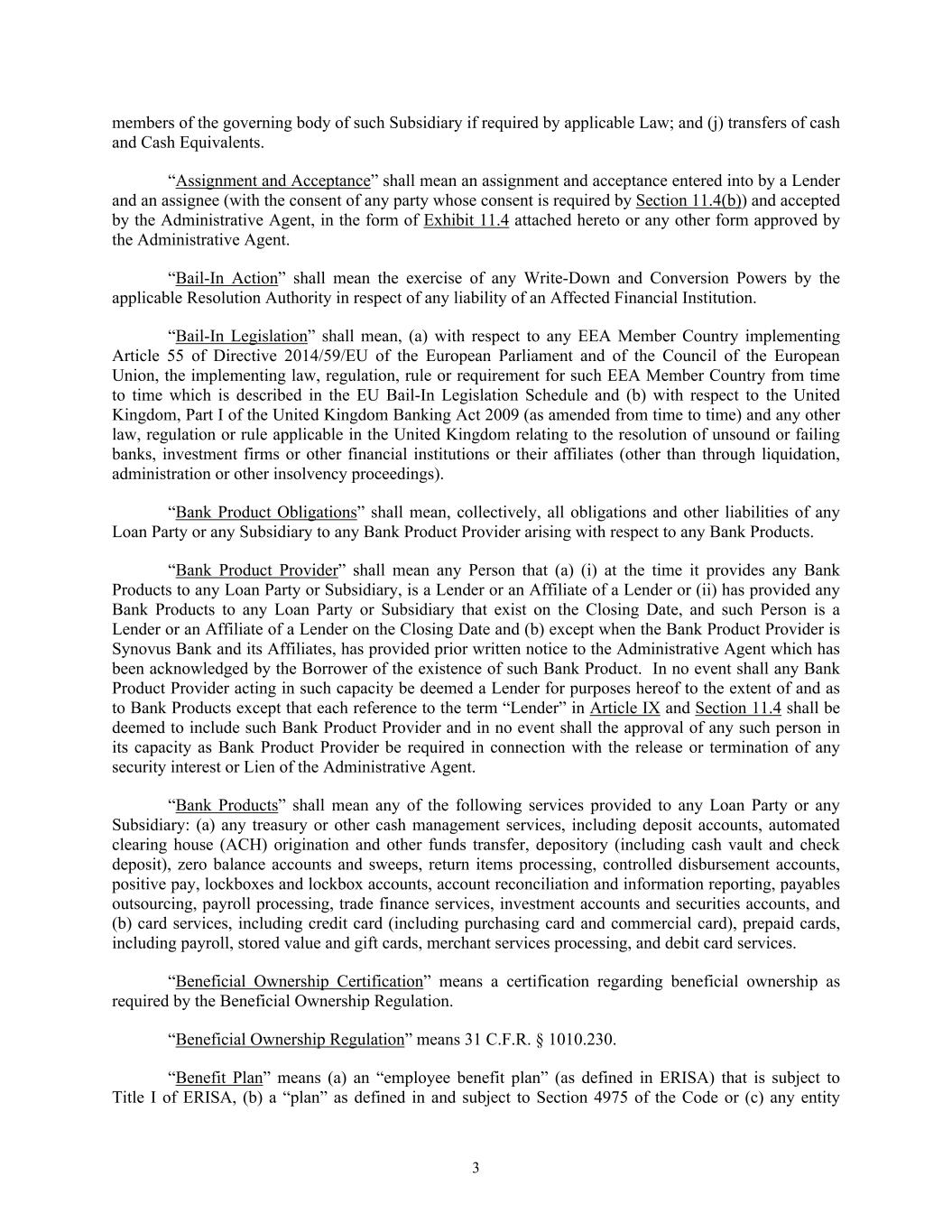
3 members of the governing body of such Subsidiary if required by applicable Law; and (j) transfers of cash and Cash Equivalents. “Assignment and Acceptance” shall mean an assignment and acceptance entered into by a Lender and an assignee (with the consent of any party whose consent is required by Section 11.4(b)) and accepted by the Administrative Agent, in the form of Exhibit 11.4 attached hereto or any other form approved by the Administrative Agent. “Bail-In Action” shall mean the exercise of any Write-Down and Conversion Powers by the applicable Resolution Authority in respect of any liability of an Affected Financial Institution. “Bail-In Legislation” shall mean, (a) with respect to any EEA Member Country implementing Article 55 of Directive 2014/59/EU of the European Parliament and of the Council of the European Union, the implementing law, regulation, rule or requirement for such EEA Member Country from time to time which is described in the EU Bail-In Legislation Schedule and (b) with respect to the United Kingdom, Part I of the United Kingdom Banking Act 2009 (as amended from time to time) and any other law, regulation or rule applicable in the United Kingdom relating to the resolution of unsound or failing banks, investment firms or other financial institutions or their affiliates (other than through liquidation, administration or other insolvency proceedings). “Bank Product Obligations” shall mean, collectively, all obligations and other liabilities of any Loan Party or any Subsidiary to any Bank Product Provider arising with respect to any Bank Products. “Bank Product Provider” shall mean any Person that (a) (i) at the time it provides any Bank Products to any Loan Party or Subsidiary, is a Lender or an Affiliate of a Lender or (ii) has provided any Bank Products to any Loan Party or Subsidiary that exist on the Closing Date, and such Person is a Lender or an Affiliate of a Lender on the Closing Date and (b) except when the Bank Product Provider is Synovus Bank and its Affiliates, has provided prior written notice to the Administrative Agent which has been acknowledged by the Borrower of the existence of such Bank Product. In no event shall any Bank Product Provider acting in such capacity be deemed a Lender for purposes hereof to the extent of and as to Bank Products except that each reference to the term “Lender” in Article IX and Section 11.4 shall be deemed to include such Bank Product Provider and in no event shall the approval of any such person in its capacity as Bank Product Provider be required in connection with the release or termination of any security interest or Lien of the Administrative Agent. “Bank Products” shall mean any of the following services provided to any Loan Party or any Subsidiary: (a) any treasury or other cash management services, including deposit accounts, automated clearing house (ACH) origination and other funds transfer, depository (including cash vault and check deposit), zero balance accounts and sweeps, return items processing, controlled disbursement accounts, positive pay, lockboxes and lockbox accounts, account reconciliation and information reporting, payables outsourcing, payroll processing, trade finance services, investment accounts and securities accounts, and (b) card services, including credit card (including purchasing card and commercial card), prepaid cards, including payroll, stored value and gift cards, merchant services processing, and debit card services. “Beneficial Ownership Certification” means a certification regarding beneficial ownership as required by the Beneficial Ownership Regulation. “Beneficial Ownership Regulation” means 31 C.F.R. § 1010.230. “Benefit Plan” means (a) an “employee benefit plan” (as defined in ERISA) that is subject to Title I of ERISA, (b) a “plan” as defined in and subject to Section 4975 of the Code or (c) any entity
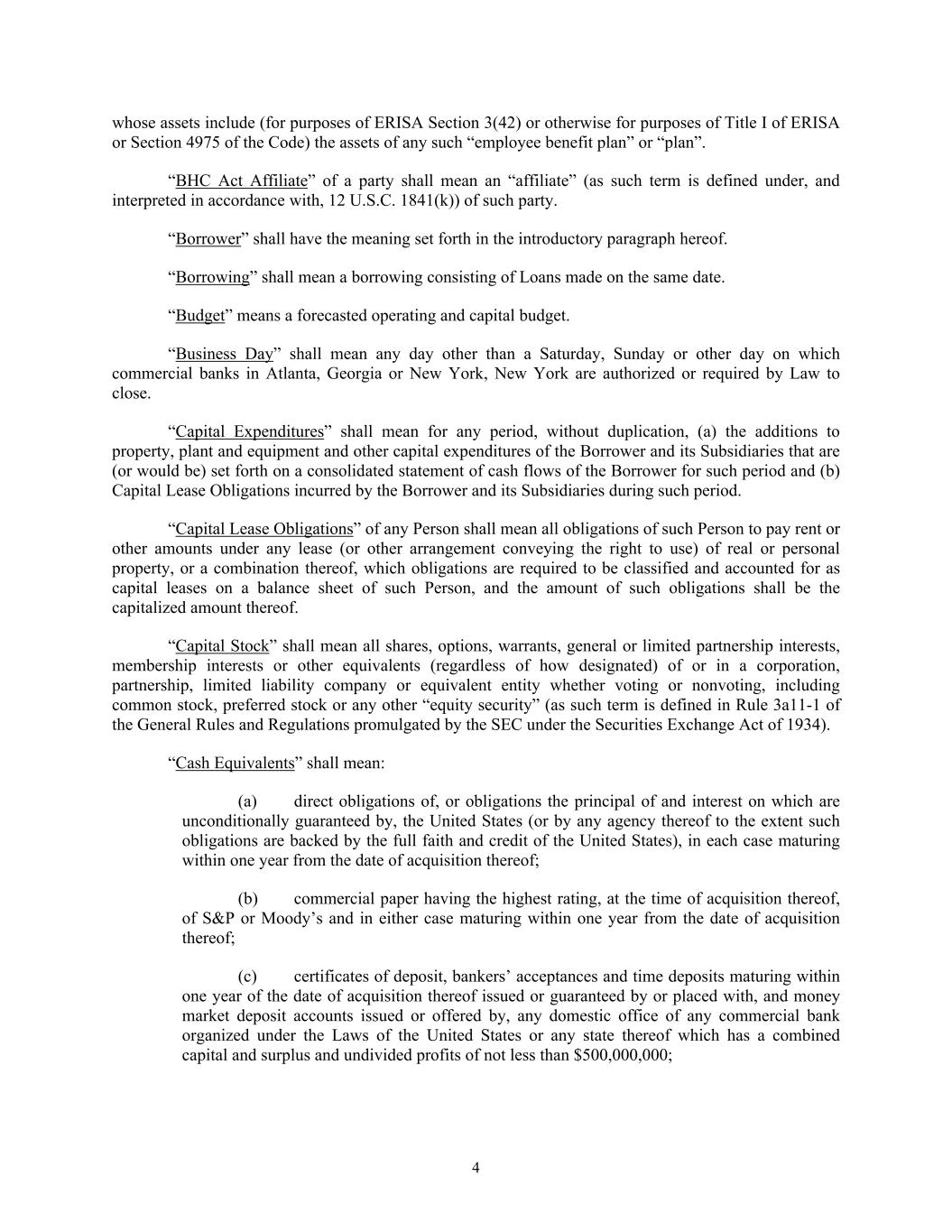
4 whose assets include (for purposes of ERISA Section 3(42) or otherwise for purposes of Title I of ERISA or Section 4975 of the Code) the assets of any such “employee benefit plan” or “plan”. “BHC Act Affiliate” of a party shall mean an “affiliate” (as such term is defined under, and interpreted in accordance with, 12 U.S.C. 1841(k)) of such party. “Borrower” shall have the meaning set forth in the introductory paragraph hereof. “Borrowing” shall mean a borrowing consisting of Loans made on the same date. “Budget” means a forecasted operating and capital budget. “Business Day” shall mean any day other than a Saturday, Sunday or other day on which commercial banks in Atlanta, Georgia or New York, New York are authorized or required by Law to close. “Capital Expenditures” shall mean for any period, without duplication, (a) the additions to property, plant and equipment and other capital expenditures of the Borrower and its Subsidiaries that are (or would be) set forth on a consolidated statement of cash flows of the Borrower for such period and (b) Capital Lease Obligations incurred by the Borrower and its Subsidiaries during such period. “Capital Lease Obligations” of any Person shall mean all obligations of such Person to pay rent or other amounts under any lease (or other arrangement conveying the right to use) of real or personal property, or a combination thereof, which obligations are required to be classified and accounted for as capital leases on a balance sheet of such Person, and the amount of such obligations shall be the capitalized amount thereof. “Capital Stock” shall mean all shares, options, warrants, general or limited partnership interests, membership interests or other equivalents (regardless of how designated) of or in a corporation, partnership, limited liability company or equivalent entity whether voting or nonvoting, including common stock, preferred stock or any other “equity security” (as such term is defined in Rule 3a11-1 of the General Rules and Regulations promulgated by the SEC under the Securities Exchange Act of 1934). “Cash Equivalents” shall mean: (a) direct obligations of, or obligations the principal of and interest on which are unconditionally guaranteed by, the United States (or by any agency thereof to the extent such obligations are backed by the full faith and credit of the United States), in each case maturing within one year from the date of acquisition thereof; (b) commercial paper having the highest rating, at the time of acquisition thereof, of S&P or Moody’s and in either case maturing within one year from the date of acquisition thereof; (c) certificates of deposit, bankers’ acceptances and time deposits maturing within one year of the date of acquisition thereof issued or guaranteed by or placed with, and money market deposit accounts issued or offered by, any domestic office of any commercial bank organized under the Laws of the United States or any state thereof which has a combined capital and surplus and undivided profits of not less than $500,000,000;
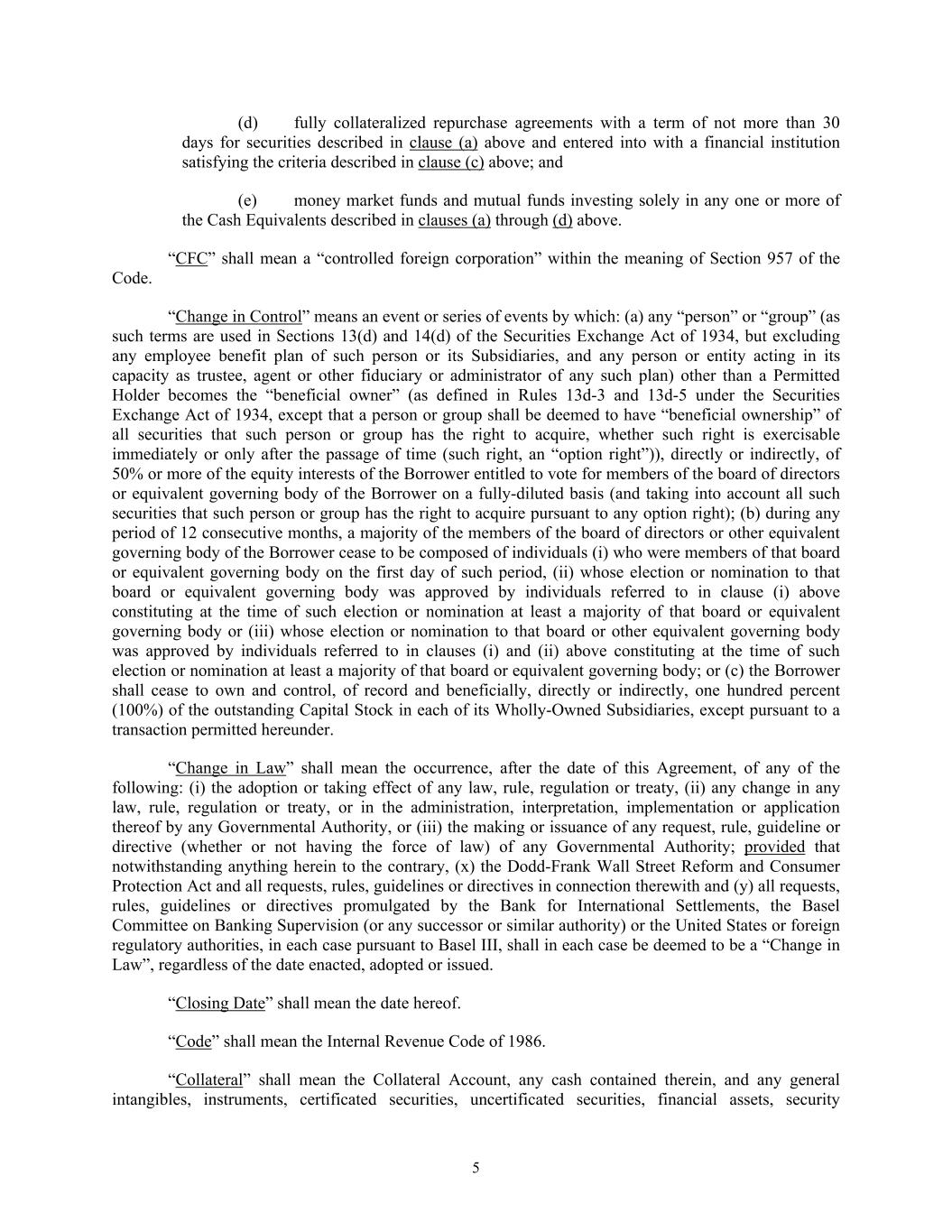
5 (d) fully collateralized repurchase agreements with a term of not more than 30 days for securities described in clause (a) above and entered into with a financial institution satisfying the criteria described in clause (c) above; and (e) money market funds and mutual funds investing solely in any one or more of the Cash Equivalents described in clauses (a) through (d) above. “CFC” shall mean a “controlled foreign corporation” within the meaning of Section 957 of the Code. “Change in Control” means an event or series of events by which: (a) any “person” or “group” (as such terms are used in Sections 13(d) and 14(d) of the Securities Exchange Act of 1934, but excluding any employee benefit plan of such person or its Subsidiaries, and any person or entity acting in its capacity as trustee, agent or other fiduciary or administrator of any such plan) other than a Permitted Holder becomes the “beneficial owner” (as defined in Rules 13d-3 and 13d-5 under the Securities Exchange Act of 1934, except that a person or group shall be deemed to have “beneficial ownership” of all securities that such person or group has the right to acquire, whether such right is exercisable immediately or only after the passage of time (such right, an “option right”)), directly or indirectly, of 50% or more of the equity interests of the Borrower entitled to vote for members of the board of directors or equivalent governing body of the Borrower on a fully-diluted basis (and taking into account all such securities that such person or group has the right to acquire pursuant to any option right); (b) during any period of 12 consecutive months, a majority of the members of the board of directors or other equivalent governing body of the Borrower cease to be composed of individuals (i) who were members of that board or equivalent governing body on the first day of such period, (ii) whose election or nomination to that board or equivalent governing body was approved by individuals referred to in clause (i) above constituting at the time of such election or nomination at least a majority of that board or equivalent governing body or (iii) whose election or nomination to that board or other equivalent governing body was approved by individuals referred to in clauses (i) and (ii) above constituting at the time of such election or nomination at least a majority of that board or equivalent governing body; or (c) the Borrower shall cease to own and control, of record and beneficially, directly or indirectly, one hundred percent (100%) of the outstanding Capital Stock in each of its Wholly-Owned Subsidiaries, except pursuant to a transaction permitted hereunder. “Change in Law” shall mean the occurrence, after the date of this Agreement, of any of the following: (i) the adoption or taking effect of any law, rule, regulation or treaty, (ii) any change in any law, rule, regulation or treaty, or in the administration, interpretation, implementation or application thereof by any Governmental Authority, or (iii) the making or issuance of any request, rule, guideline or directive (whether or not having the force of law) of any Governmental Authority; provided that notwithstanding anything herein to the contrary, (x) the Dodd-Frank Wall Street Reform and Consumer Protection Act and all requests, rules, guidelines or directives in connection therewith and (y) all requests, rules, guidelines or directives promulgated by the Bank for International Settlements, the Basel Committee on Banking Supervision (or any successor or similar authority) or the United States or foreign regulatory authorities, in each case pursuant to Basel III, shall in each case be deemed to be a “Change in Law”, regardless of the date enacted, adopted or issued. “Closing Date” shall mean the date hereof. “Code” shall mean the Internal Revenue Code of 1986. “Collateral” shall mean the Collateral Account, any cash contained therein, and any general intangibles, instruments, certificated securities, uncertificated securities, financial assets, security
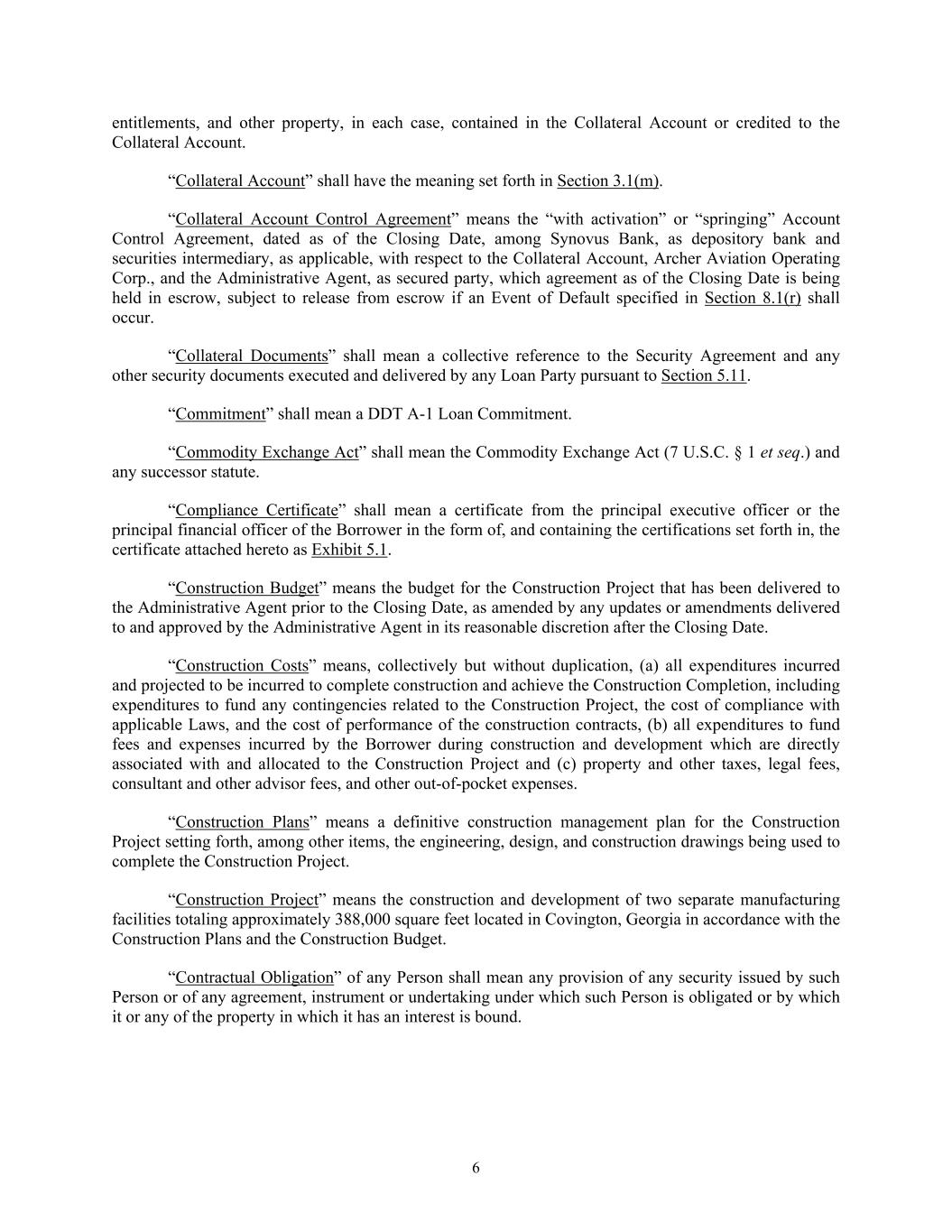
6 entitlements, and other property, in each case, contained in the Collateral Account or credited to the Collateral Account. “Collateral Account” shall have the meaning set forth in Section 3.1(m). “Collateral Account Control Agreement” means the “with activation” or “springing” Account Control Agreement, dated as of the Closing Date, among Synovus Bank, as depository bank and securities intermediary, as applicable, with respect to the Collateral Account, Archer Aviation Operating Corp., and the Administrative Agent, as secured party, which agreement as of the Closing Date is being held in escrow, subject to release from escrow if an Event of Default specified in Section 8.1(r) shall occur. “Collateral Documents” shall mean a collective reference to the Security Agreement and any other security documents executed and delivered by any Loan Party pursuant to Section 5.11. “Commitment” shall mean a DDT A-1 Loan Commitment. “Commodity Exchange Act” shall mean the Commodity Exchange Act (7 U.S.C. § 1 et seq.) and any successor statute. “Compliance Certificate” shall mean a certificate from the principal executive officer or the principal financial officer of the Borrower in the form of, and containing the certifications set forth in, the certificate attached hereto as Exhibit 5.1. “Construction Budget” means the budget for the Construction Project that has been delivered to the Administrative Agent prior to the Closing Date, as amended by any updates or amendments delivered to and approved by the Administrative Agent in its reasonable discretion after the Closing Date. “Construction Costs” means, collectively but without duplication, (a) all expenditures incurred and projected to be incurred to complete construction and achieve the Construction Completion, including expenditures to fund any contingencies related to the Construction Project, the cost of compliance with applicable Laws, and the cost of performance of the construction contracts, (b) all expenditures to fund fees and expenses incurred by the Borrower during construction and development which are directly associated with and allocated to the Construction Project and (c) property and other taxes, legal fees, consultant and other advisor fees, and other out-of-pocket expenses. “Construction Plans” means a definitive construction management plan for the Construction Project setting forth, among other items, the engineering, design, and construction drawings being used to complete the Construction Project. “Construction Project” means the construction and development of two separate manufacturing facilities totaling approximately 388,000 square feet located in Covington, Georgia in accordance with the Construction Plans and the Construction Budget. “Contractual Obligation” of any Person shall mean any provision of any security issued by such Person or of any agreement, instrument or undertaking under which such Person is obligated or by which it or any of the property in which it has an interest is bound.
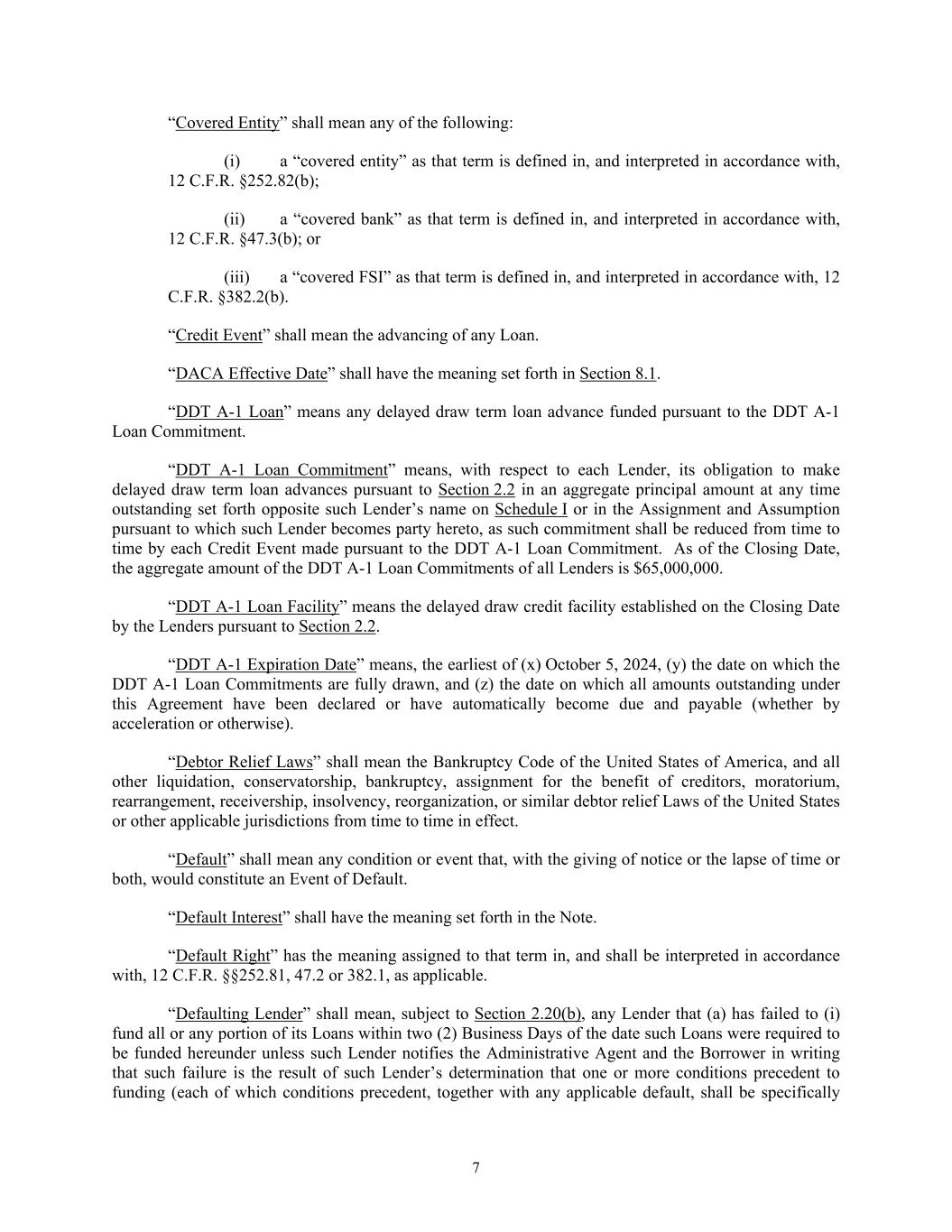
7 “Covered Entity” shall mean any of the following: (i) a “covered entity” as that term is defined in, and interpreted in accordance with, 12 C.F.R. §252.82(b); (ii) a “covered bank” as that term is defined in, and interpreted in accordance with, 12 C.F.R. §47.3(b); or (iii) a “covered FSI” as that term is defined in, and interpreted in accordance with, 12 C.F.R. §382.2(b). “Credit Event” shall mean the advancing of any Loan. “DACA Effective Date” shall have the meaning set forth in Section 8.1. “DDT A-1 Loan” means any delayed draw term loan advance funded pursuant to the DDT A-1 Loan Commitment. “DDT A-1 Loan Commitment” means, with respect to each Lender, its obligation to make delayed draw term loan advances pursuant to Section 2.2 in an aggregate principal amount at any time outstanding set forth opposite such Lender’s name on Schedule I or in the Assignment and Assumption pursuant to which such Lender becomes party hereto, as such commitment shall be reduced from time to time by each Credit Event made pursuant to the DDT A-1 Loan Commitment. As of the Closing Date, the aggregate amount of the DDT A-1 Loan Commitments of all Lenders is $65,000,000. “DDT A-1 Loan Facility” means the delayed draw credit facility established on the Closing Date by the Lenders pursuant to Section 2.2. “DDT A-1 Expiration Date” means, the earliest of (x) October 5, 2024, (y) the date on which the DDT A-1 Loan Commitments are fully drawn, and (z) the date on which all amounts outstanding under this Agreement have been declared or have automatically become due and payable (whether by acceleration or otherwise). “Debtor Relief Laws” shall mean the Bankruptcy Code of the United States of America, and all other liquidation, conservatorship, bankruptcy, assignment for the benefit of creditors, moratorium, rearrangement, receivership, insolvency, reorganization, or similar debtor relief Laws of the United States or other applicable jurisdictions from time to time in effect. “Default” shall mean any condition or event that, with the giving of notice or the lapse of time or both, would constitute an Event of Default. “Default Interest” shall have the meaning set forth in the Note. “Default Right” has the meaning assigned to that term in, and shall be interpreted in accordance with, 12 C.F.R. §§252.81, 47.2 or 382.1, as applicable. “Defaulting Lender” shall mean, subject to Section 2.20(b), any Lender that (a) has failed to (i) fund all or any portion of its Loans within two (2) Business Days of the date such Loans were required to be funded hereunder unless such Lender notifies the Administrative Agent and the Borrower in writing that such failure is the result of such Lender’s determination that one or more conditions precedent to funding (each of which conditions precedent, together with any applicable default, shall be specifically
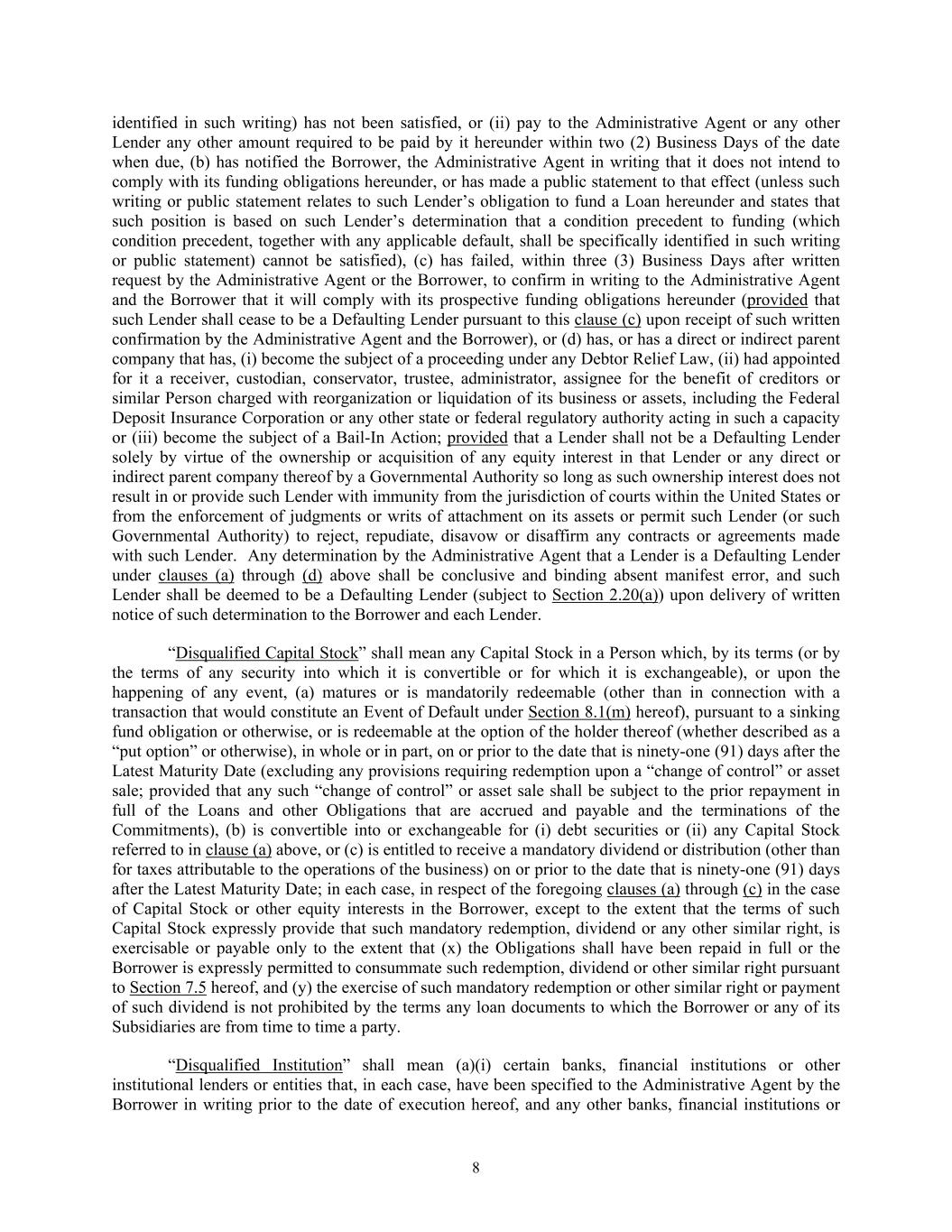
8 identified in such writing) has not been satisfied, or (ii) pay to the Administrative Agent or any other Lender any other amount required to be paid by it hereunder within two (2) Business Days of the date when due, (b) has notified the Borrower, the Administrative Agent in writing that it does not intend to comply with its funding obligations hereunder, or has made a public statement to that effect (unless such writing or public statement relates to such Lender’s obligation to fund a Loan hereunder and states that such position is based on such Lender’s determination that a condition precedent to funding (which condition precedent, together with any applicable default, shall be specifically identified in such writing or public statement) cannot be satisfied), (c) has failed, within three (3) Business Days after written request by the Administrative Agent or the Borrower, to confirm in writing to the Administrative Agent and the Borrower that it will comply with its prospective funding obligations hereunder (provided that such Lender shall cease to be a Defaulting Lender pursuant to this clause (c) upon receipt of such written confirmation by the Administrative Agent and the Borrower), or (d) has, or has a direct or indirect parent company that has, (i) become the subject of a proceeding under any Debtor Relief Law, (ii) had appointed for it a receiver, custodian, conservator, trustee, administrator, assignee for the benefit of creditors or similar Person charged with reorganization or liquidation of its business or assets, including the Federal Deposit Insurance Corporation or any other state or federal regulatory authority acting in such a capacity or (iii) become the subject of a Bail-In Action; provided that a Lender shall not be a Defaulting Lender solely by virtue of the ownership or acquisition of any equity interest in that Lender or any direct or indirect parent company thereof by a Governmental Authority so long as such ownership interest does not result in or provide such Lender with immunity from the jurisdiction of courts within the United States or from the enforcement of judgments or writs of attachment on its assets or permit such Lender (or such Governmental Authority) to reject, repudiate, disavow or disaffirm any contracts or agreements made with such Lender. Any determination by the Administrative Agent that a Lender is a Defaulting Lender under clauses (a) through (d) above shall be conclusive and binding absent manifest error, and such Lender shall be deemed to be a Defaulting Lender (subject to Section 2.20(a)) upon delivery of written notice of such determination to the Borrower and each Lender. “Disqualified Capital Stock” shall mean any Capital Stock in a Person which, by its terms (or by the terms of any security into which it is convertible or for which it is exchangeable), or upon the happening of any event, (a) matures or is mandatorily redeemable (other than in connection with a transaction that would constitute an Event of Default under Section 8.1(m) hereof), pursuant to a sinking fund obligation or otherwise, or is redeemable at the option of the holder thereof (whether described as a “put option” or otherwise), in whole or in part, on or prior to the date that is ninety-one (91) days after the Latest Maturity Date (excluding any provisions requiring redemption upon a “change of control” or asset sale; provided that any such “change of control” or asset sale shall be subject to the prior repayment in full of the Loans and other Obligations that are accrued and payable and the terminations of the Commitments), (b) is convertible into or exchangeable for (i) debt securities or (ii) any Capital Stock referred to in clause (a) above, or (c) is entitled to receive a mandatory dividend or distribution (other than for taxes attributable to the operations of the business) on or prior to the date that is ninety-one (91) days after the Latest Maturity Date; in each case, in respect of the foregoing clauses (a) through (c) in the case of Capital Stock or other equity interests in the Borrower, except to the extent that the terms of such Capital Stock expressly provide that such mandatory redemption, dividend or any other similar right, is exercisable or payable only to the extent that (x) the Obligations shall have been repaid in full or the Borrower is expressly permitted to consummate such redemption, dividend or other similar right pursuant to Section 7.5 hereof, and (y) the exercise of such mandatory redemption or other similar right or payment of such dividend is not prohibited by the terms any loan documents to which the Borrower or any of its Subsidiaries are from time to time a party. “Disqualified Institution” shall mean (a)(i) certain banks, financial institutions or other institutional lenders or entities that, in each case, have been specified to the Administrative Agent by the Borrower in writing prior to the date of execution hereof, and any other banks, financial institutions or
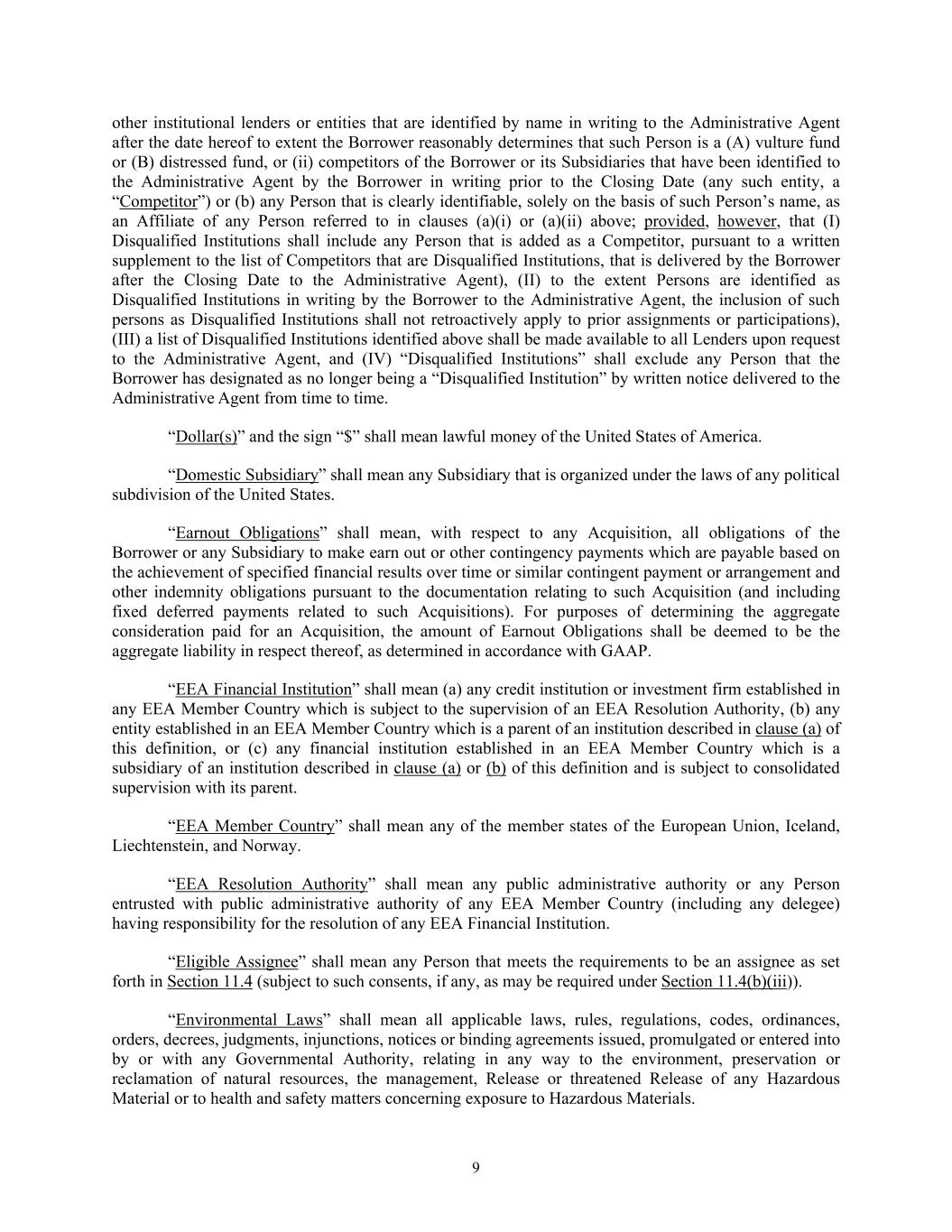
9 other institutional lenders or entities that are identified by name in writing to the Administrative Agent after the date hereof to extent the Borrower reasonably determines that such Person is a (A) vulture fund or (B) distressed fund, or (ii) competitors of the Borrower or its Subsidiaries that have been identified to the Administrative Agent by the Borrower in writing prior to the Closing Date (any such entity, a “Competitor”) or (b) any Person that is clearly identifiable, solely on the basis of such Person’s name, as an Affiliate of any Person referred to in clauses (a)(i) or (a)(ii) above; provided, however, that (I) Disqualified Institutions shall include any Person that is added as a Competitor, pursuant to a written supplement to the list of Competitors that are Disqualified Institutions, that is delivered by the Borrower after the Closing Date to the Administrative Agent), (II) to the extent Persons are identified as Disqualified Institutions in writing by the Borrower to the Administrative Agent, the inclusion of such persons as Disqualified Institutions shall not retroactively apply to prior assignments or participations), (III) a list of Disqualified Institutions identified above shall be made available to all Lenders upon request to the Administrative Agent, and (IV) “Disqualified Institutions” shall exclude any Person that the Borrower has designated as no longer being a “Disqualified Institution” by written notice delivered to the Administrative Agent from time to time. “Dollar(s)” and the sign “$” shall mean lawful money of the United States of America. “Domestic Subsidiary” shall mean any Subsidiary that is organized under the laws of any political subdivision of the United States. “Earnout Obligations” shall mean, with respect to any Acquisition, all obligations of the Borrower or any Subsidiary to make earn out or other contingency payments which are payable based on the achievement of specified financial results over time or similar contingent payment or arrangement and other indemnity obligations pursuant to the documentation relating to such Acquisition (and including fixed deferred payments related to such Acquisitions). For purposes of determining the aggregate consideration paid for an Acquisition, the amount of Earnout Obligations shall be deemed to be the aggregate liability in respect thereof, as determined in accordance with GAAP. “EEA Financial Institution” shall mean (a) any credit institution or investment firm established in any EEA Member Country which is subject to the supervision of an EEA Resolution Authority, (b) any entity established in an EEA Member Country which is a parent of an institution described in clause (a) of this definition, or (c) any financial institution established in an EEA Member Country which is a subsidiary of an institution described in clause (a) or (b) of this definition and is subject to consolidated supervision with its parent. “EEA Member Country” shall mean any of the member states of the European Union, Iceland, Liechtenstein, and Norway. “EEA Resolution Authority” shall mean any public administrative authority or any Person entrusted with public administrative authority of any EEA Member Country (including any delegee) having responsibility for the resolution of any EEA Financial Institution. “Eligible Assignee” shall mean any Person that meets the requirements to be an assignee as set forth in Section 11.4 (subject to such consents, if any, as may be required under Section 11.4(b)(iii)). “Environmental Laws” shall mean all applicable laws, rules, regulations, codes, ordinances, orders, decrees, judgments, injunctions, notices or binding agreements issued, promulgated or entered into by or with any Governmental Authority, relating in any way to the environment, preservation or reclamation of natural resources, the management, Release or threatened Release of any Hazardous Material or to health and safety matters concerning exposure to Hazardous Materials.
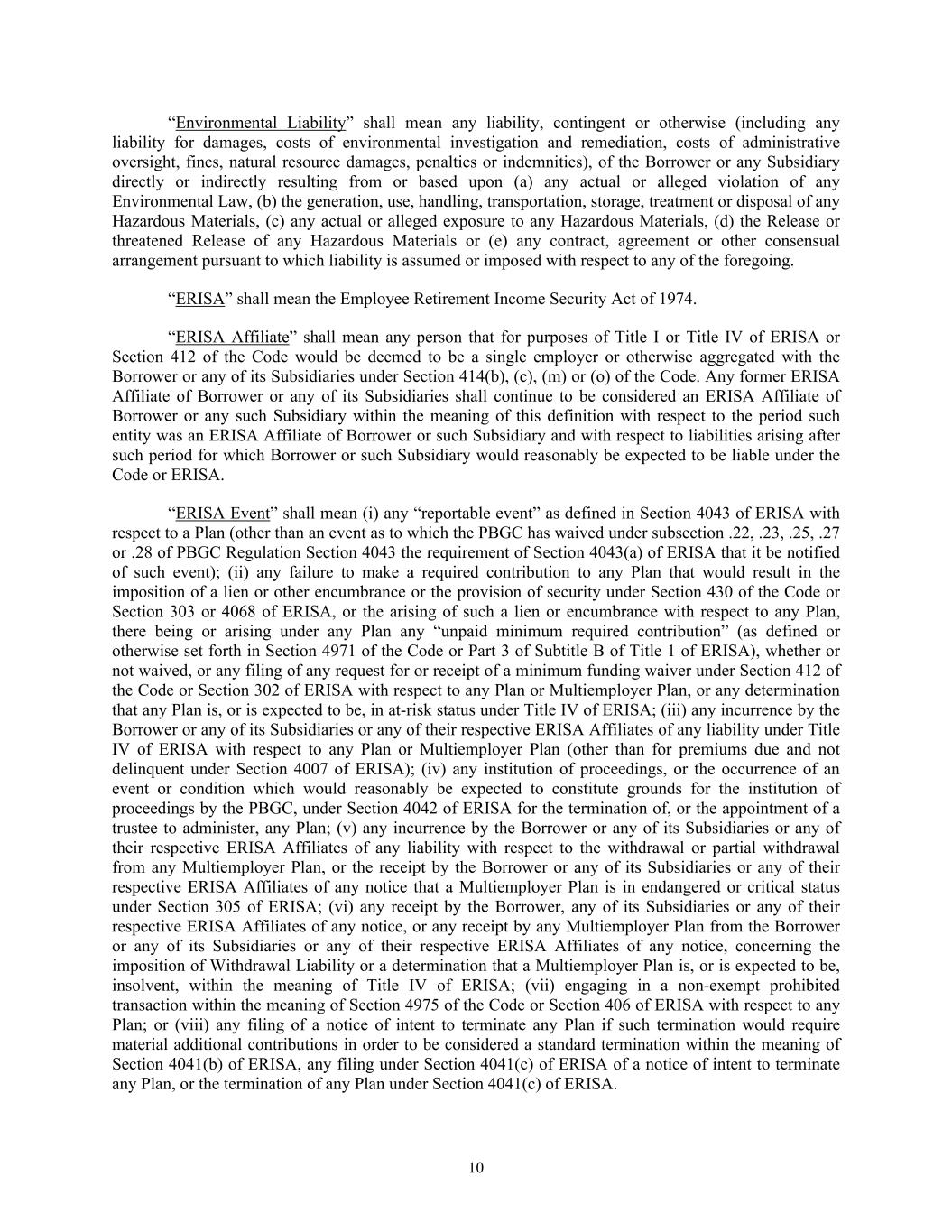
10 “Environmental Liability” shall mean any liability, contingent or otherwise (including any liability for damages, costs of environmental investigation and remediation, costs of administrative oversight, fines, natural resource damages, penalties or indemnities), of the Borrower or any Subsidiary directly or indirectly resulting from or based upon (a) any actual or alleged violation of any Environmental Law, (b) the generation, use, handling, transportation, storage, treatment or disposal of any Hazardous Materials, (c) any actual or alleged exposure to any Hazardous Materials, (d) the Release or threatened Release of any Hazardous Materials or (e) any contract, agreement or other consensual arrangement pursuant to which liability is assumed or imposed with respect to any of the foregoing. “ERISA” shall mean the Employee Retirement Income Security Act of 1974. “ERISA Affiliate” shall mean any person that for purposes of Title I or Title IV of ERISA or Section 412 of the Code would be deemed to be a single employer or otherwise aggregated with the Borrower or any of its Subsidiaries under Section 414(b), (c), (m) or (o) of the Code. Any former ERISA Affiliate of Borrower or any of its Subsidiaries shall continue to be considered an ERISA Affiliate of Borrower or any such Subsidiary within the meaning of this definition with respect to the period such entity was an ERISA Affiliate of Borrower or such Subsidiary and with respect to liabilities arising after such period for which Borrower or such Subsidiary would reasonably be expected to be liable under the Code or ERISA. “ERISA Event” shall mean (i) any “reportable event” as defined in Section 4043 of ERISA with respect to a Plan (other than an event as to which the PBGC has waived under subsection .22, .23, .25, .27 or .28 of PBGC Regulation Section 4043 the requirement of Section 4043(a) of ERISA that it be notified of such event); (ii) any failure to make a required contribution to any Plan that would result in the imposition of a lien or other encumbrance or the provision of security under Section 430 of the Code or Section 303 or 4068 of ERISA, or the arising of such a lien or encumbrance with respect to any Plan, there being or arising under any Plan any “unpaid minimum required contribution” (as defined or otherwise set forth in Section 4971 of the Code or Part 3 of Subtitle B of Title 1 of ERISA), whether or not waived, or any filing of any request for or receipt of a minimum funding waiver under Section 412 of the Code or Section 302 of ERISA with respect to any Plan or Multiemployer Plan, or any determination that any Plan is, or is expected to be, in at-risk status under Title IV of ERISA; (iii) any incurrence by the Borrower or any of its Subsidiaries or any of their respective ERISA Affiliates of any liability under Title IV of ERISA with respect to any Plan or Multiemployer Plan (other than for premiums due and not delinquent under Section 4007 of ERISA); (iv) any institution of proceedings, or the occurrence of an event or condition which would reasonably be expected to constitute grounds for the institution of proceedings by the PBGC, under Section 4042 of ERISA for the termination of, or the appointment of a trustee to administer, any Plan; (v) any incurrence by the Borrower or any of its Subsidiaries or any of their respective ERISA Affiliates of any liability with respect to the withdrawal or partial withdrawal from any Multiemployer Plan, or the receipt by the Borrower or any of its Subsidiaries or any of their respective ERISA Affiliates of any notice that a Multiemployer Plan is in endangered or critical status under Section 305 of ERISA; (vi) any receipt by the Borrower, any of its Subsidiaries or any of their respective ERISA Affiliates of any notice, or any receipt by any Multiemployer Plan from the Borrower or any of its Subsidiaries or any of their respective ERISA Affiliates of any notice, concerning the imposition of Withdrawal Liability or a determination that a Multiemployer Plan is, or is expected to be, insolvent, within the meaning of Title IV of ERISA; (vii) engaging in a non-exempt prohibited transaction within the meaning of Section 4975 of the Code or Section 406 of ERISA with respect to any Plan; or (viii) any filing of a notice of intent to terminate any Plan if such termination would require material additional contributions in order to be considered a standard termination within the meaning of Section 4041(b) of ERISA, any filing under Section 4041(c) of ERISA of a notice of intent to terminate any Plan, or the termination of any Plan under Section 4041(c) of ERISA.
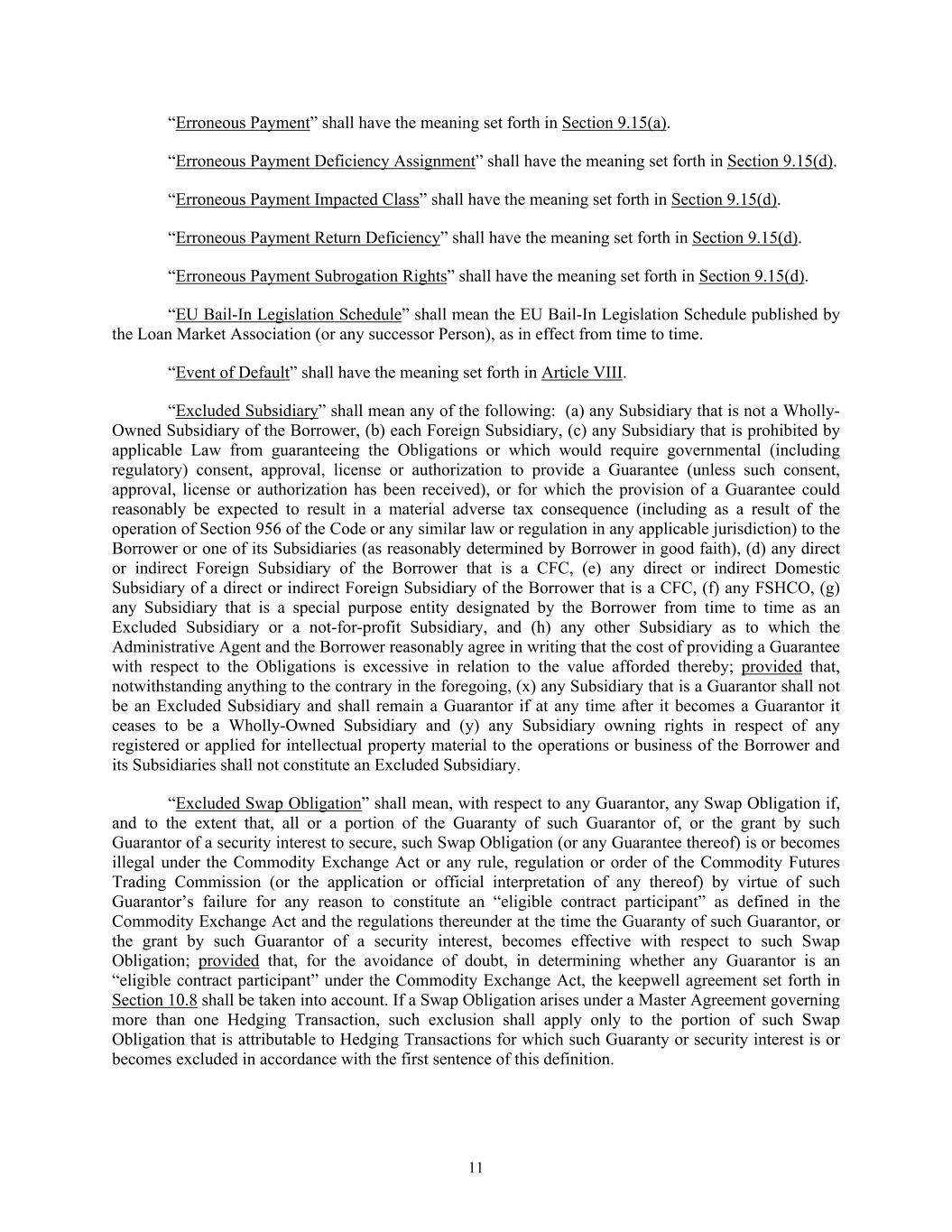
11 “Erroneous Payment” shall have the meaning set forth in Section 9.15(a). “Erroneous Payment Deficiency Assignment” shall have the meaning set forth in Section 9.15(d). “Erroneous Payment Impacted Class” shall have the meaning set forth in Section 9.15(d). “Erroneous Payment Return Deficiency” shall have the meaning set forth in Section 9.15(d). “Erroneous Payment Subrogation Rights” shall have the meaning set forth in Section 9.15(d). “EU Bail-In Legislation Schedule” shall mean the EU Bail-In Legislation Schedule published by the Loan Market Association (or any successor Person), as in effect from time to time. “Event of Default” shall have the meaning set forth in Article VIII. “Excluded Subsidiary” shall mean any of the following: (a) any Subsidiary that is not a Wholly- Owned Subsidiary of the Borrower, (b) each Foreign Subsidiary, (c) any Subsidiary that is prohibited by applicable Law from guaranteeing the Obligations or which would require governmental (including regulatory) consent, approval, license or authorization to provide a Guarantee (unless such consent, approval, license or authorization has been received), or for which the provision of a Guarantee could reasonably be expected to result in a material adverse tax consequence (including as a result of the operation of Section 956 of the Code or any similar law or regulation in any applicable jurisdiction) to the Borrower or one of its Subsidiaries (as reasonably determined by Borrower in good faith), (d) any direct or indirect Foreign Subsidiary of the Borrower that is a CFC, (e) any direct or indirect Domestic Subsidiary of a direct or indirect Foreign Subsidiary of the Borrower that is a CFC, (f) any FSHCO, (g) any Subsidiary that is a special purpose entity designated by the Borrower from time to time as an Excluded Subsidiary or a not-for-profit Subsidiary, and (h) any other Subsidiary as to which the Administrative Agent and the Borrower reasonably agree in writing that the cost of providing a Guarantee with respect to the Obligations is excessive in relation to the value afforded thereby; provided that, notwithstanding anything to the contrary in the foregoing, (x) any Subsidiary that is a Guarantor shall not be an Excluded Subsidiary and shall remain a Guarantor if at any time after it becomes a Guarantor it ceases to be a Wholly-Owned Subsidiary and (y) any Subsidiary owning rights in respect of any registered or applied for intellectual property material to the operations or business of the Borrower and its Subsidiaries shall not constitute an Excluded Subsidiary. “Excluded Swap Obligation” shall mean, with respect to any Guarantor, any Swap Obligation if, and to the extent that, all or a portion of the Guaranty of such Guarantor of, or the grant by such Guarantor of a security interest to secure, such Swap Obligation (or any Guarantee thereof) is or becomes illegal under the Commodity Exchange Act or any rule, regulation or order of the Commodity Futures Trading Commission (or the application or official interpretation of any thereof) by virtue of such Guarantor’s failure for any reason to constitute an “eligible contract participant” as defined in the Commodity Exchange Act and the regulations thereunder at the time the Guaranty of such Guarantor, or the grant by such Guarantor of a security interest, becomes effective with respect to such Swap Obligation; provided that, for the avoidance of doubt, in determining whether any Guarantor is an “eligible contract participant” under the Commodity Exchange Act, the keepwell agreement set forth in Section 10.8 shall be taken into account. If a Swap Obligation arises under a Master Agreement governing more than one Hedging Transaction, such exclusion shall apply only to the portion of such Swap Obligation that is attributable to Hedging Transactions for which such Guaranty or security interest is or becomes excluded in accordance with the first sentence of this definition.
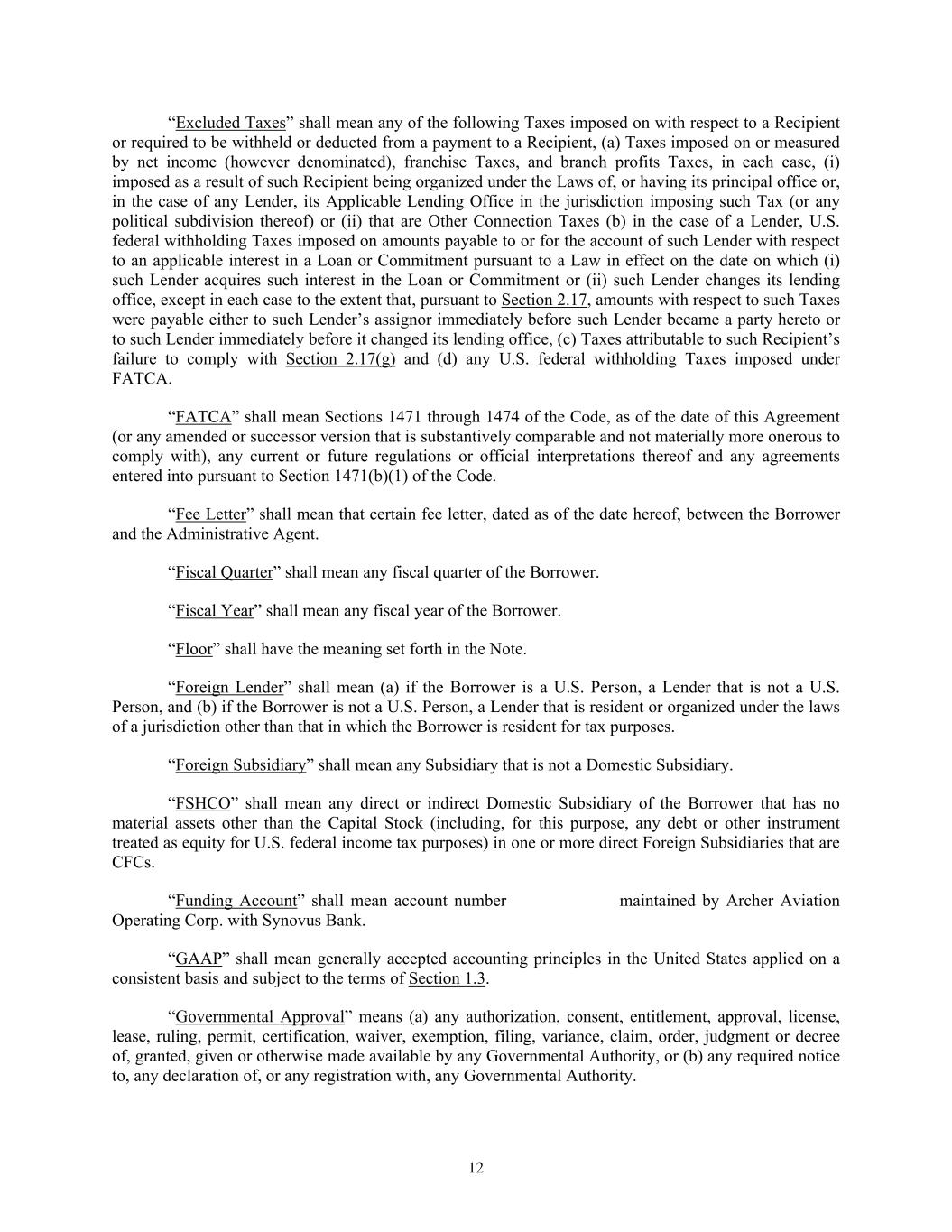
12 “Excluded Taxes” shall mean any of the following Taxes imposed on with respect to a Recipient or required to be withheld or deducted from a payment to a Recipient, (a) Taxes imposed on or measured by net income (however denominated), franchise Taxes, and branch profits Taxes, in each case, (i) imposed as a result of such Recipient being organized under the Laws of, or having its principal office or, in the case of any Lender, its Applicable Lending Office in the jurisdiction imposing such Tax (or any political subdivision thereof) or (ii) that are Other Connection Taxes (b) in the case of a Lender, U.S. federal withholding Taxes imposed on amounts payable to or for the account of such Lender with respect to an applicable interest in a Loan or Commitment pursuant to a Law in effect on the date on which (i) such Lender acquires such interest in the Loan or Commitment or (ii) such Lender changes its lending office, except in each case to the extent that, pursuant to Section 2.17, amounts with respect to such Taxes were payable either to such Lender’s assignor immediately before such Lender became a party hereto or to such Lender immediately before it changed its lending office, (c) Taxes attributable to such Recipient’s failure to comply with Section 2.17(g) and (d) any U.S. federal withholding Taxes imposed under FATCA. “FATCA” shall mean Sections 1471 through 1474 of the Code, as of the date of this Agreement (or any amended or successor version that is substantively comparable and not materially more onerous to comply with), any current or future regulations or official interpretations thereof and any agreements entered into pursuant to Section 1471(b)(1) of the Code. “Fee Letter” shall mean that certain fee letter, dated as of the date hereof, between the Borrower and the Administrative Agent. “Fiscal Quarter” shall mean any fiscal quarter of the Borrower. “Fiscal Year” shall mean any fiscal year of the Borrower. “Floor” shall have the meaning set forth in the Note. “Foreign Lender” shall mean (a) if the Borrower is a U.S. Person, a Lender that is not a U.S. Person, and (b) if the Borrower is not a U.S. Person, a Lender that is resident or organized under the laws of a jurisdiction other than that in which the Borrower is resident for tax purposes. “Foreign Subsidiary” shall mean any Subsidiary that is not a Domestic Subsidiary. “FSHCO” shall mean any direct or indirect Domestic Subsidiary of the Borrower that has no material assets other than the Capital Stock (including, for this purpose, any debt or other instrument treated as equity for U.S. federal income tax purposes) in one or more direct Foreign Subsidiaries that are CFCs. “Funding Account” shall mean account number maintained by Archer Aviation Operating Corp. with Synovus Bank. “GAAP” shall mean generally accepted accounting principles in the United States applied on a consistent basis and subject to the terms of Section 1.3. “Governmental Approval” means (a) any authorization, consent, entitlement, approval, license, lease, ruling, permit, certification, waiver, exemption, filing, variance, claim, order, judgment or decree of, granted, given or otherwise made available by any Governmental Authority, or (b) any required notice to, any declaration of, or any registration with, any Governmental Authority.
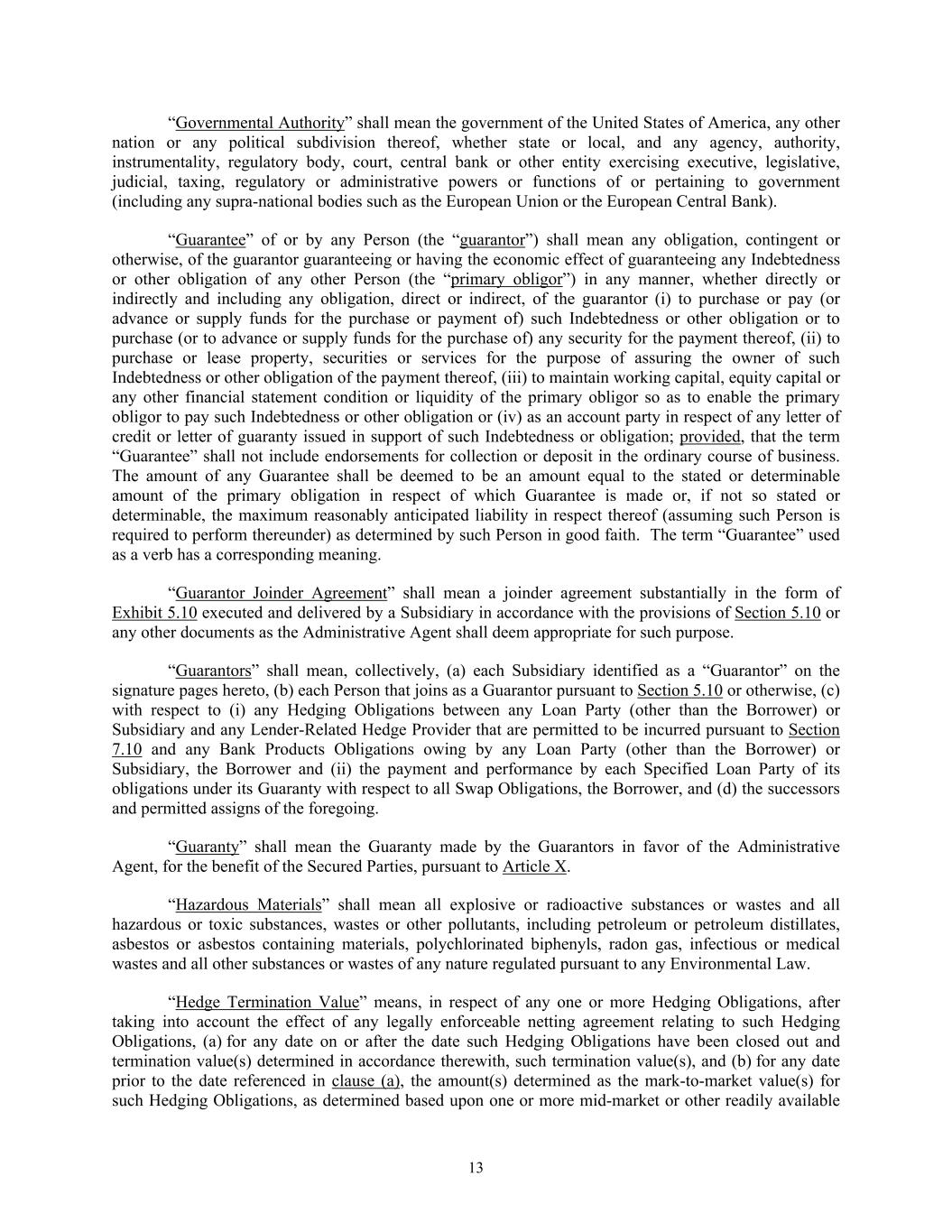
13 “Governmental Authority” shall mean the government of the United States of America, any other nation or any political subdivision thereof, whether state or local, and any agency, authority, instrumentality, regulatory body, court, central bank or other entity exercising executive, legislative, judicial, taxing, regulatory or administrative powers or functions of or pertaining to government (including any supra-national bodies such as the European Union or the European Central Bank). “Guarantee” of or by any Person (the “guarantor”) shall mean any obligation, contingent or otherwise, of the guarantor guaranteeing or having the economic effect of guaranteeing any Indebtedness or other obligation of any other Person (the “primary obligor”) in any manner, whether directly or indirectly and including any obligation, direct or indirect, of the guarantor (i) to purchase or pay (or advance or supply funds for the purchase or payment of) such Indebtedness or other obligation or to purchase (or to advance or supply funds for the purchase of) any security for the payment thereof, (ii) to purchase or lease property, securities or services for the purpose of assuring the owner of such Indebtedness or other obligation of the payment thereof, (iii) to maintain working capital, equity capital or any other financial statement condition or liquidity of the primary obligor so as to enable the primary obligor to pay such Indebtedness or other obligation or (iv) as an account party in respect of any letter of credit or letter of guaranty issued in support of such Indebtedness or obligation; provided, that the term “Guarantee” shall not include endorsements for collection or deposit in the ordinary course of business. The amount of any Guarantee shall be deemed to be an amount equal to the stated or determinable amount of the primary obligation in respect of which Guarantee is made or, if not so stated or determinable, the maximum reasonably anticipated liability in respect thereof (assuming such Person is required to perform thereunder) as determined by such Person in good faith. The term “Guarantee” used as a verb has a corresponding meaning. “Guarantor Joinder Agreement” shall mean a joinder agreement substantially in the form of Exhibit 5.10 executed and delivered by a Subsidiary in accordance with the provisions of Section 5.10 or any other documents as the Administrative Agent shall deem appropriate for such purpose. “Guarantors” shall mean, collectively, (a) each Subsidiary identified as a “Guarantor” on the signature pages hereto, (b) each Person that joins as a Guarantor pursuant to Section 5.10 or otherwise, (c) with respect to (i) any Hedging Obligations between any Loan Party (other than the Borrower) or Subsidiary and any Lender-Related Hedge Provider that are permitted to be incurred pursuant to Section 7.10 and any Bank Products Obligations owing by any Loan Party (other than the Borrower) or Subsidiary, the Borrower and (ii) the payment and performance by each Specified Loan Party of its obligations under its Guaranty with respect to all Swap Obligations, the Borrower, and (d) the successors and permitted assigns of the foregoing. “Guaranty” shall mean the Guaranty made by the Guarantors in favor of the Administrative Agent, for the benefit of the Secured Parties, pursuant to Article X. “Hazardous Materials” shall mean all explosive or radioactive substances or wastes and all hazardous or toxic substances, wastes or other pollutants, including petroleum or petroleum distillates, asbestos or asbestos containing materials, polychlorinated biphenyls, radon gas, infectious or medical wastes and all other substances or wastes of any nature regulated pursuant to any Environmental Law. “Hedge Termination Value” means, in respect of any one or more Hedging Obligations, after taking into account the effect of any legally enforceable netting agreement relating to such Hedging Obligations, (a) for any date on or after the date such Hedging Obligations have been closed out and termination value(s) determined in accordance therewith, such termination value(s), and (b) for any date prior to the date referenced in clause (a), the amount(s) determined as the mark-to-market value(s) for such Hedging Obligations, as determined based upon one or more mid-market or other readily available
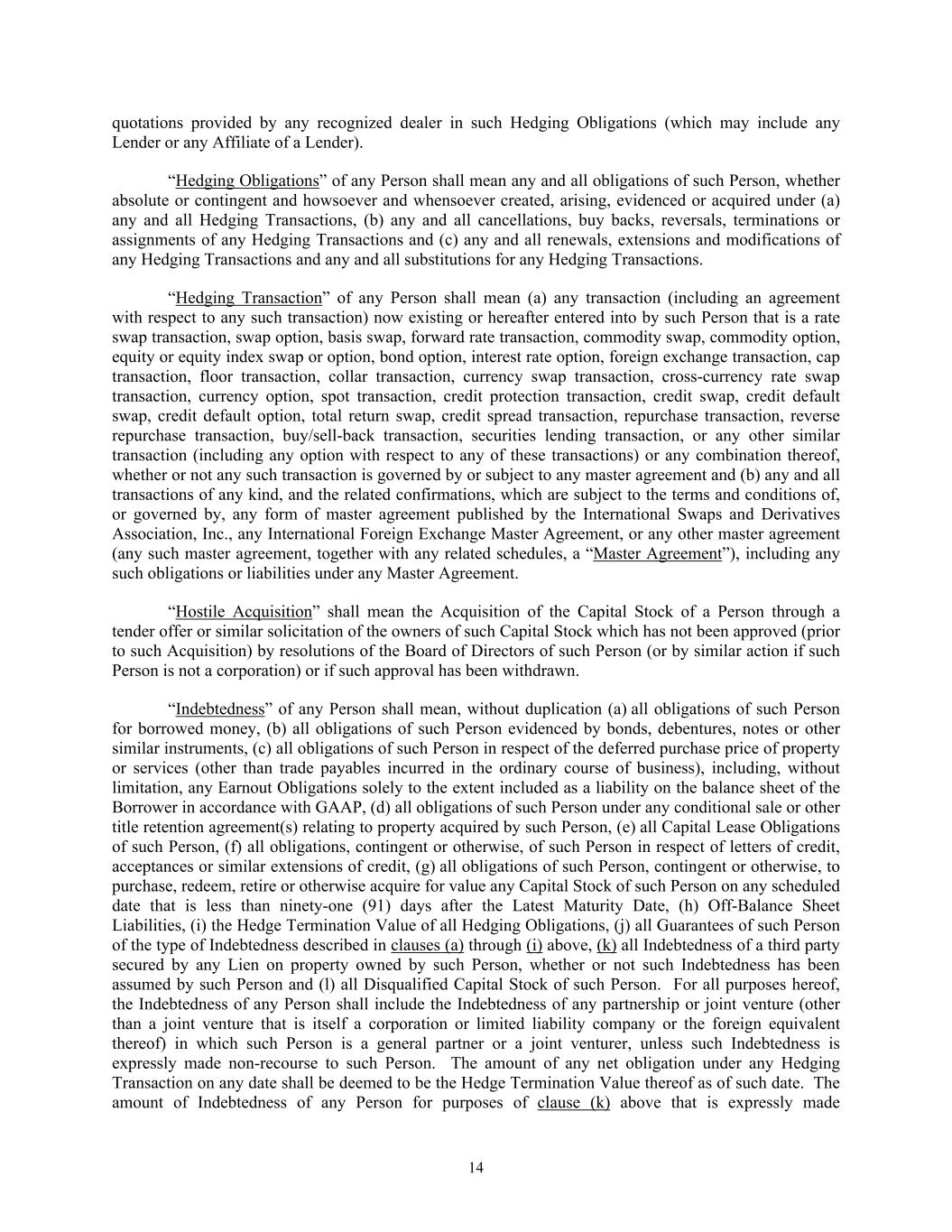
14 quotations provided by any recognized dealer in such Hedging Obligations (which may include any Lender or any Affiliate of a Lender). “Hedging Obligations” of any Person shall mean any and all obligations of such Person, whether absolute or contingent and howsoever and whensoever created, arising, evidenced or acquired under (a) any and all Hedging Transactions, (b) any and all cancellations, buy backs, reversals, terminations or assignments of any Hedging Transactions and (c) any and all renewals, extensions and modifications of any Hedging Transactions and any and all substitutions for any Hedging Transactions. “Hedging Transaction” of any Person shall mean (a) any transaction (including an agreement with respect to any such transaction) now existing or hereafter entered into by such Person that is a rate swap transaction, swap option, basis swap, forward rate transaction, commodity swap, commodity option, equity or equity index swap or option, bond option, interest rate option, foreign exchange transaction, cap transaction, floor transaction, collar transaction, currency swap transaction, cross-currency rate swap transaction, currency option, spot transaction, credit protection transaction, credit swap, credit default swap, credit default option, total return swap, credit spread transaction, repurchase transaction, reverse repurchase transaction, buy/sell-back transaction, securities lending transaction, or any other similar transaction (including any option with respect to any of these transactions) or any combination thereof, whether or not any such transaction is governed by or subject to any master agreement and (b) any and all transactions of any kind, and the related confirmations, which are subject to the terms and conditions of, or governed by, any form of master agreement published by the International Swaps and Derivatives Association, Inc., any International Foreign Exchange Master Agreement, or any other master agreement (any such master agreement, together with any related schedules, a “Master Agreement”), including any such obligations or liabilities under any Master Agreement. “Hostile Acquisition” shall mean the Acquisition of the Capital Stock of a Person through a tender offer or similar solicitation of the owners of such Capital Stock which has not been approved (prior to such Acquisition) by resolutions of the Board of Directors of such Person (or by similar action if such Person is not a corporation) or if such approval has been withdrawn. “Indebtedness” of any Person shall mean, without duplication (a) all obligations of such Person for borrowed money, (b) all obligations of such Person evidenced by bonds, debentures, notes or other similar instruments, (c) all obligations of such Person in respect of the deferred purchase price of property or services (other than trade payables incurred in the ordinary course of business), including, without limitation, any Earnout Obligations solely to the extent included as a liability on the balance sheet of the Borrower in accordance with GAAP, (d) all obligations of such Person under any conditional sale or other title retention agreement(s) relating to property acquired by such Person, (e) all Capital Lease Obligations of such Person, (f) all obligations, contingent or otherwise, of such Person in respect of letters of credit, acceptances or similar extensions of credit, (g) all obligations of such Person, contingent or otherwise, to purchase, redeem, retire or otherwise acquire for value any Capital Stock of such Person on any scheduled date that is less than ninety-one (91) days after the Latest Maturity Date, (h) Off-Balance Sheet Liabilities, (i) the Hedge Termination Value of all Hedging Obligations, (j) all Guarantees of such Person of the type of Indebtedness described in clauses (a) through (i) above, (k) all Indebtedness of a third party secured by any Lien on property owned by such Person, whether or not such Indebtedness has been assumed by such Person and (l) all Disqualified Capital Stock of such Person. For all purposes hereof, the Indebtedness of any Person shall include the Indebtedness of any partnership or joint venture (other than a joint venture that is itself a corporation or limited liability company or the foreign equivalent thereof) in which such Person is a general partner or a joint venturer, unless such Indebtedness is expressly made non-recourse to such Person. The amount of any net obligation under any Hedging Transaction on any date shall be deemed to be the Hedge Termination Value thereof as of such date. The amount of Indebtedness of any Person for purposes of clause (k) above that is expressly made
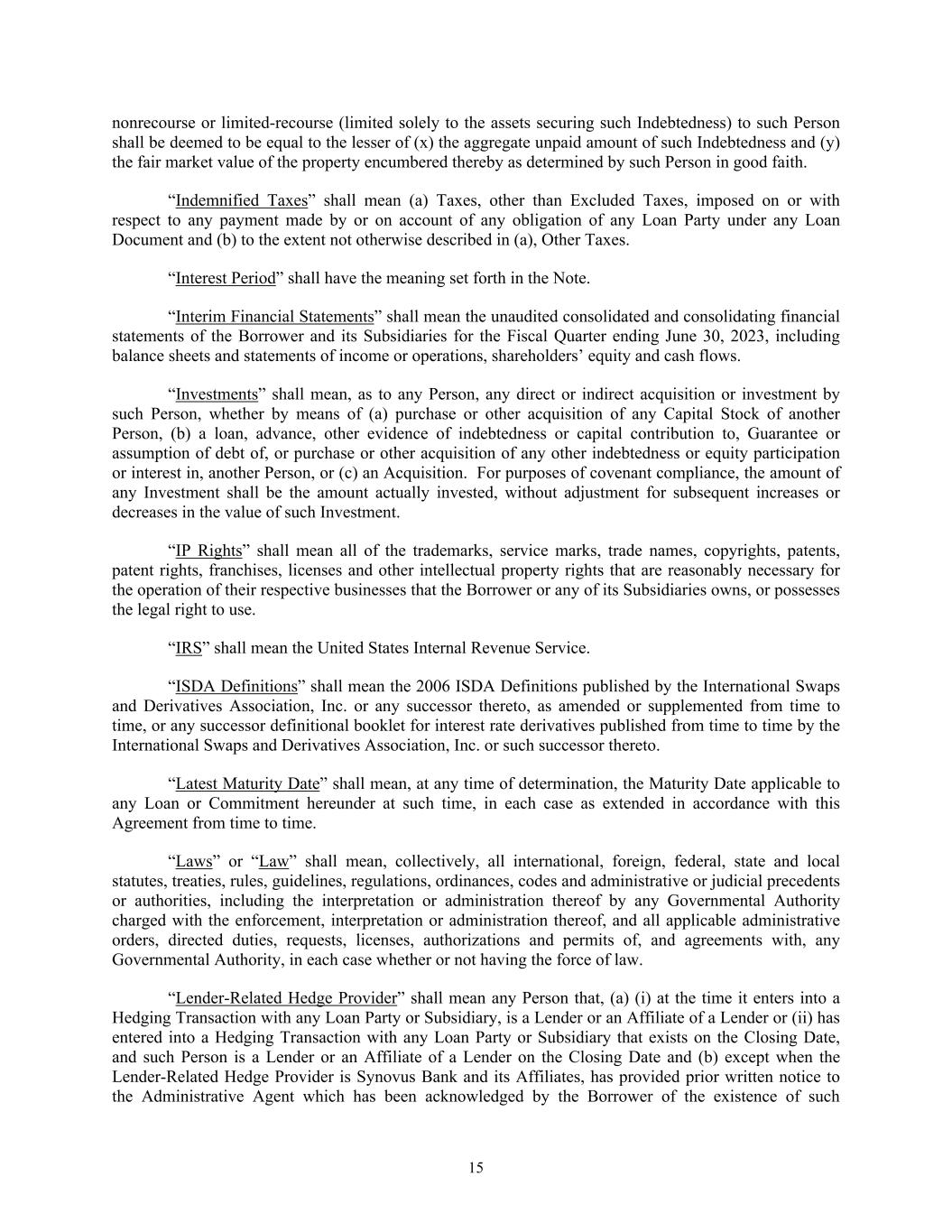
15 nonrecourse or limited-recourse (limited solely to the assets securing such Indebtedness) to such Person shall be deemed to be equal to the lesser of (x) the aggregate unpaid amount of such Indebtedness and (y) the fair market value of the property encumbered thereby as determined by such Person in good faith. “Indemnified Taxes” shall mean (a) Taxes, other than Excluded Taxes, imposed on or with respect to any payment made by or on account of any obligation of any Loan Party under any Loan Document and (b) to the extent not otherwise described in (a), Other Taxes. “Interest Period” shall have the meaning set forth in the Note. “Interim Financial Statements” shall mean the unaudited consolidated and consolidating financial statements of the Borrower and its Subsidiaries for the Fiscal Quarter ending June 30, 2023, including balance sheets and statements of income or operations, shareholders’ equity and cash flows. “Investments” shall mean, as to any Person, any direct or indirect acquisition or investment by such Person, whether by means of (a) purchase or other acquisition of any Capital Stock of another Person, (b) a loan, advance, other evidence of indebtedness or capital contribution to, Guarantee or assumption of debt of, or purchase or other acquisition of any other indebtedness or equity participation or interest in, another Person, or (c) an Acquisition. For purposes of covenant compliance, the amount of any Investment shall be the amount actually invested, without adjustment for subsequent increases or decreases in the value of such Investment. “IP Rights” shall mean all of the trademarks, service marks, trade names, copyrights, patents, patent rights, franchises, licenses and other intellectual property rights that are reasonably necessary for the operation of their respective businesses that the Borrower or any of its Subsidiaries owns, or possesses the legal right to use. “IRS” shall mean the United States Internal Revenue Service. “ISDA Definitions” shall mean the 2006 ISDA Definitions published by the International Swaps and Derivatives Association, Inc. or any successor thereto, as amended or supplemented from time to time, or any successor definitional booklet for interest rate derivatives published from time to time by the International Swaps and Derivatives Association, Inc. or such successor thereto. “Latest Maturity Date” shall mean, at any time of determination, the Maturity Date applicable to any Loan or Commitment hereunder at such time, in each case as extended in accordance with this Agreement from time to time. “Laws” or “Law” shall mean, collectively, all international, foreign, federal, state and local statutes, treaties, rules, guidelines, regulations, ordinances, codes and administrative or judicial precedents or authorities, including the interpretation or administration thereof by any Governmental Authority charged with the enforcement, interpretation or administration thereof, and all applicable administrative orders, directed duties, requests, licenses, authorizations and permits of, and agreements with, any Governmental Authority, in each case whether or not having the force of law. “Lender-Related Hedge Provider” shall mean any Person that, (a) (i) at the time it enters into a Hedging Transaction with any Loan Party or Subsidiary, is a Lender or an Affiliate of a Lender or (ii) has entered into a Hedging Transaction with any Loan Party or Subsidiary that exists on the Closing Date, and such Person is a Lender or an Affiliate of a Lender on the Closing Date and (b) except when the Lender-Related Hedge Provider is Synovus Bank and its Affiliates, has provided prior written notice to the Administrative Agent which has been acknowledged by the Borrower of the existence of such
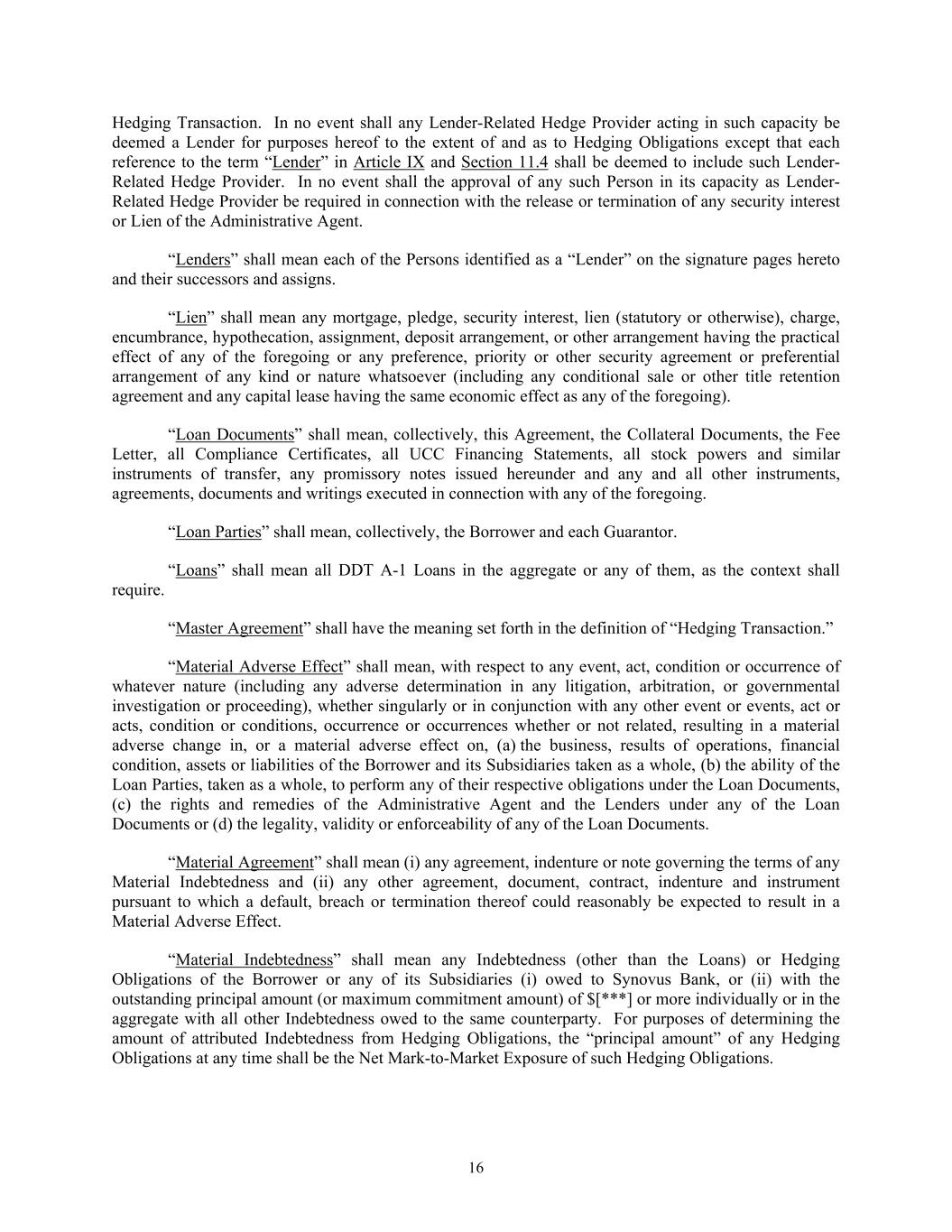
16 Hedging Transaction. In no event shall any Lender-Related Hedge Provider acting in such capacity be deemed a Lender for purposes hereof to the extent of and as to Hedging Obligations except that each reference to the term “Lender” in Article IX and Section 11.4 shall be deemed to include such Lender- Related Hedge Provider. In no event shall the approval of any such Person in its capacity as Lender- Related Hedge Provider be required in connection with the release or termination of any security interest or Lien of the Administrative Agent. “Lenders” shall mean each of the Persons identified as a “Lender” on the signature pages hereto and their successors and assigns. “Lien” shall mean any mortgage, pledge, security interest, lien (statutory or otherwise), charge, encumbrance, hypothecation, assignment, deposit arrangement, or other arrangement having the practical effect of any of the foregoing or any preference, priority or other security agreement or preferential arrangement of any kind or nature whatsoever (including any conditional sale or other title retention agreement and any capital lease having the same economic effect as any of the foregoing). “Loan Documents” shall mean, collectively, this Agreement, the Collateral Documents, the Fee Letter, all Compliance Certificates, all UCC Financing Statements, all stock powers and similar instruments of transfer, any promissory notes issued hereunder and any and all other instruments, agreements, documents and writings executed in connection with any of the foregoing. “Loan Parties” shall mean, collectively, the Borrower and each Guarantor. “Loans” shall mean all DDT A-1 Loans in the aggregate or any of them, as the context shall require. “Master Agreement” shall have the meaning set forth in the definition of “Hedging Transaction.” “Material Adverse Effect” shall mean, with respect to any event, act, condition or occurrence of whatever nature (including any adverse determination in any litigation, arbitration, or governmental investigation or proceeding), whether singularly or in conjunction with any other event or events, act or acts, condition or conditions, occurrence or occurrences whether or not related, resulting in a material adverse change in, or a material adverse effect on, (a) the business, results of operations, financial condition, assets or liabilities of the Borrower and its Subsidiaries taken as a whole, (b) the ability of the Loan Parties, taken as a whole, to perform any of their respective obligations under the Loan Documents, (c) the rights and remedies of the Administrative Agent and the Lenders under any of the Loan Documents or (d) the legality, validity or enforceability of any of the Loan Documents. “Material Agreement” shall mean (i) any agreement, indenture or note governing the terms of any Material Indebtedness and (ii) any other agreement, document, contract, indenture and instrument pursuant to which a default, breach or termination thereof could reasonably be expected to result in a Material Adverse Effect. “Material Indebtedness” shall mean any Indebtedness (other than the Loans) or Hedging Obligations of the Borrower or any of its Subsidiaries (i) owed to Synovus Bank, or (ii) with the outstanding principal amount (or maximum commitment amount) of $[***] or more individually or in the aggregate with all other Indebtedness owed to the same counterparty. For purposes of determining the amount of attributed Indebtedness from Hedging Obligations, the “principal amount” of any Hedging Obligations at any time shall be the Net Mark-to-Market Exposure of such Hedging Obligations.
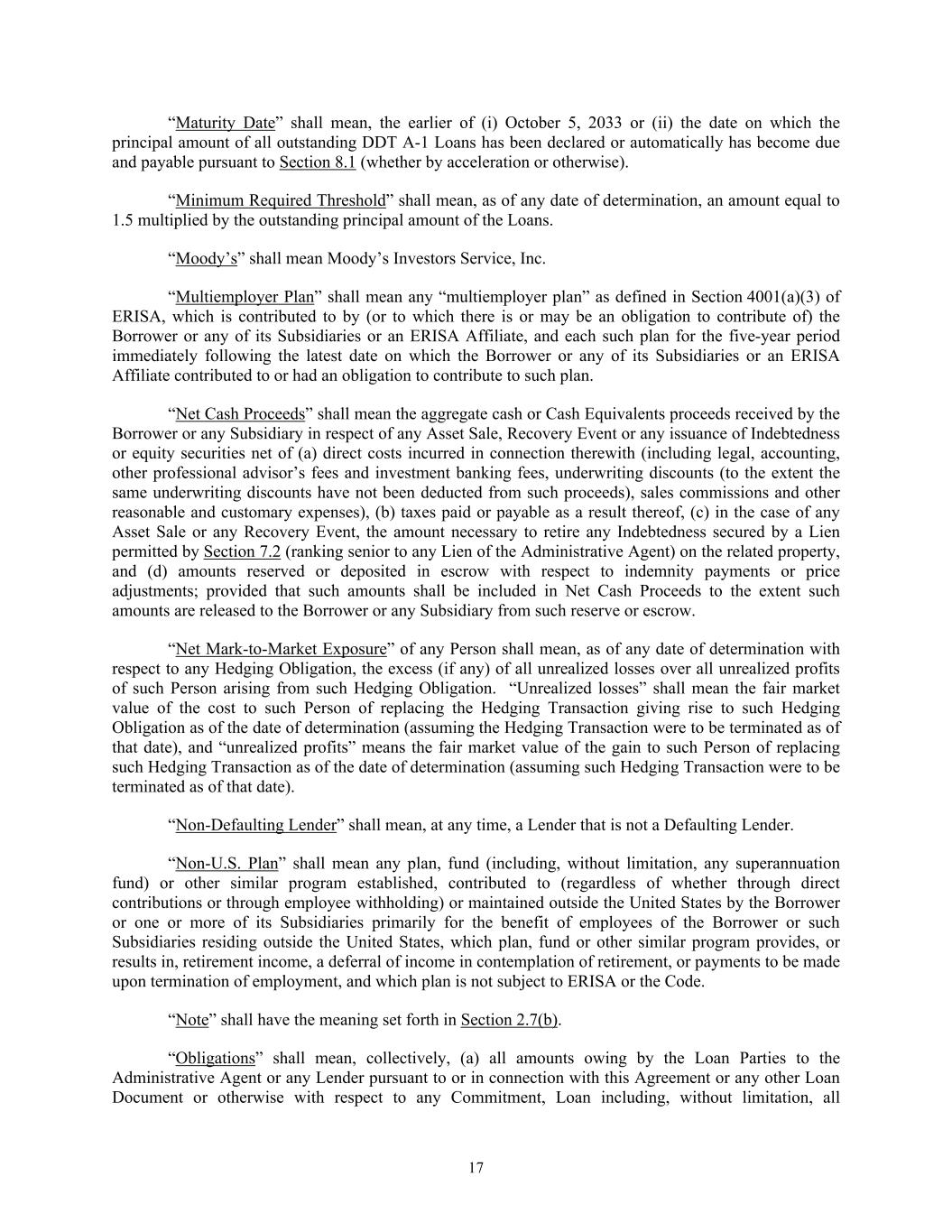
17 “Maturity Date” shall mean, the earlier of (i) October 5, 2033 or (ii) the date on which the principal amount of all outstanding DDT A-1 Loans has been declared or automatically has become due and payable pursuant to Section 8.1 (whether by acceleration or otherwise). “Minimum Required Threshold” shall mean, as of any date of determination, an amount equal to 1.5 multiplied by the outstanding principal amount of the Loans. “Moody’s” shall mean Moody’s Investors Service, Inc. “Multiemployer Plan” shall mean any “multiemployer plan” as defined in Section 4001(a)(3) of ERISA, which is contributed to by (or to which there is or may be an obligation to contribute of) the Borrower or any of its Subsidiaries or an ERISA Affiliate, and each such plan for the five-year period immediately following the latest date on which the Borrower or any of its Subsidiaries or an ERISA Affiliate contributed to or had an obligation to contribute to such plan. “Net Cash Proceeds” shall mean the aggregate cash or Cash Equivalents proceeds received by the Borrower or any Subsidiary in respect of any Asset Sale, Recovery Event or any issuance of Indebtedness or equity securities net of (a) direct costs incurred in connection therewith (including legal, accounting, other professional advisor’s fees and investment banking fees, underwriting discounts (to the extent the same underwriting discounts have not been deducted from such proceeds), sales commissions and other reasonable and customary expenses), (b) taxes paid or payable as a result thereof, (c) in the case of any Asset Sale or any Recovery Event, the amount necessary to retire any Indebtedness secured by a Lien permitted by Section 7.2 (ranking senior to any Lien of the Administrative Agent) on the related property, and (d) amounts reserved or deposited in escrow with respect to indemnity payments or price adjustments; provided that such amounts shall be included in Net Cash Proceeds to the extent such amounts are released to the Borrower or any Subsidiary from such reserve or escrow. “Net Mark-to-Market Exposure” of any Person shall mean, as of any date of determination with respect to any Hedging Obligation, the excess (if any) of all unrealized losses over all unrealized profits of such Person arising from such Hedging Obligation. “Unrealized losses” shall mean the fair market value of the cost to such Person of replacing the Hedging Transaction giving rise to such Hedging Obligation as of the date of determination (assuming the Hedging Transaction were to be terminated as of that date), and “unrealized profits” means the fair market value of the gain to such Person of replacing such Hedging Transaction as of the date of determination (assuming such Hedging Transaction were to be terminated as of that date). “Non-Defaulting Lender” shall mean, at any time, a Lender that is not a Defaulting Lender. “Non-U.S. Plan” shall mean any plan, fund (including, without limitation, any superannuation fund) or other similar program established, contributed to (regardless of whether through direct contributions or through employee withholding) or maintained outside the United States by the Borrower or one or more of its Subsidiaries primarily for the benefit of employees of the Borrower or such Subsidiaries residing outside the United States, which plan, fund or other similar program provides, or results in, retirement income, a deferral of income in contemplation of retirement, or payments to be made upon termination of employment, and which plan is not subject to ERISA or the Code. “Note” shall have the meaning set forth in Section 2.7(b). “Obligations” shall mean, collectively, (a) all amounts owing by the Loan Parties to the Administrative Agent or any Lender pursuant to or in connection with this Agreement or any other Loan Document or otherwise with respect to any Commitment, Loan including, without limitation, all
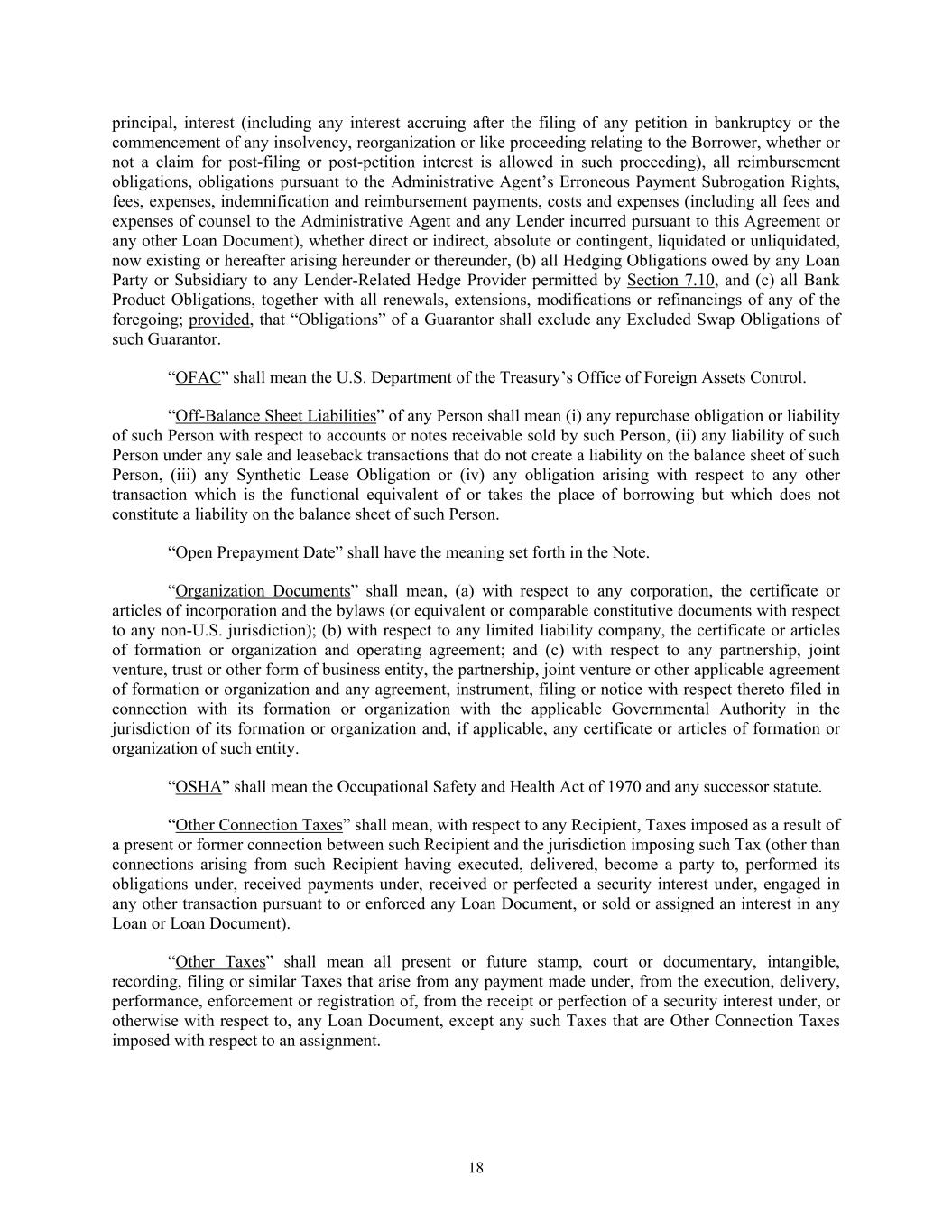
18 principal, interest (including any interest accruing after the filing of any petition in bankruptcy or the commencement of any insolvency, reorganization or like proceeding relating to the Borrower, whether or not a claim for post-filing or post-petition interest is allowed in such proceeding), all reimbursement obligations, obligations pursuant to the Administrative Agent’s Erroneous Payment Subrogation Rights, fees, expenses, indemnification and reimbursement payments, costs and expenses (including all fees and expenses of counsel to the Administrative Agent and any Lender incurred pursuant to this Agreement or any other Loan Document), whether direct or indirect, absolute or contingent, liquidated or unliquidated, now existing or hereafter arising hereunder or thereunder, (b) all Hedging Obligations owed by any Loan Party or Subsidiary to any Lender-Related Hedge Provider permitted by Section 7.10, and (c) all Bank Product Obligations, together with all renewals, extensions, modifications or refinancings of any of the foregoing; provided, that “Obligations” of a Guarantor shall exclude any Excluded Swap Obligations of such Guarantor. “OFAC” shall mean the U.S. Department of the Treasury’s Office of Foreign Assets Control. “Off-Balance Sheet Liabilities” of any Person shall mean (i) any repurchase obligation or liability of such Person with respect to accounts or notes receivable sold by such Person, (ii) any liability of such Person under any sale and leaseback transactions that do not create a liability on the balance sheet of such Person, (iii) any Synthetic Lease Obligation or (iv) any obligation arising with respect to any other transaction which is the functional equivalent of or takes the place of borrowing but which does not constitute a liability on the balance sheet of such Person. “Open Prepayment Date” shall have the meaning set forth in the Note. “Organization Documents” shall mean, (a) with respect to any corporation, the certificate or articles of incorporation and the bylaws (or equivalent or comparable constitutive documents with respect to any non-U.S. jurisdiction); (b) with respect to any limited liability company, the certificate or articles of formation or organization and operating agreement; and (c) with respect to any partnership, joint venture, trust or other form of business entity, the partnership, joint venture or other applicable agreement of formation or organization and any agreement, instrument, filing or notice with respect thereto filed in connection with its formation or organization with the applicable Governmental Authority in the jurisdiction of its formation or organization and, if applicable, any certificate or articles of formation or organization of such entity. “OSHA” shall mean the Occupational Safety and Health Act of 1970 and any successor statute. “Other Connection Taxes” shall mean, with respect to any Recipient, Taxes imposed as a result of a present or former connection between such Recipient and the jurisdiction imposing such Tax (other than connections arising from such Recipient having executed, delivered, become a party to, performed its obligations under, received payments under, received or perfected a security interest under, engaged in any other transaction pursuant to or enforced any Loan Document, or sold or assigned an interest in any Loan or Loan Document). “Other Taxes” shall mean all present or future stamp, court or documentary, intangible, recording, filing or similar Taxes that arise from any payment made under, from the execution, delivery, performance, enforcement or registration of, from the receipt or perfection of a security interest under, or otherwise with respect to, any Loan Document, except any such Taxes that are Other Connection Taxes imposed with respect to an assignment.
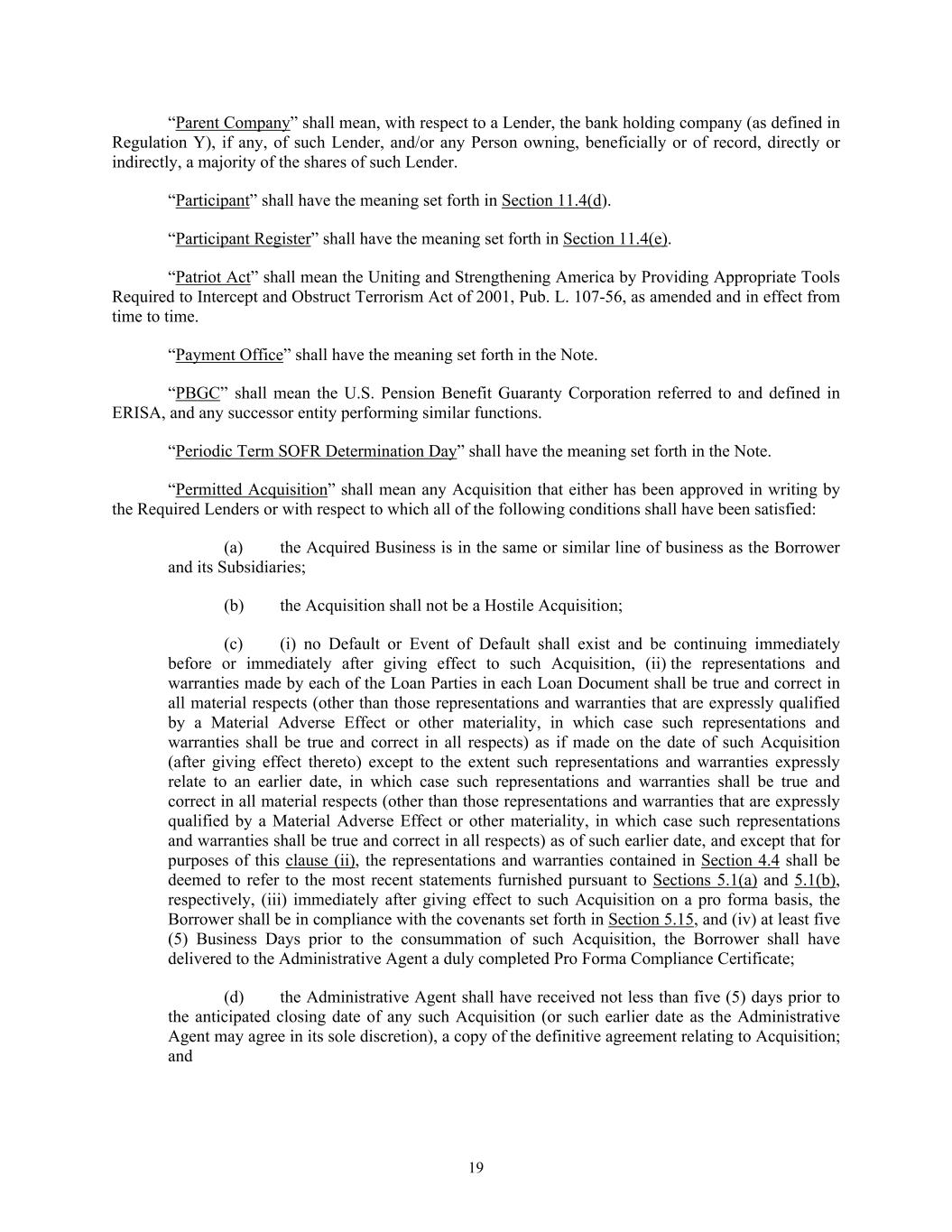
19 “Parent Company” shall mean, with respect to a Lender, the bank holding company (as defined in Regulation Y), if any, of such Lender, and/or any Person owning, beneficially or of record, directly or indirectly, a majority of the shares of such Lender. “Participant” shall have the meaning set forth in Section 11.4(d). “Participant Register” shall have the meaning set forth in Section 11.4(e). “Patriot Act” shall mean the Uniting and Strengthening America by Providing Appropriate Tools Required to Intercept and Obstruct Terrorism Act of 2001, Pub. L. 107-56, as amended and in effect from time to time. “Payment Office” shall have the meaning set forth in the Note. “PBGC” shall mean the U.S. Pension Benefit Guaranty Corporation referred to and defined in ERISA, and any successor entity performing similar functions. “Periodic Term SOFR Determination Day” shall have the meaning set forth in the Note. “Permitted Acquisition” shall mean any Acquisition that either has been approved in writing by the Required Lenders or with respect to which all of the following conditions shall have been satisfied: (a) the Acquired Business is in the same or similar line of business as the Borrower and its Subsidiaries; (b) the Acquisition shall not be a Hostile Acquisition; (c) (i) no Default or Event of Default shall exist and be continuing immediately before or immediately after giving effect to such Acquisition, (ii) the representations and warranties made by each of the Loan Parties in each Loan Document shall be true and correct in all material respects (other than those representations and warranties that are expressly qualified by a Material Adverse Effect or other materiality, in which case such representations and warranties shall be true and correct in all respects) as if made on the date of such Acquisition (after giving effect thereto) except to the extent such representations and warranties expressly relate to an earlier date, in which case such representations and warranties shall be true and correct in all material respects (other than those representations and warranties that are expressly qualified by a Material Adverse Effect or other materiality, in which case such representations and warranties shall be true and correct in all respects) as of such earlier date, and except that for purposes of this clause (ii), the representations and warranties contained in Section 4.4 shall be deemed to refer to the most recent statements furnished pursuant to Sections 5.1(a) and 5.1(b), respectively, (iii) immediately after giving effect to such Acquisition on a pro forma basis, the Borrower shall be in compliance with the covenants set forth in Section 5.15, and (iv) at least five (5) Business Days prior to the consummation of such Acquisition, the Borrower shall have delivered to the Administrative Agent a duly completed Pro Forma Compliance Certificate; (d) the Administrative Agent shall have received not less than five (5) days prior to the anticipated closing date of any such Acquisition (or such earlier date as the Administrative Agent may agree in its sole discretion), a copy of the definitive agreement relating to Acquisition; and
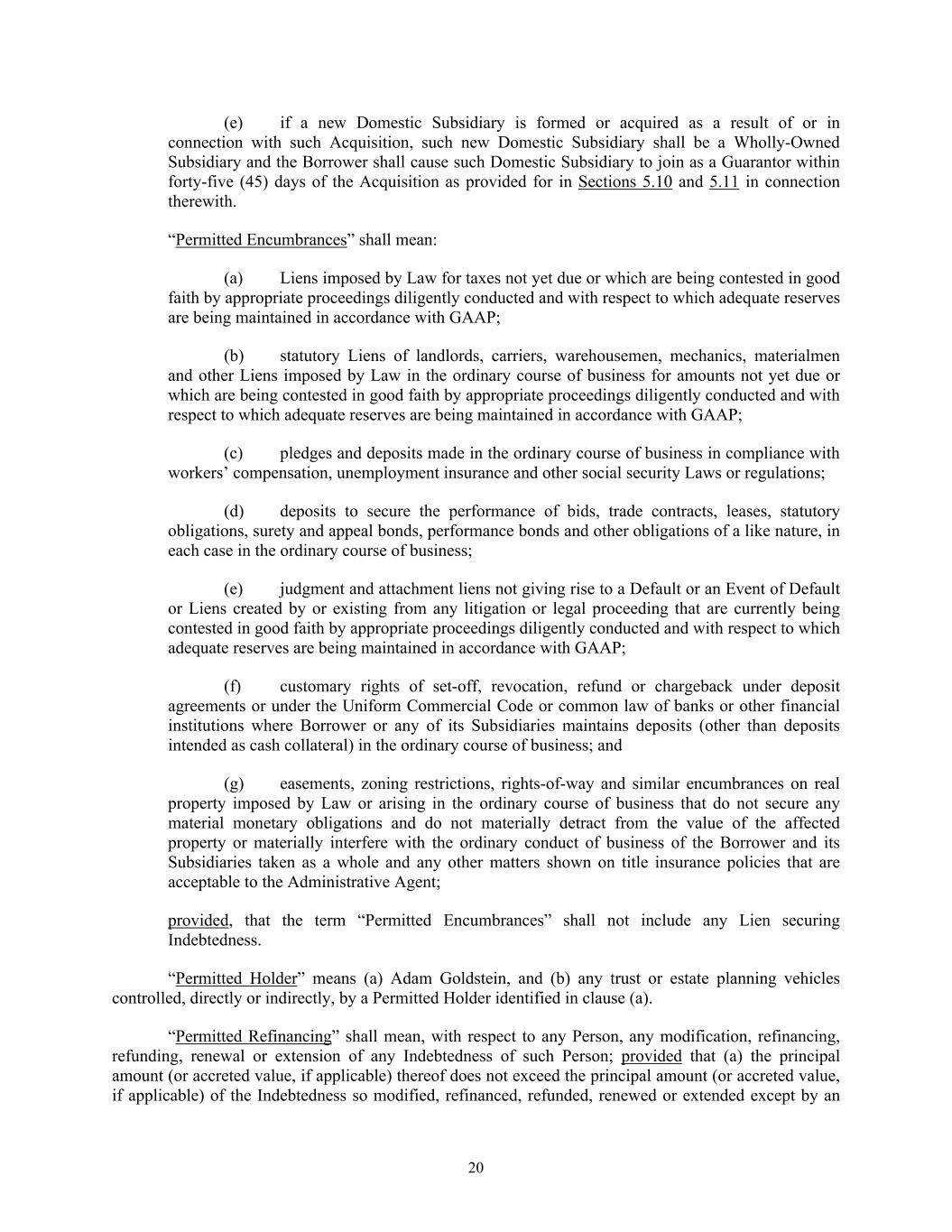
20 (e) if a new Domestic Subsidiary is formed or acquired as a result of or in connection with such Acquisition, such new Domestic Subsidiary shall be a Wholly-Owned Subsidiary and the Borrower shall cause such Domestic Subsidiary to join as a Guarantor within forty-five (45) days of the Acquisition as provided for in Sections 5.10 and 5.11 in connection therewith. “Permitted Encumbrances” shall mean: (a) Liens imposed by Law for taxes not yet due or which are being contested in good faith by appropriate proceedings diligently conducted and with respect to which adequate reserves are being maintained in accordance with GAAP; (b) statutory Liens of landlords, carriers, warehousemen, mechanics, materialmen and other Liens imposed by Law in the ordinary course of business for amounts not yet due or which are being contested in good faith by appropriate proceedings diligently conducted and with respect to which adequate reserves are being maintained in accordance with GAAP; (c) pledges and deposits made in the ordinary course of business in compliance with workers’ compensation, unemployment insurance and other social security Laws or regulations; (d) deposits to secure the performance of bids, trade contracts, leases, statutory obligations, surety and appeal bonds, performance bonds and other obligations of a like nature, in each case in the ordinary course of business; (e) judgment and attachment liens not giving rise to a Default or an Event of Default or Liens created by or existing from any litigation or legal proceeding that are currently being contested in good faith by appropriate proceedings diligently conducted and with respect to which adequate reserves are being maintained in accordance with GAAP; (f) customary rights of set-off, revocation, refund or chargeback under deposit agreements or under the Uniform Commercial Code or common law of banks or other financial institutions where Borrower or any of its Subsidiaries maintains deposits (other than deposits intended as cash collateral) in the ordinary course of business; and (g) easements, zoning restrictions, rights-of-way and similar encumbrances on real property imposed by Law or arising in the ordinary course of business that do not secure any material monetary obligations and do not materially detract from the value of the affected property or materially interfere with the ordinary conduct of business of the Borrower and its Subsidiaries taken as a whole and any other matters shown on title insurance policies that are acceptable to the Administrative Agent; provided, that the term “Permitted Encumbrances” shall not include any Lien securing Indebtedness. “Permitted Holder” means (a) Adam Goldstein, and (b) any trust or estate planning vehicles controlled, directly or indirectly, by a Permitted Holder identified in clause (a). “Permitted Refinancing” shall mean, with respect to any Person, any modification, refinancing, refunding, renewal or extension of any Indebtedness of such Person; provided that (a) the principal amount (or accreted value, if applicable) thereof does not exceed the principal amount (or accreted value, if applicable) of the Indebtedness so modified, refinanced, refunded, renewed or extended except by an
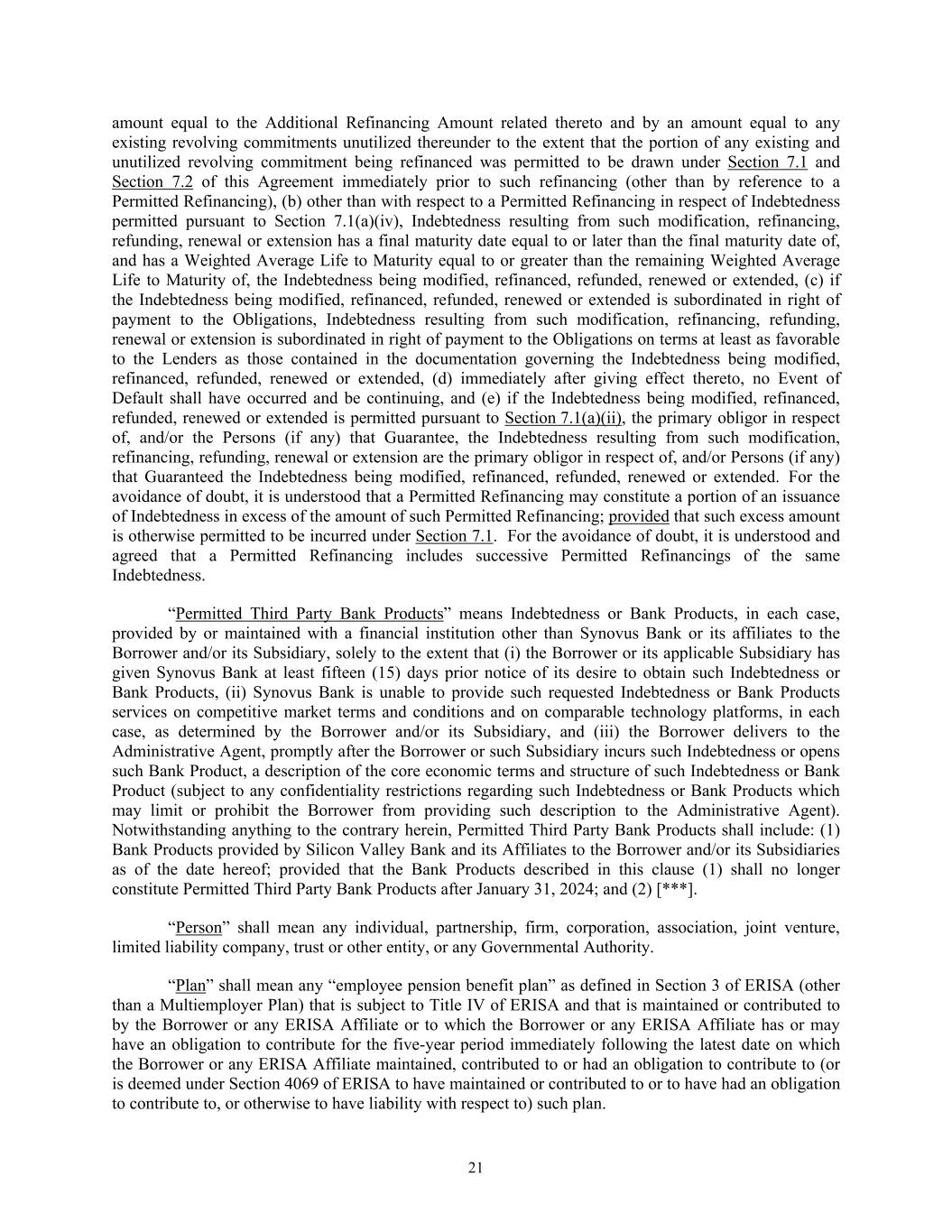
21 amount equal to the Additional Refinancing Amount related thereto and by an amount equal to any existing revolving commitments unutilized thereunder to the extent that the portion of any existing and unutilized revolving commitment being refinanced was permitted to be drawn under Section 7.1 and Section 7.2 of this Agreement immediately prior to such refinancing (other than by reference to a Permitted Refinancing), (b) other than with respect to a Permitted Refinancing in respect of Indebtedness permitted pursuant to Section 7.1(a)(iv), Indebtedness resulting from such modification, refinancing, refunding, renewal or extension has a final maturity date equal to or later than the final maturity date of, and has a Weighted Average Life to Maturity equal to or greater than the remaining Weighted Average Life to Maturity of, the Indebtedness being modified, refinanced, refunded, renewed or extended, (c) if the Indebtedness being modified, refinanced, refunded, renewed or extended is subordinated in right of payment to the Obligations, Indebtedness resulting from such modification, refinancing, refunding, renewal or extension is subordinated in right of payment to the Obligations on terms at least as favorable to the Lenders as those contained in the documentation governing the Indebtedness being modified, refinanced, refunded, renewed or extended, (d) immediately after giving effect thereto, no Event of Default shall have occurred and be continuing, and (e) if the Indebtedness being modified, refinanced, refunded, renewed or extended is permitted pursuant to Section 7.1(a)(ii), the primary obligor in respect of, and/or the Persons (if any) that Guarantee, the Indebtedness resulting from such modification, refinancing, refunding, renewal or extension are the primary obligor in respect of, and/or Persons (if any) that Guaranteed the Indebtedness being modified, refinanced, refunded, renewed or extended. For the avoidance of doubt, it is understood that a Permitted Refinancing may constitute a portion of an issuance of Indebtedness in excess of the amount of such Permitted Refinancing; provided that such excess amount is otherwise permitted to be incurred under Section 7.1. For the avoidance of doubt, it is understood and agreed that a Permitted Refinancing includes successive Permitted Refinancings of the same Indebtedness. “Permitted Third Party Bank Products” means Indebtedness or Bank Products, in each case, provided by or maintained with a financial institution other than Synovus Bank or its affiliates to the Borrower and/or its Subsidiary, solely to the extent that (i) the Borrower or its applicable Subsidiary has given Synovus Bank at least fifteen (15) days prior notice of its desire to obtain such Indebtedness or Bank Products, (ii) Synovus Bank is unable to provide such requested Indebtedness or Bank Products services on competitive market terms and conditions and on comparable technology platforms, in each case, as determined by the Borrower and/or its Subsidiary, and (iii) the Borrower delivers to the Administrative Agent, promptly after the Borrower or such Subsidiary incurs such Indebtedness or opens such Bank Product, a description of the core economic terms and structure of such Indebtedness or Bank Product (subject to any confidentiality restrictions regarding such Indebtedness or Bank Products which may limit or prohibit the Borrower from providing such description to the Administrative Agent). Notwithstanding anything to the contrary herein, Permitted Third Party Bank Products shall include: (1) Bank Products provided by Silicon Valley Bank and its Affiliates to the Borrower and/or its Subsidiaries as of the date hereof; provided that the Bank Products described in this clause (1) shall no longer constitute Permitted Third Party Bank Products after January 31, 2024; and (2) [***]. “Person” shall mean any individual, partnership, firm, corporation, association, joint venture, limited liability company, trust or other entity, or any Governmental Authority. “Plan” shall mean any “employee pension benefit plan” as defined in Section 3 of ERISA (other than a Multiemployer Plan) that is subject to Title IV of ERISA and that is maintained or contributed to by the Borrower or any ERISA Affiliate or to which the Borrower or any ERISA Affiliate has or may have an obligation to contribute for the five-year period immediately following the latest date on which the Borrower or any ERISA Affiliate maintained, contributed to or had an obligation to contribute to (or is deemed under Section 4069 of ERISA to have maintained or contributed to or to have had an obligation to contribute to, or otherwise to have liability with respect to) such plan.
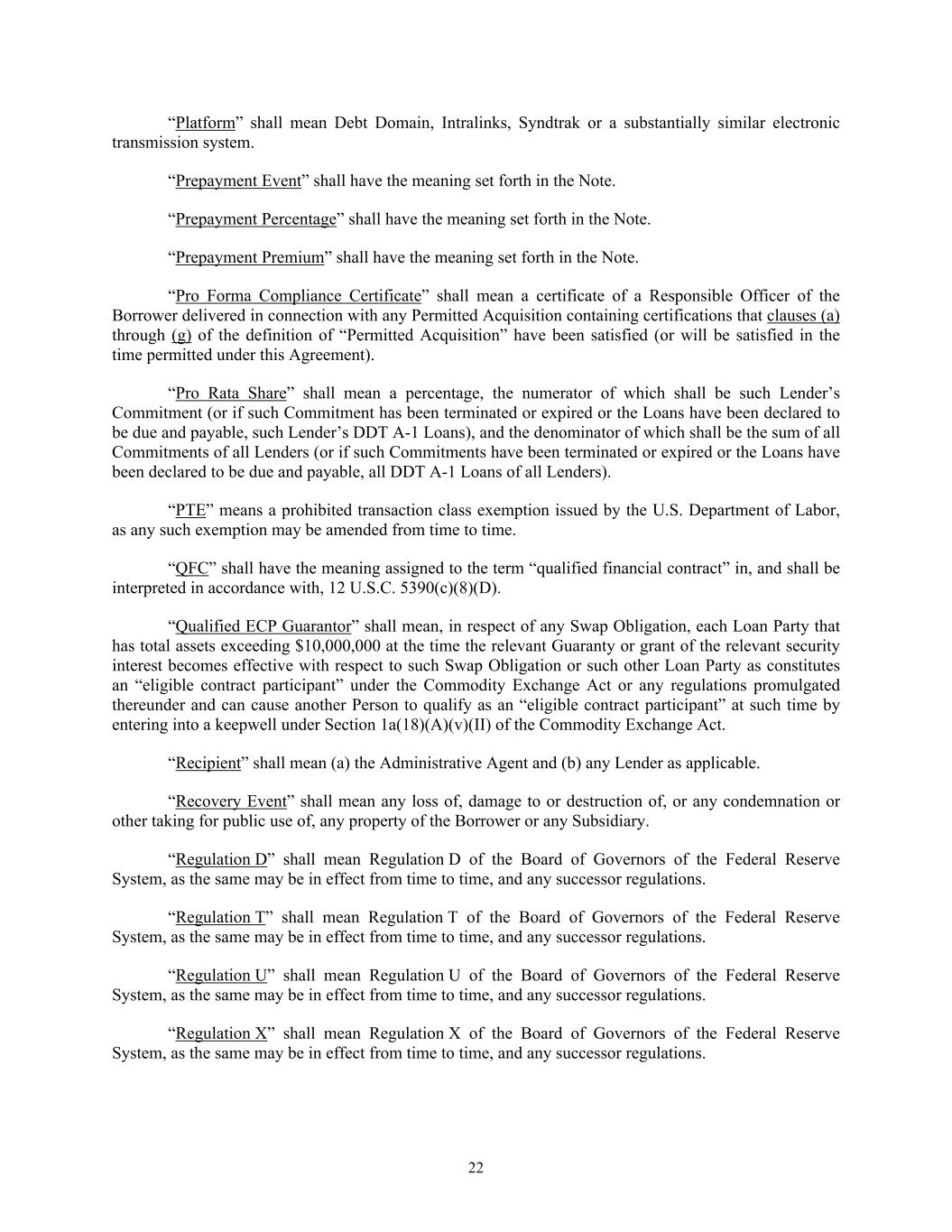
22 “Platform” shall mean Debt Domain, Intralinks, Syndtrak or a substantially similar electronic transmission system. “Prepayment Event” shall have the meaning set forth in the Note. “Prepayment Percentage” shall have the meaning set forth in the Note. “Prepayment Premium” shall have the meaning set forth in the Note. “Pro Forma Compliance Certificate” shall mean a certificate of a Responsible Officer of the Borrower delivered in connection with any Permitted Acquisition containing certifications that clauses (a) through (g) of the definition of “Permitted Acquisition” have been satisfied (or will be satisfied in the time permitted under this Agreement). “Pro Rata Share” shall mean a percentage, the numerator of which shall be such Lender’s Commitment (or if such Commitment has been terminated or expired or the Loans have been declared to be due and payable, such Lender’s DDT A-1 Loans), and the denominator of which shall be the sum of all Commitments of all Lenders (or if such Commitments have been terminated or expired or the Loans have been declared to be due and payable, all DDT A-1 Loans of all Lenders). “PTE” means a prohibited transaction class exemption issued by the U.S. Department of Labor, as any such exemption may be amended from time to time. “QFC” shall have the meaning assigned to the term “qualified financial contract” in, and shall be interpreted in accordance with, 12 U.S.C. 5390(c)(8)(D). “Qualified ECP Guarantor” shall mean, in respect of any Swap Obligation, each Loan Party that has total assets exceeding $10,000,000 at the time the relevant Guaranty or grant of the relevant security interest becomes effective with respect to such Swap Obligation or such other Loan Party as constitutes an “eligible contract participant” under the Commodity Exchange Act or any regulations promulgated thereunder and can cause another Person to qualify as an “eligible contract participant” at such time by entering into a keepwell under Section 1a(18)(A)(v)(II) of the Commodity Exchange Act. “Recipient” shall mean (a) the Administrative Agent and (b) any Lender as applicable. “Recovery Event” shall mean any loss of, damage to or destruction of, or any condemnation or other taking for public use of, any property of the Borrower or any Subsidiary. “Regulation D” shall mean Regulation D of the Board of Governors of the Federal Reserve System, as the same may be in effect from time to time, and any successor regulations. “Regulation T” shall mean Regulation T of the Board of Governors of the Federal Reserve System, as the same may be in effect from time to time, and any successor regulations. “Regulation U” shall mean Regulation U of the Board of Governors of the Federal Reserve System, as the same may be in effect from time to time, and any successor regulations. “Regulation X” shall mean Regulation X of the Board of Governors of the Federal Reserve System, as the same may be in effect from time to time, and any successor regulations.
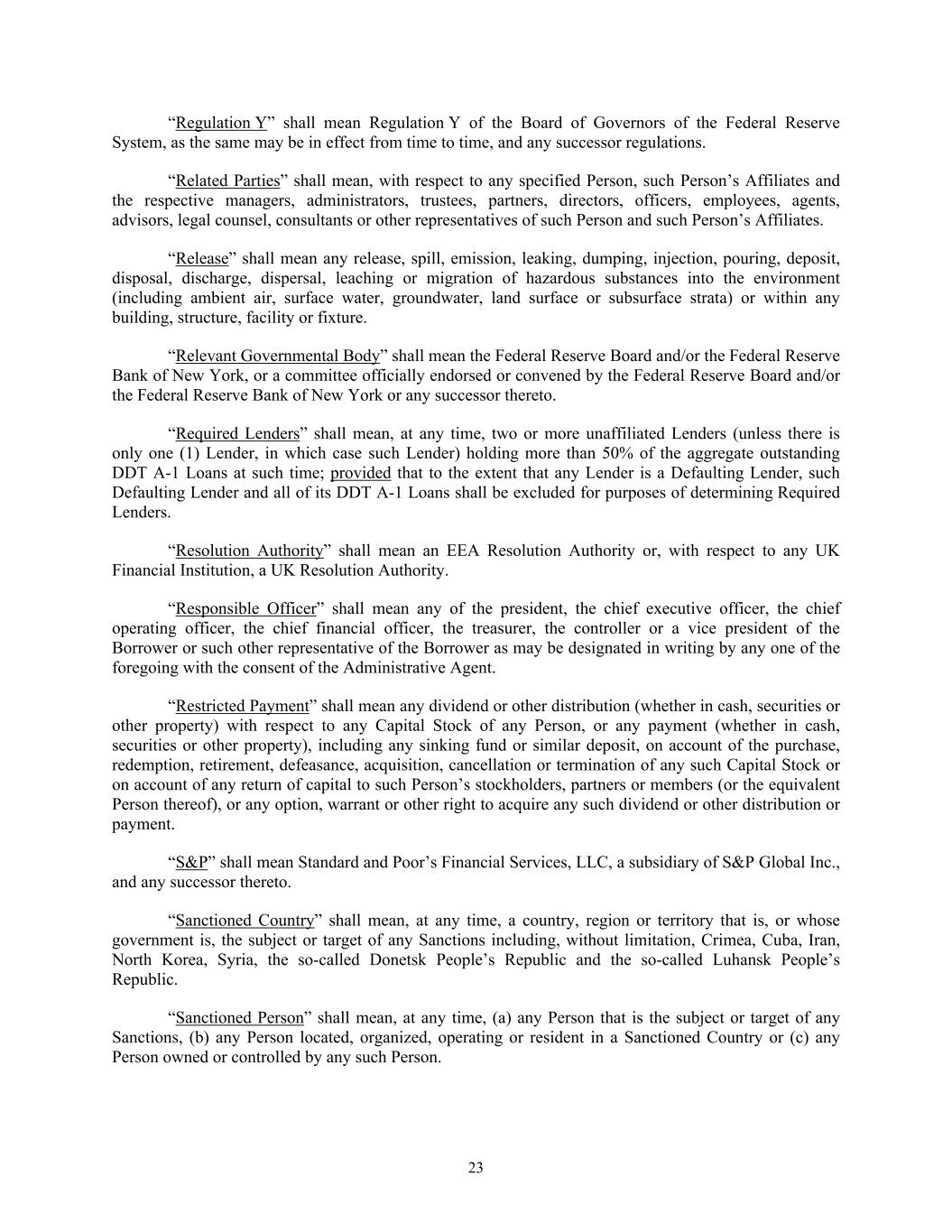
23 “Regulation Y” shall mean Regulation Y of the Board of Governors of the Federal Reserve System, as the same may be in effect from time to time, and any successor regulations. “Related Parties” shall mean, with respect to any specified Person, such Person’s Affiliates and the respective managers, administrators, trustees, partners, directors, officers, employees, agents, advisors, legal counsel, consultants or other representatives of such Person and such Person’s Affiliates. “Release” shall mean any release, spill, emission, leaking, dumping, injection, pouring, deposit, disposal, discharge, dispersal, leaching or migration of hazardous substances into the environment (including ambient air, surface water, groundwater, land surface or subsurface strata) or within any building, structure, facility or fixture. “Relevant Governmental Body” shall mean the Federal Reserve Board and/or the Federal Reserve Bank of New York, or a committee officially endorsed or convened by the Federal Reserve Board and/or the Federal Reserve Bank of New York or any successor thereto. “Required Lenders” shall mean, at any time, two or more unaffiliated Lenders (unless there is only one (1) Lender, in which case such Lender) holding more than 50% of the aggregate outstanding DDT A-1 Loans at such time; provided that to the extent that any Lender is a Defaulting Lender, such Defaulting Lender and all of its DDT A-1 Loans shall be excluded for purposes of determining Required Lenders. “Resolution Authority” shall mean an EEA Resolution Authority or, with respect to any UK Financial Institution, a UK Resolution Authority. “Responsible Officer” shall mean any of the president, the chief executive officer, the chief operating officer, the chief financial officer, the treasurer, the controller or a vice president of the Borrower or such other representative of the Borrower as may be designated in writing by any one of the foregoing with the consent of the Administrative Agent. “Restricted Payment” shall mean any dividend or other distribution (whether in cash, securities or other property) with respect to any Capital Stock of any Person, or any payment (whether in cash, securities or other property), including any sinking fund or similar deposit, on account of the purchase, redemption, retirement, defeasance, acquisition, cancellation or termination of any such Capital Stock or on account of any return of capital to such Person’s stockholders, partners or members (or the equivalent Person thereof), or any option, warrant or other right to acquire any such dividend or other distribution or payment. “S&P” shall mean Standard and Poor’s Financial Services, LLC, a subsidiary of S&P Global Inc., and any successor thereto. “Sanctioned Country” shall mean, at any time, a country, region or territory that is, or whose government is, the subject or target of any Sanctions including, without limitation, Crimea, Cuba, Iran, North Korea, Syria, the so-called Donetsk People’s Republic and the so-called Luhansk People’s Republic. “Sanctioned Person” shall mean, at any time, (a) any Person that is the subject or target of any Sanctions, (b) any Person located, organized, operating or resident in a Sanctioned Country or (c) any Person owned or controlled by any such Person.
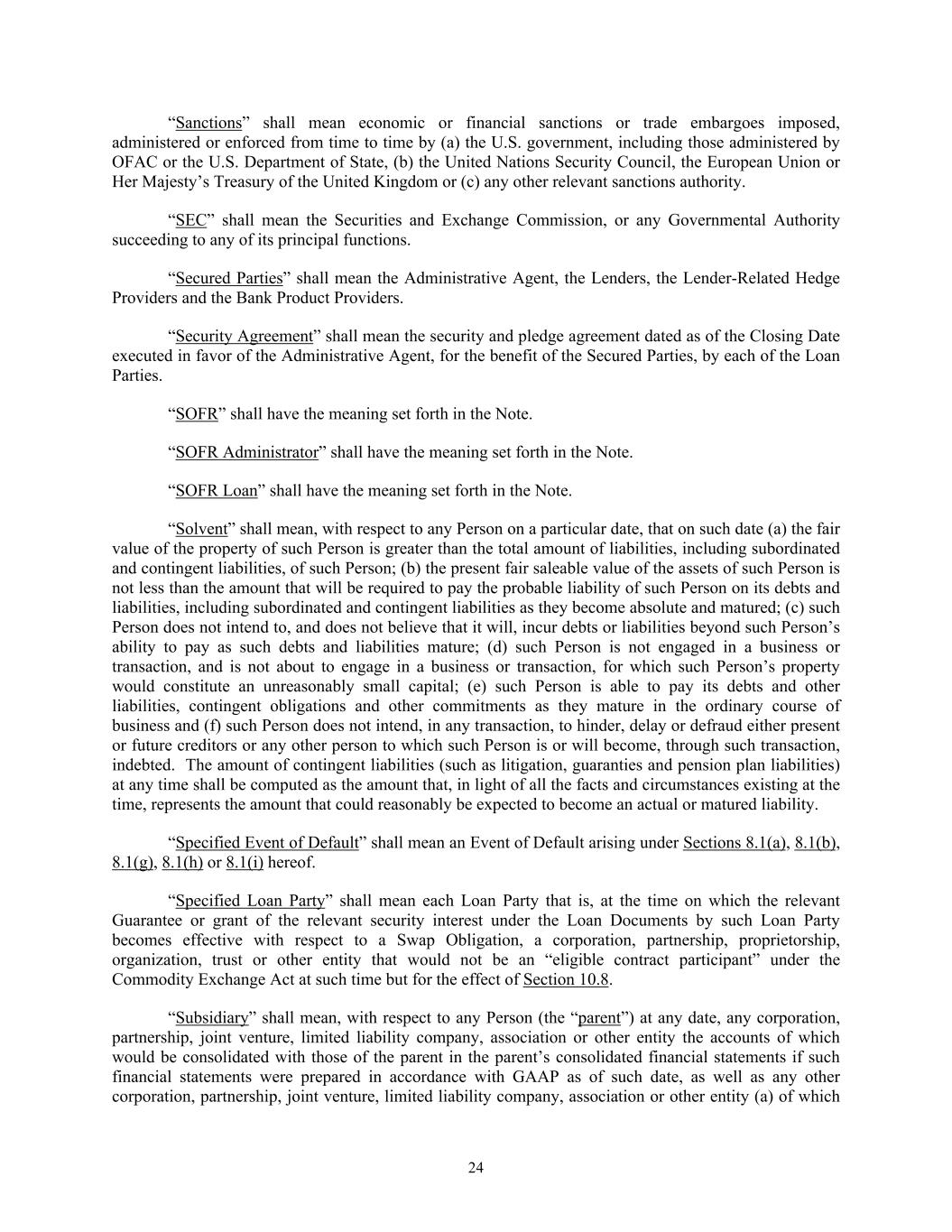
24 “Sanctions” shall mean economic or financial sanctions or trade embargoes imposed, administered or enforced from time to time by (a) the U.S. government, including those administered by OFAC or the U.S. Department of State, (b) the United Nations Security Council, the European Union or Her Majesty’s Treasury of the United Kingdom or (c) any other relevant sanctions authority. “SEC” shall mean the Securities and Exchange Commission, or any Governmental Authority succeeding to any of its principal functions. “Secured Parties” shall mean the Administrative Agent, the Lenders, the Lender-Related Hedge Providers and the Bank Product Providers. “Security Agreement” shall mean the security and pledge agreement dated as of the Closing Date executed in favor of the Administrative Agent, for the benefit of the Secured Parties, by each of the Loan Parties. “SOFR” shall have the meaning set forth in the Note. “SOFR Administrator” shall have the meaning set forth in the Note. “SOFR Loan” shall have the meaning set forth in the Note. “Solvent” shall mean, with respect to any Person on a particular date, that on such date (a) the fair value of the property of such Person is greater than the total amount of liabilities, including subordinated and contingent liabilities, of such Person; (b) the present fair saleable value of the assets of such Person is not less than the amount that will be required to pay the probable liability of such Person on its debts and liabilities, including subordinated and contingent liabilities as they become absolute and matured; (c) such Person does not intend to, and does not believe that it will, incur debts or liabilities beyond such Person’s ability to pay as such debts and liabilities mature; (d) such Person is not engaged in a business or transaction, and is not about to engage in a business or transaction, for which such Person’s property would constitute an unreasonably small capital; (e) such Person is able to pay its debts and other liabilities, contingent obligations and other commitments as they mature in the ordinary course of business and (f) such Person does not intend, in any transaction, to hinder, delay or defraud either present or future creditors or any other person to which such Person is or will become, through such transaction, indebted. The amount of contingent liabilities (such as litigation, guaranties and pension plan liabilities) at any time shall be computed as the amount that, in light of all the facts and circumstances existing at the time, represents the amount that could reasonably be expected to become an actual or matured liability. “Specified Event of Default” shall mean an Event of Default arising under Sections 8.1(a), 8.1(b), 8.1(g), 8.1(h) or 8.1(i) hereof. “Specified Loan Party” shall mean each Loan Party that is, at the time on which the relevant Guarantee or grant of the relevant security interest under the Loan Documents by such Loan Party becomes effective with respect to a Swap Obligation, a corporation, partnership, proprietorship, organization, trust or other entity that would not be an “eligible contract participant” under the Commodity Exchange Act at such time but for the effect of Section 10.8. “Subsidiary” shall mean, with respect to any Person (the “parent”) at any date, any corporation, partnership, joint venture, limited liability company, association or other entity the accounts of which would be consolidated with those of the parent in the parent’s consolidated financial statements if such financial statements were prepared in accordance with GAAP as of such date, as well as any other corporation, partnership, joint venture, limited liability company, association or other entity (a) of which
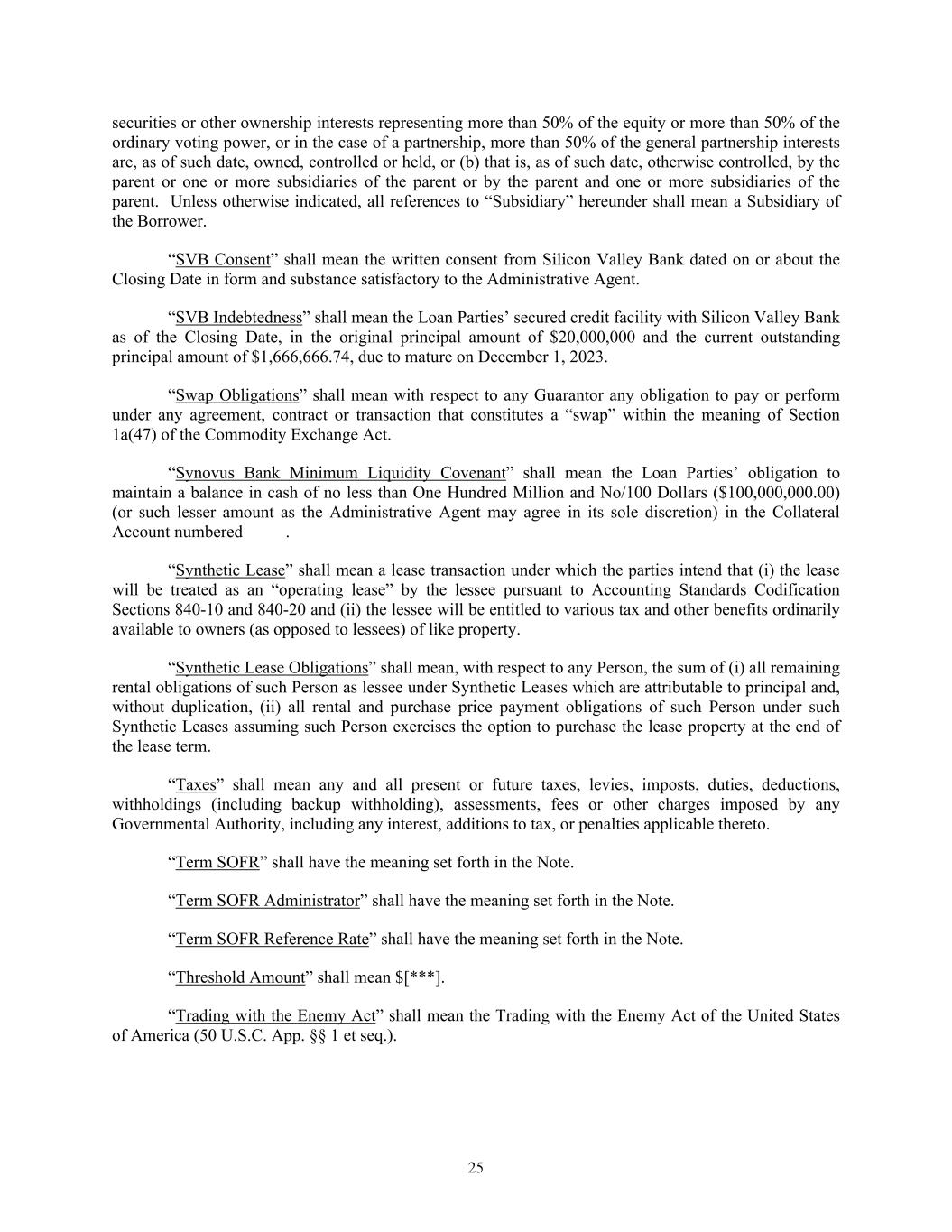
25 securities or other ownership interests representing more than 50% of the equity or more than 50% of the ordinary voting power, or in the case of a partnership, more than 50% of the general partnership interests are, as of such date, owned, controlled or held, or (b) that is, as of such date, otherwise controlled, by the parent or one or more subsidiaries of the parent or by the parent and one or more subsidiaries of the parent. Unless otherwise indicated, all references to “Subsidiary” hereunder shall mean a Subsidiary of the Borrower. “SVB Consent” shall mean the written consent from Silicon Valley Bank dated on or about the Closing Date in form and substance satisfactory to the Administrative Agent. “SVB Indebtedness” shall mean the Loan Parties’ secured credit facility with Silicon Valley Bank as of the Closing Date, in the original principal amount of $20,000,000 and the current outstanding principal amount of $1,666,666.74, due to mature on December 1, 2023. “Swap Obligations” shall mean with respect to any Guarantor any obligation to pay or perform under any agreement, contract or transaction that constitutes a “swap” within the meaning of Section 1a(47) of the Commodity Exchange Act. “Synovus Bank Minimum Liquidity Covenant” shall mean the Loan Parties’ obligation to maintain a balance in cash of no less than One Hundred Million and No/100 Dollars ($100,000,000.00) (or such lesser amount as the Administrative Agent may agree in its sole discretion) in the Collateral Account numbered . “Synthetic Lease” shall mean a lease transaction under which the parties intend that (i) the lease will be treated as an “operating lease” by the lessee pursuant to Accounting Standards Codification Sections 840-10 and 840-20 and (ii) the lessee will be entitled to various tax and other benefits ordinarily available to owners (as opposed to lessees) of like property. “Synthetic Lease Obligations” shall mean, with respect to any Person, the sum of (i) all remaining rental obligations of such Person as lessee under Synthetic Leases which are attributable to principal and, without duplication, (ii) all rental and purchase price payment obligations of such Person under such Synthetic Leases assuming such Person exercises the option to purchase the lease property at the end of the lease term. “Taxes” shall mean any and all present or future taxes, levies, imposts, duties, deductions, withholdings (including backup withholding), assessments, fees or other charges imposed by any Governmental Authority, including any interest, additions to tax, or penalties applicable thereto. “Term SOFR” shall have the meaning set forth in the Note. “Term SOFR Administrator” shall have the meaning set forth in the Note. “Term SOFR Reference Rate” shall have the meaning set forth in the Note. “Threshold Amount” shall mean $[***]. “Trading with the Enemy Act” shall mean the Trading with the Enemy Act of the United States of America (50 U.S.C. App. §§ 1 et seq.).
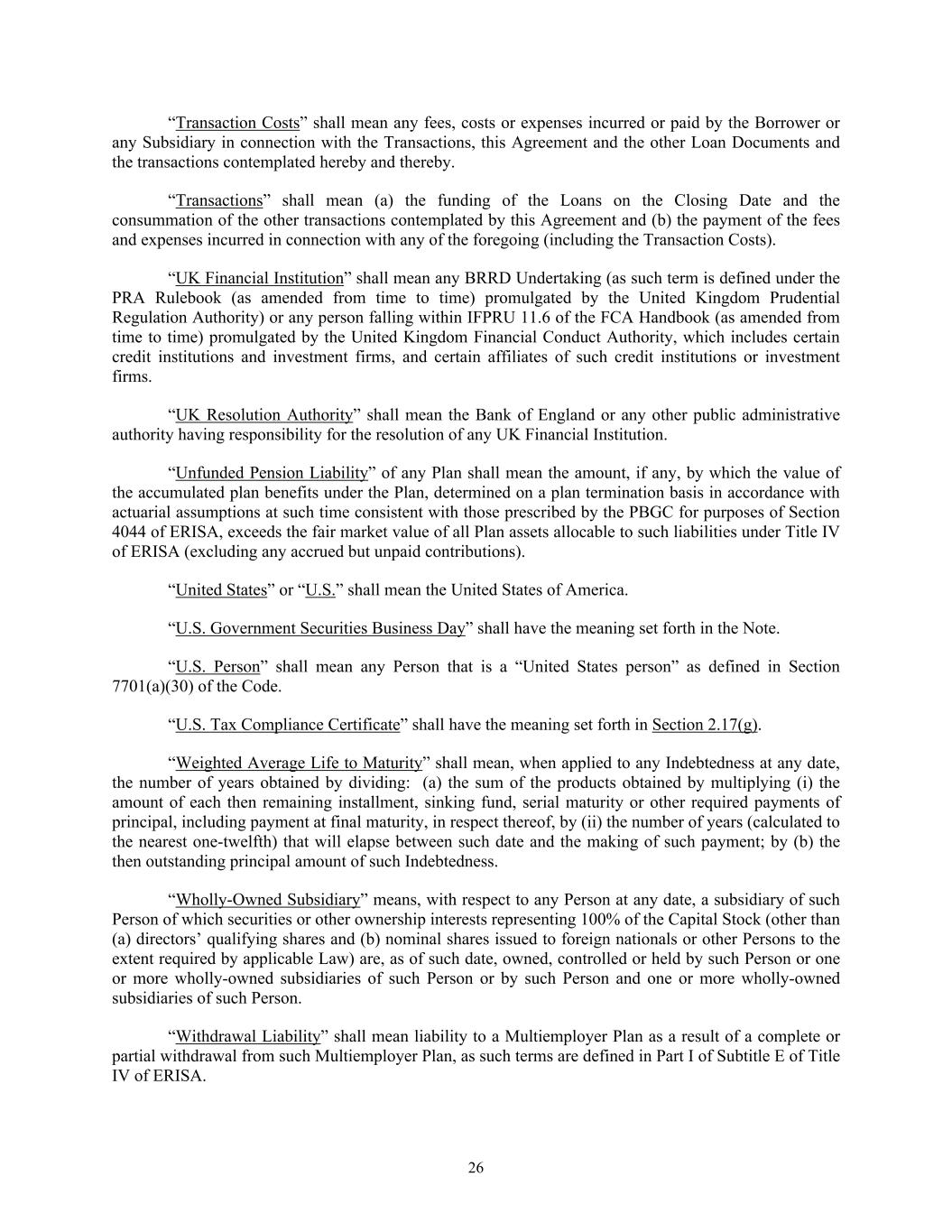
26 “Transaction Costs” shall mean any fees, costs or expenses incurred or paid by the Borrower or any Subsidiary in connection with the Transactions, this Agreement and the other Loan Documents and the transactions contemplated hereby and thereby. “Transactions” shall mean (a) the funding of the Loans on the Closing Date and the consummation of the other transactions contemplated by this Agreement and (b) the payment of the fees and expenses incurred in connection with any of the foregoing (including the Transaction Costs). “UK Financial Institution” shall mean any BRRD Undertaking (as such term is defined under the PRA Rulebook (as amended from time to time) promulgated by the United Kingdom Prudential Regulation Authority) or any person falling within IFPRU 11.6 of the FCA Handbook (as amended from time to time) promulgated by the United Kingdom Financial Conduct Authority, which includes certain credit institutions and investment firms, and certain affiliates of such credit institutions or investment firms. “UK Resolution Authority” shall mean the Bank of England or any other public administrative authority having responsibility for the resolution of any UK Financial Institution. “Unfunded Pension Liability” of any Plan shall mean the amount, if any, by which the value of the accumulated plan benefits under the Plan, determined on a plan termination basis in accordance with actuarial assumptions at such time consistent with those prescribed by the PBGC for purposes of Section 4044 of ERISA, exceeds the fair market value of all Plan assets allocable to such liabilities under Title IV of ERISA (excluding any accrued but unpaid contributions). “United States” or “U.S.” shall mean the United States of America. “U.S. Government Securities Business Day” shall have the meaning set forth in the Note. “U.S. Person” shall mean any Person that is a “United States person” as defined in Section 7701(a)(30) of the Code. “U.S. Tax Compliance Certificate” shall have the meaning set forth in Section 2.17(g). “Weighted Average Life to Maturity” shall mean, when applied to any Indebtedness at any date, the number of years obtained by dividing: (a) the sum of the products obtained by multiplying (i) the amount of each then remaining installment, sinking fund, serial maturity or other required payments of principal, including payment at final maturity, in respect thereof, by (ii) the number of years (calculated to the nearest one-twelfth) that will elapse between such date and the making of such payment; by (b) the then outstanding principal amount of such Indebtedness. “Wholly-Owned Subsidiary” means, with respect to any Person at any date, a subsidiary of such Person of which securities or other ownership interests representing 100% of the Capital Stock (other than (a) directors’ qualifying shares and (b) nominal shares issued to foreign nationals or other Persons to the extent required by applicable Law) are, as of such date, owned, controlled or held by such Person or one or more wholly-owned subsidiaries of such Person or by such Person and one or more wholly-owned subsidiaries of such Person. “Withdrawal Liability” shall mean liability to a Multiemployer Plan as a result of a complete or partial withdrawal from such Multiemployer Plan, as such terms are defined in Part I of Subtitle E of Title IV of ERISA.
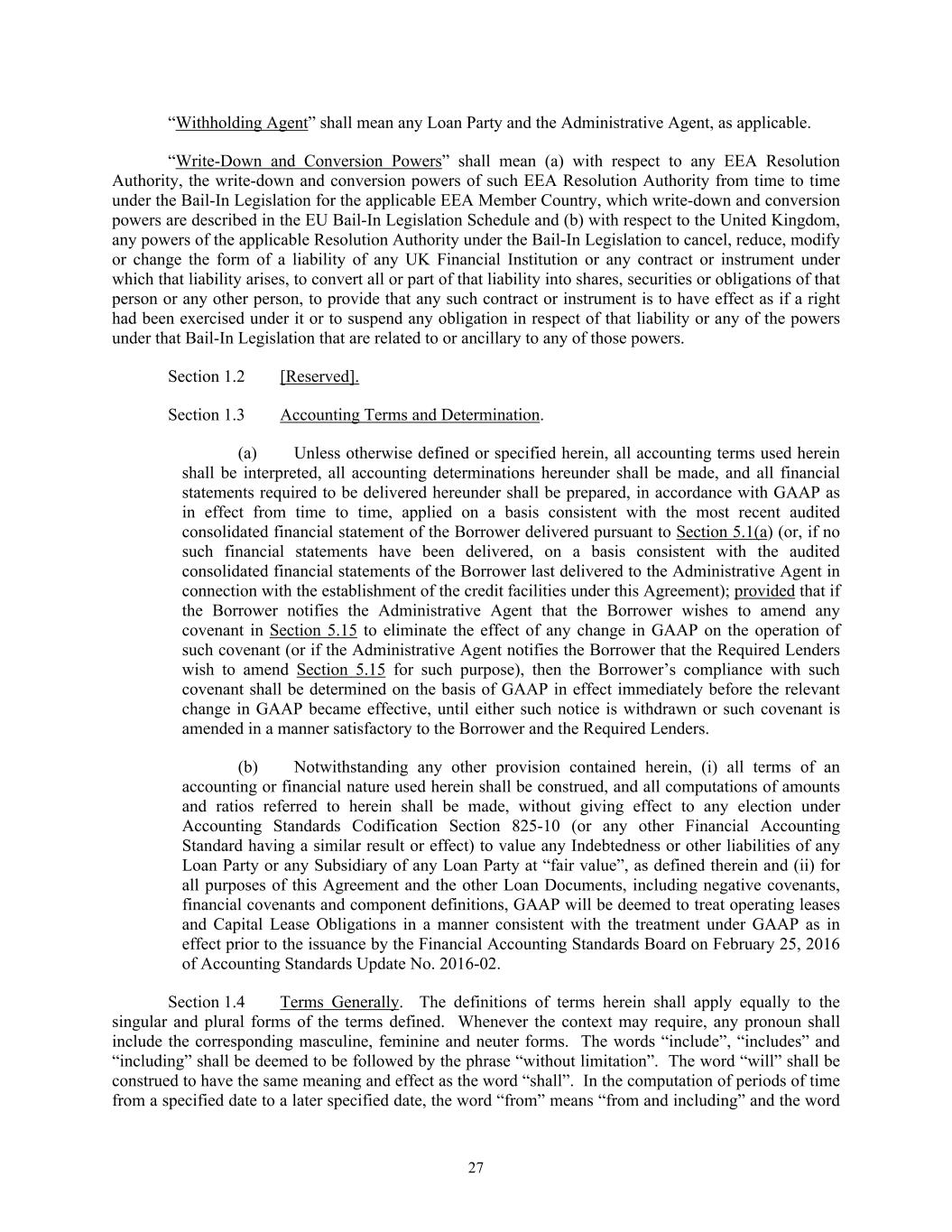
27 “Withholding Agent” shall mean any Loan Party and the Administrative Agent, as applicable. “Write-Down and Conversion Powers” shall mean (a) with respect to any EEA Resolution Authority, the write-down and conversion powers of such EEA Resolution Authority from time to time under the Bail-In Legislation for the applicable EEA Member Country, which write-down and conversion powers are described in the EU Bail-In Legislation Schedule and (b) with respect to the United Kingdom, any powers of the applicable Resolution Authority under the Bail-In Legislation to cancel, reduce, modify or change the form of a liability of any UK Financial Institution or any contract or instrument under which that liability arises, to convert all or part of that liability into shares, securities or obligations of that person or any other person, to provide that any such contract or instrument is to have effect as if a right had been exercised under it or to suspend any obligation in respect of that liability or any of the powers under that Bail-In Legislation that are related to or ancillary to any of those powers. Section 1.2 [Reserved]. Section 1.3 Accounting Terms and Determination. (a) Unless otherwise defined or specified herein, all accounting terms used herein shall be interpreted, all accounting determinations hereunder shall be made, and all financial statements required to be delivered hereunder shall be prepared, in accordance with GAAP as in effect from time to time, applied on a basis consistent with the most recent audited consolidated financial statement of the Borrower delivered pursuant to Section 5.1(a) (or, if no such financial statements have been delivered, on a basis consistent with the audited consolidated financial statements of the Borrower last delivered to the Administrative Agent in connection with the establishment of the credit facilities under this Agreement); provided that if the Borrower notifies the Administrative Agent that the Borrower wishes to amend any covenant in Section 5.15 to eliminate the effect of any change in GAAP on the operation of such covenant (or if the Administrative Agent notifies the Borrower that the Required Lenders wish to amend Section 5.15 for such purpose), then the Borrower’s compliance with such covenant shall be determined on the basis of GAAP in effect immediately before the relevant change in GAAP became effective, until either such notice is withdrawn or such covenant is amended in a manner satisfactory to the Borrower and the Required Lenders. (b) Notwithstanding any other provision contained herein, (i) all terms of an accounting or financial nature used herein shall be construed, and all computations of amounts and ratios referred to herein shall be made, without giving effect to any election under Accounting Standards Codification Section 825-10 (or any other Financial Accounting Standard having a similar result or effect) to value any Indebtedness or other liabilities of any Loan Party or any Subsidiary of any Loan Party at “fair value”, as defined therein and (ii) for all purposes of this Agreement and the other Loan Documents, including negative covenants, financial covenants and component definitions, GAAP will be deemed to treat operating leases and Capital Lease Obligations in a manner consistent with the treatment under GAAP as in effect prior to the issuance by the Financial Accounting Standards Board on February 25, 2016 of Accounting Standards Update No. 2016-02. Section 1.4 Terms Generally. The definitions of terms herein shall apply equally to the singular and plural forms of the terms defined. Whenever the context may require, any pronoun shall include the corresponding masculine, feminine and neuter forms. The words “include”, “includes” and “including” shall be deemed to be followed by the phrase “without limitation”. The word “will” shall be construed to have the same meaning and effect as the word “shall”. In the computation of periods of time from a specified date to a later specified date, the word “from” means “from and including” and the word
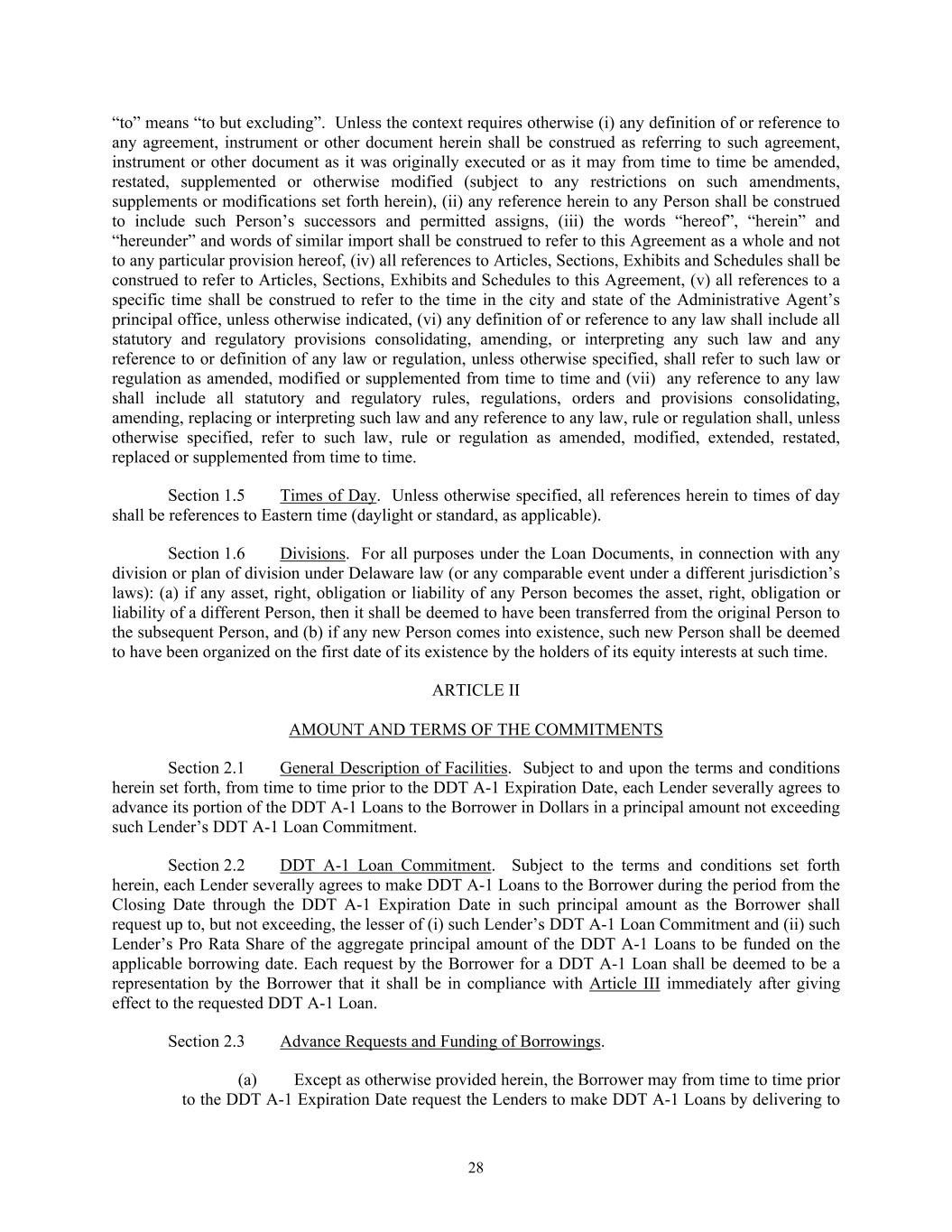
28 “to” means “to but excluding”. Unless the context requires otherwise (i) any definition of or reference to any agreement, instrument or other document herein shall be construed as referring to such agreement, instrument or other document as it was originally executed or as it may from time to time be amended, restated, supplemented or otherwise modified (subject to any restrictions on such amendments, supplements or modifications set forth herein), (ii) any reference herein to any Person shall be construed to include such Person’s successors and permitted assigns, (iii) the words “hereof”, “herein” and “hereunder” and words of similar import shall be construed to refer to this Agreement as a whole and not to any particular provision hereof, (iv) all references to Articles, Sections, Exhibits and Schedules shall be construed to refer to Articles, Sections, Exhibits and Schedules to this Agreement, (v) all references to a specific time shall be construed to refer to the time in the city and state of the Administrative Agent’s principal office, unless otherwise indicated, (vi) any definition of or reference to any law shall include all statutory and regulatory provisions consolidating, amending, or interpreting any such law and any reference to or definition of any law or regulation, unless otherwise specified, shall refer to such law or regulation as amended, modified or supplemented from time to time and (vii) any reference to any law shall include all statutory and regulatory rules, regulations, orders and provisions consolidating, amending, replacing or interpreting such law and any reference to any law, rule or regulation shall, unless otherwise specified, refer to such law, rule or regulation as amended, modified, extended, restated, replaced or supplemented from time to time. Section 1.5 Times of Day. Unless otherwise specified, all references herein to times of day shall be references to Eastern time (daylight or standard, as applicable). Section 1.6 Divisions. For all purposes under the Loan Documents, in connection with any division or plan of division under Delaware law (or any comparable event under a different jurisdiction’s laws): (a) if any asset, right, obligation or liability of any Person becomes the asset, right, obligation or liability of a different Person, then it shall be deemed to have been transferred from the original Person to the subsequent Person, and (b) if any new Person comes into existence, such new Person shall be deemed to have been organized on the first date of its existence by the holders of its equity interests at such time. ARTICLE II AMOUNT AND TERMS OF THE COMMITMENTS Section 2.1 General Description of Facilities. Subject to and upon the terms and conditions herein set forth, from time to time prior to the DDT A-1 Expiration Date, each Lender severally agrees to advance its portion of the DDT A-1 Loans to the Borrower in Dollars in a principal amount not exceeding such Lender’s DDT A-1 Loan Commitment. Section 2.2 DDT A-1 Loan Commitment. Subject to the terms and conditions set forth herein, each Lender severally agrees to make DDT A-1 Loans to the Borrower during the period from the Closing Date through the DDT A-1 Expiration Date in such principal amount as the Borrower shall request up to, but not exceeding, the lesser of (i) such Lender’s DDT A-1 Loan Commitment and (ii) such Lender’s Pro Rata Share of the aggregate principal amount of the DDT A-1 Loans to be funded on the applicable borrowing date. Each request by the Borrower for a DDT A-1 Loan shall be deemed to be a representation by the Borrower that it shall be in compliance with Article III immediately after giving effect to the requested DDT A-1 Loan. Section 2.3 Advance Requests and Funding of Borrowings. (a) Except as otherwise provided herein, the Borrower may from time to time prior to the DDT A-1 Expiration Date request the Lenders to make DDT A-1 Loans by delivering to
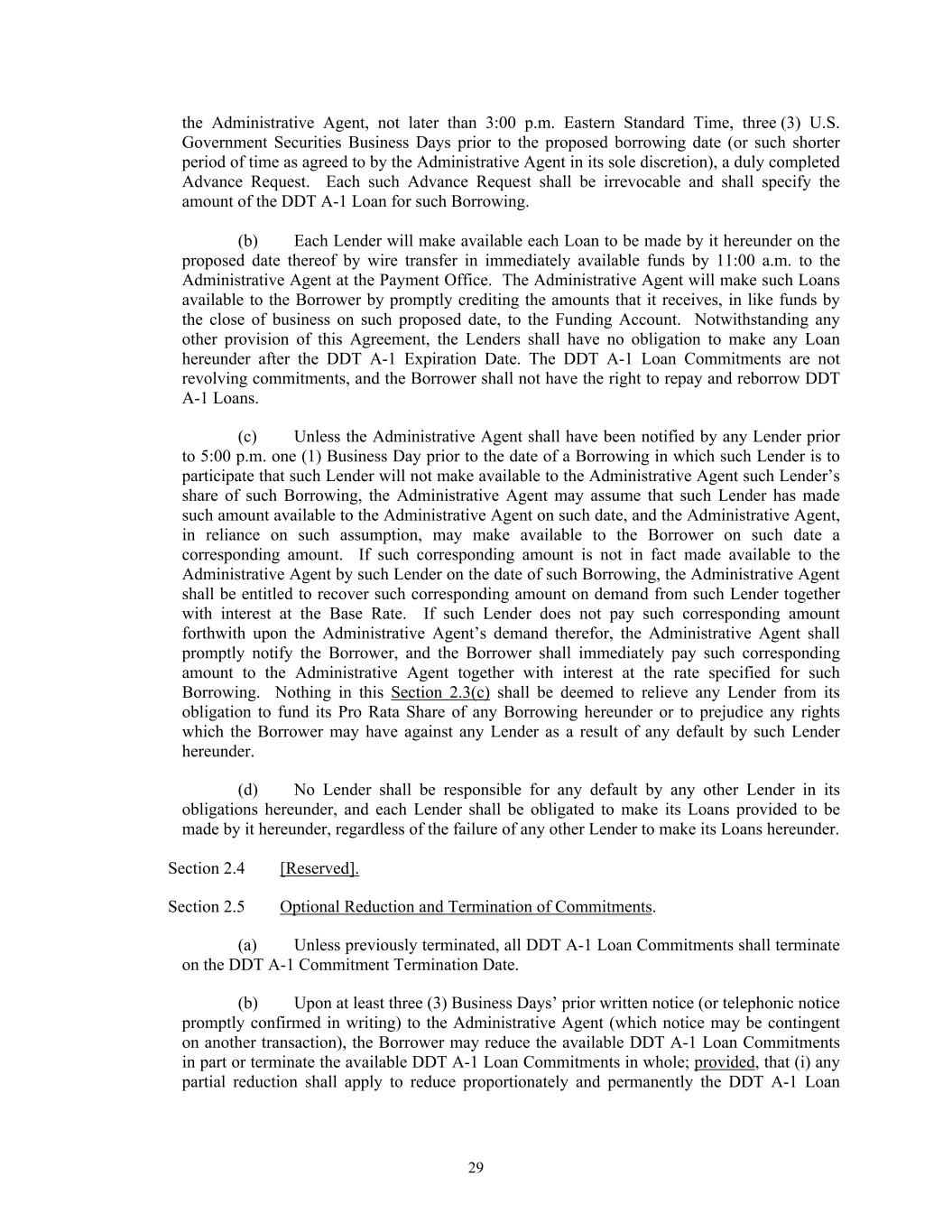
29 the Administrative Agent, not later than 3:00 p.m. Eastern Standard Time, three (3) U.S. Government Securities Business Days prior to the proposed borrowing date (or such shorter period of time as agreed to by the Administrative Agent in its sole discretion), a duly completed Advance Request. Each such Advance Request shall be irrevocable and shall specify the amount of the DDT A-1 Loan for such Borrowing. (b) Each Lender will make available each Loan to be made by it hereunder on the proposed date thereof by wire transfer in immediately available funds by 11:00 a.m. to the Administrative Agent at the Payment Office. The Administrative Agent will make such Loans available to the Borrower by promptly crediting the amounts that it receives, in like funds by the close of business on such proposed date, to the Funding Account. Notwithstanding any other provision of this Agreement, the Lenders shall have no obligation to make any Loan hereunder after the DDT A-1 Expiration Date. The DDT A-1 Loan Commitments are not revolving commitments, and the Borrower shall not have the right to repay and reborrow DDT A-1 Loans. (c) Unless the Administrative Agent shall have been notified by any Lender prior to 5:00 p.m. one (1) Business Day prior to the date of a Borrowing in which such Lender is to participate that such Lender will not make available to the Administrative Agent such Lender’s share of such Borrowing, the Administrative Agent may assume that such Lender has made such amount available to the Administrative Agent on such date, and the Administrative Agent, in reliance on such assumption, may make available to the Borrower on such date a corresponding amount. If such corresponding amount is not in fact made available to the Administrative Agent by such Lender on the date of such Borrowing, the Administrative Agent shall be entitled to recover such corresponding amount on demand from such Lender together with interest at the Base Rate. If such Lender does not pay such corresponding amount forthwith upon the Administrative Agent’s demand therefor, the Administrative Agent shall promptly notify the Borrower, and the Borrower shall immediately pay such corresponding amount to the Administrative Agent together with interest at the rate specified for such Borrowing. Nothing in this Section 2.3(c) shall be deemed to relieve any Lender from its obligation to fund its Pro Rata Share of any Borrowing hereunder or to prejudice any rights which the Borrower may have against any Lender as a result of any default by such Lender hereunder. (d) No Lender shall be responsible for any default by any other Lender in its obligations hereunder, and each Lender shall be obligated to make its Loans provided to be made by it hereunder, regardless of the failure of any other Lender to make its Loans hereunder. Section 2.4 [Reserved]. Section 2.5 Optional Reduction and Termination of Commitments. (a) Unless previously terminated, all DDT A-1 Loan Commitments shall terminate on the DDT A-1 Commitment Termination Date. (b) Upon at least three (3) Business Days’ prior written notice (or telephonic notice promptly confirmed in writing) to the Administrative Agent (which notice may be contingent on another transaction), the Borrower may reduce the available DDT A-1 Loan Commitments in part or terminate the available DDT A-1 Loan Commitments in whole; provided, that (i) any partial reduction shall apply to reduce proportionately and permanently the DDT A-1 Loan
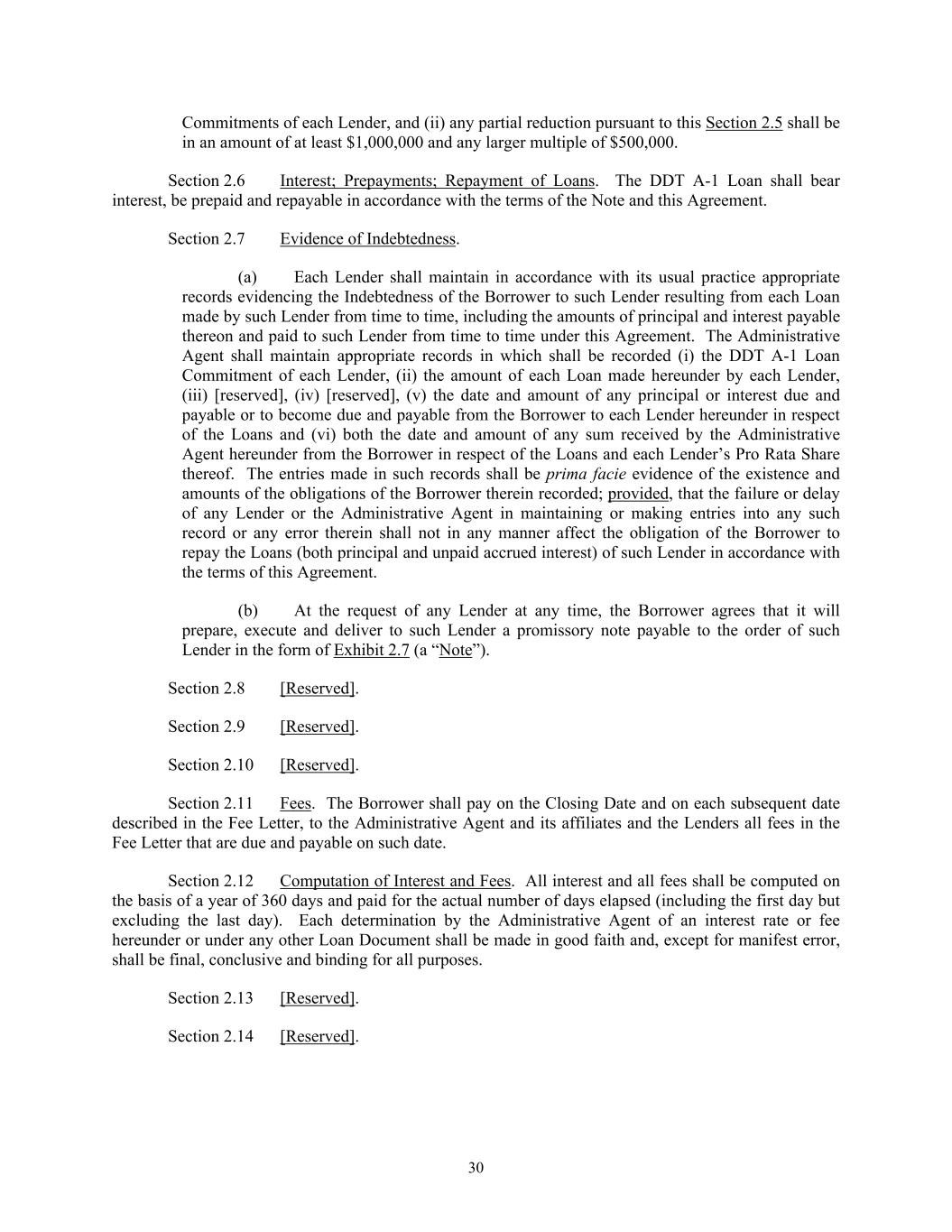
30 Commitments of each Lender, and (ii) any partial reduction pursuant to this Section 2.5 shall be in an amount of at least $1,000,000 and any larger multiple of $500,000. Section 2.6 Interest; Prepayments; Repayment of Loans. The DDT A-1 Loan shall bear interest, be prepaid and repayable in accordance with the terms of the Note and this Agreement. Section 2.7 Evidence of Indebtedness. (a) Each Lender shall maintain in accordance with its usual practice appropriate records evidencing the Indebtedness of the Borrower to such Lender resulting from each Loan made by such Lender from time to time, including the amounts of principal and interest payable thereon and paid to such Lender from time to time under this Agreement. The Administrative Agent shall maintain appropriate records in which shall be recorded (i) the DDT A-1 Loan Commitment of each Lender, (ii) the amount of each Loan made hereunder by each Lender, (iii) [reserved], (iv) [reserved], (v) the date and amount of any principal or interest due and payable or to become due and payable from the Borrower to each Lender hereunder in respect of the Loans and (vi) both the date and amount of any sum received by the Administrative Agent hereunder from the Borrower in respect of the Loans and each Lender’s Pro Rata Share thereof. The entries made in such records shall be prima facie evidence of the existence and amounts of the obligations of the Borrower therein recorded; provided, that the failure or delay of any Lender or the Administrative Agent in maintaining or making entries into any such record or any error therein shall not in any manner affect the obligation of the Borrower to repay the Loans (both principal and unpaid accrued interest) of such Lender in accordance with the terms of this Agreement. (b) At the request of any Lender at any time, the Borrower agrees that it will prepare, execute and deliver to such Lender a promissory note payable to the order of such Lender in the form of Exhibit 2.7 (a “Note”). Section 2.8 [Reserved]. Section 2.9 [Reserved]. Section 2.10 [Reserved]. Section 2.11 Fees. The Borrower shall pay on the Closing Date and on each subsequent date described in the Fee Letter, to the Administrative Agent and its affiliates and the Lenders all fees in the Fee Letter that are due and payable on such date. Section 2.12 Computation of Interest and Fees. All interest and all fees shall be computed on the basis of a year of 360 days and paid for the actual number of days elapsed (including the first day but excluding the last day). Each determination by the Administrative Agent of an interest rate or fee hereunder or under any other Loan Document shall be made in good faith and, except for manifest error, shall be final, conclusive and binding for all purposes. Section 2.13 [Reserved]. Section 2.14 [Reserved].
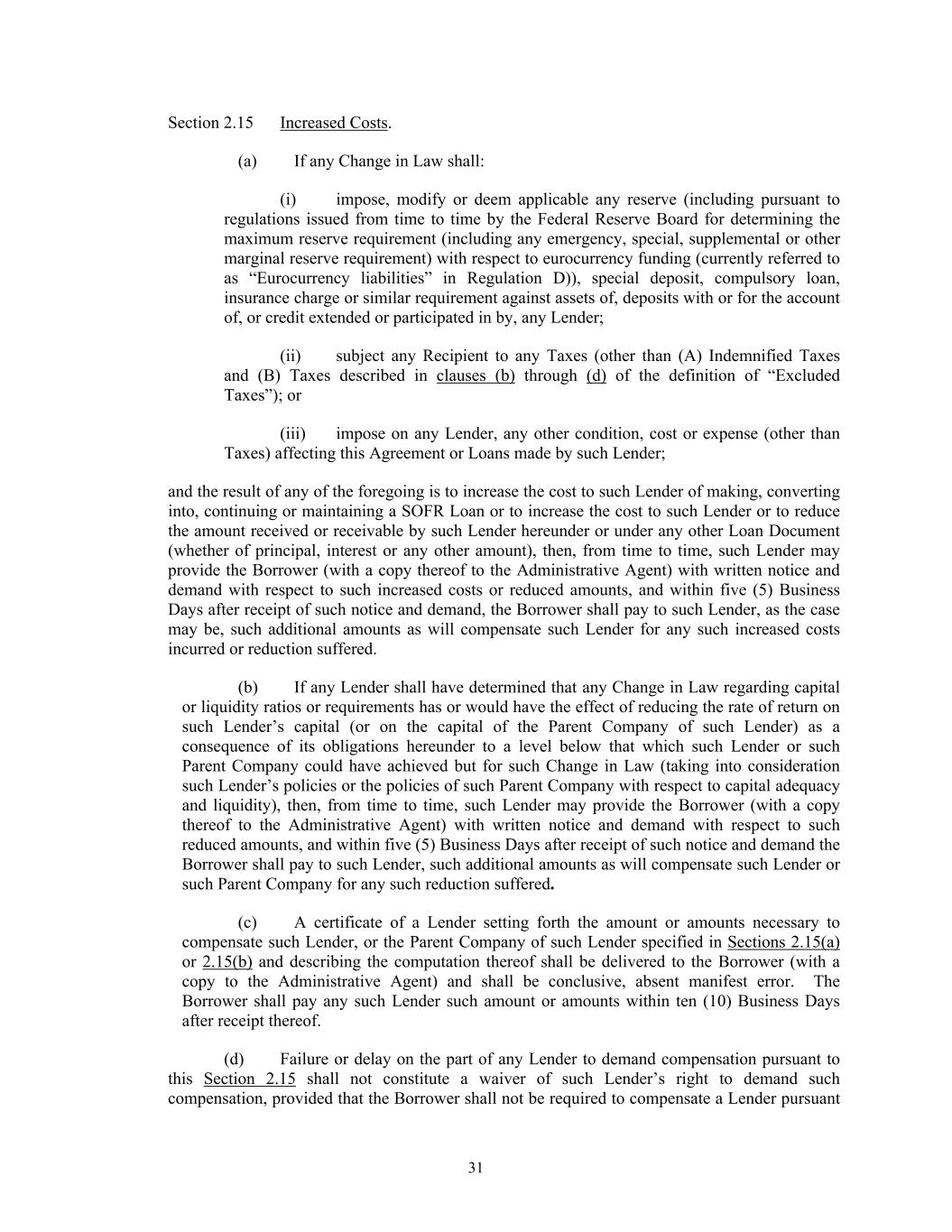
31 Section 2.15 Increased Costs. (a) If any Change in Law shall: (i) impose, modify or deem applicable any reserve (including pursuant to regulations issued from time to time by the Federal Reserve Board for determining the maximum reserve requirement (including any emergency, special, supplemental or other marginal reserve requirement) with respect to eurocurrency funding (currently referred to as “Eurocurrency liabilities” in Regulation D)), special deposit, compulsory loan, insurance charge or similar requirement against assets of, deposits with or for the account of, or credit extended or participated in by, any Lender; (ii) subject any Recipient to any Taxes (other than (A) Indemnified Taxes and (B) Taxes described in clauses (b) through (d) of the definition of “Excluded Taxes”); or (iii) impose on any Lender, any other condition, cost or expense (other than Taxes) affecting this Agreement or Loans made by such Lender; and the result of any of the foregoing is to increase the cost to such Lender of making, converting into, continuing or maintaining a SOFR Loan or to increase the cost to such Lender or to reduce the amount received or receivable by such Lender hereunder or under any other Loan Document (whether of principal, interest or any other amount), then, from time to time, such Lender may provide the Borrower (with a copy thereof to the Administrative Agent) with written notice and demand with respect to such increased costs or reduced amounts, and within five (5) Business Days after receipt of such notice and demand, the Borrower shall pay to such Lender, as the case may be, such additional amounts as will compensate such Lender for any such increased costs incurred or reduction suffered. (b) If any Lender shall have determined that any Change in Law regarding capital or liquidity ratios or requirements has or would have the effect of reducing the rate of return on such Lender’s capital (or on the capital of the Parent Company of such Lender) as a consequence of its obligations hereunder to a level below that which such Lender or such Parent Company could have achieved but for such Change in Law (taking into consideration such Lender’s policies or the policies of such Parent Company with respect to capital adequacy and liquidity), then, from time to time, such Lender may provide the Borrower (with a copy thereof to the Administrative Agent) with written notice and demand with respect to such reduced amounts, and within five (5) Business Days after receipt of such notice and demand the Borrower shall pay to such Lender, such additional amounts as will compensate such Lender or such Parent Company for any such reduction suffered. (c) A certificate of a Lender setting forth the amount or amounts necessary to compensate such Lender, or the Parent Company of such Lender specified in Sections 2.15(a) or 2.15(b) and describing the computation thereof shall be delivered to the Borrower (with a copy to the Administrative Agent) and shall be conclusive, absent manifest error. The Borrower shall pay any such Lender such amount or amounts within ten (10) Business Days after receipt thereof. (d) Failure or delay on the part of any Lender to demand compensation pursuant to this Section 2.15 shall not constitute a waiver of such Lender’s right to demand such compensation, provided that the Borrower shall not be required to compensate a Lender pursuant
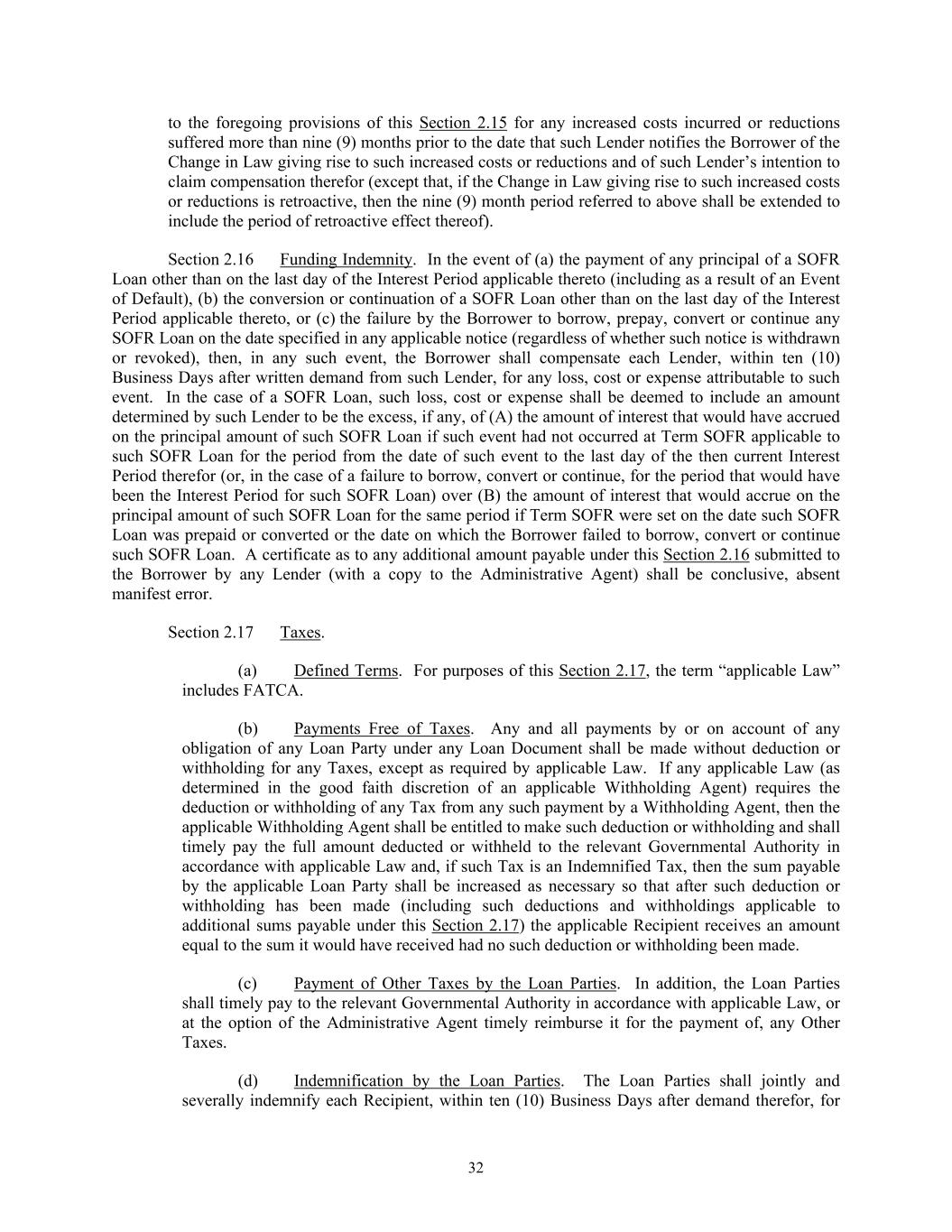
32 to the foregoing provisions of this Section 2.15 for any increased costs incurred or reductions suffered more than nine (9) months prior to the date that such Lender notifies the Borrower of the Change in Law giving rise to such increased costs or reductions and of such Lender’s intention to claim compensation therefor (except that, if the Change in Law giving rise to such increased costs or reductions is retroactive, then the nine (9) month period referred to above shall be extended to include the period of retroactive effect thereof). Section 2.16 Funding Indemnity. In the event of (a) the payment of any principal of a SOFR Loan other than on the last day of the Interest Period applicable thereto (including as a result of an Event of Default), (b) the conversion or continuation of a SOFR Loan other than on the last day of the Interest Period applicable thereto, or (c) the failure by the Borrower to borrow, prepay, convert or continue any SOFR Loan on the date specified in any applicable notice (regardless of whether such notice is withdrawn or revoked), then, in any such event, the Borrower shall compensate each Lender, within ten (10) Business Days after written demand from such Lender, for any loss, cost or expense attributable to such event. In the case of a SOFR Loan, such loss, cost or expense shall be deemed to include an amount determined by such Lender to be the excess, if any, of (A) the amount of interest that would have accrued on the principal amount of such SOFR Loan if such event had not occurred at Term SOFR applicable to such SOFR Loan for the period from the date of such event to the last day of the then current Interest Period therefor (or, in the case of a failure to borrow, convert or continue, for the period that would have been the Interest Period for such SOFR Loan) over (B) the amount of interest that would accrue on the principal amount of such SOFR Loan for the same period if Term SOFR were set on the date such SOFR Loan was prepaid or converted or the date on which the Borrower failed to borrow, convert or continue such SOFR Loan. A certificate as to any additional amount payable under this Section 2.16 submitted to the Borrower by any Lender (with a copy to the Administrative Agent) shall be conclusive, absent manifest error. Section 2.17 Taxes. (a) Defined Terms. For purposes of this Section 2.17, the term “applicable Law” includes FATCA. (b) Payments Free of Taxes. Any and all payments by or on account of any obligation of any Loan Party under any Loan Document shall be made without deduction or withholding for any Taxes, except as required by applicable Law. If any applicable Law (as determined in the good faith discretion of an applicable Withholding Agent) requires the deduction or withholding of any Tax from any such payment by a Withholding Agent, then the applicable Withholding Agent shall be entitled to make such deduction or withholding and shall timely pay the full amount deducted or withheld to the relevant Governmental Authority in accordance with applicable Law and, if such Tax is an Indemnified Tax, then the sum payable by the applicable Loan Party shall be increased as necessary so that after such deduction or withholding has been made (including such deductions and withholdings applicable to additional sums payable under this Section 2.17) the applicable Recipient receives an amount equal to the sum it would have received had no such deduction or withholding been made. (c) Payment of Other Taxes by the Loan Parties. In addition, the Loan Parties shall timely pay to the relevant Governmental Authority in accordance with applicable Law, or at the option of the Administrative Agent timely reimburse it for the payment of, any Other Taxes. (d) Indemnification by the Loan Parties. The Loan Parties shall jointly and severally indemnify each Recipient, within ten (10) Business Days after demand therefor, for
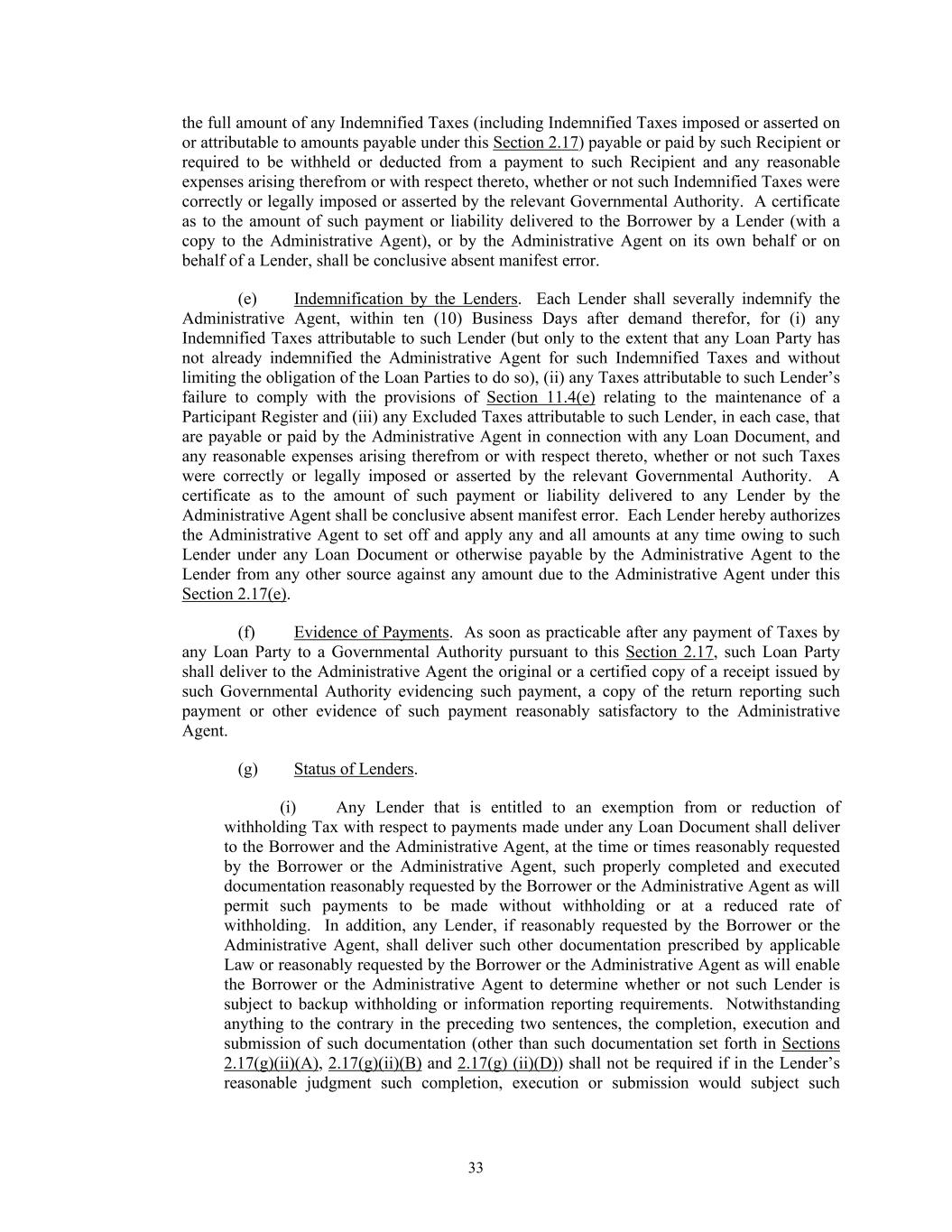
33 the full amount of any Indemnified Taxes (including Indemnified Taxes imposed or asserted on or attributable to amounts payable under this Section 2.17) payable or paid by such Recipient or required to be withheld or deducted from a payment to such Recipient and any reasonable expenses arising therefrom or with respect thereto, whether or not such Indemnified Taxes were correctly or legally imposed or asserted by the relevant Governmental Authority. A certificate as to the amount of such payment or liability delivered to the Borrower by a Lender (with a copy to the Administrative Agent), or by the Administrative Agent on its own behalf or on behalf of a Lender, shall be conclusive absent manifest error. (e) Indemnification by the Lenders. Each Lender shall severally indemnify the Administrative Agent, within ten (10) Business Days after demand therefor, for (i) any Indemnified Taxes attributable to such Lender (but only to the extent that any Loan Party has not already indemnified the Administrative Agent for such Indemnified Taxes and without limiting the obligation of the Loan Parties to do so), (ii) any Taxes attributable to such Lender’s failure to comply with the provisions of Section 11.4(e) relating to the maintenance of a Participant Register and (iii) any Excluded Taxes attributable to such Lender, in each case, that are payable or paid by the Administrative Agent in connection with any Loan Document, and any reasonable expenses arising therefrom or with respect thereto, whether or not such Taxes were correctly or legally imposed or asserted by the relevant Governmental Authority. A certificate as to the amount of such payment or liability delivered to any Lender by the Administrative Agent shall be conclusive absent manifest error. Each Lender hereby authorizes the Administrative Agent to set off and apply any and all amounts at any time owing to such Lender under any Loan Document or otherwise payable by the Administrative Agent to the Lender from any other source against any amount due to the Administrative Agent under this Section 2.17(e). (f) Evidence of Payments. As soon as practicable after any payment of Taxes by any Loan Party to a Governmental Authority pursuant to this Section 2.17, such Loan Party shall deliver to the Administrative Agent the original or a certified copy of a receipt issued by such Governmental Authority evidencing such payment, a copy of the return reporting such payment or other evidence of such payment reasonably satisfactory to the Administrative Agent. (g) Status of Lenders. (i) Any Lender that is entitled to an exemption from or reduction of withholding Tax with respect to payments made under any Loan Document shall deliver to the Borrower and the Administrative Agent, at the time or times reasonably requested by the Borrower or the Administrative Agent, such properly completed and executed documentation reasonably requested by the Borrower or the Administrative Agent as will permit such payments to be made without withholding or at a reduced rate of withholding. In addition, any Lender, if reasonably requested by the Borrower or the Administrative Agent, shall deliver such other documentation prescribed by applicable Law or reasonably requested by the Borrower or the Administrative Agent as will enable the Borrower or the Administrative Agent to determine whether or not such Lender is subject to backup withholding or information reporting requirements. Notwithstanding anything to the contrary in the preceding two sentences, the completion, execution and submission of such documentation (other than such documentation set forth in Sections 2.17(g)(ii)(A), 2.17(g)(ii)(B) and 2.17(g) (ii)(D)) shall not be required if in the Lender’s reasonable judgment such completion, execution or submission would subject such
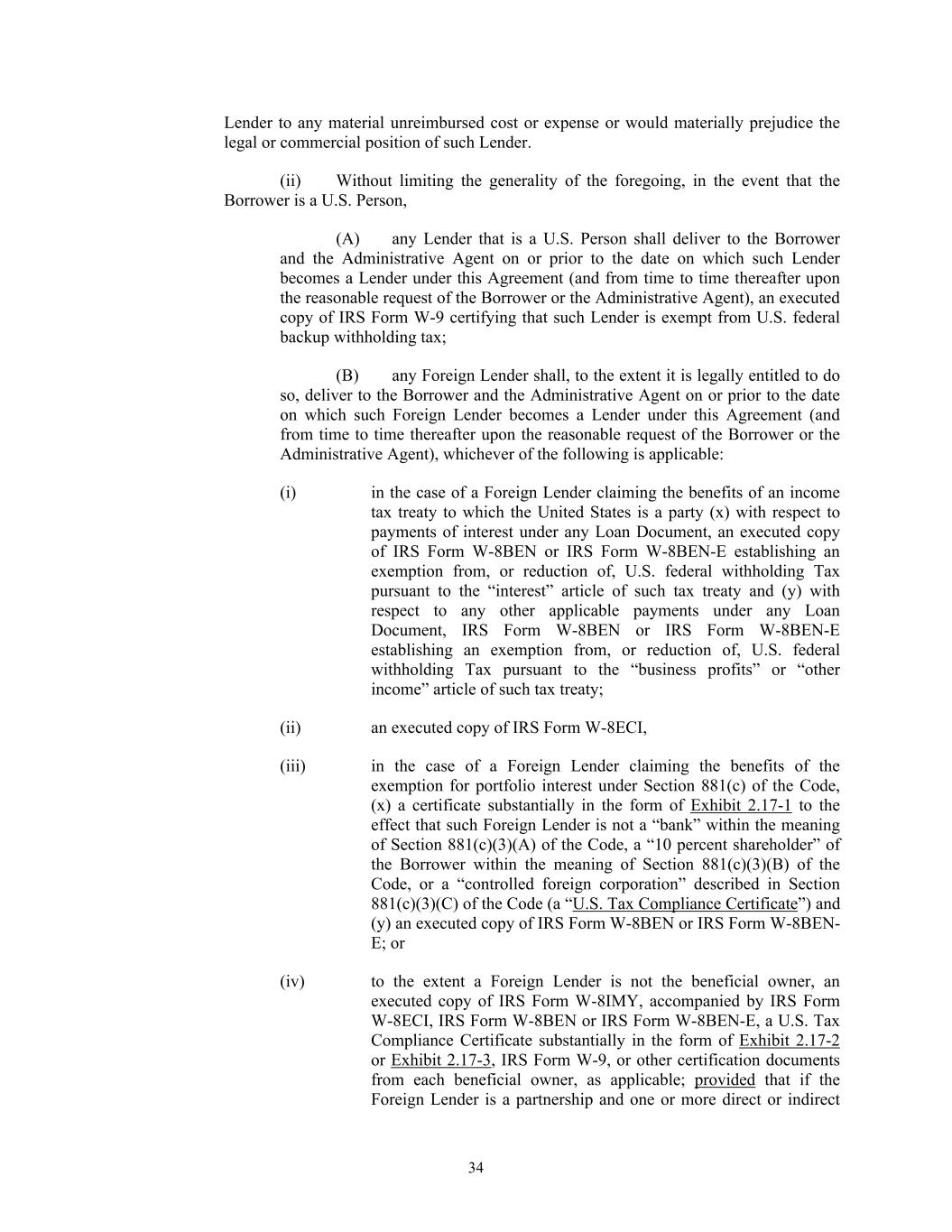
34 Lender to any material unreimbursed cost or expense or would materially prejudice the legal or commercial position of such Lender. (ii) Without limiting the generality of the foregoing, in the event that the Borrower is a U.S. Person, (A) any Lender that is a U.S. Person shall deliver to the Borrower and the Administrative Agent on or prior to the date on which such Lender becomes a Lender under this Agreement (and from time to time thereafter upon the reasonable request of the Borrower or the Administrative Agent), an executed copy of IRS Form W-9 certifying that such Lender is exempt from U.S. federal backup withholding tax; (B) any Foreign Lender shall, to the extent it is legally entitled to do so, deliver to the Borrower and the Administrative Agent on or prior to the date on which such Foreign Lender becomes a Lender under this Agreement (and from time to time thereafter upon the reasonable request of the Borrower or the Administrative Agent), whichever of the following is applicable: (i) in the case of a Foreign Lender claiming the benefits of an income tax treaty to which the United States is a party (x) with respect to payments of interest under any Loan Document, an executed copy of IRS Form W-8BEN or IRS Form W-8BEN-E establishing an exemption from, or reduction of, U.S. federal withholding Tax pursuant to the “interest” article of such tax treaty and (y) with respect to any other applicable payments under any Loan Document, IRS Form W-8BEN or IRS Form W-8BEN-E establishing an exemption from, or reduction of, U.S. federal withholding Tax pursuant to the “business profits” or “other income” article of such tax treaty; (ii) an executed copy of IRS Form W-8ECI, (iii) in the case of a Foreign Lender claiming the benefits of the exemption for portfolio interest under Section 881(c) of the Code, (x) a certificate substantially in the form of Exhibit 2.17-1 to the effect that such Foreign Lender is not a “bank” within the meaning of Section 881(c)(3)(A) of the Code, a “10 percent shareholder” of the Borrower within the meaning of Section 881(c)(3)(B) of the Code, or a “controlled foreign corporation” described in Section 881(c)(3)(C) of the Code (a “U.S. Tax Compliance Certificate”) and (y) an executed copy of IRS Form W-8BEN or IRS Form W-8BEN- E; or (iv) to the extent a Foreign Lender is not the beneficial owner, an executed copy of IRS Form W-8IMY, accompanied by IRS Form W-8ECI, IRS Form W-8BEN or IRS Form W-8BEN-E, a U.S. Tax Compliance Certificate substantially in the form of Exhibit 2.17-2 or Exhibit 2.17-3, IRS Form W-9, or other certification documents from each beneficial owner, as applicable; provided that if the Foreign Lender is a partnership and one or more direct or indirect
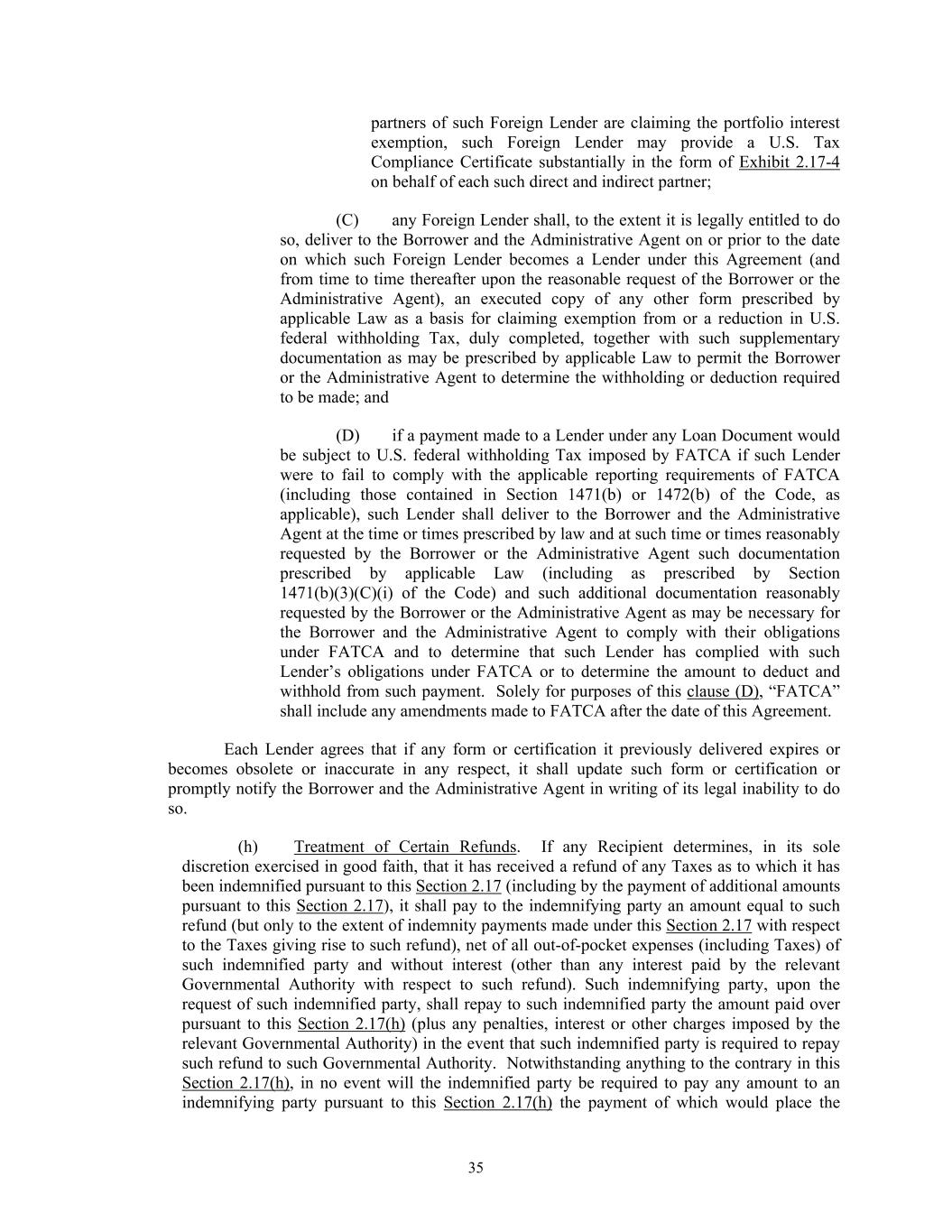
35 partners of such Foreign Lender are claiming the portfolio interest exemption, such Foreign Lender may provide a U.S. Tax Compliance Certificate substantially in the form of Exhibit 2.17-4 on behalf of each such direct and indirect partner; (C) any Foreign Lender shall, to the extent it is legally entitled to do so, deliver to the Borrower and the Administrative Agent on or prior to the date on which such Foreign Lender becomes a Lender under this Agreement (and from time to time thereafter upon the reasonable request of the Borrower or the Administrative Agent), an executed copy of any other form prescribed by applicable Law as a basis for claiming exemption from or a reduction in U.S. federal withholding Tax, duly completed, together with such supplementary documentation as may be prescribed by applicable Law to permit the Borrower or the Administrative Agent to determine the withholding or deduction required to be made; and (D) if a payment made to a Lender under any Loan Document would be subject to U.S. federal withholding Tax imposed by FATCA if such Lender were to fail to comply with the applicable reporting requirements of FATCA (including those contained in Section 1471(b) or 1472(b) of the Code, as applicable), such Lender shall deliver to the Borrower and the Administrative Agent at the time or times prescribed by law and at such time or times reasonably requested by the Borrower or the Administrative Agent such documentation prescribed by applicable Law (including as prescribed by Section 1471(b)(3)(C)(i) of the Code) and such additional documentation reasonably requested by the Borrower or the Administrative Agent as may be necessary for the Borrower and the Administrative Agent to comply with their obligations under FATCA and to determine that such Lender has complied with such Lender’s obligations under FATCA or to determine the amount to deduct and withhold from such payment. Solely for purposes of this clause (D), “FATCA” shall include any amendments made to FATCA after the date of this Agreement. Each Lender agrees that if any form or certification it previously delivered expires or becomes obsolete or inaccurate in any respect, it shall update such form or certification or promptly notify the Borrower and the Administrative Agent in writing of its legal inability to do so. (h) Treatment of Certain Refunds. If any Recipient determines, in its sole discretion exercised in good faith, that it has received a refund of any Taxes as to which it has been indemnified pursuant to this Section 2.17 (including by the payment of additional amounts pursuant to this Section 2.17), it shall pay to the indemnifying party an amount equal to such refund (but only to the extent of indemnity payments made under this Section 2.17 with respect to the Taxes giving rise to such refund), net of all out-of-pocket expenses (including Taxes) of such indemnified party and without interest (other than any interest paid by the relevant Governmental Authority with respect to such refund). Such indemnifying party, upon the request of such indemnified party, shall repay to such indemnified party the amount paid over pursuant to this Section 2.17(h) (plus any penalties, interest or other charges imposed by the relevant Governmental Authority) in the event that such indemnified party is required to repay such refund to such Governmental Authority. Notwithstanding anything to the contrary in this Section 2.17(h), in no event will the indemnified party be required to pay any amount to an indemnifying party pursuant to this Section 2.17(h) the payment of which would place the
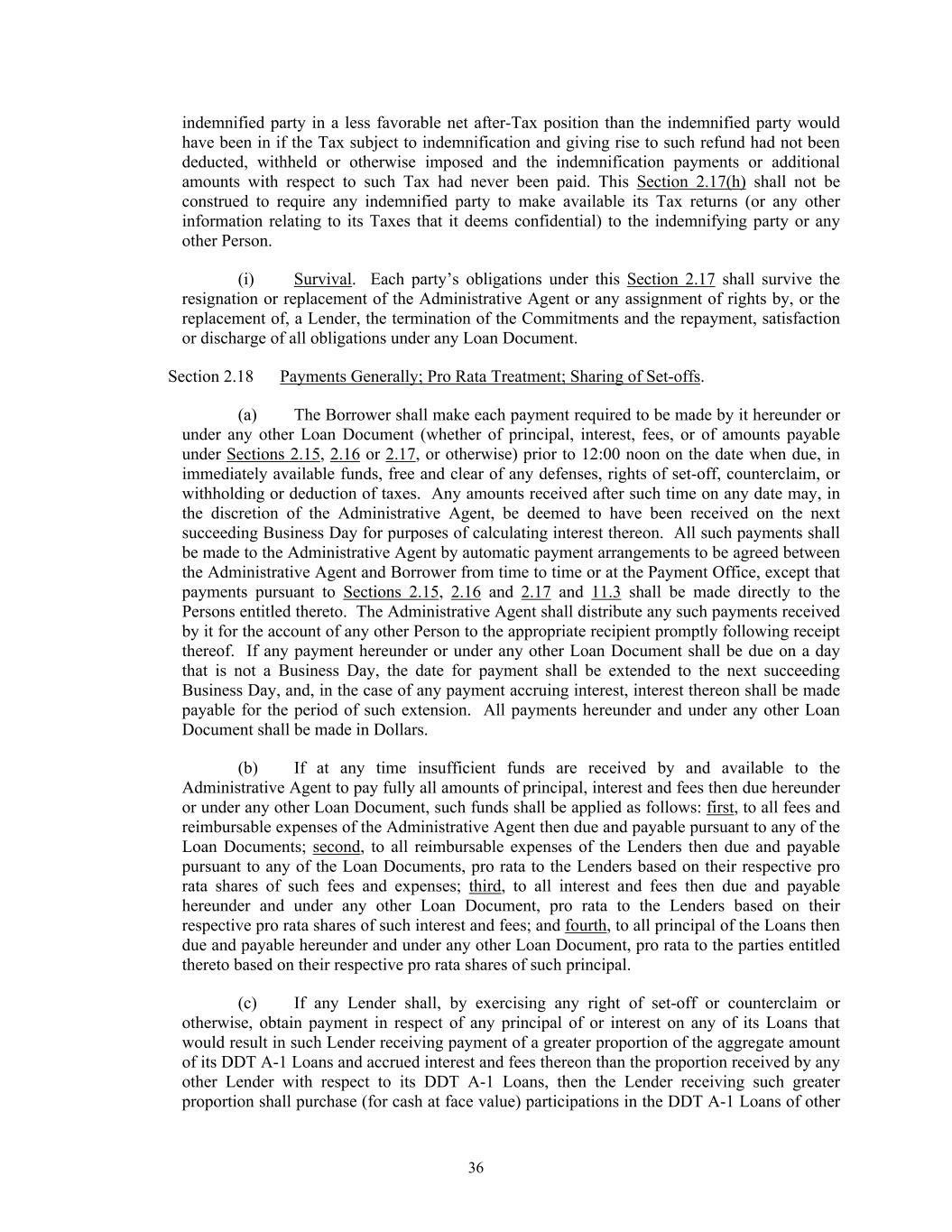
36 indemnified party in a less favorable net after-Tax position than the indemnified party would have been in if the Tax subject to indemnification and giving rise to such refund had not been deducted, withheld or otherwise imposed and the indemnification payments or additional amounts with respect to such Tax had never been paid. This Section 2.17(h) shall not be construed to require any indemnified party to make available its Tax returns (or any other information relating to its Taxes that it deems confidential) to the indemnifying party or any other Person. (i) Survival. Each party’s obligations under this Section 2.17 shall survive the resignation or replacement of the Administrative Agent or any assignment of rights by, or the replacement of, a Lender, the termination of the Commitments and the repayment, satisfaction or discharge of all obligations under any Loan Document. Section 2.18 Payments Generally; Pro Rata Treatment; Sharing of Set-offs. (a) The Borrower shall make each payment required to be made by it hereunder or under any other Loan Document (whether of principal, interest, fees, or of amounts payable under Sections 2.15, 2.16 or 2.17, or otherwise) prior to 12:00 noon on the date when due, in immediately available funds, free and clear of any defenses, rights of set-off, counterclaim, or withholding or deduction of taxes. Any amounts received after such time on any date may, in the discretion of the Administrative Agent, be deemed to have been received on the next succeeding Business Day for purposes of calculating interest thereon. All such payments shall be made to the Administrative Agent by automatic payment arrangements to be agreed between the Administrative Agent and Borrower from time to time or at the Payment Office, except that payments pursuant to Sections 2.15, 2.16 and 2.17 and 11.3 shall be made directly to the Persons entitled thereto. The Administrative Agent shall distribute any such payments received by it for the account of any other Person to the appropriate recipient promptly following receipt thereof. If any payment hereunder or under any other Loan Document shall be due on a day that is not a Business Day, the date for payment shall be extended to the next succeeding Business Day, and, in the case of any payment accruing interest, interest thereon shall be made payable for the period of such extension. All payments hereunder and under any other Loan Document shall be made in Dollars. (b) If at any time insufficient funds are received by and available to the Administrative Agent to pay fully all amounts of principal, interest and fees then due hereunder or under any other Loan Document, such funds shall be applied as follows: first, to all fees and reimbursable expenses of the Administrative Agent then due and payable pursuant to any of the Loan Documents; second, to all reimbursable expenses of the Lenders then due and payable pursuant to any of the Loan Documents, pro rata to the Lenders based on their respective pro rata shares of such fees and expenses; third, to all interest and fees then due and payable hereunder and under any other Loan Document, pro rata to the Lenders based on their respective pro rata shares of such interest and fees; and fourth, to all principal of the Loans then due and payable hereunder and under any other Loan Document, pro rata to the parties entitled thereto based on their respective pro rata shares of such principal. (c) If any Lender shall, by exercising any right of set-off or counterclaim or otherwise, obtain payment in respect of any principal of or interest on any of its Loans that would result in such Lender receiving payment of a greater proportion of the aggregate amount of its DDT A-1 Loans and accrued interest and fees thereon than the proportion received by any other Lender with respect to its DDT A-1 Loans, then the Lender receiving such greater proportion shall purchase (for cash at face value) participations in the DDT A-1 Loans of other
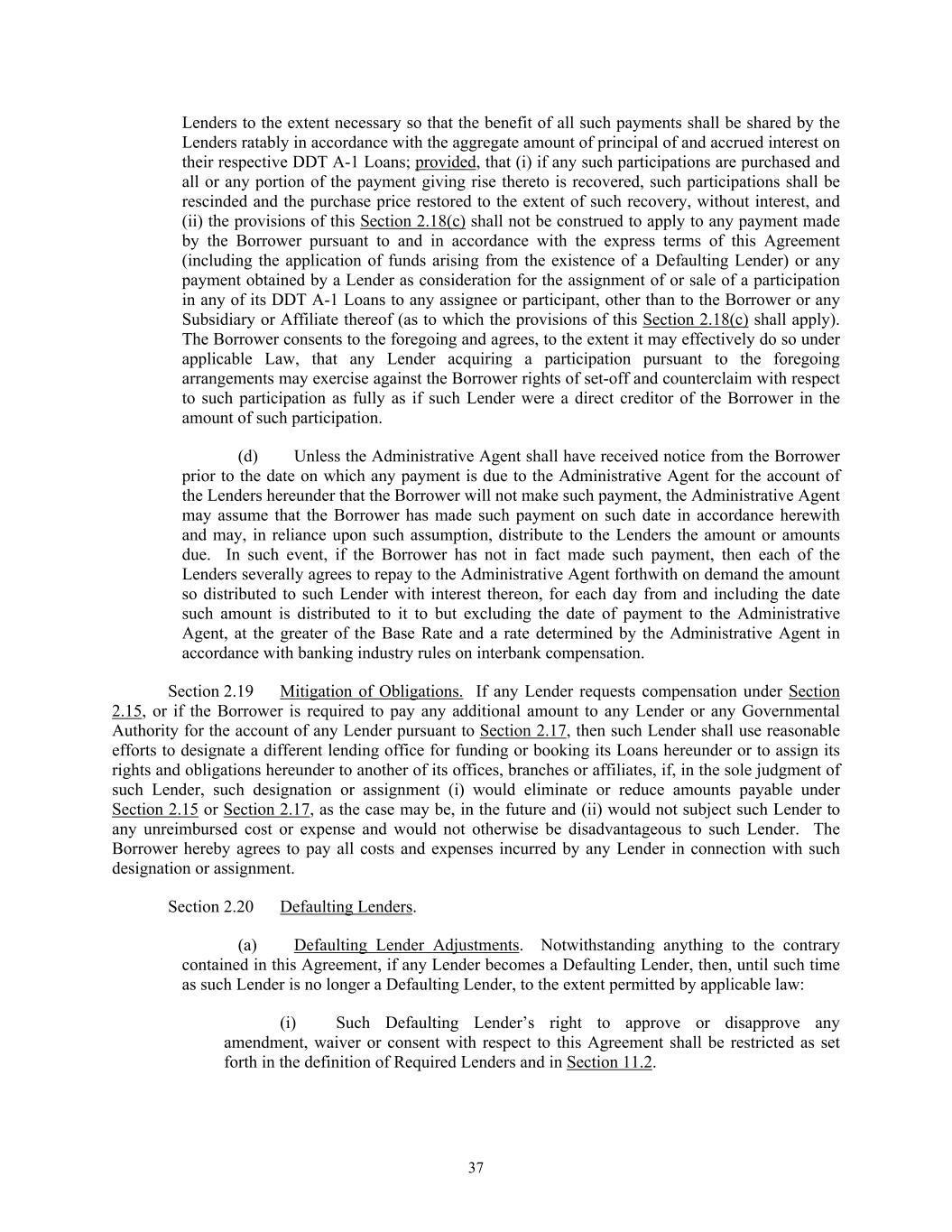
37 Lenders to the extent necessary so that the benefit of all such payments shall be shared by the Lenders ratably in accordance with the aggregate amount of principal of and accrued interest on their respective DDT A-1 Loans; provided, that (i) if any such participations are purchased and all or any portion of the payment giving rise thereto is recovered, such participations shall be rescinded and the purchase price restored to the extent of such recovery, without interest, and (ii) the provisions of this Section 2.18(c) shall not be construed to apply to any payment made by the Borrower pursuant to and in accordance with the express terms of this Agreement (including the application of funds arising from the existence of a Defaulting Lender) or any payment obtained by a Lender as consideration for the assignment of or sale of a participation in any of its DDT A-1 Loans to any assignee or participant, other than to the Borrower or any Subsidiary or Affiliate thereof (as to which the provisions of this Section 2.18(c) shall apply). The Borrower consents to the foregoing and agrees, to the extent it may effectively do so under applicable Law, that any Lender acquiring a participation pursuant to the foregoing arrangements may exercise against the Borrower rights of set-off and counterclaim with respect to such participation as fully as if such Lender were a direct creditor of the Borrower in the amount of such participation. (d) Unless the Administrative Agent shall have received notice from the Borrower prior to the date on which any payment is due to the Administrative Agent for the account of the Lenders hereunder that the Borrower will not make such payment, the Administrative Agent may assume that the Borrower has made such payment on such date in accordance herewith and may, in reliance upon such assumption, distribute to the Lenders the amount or amounts due. In such event, if the Borrower has not in fact made such payment, then each of the Lenders severally agrees to repay to the Administrative Agent forthwith on demand the amount so distributed to such Lender with interest thereon, for each day from and including the date such amount is distributed to it to but excluding the date of payment to the Administrative Agent, at the greater of the Base Rate and a rate determined by the Administrative Agent in accordance with banking industry rules on interbank compensation. Section 2.19 Mitigation of Obligations. If any Lender requests compensation under Section 2.15, or if the Borrower is required to pay any additional amount to any Lender or any Governmental Authority for the account of any Lender pursuant to Section 2.17, then such Lender shall use reasonable efforts to designate a different lending office for funding or booking its Loans hereunder or to assign its rights and obligations hereunder to another of its offices, branches or affiliates, if, in the sole judgment of such Lender, such designation or assignment (i) would eliminate or reduce amounts payable under Section 2.15 or Section 2.17, as the case may be, in the future and (ii) would not subject such Lender to any unreimbursed cost or expense and would not otherwise be disadvantageous to such Lender. The Borrower hereby agrees to pay all costs and expenses incurred by any Lender in connection with such designation or assignment. Section 2.20 Defaulting Lenders. (a) Defaulting Lender Adjustments. Notwithstanding anything to the contrary contained in this Agreement, if any Lender becomes a Defaulting Lender, then, until such time as such Lender is no longer a Defaulting Lender, to the extent permitted by applicable law: (i) Such Defaulting Lender’s right to approve or disapprove any amendment, waiver or consent with respect to this Agreement shall be restricted as set forth in the definition of Required Lenders and in Section 11.2.
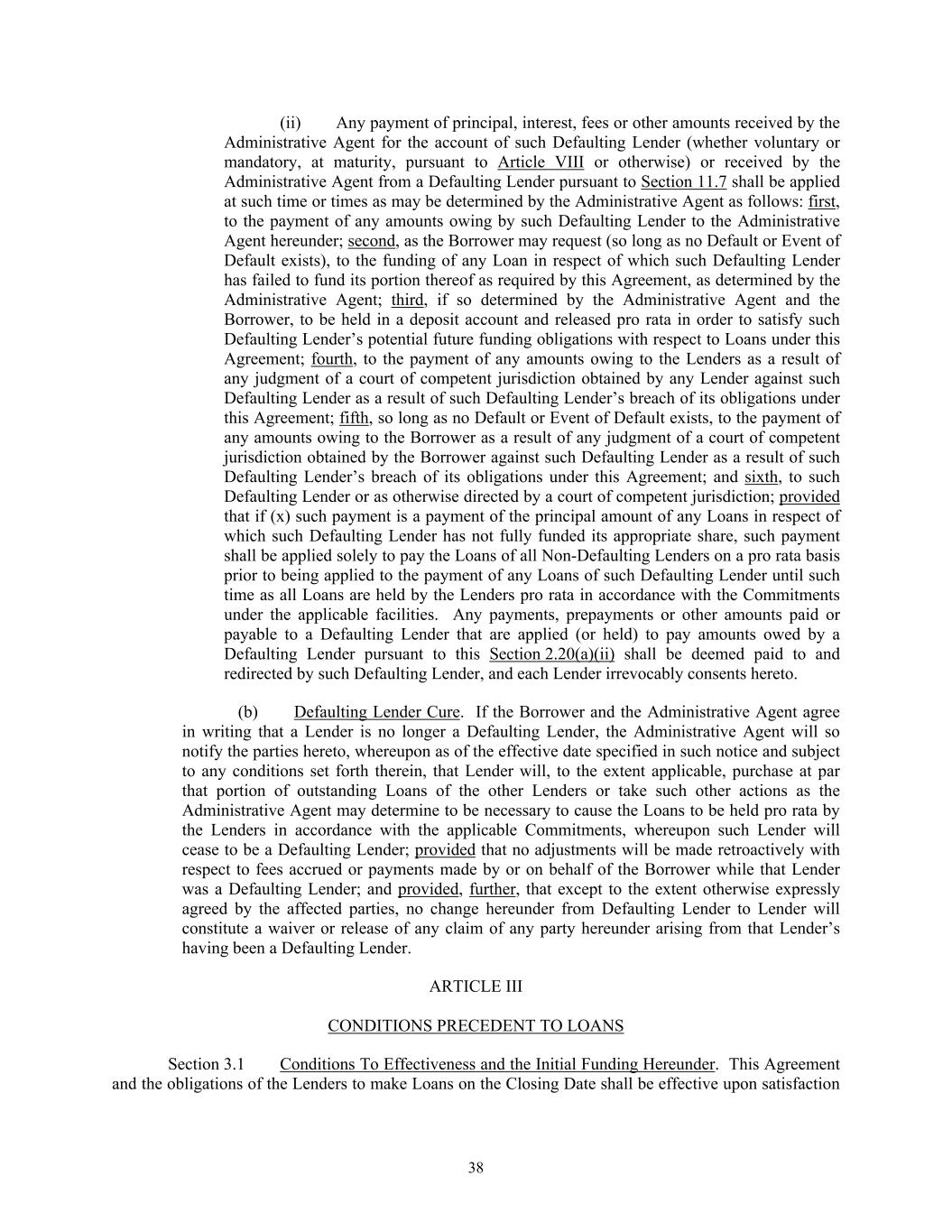
38 (ii) Any payment of principal, interest, fees or other amounts received by the Administrative Agent for the account of such Defaulting Lender (whether voluntary or mandatory, at maturity, pursuant to Article VIII or otherwise) or received by the Administrative Agent from a Defaulting Lender pursuant to Section 11.7 shall be applied at such time or times as may be determined by the Administrative Agent as follows: first, to the payment of any amounts owing by such Defaulting Lender to the Administrative Agent hereunder; second, as the Borrower may request (so long as no Default or Event of Default exists), to the funding of any Loan in respect of which such Defaulting Lender has failed to fund its portion thereof as required by this Agreement, as determined by the Administrative Agent; third, if so determined by the Administrative Agent and the Borrower, to be held in a deposit account and released pro rata in order to satisfy such Defaulting Lender’s potential future funding obligations with respect to Loans under this Agreement; fourth, to the payment of any amounts owing to the Lenders as a result of any judgment of a court of competent jurisdiction obtained by any Lender against such Defaulting Lender as a result of such Defaulting Lender’s breach of its obligations under this Agreement; fifth, so long as no Default or Event of Default exists, to the payment of any amounts owing to the Borrower as a result of any judgment of a court of competent jurisdiction obtained by the Borrower against such Defaulting Lender as a result of such Defaulting Lender’s breach of its obligations under this Agreement; and sixth, to such Defaulting Lender or as otherwise directed by a court of competent jurisdiction; provided that if (x) such payment is a payment of the principal amount of any Loans in respect of which such Defaulting Lender has not fully funded its appropriate share, such payment shall be applied solely to pay the Loans of all Non-Defaulting Lenders on a pro rata basis prior to being applied to the payment of any Loans of such Defaulting Lender until such time as all Loans are held by the Lenders pro rata in accordance with the Commitments under the applicable facilities. Any payments, prepayments or other amounts paid or payable to a Defaulting Lender that are applied (or held) to pay amounts owed by a Defaulting Lender pursuant to this Section 2.20(a)(ii) shall be deemed paid to and redirected by such Defaulting Lender, and each Lender irrevocably consents hereto. (b) Defaulting Lender Cure. If the Borrower and the Administrative Agent agree in writing that a Lender is no longer a Defaulting Lender, the Administrative Agent will so notify the parties hereto, whereupon as of the effective date specified in such notice and subject to any conditions set forth therein, that Lender will, to the extent applicable, purchase at par that portion of outstanding Loans of the other Lenders or take such other actions as the Administrative Agent may determine to be necessary to cause the Loans to be held pro rata by the Lenders in accordance with the applicable Commitments, whereupon such Lender will cease to be a Defaulting Lender; provided that no adjustments will be made retroactively with respect to fees accrued or payments made by or on behalf of the Borrower while that Lender was a Defaulting Lender; and provided, further, that except to the extent otherwise expressly agreed by the affected parties, no change hereunder from Defaulting Lender to Lender will constitute a waiver or release of any claim of any party hereunder arising from that Lender’s having been a Defaulting Lender. ARTICLE III CONDITIONS PRECEDENT TO LOANS Section 3.1 Conditions To Effectiveness and the Initial Funding Hereunder. This Agreement and the obligations of the Lenders to make Loans on the Closing Date shall be effective upon satisfaction
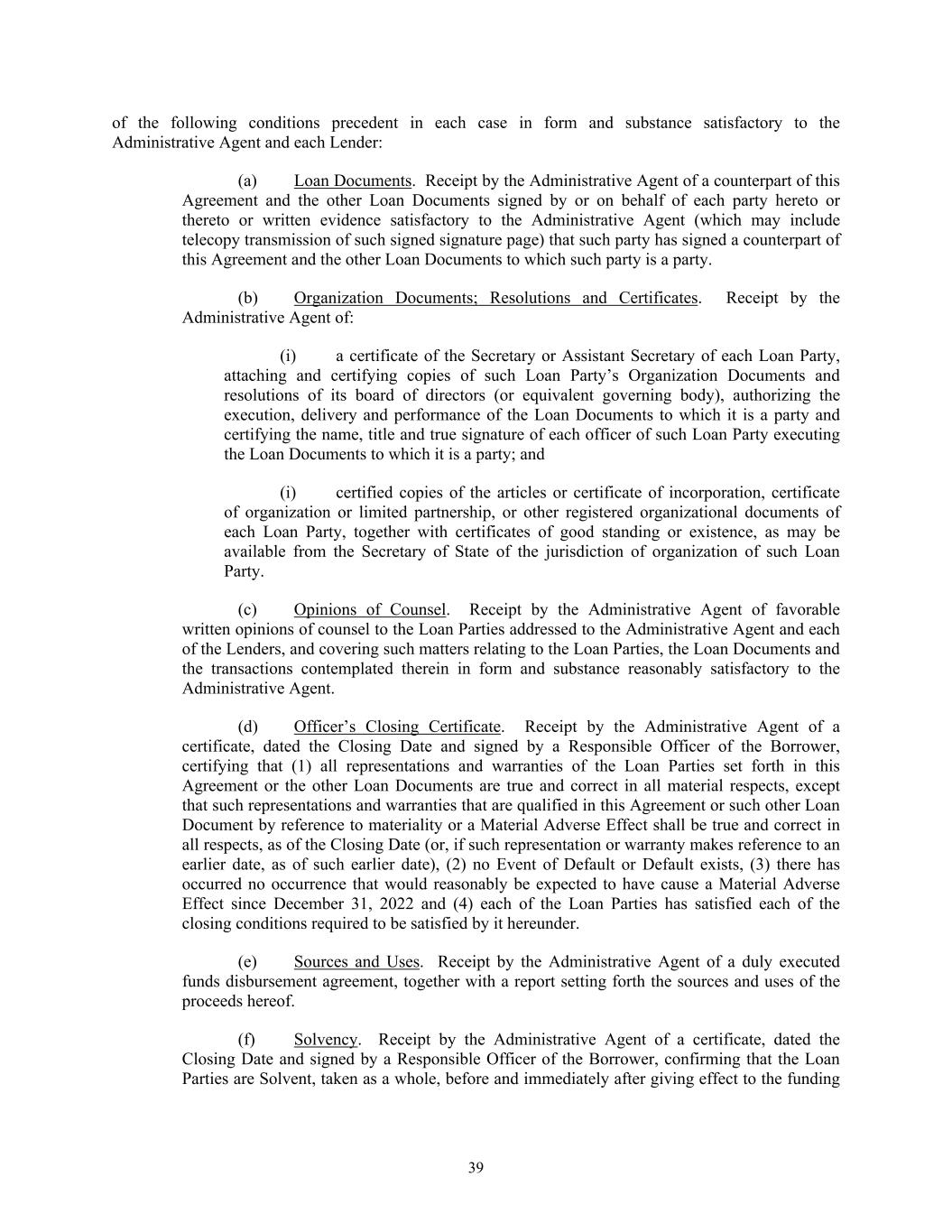
39 of the following conditions precedent in each case in form and substance satisfactory to the Administrative Agent and each Lender: (a) Loan Documents. Receipt by the Administrative Agent of a counterpart of this Agreement and the other Loan Documents signed by or on behalf of each party hereto or thereto or written evidence satisfactory to the Administrative Agent (which may include telecopy transmission of such signed signature page) that such party has signed a counterpart of this Agreement and the other Loan Documents to which such party is a party. (b) Organization Documents; Resolutions and Certificates. Receipt by the Administrative Agent of: (i) a certificate of the Secretary or Assistant Secretary of each Loan Party, attaching and certifying copies of such Loan Party’s Organization Documents and resolutions of its board of directors (or equivalent governing body), authorizing the execution, delivery and performance of the Loan Documents to which it is a party and certifying the name, title and true signature of each officer of such Loan Party executing the Loan Documents to which it is a party; and (i) certified copies of the articles or certificate of incorporation, certificate of organization or limited partnership, or other registered organizational documents of each Loan Party, together with certificates of good standing or existence, as may be available from the Secretary of State of the jurisdiction of organization of such Loan Party. (c) Opinions of Counsel. Receipt by the Administrative Agent of favorable written opinions of counsel to the Loan Parties addressed to the Administrative Agent and each of the Lenders, and covering such matters relating to the Loan Parties, the Loan Documents and the transactions contemplated therein in form and substance reasonably satisfactory to the Administrative Agent. (d) Officer’s Closing Certificate. Receipt by the Administrative Agent of a certificate, dated the Closing Date and signed by a Responsible Officer of the Borrower, certifying that (1) all representations and warranties of the Loan Parties set forth in this Agreement or the other Loan Documents are true and correct in all material respects, except that such representations and warranties that are qualified in this Agreement or such other Loan Document by reference to materiality or a Material Adverse Effect shall be true and correct in all respects, as of the Closing Date (or, if such representation or warranty makes reference to an earlier date, as of such earlier date), (2) no Event of Default or Default exists, (3) there has occurred no occurrence that would reasonably be expected to have cause a Material Adverse Effect since December 31, 2022 and (4) each of the Loan Parties has satisfied each of the closing conditions required to be satisfied by it hereunder. (e) Sources and Uses. Receipt by the Administrative Agent of a duly executed funds disbursement agreement, together with a report setting forth the sources and uses of the proceeds hereof. (f) Solvency. Receipt by the Administrative Agent of a certificate, dated the Closing Date and signed by a Responsible Officer of the Borrower, confirming that the Loan Parties are Solvent, taken as a whole, before and immediately after giving effect to the funding
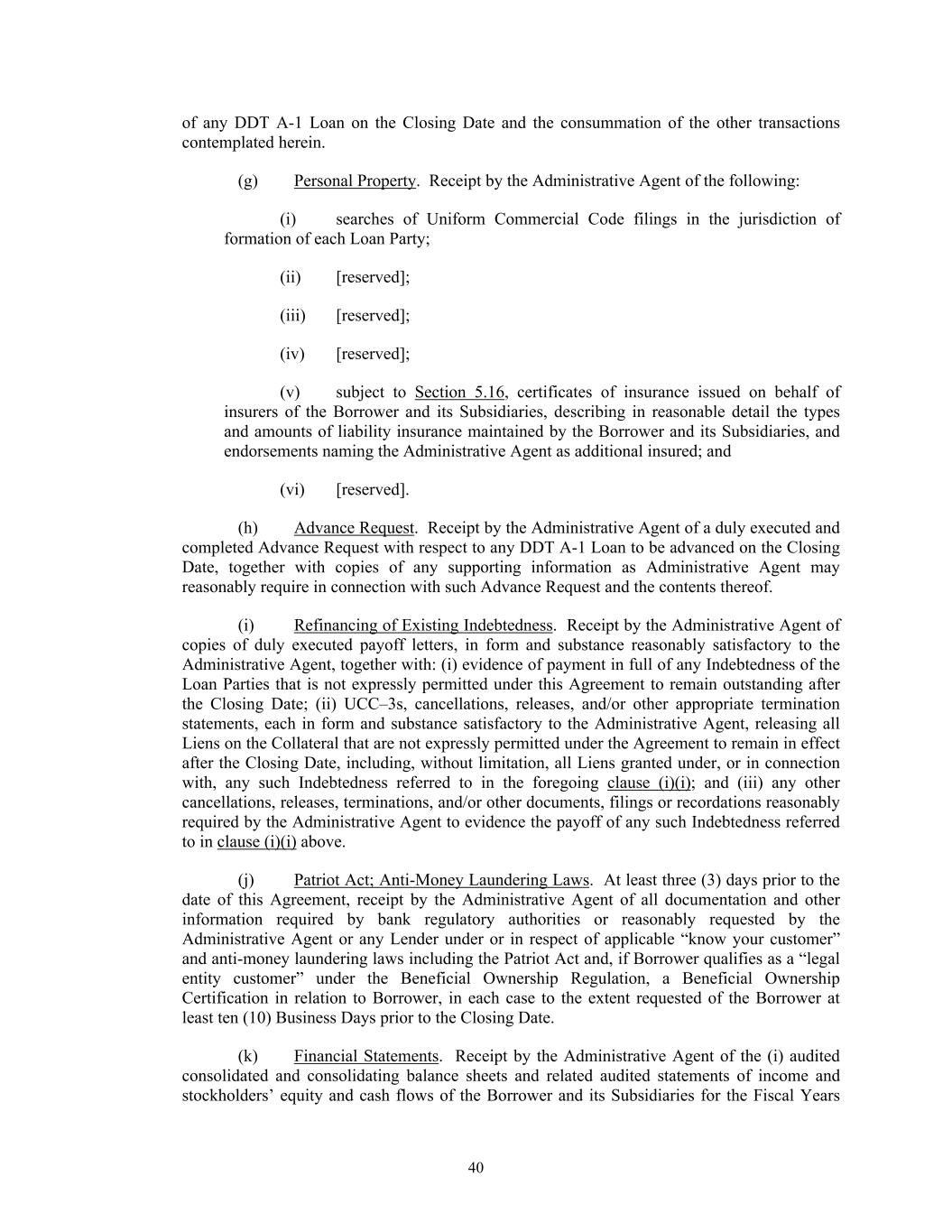
40 of any DDT A-1 Loan on the Closing Date and the consummation of the other transactions contemplated herein. (g) Personal Property. Receipt by the Administrative Agent of the following: (i) searches of Uniform Commercial Code filings in the jurisdiction of formation of each Loan Party; (ii) [reserved]; (iii) [reserved]; (iv) [reserved]; (v) subject to Section 5.16, certificates of insurance issued on behalf of insurers of the Borrower and its Subsidiaries, describing in reasonable detail the types and amounts of liability insurance maintained by the Borrower and its Subsidiaries, and endorsements naming the Administrative Agent as additional insured; and (vi) [reserved]. (h) Advance Request. Receipt by the Administrative Agent of a duly executed and completed Advance Request with respect to any DDT A-1 Loan to be advanced on the Closing Date, together with copies of any supporting information as Administrative Agent may reasonably require in connection with such Advance Request and the contents thereof. (i) Refinancing of Existing Indebtedness. Receipt by the Administrative Agent of copies of duly executed payoff letters, in form and substance reasonably satisfactory to the Administrative Agent, together with: (i) evidence of payment in full of any Indebtedness of the Loan Parties that is not expressly permitted under this Agreement to remain outstanding after the Closing Date; (ii) UCC–3s, cancellations, releases, and/or other appropriate termination statements, each in form and substance satisfactory to the Administrative Agent, releasing all Liens on the Collateral that are not expressly permitted under the Agreement to remain in effect after the Closing Date, including, without limitation, all Liens granted under, or in connection with, any such Indebtedness referred to in the foregoing clause (i)(i); and (iii) any other cancellations, releases, terminations, and/or other documents, filings or recordations reasonably required by the Administrative Agent to evidence the payoff of any such Indebtedness referred to in clause (i)(i) above. (j) Patriot Act; Anti-Money Laundering Laws. At least three (3) days prior to the date of this Agreement, receipt by the Administrative Agent of all documentation and other information required by bank regulatory authorities or reasonably requested by the Administrative Agent or any Lender under or in respect of applicable “know your customer” and anti-money laundering laws including the Patriot Act and, if Borrower qualifies as a “legal entity customer” under the Beneficial Ownership Regulation, a Beneficial Ownership Certification in relation to Borrower, in each case to the extent requested of the Borrower at least ten (10) Business Days prior to the Closing Date. (k) Financial Statements. Receipt by the Administrative Agent of the (i) audited consolidated and consolidating balance sheets and related audited statements of income and stockholders’ equity and cash flows of the Borrower and its Subsidiaries for the Fiscal Years
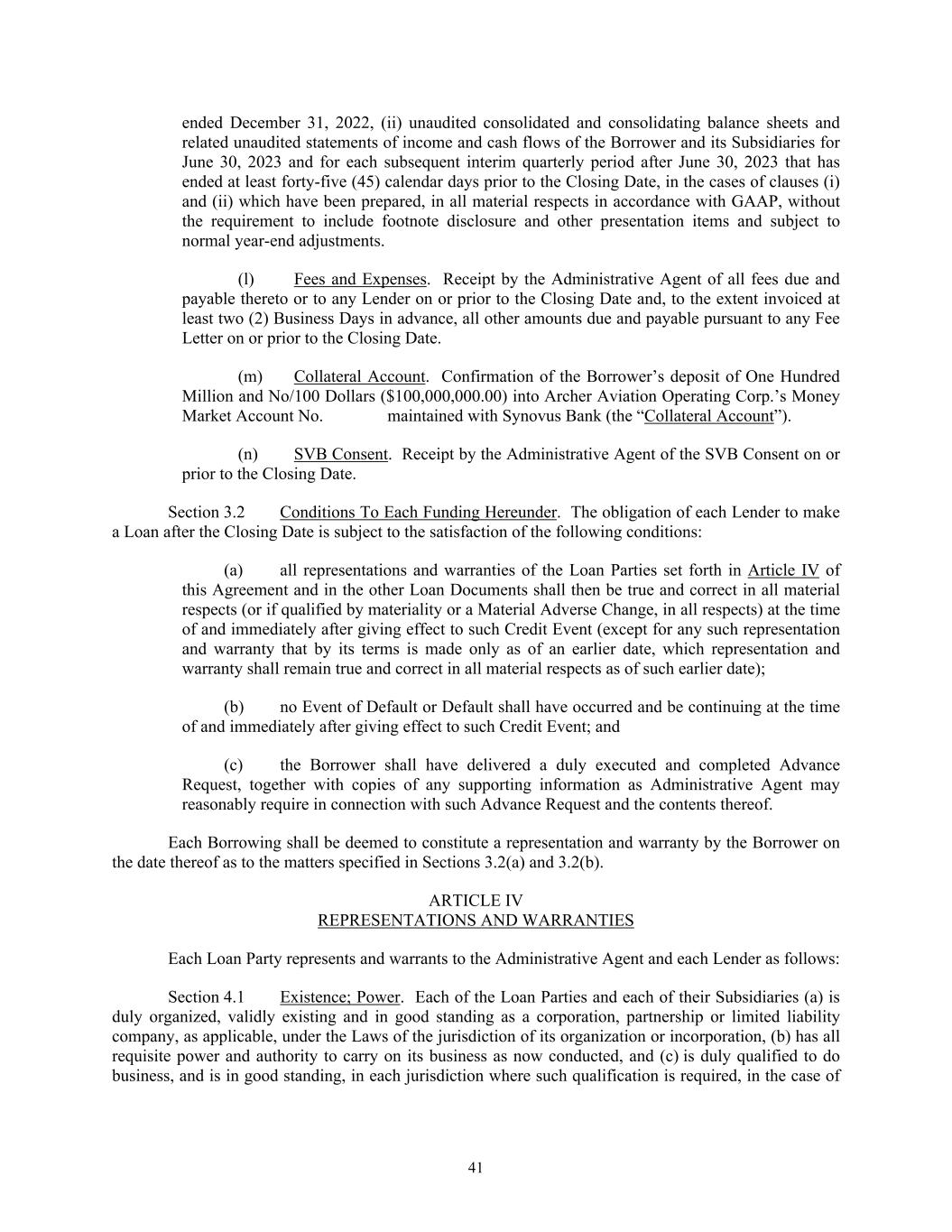
41 ended December 31, 2022, (ii) unaudited consolidated and consolidating balance sheets and related unaudited statements of income and cash flows of the Borrower and its Subsidiaries for June 30, 2023 and for each subsequent interim quarterly period after June 30, 2023 that has ended at least forty-five (45) calendar days prior to the Closing Date, in the cases of clauses (i) and (ii) which have been prepared, in all material respects in accordance with GAAP, without the requirement to include footnote disclosure and other presentation items and subject to normal year-end adjustments. (l) Fees and Expenses. Receipt by the Administrative Agent of all fees due and payable thereto or to any Lender on or prior to the Closing Date and, to the extent invoiced at least two (2) Business Days in advance, all other amounts due and payable pursuant to any Fee Letter on or prior to the Closing Date. (m) Collateral Account. Confirmation of the Borrower’s deposit of One Hundred Million and No/100 Dollars ($100,000,000.00) into Archer Aviation Operating Corp.’s Money Market Account No. maintained with Synovus Bank (the “Collateral Account”). (n) SVB Consent. Receipt by the Administrative Agent of the SVB Consent on or prior to the Closing Date. Section 3.2 Conditions To Each Funding Hereunder. The obligation of each Lender to make a Loan after the Closing Date is subject to the satisfaction of the following conditions: (a) all representations and warranties of the Loan Parties set forth in Article IV of this Agreement and in the other Loan Documents shall then be true and correct in all material respects (or if qualified by materiality or a Material Adverse Change, in all respects) at the time of and immediately after giving effect to such Credit Event (except for any such representation and warranty that by its terms is made only as of an earlier date, which representation and warranty shall remain true and correct in all material respects as of such earlier date); (b) no Event of Default or Default shall have occurred and be continuing at the time of and immediately after giving effect to such Credit Event; and (c) the Borrower shall have delivered a duly executed and completed Advance Request, together with copies of any supporting information as Administrative Agent may reasonably require in connection with such Advance Request and the contents thereof. Each Borrowing shall be deemed to constitute a representation and warranty by the Borrower on the date thereof as to the matters specified in Sections 3.2(a) and 3.2(b). ARTICLE IV REPRESENTATIONS AND WARRANTIES Each Loan Party represents and warrants to the Administrative Agent and each Lender as follows: Section 4.1 Existence; Power. Each of the Loan Parties and each of their Subsidiaries (a) is duly organized, validly existing and in good standing as a corporation, partnership or limited liability company, as applicable, under the Laws of the jurisdiction of its organization or incorporation, (b) has all requisite power and authority to carry on its business as now conducted, and (c) is duly qualified to do business, and is in good standing, in each jurisdiction where such qualification is required, in the case of
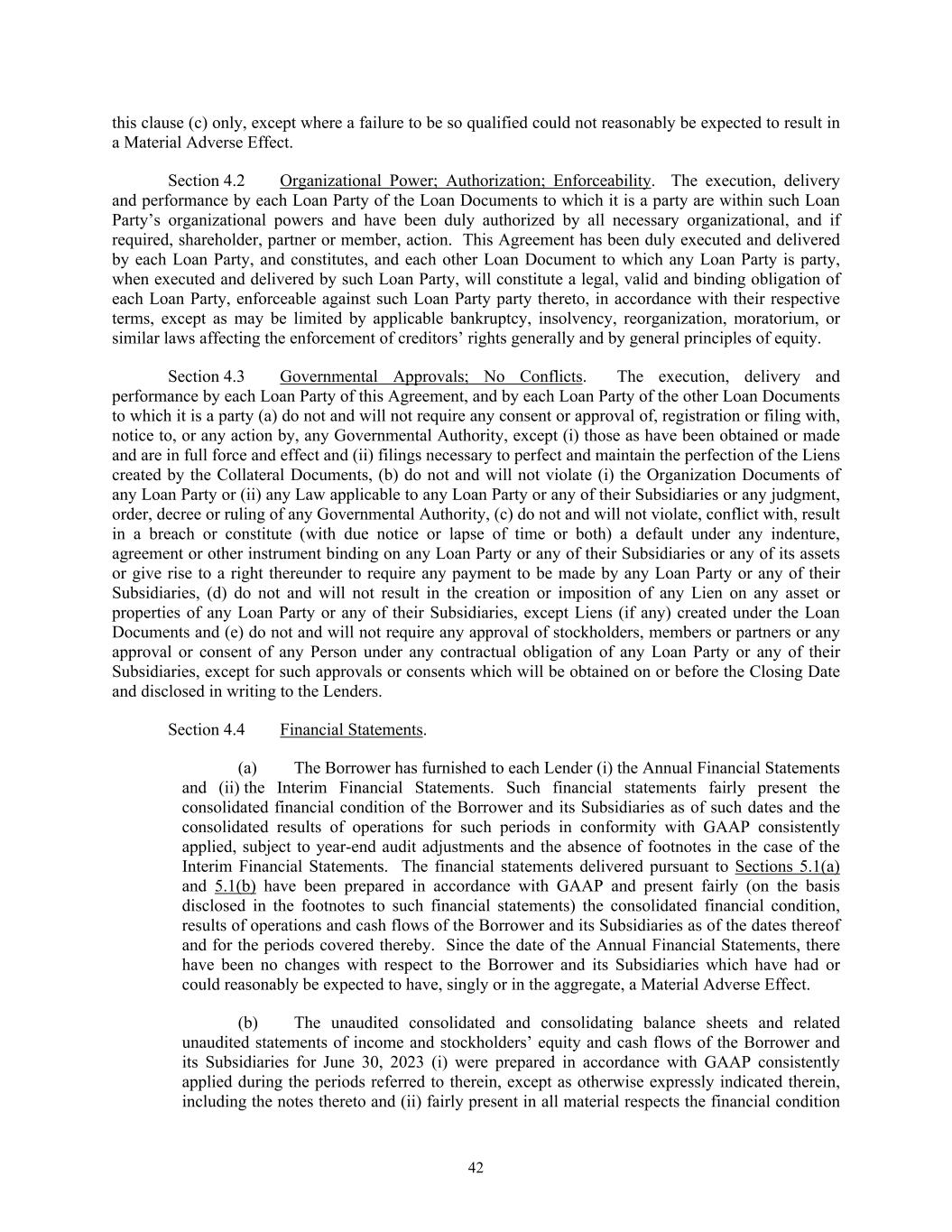
42 this clause (c) only, except where a failure to be so qualified could not reasonably be expected to result in a Material Adverse Effect. Section 4.2 Organizational Power; Authorization; Enforceability. The execution, delivery and performance by each Loan Party of the Loan Documents to which it is a party are within such Loan Party’s organizational powers and have been duly authorized by all necessary organizational, and if required, shareholder, partner or member, action. This Agreement has been duly executed and delivered by each Loan Party, and constitutes, and each other Loan Document to which any Loan Party is party, when executed and delivered by such Loan Party, will constitute a legal, valid and binding obligation of each Loan Party, enforceable against such Loan Party party thereto, in accordance with their respective terms, except as may be limited by applicable bankruptcy, insolvency, reorganization, moratorium, or similar laws affecting the enforcement of creditors’ rights generally and by general principles of equity. Section 4.3 Governmental Approvals; No Conflicts. The execution, delivery and performance by each Loan Party of this Agreement, and by each Loan Party of the other Loan Documents to which it is a party (a) do not and will not require any consent or approval of, registration or filing with, notice to, or any action by, any Governmental Authority, except (i) those as have been obtained or made and are in full force and effect and (ii) filings necessary to perfect and maintain the perfection of the Liens created by the Collateral Documents, (b) do not and will not violate (i) the Organization Documents of any Loan Party or (ii) any Law applicable to any Loan Party or any of their Subsidiaries or any judgment, order, decree or ruling of any Governmental Authority, (c) do not and will not violate, conflict with, result in a breach or constitute (with due notice or lapse of time or both) a default under any indenture, agreement or other instrument binding on any Loan Party or any of their Subsidiaries or any of its assets or give rise to a right thereunder to require any payment to be made by any Loan Party or any of their Subsidiaries, (d) do not and will not result in the creation or imposition of any Lien on any asset or properties of any Loan Party or any of their Subsidiaries, except Liens (if any) created under the Loan Documents and (e) do not and will not require any approval of stockholders, members or partners or any approval or consent of any Person under any contractual obligation of any Loan Party or any of their Subsidiaries, except for such approvals or consents which will be obtained on or before the Closing Date and disclosed in writing to the Lenders. Section 4.4 Financial Statements. (a) The Borrower has furnished to each Lender (i) the Annual Financial Statements and (ii) the Interim Financial Statements. Such financial statements fairly present the consolidated financial condition of the Borrower and its Subsidiaries as of such dates and the consolidated results of operations for such periods in conformity with GAAP consistently applied, subject to year-end audit adjustments and the absence of footnotes in the case of the Interim Financial Statements. The financial statements delivered pursuant to Sections 5.1(a) and 5.1(b) have been prepared in accordance with GAAP and present fairly (on the basis disclosed in the footnotes to such financial statements) the consolidated financial condition, results of operations and cash flows of the Borrower and its Subsidiaries as of the dates thereof and for the periods covered thereby. Since the date of the Annual Financial Statements, there have been no changes with respect to the Borrower and its Subsidiaries which have had or could reasonably be expected to have, singly or in the aggregate, a Material Adverse Effect. (b) The unaudited consolidated and consolidating balance sheets and related unaudited statements of income and stockholders’ equity and cash flows of the Borrower and its Subsidiaries for June 30, 2023 (i) were prepared in accordance with GAAP consistently applied during the periods referred to therein, except as otherwise expressly indicated therein, including the notes thereto and (ii) fairly present in all material respects the financial condition
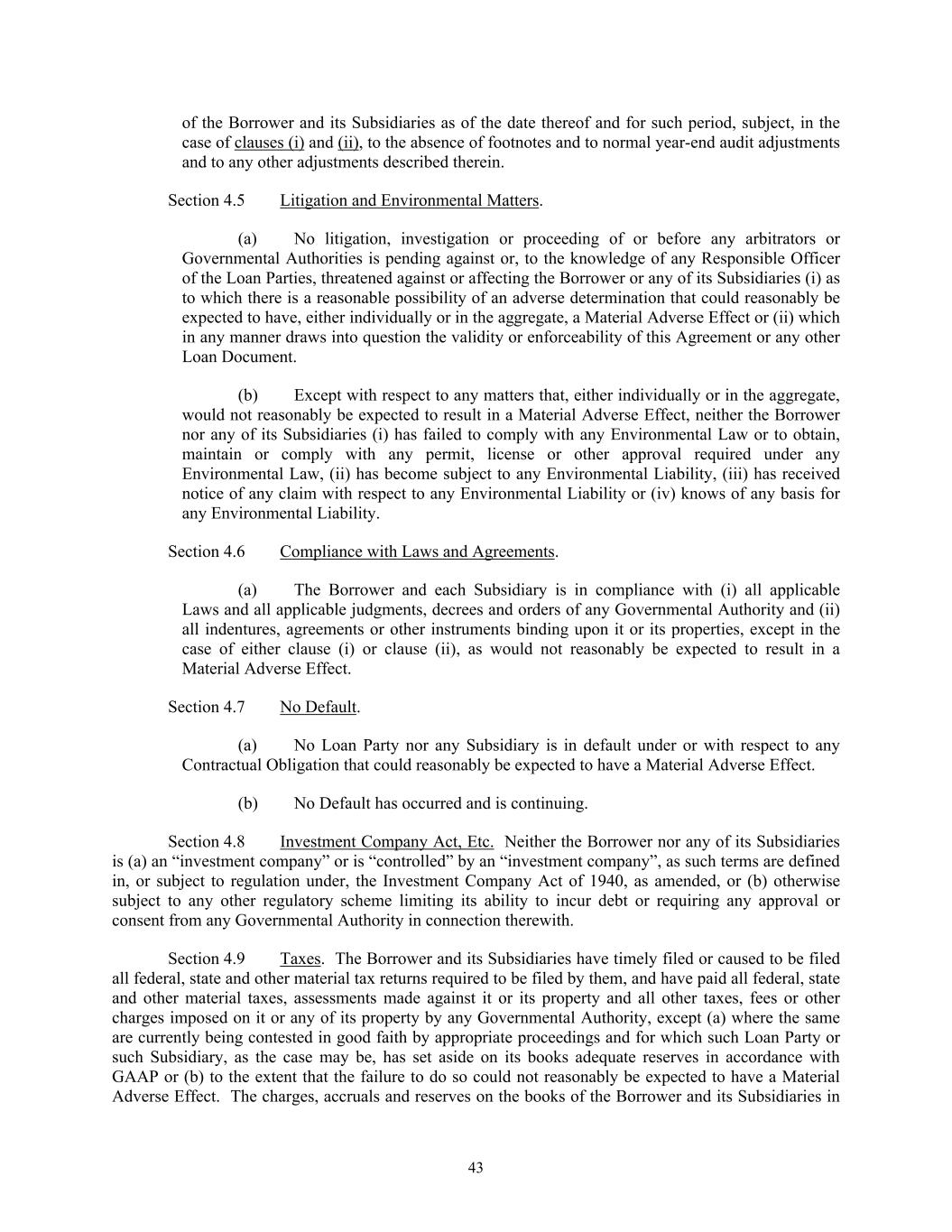
43 of the Borrower and its Subsidiaries as of the date thereof and for such period, subject, in the case of clauses (i) and (ii), to the absence of footnotes and to normal year-end audit adjustments and to any other adjustments described therein. Section 4.5 Litigation and Environmental Matters. (a) No litigation, investigation or proceeding of or before any arbitrators or Governmental Authorities is pending against or, to the knowledge of any Responsible Officer of the Loan Parties, threatened against or affecting the Borrower or any of its Subsidiaries (i) as to which there is a reasonable possibility of an adverse determination that could reasonably be expected to have, either individually or in the aggregate, a Material Adverse Effect or (ii) which in any manner draws into question the validity or enforceability of this Agreement or any other Loan Document. (b) Except with respect to any matters that, either individually or in the aggregate, would not reasonably be expected to result in a Material Adverse Effect, neither the Borrower nor any of its Subsidiaries (i) has failed to comply with any Environmental Law or to obtain, maintain or comply with any permit, license or other approval required under any Environmental Law, (ii) has become subject to any Environmental Liability, (iii) has received notice of any claim with respect to any Environmental Liability or (iv) knows of any basis for any Environmental Liability. Section 4.6 Compliance with Laws and Agreements. (a) The Borrower and each Subsidiary is in compliance with (i) all applicable Laws and all applicable judgments, decrees and orders of any Governmental Authority and (ii) all indentures, agreements or other instruments binding upon it or its properties, except in the case of either clause (i) or clause (ii), as would not reasonably be expected to result in a Material Adverse Effect. Section 4.7 No Default. (a) No Loan Party nor any Subsidiary is in default under or with respect to any Contractual Obligation that could reasonably be expected to have a Material Adverse Effect. (b) No Default has occurred and is continuing. Section 4.8 Investment Company Act, Etc. Neither the Borrower nor any of its Subsidiaries is (a) an “investment company” or is “controlled” by an “investment company”, as such terms are defined in, or subject to regulation under, the Investment Company Act of 1940, as amended, or (b) otherwise subject to any other regulatory scheme limiting its ability to incur debt or requiring any approval or consent from any Governmental Authority in connection therewith. Section 4.9 Taxes. The Borrower and its Subsidiaries have timely filed or caused to be filed all federal, state and other material tax returns required to be filed by them, and have paid all federal, state and other material taxes, assessments made against it or its property and all other taxes, fees or other charges imposed on it or any of its property by any Governmental Authority, except (a) where the same are currently being contested in good faith by appropriate proceedings and for which such Loan Party or such Subsidiary, as the case may be, has set aside on its books adequate reserves in accordance with GAAP or (b) to the extent that the failure to do so could not reasonably be expected to have a Material Adverse Effect. The charges, accruals and reserves on the books of the Borrower and its Subsidiaries in
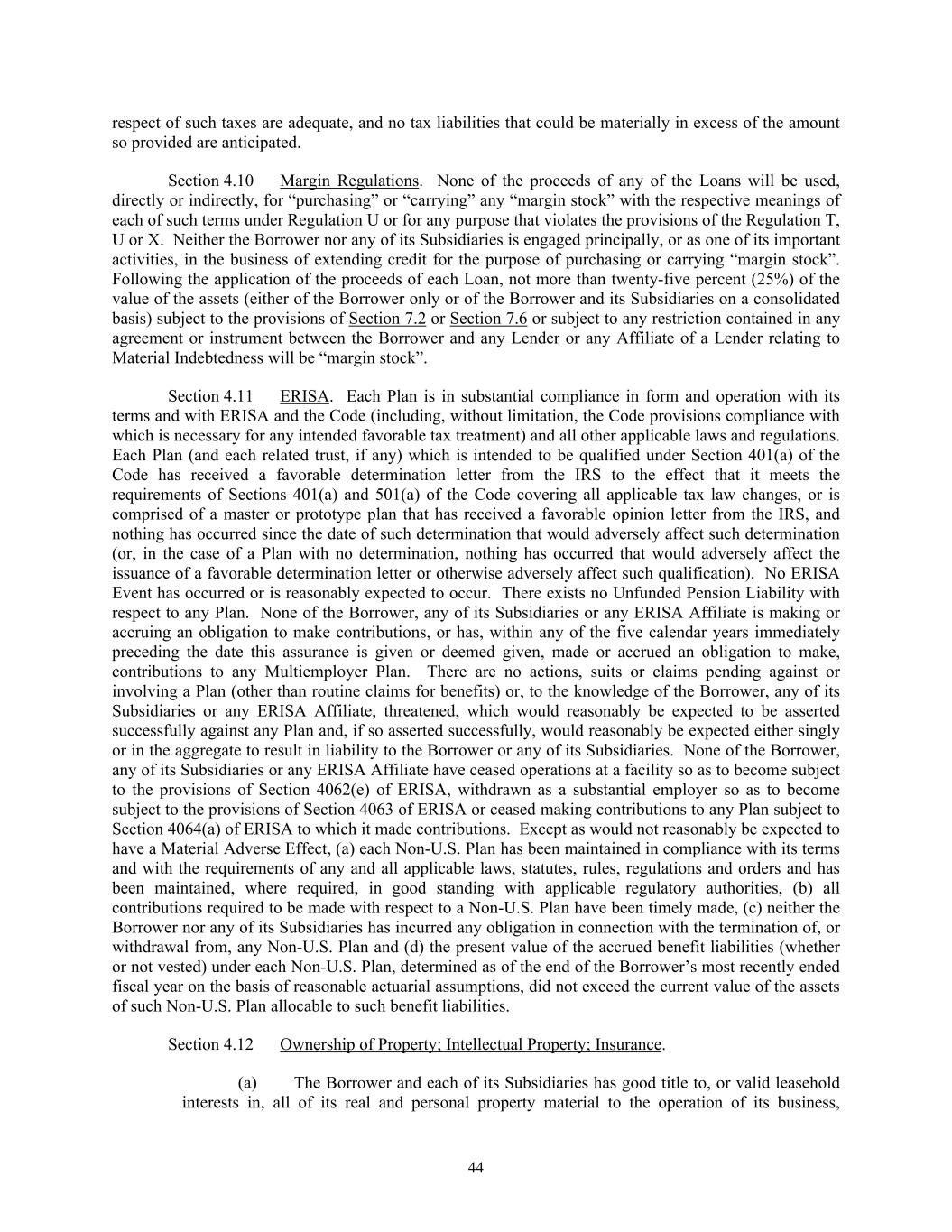
44 respect of such taxes are adequate, and no tax liabilities that could be materially in excess of the amount so provided are anticipated. Section 4.10 Margin Regulations. None of the proceeds of any of the Loans will be used, directly or indirectly, for “purchasing” or “carrying” any “margin stock” with the respective meanings of each of such terms under Regulation U or for any purpose that violates the provisions of the Regulation T, U or X. Neither the Borrower nor any of its Subsidiaries is engaged principally, or as one of its important activities, in the business of extending credit for the purpose of purchasing or carrying “margin stock”. Following the application of the proceeds of each Loan, not more than twenty-five percent (25%) of the value of the assets (either of the Borrower only or of the Borrower and its Subsidiaries on a consolidated basis) subject to the provisions of Section 7.2 or Section 7.6 or subject to any restriction contained in any agreement or instrument between the Borrower and any Lender or any Affiliate of a Lender relating to Material Indebtedness will be “margin stock”. Section 4.11 ERISA. Each Plan is in substantial compliance in form and operation with its terms and with ERISA and the Code (including, without limitation, the Code provisions compliance with which is necessary for any intended favorable tax treatment) and all other applicable laws and regulations. Each Plan (and each related trust, if any) which is intended to be qualified under Section 401(a) of the Code has received a favorable determination letter from the IRS to the effect that it meets the requirements of Sections 401(a) and 501(a) of the Code covering all applicable tax law changes, or is comprised of a master or prototype plan that has received a favorable opinion letter from the IRS, and nothing has occurred since the date of such determination that would adversely affect such determination (or, in the case of a Plan with no determination, nothing has occurred that would adversely affect the issuance of a favorable determination letter or otherwise adversely affect such qualification). No ERISA Event has occurred or is reasonably expected to occur. There exists no Unfunded Pension Liability with respect to any Plan. None of the Borrower, any of its Subsidiaries or any ERISA Affiliate is making or accruing an obligation to make contributions, or has, within any of the five calendar years immediately preceding the date this assurance is given or deemed given, made or accrued an obligation to make, contributions to any Multiemployer Plan. There are no actions, suits or claims pending against or involving a Plan (other than routine claims for benefits) or, to the knowledge of the Borrower, any of its Subsidiaries or any ERISA Affiliate, threatened, which would reasonably be expected to be asserted successfully against any Plan and, if so asserted successfully, would reasonably be expected either singly or in the aggregate to result in liability to the Borrower or any of its Subsidiaries. None of the Borrower, any of its Subsidiaries or any ERISA Affiliate have ceased operations at a facility so as to become subject to the provisions of Section 4062(e) of ERISA, withdrawn as a substantial employer so as to become subject to the provisions of Section 4063 of ERISA or ceased making contributions to any Plan subject to Section 4064(a) of ERISA to which it made contributions. Except as would not reasonably be expected to have a Material Adverse Effect, (a) each Non-U.S. Plan has been maintained in compliance with its terms and with the requirements of any and all applicable laws, statutes, rules, regulations and orders and has been maintained, where required, in good standing with applicable regulatory authorities, (b) all contributions required to be made with respect to a Non-U.S. Plan have been timely made, (c) neither the Borrower nor any of its Subsidiaries has incurred any obligation in connection with the termination of, or withdrawal from, any Non-U.S. Plan and (d) the present value of the accrued benefit liabilities (whether or not vested) under each Non-U.S. Plan, determined as of the end of the Borrower’s most recently ended fiscal year on the basis of reasonable actuarial assumptions, did not exceed the current value of the assets of such Non-U.S. Plan allocable to such benefit liabilities. Section 4.12 Ownership of Property; Intellectual Property; Insurance. (a) The Borrower and each of its Subsidiaries has good title to, or valid leasehold interests in, all of its real and personal property material to the operation of its business,
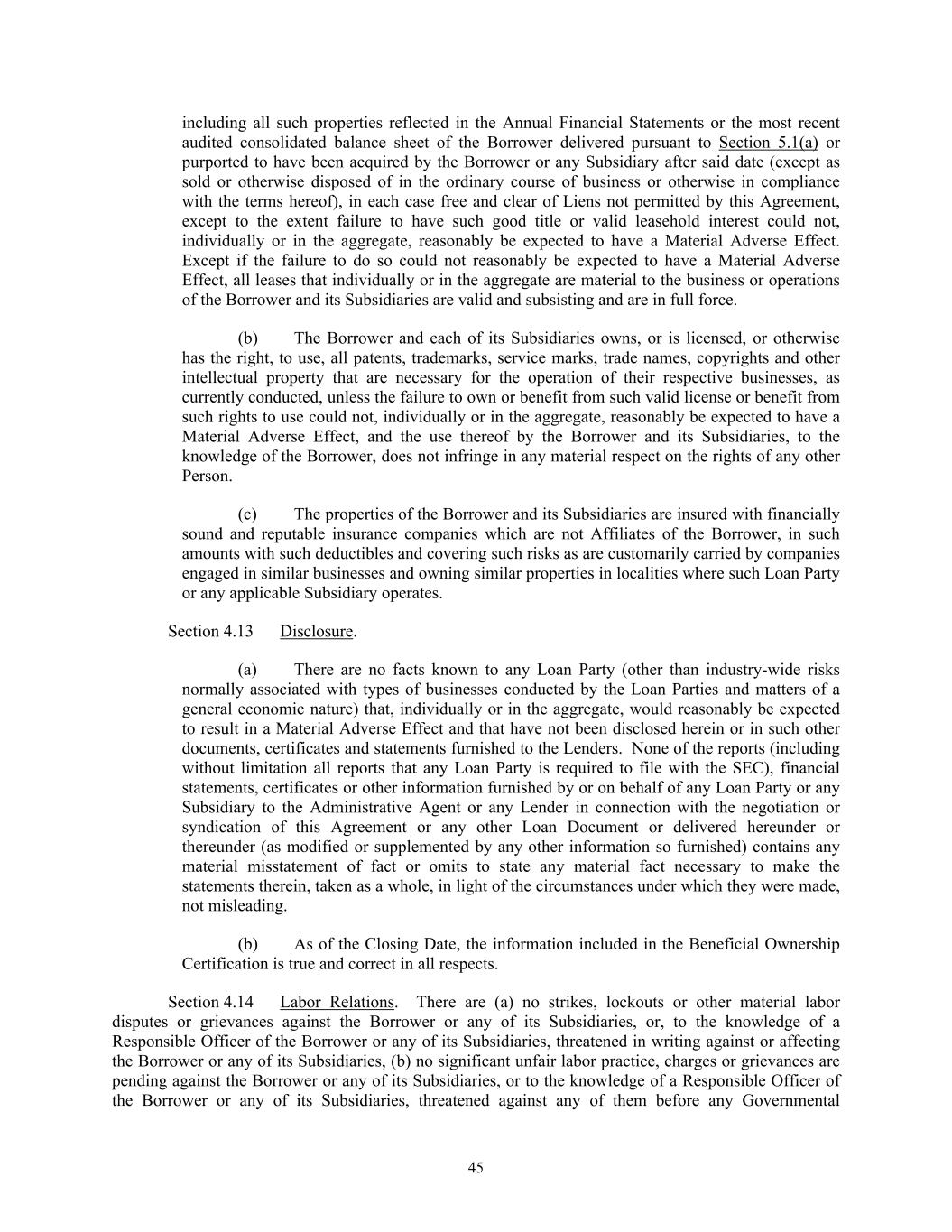
45 including all such properties reflected in the Annual Financial Statements or the most recent audited consolidated balance sheet of the Borrower delivered pursuant to Section 5.1(a) or purported to have been acquired by the Borrower or any Subsidiary after said date (except as sold or otherwise disposed of in the ordinary course of business or otherwise in compliance with the terms hereof), in each case free and clear of Liens not permitted by this Agreement, except to the extent failure to have such good title or valid leasehold interest could not, individually or in the aggregate, reasonably be expected to have a Material Adverse Effect. Except if the failure to do so could not reasonably be expected to have a Material Adverse Effect, all leases that individually or in the aggregate are material to the business or operations of the Borrower and its Subsidiaries are valid and subsisting and are in full force. (b) The Borrower and each of its Subsidiaries owns, or is licensed, or otherwise has the right, to use, all patents, trademarks, service marks, trade names, copyrights and other intellectual property that are necessary for the operation of their respective businesses, as currently conducted, unless the failure to own or benefit from such valid license or benefit from such rights to use could not, individually or in the aggregate, reasonably be expected to have a Material Adverse Effect, and the use thereof by the Borrower and its Subsidiaries, to the knowledge of the Borrower, does not infringe in any material respect on the rights of any other Person. (c) The properties of the Borrower and its Subsidiaries are insured with financially sound and reputable insurance companies which are not Affiliates of the Borrower, in such amounts with such deductibles and covering such risks as are customarily carried by companies engaged in similar businesses and owning similar properties in localities where such Loan Party or any applicable Subsidiary operates. Section 4.13 Disclosure. (a) There are no facts known to any Loan Party (other than industry-wide risks normally associated with types of businesses conducted by the Loan Parties and matters of a general economic nature) that, individually or in the aggregate, would reasonably be expected to result in a Material Adverse Effect and that have not been disclosed herein or in such other documents, certificates and statements furnished to the Lenders. None of the reports (including without limitation all reports that any Loan Party is required to file with the SEC), financial statements, certificates or other information furnished by or on behalf of any Loan Party or any Subsidiary to the Administrative Agent or any Lender in connection with the negotiation or syndication of this Agreement or any other Loan Document or delivered hereunder or thereunder (as modified or supplemented by any other information so furnished) contains any material misstatement of fact or omits to state any material fact necessary to make the statements therein, taken as a whole, in light of the circumstances under which they were made, not misleading. (b) As of the Closing Date, the information included in the Beneficial Ownership Certification is true and correct in all respects. Section 4.14 Labor Relations. There are (a) no strikes, lockouts or other material labor disputes or grievances against the Borrower or any of its Subsidiaries, or, to the knowledge of a Responsible Officer of the Borrower or any of its Subsidiaries, threatened in writing against or affecting the Borrower or any of its Subsidiaries, (b) no significant unfair labor practice, charges or grievances are pending against the Borrower or any of its Subsidiaries, or to the knowledge of a Responsible Officer of the Borrower or any of its Subsidiaries, threatened against any of them before any Governmental
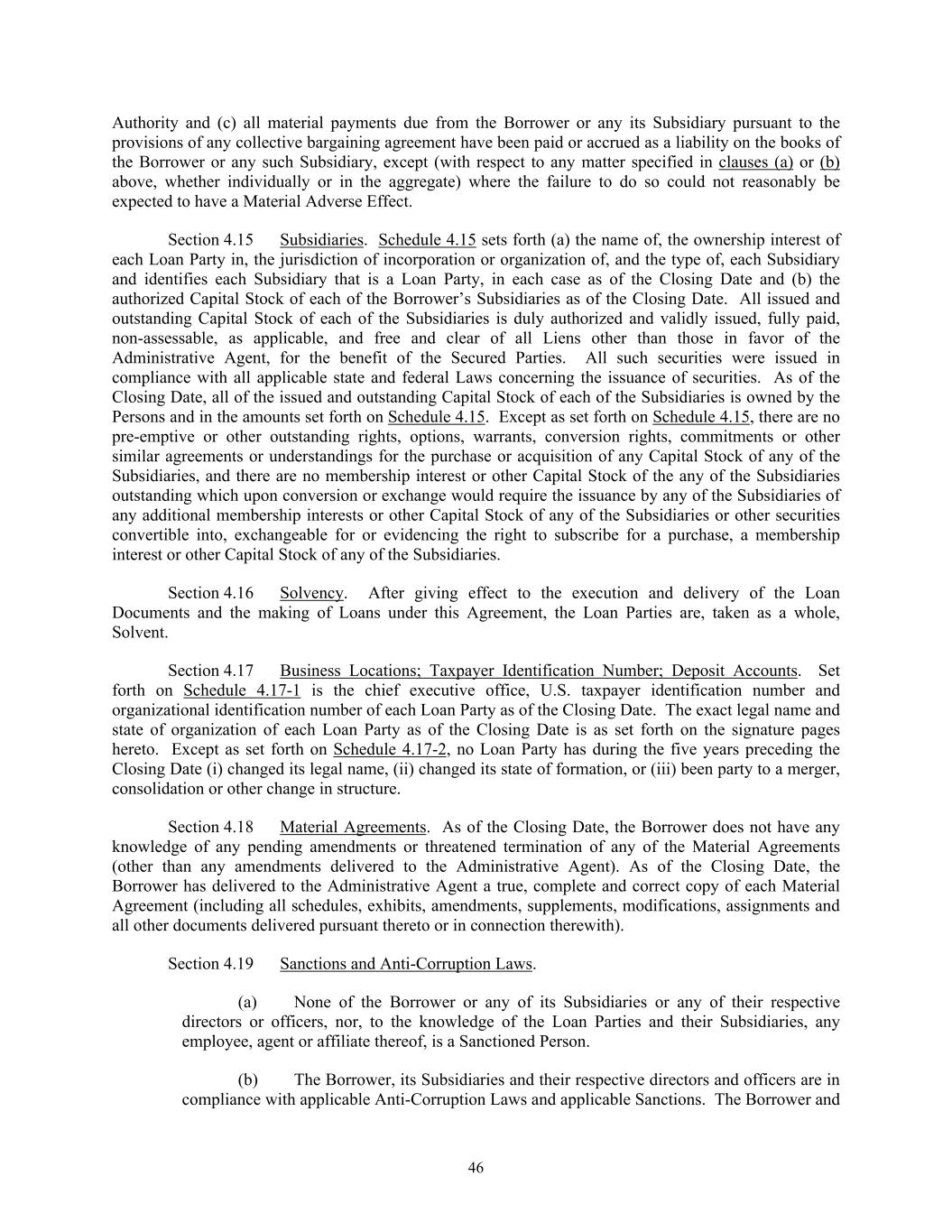
46 Authority and (c) all material payments due from the Borrower or any its Subsidiary pursuant to the provisions of any collective bargaining agreement have been paid or accrued as a liability on the books of the Borrower or any such Subsidiary, except (with respect to any matter specified in clauses (a) or (b) above, whether individually or in the aggregate) where the failure to do so could not reasonably be expected to have a Material Adverse Effect. Section 4.15 Subsidiaries. Schedule 4.15 sets forth (a) the name of, the ownership interest of each Loan Party in, the jurisdiction of incorporation or organization of, and the type of, each Subsidiary and identifies each Subsidiary that is a Loan Party, in each case as of the Closing Date and (b) the authorized Capital Stock of each of the Borrower’s Subsidiaries as of the Closing Date. All issued and outstanding Capital Stock of each of the Subsidiaries is duly authorized and validly issued, fully paid, non-assessable, as applicable, and free and clear of all Liens other than those in favor of the Administrative Agent, for the benefit of the Secured Parties. All such securities were issued in compliance with all applicable state and federal Laws concerning the issuance of securities. As of the Closing Date, all of the issued and outstanding Capital Stock of each of the Subsidiaries is owned by the Persons and in the amounts set forth on Schedule 4.15. Except as set forth on Schedule 4.15, there are no pre-emptive or other outstanding rights, options, warrants, conversion rights, commitments or other similar agreements or understandings for the purchase or acquisition of any Capital Stock of any of the Subsidiaries, and there are no membership interest or other Capital Stock of the any of the Subsidiaries outstanding which upon conversion or exchange would require the issuance by any of the Subsidiaries of any additional membership interests or other Capital Stock of any of the Subsidiaries or other securities convertible into, exchangeable for or evidencing the right to subscribe for a purchase, a membership interest or other Capital Stock of any of the Subsidiaries. Section 4.16 Solvency. After giving effect to the execution and delivery of the Loan Documents and the making of Loans under this Agreement, the Loan Parties are, taken as a whole, Solvent. Section 4.17 Business Locations; Taxpayer Identification Number; Deposit Accounts. Set forth on Schedule 4.17-1 is the chief executive office, U.S. taxpayer identification number and organizational identification number of each Loan Party as of the Closing Date. The exact legal name and state of organization of each Loan Party as of the Closing Date is as set forth on the signature pages hereto. Except as set forth on Schedule 4.17-2, no Loan Party has during the five years preceding the Closing Date (i) changed its legal name, (ii) changed its state of formation, or (iii) been party to a merger, consolidation or other change in structure. Section 4.18 Material Agreements. As of the Closing Date, the Borrower does not have any knowledge of any pending amendments or threatened termination of any of the Material Agreements (other than any amendments delivered to the Administrative Agent). As of the Closing Date, the Borrower has delivered to the Administrative Agent a true, complete and correct copy of each Material Agreement (including all schedules, exhibits, amendments, supplements, modifications, assignments and all other documents delivered pursuant thereto or in connection therewith). Section 4.19 Sanctions and Anti-Corruption Laws. (a) None of the Borrower or any of its Subsidiaries or any of their respective directors or officers, nor, to the knowledge of the Loan Parties and their Subsidiaries, any employee, agent or affiliate thereof, is a Sanctioned Person. (b) The Borrower, its Subsidiaries and their respective directors and officers are in compliance with applicable Anti-Corruption Laws and applicable Sanctions. The Borrower and
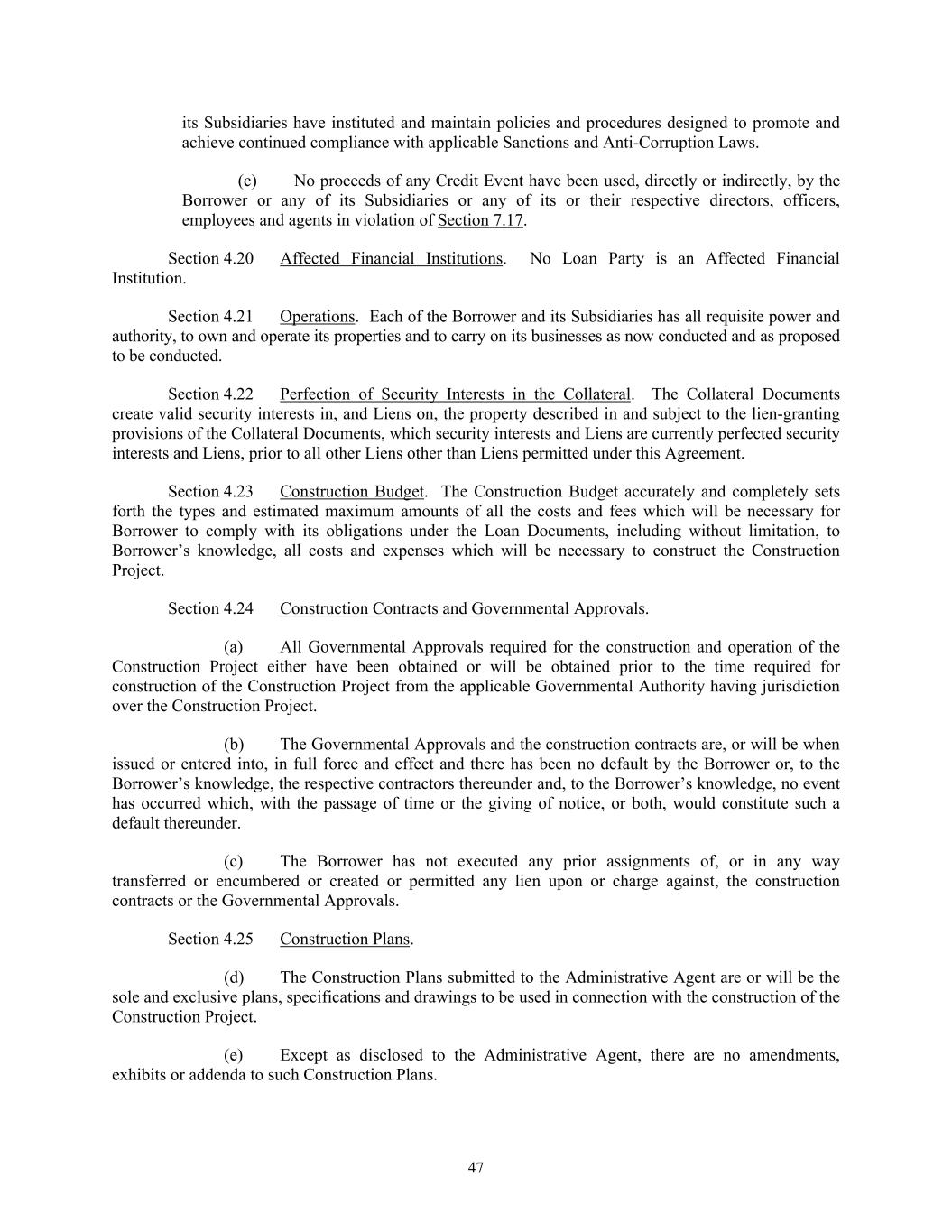
47 its Subsidiaries have instituted and maintain policies and procedures designed to promote and achieve continued compliance with applicable Sanctions and Anti-Corruption Laws. (c) No proceeds of any Credit Event have been used, directly or indirectly, by the Borrower or any of its Subsidiaries or any of its or their respective directors, officers, employees and agents in violation of Section 7.17. Section 4.20 Affected Financial Institutions. No Loan Party is an Affected Financial Institution. Section 4.21 Operations. Each of the Borrower and its Subsidiaries has all requisite power and authority, to own and operate its properties and to carry on its businesses as now conducted and as proposed to be conducted. Section 4.22 Perfection of Security Interests in the Collateral. The Collateral Documents create valid security interests in, and Liens on, the property described in and subject to the lien-granting provisions of the Collateral Documents, which security interests and Liens are currently perfected security interests and Liens, prior to all other Liens other than Liens permitted under this Agreement. Section 4.23 Construction Budget. The Construction Budget accurately and completely sets forth the types and estimated maximum amounts of all the costs and fees which will be necessary for Borrower to comply with its obligations under the Loan Documents, including without limitation, to Borrower’s knowledge, all costs and expenses which will be necessary to construct the Construction Project. Section 4.24 Construction Contracts and Governmental Approvals. (a) All Governmental Approvals required for the construction and operation of the Construction Project either have been obtained or will be obtained prior to the time required for construction of the Construction Project from the applicable Governmental Authority having jurisdiction over the Construction Project. (b) The Governmental Approvals and the construction contracts are, or will be when issued or entered into, in full force and effect and there has been no default by the Borrower or, to the Borrower’s knowledge, the respective contractors thereunder and, to the Borrower’s knowledge, no event has occurred which, with the passage of time or the giving of notice, or both, would constitute such a default thereunder. (c) The Borrower has not executed any prior assignments of, or in any way transferred or encumbered or created or permitted any lien upon or charge against, the construction contracts or the Governmental Approvals. Section 4.25 Construction Plans. (d) The Construction Plans submitted to the Administrative Agent are or will be the sole and exclusive plans, specifications and drawings to be used in connection with the construction of the Construction Project. (e) Except as disclosed to the Administrative Agent, there are no amendments, exhibits or addenda to such Construction Plans.
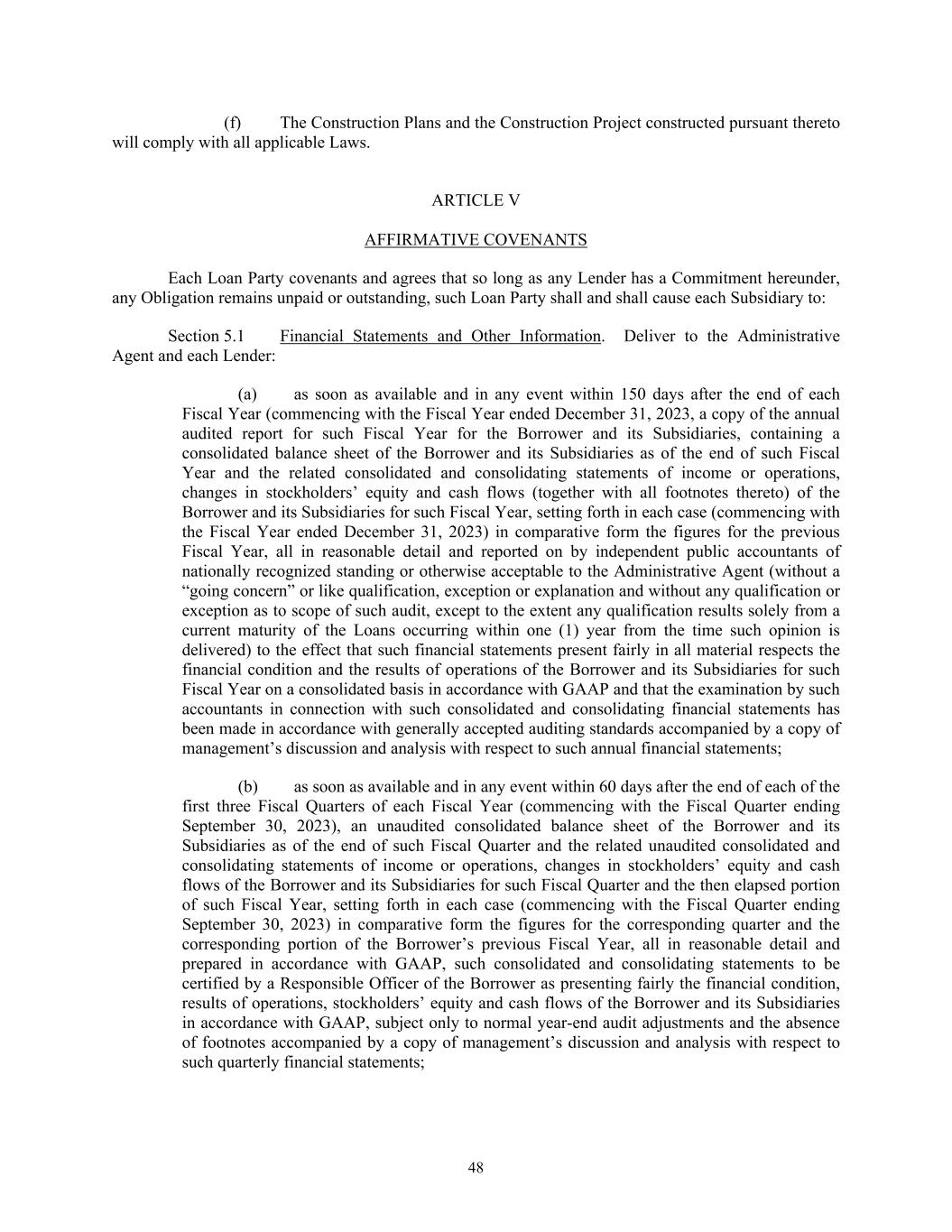
48 (f) The Construction Plans and the Construction Project constructed pursuant thereto will comply with all applicable Laws. ARTICLE V AFFIRMATIVE COVENANTS Each Loan Party covenants and agrees that so long as any Lender has a Commitment hereunder, any Obligation remains unpaid or outstanding, such Loan Party shall and shall cause each Subsidiary to: Section 5.1 Financial Statements and Other Information. Deliver to the Administrative Agent and each Lender: (a) as soon as available and in any event within 150 days after the end of each Fiscal Year (commencing with the Fiscal Year ended December 31, 2023, a copy of the annual audited report for such Fiscal Year for the Borrower and its Subsidiaries, containing a consolidated balance sheet of the Borrower and its Subsidiaries as of the end of such Fiscal Year and the related consolidated and consolidating statements of income or operations, changes in stockholders’ equity and cash flows (together with all footnotes thereto) of the Borrower and its Subsidiaries for such Fiscal Year, setting forth in each case (commencing with the Fiscal Year ended December 31, 2023) in comparative form the figures for the previous Fiscal Year, all in reasonable detail and reported on by independent public accountants of nationally recognized standing or otherwise acceptable to the Administrative Agent (without a “going concern” or like qualification, exception or explanation and without any qualification or exception as to scope of such audit, except to the extent any qualification results solely from a current maturity of the Loans occurring within one (1) year from the time such opinion is delivered) to the effect that such financial statements present fairly in all material respects the financial condition and the results of operations of the Borrower and its Subsidiaries for such Fiscal Year on a consolidated basis in accordance with GAAP and that the examination by such accountants in connection with such consolidated and consolidating financial statements has been made in accordance with generally accepted auditing standards accompanied by a copy of management’s discussion and analysis with respect to such annual financial statements; (b) as soon as available and in any event within 60 days after the end of each of the first three Fiscal Quarters of each Fiscal Year (commencing with the Fiscal Quarter ending September 30, 2023), an unaudited consolidated balance sheet of the Borrower and its Subsidiaries as of the end of such Fiscal Quarter and the related unaudited consolidated and consolidating statements of income or operations, changes in stockholders’ equity and cash flows of the Borrower and its Subsidiaries for such Fiscal Quarter and the then elapsed portion of such Fiscal Year, setting forth in each case (commencing with the Fiscal Quarter ending September 30, 2023) in comparative form the figures for the corresponding quarter and the corresponding portion of the Borrower’s previous Fiscal Year, all in reasonable detail and prepared in accordance with GAAP, such consolidated and consolidating statements to be certified by a Responsible Officer of the Borrower as presenting fairly the financial condition, results of operations, stockholders’ equity and cash flows of the Borrower and its Subsidiaries in accordance with GAAP, subject only to normal year-end audit adjustments and the absence of footnotes accompanied by a copy of management’s discussion and analysis with respect to such quarterly financial statements;
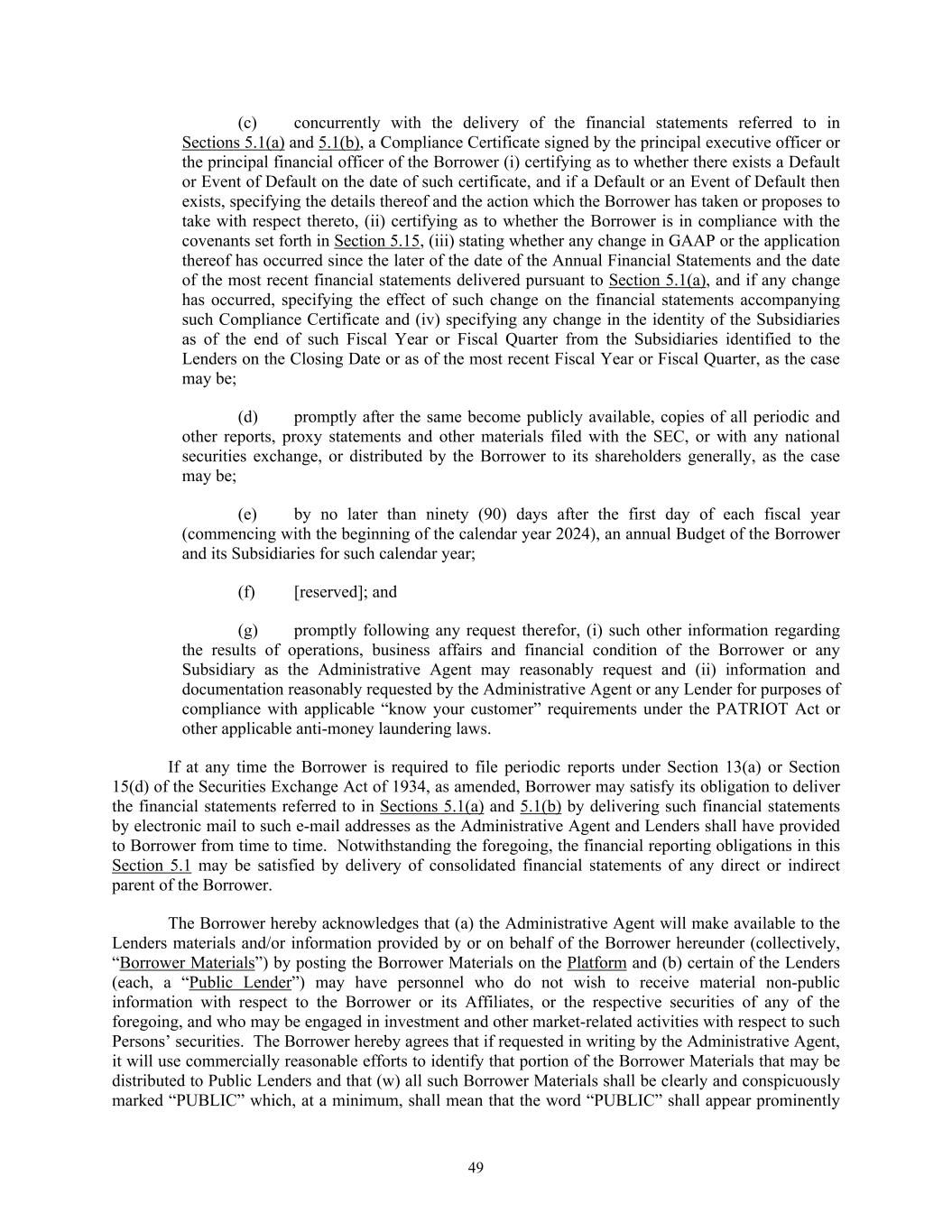
49 (c) concurrently with the delivery of the financial statements referred to in Sections 5.1(a) and 5.1(b), a Compliance Certificate signed by the principal executive officer or the principal financial officer of the Borrower (i) certifying as to whether there exists a Default or Event of Default on the date of such certificate, and if a Default or an Event of Default then exists, specifying the details thereof and the action which the Borrower has taken or proposes to take with respect thereto, (ii) certifying as to whether the Borrower is in compliance with the covenants set forth in Section 5.15, (iii) stating whether any change in GAAP or the application thereof has occurred since the later of the date of the Annual Financial Statements and the date of the most recent financial statements delivered pursuant to Section 5.1(a), and if any change has occurred, specifying the effect of such change on the financial statements accompanying such Compliance Certificate and (iv) specifying any change in the identity of the Subsidiaries as of the end of such Fiscal Year or Fiscal Quarter from the Subsidiaries identified to the Lenders on the Closing Date or as of the most recent Fiscal Year or Fiscal Quarter, as the case may be; (d) promptly after the same become publicly available, copies of all periodic and other reports, proxy statements and other materials filed with the SEC, or with any national securities exchange, or distributed by the Borrower to its shareholders generally, as the case may be; (e) by no later than ninety (90) days after the first day of each fiscal year (commencing with the beginning of the calendar year 2024), an annual Budget of the Borrower and its Subsidiaries for such calendar year; (f) [reserved]; and (g) promptly following any request therefor, (i) such other information regarding the results of operations, business affairs and financial condition of the Borrower or any Subsidiary as the Administrative Agent may reasonably request and (ii) information and documentation reasonably requested by the Administrative Agent or any Lender for purposes of compliance with applicable “know your customer” requirements under the PATRIOT Act or other applicable anti-money laundering laws. If at any time the Borrower is required to file periodic reports under Section 13(a) or Section 15(d) of the Securities Exchange Act of 1934, as amended, Borrower may satisfy its obligation to deliver the financial statements referred to in Sections 5.1(a) and 5.1(b) by delivering such financial statements by electronic mail to such e-mail addresses as the Administrative Agent and Lenders shall have provided to Borrower from time to time. Notwithstanding the foregoing, the financial reporting obligations in this Section 5.1 may be satisfied by delivery of consolidated financial statements of any direct or indirect parent of the Borrower. The Borrower hereby acknowledges that (a) the Administrative Agent will make available to the Lenders materials and/or information provided by or on behalf of the Borrower hereunder (collectively, “Borrower Materials”) by posting the Borrower Materials on the Platform and (b) certain of the Lenders (each, a “Public Lender”) may have personnel who do not wish to receive material non-public information with respect to the Borrower or its Affiliates, or the respective securities of any of the foregoing, and who may be engaged in investment and other market-related activities with respect to such Persons’ securities. The Borrower hereby agrees that if requested in writing by the Administrative Agent, it will use commercially reasonable efforts to identify that portion of the Borrower Materials that may be distributed to Public Lenders and that (w) all such Borrower Materials shall be clearly and conspicuously marked “PUBLIC” which, at a minimum, shall mean that the word “PUBLIC” shall appear prominently
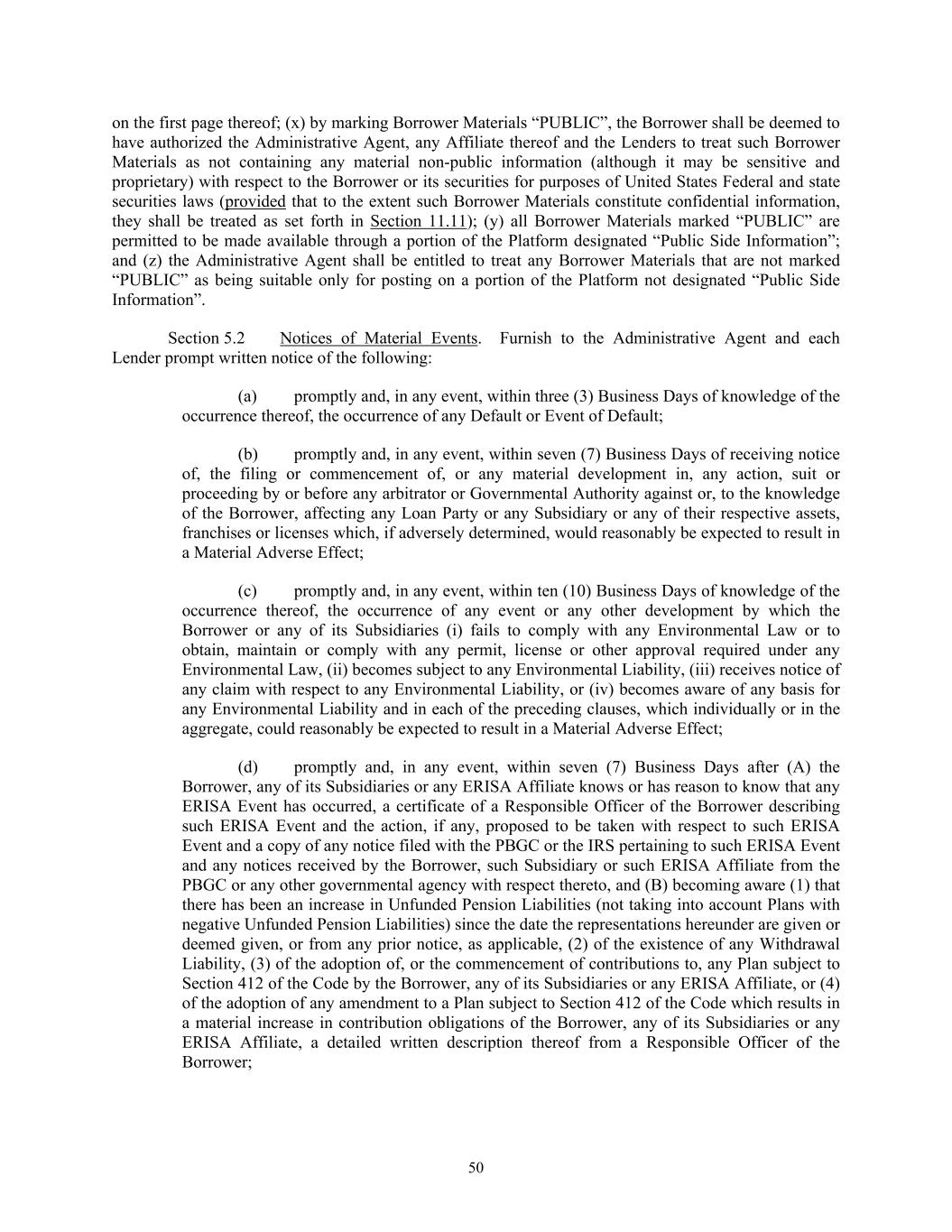
50 on the first page thereof; (x) by marking Borrower Materials “PUBLIC”, the Borrower shall be deemed to have authorized the Administrative Agent, any Affiliate thereof and the Lenders to treat such Borrower Materials as not containing any material non-public information (although it may be sensitive and proprietary) with respect to the Borrower or its securities for purposes of United States Federal and state securities laws (provided that to the extent such Borrower Materials constitute confidential information, they shall be treated as set forth in Section 11.11); (y) all Borrower Materials marked “PUBLIC” are permitted to be made available through a portion of the Platform designated “Public Side Information”; and (z) the Administrative Agent shall be entitled to treat any Borrower Materials that are not marked “PUBLIC” as being suitable only for posting on a portion of the Platform not designated “Public Side Information”. Section 5.2 Notices of Material Events. Furnish to the Administrative Agent and each Lender prompt written notice of the following: (a) promptly and, in any event, within three (3) Business Days of knowledge of the occurrence thereof, the occurrence of any Default or Event of Default; (b) promptly and, in any event, within seven (7) Business Days of receiving notice of, the filing or commencement of, or any material development in, any action, suit or proceeding by or before any arbitrator or Governmental Authority against or, to the knowledge of the Borrower, affecting any Loan Party or any Subsidiary or any of their respective assets, franchises or licenses which, if adversely determined, would reasonably be expected to result in a Material Adverse Effect; (c) promptly and, in any event, within ten (10) Business Days of knowledge of the occurrence thereof, the occurrence of any event or any other development by which the Borrower or any of its Subsidiaries (i) fails to comply with any Environmental Law or to obtain, maintain or comply with any permit, license or other approval required under any Environmental Law, (ii) becomes subject to any Environmental Liability, (iii) receives notice of any claim with respect to any Environmental Liability, or (iv) becomes aware of any basis for any Environmental Liability and in each of the preceding clauses, which individually or in the aggregate, could reasonably be expected to result in a Material Adverse Effect; (d) promptly and, in any event, within seven (7) Business Days after (A) the Borrower, any of its Subsidiaries or any ERISA Affiliate knows or has reason to know that any ERISA Event has occurred, a certificate of a Responsible Officer of the Borrower describing such ERISA Event and the action, if any, proposed to be taken with respect to such ERISA Event and a copy of any notice filed with the PBGC or the IRS pertaining to such ERISA Event and any notices received by the Borrower, such Subsidiary or such ERISA Affiliate from the PBGC or any other governmental agency with respect thereto, and (B) becoming aware (1) that there has been an increase in Unfunded Pension Liabilities (not taking into account Plans with negative Unfunded Pension Liabilities) since the date the representations hereunder are given or deemed given, or from any prior notice, as applicable, (2) of the existence of any Withdrawal Liability, (3) of the adoption of, or the commencement of contributions to, any Plan subject to Section 412 of the Code by the Borrower, any of its Subsidiaries or any ERISA Affiliate, or (4) of the adoption of any amendment to a Plan subject to Section 412 of the Code which results in a material increase in contribution obligations of the Borrower, any of its Subsidiaries or any ERISA Affiliate, a detailed written description thereof from a Responsible Officer of the Borrower;
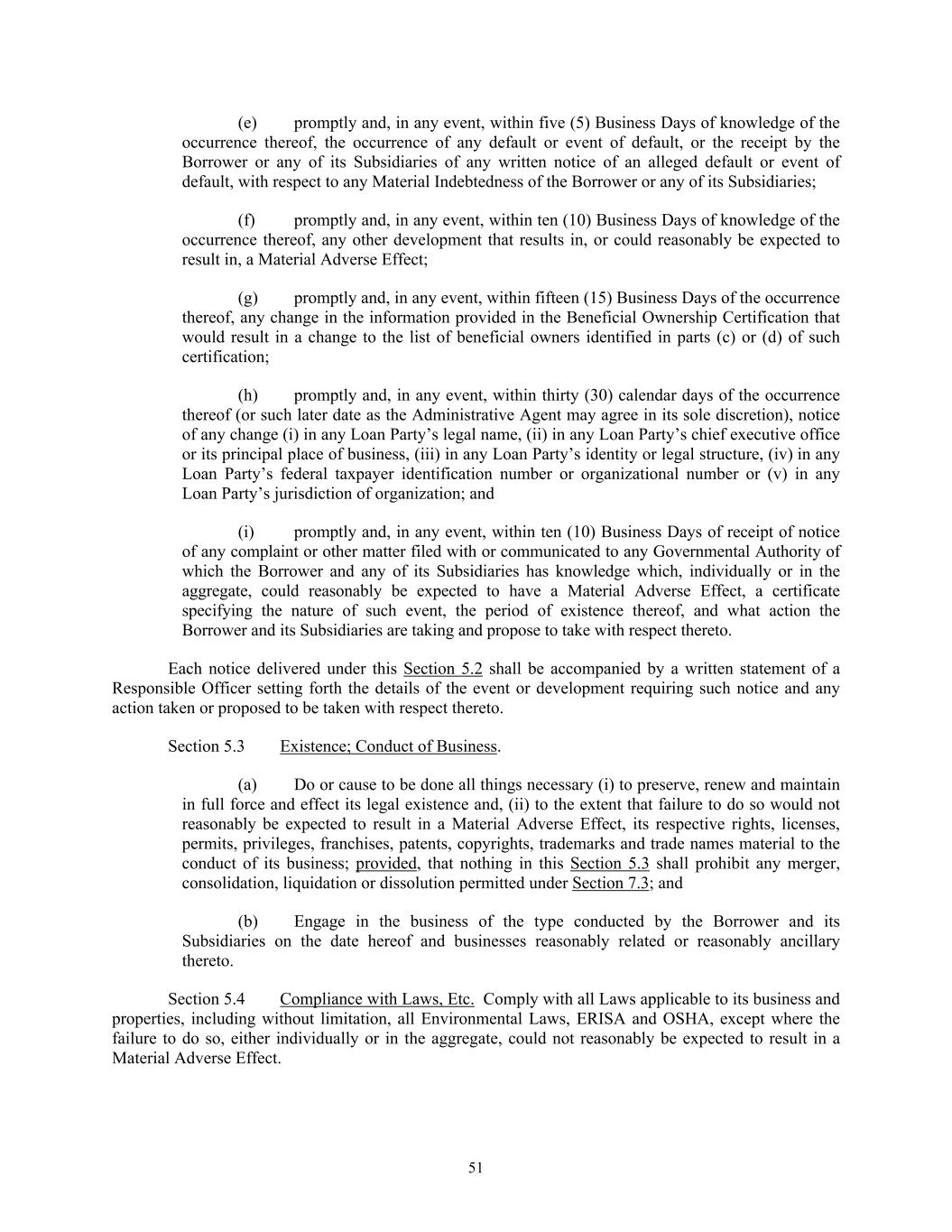
51 (e) promptly and, in any event, within five (5) Business Days of knowledge of the occurrence thereof, the occurrence of any default or event of default, or the receipt by the Borrower or any of its Subsidiaries of any written notice of an alleged default or event of default, with respect to any Material Indebtedness of the Borrower or any of its Subsidiaries; (f) promptly and, in any event, within ten (10) Business Days of knowledge of the occurrence thereof, any other development that results in, or could reasonably be expected to result in, a Material Adverse Effect; (g) promptly and, in any event, within fifteen (15) Business Days of the occurrence thereof, any change in the information provided in the Beneficial Ownership Certification that would result in a change to the list of beneficial owners identified in parts (c) or (d) of such certification; (h) promptly and, in any event, within thirty (30) calendar days of the occurrence thereof (or such later date as the Administrative Agent may agree in its sole discretion), notice of any change (i) in any Loan Party’s legal name, (ii) in any Loan Party’s chief executive office or its principal place of business, (iii) in any Loan Party’s identity or legal structure, (iv) in any Loan Party’s federal taxpayer identification number or organizational number or (v) in any Loan Party’s jurisdiction of organization; and (i) promptly and, in any event, within ten (10) Business Days of receipt of notice of any complaint or other matter filed with or communicated to any Governmental Authority of which the Borrower and any of its Subsidiaries has knowledge which, individually or in the aggregate, could reasonably be expected to have a Material Adverse Effect, a certificate specifying the nature of such event, the period of existence thereof, and what action the Borrower and its Subsidiaries are taking and propose to take with respect thereto. Each notice delivered under this Section 5.2 shall be accompanied by a written statement of a Responsible Officer setting forth the details of the event or development requiring such notice and any action taken or proposed to be taken with respect thereto. Section 5.3 Existence; Conduct of Business. (a) Do or cause to be done all things necessary (i) to preserve, renew and maintain in full force and effect its legal existence and, (ii) to the extent that failure to do so would not reasonably be expected to result in a Material Adverse Effect, its respective rights, licenses, permits, privileges, franchises, patents, copyrights, trademarks and trade names material to the conduct of its business; provided, that nothing in this Section 5.3 shall prohibit any merger, consolidation, liquidation or dissolution permitted under Section 7.3; and (b) Engage in the business of the type conducted by the Borrower and its Subsidiaries on the date hereof and businesses reasonably related or reasonably ancillary thereto. Section 5.4 Compliance with Laws, Etc. Comply with all Laws applicable to its business and properties, including without limitation, all Environmental Laws, ERISA and OSHA, except where the failure to do so, either individually or in the aggregate, could not reasonably be expected to result in a Material Adverse Effect.
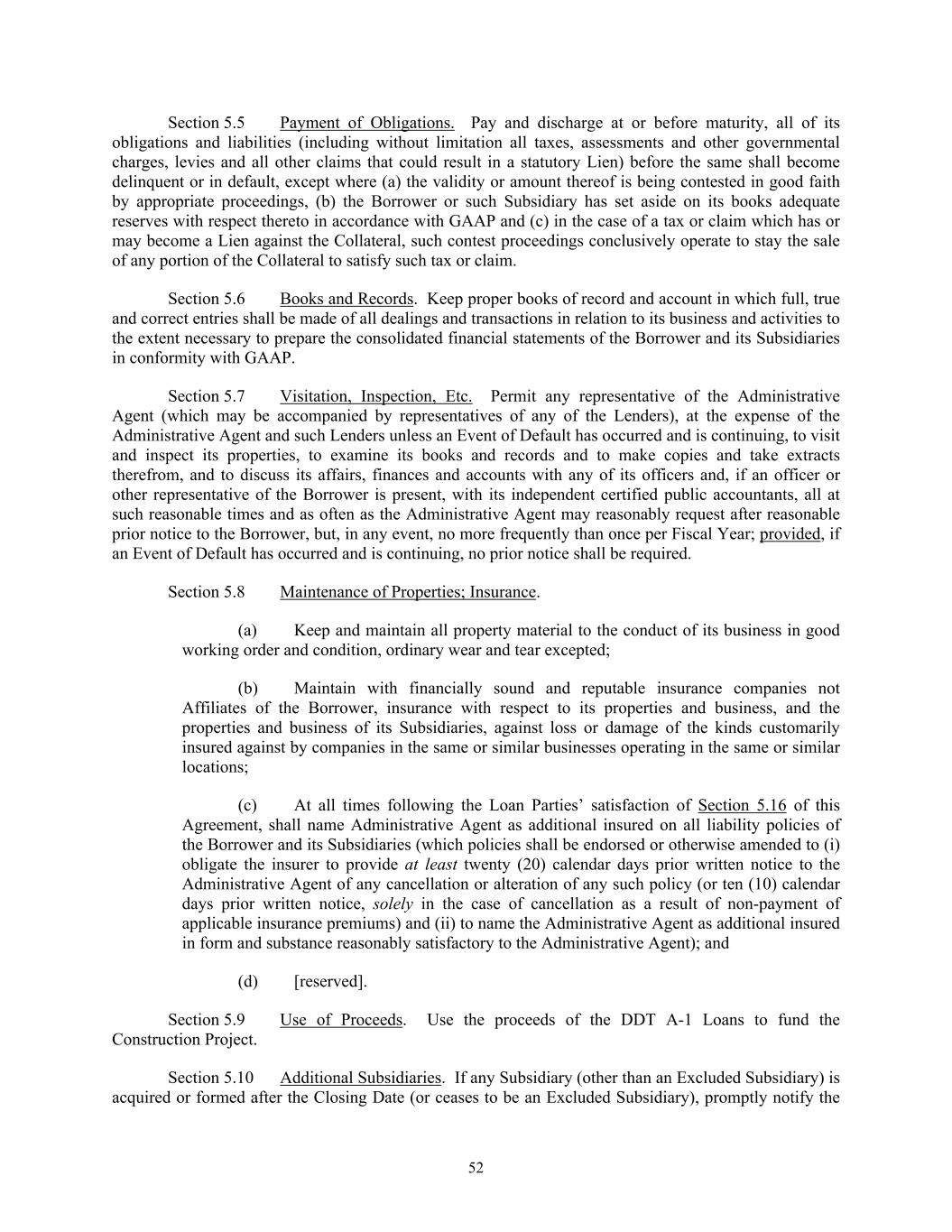
52 Section 5.5 Payment of Obligations. Pay and discharge at or before maturity, all of its obligations and liabilities (including without limitation all taxes, assessments and other governmental charges, levies and all other claims that could result in a statutory Lien) before the same shall become delinquent or in default, except where (a) the validity or amount thereof is being contested in good faith by appropriate proceedings, (b) the Borrower or such Subsidiary has set aside on its books adequate reserves with respect thereto in accordance with GAAP and (c) in the case of a tax or claim which has or may become a Lien against the Collateral, such contest proceedings conclusively operate to stay the sale of any portion of the Collateral to satisfy such tax or claim. Section 5.6 Books and Records. Keep proper books of record and account in which full, true and correct entries shall be made of all dealings and transactions in relation to its business and activities to the extent necessary to prepare the consolidated financial statements of the Borrower and its Subsidiaries in conformity with GAAP. Section 5.7 Visitation, Inspection, Etc. Permit any representative of the Administrative Agent (which may be accompanied by representatives of any of the Lenders), at the expense of the Administrative Agent and such Lenders unless an Event of Default has occurred and is continuing, to visit and inspect its properties, to examine its books and records and to make copies and take extracts therefrom, and to discuss its affairs, finances and accounts with any of its officers and, if an officer or other representative of the Borrower is present, with its independent certified public accountants, all at such reasonable times and as often as the Administrative Agent may reasonably request after reasonable prior notice to the Borrower, but, in any event, no more frequently than once per Fiscal Year; provided, if an Event of Default has occurred and is continuing, no prior notice shall be required. Section 5.8 Maintenance of Properties; Insurance. (a) Keep and maintain all property material to the conduct of its business in good working order and condition, ordinary wear and tear excepted; (b) Maintain with financially sound and reputable insurance companies not Affiliates of the Borrower, insurance with respect to its properties and business, and the properties and business of its Subsidiaries, against loss or damage of the kinds customarily insured against by companies in the same or similar businesses operating in the same or similar locations; (c) At all times following the Loan Parties’ satisfaction of Section 5.16 of this Agreement, shall name Administrative Agent as additional insured on all liability policies of the Borrower and its Subsidiaries (which policies shall be endorsed or otherwise amended to (i) obligate the insurer to provide at least twenty (20) calendar days prior written notice to the Administrative Agent of any cancellation or alteration of any such policy (or ten (10) calendar days prior written notice, solely in the case of cancellation as a result of non-payment of applicable insurance premiums) and (ii) to name the Administrative Agent as additional insured in form and substance reasonably satisfactory to the Administrative Agent); and (d) [reserved]. Section 5.9 Use of Proceeds. Use the proceeds of the DDT A-1 Loans to fund the Construction Project. Section 5.10 Additional Subsidiaries. If any Subsidiary (other than an Excluded Subsidiary) is acquired or formed after the Closing Date (or ceases to be an Excluded Subsidiary), promptly notify the
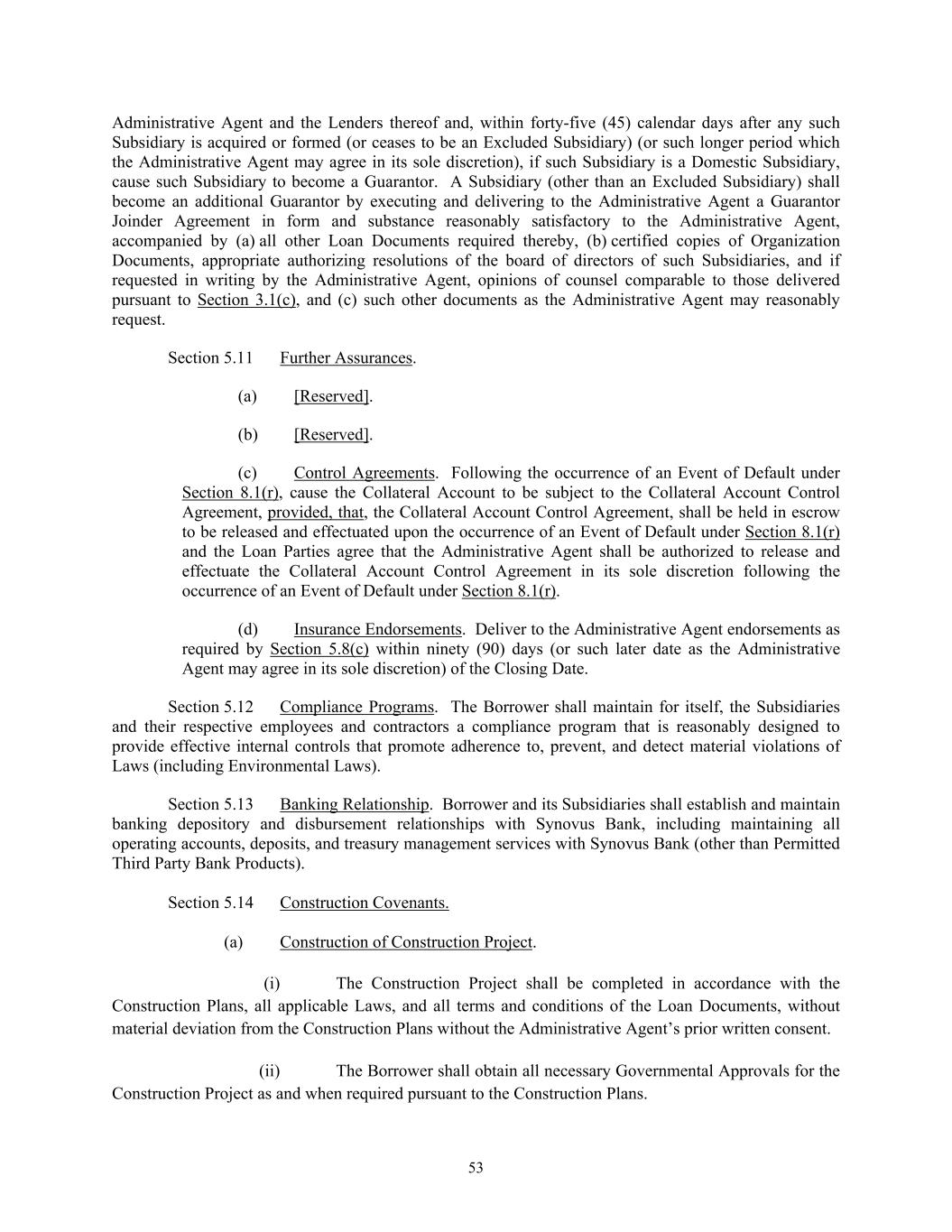
53 Administrative Agent and the Lenders thereof and, within forty-five (45) calendar days after any such Subsidiary is acquired or formed (or ceases to be an Excluded Subsidiary) (or such longer period which the Administrative Agent may agree in its sole discretion), if such Subsidiary is a Domestic Subsidiary, cause such Subsidiary to become a Guarantor. A Subsidiary (other than an Excluded Subsidiary) shall become an additional Guarantor by executing and delivering to the Administrative Agent a Guarantor Joinder Agreement in form and substance reasonably satisfactory to the Administrative Agent, accompanied by (a) all other Loan Documents required thereby, (b) certified copies of Organization Documents, appropriate authorizing resolutions of the board of directors of such Subsidiaries, and if requested in writing by the Administrative Agent, opinions of counsel comparable to those delivered pursuant to Section 3.1(c), and (c) such other documents as the Administrative Agent may reasonably request. Section 5.11 Further Assurances. (a) [Reserved]. (b) [Reserved]. (c) Control Agreements. Following the occurrence of an Event of Default under Section 8.1(r), cause the Collateral Account to be subject to the Collateral Account Control Agreement, provided, that, the Collateral Account Control Agreement, shall be held in escrow to be released and effectuated upon the occurrence of an Event of Default under Section 8.1(r) and the Loan Parties agree that the Administrative Agent shall be authorized to release and effectuate the Collateral Account Control Agreement in its sole discretion following the occurrence of an Event of Default under Section 8.1(r). (d) Insurance Endorsements. Deliver to the Administrative Agent endorsements as required by Section 5.8(c) within ninety (90) days (or such later date as the Administrative Agent may agree in its sole discretion) of the Closing Date. Section 5.12 Compliance Programs. The Borrower shall maintain for itself, the Subsidiaries and their respective employees and contractors a compliance program that is reasonably designed to provide effective internal controls that promote adherence to, prevent, and detect material violations of Laws (including Environmental Laws). Section 5.13 Banking Relationship. Borrower and its Subsidiaries shall establish and maintain banking depository and disbursement relationships with Synovus Bank, including maintaining all operating accounts, deposits, and treasury management services with Synovus Bank (other than Permitted Third Party Bank Products). Section 5.14 Construction Covenants. (a) Construction of Construction Project. (i) The Construction Project shall be completed in accordance with the Construction Plans, all applicable Laws, and all terms and conditions of the Loan Documents, without material deviation from the Construction Plans without the Administrative Agent’s prior written consent. (ii) The Borrower shall obtain all necessary Governmental Approvals for the Construction Project as and when required pursuant to the Construction Plans.
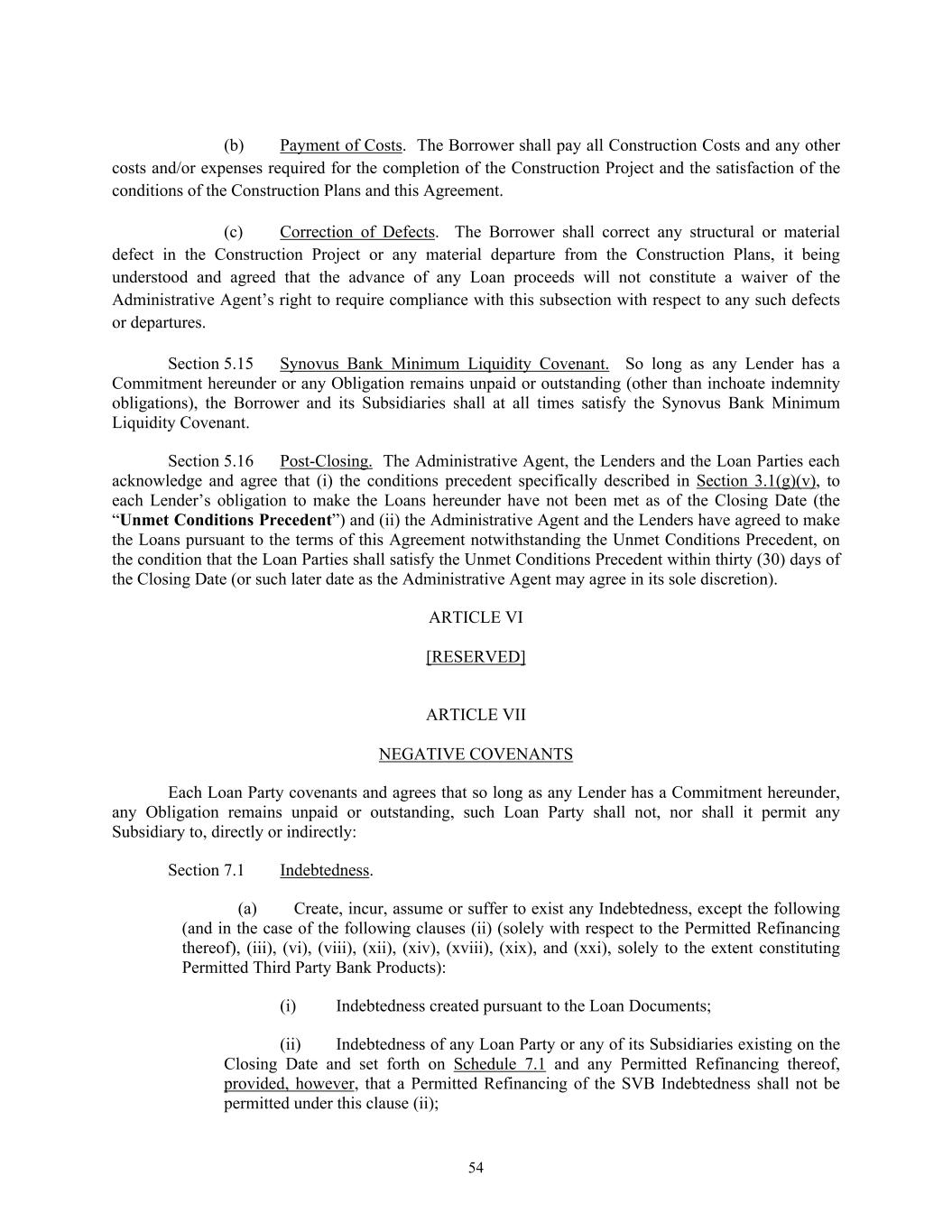
54 (b) Payment of Costs. The Borrower shall pay all Construction Costs and any other costs and/or expenses required for the completion of the Construction Project and the satisfaction of the conditions of the Construction Plans and this Agreement. (c) Correction of Defects. The Borrower shall correct any structural or material defect in the Construction Project or any material departure from the Construction Plans, it being understood and agreed that the advance of any Loan proceeds will not constitute a waiver of the Administrative Agent’s right to require compliance with this subsection with respect to any such defects or departures. Section 5.15 Synovus Bank Minimum Liquidity Covenant. So long as any Lender has a Commitment hereunder or any Obligation remains unpaid or outstanding (other than inchoate indemnity obligations), the Borrower and its Subsidiaries shall at all times satisfy the Synovus Bank Minimum Liquidity Covenant. Section 5.16 Post-Closing. The Administrative Agent, the Lenders and the Loan Parties each acknowledge and agree that (i) the conditions precedent specifically described in Section 3.1(g)(v), to each Lender’s obligation to make the Loans hereunder have not been met as of the Closing Date (the “Unmet Conditions Precedent”) and (ii) the Administrative Agent and the Lenders have agreed to make the Loans pursuant to the terms of this Agreement notwithstanding the Unmet Conditions Precedent, on the condition that the Loan Parties shall satisfy the Unmet Conditions Precedent within thirty (30) days of the Closing Date (or such later date as the Administrative Agent may agree in its sole discretion). ARTICLE VI [RESERVED] ARTICLE VII NEGATIVE COVENANTS Each Loan Party covenants and agrees that so long as any Lender has a Commitment hereunder, any Obligation remains unpaid or outstanding, such Loan Party shall not, nor shall it permit any Subsidiary to, directly or indirectly: Section 7.1 Indebtedness. (a) Create, incur, assume or suffer to exist any Indebtedness, except the following (and in the case of the following clauses (ii) (solely with respect to the Permitted Refinancing thereof), (iii), (vi), (viii), (xii), (xiv), (xviii), (xix), and (xxi), solely to the extent constituting Permitted Third Party Bank Products): (i) Indebtedness created pursuant to the Loan Documents; (ii) Indebtedness of any Loan Party or any of its Subsidiaries existing on the Closing Date and set forth on Schedule 7.1 and any Permitted Refinancing thereof, provided, however, that a Permitted Refinancing of the SVB Indebtedness shall not be permitted under this clause (ii);
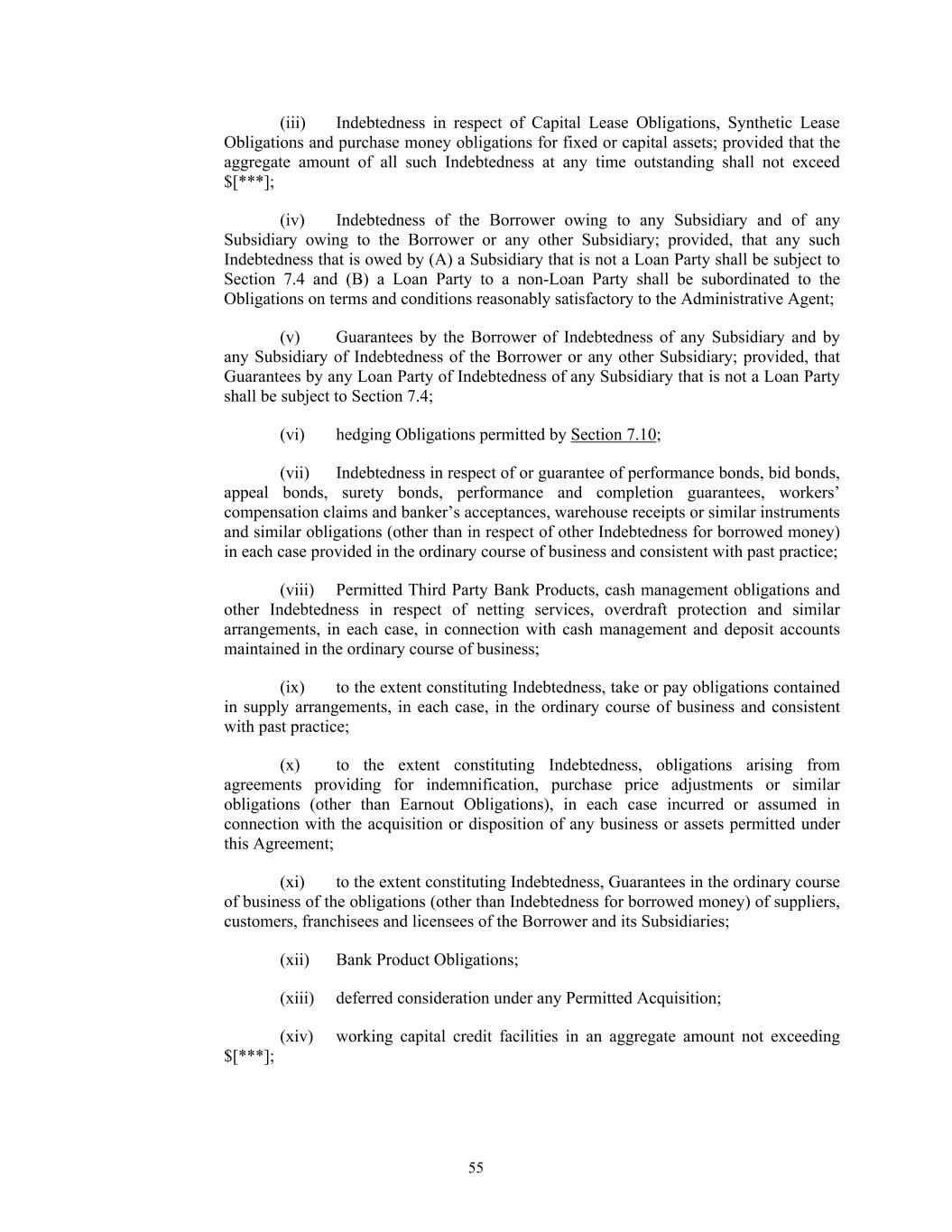
55 (iii) Indebtedness in respect of Capital Lease Obligations, Synthetic Lease Obligations and purchase money obligations for fixed or capital assets; provided that the aggregate amount of all such Indebtedness at any time outstanding shall not exceed $[***]; (iv) Indebtedness of the Borrower owing to any Subsidiary and of any Subsidiary owing to the Borrower or any other Subsidiary; provided, that any such Indebtedness that is owed by (A) a Subsidiary that is not a Loan Party shall be subject to Section 7.4 and (B) a Loan Party to a non-Loan Party shall be subordinated to the Obligations on terms and conditions reasonably satisfactory to the Administrative Agent; (v) Guarantees by the Borrower of Indebtedness of any Subsidiary and by any Subsidiary of Indebtedness of the Borrower or any other Subsidiary; provided, that Guarantees by any Loan Party of Indebtedness of any Subsidiary that is not a Loan Party shall be subject to Section 7.4; (vi) hedging Obligations permitted by Section 7.10; (vii) Indebtedness in respect of or guarantee of performance bonds, bid bonds, appeal bonds, surety bonds, performance and completion guarantees, workers’ compensation claims and banker’s acceptances, warehouse receipts or similar instruments and similar obligations (other than in respect of other Indebtedness for borrowed money) in each case provided in the ordinary course of business and consistent with past practice; (viii) Permitted Third Party Bank Products, cash management obligations and other Indebtedness in respect of netting services, overdraft protection and similar arrangements, in each case, in connection with cash management and deposit accounts maintained in the ordinary course of business; (ix) to the extent constituting Indebtedness, take or pay obligations contained in supply arrangements, in each case, in the ordinary course of business and consistent with past practice; (x) to the extent constituting Indebtedness, obligations arising from agreements providing for indemnification, purchase price adjustments or similar obligations (other than Earnout Obligations), in each case incurred or assumed in connection with the acquisition or disposition of any business or assets permitted under this Agreement; (xi) to the extent constituting Indebtedness, Guarantees in the ordinary course of business of the obligations (other than Indebtedness for borrowed money) of suppliers, customers, franchisees and licensees of the Borrower and its Subsidiaries; (xii) Bank Product Obligations; (xiii) deferred consideration under any Permitted Acquisition; (xiv) working capital credit facilities in an aggregate amount not exceeding $[***];
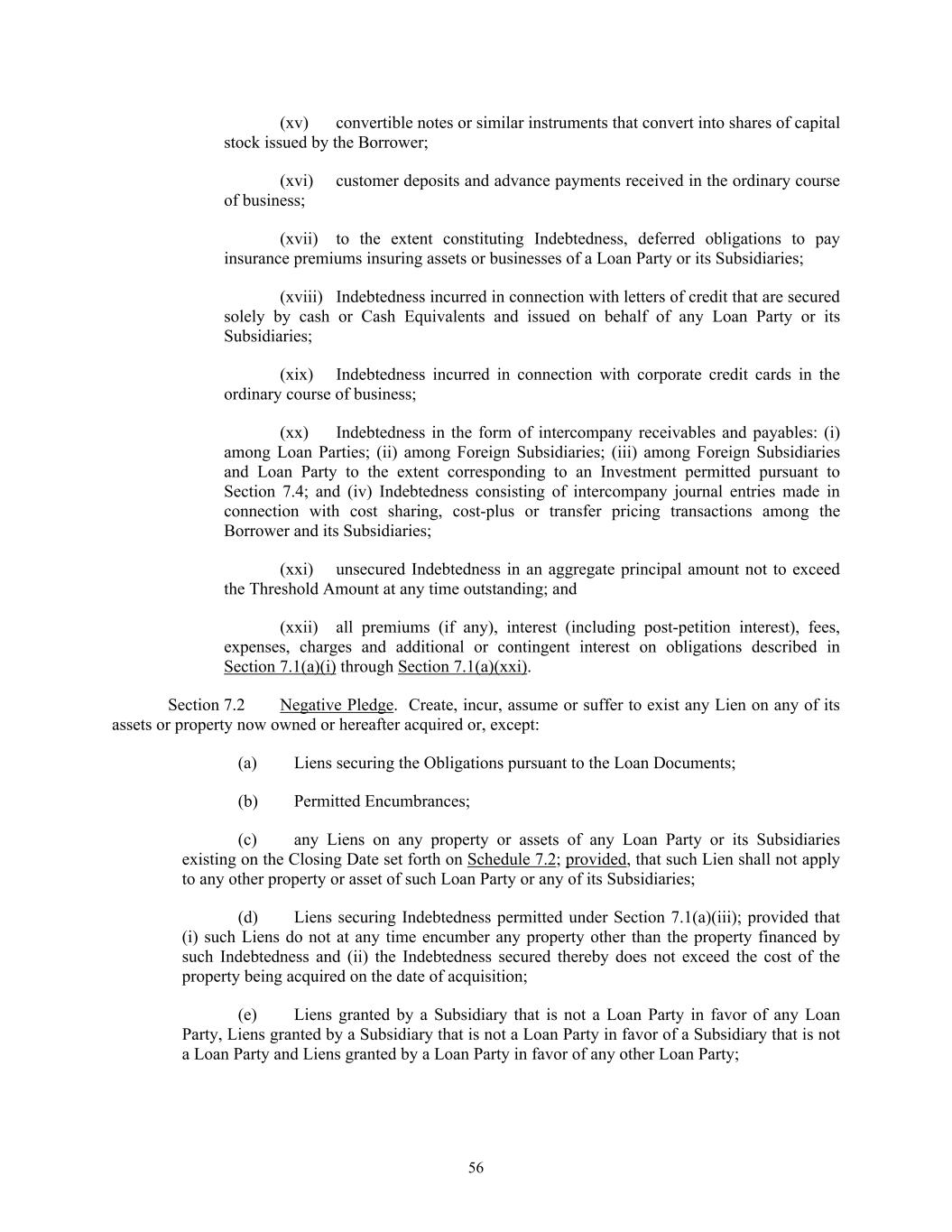
56 (xv) convertible notes or similar instruments that convert into shares of capital stock issued by the Borrower; (xvi) customer deposits and advance payments received in the ordinary course of business; (xvii) to the extent constituting Indebtedness, deferred obligations to pay insurance premiums insuring assets or businesses of a Loan Party or its Subsidiaries; (xviii) Indebtedness incurred in connection with letters of credit that are secured solely by cash or Cash Equivalents and issued on behalf of any Loan Party or its Subsidiaries; (xix) Indebtedness incurred in connection with corporate credit cards in the ordinary course of business; (xx) Indebtedness in the form of intercompany receivables and payables: (i) among Loan Parties; (ii) among Foreign Subsidiaries; (iii) among Foreign Subsidiaries and Loan Party to the extent corresponding to an Investment permitted pursuant to Section 7.4; and (iv) Indebtedness consisting of intercompany journal entries made in connection with cost sharing, cost-plus or transfer pricing transactions among the Borrower and its Subsidiaries; (xxi) unsecured Indebtedness in an aggregate principal amount not to exceed the Threshold Amount at any time outstanding; and (xxii) all premiums (if any), interest (including post-petition interest), fees, expenses, charges and additional or contingent interest on obligations described in Section 7.1(a)(i) through Section 7.1(a)(xxi). Section 7.2 Negative Pledge. Create, incur, assume or suffer to exist any Lien on any of its assets or property now owned or hereafter acquired or, except: (a) Liens securing the Obligations pursuant to the Loan Documents; (b) Permitted Encumbrances; (c) any Liens on any property or assets of any Loan Party or its Subsidiaries existing on the Closing Date set forth on Schedule 7.2; provided, that such Lien shall not apply to any other property or asset of such Loan Party or any of its Subsidiaries; (d) Liens securing Indebtedness permitted under Section 7.1(a)(iii); provided that (i) such Liens do not at any time encumber any property other than the property financed by such Indebtedness and (ii) the Indebtedness secured thereby does not exceed the cost of the property being acquired on the date of acquisition; (e) Liens granted by a Subsidiary that is not a Loan Party in favor of any Loan Party, Liens granted by a Subsidiary that is not a Loan Party in favor of a Subsidiary that is not a Loan Party and Liens granted by a Loan Party in favor of any other Loan Party;
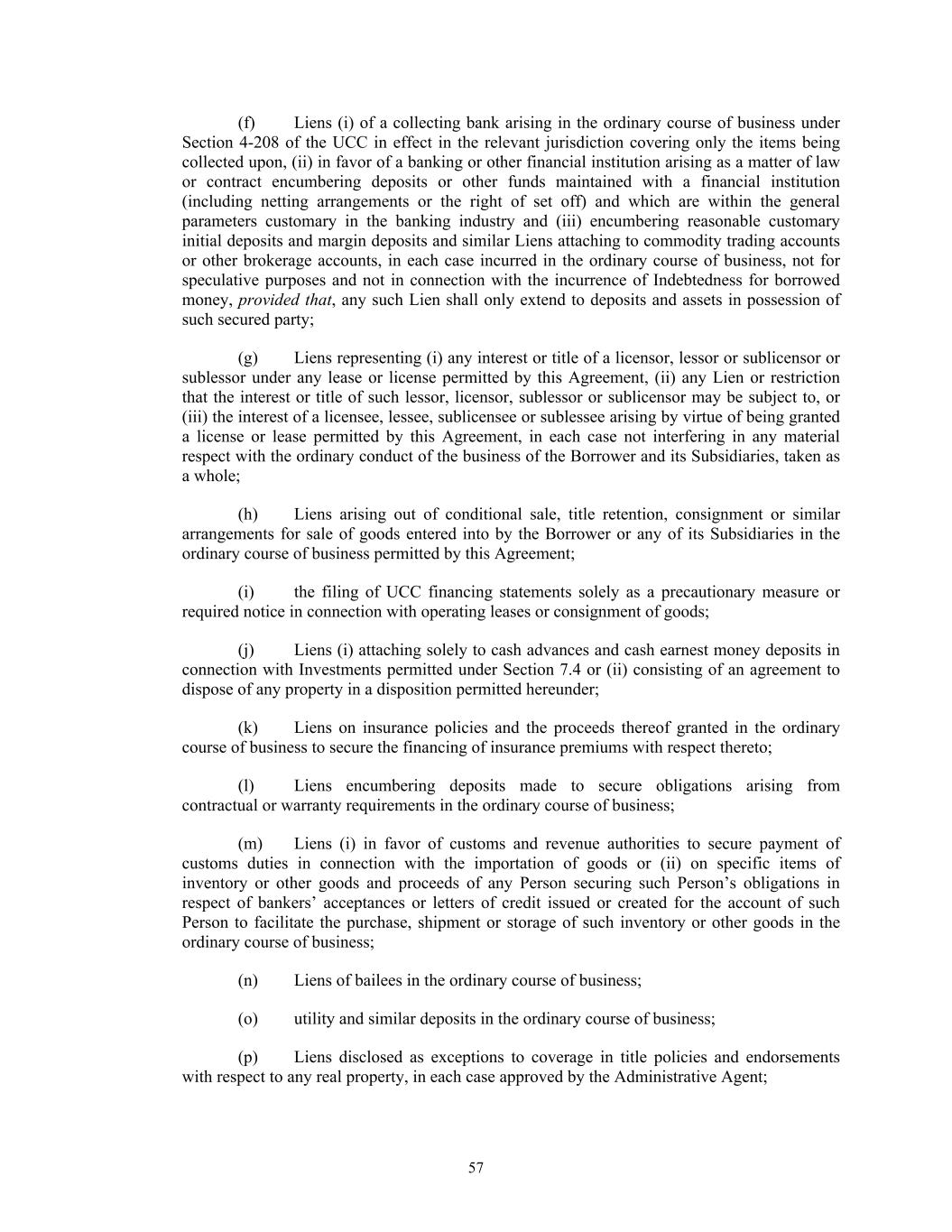
57 (f) Liens (i) of a collecting bank arising in the ordinary course of business under Section 4-208 of the UCC in effect in the relevant jurisdiction covering only the items being collected upon, (ii) in favor of a banking or other financial institution arising as a matter of law or contract encumbering deposits or other funds maintained with a financial institution (including netting arrangements or the right of set off) and which are within the general parameters customary in the banking industry and (iii) encumbering reasonable customary initial deposits and margin deposits and similar Liens attaching to commodity trading accounts or other brokerage accounts, in each case incurred in the ordinary course of business, not for speculative purposes and not in connection with the incurrence of Indebtedness for borrowed money, provided that, any such Lien shall only extend to deposits and assets in possession of such secured party; (g) Liens representing (i) any interest or title of a licensor, lessor or sublicensor or sublessor under any lease or license permitted by this Agreement, (ii) any Lien or restriction that the interest or title of such lessor, licensor, sublessor or sublicensor may be subject to, or (iii) the interest of a licensee, lessee, sublicensee or sublessee arising by virtue of being granted a license or lease permitted by this Agreement, in each case not interfering in any material respect with the ordinary conduct of the business of the Borrower and its Subsidiaries, taken as a whole; (h) Liens arising out of conditional sale, title retention, consignment or similar arrangements for sale of goods entered into by the Borrower or any of its Subsidiaries in the ordinary course of business permitted by this Agreement; (i) the filing of UCC financing statements solely as a precautionary measure or required notice in connection with operating leases or consignment of goods; (j) Liens (i) attaching solely to cash advances and cash earnest money deposits in connection with Investments permitted under Section 7.4 or (ii) consisting of an agreement to dispose of any property in a disposition permitted hereunder; (k) Liens on insurance policies and the proceeds thereof granted in the ordinary course of business to secure the financing of insurance premiums with respect thereto; (l) Liens encumbering deposits made to secure obligations arising from contractual or warranty requirements in the ordinary course of business; (m) Liens (i) in favor of customs and revenue authorities to secure payment of customs duties in connection with the importation of goods or (ii) on specific items of inventory or other goods and proceeds of any Person securing such Person’s obligations in respect of bankers’ acceptances or letters of credit issued or created for the account of such Person to facilitate the purchase, shipment or storage of such inventory or other goods in the ordinary course of business; (n) Liens of bailees in the ordinary course of business; (o) utility and similar deposits in the ordinary course of business; (p) Liens disclosed as exceptions to coverage in title policies and endorsements with respect to any real property, in each case approved by the Administrative Agent;
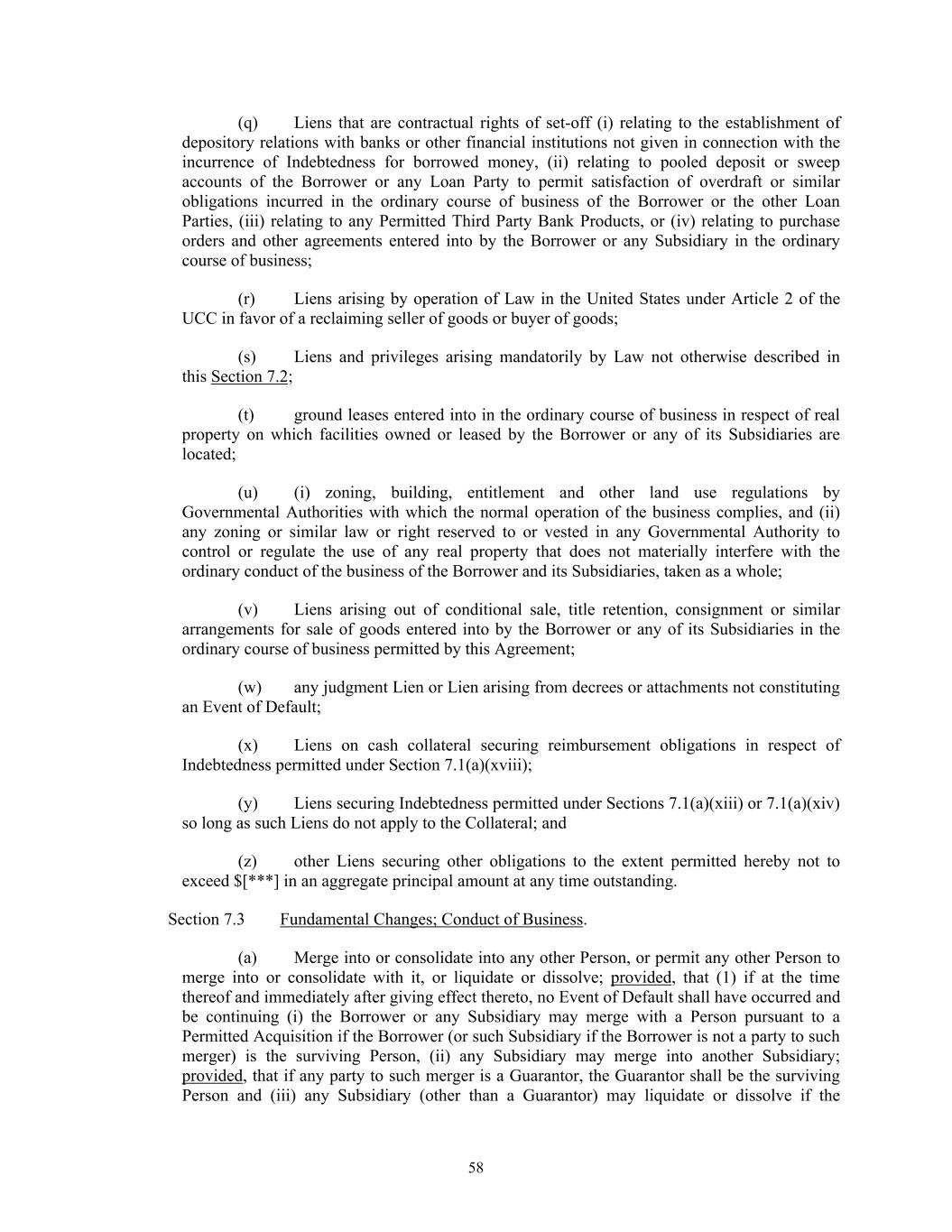
58 (q) Liens that are contractual rights of set-off (i) relating to the establishment of depository relations with banks or other financial institutions not given in connection with the incurrence of Indebtedness for borrowed money, (ii) relating to pooled deposit or sweep accounts of the Borrower or any Loan Party to permit satisfaction of overdraft or similar obligations incurred in the ordinary course of business of the Borrower or the other Loan Parties, (iii) relating to any Permitted Third Party Bank Products, or (iv) relating to purchase orders and other agreements entered into by the Borrower or any Subsidiary in the ordinary course of business; (r) Liens arising by operation of Law in the United States under Article 2 of the UCC in favor of a reclaiming seller of goods or buyer of goods; (s) Liens and privileges arising mandatorily by Law not otherwise described in this Section 7.2; (t) ground leases entered into in the ordinary course of business in respect of real property on which facilities owned or leased by the Borrower or any of its Subsidiaries are located; (u) (i) zoning, building, entitlement and other land use regulations by Governmental Authorities with which the normal operation of the business complies, and (ii) any zoning or similar law or right reserved to or vested in any Governmental Authority to control or regulate the use of any real property that does not materially interfere with the ordinary conduct of the business of the Borrower and its Subsidiaries, taken as a whole; (v) Liens arising out of conditional sale, title retention, consignment or similar arrangements for sale of goods entered into by the Borrower or any of its Subsidiaries in the ordinary course of business permitted by this Agreement; (w) any judgment Lien or Lien arising from decrees or attachments not constituting an Event of Default; (x) Liens on cash collateral securing reimbursement obligations in respect of Indebtedness permitted under Section 7.1(a)(xviii); (y) Liens securing Indebtedness permitted under Sections 7.1(a)(xiii) or 7.1(a)(xiv) so long as such Liens do not apply to the Collateral; and (z) other Liens securing other obligations to the extent permitted hereby not to exceed $[***] in an aggregate principal amount at any time outstanding. Section 7.3 Fundamental Changes; Conduct of Business. (a) Merge into or consolidate into any other Person, or permit any other Person to merge into or consolidate with it, or liquidate or dissolve; provided, that (1) if at the time thereof and immediately after giving effect thereto, no Event of Default shall have occurred and be continuing (i) the Borrower or any Subsidiary may merge with a Person pursuant to a Permitted Acquisition if the Borrower (or such Subsidiary if the Borrower is not a party to such merger) is the surviving Person, (ii) any Subsidiary may merge into another Subsidiary; provided, that if any party to such merger is a Guarantor, the Guarantor shall be the surviving Person and (iii) any Subsidiary (other than a Guarantor) may liquidate or dissolve if the
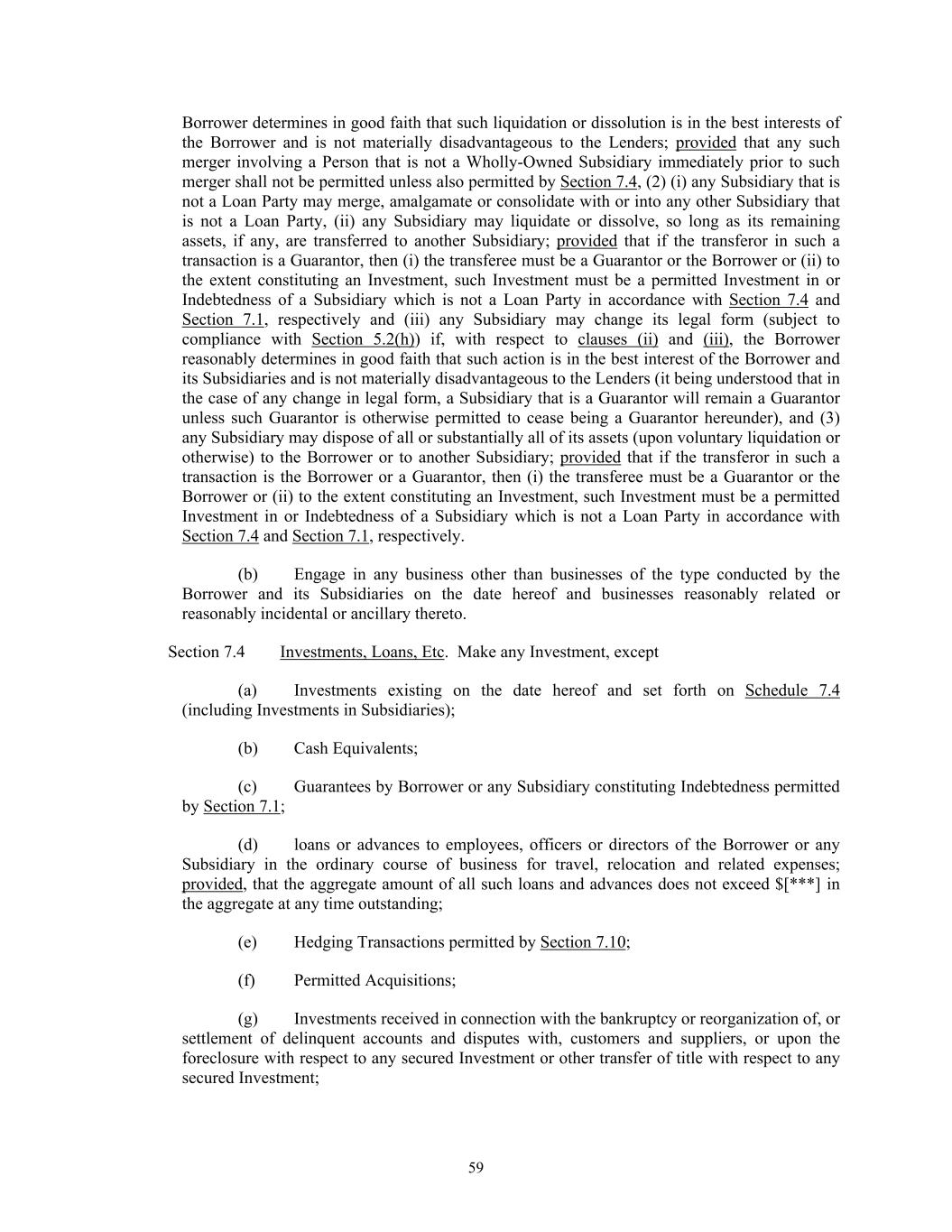
59 Borrower determines in good faith that such liquidation or dissolution is in the best interests of the Borrower and is not materially disadvantageous to the Lenders; provided that any such merger involving a Person that is not a Wholly-Owned Subsidiary immediately prior to such merger shall not be permitted unless also permitted by Section 7.4, (2) (i) any Subsidiary that is not a Loan Party may merge, amalgamate or consolidate with or into any other Subsidiary that is not a Loan Party, (ii) any Subsidiary may liquidate or dissolve, so long as its remaining assets, if any, are transferred to another Subsidiary; provided that if the transferor in such a transaction is a Guarantor, then (i) the transferee must be a Guarantor or the Borrower or (ii) to the extent constituting an Investment, such Investment must be a permitted Investment in or Indebtedness of a Subsidiary which is not a Loan Party in accordance with Section 7.4 and Section 7.1, respectively and (iii) any Subsidiary may change its legal form (subject to compliance with Section 5.2(h)) if, with respect to clauses (ii) and (iii), the Borrower reasonably determines in good faith that such action is in the best interest of the Borrower and its Subsidiaries and is not materially disadvantageous to the Lenders (it being understood that in the case of any change in legal form, a Subsidiary that is a Guarantor will remain a Guarantor unless such Guarantor is otherwise permitted to cease being a Guarantor hereunder), and (3) any Subsidiary may dispose of all or substantially all of its assets (upon voluntary liquidation or otherwise) to the Borrower or to another Subsidiary; provided that if the transferor in such a transaction is the Borrower or a Guarantor, then (i) the transferee must be a Guarantor or the Borrower or (ii) to the extent constituting an Investment, such Investment must be a permitted Investment in or Indebtedness of a Subsidiary which is not a Loan Party in accordance with Section 7.4 and Section 7.1, respectively. (b) Engage in any business other than businesses of the type conducted by the Borrower and its Subsidiaries on the date hereof and businesses reasonably related or reasonably incidental or ancillary thereto. Section 7.4 Investments, Loans, Etc. Make any Investment, except (a) Investments existing on the date hereof and set forth on Schedule 7.4 (including Investments in Subsidiaries); (b) Cash Equivalents; (c) Guarantees by Borrower or any Subsidiary constituting Indebtedness permitted by Section 7.1; (d) loans or advances to employees, officers or directors of the Borrower or any Subsidiary in the ordinary course of business for travel, relocation and related expenses; provided, that the aggregate amount of all such loans and advances does not exceed $[***] in the aggregate at any time outstanding; (e) Hedging Transactions permitted by Section 7.10; (f) Permitted Acquisitions; (g) Investments received in connection with the bankruptcy or reorganization of, or settlement of delinquent accounts and disputes with, customers and suppliers, or upon the foreclosure with respect to any secured Investment or other transfer of title with respect to any secured Investment;
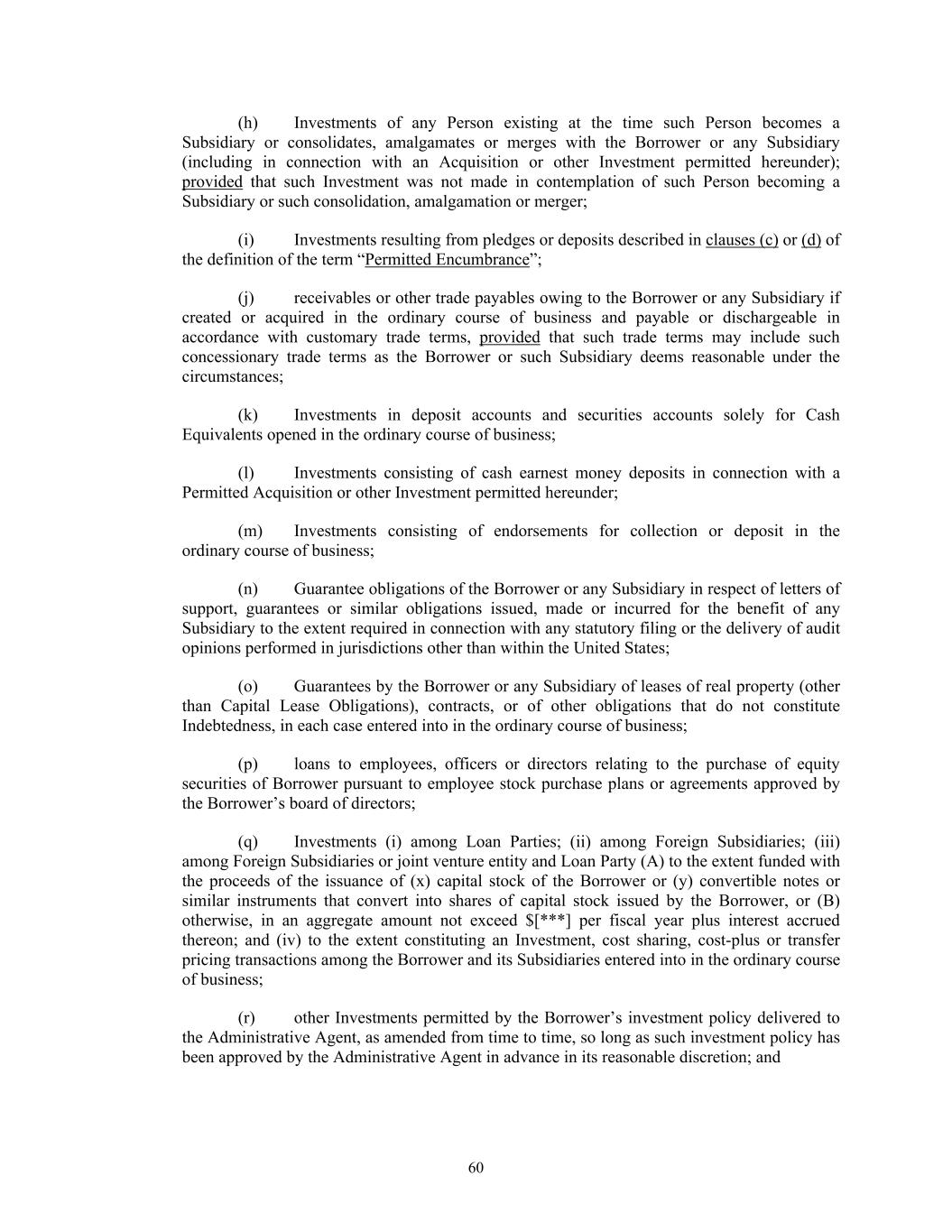
60 (h) Investments of any Person existing at the time such Person becomes a Subsidiary or consolidates, amalgamates or merges with the Borrower or any Subsidiary (including in connection with an Acquisition or other Investment permitted hereunder); provided that such Investment was not made in contemplation of such Person becoming a Subsidiary or such consolidation, amalgamation or merger; (i) Investments resulting from pledges or deposits described in clauses (c) or (d) of the definition of the term “Permitted Encumbrance”; (j) receivables or other trade payables owing to the Borrower or any Subsidiary if created or acquired in the ordinary course of business and payable or dischargeable in accordance with customary trade terms, provided that such trade terms may include such concessionary trade terms as the Borrower or such Subsidiary deems reasonable under the circumstances; (k) Investments in deposit accounts and securities accounts solely for Cash Equivalents opened in the ordinary course of business; (l) Investments consisting of cash earnest money deposits in connection with a Permitted Acquisition or other Investment permitted hereunder; (m) Investments consisting of endorsements for collection or deposit in the ordinary course of business; (n) Guarantee obligations of the Borrower or any Subsidiary in respect of letters of support, guarantees or similar obligations issued, made or incurred for the benefit of any Subsidiary to the extent required in connection with any statutory filing or the delivery of audit opinions performed in jurisdictions other than within the United States; (o) Guarantees by the Borrower or any Subsidiary of leases of real property (other than Capital Lease Obligations), contracts, or of other obligations that do not constitute Indebtedness, in each case entered into in the ordinary course of business; (p) loans to employees, officers or directors relating to the purchase of equity securities of Borrower pursuant to employee stock purchase plans or agreements approved by the Borrower’s board of directors; (q) Investments (i) among Loan Parties; (ii) among Foreign Subsidiaries; (iii) among Foreign Subsidiaries or joint venture entity and Loan Party (A) to the extent funded with the proceeds of the issuance of (x) capital stock of the Borrower or (y) convertible notes or similar instruments that convert into shares of capital stock issued by the Borrower, or (B) otherwise, in an aggregate amount not exceed $[***] per fiscal year plus interest accrued thereon; and (iv) to the extent constituting an Investment, cost sharing, cost-plus or transfer pricing transactions among the Borrower and its Subsidiaries entered into in the ordinary course of business; (r) other Investments permitted by the Borrower’s investment policy delivered to the Administrative Agent, as amended from time to time, so long as such investment policy has been approved by the Administrative Agent in advance in its reasonable discretion; and
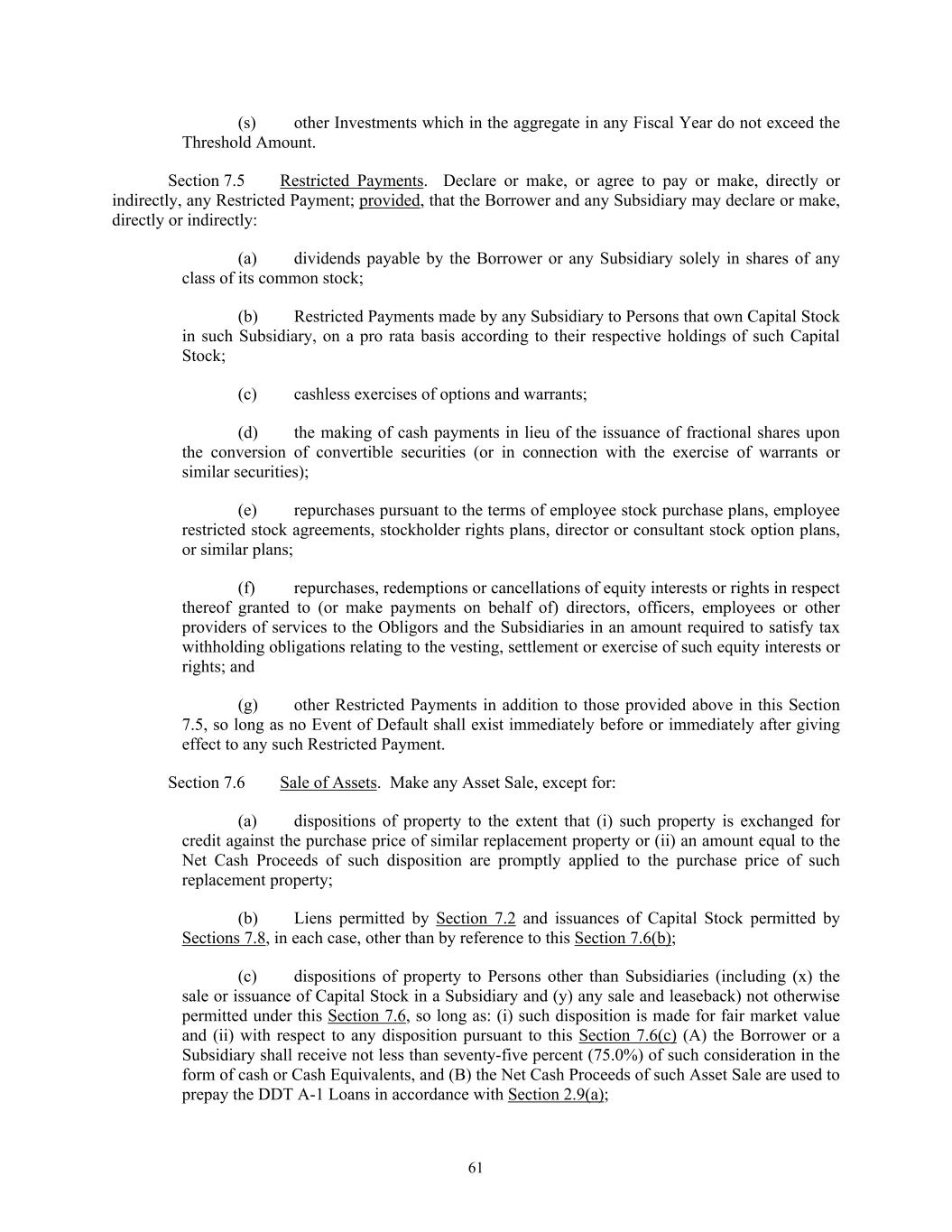
61 (s) other Investments which in the aggregate in any Fiscal Year do not exceed the Threshold Amount. Section 7.5 Restricted Payments. Declare or make, or agree to pay or make, directly or indirectly, any Restricted Payment; provided, that the Borrower and any Subsidiary may declare or make, directly or indirectly: (a) dividends payable by the Borrower or any Subsidiary solely in shares of any class of its common stock; (b) Restricted Payments made by any Subsidiary to Persons that own Capital Stock in such Subsidiary, on a pro rata basis according to their respective holdings of such Capital Stock; (c) cashless exercises of options and warrants; (d) the making of cash payments in lieu of the issuance of fractional shares upon the conversion of convertible securities (or in connection with the exercise of warrants or similar securities); (e) repurchases pursuant to the terms of employee stock purchase plans, employee restricted stock agreements, stockholder rights plans, director or consultant stock option plans, or similar plans; (f) repurchases, redemptions or cancellations of equity interests or rights in respect thereof granted to (or make payments on behalf of) directors, officers, employees or other providers of services to the Obligors and the Subsidiaries in an amount required to satisfy tax withholding obligations relating to the vesting, settlement or exercise of such equity interests or rights; and (g) other Restricted Payments in addition to those provided above in this Section 7.5, so long as no Event of Default shall exist immediately before or immediately after giving effect to any such Restricted Payment. Section 7.6 Sale of Assets. Make any Asset Sale, except for: (a) dispositions of property to the extent that (i) such property is exchanged for credit against the purchase price of similar replacement property or (ii) an amount equal to the Net Cash Proceeds of such disposition are promptly applied to the purchase price of such replacement property; (b) Liens permitted by Section 7.2 and issuances of Capital Stock permitted by Sections 7.8, in each case, other than by reference to this Section 7.6(b); (c) dispositions of property to Persons other than Subsidiaries (including (x) the sale or issuance of Capital Stock in a Subsidiary and (y) any sale and leaseback) not otherwise permitted under this Section 7.6, so long as: (i) such disposition is made for fair market value and (ii) with respect to any disposition pursuant to this Section 7.6(c) (A) the Borrower or a Subsidiary shall receive not less than seventy-five percent (75.0%) of such consideration in the form of cash or Cash Equivalents, and (B) the Net Cash Proceeds of such Asset Sale are used to prepay the DDT A-1 Loans in accordance with Section 2.9(a);
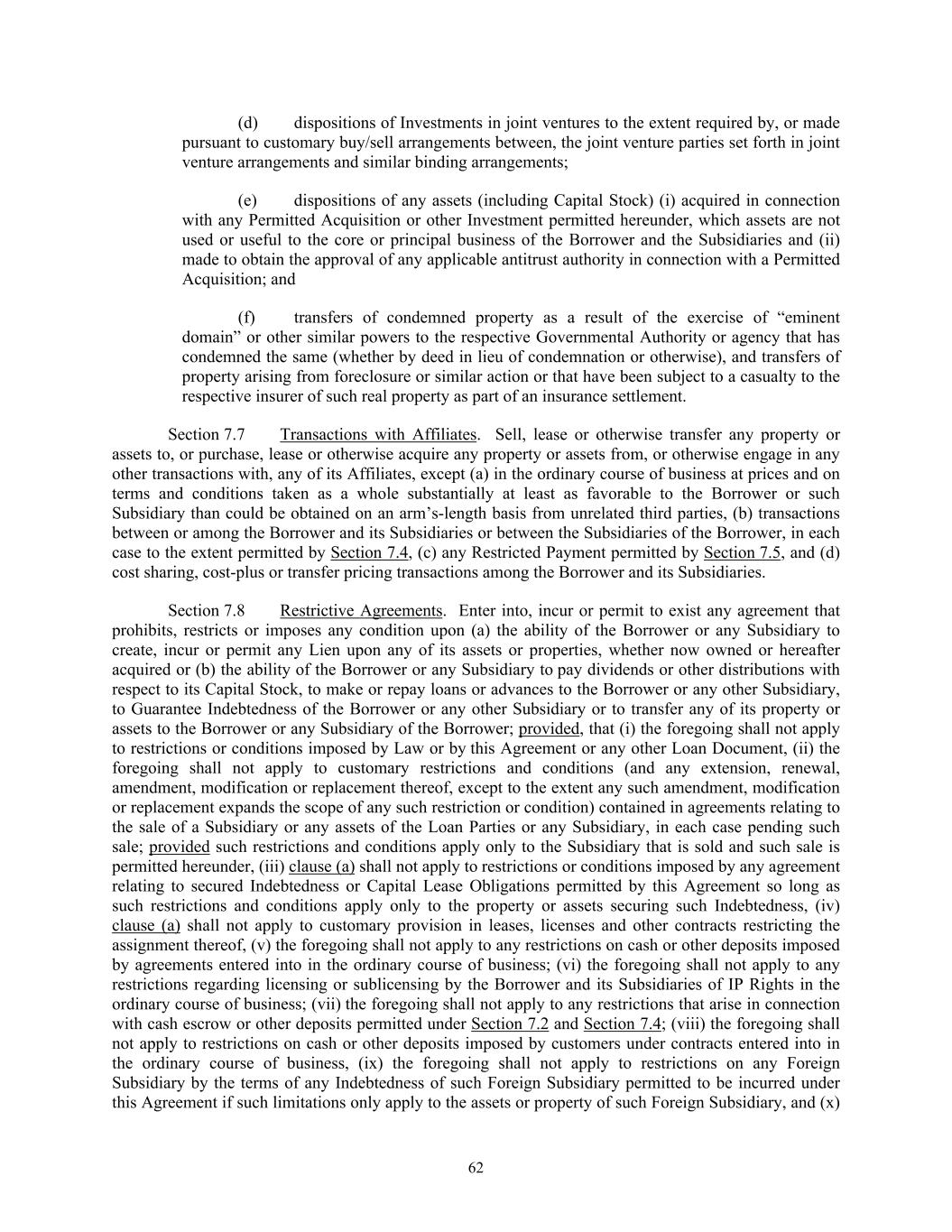
62 (d) dispositions of Investments in joint ventures to the extent required by, or made pursuant to customary buy/sell arrangements between, the joint venture parties set forth in joint venture arrangements and similar binding arrangements; (e) dispositions of any assets (including Capital Stock) (i) acquired in connection with any Permitted Acquisition or other Investment permitted hereunder, which assets are not used or useful to the core or principal business of the Borrower and the Subsidiaries and (ii) made to obtain the approval of any applicable antitrust authority in connection with a Permitted Acquisition; and (f) transfers of condemned property as a result of the exercise of “eminent domain” or other similar powers to the respective Governmental Authority or agency that has condemned the same (whether by deed in lieu of condemnation or otherwise), and transfers of property arising from foreclosure or similar action or that have been subject to a casualty to the respective insurer of such real property as part of an insurance settlement. Section 7.7 Transactions with Affiliates. Sell, lease or otherwise transfer any property or assets to, or purchase, lease or otherwise acquire any property or assets from, or otherwise engage in any other transactions with, any of its Affiliates, except (a) in the ordinary course of business at prices and on terms and conditions taken as a whole substantially at least as favorable to the Borrower or such Subsidiary than could be obtained on an arm’s-length basis from unrelated third parties, (b) transactions between or among the Borrower and its Subsidiaries or between the Subsidiaries of the Borrower, in each case to the extent permitted by Section 7.4, (c) any Restricted Payment permitted by Section 7.5, and (d) cost sharing, cost-plus or transfer pricing transactions among the Borrower and its Subsidiaries. Section 7.8 Restrictive Agreements. Enter into, incur or permit to exist any agreement that prohibits, restricts or imposes any condition upon (a) the ability of the Borrower or any Subsidiary to create, incur or permit any Lien upon any of its assets or properties, whether now owned or hereafter acquired or (b) the ability of the Borrower or any Subsidiary to pay dividends or other distributions with respect to its Capital Stock, to make or repay loans or advances to the Borrower or any other Subsidiary, to Guarantee Indebtedness of the Borrower or any other Subsidiary or to transfer any of its property or assets to the Borrower or any Subsidiary of the Borrower; provided, that (i) the foregoing shall not apply to restrictions or conditions imposed by Law or by this Agreement or any other Loan Document, (ii) the foregoing shall not apply to customary restrictions and conditions (and any extension, renewal, amendment, modification or replacement thereof, except to the extent any such amendment, modification or replacement expands the scope of any such restriction or condition) contained in agreements relating to the sale of a Subsidiary or any assets of the Loan Parties or any Subsidiary, in each case pending such sale; provided such restrictions and conditions apply only to the Subsidiary that is sold and such sale is permitted hereunder, (iii) clause (a) shall not apply to restrictions or conditions imposed by any agreement relating to secured Indebtedness or Capital Lease Obligations permitted by this Agreement so long as such restrictions and conditions apply only to the property or assets securing such Indebtedness, (iv) clause (a) shall not apply to customary provision in leases, licenses and other contracts restricting the assignment thereof, (v) the foregoing shall not apply to any restrictions on cash or other deposits imposed by agreements entered into in the ordinary course of business; (vi) the foregoing shall not apply to any restrictions regarding licensing or sublicensing by the Borrower and its Subsidiaries of IP Rights in the ordinary course of business; (vii) the foregoing shall not apply to any restrictions that arise in connection with cash escrow or other deposits permitted under Section 7.2 and Section 7.4; (viii) the foregoing shall not apply to restrictions on cash or other deposits imposed by customers under contracts entered into in the ordinary course of business, (ix) the foregoing shall not apply to restrictions on any Foreign Subsidiary by the terms of any Indebtedness of such Foreign Subsidiary permitted to be incurred under this Agreement if such limitations only apply to the assets or property of such Foreign Subsidiary, and (x)
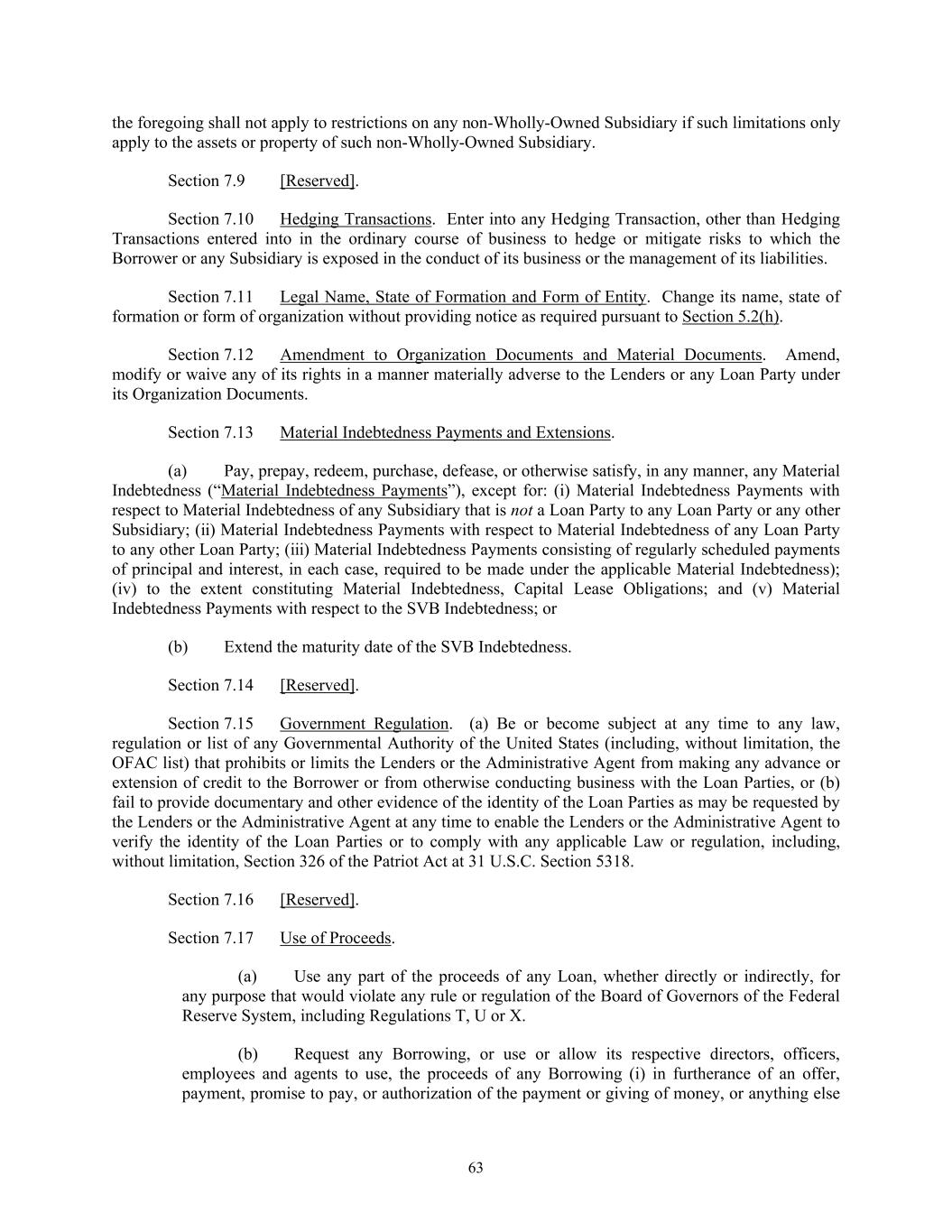
63 the foregoing shall not apply to restrictions on any non-Wholly-Owned Subsidiary if such limitations only apply to the assets or property of such non-Wholly-Owned Subsidiary. Section 7.9 [Reserved]. Section 7.10 Hedging Transactions. Enter into any Hedging Transaction, other than Hedging Transactions entered into in the ordinary course of business to hedge or mitigate risks to which the Borrower or any Subsidiary is exposed in the conduct of its business or the management of its liabilities. Section 7.11 Legal Name, State of Formation and Form of Entity. Change its name, state of formation or form of organization without providing notice as required pursuant to Section 5.2(h). Section 7.12 Amendment to Organization Documents and Material Documents. Amend, modify or waive any of its rights in a manner materially adverse to the Lenders or any Loan Party under its Organization Documents. Section 7.13 Material Indebtedness Payments and Extensions. (a) Pay, prepay, redeem, purchase, defease, or otherwise satisfy, in any manner, any Material Indebtedness (“Material Indebtedness Payments”), except for: (i) Material Indebtedness Payments with respect to Material Indebtedness of any Subsidiary that is not a Loan Party to any Loan Party or any other Subsidiary; (ii) Material Indebtedness Payments with respect to Material Indebtedness of any Loan Party to any other Loan Party; (iii) Material Indebtedness Payments consisting of regularly scheduled payments of principal and interest, in each case, required to be made under the applicable Material Indebtedness); (iv) to the extent constituting Material Indebtedness, Capital Lease Obligations; and (v) Material Indebtedness Payments with respect to the SVB Indebtedness; or (b) Extend the maturity date of the SVB Indebtedness. Section 7.14 [Reserved]. Section 7.15 Government Regulation. (a) Be or become subject at any time to any law, regulation or list of any Governmental Authority of the United States (including, without limitation, the OFAC list) that prohibits or limits the Lenders or the Administrative Agent from making any advance or extension of credit to the Borrower or from otherwise conducting business with the Loan Parties, or (b) fail to provide documentary and other evidence of the identity of the Loan Parties as may be requested by the Lenders or the Administrative Agent at any time to enable the Lenders or the Administrative Agent to verify the identity of the Loan Parties or to comply with any applicable Law or regulation, including, without limitation, Section 326 of the Patriot Act at 31 U.S.C. Section 5318. Section 7.16 [Reserved]. Section 7.17 Use of Proceeds. (a) Use any part of the proceeds of any Loan, whether directly or indirectly, for any purpose that would violate any rule or regulation of the Board of Governors of the Federal Reserve System, including Regulations T, U or X. (b) Request any Borrowing, or use or allow its respective directors, officers, employees and agents to use, the proceeds of any Borrowing (i) in furtherance of an offer, payment, promise to pay, or authorization of the payment or giving of money, or anything else
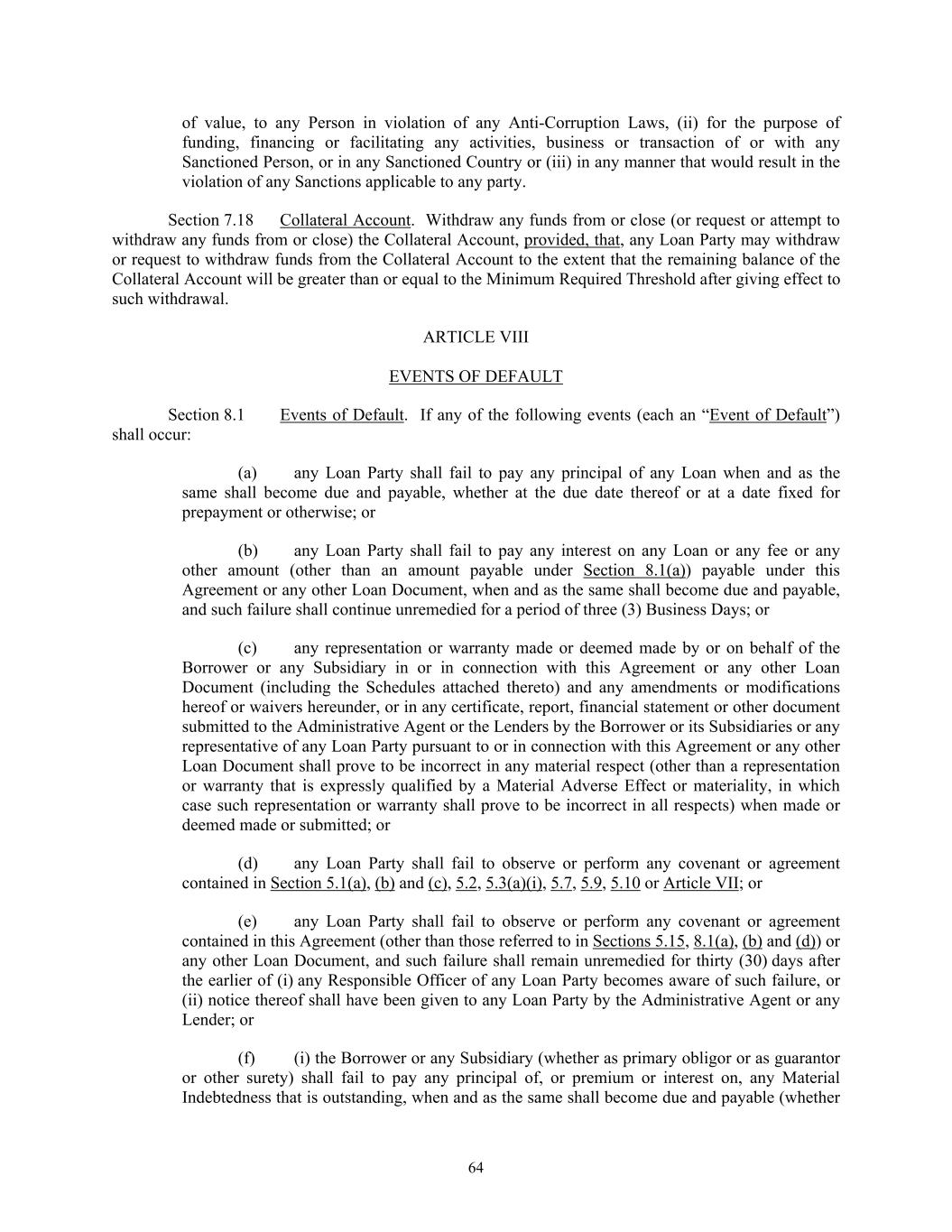
64 of value, to any Person in violation of any Anti-Corruption Laws, (ii) for the purpose of funding, financing or facilitating any activities, business or transaction of or with any Sanctioned Person, or in any Sanctioned Country or (iii) in any manner that would result in the violation of any Sanctions applicable to any party. Section 7.18 Collateral Account. Withdraw any funds from or close (or request or attempt to withdraw any funds from or close) the Collateral Account, provided, that, any Loan Party may withdraw or request to withdraw funds from the Collateral Account to the extent that the remaining balance of the Collateral Account will be greater than or equal to the Minimum Required Threshold after giving effect to such withdrawal. ARTICLE VIII EVENTS OF DEFAULT Section 8.1 Events of Default. If any of the following events (each an “Event of Default”) shall occur: (a) any Loan Party shall fail to pay any principal of any Loan when and as the same shall become due and payable, whether at the due date thereof or at a date fixed for prepayment or otherwise; or (b) any Loan Party shall fail to pay any interest on any Loan or any fee or any other amount (other than an amount payable under Section 8.1(a)) payable under this Agreement or any other Loan Document, when and as the same shall become due and payable, and such failure shall continue unremedied for a period of three (3) Business Days; or (c) any representation or warranty made or deemed made by or on behalf of the Borrower or any Subsidiary in or in connection with this Agreement or any other Loan Document (including the Schedules attached thereto) and any amendments or modifications hereof or waivers hereunder, or in any certificate, report, financial statement or other document submitted to the Administrative Agent or the Lenders by the Borrower or its Subsidiaries or any representative of any Loan Party pursuant to or in connection with this Agreement or any other Loan Document shall prove to be incorrect in any material respect (other than a representation or warranty that is expressly qualified by a Material Adverse Effect or materiality, in which case such representation or warranty shall prove to be incorrect in all respects) when made or deemed made or submitted; or (d) any Loan Party shall fail to observe or perform any covenant or agreement contained in Section 5.1(a), (b) and (c), 5.2, 5.3(a)(i), 5.7, 5.9, 5.10 or Article VII; or (e) any Loan Party shall fail to observe or perform any covenant or agreement contained in this Agreement (other than those referred to in Sections 5.15, 8.1(a), (b) and (d)) or any other Loan Document, and such failure shall remain unremedied for thirty (30) days after the earlier of (i) any Responsible Officer of any Loan Party becomes aware of such failure, or (ii) notice thereof shall have been given to any Loan Party by the Administrative Agent or any Lender; or (f) (i) the Borrower or any Subsidiary (whether as primary obligor or as guarantor or other surety) shall fail to pay any principal of, or premium or interest on, any Material Indebtedness that is outstanding, when and as the same shall become due and payable (whether
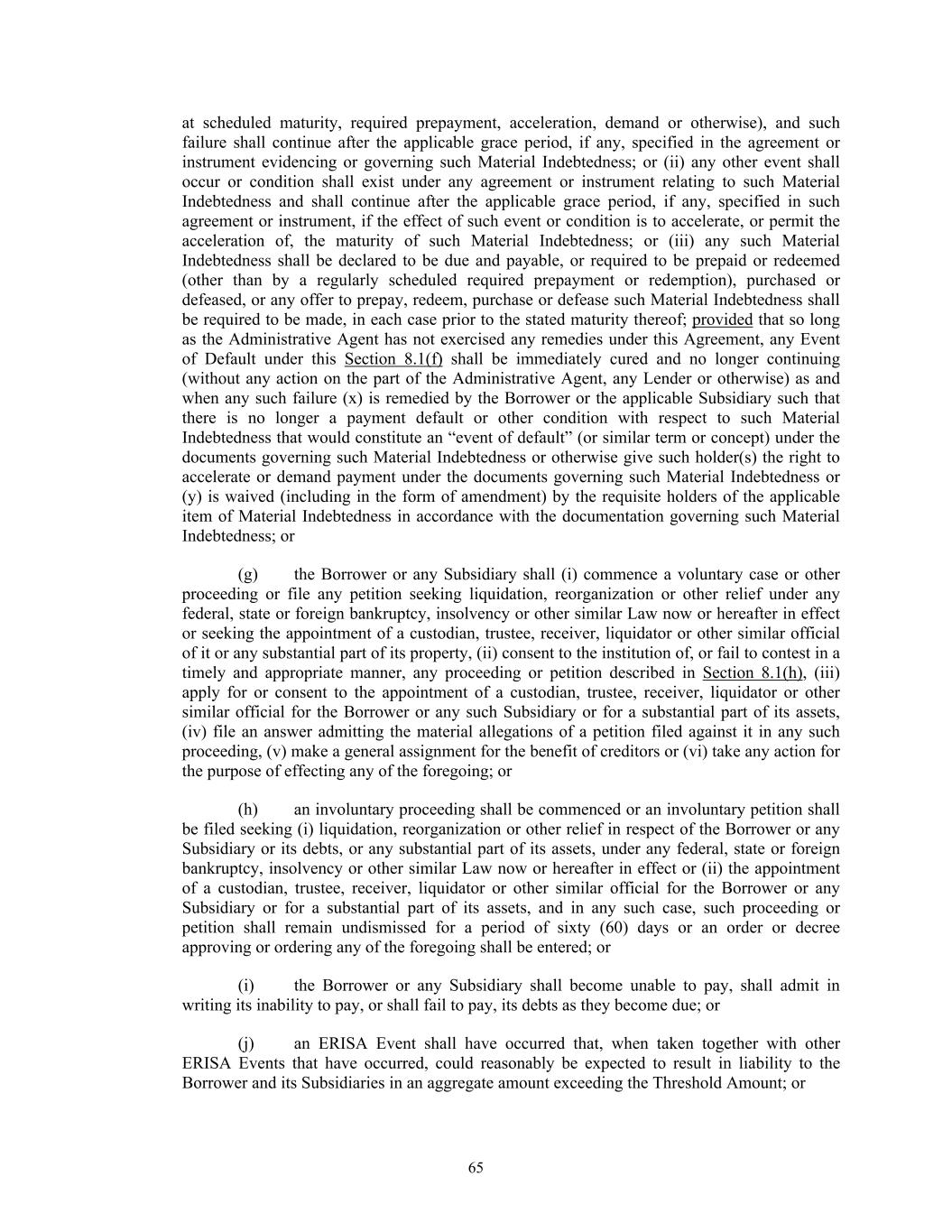
65 at scheduled maturity, required prepayment, acceleration, demand or otherwise), and such failure shall continue after the applicable grace period, if any, specified in the agreement or instrument evidencing or governing such Material Indebtedness; or (ii) any other event shall occur or condition shall exist under any agreement or instrument relating to such Material Indebtedness and shall continue after the applicable grace period, if any, specified in such agreement or instrument, if the effect of such event or condition is to accelerate, or permit the acceleration of, the maturity of such Material Indebtedness; or (iii) any such Material Indebtedness shall be declared to be due and payable, or required to be prepaid or redeemed (other than by a regularly scheduled required prepayment or redemption), purchased or defeased, or any offer to prepay, redeem, purchase or defease such Material Indebtedness shall be required to be made, in each case prior to the stated maturity thereof; provided that so long as the Administrative Agent has not exercised any remedies under this Agreement, any Event of Default under this Section 8.1(f) shall be immediately cured and no longer continuing (without any action on the part of the Administrative Agent, any Lender or otherwise) as and when any such failure (x) is remedied by the Borrower or the applicable Subsidiary such that there is no longer a payment default or other condition with respect to such Material Indebtedness that would constitute an “event of default” (or similar term or concept) under the documents governing such Material Indebtedness or otherwise give such holder(s) the right to accelerate or demand payment under the documents governing such Material Indebtedness or (y) is waived (including in the form of amendment) by the requisite holders of the applicable item of Material Indebtedness in accordance with the documentation governing such Material Indebtedness; or (g) the Borrower or any Subsidiary shall (i) commence a voluntary case or other proceeding or file any petition seeking liquidation, reorganization or other relief under any federal, state or foreign bankruptcy, insolvency or other similar Law now or hereafter in effect or seeking the appointment of a custodian, trustee, receiver, liquidator or other similar official of it or any substantial part of its property, (ii) consent to the institution of, or fail to contest in a timely and appropriate manner, any proceeding or petition described in Section 8.1(h), (iii) apply for or consent to the appointment of a custodian, trustee, receiver, liquidator or other similar official for the Borrower or any such Subsidiary or for a substantial part of its assets, (iv) file an answer admitting the material allegations of a petition filed against it in any such proceeding, (v) make a general assignment for the benefit of creditors or (vi) take any action for the purpose of effecting any of the foregoing; or (h) an involuntary proceeding shall be commenced or an involuntary petition shall be filed seeking (i) liquidation, reorganization or other relief in respect of the Borrower or any Subsidiary or its debts, or any substantial part of its assets, under any federal, state or foreign bankruptcy, insolvency or other similar Law now or hereafter in effect or (ii) the appointment of a custodian, trustee, receiver, liquidator or other similar official for the Borrower or any Subsidiary or for a substantial part of its assets, and in any such case, such proceeding or petition shall remain undismissed for a period of sixty (60) days or an order or decree approving or ordering any of the foregoing shall be entered; or (i) the Borrower or any Subsidiary shall become unable to pay, shall admit in writing its inability to pay, or shall fail to pay, its debts as they become due; or (j) an ERISA Event shall have occurred that, when taken together with other ERISA Events that have occurred, could reasonably be expected to result in liability to the Borrower and its Subsidiaries in an aggregate amount exceeding the Threshold Amount; or
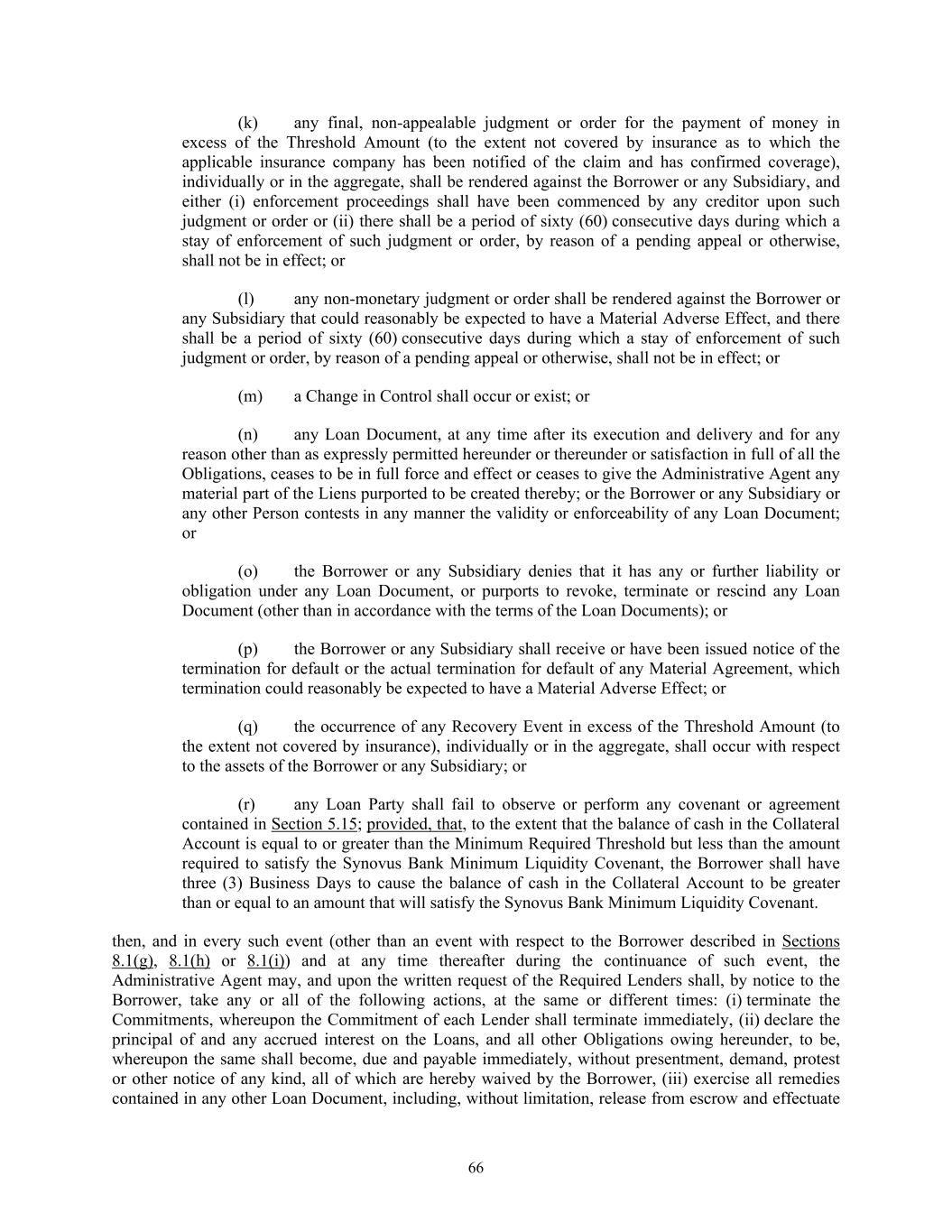
66 (k) any final, non-appealable judgment or order for the payment of money in excess of the Threshold Amount (to the extent not covered by insurance as to which the applicable insurance company has been notified of the claim and has confirmed coverage), individually or in the aggregate, shall be rendered against the Borrower or any Subsidiary, and either (i) enforcement proceedings shall have been commenced by any creditor upon such judgment or order or (ii) there shall be a period of sixty (60) consecutive days during which a stay of enforcement of such judgment or order, by reason of a pending appeal or otherwise, shall not be in effect; or (l) any non-monetary judgment or order shall be rendered against the Borrower or any Subsidiary that could reasonably be expected to have a Material Adverse Effect, and there shall be a period of sixty (60) consecutive days during which a stay of enforcement of such judgment or order, by reason of a pending appeal or otherwise, shall not be in effect; or (m) a Change in Control shall occur or exist; or (n) any Loan Document, at any time after its execution and delivery and for any reason other than as expressly permitted hereunder or thereunder or satisfaction in full of all the Obligations, ceases to be in full force and effect or ceases to give the Administrative Agent any material part of the Liens purported to be created thereby; or the Borrower or any Subsidiary or any other Person contests in any manner the validity or enforceability of any Loan Document; or (o) the Borrower or any Subsidiary denies that it has any or further liability or obligation under any Loan Document, or purports to revoke, terminate or rescind any Loan Document (other than in accordance with the terms of the Loan Documents); or (p) the Borrower or any Subsidiary shall receive or have been issued notice of the termination for default or the actual termination for default of any Material Agreement, which termination could reasonably be expected to have a Material Adverse Effect; or (q) the occurrence of any Recovery Event in excess of the Threshold Amount (to the extent not covered by insurance), individually or in the aggregate, shall occur with respect to the assets of the Borrower or any Subsidiary; or (r) any Loan Party shall fail to observe or perform any covenant or agreement contained in Section 5.15; provided, that, to the extent that the balance of cash in the Collateral Account is equal to or greater than the Minimum Required Threshold but less than the amount required to satisfy the Synovus Bank Minimum Liquidity Covenant, the Borrower shall have three (3) Business Days to cause the balance of cash in the Collateral Account to be greater than or equal to an amount that will satisfy the Synovus Bank Minimum Liquidity Covenant. then, and in every such event (other than an event with respect to the Borrower described in Sections 8.1(g), 8.1(h) or 8.1(i)) and at any time thereafter during the continuance of such event, the Administrative Agent may, and upon the written request of the Required Lenders shall, by notice to the Borrower, take any or all of the following actions, at the same or different times: (i) terminate the Commitments, whereupon the Commitment of each Lender shall terminate immediately, (ii) declare the principal of and any accrued interest on the Loans, and all other Obligations owing hereunder, to be, whereupon the same shall become, due and payable immediately, without presentment, demand, protest or other notice of any kind, all of which are hereby waived by the Borrower, (iii) exercise all remedies contained in any other Loan Document, including, without limitation, release from escrow and effectuate
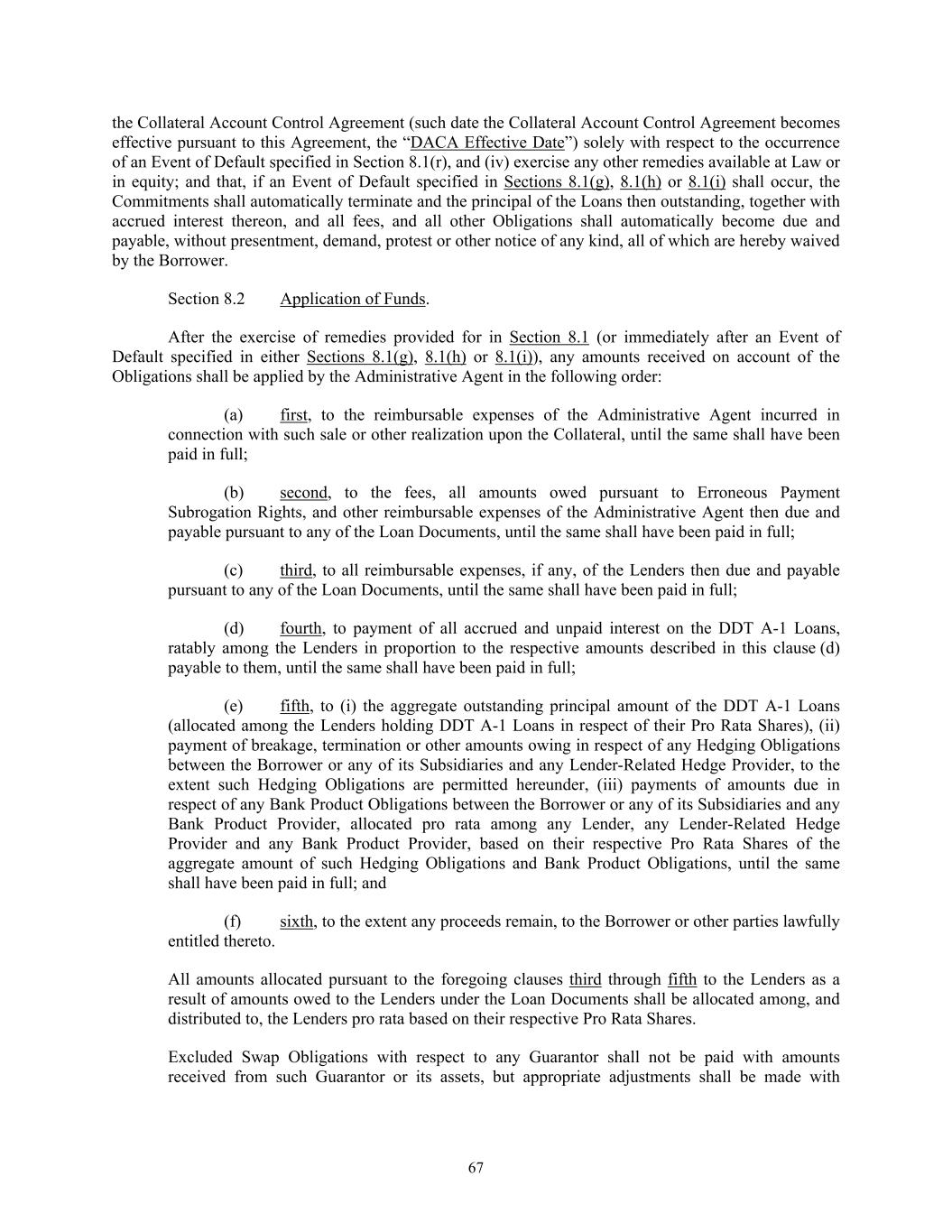
67 the Collateral Account Control Agreement (such date the Collateral Account Control Agreement becomes effective pursuant to this Agreement, the “DACA Effective Date”) solely with respect to the occurrence of an Event of Default specified in Section 8.1(r), and (iv) exercise any other remedies available at Law or in equity; and that, if an Event of Default specified in Sections 8.1(g), 8.1(h) or 8.1(i) shall occur, the Commitments shall automatically terminate and the principal of the Loans then outstanding, together with accrued interest thereon, and all fees, and all other Obligations shall automatically become due and payable, without presentment, demand, protest or other notice of any kind, all of which are hereby waived by the Borrower. Section 8.2 Application of Funds. After the exercise of remedies provided for in Section 8.1 (or immediately after an Event of Default specified in either Sections 8.1(g), 8.1(h) or 8.1(i)), any amounts received on account of the Obligations shall be applied by the Administrative Agent in the following order: (a) first, to the reimbursable expenses of the Administrative Agent incurred in connection with such sale or other realization upon the Collateral, until the same shall have been paid in full; (b) second, to the fees, all amounts owed pursuant to Erroneous Payment Subrogation Rights, and other reimbursable expenses of the Administrative Agent then due and payable pursuant to any of the Loan Documents, until the same shall have been paid in full; (c) third, to all reimbursable expenses, if any, of the Lenders then due and payable pursuant to any of the Loan Documents, until the same shall have been paid in full; (d) fourth, to payment of all accrued and unpaid interest on the DDT A-1 Loans, ratably among the Lenders in proportion to the respective amounts described in this clause (d) payable to them, until the same shall have been paid in full; (e) fifth, to (i) the aggregate outstanding principal amount of the DDT A-1 Loans (allocated among the Lenders holding DDT A-1 Loans in respect of their Pro Rata Shares), (ii) payment of breakage, termination or other amounts owing in respect of any Hedging Obligations between the Borrower or any of its Subsidiaries and any Lender-Related Hedge Provider, to the extent such Hedging Obligations are permitted hereunder, (iii) payments of amounts due in respect of any Bank Product Obligations between the Borrower or any of its Subsidiaries and any Bank Product Provider, allocated pro rata among any Lender, any Lender-Related Hedge Provider and any Bank Product Provider, based on their respective Pro Rata Shares of the aggregate amount of such Hedging Obligations and Bank Product Obligations, until the same shall have been paid in full; and (f) sixth, to the extent any proceeds remain, to the Borrower or other parties lawfully entitled thereto. All amounts allocated pursuant to the foregoing clauses third through fifth to the Lenders as a result of amounts owed to the Lenders under the Loan Documents shall be allocated among, and distributed to, the Lenders pro rata based on their respective Pro Rata Shares. Excluded Swap Obligations with respect to any Guarantor shall not be paid with amounts received from such Guarantor or its assets, but appropriate adjustments shall be made with
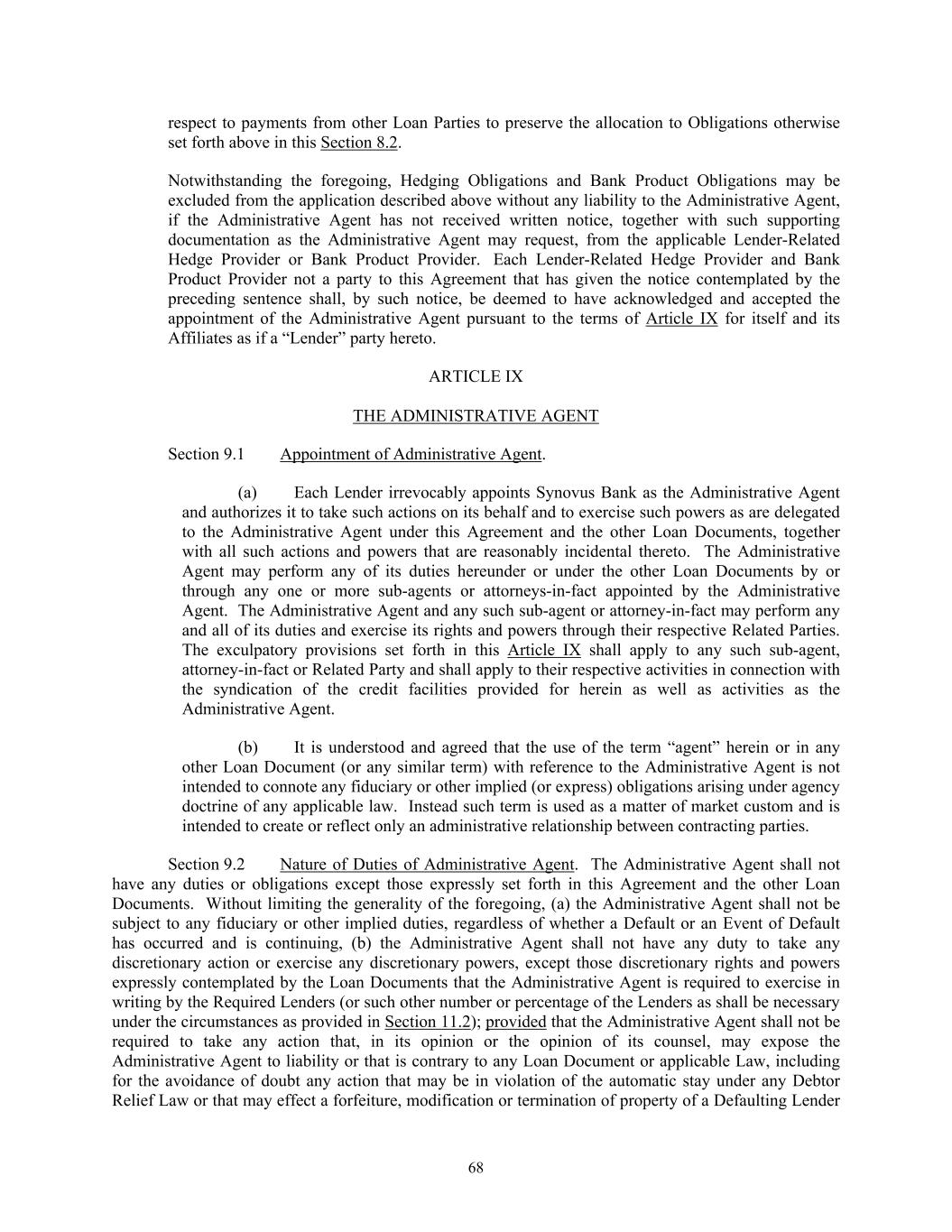
68 respect to payments from other Loan Parties to preserve the allocation to Obligations otherwise set forth above in this Section 8.2. Notwithstanding the foregoing, Hedging Obligations and Bank Product Obligations may be excluded from the application described above without any liability to the Administrative Agent, if the Administrative Agent has not received written notice, together with such supporting documentation as the Administrative Agent may request, from the applicable Lender-Related Hedge Provider or Bank Product Provider. Each Lender-Related Hedge Provider and Bank Product Provider not a party to this Agreement that has given the notice contemplated by the preceding sentence shall, by such notice, be deemed to have acknowledged and accepted the appointment of the Administrative Agent pursuant to the terms of Article IX for itself and its Affiliates as if a “Lender” party hereto. ARTICLE IX THE ADMINISTRATIVE AGENT Section 9.1 Appointment of Administrative Agent. (a) Each Lender irrevocably appoints Synovus Bank as the Administrative Agent and authorizes it to take such actions on its behalf and to exercise such powers as are delegated to the Administrative Agent under this Agreement and the other Loan Documents, together with all such actions and powers that are reasonably incidental thereto. The Administrative Agent may perform any of its duties hereunder or under the other Loan Documents by or through any one or more sub-agents or attorneys-in-fact appointed by the Administrative Agent. The Administrative Agent and any such sub-agent or attorney-in-fact may perform any and all of its duties and exercise its rights and powers through their respective Related Parties. The exculpatory provisions set forth in this Article IX shall apply to any such sub-agent, attorney-in-fact or Related Party and shall apply to their respective activities in connection with the syndication of the credit facilities provided for herein as well as activities as the Administrative Agent. (b) It is understood and agreed that the use of the term “agent” herein or in any other Loan Document (or any similar term) with reference to the Administrative Agent is not intended to connote any fiduciary or other implied (or express) obligations arising under agency doctrine of any applicable law. Instead such term is used as a matter of market custom and is intended to create or reflect only an administrative relationship between contracting parties. Section 9.2 Nature of Duties of Administrative Agent. The Administrative Agent shall not have any duties or obligations except those expressly set forth in this Agreement and the other Loan Documents. Without limiting the generality of the foregoing, (a) the Administrative Agent shall not be subject to any fiduciary or other implied duties, regardless of whether a Default or an Event of Default has occurred and is continuing, (b) the Administrative Agent shall not have any duty to take any discretionary action or exercise any discretionary powers, except those discretionary rights and powers expressly contemplated by the Loan Documents that the Administrative Agent is required to exercise in writing by the Required Lenders (or such other number or percentage of the Lenders as shall be necessary under the circumstances as provided in Section 11.2); provided that the Administrative Agent shall not be required to take any action that, in its opinion or the opinion of its counsel, may expose the Administrative Agent to liability or that is contrary to any Loan Document or applicable Law, including for the avoidance of doubt any action that may be in violation of the automatic stay under any Debtor Relief Law or that may effect a forfeiture, modification or termination of property of a Defaulting Lender
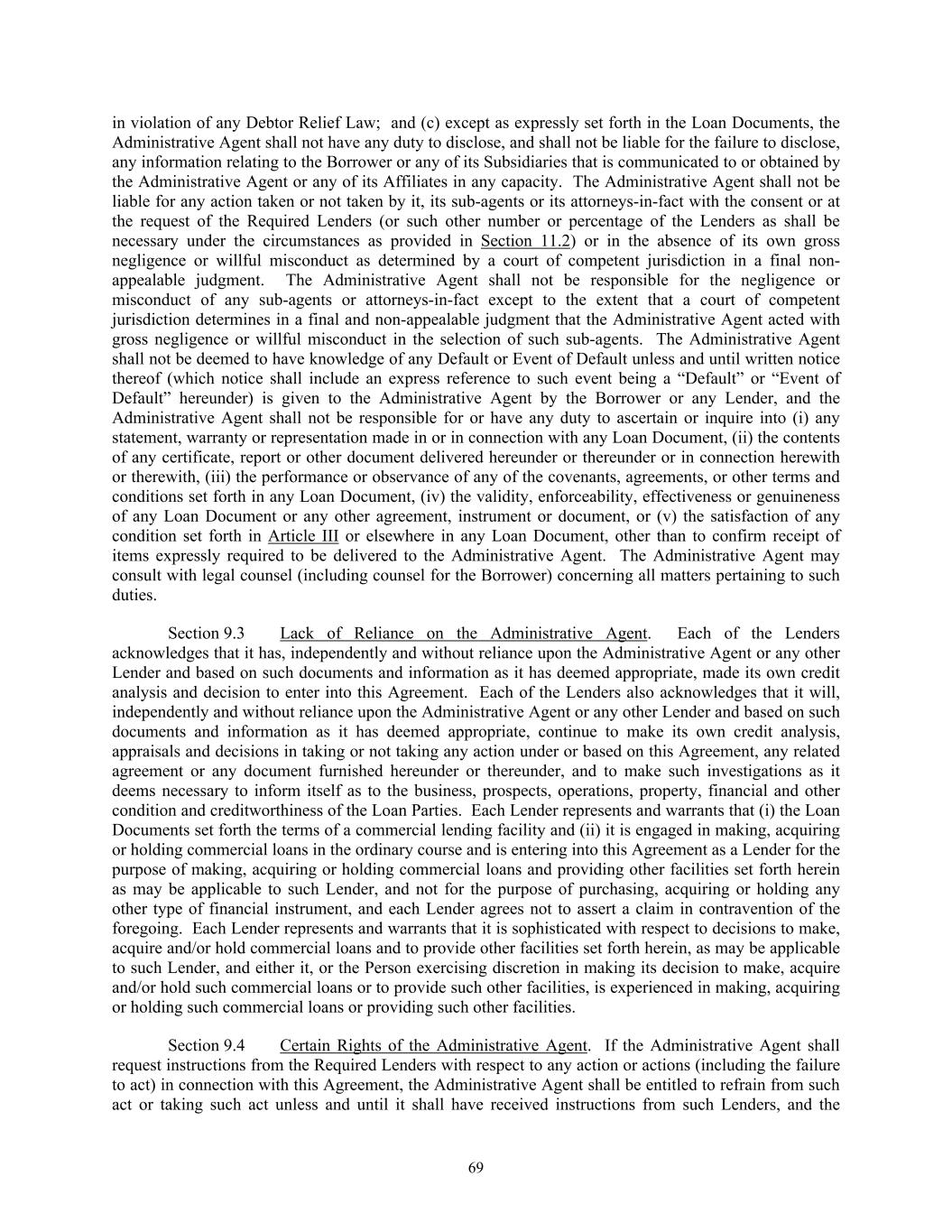
69 in violation of any Debtor Relief Law; and (c) except as expressly set forth in the Loan Documents, the Administrative Agent shall not have any duty to disclose, and shall not be liable for the failure to disclose, any information relating to the Borrower or any of its Subsidiaries that is communicated to or obtained by the Administrative Agent or any of its Affiliates in any capacity. The Administrative Agent shall not be liable for any action taken or not taken by it, its sub-agents or its attorneys-in-fact with the consent or at the request of the Required Lenders (or such other number or percentage of the Lenders as shall be necessary under the circumstances as provided in Section 11.2) or in the absence of its own gross negligence or willful misconduct as determined by a court of competent jurisdiction in a final non- appealable judgment. The Administrative Agent shall not be responsible for the negligence or misconduct of any sub-agents or attorneys-in-fact except to the extent that a court of competent jurisdiction determines in a final and non-appealable judgment that the Administrative Agent acted with gross negligence or willful misconduct in the selection of such sub-agents. The Administrative Agent shall not be deemed to have knowledge of any Default or Event of Default unless and until written notice thereof (which notice shall include an express reference to such event being a “Default” or “Event of Default” hereunder) is given to the Administrative Agent by the Borrower or any Lender, and the Administrative Agent shall not be responsible for or have any duty to ascertain or inquire into (i) any statement, warranty or representation made in or in connection with any Loan Document, (ii) the contents of any certificate, report or other document delivered hereunder or thereunder or in connection herewith or therewith, (iii) the performance or observance of any of the covenants, agreements, or other terms and conditions set forth in any Loan Document, (iv) the validity, enforceability, effectiveness or genuineness of any Loan Document or any other agreement, instrument or document, or (v) the satisfaction of any condition set forth in Article III or elsewhere in any Loan Document, other than to confirm receipt of items expressly required to be delivered to the Administrative Agent. The Administrative Agent may consult with legal counsel (including counsel for the Borrower) concerning all matters pertaining to such duties. Section 9.3 Lack of Reliance on the Administrative Agent. Each of the Lenders acknowledges that it has, independently and without reliance upon the Administrative Agent or any other Lender and based on such documents and information as it has deemed appropriate, made its own credit analysis and decision to enter into this Agreement. Each of the Lenders also acknowledges that it will, independently and without reliance upon the Administrative Agent or any other Lender and based on such documents and information as it has deemed appropriate, continue to make its own credit analysis, appraisals and decisions in taking or not taking any action under or based on this Agreement, any related agreement or any document furnished hereunder or thereunder, and to make such investigations as it deems necessary to inform itself as to the business, prospects, operations, property, financial and other condition and creditworthiness of the Loan Parties. Each Lender represents and warrants that (i) the Loan Documents set forth the terms of a commercial lending facility and (ii) it is engaged in making, acquiring or holding commercial loans in the ordinary course and is entering into this Agreement as a Lender for the purpose of making, acquiring or holding commercial loans and providing other facilities set forth herein as may be applicable to such Lender, and not for the purpose of purchasing, acquiring or holding any other type of financial instrument, and each Lender agrees not to assert a claim in contravention of the foregoing. Each Lender represents and warrants that it is sophisticated with respect to decisions to make, acquire and/or hold commercial loans and to provide other facilities set forth herein, as may be applicable to such Lender, and either it, or the Person exercising discretion in making its decision to make, acquire and/or hold such commercial loans or to provide such other facilities, is experienced in making, acquiring or holding such commercial loans or providing such other facilities. Section 9.4 Certain Rights of the Administrative Agent. If the Administrative Agent shall request instructions from the Required Lenders with respect to any action or actions (including the failure to act) in connection with this Agreement, the Administrative Agent shall be entitled to refrain from such act or taking such act unless and until it shall have received instructions from such Lenders, and the
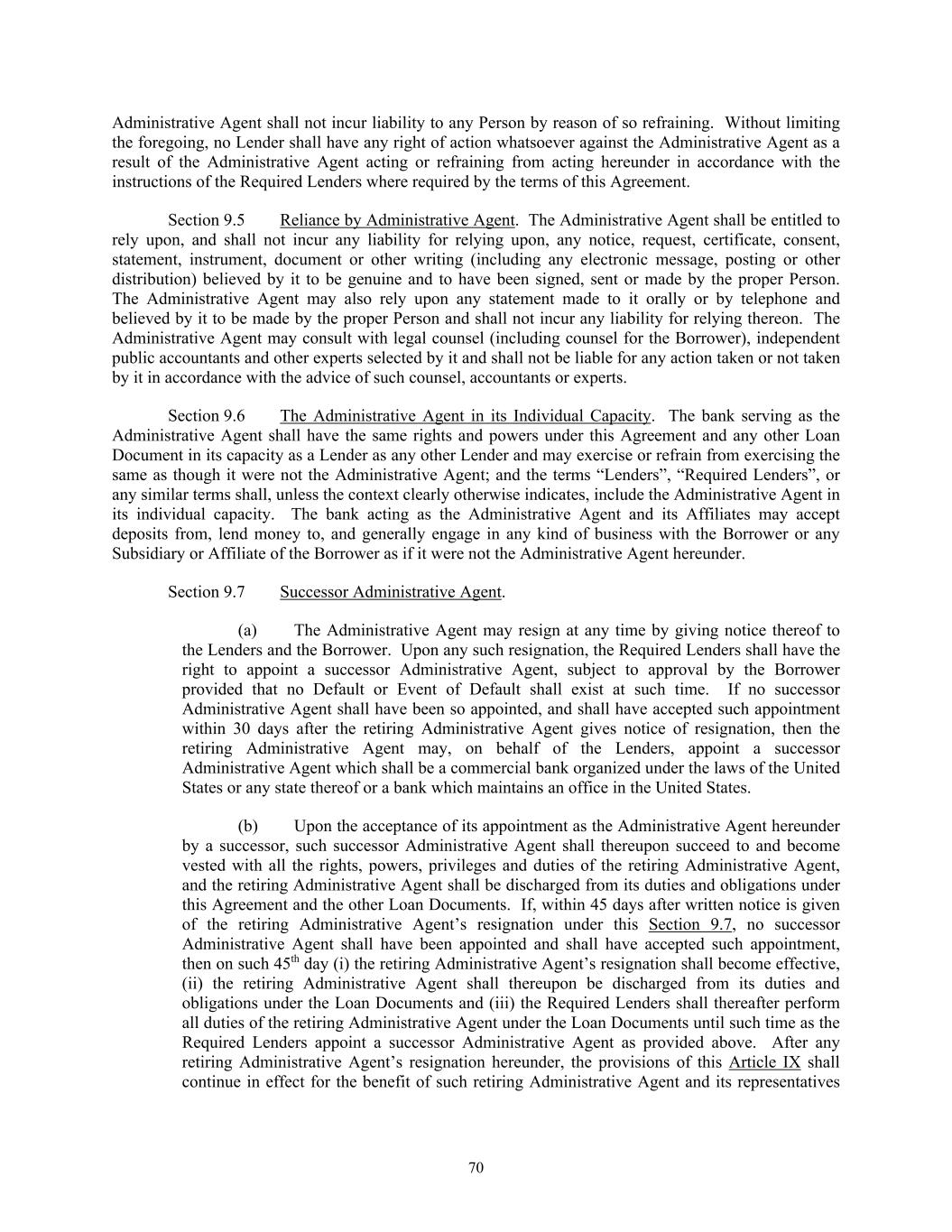
70 Administrative Agent shall not incur liability to any Person by reason of so refraining. Without limiting the foregoing, no Lender shall have any right of action whatsoever against the Administrative Agent as a result of the Administrative Agent acting or refraining from acting hereunder in accordance with the instructions of the Required Lenders where required by the terms of this Agreement. Section 9.5 Reliance by Administrative Agent. The Administrative Agent shall be entitled to rely upon, and shall not incur any liability for relying upon, any notice, request, certificate, consent, statement, instrument, document or other writing (including any electronic message, posting or other distribution) believed by it to be genuine and to have been signed, sent or made by the proper Person. The Administrative Agent may also rely upon any statement made to it orally or by telephone and believed by it to be made by the proper Person and shall not incur any liability for relying thereon. The Administrative Agent may consult with legal counsel (including counsel for the Borrower), independent public accountants and other experts selected by it and shall not be liable for any action taken or not taken by it in accordance with the advice of such counsel, accountants or experts. Section 9.6 The Administrative Agent in its Individual Capacity. The bank serving as the Administrative Agent shall have the same rights and powers under this Agreement and any other Loan Document in its capacity as a Lender as any other Lender and may exercise or refrain from exercising the same as though it were not the Administrative Agent; and the terms “Lenders”, “Required Lenders”, or any similar terms shall, unless the context clearly otherwise indicates, include the Administrative Agent in its individual capacity. The bank acting as the Administrative Agent and its Affiliates may accept deposits from, lend money to, and generally engage in any kind of business with the Borrower or any Subsidiary or Affiliate of the Borrower as if it were not the Administrative Agent hereunder. Section 9.7 Successor Administrative Agent. (a) The Administrative Agent may resign at any time by giving notice thereof to the Lenders and the Borrower. Upon any such resignation, the Required Lenders shall have the right to appoint a successor Administrative Agent, subject to approval by the Borrower provided that no Default or Event of Default shall exist at such time. If no successor Administrative Agent shall have been so appointed, and shall have accepted such appointment within 30 days after the retiring Administrative Agent gives notice of resignation, then the retiring Administrative Agent may, on behalf of the Lenders, appoint a successor Administrative Agent which shall be a commercial bank organized under the laws of the United States or any state thereof or a bank which maintains an office in the United States. (b) Upon the acceptance of its appointment as the Administrative Agent hereunder by a successor, such successor Administrative Agent shall thereupon succeed to and become vested with all the rights, powers, privileges and duties of the retiring Administrative Agent, and the retiring Administrative Agent shall be discharged from its duties and obligations under this Agreement and the other Loan Documents. If, within 45 days after written notice is given of the retiring Administrative Agent’s resignation under this Section 9.7, no successor Administrative Agent shall have been appointed and shall have accepted such appointment, then on such 45th day (i) the retiring Administrative Agent’s resignation shall become effective, (ii) the retiring Administrative Agent shall thereupon be discharged from its duties and obligations under the Loan Documents and (iii) the Required Lenders shall thereafter perform all duties of the retiring Administrative Agent under the Loan Documents until such time as the Required Lenders appoint a successor Administrative Agent as provided above. After any retiring Administrative Agent’s resignation hereunder, the provisions of this Article IX shall continue in effect for the benefit of such retiring Administrative Agent and its representatives
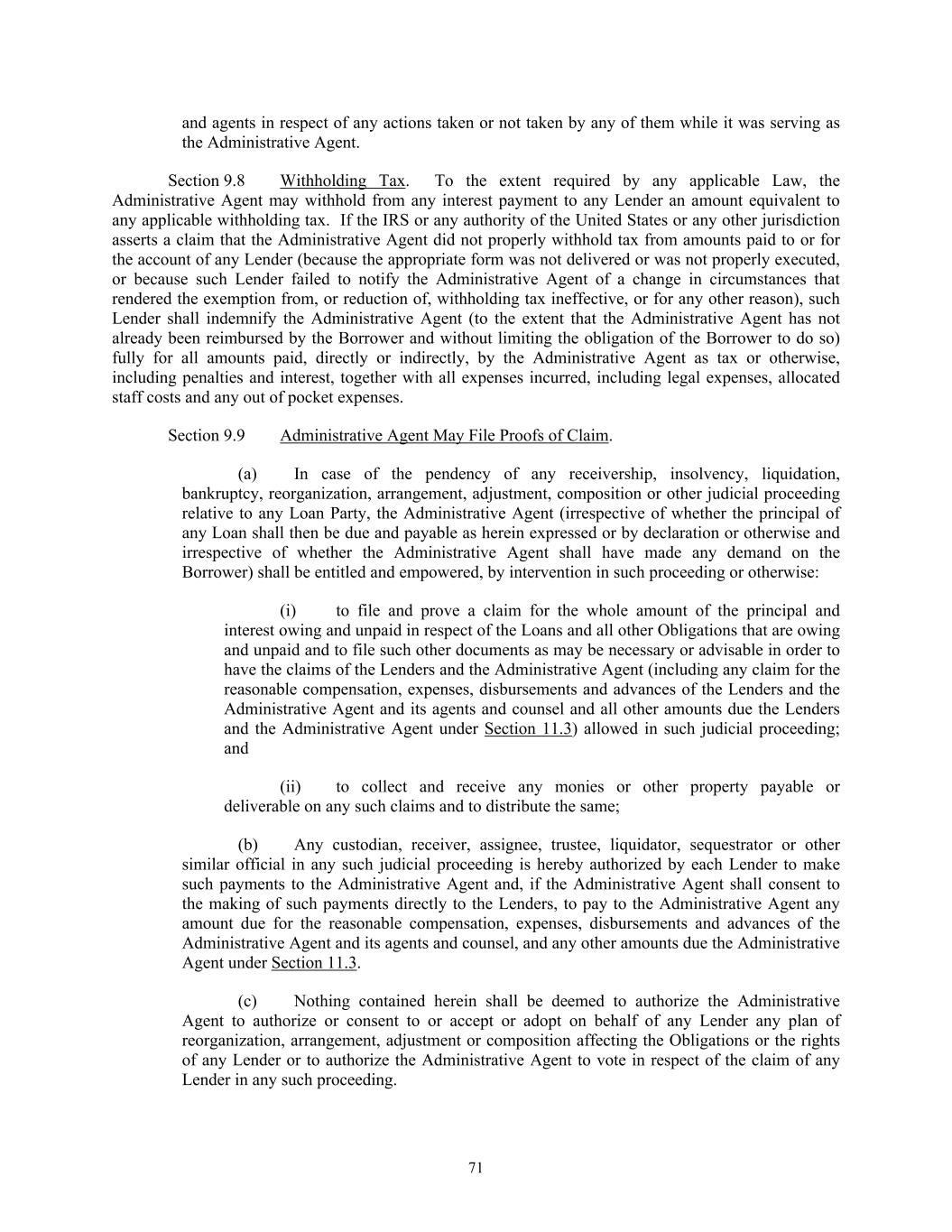
71 and agents in respect of any actions taken or not taken by any of them while it was serving as the Administrative Agent. Section 9.8 Withholding Tax. To the extent required by any applicable Law, the Administrative Agent may withhold from any interest payment to any Lender an amount equivalent to any applicable withholding tax. If the IRS or any authority of the United States or any other jurisdiction asserts a claim that the Administrative Agent did not properly withhold tax from amounts paid to or for the account of any Lender (because the appropriate form was not delivered or was not properly executed, or because such Lender failed to notify the Administrative Agent of a change in circumstances that rendered the exemption from, or reduction of, withholding tax ineffective, or for any other reason), such Lender shall indemnify the Administrative Agent (to the extent that the Administrative Agent has not already been reimbursed by the Borrower and without limiting the obligation of the Borrower to do so) fully for all amounts paid, directly or indirectly, by the Administrative Agent as tax or otherwise, including penalties and interest, together with all expenses incurred, including legal expenses, allocated staff costs and any out of pocket expenses. Section 9.9 Administrative Agent May File Proofs of Claim. (a) In case of the pendency of any receivership, insolvency, liquidation, bankruptcy, reorganization, arrangement, adjustment, composition or other judicial proceeding relative to any Loan Party, the Administrative Agent (irrespective of whether the principal of any Loan shall then be due and payable as herein expressed or by declaration or otherwise and irrespective of whether the Administrative Agent shall have made any demand on the Borrower) shall be entitled and empowered, by intervention in such proceeding or otherwise: (i) to file and prove a claim for the whole amount of the principal and interest owing and unpaid in respect of the Loans and all other Obligations that are owing and unpaid and to file such other documents as may be necessary or advisable in order to have the claims of the Lenders and the Administrative Agent (including any claim for the reasonable compensation, expenses, disbursements and advances of the Lenders and the Administrative Agent and its agents and counsel and all other amounts due the Lenders and the Administrative Agent under Section 11.3) allowed in such judicial proceeding; and (ii) to collect and receive any monies or other property payable or deliverable on any such claims and to distribute the same; (b) Any custodian, receiver, assignee, trustee, liquidator, sequestrator or other similar official in any such judicial proceeding is hereby authorized by each Lender to make such payments to the Administrative Agent and, if the Administrative Agent shall consent to the making of such payments directly to the Lenders, to pay to the Administrative Agent any amount due for the reasonable compensation, expenses, disbursements and advances of the Administrative Agent and its agents and counsel, and any other amounts due the Administrative Agent under Section 11.3. (c) Nothing contained herein shall be deemed to authorize the Administrative Agent to authorize or consent to or accept or adopt on behalf of any Lender any plan of reorganization, arrangement, adjustment or composition affecting the Obligations or the rights of any Lender or to authorize the Administrative Agent to vote in respect of the claim of any Lender in any such proceeding.
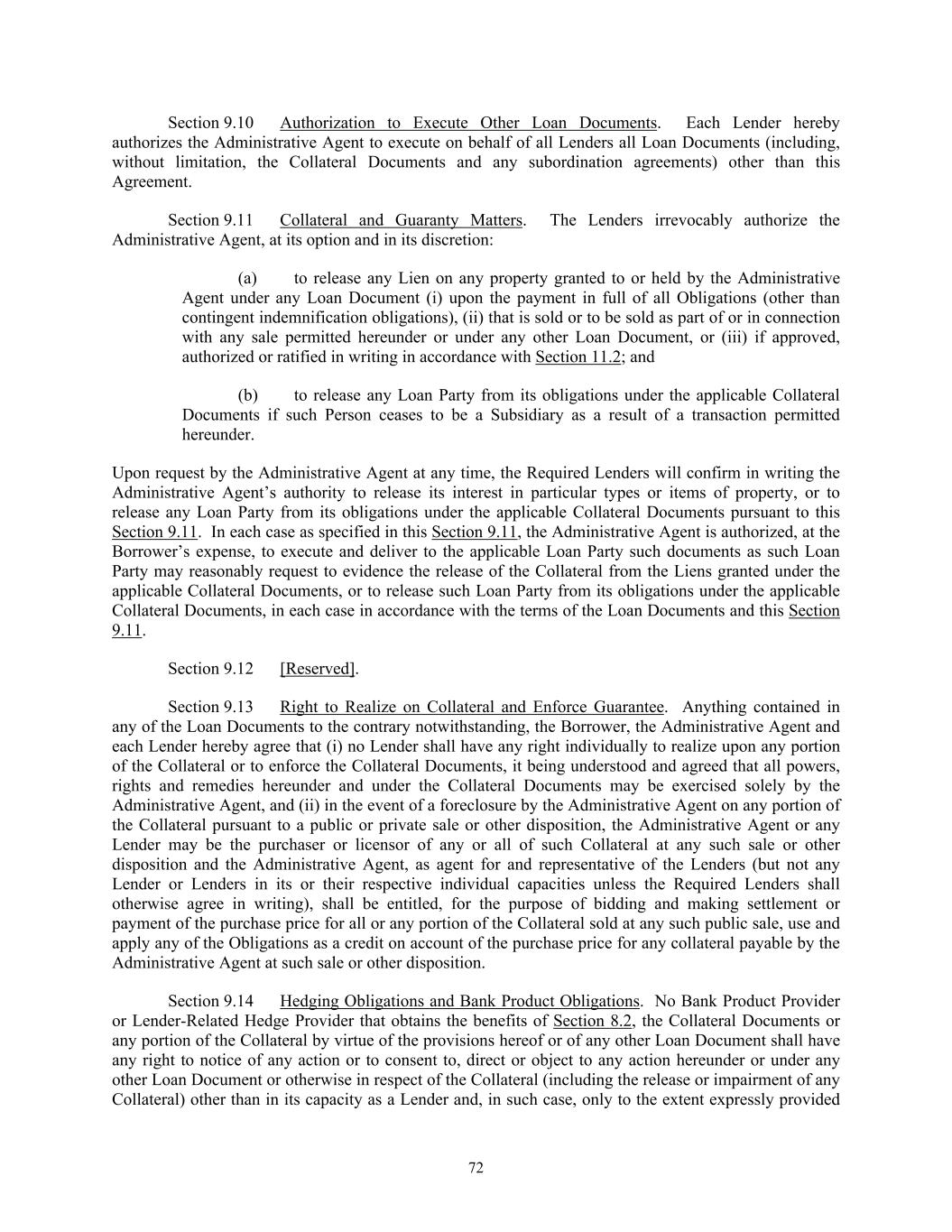
72 Section 9.10 Authorization to Execute Other Loan Documents. Each Lender hereby authorizes the Administrative Agent to execute on behalf of all Lenders all Loan Documents (including, without limitation, the Collateral Documents and any subordination agreements) other than this Agreement. Section 9.11 Collateral and Guaranty Matters. The Lenders irrevocably authorize the Administrative Agent, at its option and in its discretion: (a) to release any Lien on any property granted to or held by the Administrative Agent under any Loan Document (i) upon the payment in full of all Obligations (other than contingent indemnification obligations), (ii) that is sold or to be sold as part of or in connection with any sale permitted hereunder or under any other Loan Document, or (iii) if approved, authorized or ratified in writing in accordance with Section 11.2; and (b) to release any Loan Party from its obligations under the applicable Collateral Documents if such Person ceases to be a Subsidiary as a result of a transaction permitted hereunder. Upon request by the Administrative Agent at any time, the Required Lenders will confirm in writing the Administrative Agent’s authority to release its interest in particular types or items of property, or to release any Loan Party from its obligations under the applicable Collateral Documents pursuant to this Section 9.11. In each case as specified in this Section 9.11, the Administrative Agent is authorized, at the Borrower’s expense, to execute and deliver to the applicable Loan Party such documents as such Loan Party may reasonably request to evidence the release of the Collateral from the Liens granted under the applicable Collateral Documents, or to release such Loan Party from its obligations under the applicable Collateral Documents, in each case in accordance with the terms of the Loan Documents and this Section 9.11. Section 9.12 [Reserved]. Section 9.13 Right to Realize on Collateral and Enforce Guarantee. Anything contained in any of the Loan Documents to the contrary notwithstanding, the Borrower, the Administrative Agent and each Lender hereby agree that (i) no Lender shall have any right individually to realize upon any portion of the Collateral or to enforce the Collateral Documents, it being understood and agreed that all powers, rights and remedies hereunder and under the Collateral Documents may be exercised solely by the Administrative Agent, and (ii) in the event of a foreclosure by the Administrative Agent on any portion of the Collateral pursuant to a public or private sale or other disposition, the Administrative Agent or any Lender may be the purchaser or licensor of any or all of such Collateral at any such sale or other disposition and the Administrative Agent, as agent for and representative of the Lenders (but not any Lender or Lenders in its or their respective individual capacities unless the Required Lenders shall otherwise agree in writing), shall be entitled, for the purpose of bidding and making settlement or payment of the purchase price for all or any portion of the Collateral sold at any such public sale, use and apply any of the Obligations as a credit on account of the purchase price for any collateral payable by the Administrative Agent at such sale or other disposition. Section 9.14 Hedging Obligations and Bank Product Obligations. No Bank Product Provider or Lender-Related Hedge Provider that obtains the benefits of Section 8.2, the Collateral Documents or any portion of the Collateral by virtue of the provisions hereof or of any other Loan Document shall have any right to notice of any action or to consent to, direct or object to any action hereunder or under any other Loan Document or otherwise in respect of the Collateral (including the release or impairment of any Collateral) other than in its capacity as a Lender and, in such case, only to the extent expressly provided
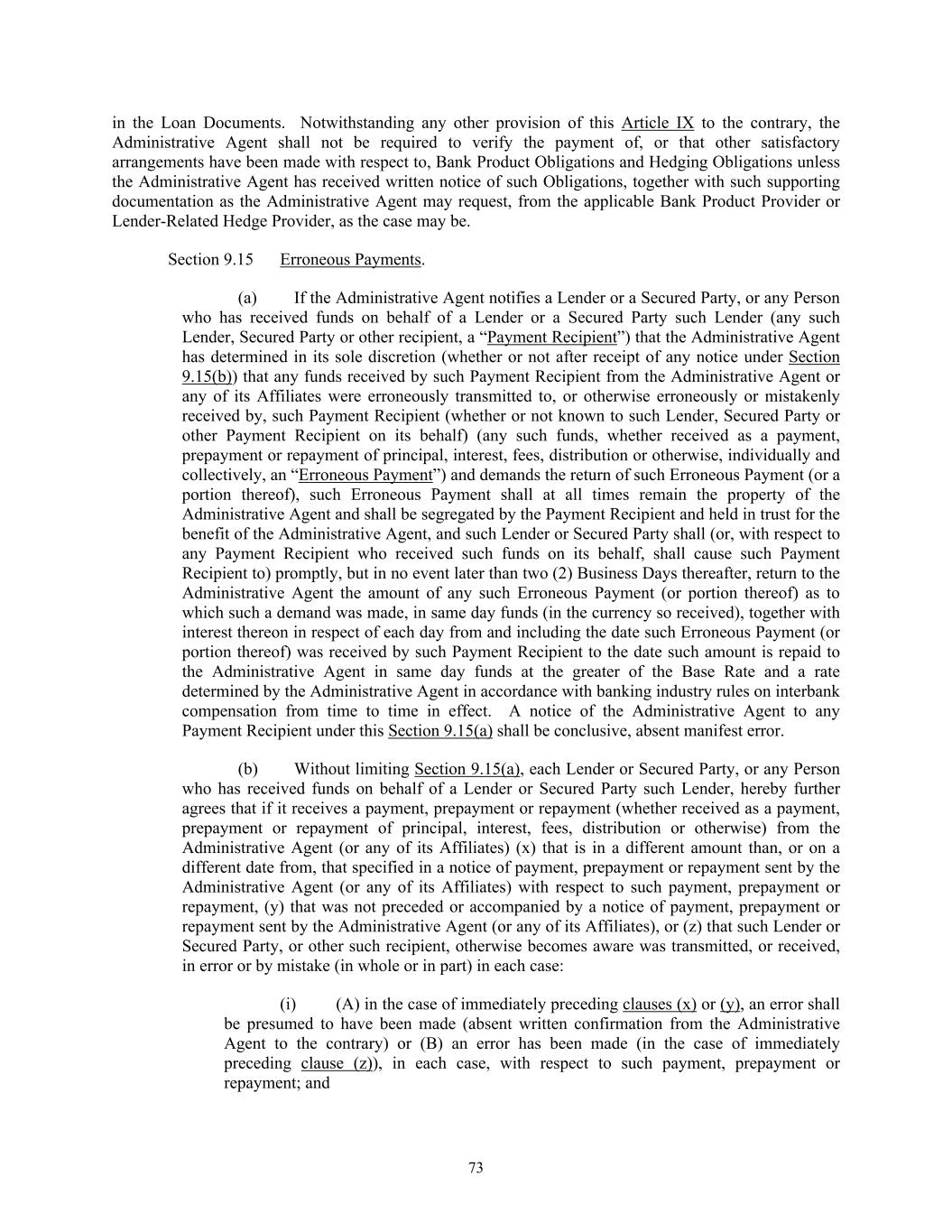
73 in the Loan Documents. Notwithstanding any other provision of this Article IX to the contrary, the Administrative Agent shall not be required to verify the payment of, or that other satisfactory arrangements have been made with respect to, Bank Product Obligations and Hedging Obligations unless the Administrative Agent has received written notice of such Obligations, together with such supporting documentation as the Administrative Agent may request, from the applicable Bank Product Provider or Lender-Related Hedge Provider, as the case may be. Section 9.15 Erroneous Payments. (a) If the Administrative Agent notifies a Lender or a Secured Party, or any Person who has received funds on behalf of a Lender or a Secured Party such Lender (any such Lender, Secured Party or other recipient, a “Payment Recipient”) that the Administrative Agent has determined in its sole discretion (whether or not after receipt of any notice under Section 9.15(b)) that any funds received by such Payment Recipient from the Administrative Agent or any of its Affiliates were erroneously transmitted to, or otherwise erroneously or mistakenly received by, such Payment Recipient (whether or not known to such Lender, Secured Party or other Payment Recipient on its behalf) (any such funds, whether received as a payment, prepayment or repayment of principal, interest, fees, distribution or otherwise, individually and collectively, an “Erroneous Payment”) and demands the return of such Erroneous Payment (or a portion thereof), such Erroneous Payment shall at all times remain the property of the Administrative Agent and shall be segregated by the Payment Recipient and held in trust for the benefit of the Administrative Agent, and such Lender or Secured Party shall (or, with respect to any Payment Recipient who received such funds on its behalf, shall cause such Payment Recipient to) promptly, but in no event later than two (2) Business Days thereafter, return to the Administrative Agent the amount of any such Erroneous Payment (or portion thereof) as to which such a demand was made, in same day funds (in the currency so received), together with interest thereon in respect of each day from and including the date such Erroneous Payment (or portion thereof) was received by such Payment Recipient to the date such amount is repaid to the Administrative Agent in same day funds at the greater of the Base Rate and a rate determined by the Administrative Agent in accordance with banking industry rules on interbank compensation from time to time in effect. A notice of the Administrative Agent to any Payment Recipient under this Section 9.15(a) shall be conclusive, absent manifest error. (b) Without limiting Section 9.15(a), each Lender or Secured Party, or any Person who has received funds on behalf of a Lender or Secured Party such Lender, hereby further agrees that if it receives a payment, prepayment or repayment (whether received as a payment, prepayment or repayment of principal, interest, fees, distribution or otherwise) from the Administrative Agent (or any of its Affiliates) (x) that is in a different amount than, or on a different date from, that specified in a notice of payment, prepayment or repayment sent by the Administrative Agent (or any of its Affiliates) with respect to such payment, prepayment or repayment, (y) that was not preceded or accompanied by a notice of payment, prepayment or repayment sent by the Administrative Agent (or any of its Affiliates), or (z) that such Lender or Secured Party, or other such recipient, otherwise becomes aware was transmitted, or received, in error or by mistake (in whole or in part) in each case: (i) (A) in the case of immediately preceding clauses (x) or (y), an error shall be presumed to have been made (absent written confirmation from the Administrative Agent to the contrary) or (B) an error has been made (in the case of immediately preceding clause (z)), in each case, with respect to such payment, prepayment or repayment; and
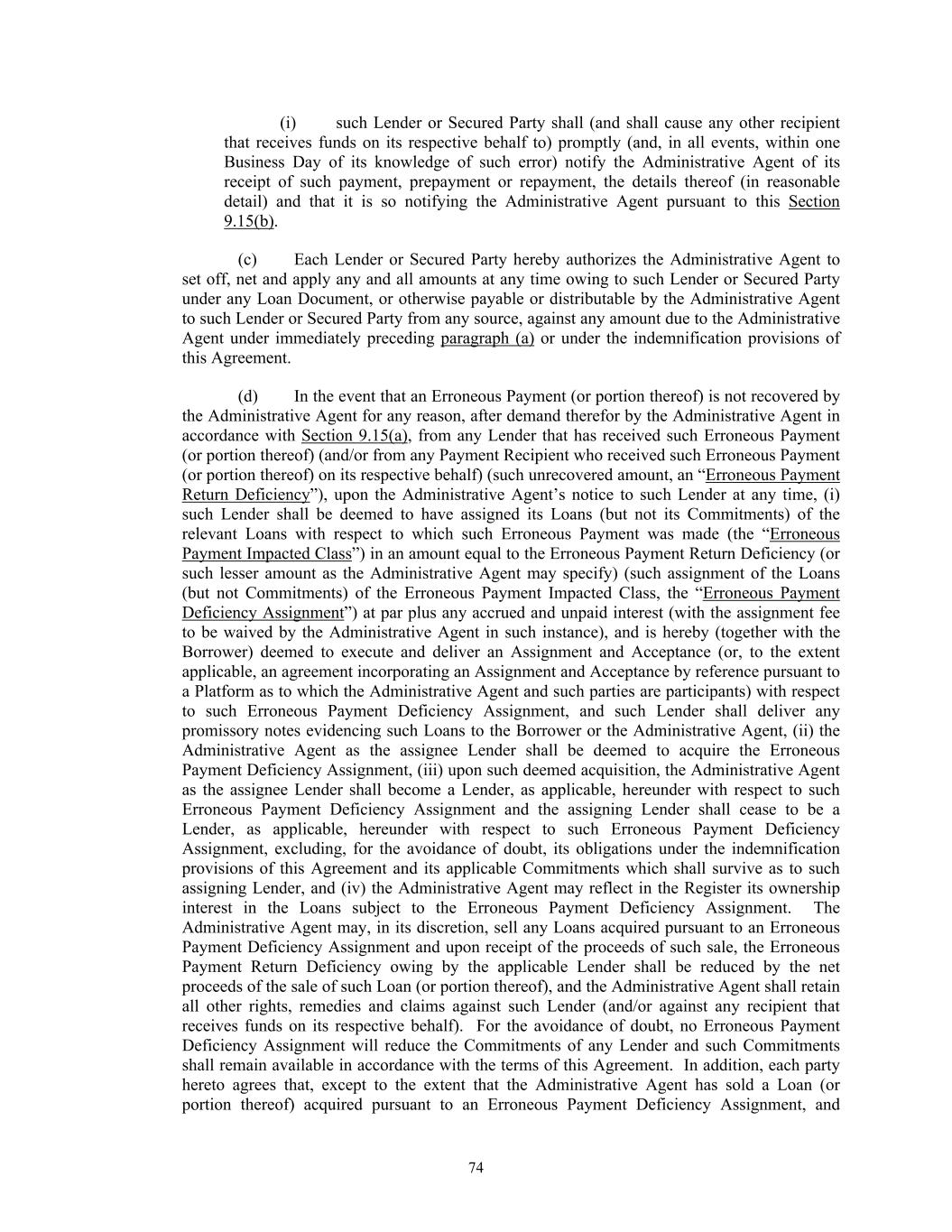
74 (i) such Lender or Secured Party shall (and shall cause any other recipient that receives funds on its respective behalf to) promptly (and, in all events, within one Business Day of its knowledge of such error) notify the Administrative Agent of its receipt of such payment, prepayment or repayment, the details thereof (in reasonable detail) and that it is so notifying the Administrative Agent pursuant to this Section 9.15(b). (c) Each Lender or Secured Party hereby authorizes the Administrative Agent to set off, net and apply any and all amounts at any time owing to such Lender or Secured Party under any Loan Document, or otherwise payable or distributable by the Administrative Agent to such Lender or Secured Party from any source, against any amount due to the Administrative Agent under immediately preceding paragraph (a) or under the indemnification provisions of this Agreement. (d) In the event that an Erroneous Payment (or portion thereof) is not recovered by the Administrative Agent for any reason, after demand therefor by the Administrative Agent in accordance with Section 9.15(a), from any Lender that has received such Erroneous Payment (or portion thereof) (and/or from any Payment Recipient who received such Erroneous Payment (or portion thereof) on its respective behalf) (such unrecovered amount, an “Erroneous Payment Return Deficiency”), upon the Administrative Agent’s notice to such Lender at any time, (i) such Lender shall be deemed to have assigned its Loans (but not its Commitments) of the relevant Loans with respect to which such Erroneous Payment was made (the “Erroneous Payment Impacted Class”) in an amount equal to the Erroneous Payment Return Deficiency (or such lesser amount as the Administrative Agent may specify) (such assignment of the Loans (but not Commitments) of the Erroneous Payment Impacted Class, the “Erroneous Payment Deficiency Assignment”) at par plus any accrued and unpaid interest (with the assignment fee to be waived by the Administrative Agent in such instance), and is hereby (together with the Borrower) deemed to execute and deliver an Assignment and Acceptance (or, to the extent applicable, an agreement incorporating an Assignment and Acceptance by reference pursuant to a Platform as to which the Administrative Agent and such parties are participants) with respect to such Erroneous Payment Deficiency Assignment, and such Lender shall deliver any promissory notes evidencing such Loans to the Borrower or the Administrative Agent, (ii) the Administrative Agent as the assignee Lender shall be deemed to acquire the Erroneous Payment Deficiency Assignment, (iii) upon such deemed acquisition, the Administrative Agent as the assignee Lender shall become a Lender, as applicable, hereunder with respect to such Erroneous Payment Deficiency Assignment and the assigning Lender shall cease to be a Lender, as applicable, hereunder with respect to such Erroneous Payment Deficiency Assignment, excluding, for the avoidance of doubt, its obligations under the indemnification provisions of this Agreement and its applicable Commitments which shall survive as to such assigning Lender, and (iv) the Administrative Agent may reflect in the Register its ownership interest in the Loans subject to the Erroneous Payment Deficiency Assignment. The Administrative Agent may, in its discretion, sell any Loans acquired pursuant to an Erroneous Payment Deficiency Assignment and upon receipt of the proceeds of such sale, the Erroneous Payment Return Deficiency owing by the applicable Lender shall be reduced by the net proceeds of the sale of such Loan (or portion thereof), and the Administrative Agent shall retain all other rights, remedies and claims against such Lender (and/or against any recipient that receives funds on its respective behalf). For the avoidance of doubt, no Erroneous Payment Deficiency Assignment will reduce the Commitments of any Lender and such Commitments shall remain available in accordance with the terms of this Agreement. In addition, each party hereto agrees that, except to the extent that the Administrative Agent has sold a Loan (or portion thereof) acquired pursuant to an Erroneous Payment Deficiency Assignment, and
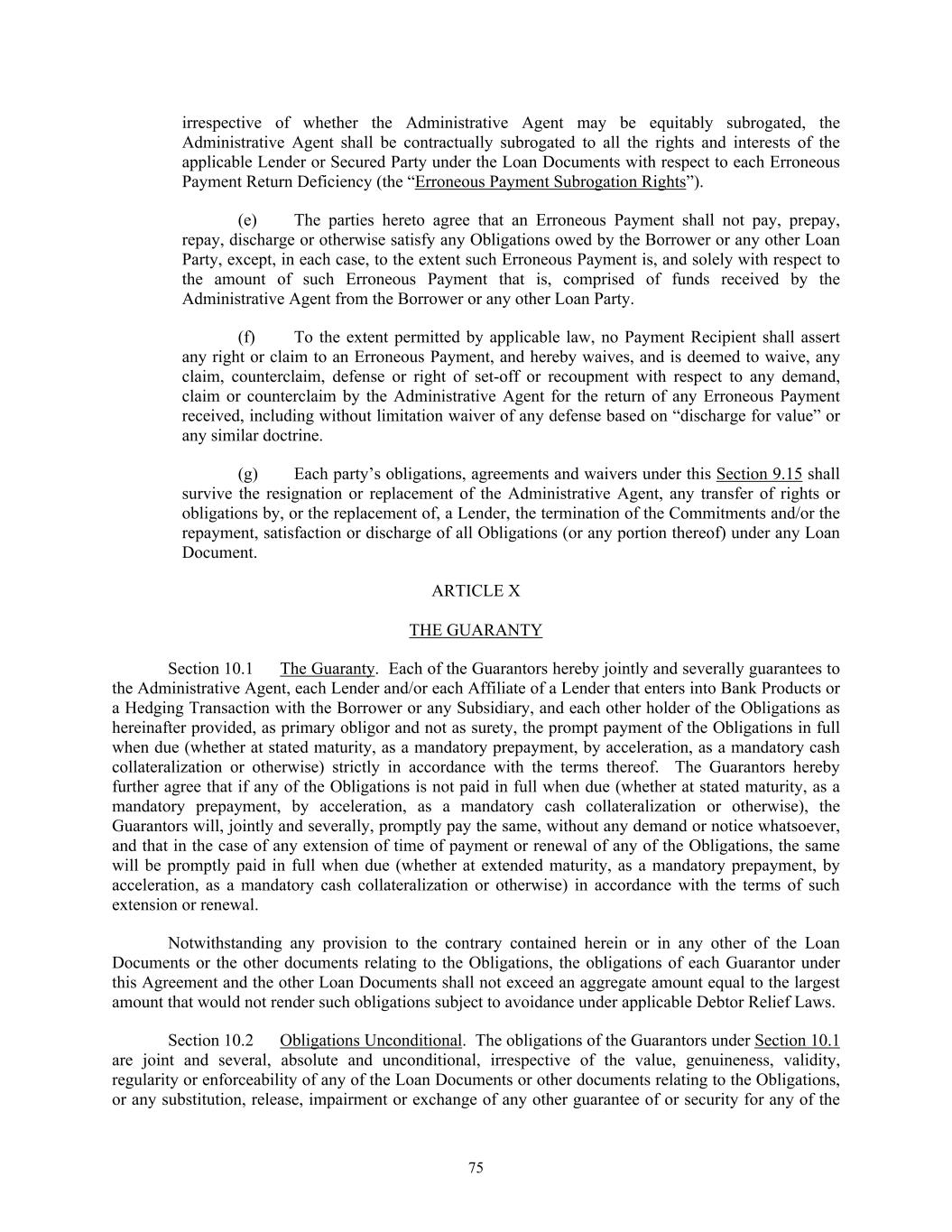
75 irrespective of whether the Administrative Agent may be equitably subrogated, the Administrative Agent shall be contractually subrogated to all the rights and interests of the applicable Lender or Secured Party under the Loan Documents with respect to each Erroneous Payment Return Deficiency (the “Erroneous Payment Subrogation Rights”). (e) The parties hereto agree that an Erroneous Payment shall not pay, prepay, repay, discharge or otherwise satisfy any Obligations owed by the Borrower or any other Loan Party, except, in each case, to the extent such Erroneous Payment is, and solely with respect to the amount of such Erroneous Payment that is, comprised of funds received by the Administrative Agent from the Borrower or any other Loan Party. (f) To the extent permitted by applicable law, no Payment Recipient shall assert any right or claim to an Erroneous Payment, and hereby waives, and is deemed to waive, any claim, counterclaim, defense or right of set-off or recoupment with respect to any demand, claim or counterclaim by the Administrative Agent for the return of any Erroneous Payment received, including without limitation waiver of any defense based on “discharge for value” or any similar doctrine. (g) Each party’s obligations, agreements and waivers under this Section 9.15 shall survive the resignation or replacement of the Administrative Agent, any transfer of rights or obligations by, or the replacement of, a Lender, the termination of the Commitments and/or the repayment, satisfaction or discharge of all Obligations (or any portion thereof) under any Loan Document. ARTICLE X THE GUARANTY Section 10.1 The Guaranty. Each of the Guarantors hereby jointly and severally guarantees to the Administrative Agent, each Lender and/or each Affiliate of a Lender that enters into Bank Products or a Hedging Transaction with the Borrower or any Subsidiary, and each other holder of the Obligations as hereinafter provided, as primary obligor and not as surety, the prompt payment of the Obligations in full when due (whether at stated maturity, as a mandatory prepayment, by acceleration, as a mandatory cash collateralization or otherwise) strictly in accordance with the terms thereof. The Guarantors hereby further agree that if any of the Obligations is not paid in full when due (whether at stated maturity, as a mandatory prepayment, by acceleration, as a mandatory cash collateralization or otherwise), the Guarantors will, jointly and severally, promptly pay the same, without any demand or notice whatsoever, and that in the case of any extension of time of payment or renewal of any of the Obligations, the same will be promptly paid in full when due (whether at extended maturity, as a mandatory prepayment, by acceleration, as a mandatory cash collateralization or otherwise) in accordance with the terms of such extension or renewal. Notwithstanding any provision to the contrary contained herein or in any other of the Loan Documents or the other documents relating to the Obligations, the obligations of each Guarantor under this Agreement and the other Loan Documents shall not exceed an aggregate amount equal to the largest amount that would not render such obligations subject to avoidance under applicable Debtor Relief Laws. Section 10.2 Obligations Unconditional. The obligations of the Guarantors under Section 10.1 are joint and several, absolute and unconditional, irrespective of the value, genuineness, validity, regularity or enforceability of any of the Loan Documents or other documents relating to the Obligations, or any substitution, release, impairment or exchange of any other guarantee of or security for any of the
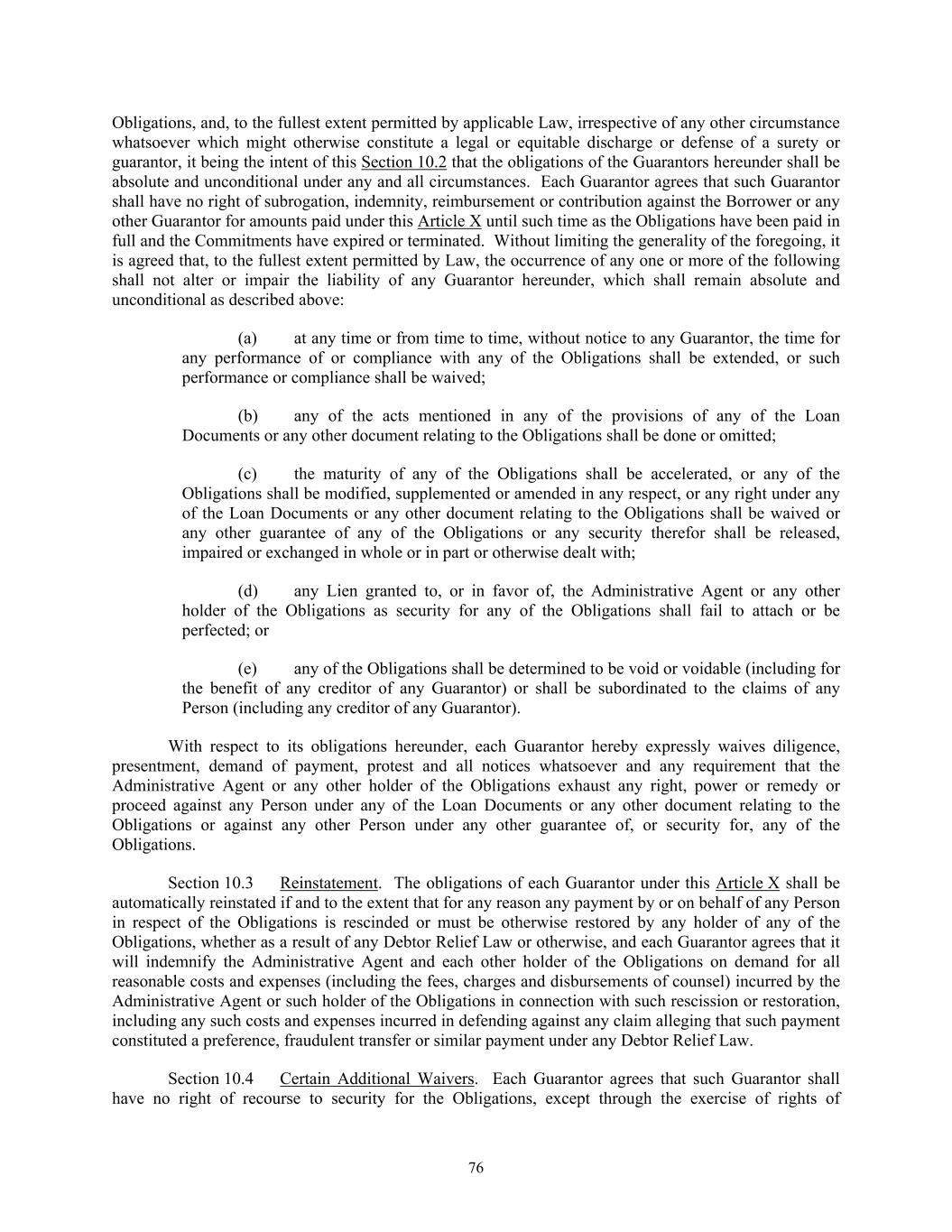
76 Obligations, and, to the fullest extent permitted by applicable Law, irrespective of any other circumstance whatsoever which might otherwise constitute a legal or equitable discharge or defense of a surety or guarantor, it being the intent of this Section 10.2 that the obligations of the Guarantors hereunder shall be absolute and unconditional under any and all circumstances. Each Guarantor agrees that such Guarantor shall have no right of subrogation, indemnity, reimbursement or contribution against the Borrower or any other Guarantor for amounts paid under this Article X until such time as the Obligations have been paid in full and the Commitments have expired or terminated. Without limiting the generality of the foregoing, it is agreed that, to the fullest extent permitted by Law, the occurrence of any one or more of the following shall not alter or impair the liability of any Guarantor hereunder, which shall remain absolute and unconditional as described above: (a) at any time or from time to time, without notice to any Guarantor, the time for any performance of or compliance with any of the Obligations shall be extended, or such performance or compliance shall be waived; (b) any of the acts mentioned in any of the provisions of any of the Loan Documents or any other document relating to the Obligations shall be done or omitted; (c) the maturity of any of the Obligations shall be accelerated, or any of the Obligations shall be modified, supplemented or amended in any respect, or any right under any of the Loan Documents or any other document relating to the Obligations shall be waived or any other guarantee of any of the Obligations or any security therefor shall be released, impaired or exchanged in whole or in part or otherwise dealt with; (d) any Lien granted to, or in favor of, the Administrative Agent or any other holder of the Obligations as security for any of the Obligations shall fail to attach or be perfected; or (e) any of the Obligations shall be determined to be void or voidable (including for the benefit of any creditor of any Guarantor) or shall be subordinated to the claims of any Person (including any creditor of any Guarantor). With respect to its obligations hereunder, each Guarantor hereby expressly waives diligence, presentment, demand of payment, protest and all notices whatsoever and any requirement that the Administrative Agent or any other holder of the Obligations exhaust any right, power or remedy or proceed against any Person under any of the Loan Documents or any other document relating to the Obligations or against any other Person under any other guarantee of, or security for, any of the Obligations. Section 10.3 Reinstatement. The obligations of each Guarantor under this Article X shall be automatically reinstated if and to the extent that for any reason any payment by or on behalf of any Person in respect of the Obligations is rescinded or must be otherwise restored by any holder of any of the Obligations, whether as a result of any Debtor Relief Law or otherwise, and each Guarantor agrees that it will indemnify the Administrative Agent and each other holder of the Obligations on demand for all reasonable costs and expenses (including the fees, charges and disbursements of counsel) incurred by the Administrative Agent or such holder of the Obligations in connection with such rescission or restoration, including any such costs and expenses incurred in defending against any claim alleging that such payment constituted a preference, fraudulent transfer or similar payment under any Debtor Relief Law. Section 10.4 Certain Additional Waivers. Each Guarantor agrees that such Guarantor shall have no right of recourse to security for the Obligations, except through the exercise of rights of
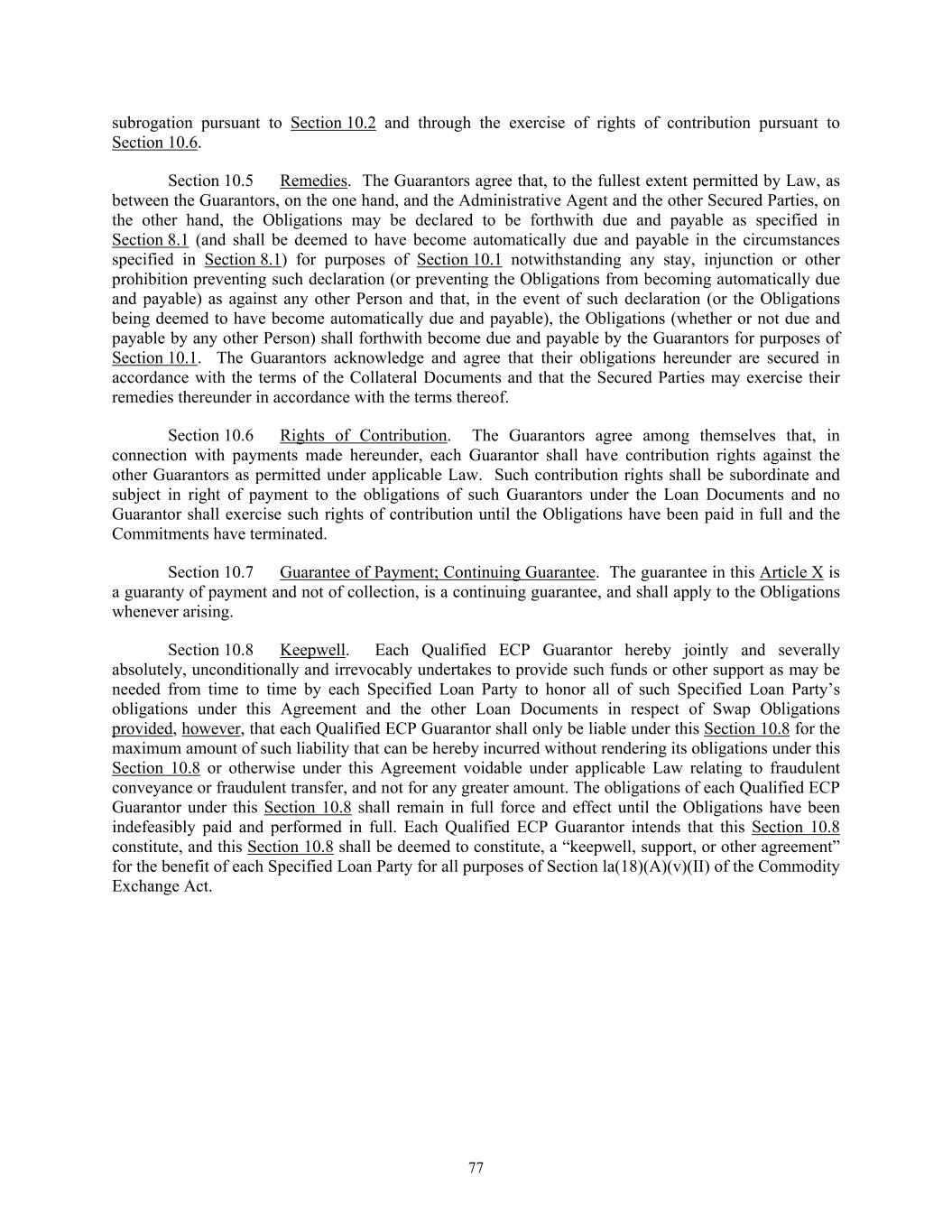
77 subrogation pursuant to Section 10.2 and through the exercise of rights of contribution pursuant to Section 10.6. Section 10.5 Remedies. The Guarantors agree that, to the fullest extent permitted by Law, as between the Guarantors, on the one hand, and the Administrative Agent and the other Secured Parties, on the other hand, the Obligations may be declared to be forthwith due and payable as specified in Section 8.1 (and shall be deemed to have become automatically due and payable in the circumstances specified in Section 8.1) for purposes of Section 10.1 notwithstanding any stay, injunction or other prohibition preventing such declaration (or preventing the Obligations from becoming automatically due and payable) as against any other Person and that, in the event of such declaration (or the Obligations being deemed to have become automatically due and payable), the Obligations (whether or not due and payable by any other Person) shall forthwith become due and payable by the Guarantors for purposes of Section 10.1. The Guarantors acknowledge and agree that their obligations hereunder are secured in accordance with the terms of the Collateral Documents and that the Secured Parties may exercise their remedies thereunder in accordance with the terms thereof. Section 10.6 Rights of Contribution. The Guarantors agree among themselves that, in connection with payments made hereunder, each Guarantor shall have contribution rights against the other Guarantors as permitted under applicable Law. Such contribution rights shall be subordinate and subject in right of payment to the obligations of such Guarantors under the Loan Documents and no Guarantor shall exercise such rights of contribution until the Obligations have been paid in full and the Commitments have terminated. Section 10.7 Guarantee of Payment; Continuing Guarantee. The guarantee in this Article X is a guaranty of payment and not of collection, is a continuing guarantee, and shall apply to the Obligations whenever arising. Section 10.8 Keepwell. Each Qualified ECP Guarantor hereby jointly and severally absolutely, unconditionally and irrevocably undertakes to provide such funds or other support as may be needed from time to time by each Specified Loan Party to honor all of such Specified Loan Party’s obligations under this Agreement and the other Loan Documents in respect of Swap Obligations provided, however, that each Qualified ECP Guarantor shall only be liable under this Section 10.8 for the maximum amount of such liability that can be hereby incurred without rendering its obligations under this Section 10.8 or otherwise under this Agreement voidable under applicable Law relating to fraudulent conveyance or fraudulent transfer, and not for any greater amount. The obligations of each Qualified ECP Guarantor under this Section 10.8 shall remain in full force and effect until the Obligations have been indefeasibly paid and performed in full. Each Qualified ECP Guarantor intends that this Section 10.8 constitute, and this Section 10.8 shall be deemed to constitute, a “keepwell, support, or other agreement” for the benefit of each Specified Loan Party for all purposes of Section la(18)(A)(v)(II) of the Commodity Exchange Act.
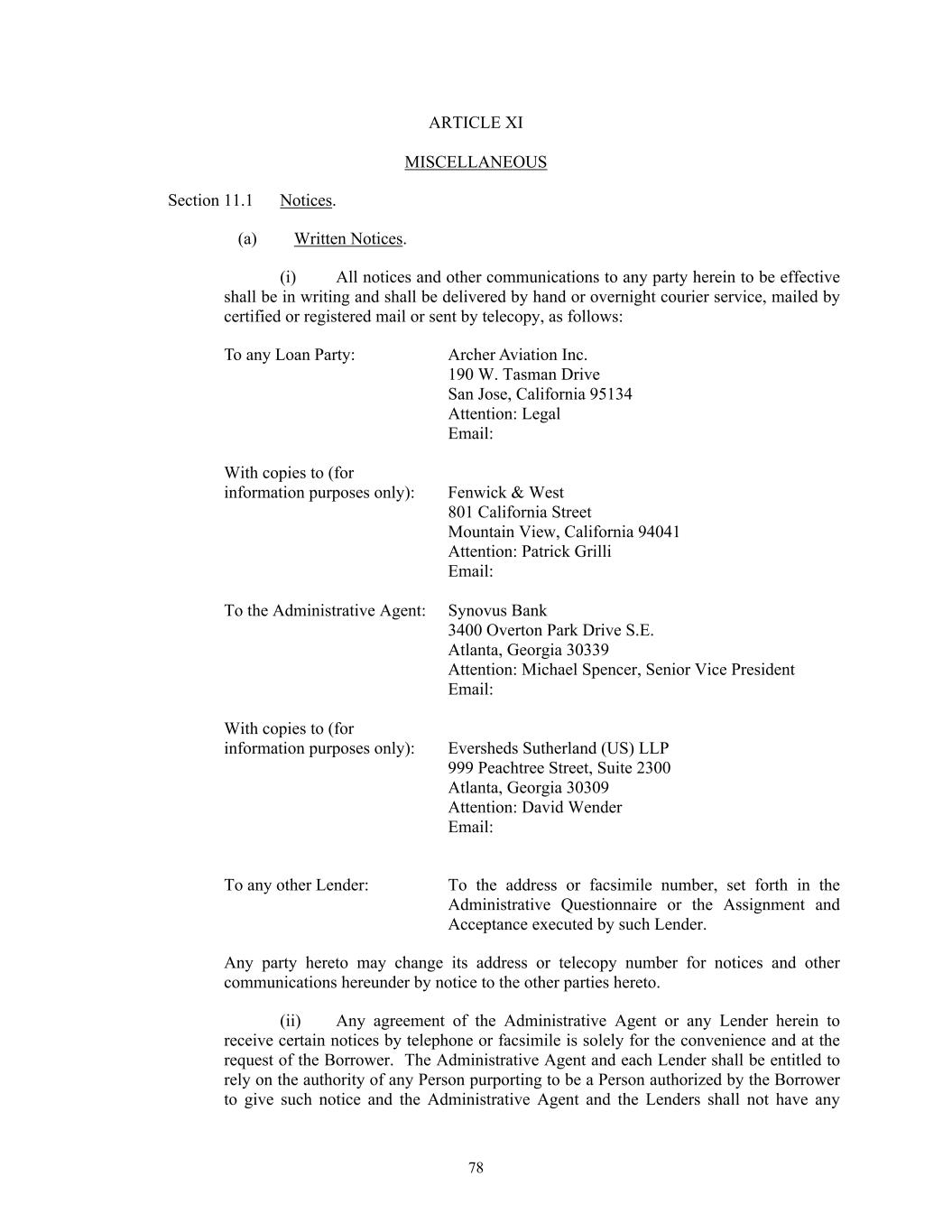
78 ARTICLE XI MISCELLANEOUS Section 11.1 Notices. (a) Written Notices. (i) All notices and other communications to any party herein to be effective shall be in writing and shall be delivered by hand or overnight courier service, mailed by certified or registered mail or sent by telecopy, as follows: To any Loan Party: Archer Aviation Inc. 190 W. Tasman Drive San Jose, California 95134 Attention: Legal Email: With copies to (for information purposes only): Fenwick & West 801 California Street Mountain View, California 94041 Attention: Patrick Grilli Email: To the Administrative Agent: Synovus Bank 3400 Overton Park Drive S.E. Atlanta, Georgia 30339 Attention: Michael Spencer, Senior Vice President Email: With copies to (for information purposes only): Eversheds Sutherland (US) LLP 999 Peachtree Street, Suite 2300 Atlanta, Georgia 30309 Attention: David Wender Email: To any other Lender: To the address or facsimile number, set forth in the Administrative Questionnaire or the Assignment and Acceptance executed by such Lender. Any party hereto may change its address or telecopy number for notices and other communications hereunder by notice to the other parties hereto. (ii) Any agreement of the Administrative Agent or any Lender herein to receive certain notices by telephone or facsimile is solely for the convenience and at the request of the Borrower. The Administrative Agent and each Lender shall be entitled to rely on the authority of any Person purporting to be a Person authorized by the Borrower to give such notice and the Administrative Agent and the Lenders shall not have any
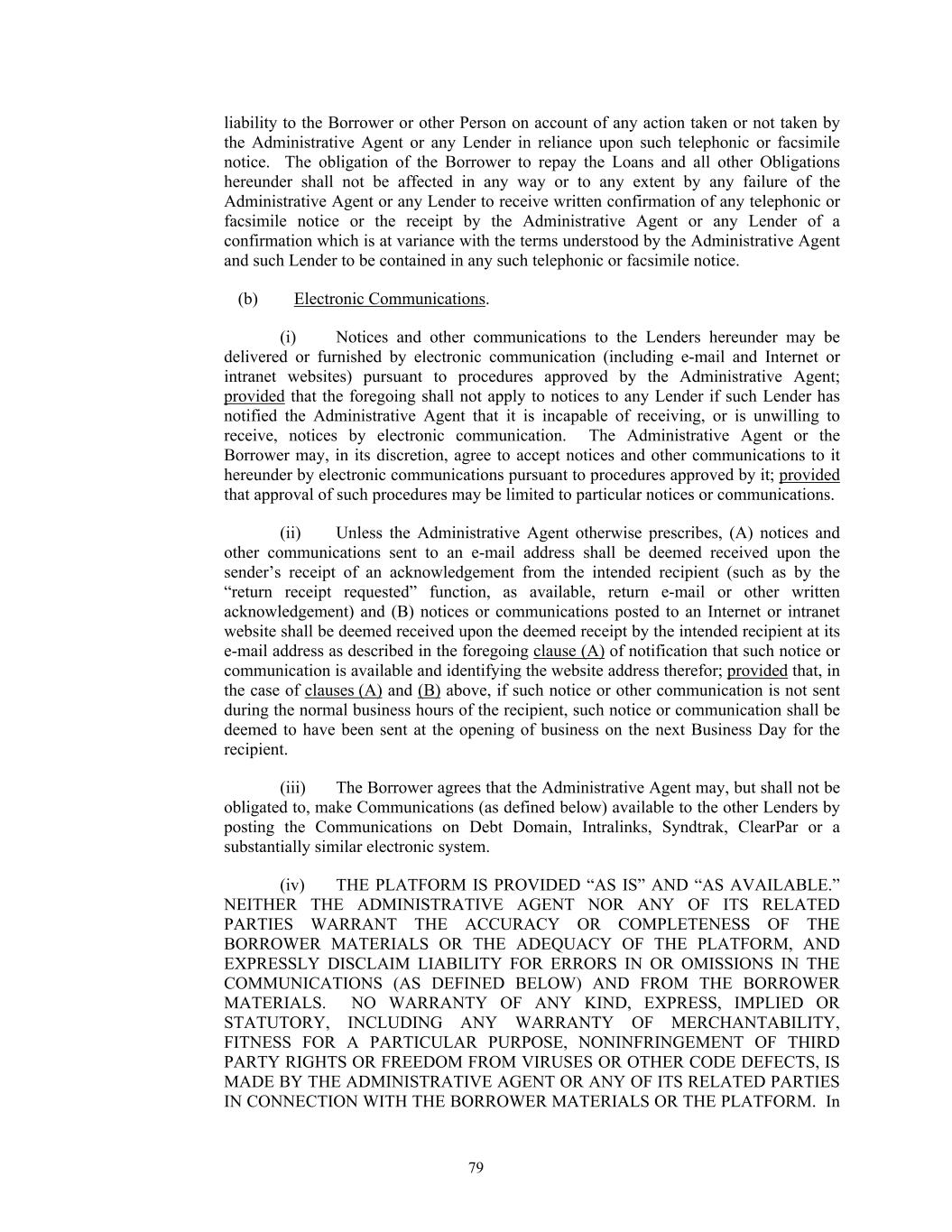
79 liability to the Borrower or other Person on account of any action taken or not taken by the Administrative Agent or any Lender in reliance upon such telephonic or facsimile notice. The obligation of the Borrower to repay the Loans and all other Obligations hereunder shall not be affected in any way or to any extent by any failure of the Administrative Agent or any Lender to receive written confirmation of any telephonic or facsimile notice or the receipt by the Administrative Agent or any Lender of a confirmation which is at variance with the terms understood by the Administrative Agent and such Lender to be contained in any such telephonic or facsimile notice. (b) Electronic Communications. (i) Notices and other communications to the Lenders hereunder may be delivered or furnished by electronic communication (including e-mail and Internet or intranet websites) pursuant to procedures approved by the Administrative Agent; provided that the foregoing shall not apply to notices to any Lender if such Lender has notified the Administrative Agent that it is incapable of receiving, or is unwilling to receive, notices by electronic communication. The Administrative Agent or the Borrower may, in its discretion, agree to accept notices and other communications to it hereunder by electronic communications pursuant to procedures approved by it; provided that approval of such procedures may be limited to particular notices or communications. (ii) Unless the Administrative Agent otherwise prescribes, (A) notices and other communications sent to an e-mail address shall be deemed received upon the sender’s receipt of an acknowledgement from the intended recipient (such as by the “return receipt requested” function, as available, return e-mail or other written acknowledgement) and (B) notices or communications posted to an Internet or intranet website shall be deemed received upon the deemed receipt by the intended recipient at its e-mail address as described in the foregoing clause (A) of notification that such notice or communication is available and identifying the website address therefor; provided that, in the case of clauses (A) and (B) above, if such notice or other communication is not sent during the normal business hours of the recipient, such notice or communication shall be deemed to have been sent at the opening of business on the next Business Day for the recipient. (iii) The Borrower agrees that the Administrative Agent may, but shall not be obligated to, make Communications (as defined below) available to the other Lenders by posting the Communications on Debt Domain, Intralinks, Syndtrak, ClearPar or a substantially similar electronic system. (iv) THE PLATFORM IS PROVIDED “AS IS” AND “AS AVAILABLE.” NEITHER THE ADMINISTRATIVE AGENT NOR ANY OF ITS RELATED PARTIES WARRANT THE ACCURACY OR COMPLETENESS OF THE BORROWER MATERIALS OR THE ADEQUACY OF THE PLATFORM, AND EXPRESSLY DISCLAIM LIABILITY FOR ERRORS IN OR OMISSIONS IN THE COMMUNICATIONS (AS DEFINED BELOW) AND FROM THE BORROWER MATERIALS. NO WARRANTY OF ANY KIND, EXPRESS, IMPLIED OR STATUTORY, INCLUDING ANY WARRANTY OF MERCHANTABILITY, FITNESS FOR A PARTICULAR PURPOSE, NONINFRINGEMENT OF THIRD PARTY RIGHTS OR FREEDOM FROM VIRUSES OR OTHER CODE DEFECTS, IS MADE BY THE ADMINISTRATIVE AGENT OR ANY OF ITS RELATED PARTIES IN CONNECTION WITH THE BORROWER MATERIALS OR THE PLATFORM. In
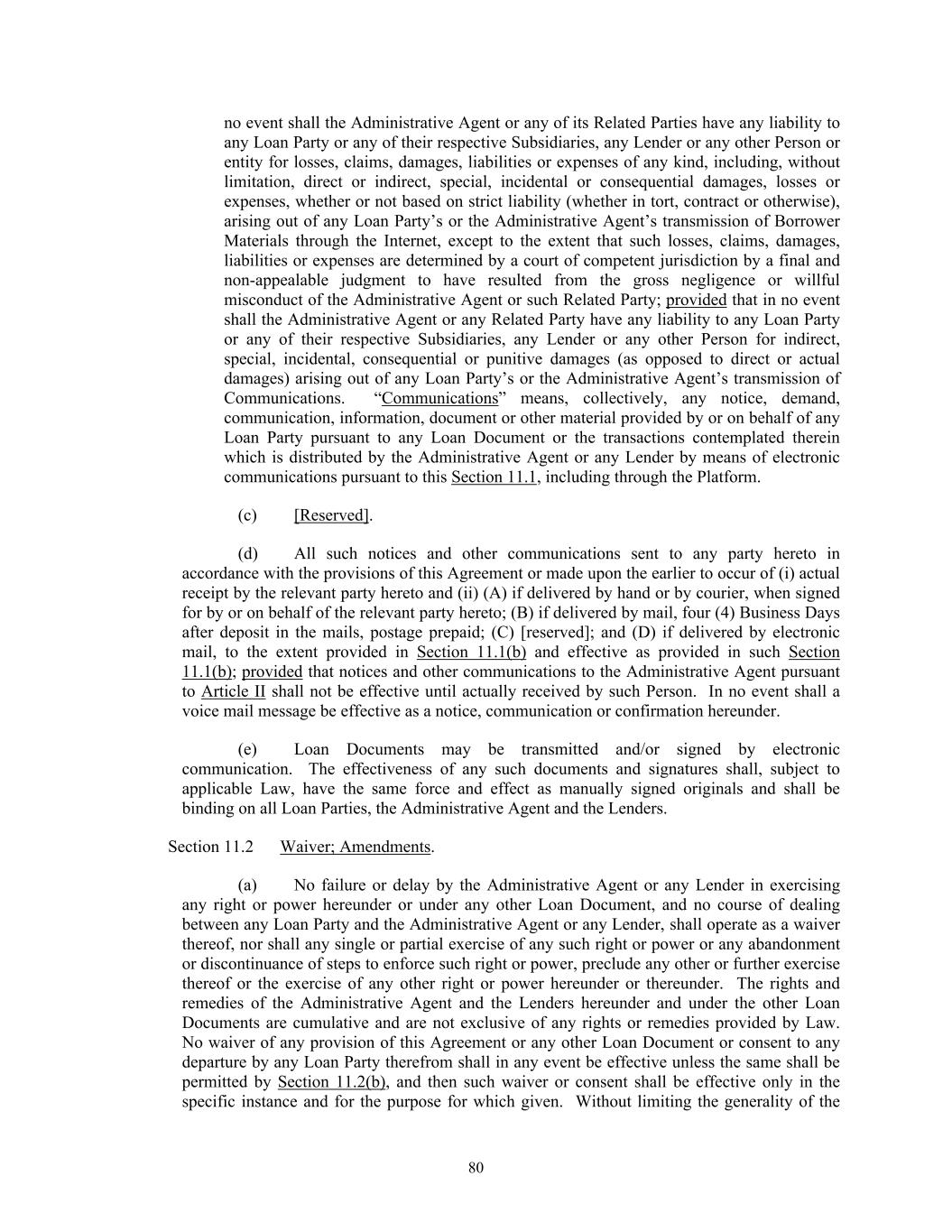
80 no event shall the Administrative Agent or any of its Related Parties have any liability to any Loan Party or any of their respective Subsidiaries, any Lender or any other Person or entity for losses, claims, damages, liabilities or expenses of any kind, including, without limitation, direct or indirect, special, incidental or consequential damages, losses or expenses, whether or not based on strict liability (whether in tort, contract or otherwise), arising out of any Loan Party’s or the Administrative Agent’s transmission of Borrower Materials through the Internet, except to the extent that such losses, claims, damages, liabilities or expenses are determined by a court of competent jurisdiction by a final and non-appealable judgment to have resulted from the gross negligence or willful misconduct of the Administrative Agent or such Related Party; provided that in no event shall the Administrative Agent or any Related Party have any liability to any Loan Party or any of their respective Subsidiaries, any Lender or any other Person for indirect, special, incidental, consequential or punitive damages (as opposed to direct or actual damages) arising out of any Loan Party’s or the Administrative Agent’s transmission of Communications. “Communications” means, collectively, any notice, demand, communication, information, document or other material provided by or on behalf of any Loan Party pursuant to any Loan Document or the transactions contemplated therein which is distributed by the Administrative Agent or any Lender by means of electronic communications pursuant to this Section 11.1, including through the Platform. (c) [Reserved]. (d) All such notices and other communications sent to any party hereto in accordance with the provisions of this Agreement or made upon the earlier to occur of (i) actual receipt by the relevant party hereto and (ii) (A) if delivered by hand or by courier, when signed for by or on behalf of the relevant party hereto; (B) if delivered by mail, four (4) Business Days after deposit in the mails, postage prepaid; (C) [reserved]; and (D) if delivered by electronic mail, to the extent provided in Section 11.1(b) and effective as provided in such Section 11.1(b); provided that notices and other communications to the Administrative Agent pursuant to Article II shall not be effective until actually received by such Person. In no event shall a voice mail message be effective as a notice, communication or confirmation hereunder. (e) Loan Documents may be transmitted and/or signed by electronic communication. The effectiveness of any such documents and signatures shall, subject to applicable Law, have the same force and effect as manually signed originals and shall be binding on all Loan Parties, the Administrative Agent and the Lenders. Section 11.2 Waiver; Amendments. (a) No failure or delay by the Administrative Agent or any Lender in exercising any right or power hereunder or under any other Loan Document, and no course of dealing between any Loan Party and the Administrative Agent or any Lender, shall operate as a waiver thereof, nor shall any single or partial exercise of any such right or power or any abandonment or discontinuance of steps to enforce such right or power, preclude any other or further exercise thereof or the exercise of any other right or power hereunder or thereunder. The rights and remedies of the Administrative Agent and the Lenders hereunder and under the other Loan Documents are cumulative and are not exclusive of any rights or remedies provided by Law. No waiver of any provision of this Agreement or any other Loan Document or consent to any departure by any Loan Party therefrom shall in any event be effective unless the same shall be permitted by Section 11.2(b), and then such waiver or consent shall be effective only in the specific instance and for the purpose for which given. Without limiting the generality of the
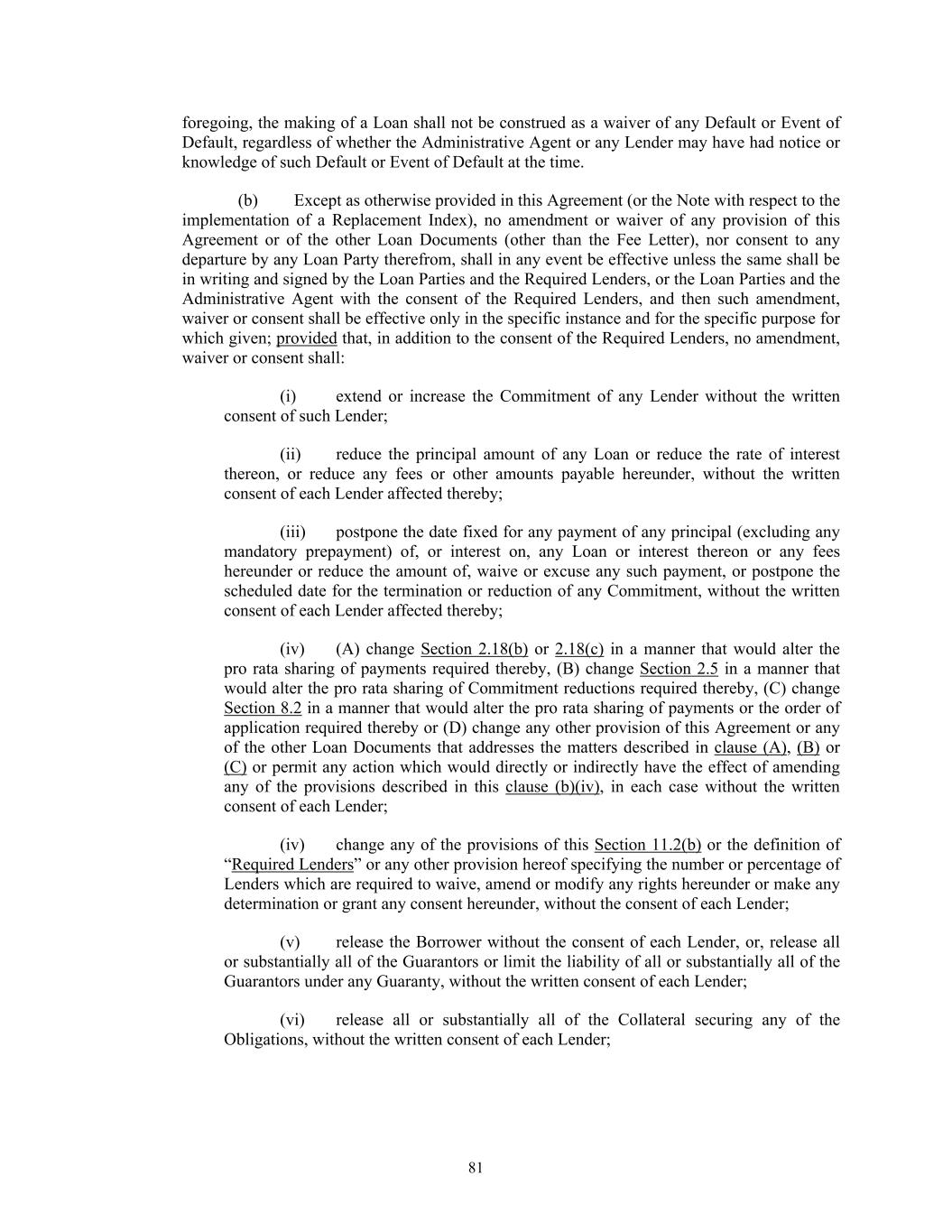
81 foregoing, the making of a Loan shall not be construed as a waiver of any Default or Event of Default, regardless of whether the Administrative Agent or any Lender may have had notice or knowledge of such Default or Event of Default at the time. (b) Except as otherwise provided in this Agreement (or the Note with respect to the implementation of a Replacement Index), no amendment or waiver of any provision of this Agreement or of the other Loan Documents (other than the Fee Letter), nor consent to any departure by any Loan Party therefrom, shall in any event be effective unless the same shall be in writing and signed by the Loan Parties and the Required Lenders, or the Loan Parties and the Administrative Agent with the consent of the Required Lenders, and then such amendment, waiver or consent shall be effective only in the specific instance and for the specific purpose for which given; provided that, in addition to the consent of the Required Lenders, no amendment, waiver or consent shall: (i) extend or increase the Commitment of any Lender without the written consent of such Lender; (ii) reduce the principal amount of any Loan or reduce the rate of interest thereon, or reduce any fees or other amounts payable hereunder, without the written consent of each Lender affected thereby; (iii) postpone the date fixed for any payment of any principal (excluding any mandatory prepayment) of, or interest on, any Loan or interest thereon or any fees hereunder or reduce the amount of, waive or excuse any such payment, or postpone the scheduled date for the termination or reduction of any Commitment, without the written consent of each Lender affected thereby; (iv) (A) change Section 2.18(b) or 2.18(c) in a manner that would alter the pro rata sharing of payments required thereby, (B) change Section 2.5 in a manner that would alter the pro rata sharing of Commitment reductions required thereby, (C) change Section 8.2 in a manner that would alter the pro rata sharing of payments or the order of application required thereby or (D) change any other provision of this Agreement or any of the other Loan Documents that addresses the matters described in clause (A), (B) or (C) or permit any action which would directly or indirectly have the effect of amending any of the provisions described in this clause (b)(iv), in each case without the written consent of each Lender; (iv) change any of the provisions of this Section 11.2(b) or the definition of “Required Lenders” or any other provision hereof specifying the number or percentage of Lenders which are required to waive, amend or modify any rights hereunder or make any determination or grant any consent hereunder, without the consent of each Lender; (v) release the Borrower without the consent of each Lender, or, release all or substantially all of the Guarantors or limit the liability of all or substantially all of the Guarantors under any Guaranty, without the written consent of each Lender; (vi) release all or substantially all of the Collateral securing any of the Obligations, without the written consent of each Lender;
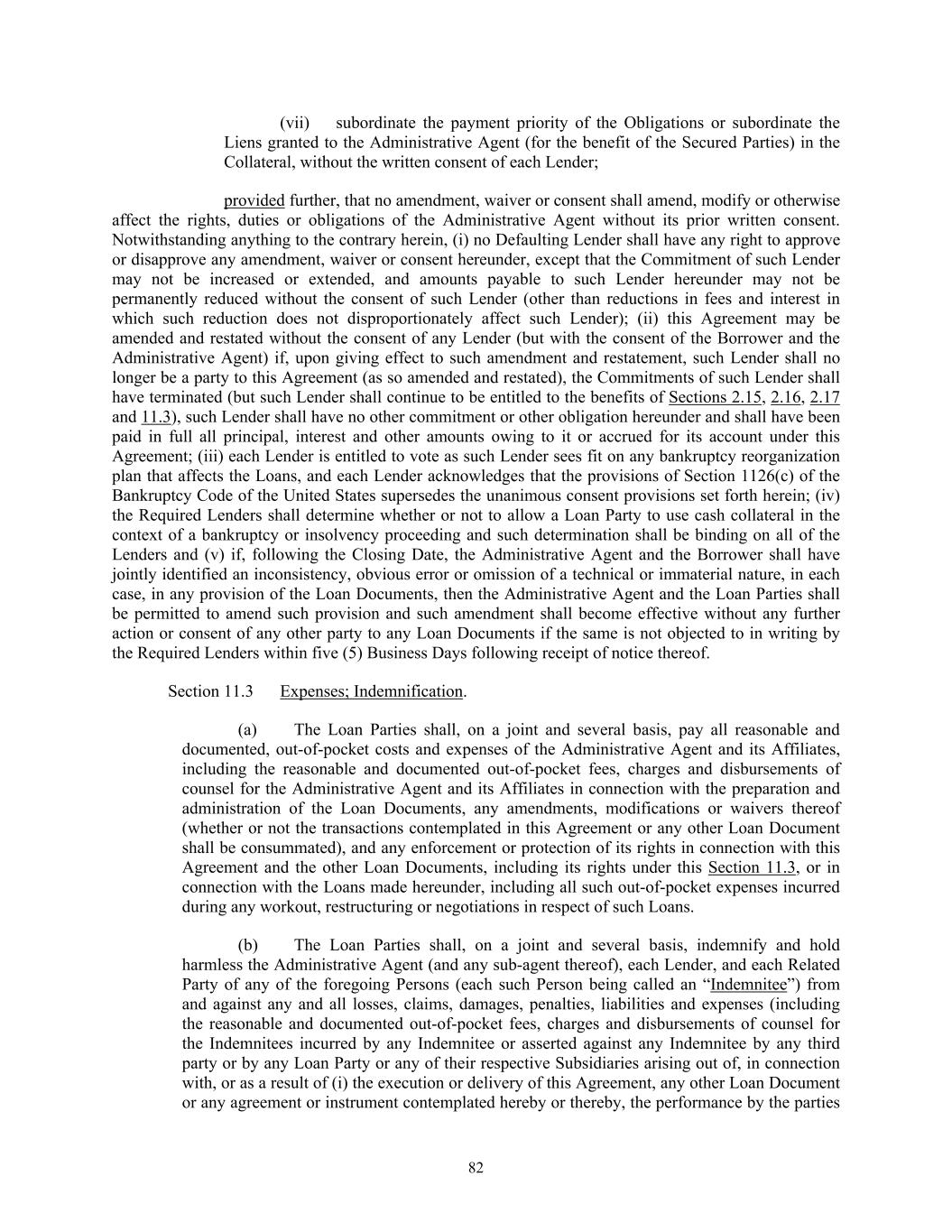
82 (vii) subordinate the payment priority of the Obligations or subordinate the Liens granted to the Administrative Agent (for the benefit of the Secured Parties) in the Collateral, without the written consent of each Lender; provided further, that no amendment, waiver or consent shall amend, modify or otherwise affect the rights, duties or obligations of the Administrative Agent without its prior written consent. Notwithstanding anything to the contrary herein, (i) no Defaulting Lender shall have any right to approve or disapprove any amendment, waiver or consent hereunder, except that the Commitment of such Lender may not be increased or extended, and amounts payable to such Lender hereunder may not be permanently reduced without the consent of such Lender (other than reductions in fees and interest in which such reduction does not disproportionately affect such Lender); (ii) this Agreement may be amended and restated without the consent of any Lender (but with the consent of the Borrower and the Administrative Agent) if, upon giving effect to such amendment and restatement, such Lender shall no longer be a party to this Agreement (as so amended and restated), the Commitments of such Lender shall have terminated (but such Lender shall continue to be entitled to the benefits of Sections 2.15, 2.16, 2.17 and 11.3), such Lender shall have no other commitment or other obligation hereunder and shall have been paid in full all principal, interest and other amounts owing to it or accrued for its account under this Agreement; (iii) each Lender is entitled to vote as such Lender sees fit on any bankruptcy reorganization plan that affects the Loans, and each Lender acknowledges that the provisions of Section 1126(c) of the Bankruptcy Code of the United States supersedes the unanimous consent provisions set forth herein; (iv) the Required Lenders shall determine whether or not to allow a Loan Party to use cash collateral in the context of a bankruptcy or insolvency proceeding and such determination shall be binding on all of the Lenders and (v) if, following the Closing Date, the Administrative Agent and the Borrower shall have jointly identified an inconsistency, obvious error or omission of a technical or immaterial nature, in each case, in any provision of the Loan Documents, then the Administrative Agent and the Loan Parties shall be permitted to amend such provision and such amendment shall become effective without any further action or consent of any other party to any Loan Documents if the same is not objected to in writing by the Required Lenders within five (5) Business Days following receipt of notice thereof. Section 11.3 Expenses; Indemnification. (a) The Loan Parties shall, on a joint and several basis, pay all reasonable and documented, out-of-pocket costs and expenses of the Administrative Agent and its Affiliates, including the reasonable and documented out-of-pocket fees, charges and disbursements of counsel for the Administrative Agent and its Affiliates in connection with the preparation and administration of the Loan Documents, any amendments, modifications or waivers thereof (whether or not the transactions contemplated in this Agreement or any other Loan Document shall be consummated), and any enforcement or protection of its rights in connection with this Agreement and the other Loan Documents, including its rights under this Section 11.3, or in connection with the Loans made hereunder, including all such out-of-pocket expenses incurred during any workout, restructuring or negotiations in respect of such Loans. (b) The Loan Parties shall, on a joint and several basis, indemnify and hold harmless the Administrative Agent (and any sub-agent thereof), each Lender, and each Related Party of any of the foregoing Persons (each such Person being called an “Indemnitee”) from and against any and all losses, claims, damages, penalties, liabilities and expenses (including the reasonable and documented out-of-pocket fees, charges and disbursements of counsel for the Indemnitees incurred by any Indemnitee or asserted against any Indemnitee by any third party or by any Loan Party or any of their respective Subsidiaries arising out of, in connection with, or as a result of (i) the execution or delivery of this Agreement, any other Loan Document or any agreement or instrument contemplated hereby or thereby, the performance by the parties
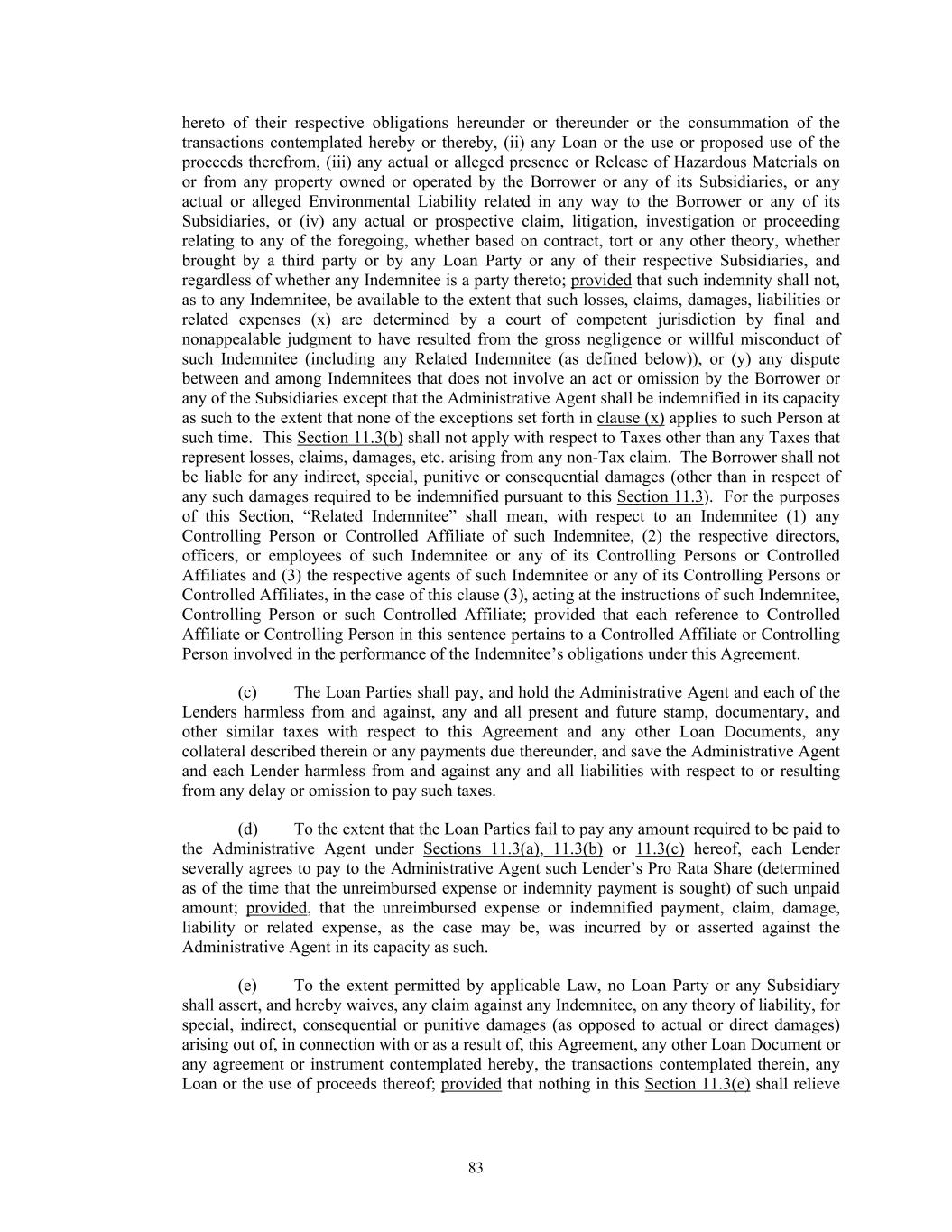
83 hereto of their respective obligations hereunder or thereunder or the consummation of the transactions contemplated hereby or thereby, (ii) any Loan or the use or proposed use of the proceeds therefrom, (iii) any actual or alleged presence or Release of Hazardous Materials on or from any property owned or operated by the Borrower or any of its Subsidiaries, or any actual or alleged Environmental Liability related in any way to the Borrower or any of its Subsidiaries, or (iv) any actual or prospective claim, litigation, investigation or proceeding relating to any of the foregoing, whether based on contract, tort or any other theory, whether brought by a third party or by any Loan Party or any of their respective Subsidiaries, and regardless of whether any Indemnitee is a party thereto; provided that such indemnity shall not, as to any Indemnitee, be available to the extent that such losses, claims, damages, liabilities or related expenses (x) are determined by a court of competent jurisdiction by final and nonappealable judgment to have resulted from the gross negligence or willful misconduct of such Indemnitee (including any Related Indemnitee (as defined below)), or (y) any dispute between and among Indemnitees that does not involve an act or omission by the Borrower or any of the Subsidiaries except that the Administrative Agent shall be indemnified in its capacity as such to the extent that none of the exceptions set forth in clause (x) applies to such Person at such time. This Section 11.3(b) shall not apply with respect to Taxes other than any Taxes that represent losses, claims, damages, etc. arising from any non-Tax claim. The Borrower shall not be liable for any indirect, special, punitive or consequential damages (other than in respect of any such damages required to be indemnified pursuant to this Section 11.3). For the purposes of this Section, “Related Indemnitee” shall mean, with respect to an Indemnitee (1) any Controlling Person or Controlled Affiliate of such Indemnitee, (2) the respective directors, officers, or employees of such Indemnitee or any of its Controlling Persons or Controlled Affiliates and (3) the respective agents of such Indemnitee or any of its Controlling Persons or Controlled Affiliates, in the case of this clause (3), acting at the instructions of such Indemnitee, Controlling Person or such Controlled Affiliate; provided that each reference to Controlled Affiliate or Controlling Person in this sentence pertains to a Controlled Affiliate or Controlling Person involved in the performance of the Indemnitee’s obligations under this Agreement. (c) The Loan Parties shall pay, and hold the Administrative Agent and each of the Lenders harmless from and against, any and all present and future stamp, documentary, and other similar taxes with respect to this Agreement and any other Loan Documents, any collateral described therein or any payments due thereunder, and save the Administrative Agent and each Lender harmless from and against any and all liabilities with respect to or resulting from any delay or omission to pay such taxes. (d) To the extent that the Loan Parties fail to pay any amount required to be paid to the Administrative Agent under Sections 11.3(a), 11.3(b) or 11.3(c) hereof, each Lender severally agrees to pay to the Administrative Agent such Lender’s Pro Rata Share (determined as of the time that the unreimbursed expense or indemnity payment is sought) of such unpaid amount; provided, that the unreimbursed expense or indemnified payment, claim, damage, liability or related expense, as the case may be, was incurred by or asserted against the Administrative Agent in its capacity as such. (e) To the extent permitted by applicable Law, no Loan Party or any Subsidiary shall assert, and hereby waives, any claim against any Indemnitee, on any theory of liability, for special, indirect, consequential or punitive damages (as opposed to actual or direct damages) arising out of, in connection with or as a result of, this Agreement, any other Loan Document or any agreement or instrument contemplated hereby, the transactions contemplated therein, any Loan or the use of proceeds thereof; provided that nothing in this Section 11.3(e) shall relieve
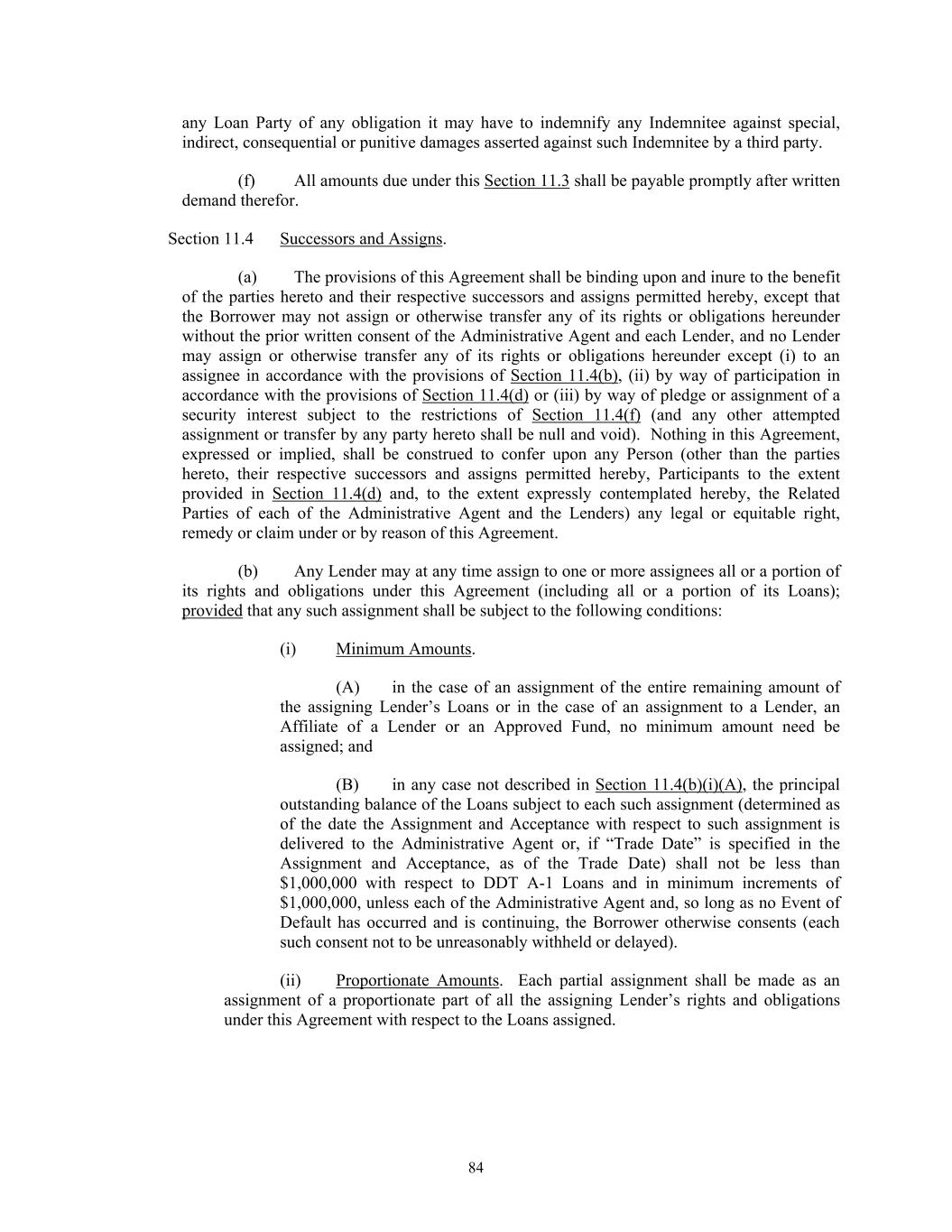
84 any Loan Party of any obligation it may have to indemnify any Indemnitee against special, indirect, consequential or punitive damages asserted against such Indemnitee by a third party. (f) All amounts due under this Section 11.3 shall be payable promptly after written demand therefor. Section 11.4 Successors and Assigns. (a) The provisions of this Agreement shall be binding upon and inure to the benefit of the parties hereto and their respective successors and assigns permitted hereby, except that the Borrower may not assign or otherwise transfer any of its rights or obligations hereunder without the prior written consent of the Administrative Agent and each Lender, and no Lender may assign or otherwise transfer any of its rights or obligations hereunder except (i) to an assignee in accordance with the provisions of Section 11.4(b), (ii) by way of participation in accordance with the provisions of Section 11.4(d) or (iii) by way of pledge or assignment of a security interest subject to the restrictions of Section 11.4(f) (and any other attempted assignment or transfer by any party hereto shall be null and void). Nothing in this Agreement, expressed or implied, shall be construed to confer upon any Person (other than the parties hereto, their respective successors and assigns permitted hereby, Participants to the extent provided in Section 11.4(d) and, to the extent expressly contemplated hereby, the Related Parties of each of the Administrative Agent and the Lenders) any legal or equitable right, remedy or claim under or by reason of this Agreement. (b) Any Lender may at any time assign to one or more assignees all or a portion of its rights and obligations under this Agreement (including all or a portion of its Loans); provided that any such assignment shall be subject to the following conditions: (i) Minimum Amounts. (A) in the case of an assignment of the entire remaining amount of the assigning Lender’s Loans or in the case of an assignment to a Lender, an Affiliate of a Lender or an Approved Fund, no minimum amount need be assigned; and (B) in any case not described in Section 11.4(b)(i)(A), the principal outstanding balance of the Loans subject to each such assignment (determined as of the date the Assignment and Acceptance with respect to such assignment is delivered to the Administrative Agent or, if “Trade Date” is specified in the Assignment and Acceptance, as of the Trade Date) shall not be less than $1,000,000 with respect to DDT A-1 Loans and in minimum increments of $1,000,000, unless each of the Administrative Agent and, so long as no Event of Default has occurred and is continuing, the Borrower otherwise consents (each such consent not to be unreasonably withheld or delayed). (ii) Proportionate Amounts. Each partial assignment shall be made as an assignment of a proportionate part of all the assigning Lender’s rights and obligations under this Agreement with respect to the Loans assigned.
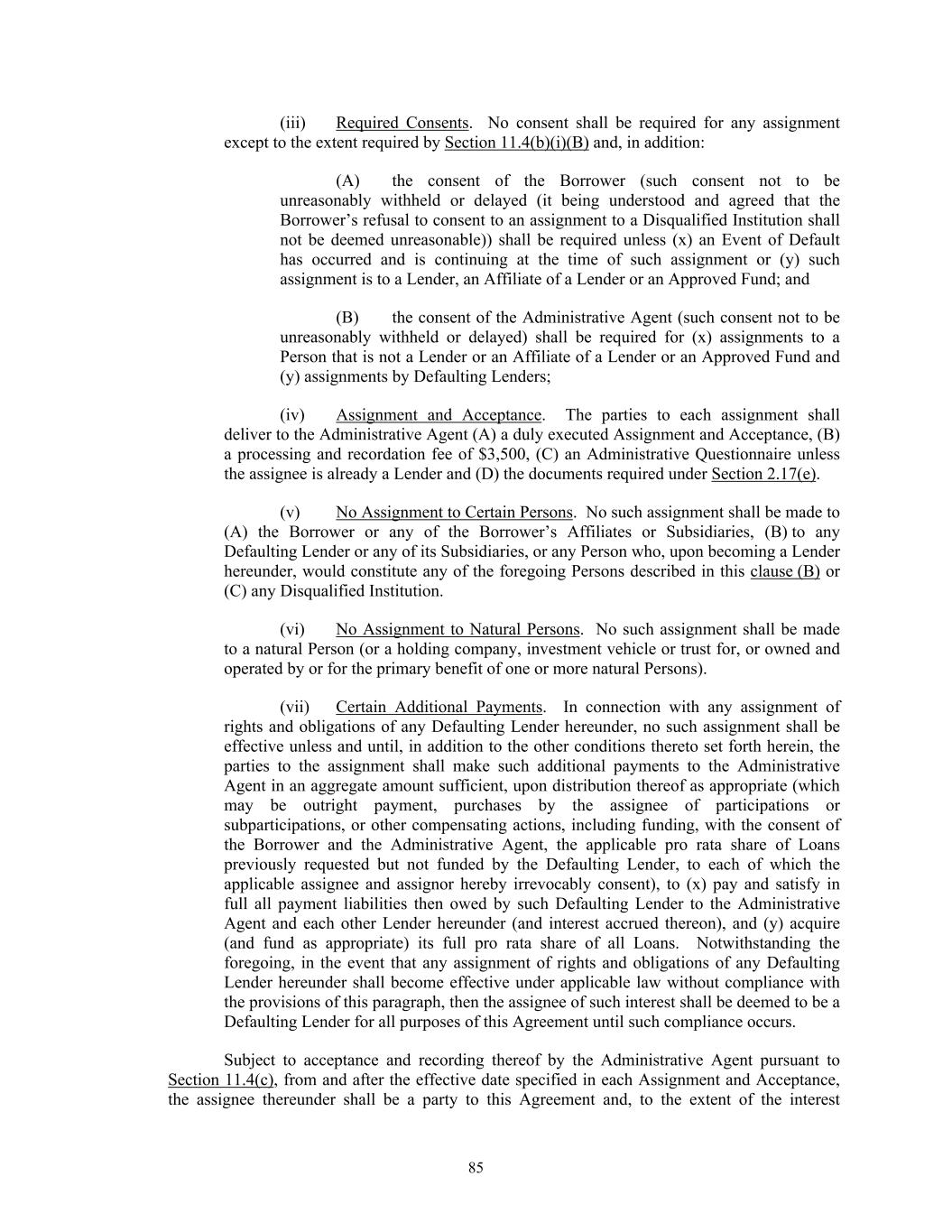
85 (iii) Required Consents. No consent shall be required for any assignment except to the extent required by Section 11.4(b)(i)(B) and, in addition: (A) the consent of the Borrower (such consent not to be unreasonably withheld or delayed (it being understood and agreed that the Borrower’s refusal to consent to an assignment to a Disqualified Institution shall not be deemed unreasonable)) shall be required unless (x) an Event of Default has occurred and is continuing at the time of such assignment or (y) such assignment is to a Lender, an Affiliate of a Lender or an Approved Fund; and (B) the consent of the Administrative Agent (such consent not to be unreasonably withheld or delayed) shall be required for (x) assignments to a Person that is not a Lender or an Affiliate of a Lender or an Approved Fund and (y) assignments by Defaulting Lenders; (iv) Assignment and Acceptance. The parties to each assignment shall deliver to the Administrative Agent (A) a duly executed Assignment and Acceptance, (B) a processing and recordation fee of $3,500, (C) an Administrative Questionnaire unless the assignee is already a Lender and (D) the documents required under Section 2.17(e). (v) No Assignment to Certain Persons. No such assignment shall be made to (A) the Borrower or any of the Borrower’s Affiliates or Subsidiaries, (B) to any Defaulting Lender or any of its Subsidiaries, or any Person who, upon becoming a Lender hereunder, would constitute any of the foregoing Persons described in this clause (B) or (C) any Disqualified Institution. (vi) No Assignment to Natural Persons. No such assignment shall be made to a natural Person (or a holding company, investment vehicle or trust for, or owned and operated by or for the primary benefit of one or more natural Persons). (vii) Certain Additional Payments. In connection with any assignment of rights and obligations of any Defaulting Lender hereunder, no such assignment shall be effective unless and until, in addition to the other conditions thereto set forth herein, the parties to the assignment shall make such additional payments to the Administrative Agent in an aggregate amount sufficient, upon distribution thereof as appropriate (which may be outright payment, purchases by the assignee of participations or subparticipations, or other compensating actions, including funding, with the consent of the Borrower and the Administrative Agent, the applicable pro rata share of Loans previously requested but not funded by the Defaulting Lender, to each of which the applicable assignee and assignor hereby irrevocably consent), to (x) pay and satisfy in full all payment liabilities then owed by such Defaulting Lender to the Administrative Agent and each other Lender hereunder (and interest accrued thereon), and (y) acquire (and fund as appropriate) its full pro rata share of all Loans. Notwithstanding the foregoing, in the event that any assignment of rights and obligations of any Defaulting Lender hereunder shall become effective under applicable law without compliance with the provisions of this paragraph, then the assignee of such interest shall be deemed to be a Defaulting Lender for all purposes of this Agreement until such compliance occurs. Subject to acceptance and recording thereof by the Administrative Agent pursuant to Section 11.4(c), from and after the effective date specified in each Assignment and Acceptance, the assignee thereunder shall be a party to this Agreement and, to the extent of the interest
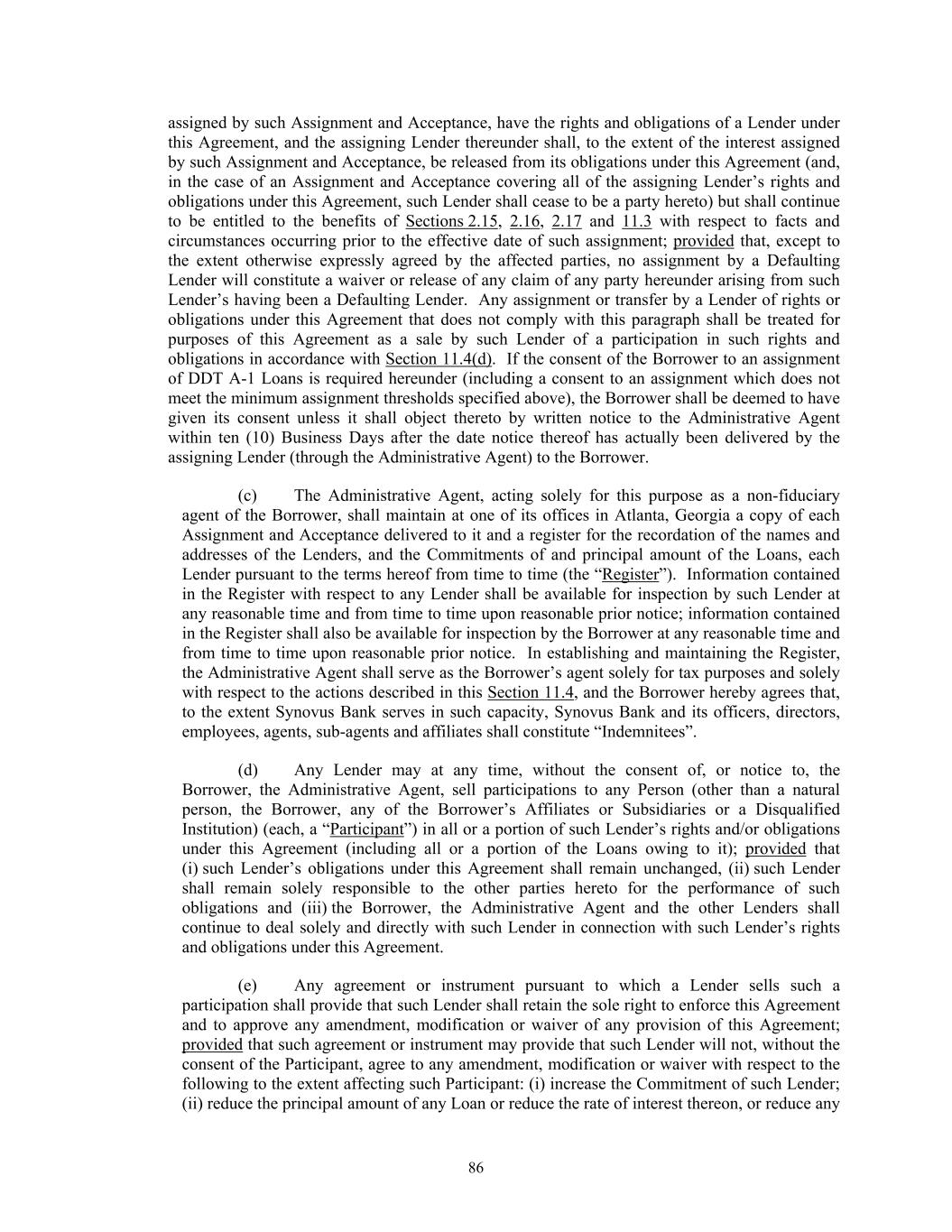
86 assigned by such Assignment and Acceptance, have the rights and obligations of a Lender under this Agreement, and the assigning Lender thereunder shall, to the extent of the interest assigned by such Assignment and Acceptance, be released from its obligations under this Agreement (and, in the case of an Assignment and Acceptance covering all of the assigning Lender’s rights and obligations under this Agreement, such Lender shall cease to be a party hereto) but shall continue to be entitled to the benefits of Sections 2.15, 2.16, 2.17 and 11.3 with respect to facts and circumstances occurring prior to the effective date of such assignment; provided that, except to the extent otherwise expressly agreed by the affected parties, no assignment by a Defaulting Lender will constitute a waiver or release of any claim of any party hereunder arising from such Lender’s having been a Defaulting Lender. Any assignment or transfer by a Lender of rights or obligations under this Agreement that does not comply with this paragraph shall be treated for purposes of this Agreement as a sale by such Lender of a participation in such rights and obligations in accordance with Section 11.4(d). If the consent of the Borrower to an assignment of DDT A-1 Loans is required hereunder (including a consent to an assignment which does not meet the minimum assignment thresholds specified above), the Borrower shall be deemed to have given its consent unless it shall object thereto by written notice to the Administrative Agent within ten (10) Business Days after the date notice thereof has actually been delivered by the assigning Lender (through the Administrative Agent) to the Borrower. (c) The Administrative Agent, acting solely for this purpose as a non-fiduciary agent of the Borrower, shall maintain at one of its offices in Atlanta, Georgia a copy of each Assignment and Acceptance delivered to it and a register for the recordation of the names and addresses of the Lenders, and the Commitments of and principal amount of the Loans, each Lender pursuant to the terms hereof from time to time (the “Register”). Information contained in the Register with respect to any Lender shall be available for inspection by such Lender at any reasonable time and from time to time upon reasonable prior notice; information contained in the Register shall also be available for inspection by the Borrower at any reasonable time and from time to time upon reasonable prior notice. In establishing and maintaining the Register, the Administrative Agent shall serve as the Borrower’s agent solely for tax purposes and solely with respect to the actions described in this Section 11.4, and the Borrower hereby agrees that, to the extent Synovus Bank serves in such capacity, Synovus Bank and its officers, directors, employees, agents, sub-agents and affiliates shall constitute “Indemnitees”. (d) Any Lender may at any time, without the consent of, or notice to, the Borrower, the Administrative Agent, sell participations to any Person (other than a natural person, the Borrower, any of the Borrower’s Affiliates or Subsidiaries or a Disqualified Institution) (each, a “Participant”) in all or a portion of such Lender’s rights and/or obligations under this Agreement (including all or a portion of the Loans owing to it); provided that (i) such Lender’s obligations under this Agreement shall remain unchanged, (ii) such Lender shall remain solely responsible to the other parties hereto for the performance of such obligations and (iii) the Borrower, the Administrative Agent and the other Lenders shall continue to deal solely and directly with such Lender in connection with such Lender’s rights and obligations under this Agreement. (e) Any agreement or instrument pursuant to which a Lender sells such a participation shall provide that such Lender shall retain the sole right to enforce this Agreement and to approve any amendment, modification or waiver of any provision of this Agreement; provided that such agreement or instrument may provide that such Lender will not, without the consent of the Participant, agree to any amendment, modification or waiver with respect to the following to the extent affecting such Participant: (i) increase the Commitment of such Lender; (ii) reduce the principal amount of any Loan or reduce the rate of interest thereon, or reduce any
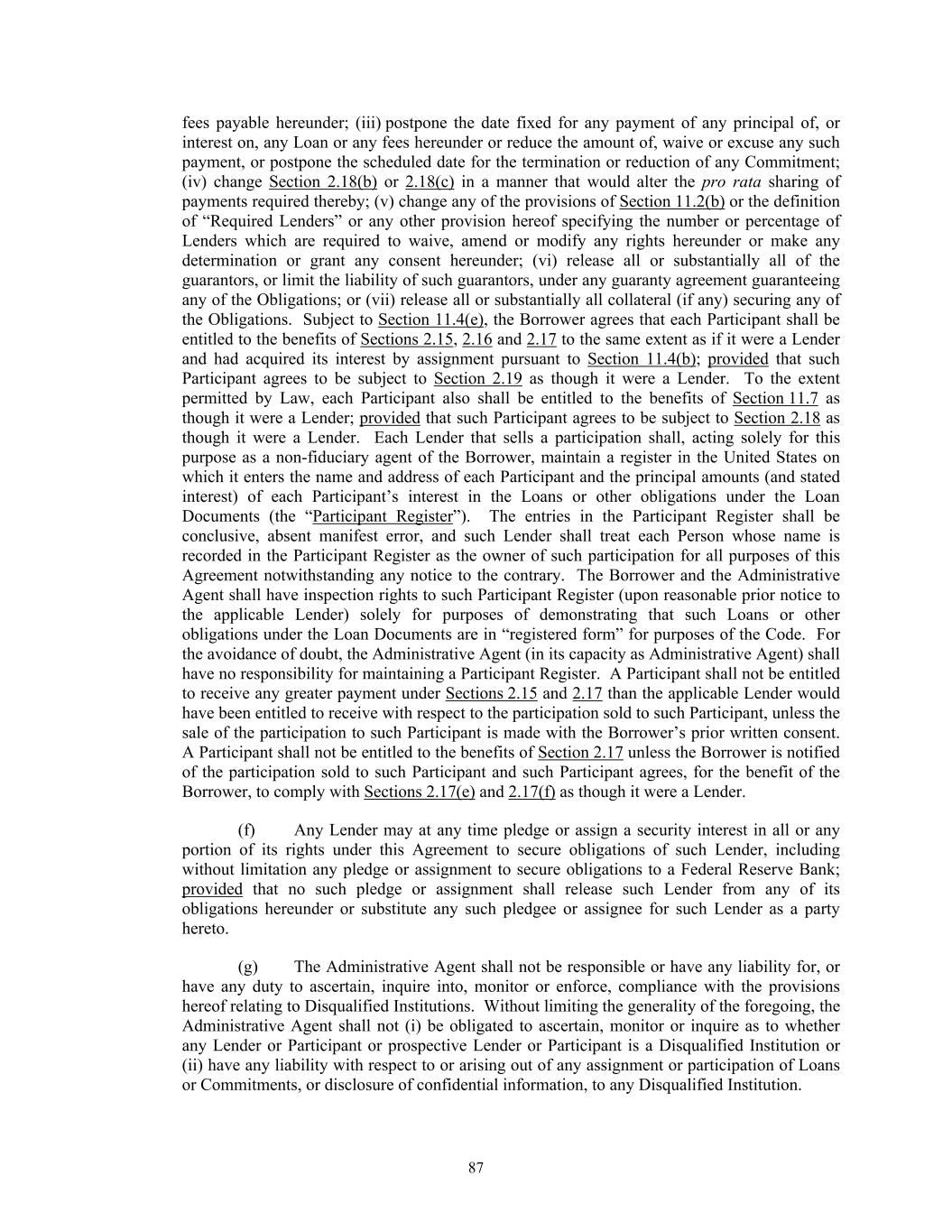
87 fees payable hereunder; (iii) postpone the date fixed for any payment of any principal of, or interest on, any Loan or any fees hereunder or reduce the amount of, waive or excuse any such payment, or postpone the scheduled date for the termination or reduction of any Commitment; (iv) change Section 2.18(b) or 2.18(c) in a manner that would alter the pro rata sharing of payments required thereby; (v) change any of the provisions of Section 11.2(b) or the definition of “Required Lenders” or any other provision hereof specifying the number or percentage of Lenders which are required to waive, amend or modify any rights hereunder or make any determination or grant any consent hereunder; (vi) release all or substantially all of the guarantors, or limit the liability of such guarantors, under any guaranty agreement guaranteeing any of the Obligations; or (vii) release all or substantially all collateral (if any) securing any of the Obligations. Subject to Section 11.4(e), the Borrower agrees that each Participant shall be entitled to the benefits of Sections 2.15, 2.16 and 2.17 to the same extent as if it were a Lender and had acquired its interest by assignment pursuant to Section 11.4(b); provided that such Participant agrees to be subject to Section 2.19 as though it were a Lender. To the extent permitted by Law, each Participant also shall be entitled to the benefits of Section 11.7 as though it were a Lender; provided that such Participant agrees to be subject to Section 2.18 as though it were a Lender. Each Lender that sells a participation shall, acting solely for this purpose as a non-fiduciary agent of the Borrower, maintain a register in the United States on which it enters the name and address of each Participant and the principal amounts (and stated interest) of each Participant’s interest in the Loans or other obligations under the Loan Documents (the “Participant Register”). The entries in the Participant Register shall be conclusive, absent manifest error, and such Lender shall treat each Person whose name is recorded in the Participant Register as the owner of such participation for all purposes of this Agreement notwithstanding any notice to the contrary. The Borrower and the Administrative Agent shall have inspection rights to such Participant Register (upon reasonable prior notice to the applicable Lender) solely for purposes of demonstrating that such Loans or other obligations under the Loan Documents are in “registered form” for purposes of the Code. For the avoidance of doubt, the Administrative Agent (in its capacity as Administrative Agent) shall have no responsibility for maintaining a Participant Register. A Participant shall not be entitled to receive any greater payment under Sections 2.15 and 2.17 than the applicable Lender would have been entitled to receive with respect to the participation sold to such Participant, unless the sale of the participation to such Participant is made with the Borrower’s prior written consent. A Participant shall not be entitled to the benefits of Section 2.17 unless the Borrower is notified of the participation sold to such Participant and such Participant agrees, for the benefit of the Borrower, to comply with Sections 2.17(e) and 2.17(f) as though it were a Lender. (f) Any Lender may at any time pledge or assign a security interest in all or any portion of its rights under this Agreement to secure obligations of such Lender, including without limitation any pledge or assignment to secure obligations to a Federal Reserve Bank; provided that no such pledge or assignment shall release such Lender from any of its obligations hereunder or substitute any such pledgee or assignee for such Lender as a party hereto. (g) The Administrative Agent shall not be responsible or have any liability for, or have any duty to ascertain, inquire into, monitor or enforce, compliance with the provisions hereof relating to Disqualified Institutions. Without limiting the generality of the foregoing, the Administrative Agent shall not (i) be obligated to ascertain, monitor or inquire as to whether any Lender or Participant or prospective Lender or Participant is a Disqualified Institution or (ii) have any liability with respect to or arising out of any assignment or participation of Loans or Commitments, or disclosure of confidential information, to any Disqualified Institution.
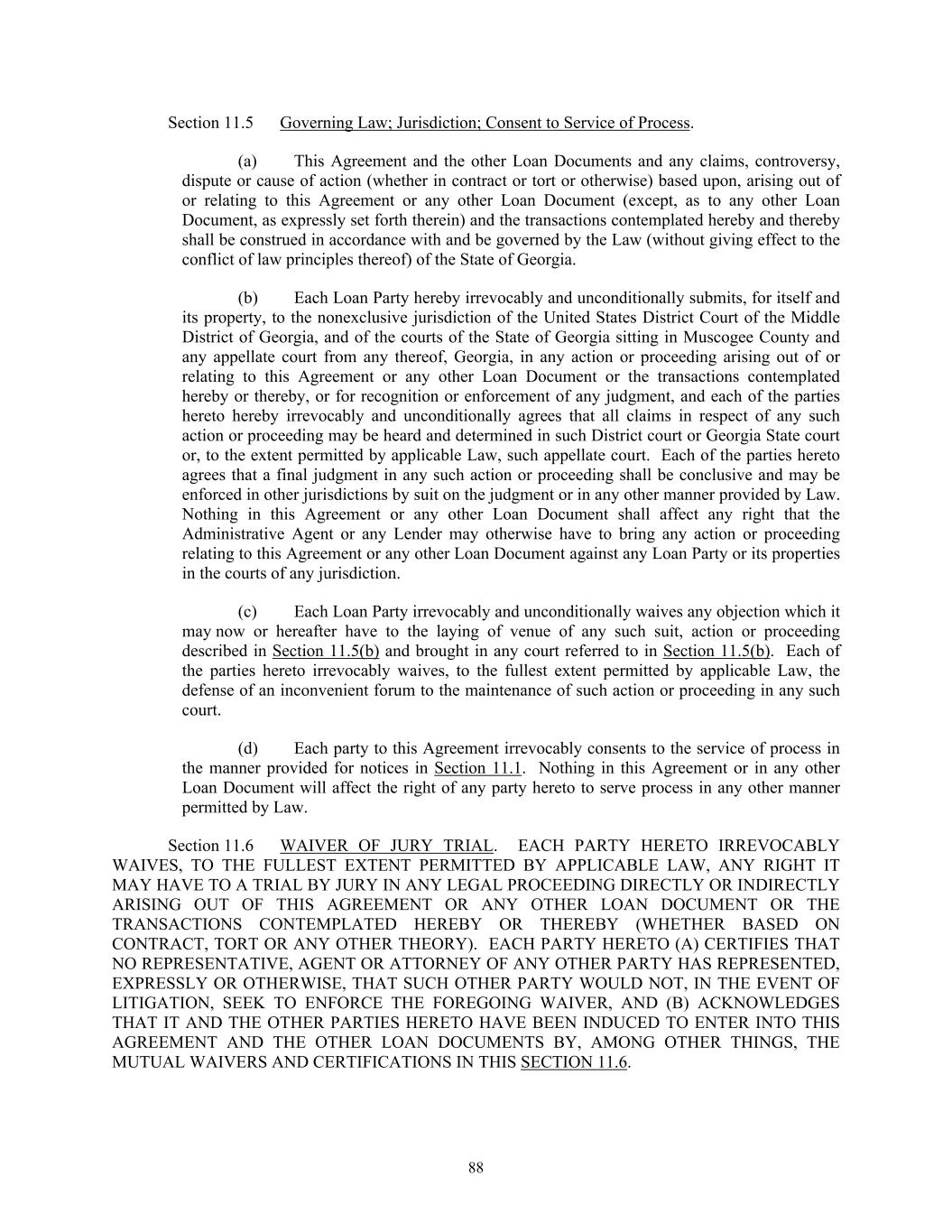
88 Section 11.5 Governing Law; Jurisdiction; Consent to Service of Process. (a) This Agreement and the other Loan Documents and any claims, controversy, dispute or cause of action (whether in contract or tort or otherwise) based upon, arising out of or relating to this Agreement or any other Loan Document (except, as to any other Loan Document, as expressly set forth therein) and the transactions contemplated hereby and thereby shall be construed in accordance with and be governed by the Law (without giving effect to the conflict of law principles thereof) of the State of Georgia. (b) Each Loan Party hereby irrevocably and unconditionally submits, for itself and its property, to the nonexclusive jurisdiction of the United States District Court of the Middle District of Georgia, and of the courts of the State of Georgia sitting in Muscogee County and any appellate court from any thereof, Georgia, in any action or proceeding arising out of or relating to this Agreement or any other Loan Document or the transactions contemplated hereby or thereby, or for recognition or enforcement of any judgment, and each of the parties hereto hereby irrevocably and unconditionally agrees that all claims in respect of any such action or proceeding may be heard and determined in such District court or Georgia State court or, to the extent permitted by applicable Law, such appellate court. Each of the parties hereto agrees that a final judgment in any such action or proceeding shall be conclusive and may be enforced in other jurisdictions by suit on the judgment or in any other manner provided by Law. Nothing in this Agreement or any other Loan Document shall affect any right that the Administrative Agent or any Lender may otherwise have to bring any action or proceeding relating to this Agreement or any other Loan Document against any Loan Party or its properties in the courts of any jurisdiction. (c) Each Loan Party irrevocably and unconditionally waives any objection which it may now or hereafter have to the laying of venue of any such suit, action or proceeding described in Section 11.5(b) and brought in any court referred to in Section 11.5(b). Each of the parties hereto irrevocably waives, to the fullest extent permitted by applicable Law, the defense of an inconvenient forum to the maintenance of such action or proceeding in any such court. (d) Each party to this Agreement irrevocably consents to the service of process in the manner provided for notices in Section 11.1. Nothing in this Agreement or in any other Loan Document will affect the right of any party hereto to serve process in any other manner permitted by Law. Section 11.6 WAIVER OF JURY TRIAL. EACH PARTY HERETO IRREVOCABLY WAIVES, TO THE FULLEST EXTENT PERMITTED BY APPLICABLE LAW, ANY RIGHT IT MAY HAVE TO A TRIAL BY JURY IN ANY LEGAL PROCEEDING DIRECTLY OR INDIRECTLY ARISING OUT OF THIS AGREEMENT OR ANY OTHER LOAN DOCUMENT OR THE TRANSACTIONS CONTEMPLATED HEREBY OR THEREBY (WHETHER BASED ON CONTRACT, TORT OR ANY OTHER THEORY). EACH PARTY HERETO (A) CERTIFIES THAT NO REPRESENTATIVE, AGENT OR ATTORNEY OF ANY OTHER PARTY HAS REPRESENTED, EXPRESSLY OR OTHERWISE, THAT SUCH OTHER PARTY WOULD NOT, IN THE EVENT OF LITIGATION, SEEK TO ENFORCE THE FOREGOING WAIVER, AND (B) ACKNOWLEDGES THAT IT AND THE OTHER PARTIES HERETO HAVE BEEN INDUCED TO ENTER INTO THIS AGREEMENT AND THE OTHER LOAN DOCUMENTS BY, AMONG OTHER THINGS, THE MUTUAL WAIVERS AND CERTIFICATIONS IN THIS SECTION 11.6.
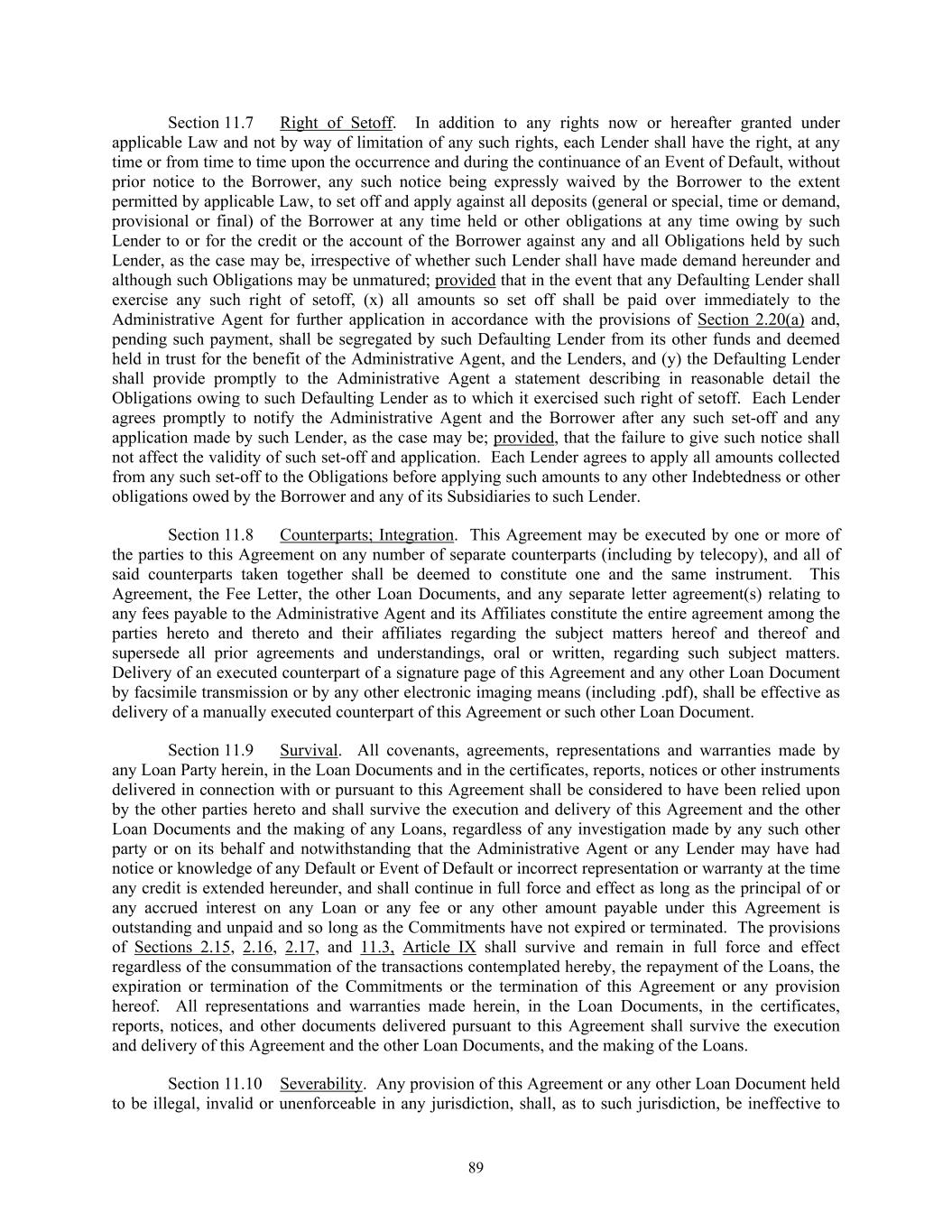
89 Section 11.7 Right of Setoff. In addition to any rights now or hereafter granted under applicable Law and not by way of limitation of any such rights, each Lender shall have the right, at any time or from time to time upon the occurrence and during the continuance of an Event of Default, without prior notice to the Borrower, any such notice being expressly waived by the Borrower to the extent permitted by applicable Law, to set off and apply against all deposits (general or special, time or demand, provisional or final) of the Borrower at any time held or other obligations at any time owing by such Lender to or for the credit or the account of the Borrower against any and all Obligations held by such Lender, as the case may be, irrespective of whether such Lender shall have made demand hereunder and although such Obligations may be unmatured; provided that in the event that any Defaulting Lender shall exercise any such right of setoff, (x) all amounts so set off shall be paid over immediately to the Administrative Agent for further application in accordance with the provisions of Section 2.20(a) and, pending such payment, shall be segregated by such Defaulting Lender from its other funds and deemed held in trust for the benefit of the Administrative Agent, and the Lenders, and (y) the Defaulting Lender shall provide promptly to the Administrative Agent a statement describing in reasonable detail the Obligations owing to such Defaulting Lender as to which it exercised such right of setoff. Each Lender agrees promptly to notify the Administrative Agent and the Borrower after any such set-off and any application made by such Lender, as the case may be; provided, that the failure to give such notice shall not affect the validity of such set-off and application. Each Lender agrees to apply all amounts collected from any such set-off to the Obligations before applying such amounts to any other Indebtedness or other obligations owed by the Borrower and any of its Subsidiaries to such Lender. Section 11.8 Counterparts; Integration. This Agreement may be executed by one or more of the parties to this Agreement on any number of separate counterparts (including by telecopy), and all of said counterparts taken together shall be deemed to constitute one and the same instrument. This Agreement, the Fee Letter, the other Loan Documents, and any separate letter agreement(s) relating to any fees payable to the Administrative Agent and its Affiliates constitute the entire agreement among the parties hereto and thereto and their affiliates regarding the subject matters hereof and thereof and supersede all prior agreements and understandings, oral or written, regarding such subject matters. Delivery of an executed counterpart of a signature page of this Agreement and any other Loan Document by facsimile transmission or by any other electronic imaging means (including .pdf), shall be effective as delivery of a manually executed counterpart of this Agreement or such other Loan Document. Section 11.9 Survival. All covenants, agreements, representations and warranties made by any Loan Party herein, in the Loan Documents and in the certificates, reports, notices or other instruments delivered in connection with or pursuant to this Agreement shall be considered to have been relied upon by the other parties hereto and shall survive the execution and delivery of this Agreement and the other Loan Documents and the making of any Loans, regardless of any investigation made by any such other party or on its behalf and notwithstanding that the Administrative Agent or any Lender may have had notice or knowledge of any Default or Event of Default or incorrect representation or warranty at the time any credit is extended hereunder, and shall continue in full force and effect as long as the principal of or any accrued interest on any Loan or any fee or any other amount payable under this Agreement is outstanding and unpaid and so long as the Commitments have not expired or terminated. The provisions of Sections 2.15, 2.16, 2.17, and 11.3, Article IX shall survive and remain in full force and effect regardless of the consummation of the transactions contemplated hereby, the repayment of the Loans, the expiration or termination of the Commitments or the termination of this Agreement or any provision hereof. All representations and warranties made herein, in the Loan Documents, in the certificates, reports, notices, and other documents delivered pursuant to this Agreement shall survive the execution and delivery of this Agreement and the other Loan Documents, and the making of the Loans. Section 11.10 Severability. Any provision of this Agreement or any other Loan Document held to be illegal, invalid or unenforceable in any jurisdiction, shall, as to such jurisdiction, be ineffective to
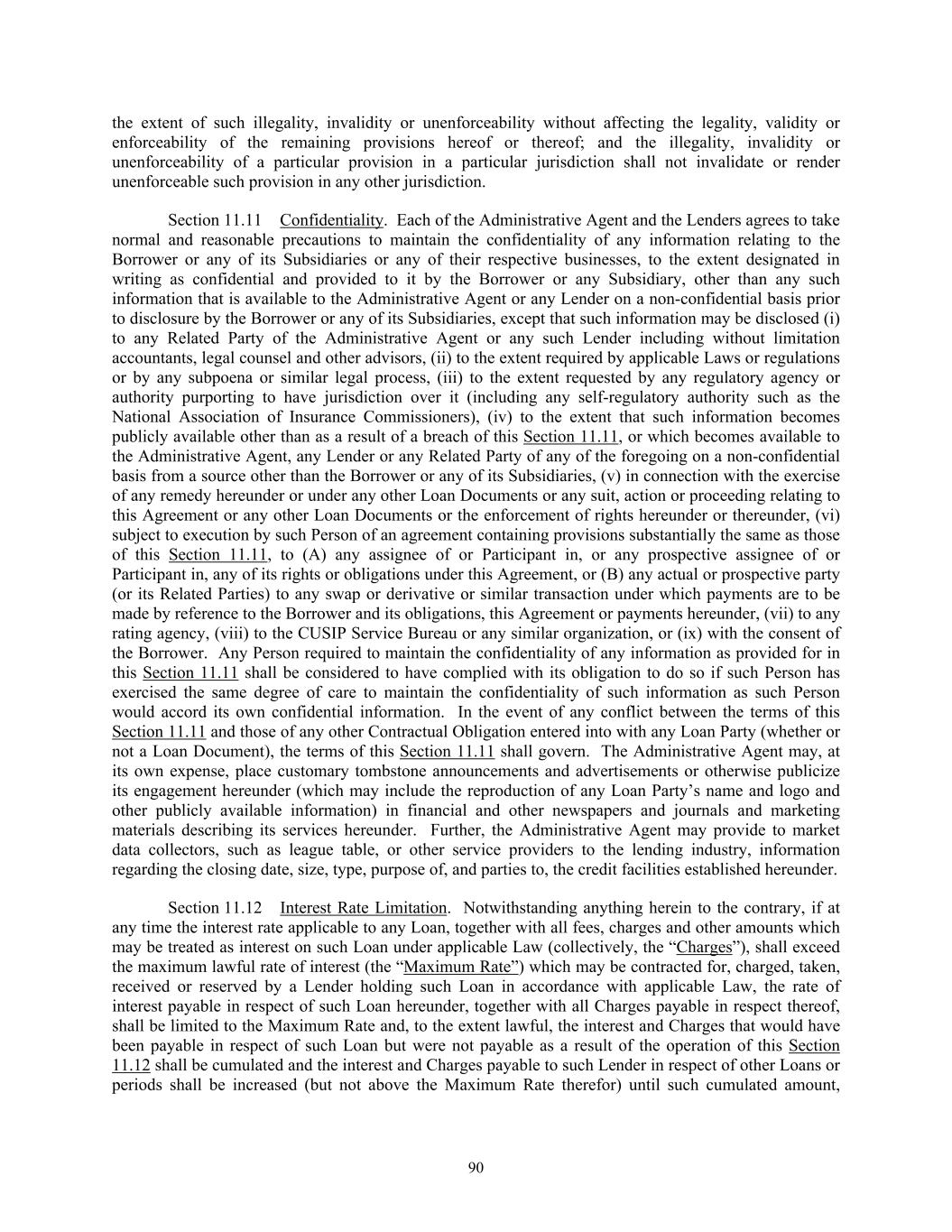
90 the extent of such illegality, invalidity or unenforceability without affecting the legality, validity or enforceability of the remaining provisions hereof or thereof; and the illegality, invalidity or unenforceability of a particular provision in a particular jurisdiction shall not invalidate or render unenforceable such provision in any other jurisdiction. Section 11.11 Confidentiality. Each of the Administrative Agent and the Lenders agrees to take normal and reasonable precautions to maintain the confidentiality of any information relating to the Borrower or any of its Subsidiaries or any of their respective businesses, to the extent designated in writing as confidential and provided to it by the Borrower or any Subsidiary, other than any such information that is available to the Administrative Agent or any Lender on a non-confidential basis prior to disclosure by the Borrower or any of its Subsidiaries, except that such information may be disclosed (i) to any Related Party of the Administrative Agent or any such Lender including without limitation accountants, legal counsel and other advisors, (ii) to the extent required by applicable Laws or regulations or by any subpoena or similar legal process, (iii) to the extent requested by any regulatory agency or authority purporting to have jurisdiction over it (including any self-regulatory authority such as the National Association of Insurance Commissioners), (iv) to the extent that such information becomes publicly available other than as a result of a breach of this Section 11.11, or which becomes available to the Administrative Agent, any Lender or any Related Party of any of the foregoing on a non-confidential basis from a source other than the Borrower or any of its Subsidiaries, (v) in connection with the exercise of any remedy hereunder or under any other Loan Documents or any suit, action or proceeding relating to this Agreement or any other Loan Documents or the enforcement of rights hereunder or thereunder, (vi) subject to execution by such Person of an agreement containing provisions substantially the same as those of this Section 11.11, to (A) any assignee of or Participant in, or any prospective assignee of or Participant in, any of its rights or obligations under this Agreement, or (B) any actual or prospective party (or its Related Parties) to any swap or derivative or similar transaction under which payments are to be made by reference to the Borrower and its obligations, this Agreement or payments hereunder, (vii) to any rating agency, (viii) to the CUSIP Service Bureau or any similar organization, or (ix) with the consent of the Borrower. Any Person required to maintain the confidentiality of any information as provided for in this Section 11.11 shall be considered to have complied with its obligation to do so if such Person has exercised the same degree of care to maintain the confidentiality of such information as such Person would accord its own confidential information. In the event of any conflict between the terms of this Section 11.11 and those of any other Contractual Obligation entered into with any Loan Party (whether or not a Loan Document), the terms of this Section 11.11 shall govern. The Administrative Agent may, at its own expense, place customary tombstone announcements and advertisements or otherwise publicize its engagement hereunder (which may include the reproduction of any Loan Party’s name and logo and other publicly available information) in financial and other newspapers and journals and marketing materials describing its services hereunder. Further, the Administrative Agent may provide to market data collectors, such as league table, or other service providers to the lending industry, information regarding the closing date, size, type, purpose of, and parties to, the credit facilities established hereunder. Section 11.12 Interest Rate Limitation. Notwithstanding anything herein to the contrary, if at any time the interest rate applicable to any Loan, together with all fees, charges and other amounts which may be treated as interest on such Loan under applicable Law (collectively, the “Charges”), shall exceed the maximum lawful rate of interest (the “Maximum Rate”) which may be contracted for, charged, taken, received or reserved by a Lender holding such Loan in accordance with applicable Law, the rate of interest payable in respect of such Loan hereunder, together with all Charges payable in respect thereof, shall be limited to the Maximum Rate and, to the extent lawful, the interest and Charges that would have been payable in respect of such Loan but were not payable as a result of the operation of this Section 11.12 shall be cumulated and the interest and Charges payable to such Lender in respect of other Loans or periods shall be increased (but not above the Maximum Rate therefor) until such cumulated amount,
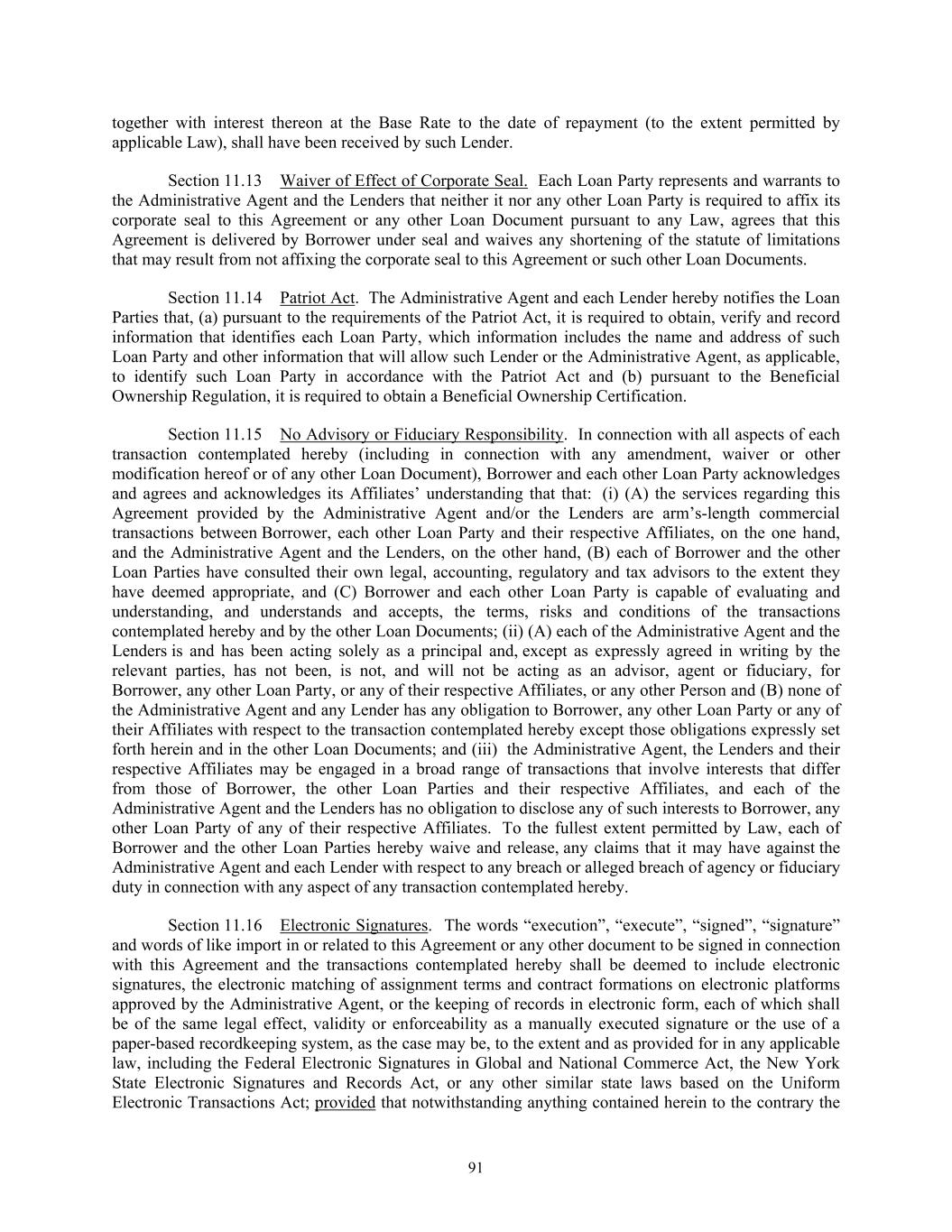
91 together with interest thereon at the Base Rate to the date of repayment (to the extent permitted by applicable Law), shall have been received by such Lender. Section 11.13 Waiver of Effect of Corporate Seal. Each Loan Party represents and warrants to the Administrative Agent and the Lenders that neither it nor any other Loan Party is required to affix its corporate seal to this Agreement or any other Loan Document pursuant to any Law, agrees that this Agreement is delivered by Borrower under seal and waives any shortening of the statute of limitations that may result from not affixing the corporate seal to this Agreement or such other Loan Documents. Section 11.14 Patriot Act. The Administrative Agent and each Lender hereby notifies the Loan Parties that, (a) pursuant to the requirements of the Patriot Act, it is required to obtain, verify and record information that identifies each Loan Party, which information includes the name and address of such Loan Party and other information that will allow such Lender or the Administrative Agent, as applicable, to identify such Loan Party in accordance with the Patriot Act and (b) pursuant to the Beneficial Ownership Regulation, it is required to obtain a Beneficial Ownership Certification. Section 11.15 No Advisory or Fiduciary Responsibility. In connection with all aspects of each transaction contemplated hereby (including in connection with any amendment, waiver or other modification hereof or of any other Loan Document), Borrower and each other Loan Party acknowledges and agrees and acknowledges its Affiliates’ understanding that that: (i) (A) the services regarding this Agreement provided by the Administrative Agent and/or the Lenders are arm’s-length commercial transactions between Borrower, each other Loan Party and their respective Affiliates, on the one hand, and the Administrative Agent and the Lenders, on the other hand, (B) each of Borrower and the other Loan Parties have consulted their own legal, accounting, regulatory and tax advisors to the extent they have deemed appropriate, and (C) Borrower and each other Loan Party is capable of evaluating and understanding, and understands and accepts, the terms, risks and conditions of the transactions contemplated hereby and by the other Loan Documents; (ii) (A) each of the Administrative Agent and the Lenders is and has been acting solely as a principal and, except as expressly agreed in writing by the relevant parties, has not been, is not, and will not be acting as an advisor, agent or fiduciary, for Borrower, any other Loan Party, or any of their respective Affiliates, or any other Person and (B) none of the Administrative Agent and any Lender has any obligation to Borrower, any other Loan Party or any of their Affiliates with respect to the transaction contemplated hereby except those obligations expressly set forth herein and in the other Loan Documents; and (iii) the Administrative Agent, the Lenders and their respective Affiliates may be engaged in a broad range of transactions that involve interests that differ from those of Borrower, the other Loan Parties and their respective Affiliates, and each of the Administrative Agent and the Lenders has no obligation to disclose any of such interests to Borrower, any other Loan Party of any of their respective Affiliates. To the fullest extent permitted by Law, each of Borrower and the other Loan Parties hereby waive and release, any claims that it may have against the Administrative Agent and each Lender with respect to any breach or alleged breach of agency or fiduciary duty in connection with any aspect of any transaction contemplated hereby. Section 11.16 Electronic Signatures. The words “execution”, “execute”, “signed”, “signature” and words of like import in or related to this Agreement or any other document to be signed in connection with this Agreement and the transactions contemplated hereby shall be deemed to include electronic signatures, the electronic matching of assignment terms and contract formations on electronic platforms approved by the Administrative Agent, or the keeping of records in electronic form, each of which shall be of the same legal effect, validity or enforceability as a manually executed signature or the use of a paper-based recordkeeping system, as the case may be, to the extent and as provided for in any applicable law, including the Federal Electronic Signatures in Global and National Commerce Act, the New York State Electronic Signatures and Records Act, or any other similar state laws based on the Uniform Electronic Transactions Act; provided that notwithstanding anything contained herein to the contrary the
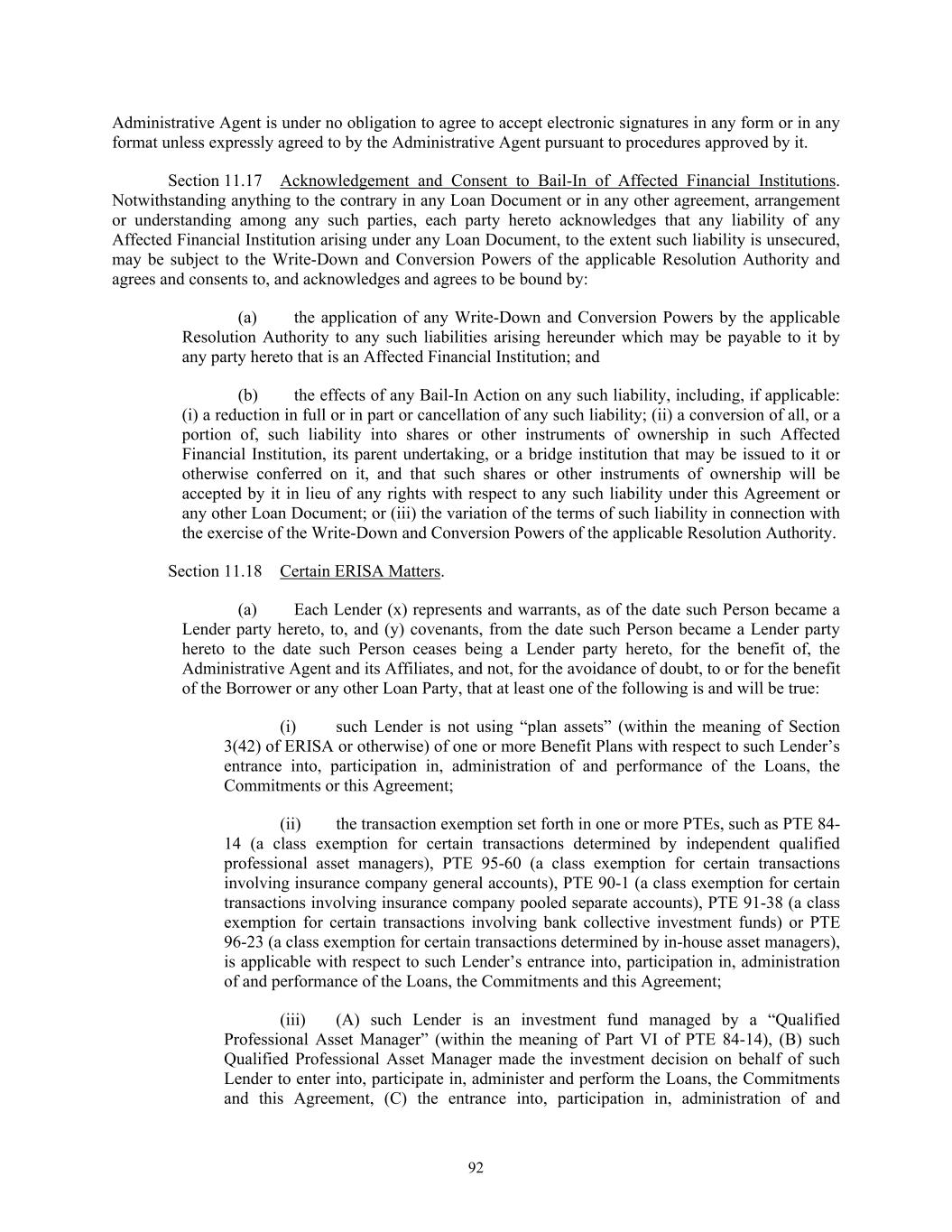
92 Administrative Agent is under no obligation to agree to accept electronic signatures in any form or in any format unless expressly agreed to by the Administrative Agent pursuant to procedures approved by it. Section 11.17 Acknowledgement and Consent to Bail-In of Affected Financial Institutions. Notwithstanding anything to the contrary in any Loan Document or in any other agreement, arrangement or understanding among any such parties, each party hereto acknowledges that any liability of any Affected Financial Institution arising under any Loan Document, to the extent such liability is unsecured, may be subject to the Write-Down and Conversion Powers of the applicable Resolution Authority and agrees and consents to, and acknowledges and agrees to be bound by: (a) the application of any Write-Down and Conversion Powers by the applicable Resolution Authority to any such liabilities arising hereunder which may be payable to it by any party hereto that is an Affected Financial Institution; and (b) the effects of any Bail-In Action on any such liability, including, if applicable: (i) a reduction in full or in part or cancellation of any such liability; (ii) a conversion of all, or a portion of, such liability into shares or other instruments of ownership in such Affected Financial Institution, its parent undertaking, or a bridge institution that may be issued to it or otherwise conferred on it, and that such shares or other instruments of ownership will be accepted by it in lieu of any rights with respect to any such liability under this Agreement or any other Loan Document; or (iii) the variation of the terms of such liability in connection with the exercise of the Write-Down and Conversion Powers of the applicable Resolution Authority. Section 11.18 Certain ERISA Matters. (a) Each Lender (x) represents and warrants, as of the date such Person became a Lender party hereto, to, and (y) covenants, from the date such Person became a Lender party hereto to the date such Person ceases being a Lender party hereto, for the benefit of, the Administrative Agent and its Affiliates, and not, for the avoidance of doubt, to or for the benefit of the Borrower or any other Loan Party, that at least one of the following is and will be true: (i) such Lender is not using “plan assets” (within the meaning of Section 3(42) of ERISA or otherwise) of one or more Benefit Plans with respect to such Lender’s entrance into, participation in, administration of and performance of the Loans, the Commitments or this Agreement; (ii) the transaction exemption set forth in one or more PTEs, such as PTE 84- 14 (a class exemption for certain transactions determined by independent qualified professional asset managers), PTE 95-60 (a class exemption for certain transactions involving insurance company general accounts), PTE 90-1 (a class exemption for certain transactions involving insurance company pooled separate accounts), PTE 91-38 (a class exemption for certain transactions involving bank collective investment funds) or PTE 96-23 (a class exemption for certain transactions determined by in-house asset managers), is applicable with respect to such Lender’s entrance into, participation in, administration of and performance of the Loans, the Commitments and this Agreement; (iii) (A) such Lender is an investment fund managed by a “Qualified Professional Asset Manager” (within the meaning of Part VI of PTE 84-14), (B) such Qualified Professional Asset Manager made the investment decision on behalf of such Lender to enter into, participate in, administer and perform the Loans, the Commitments and this Agreement, (C) the entrance into, participation in, administration of and
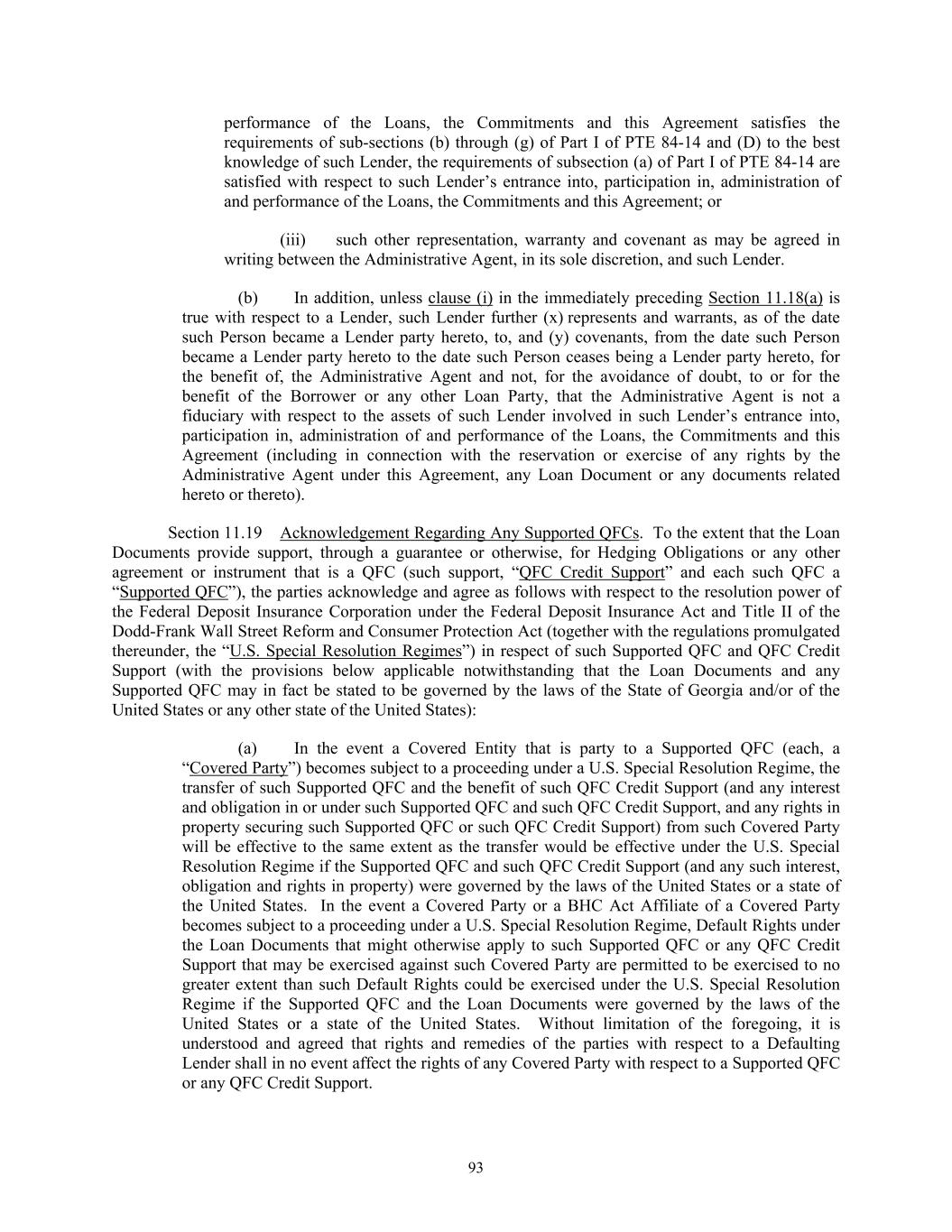
93 performance of the Loans, the Commitments and this Agreement satisfies the requirements of sub-sections (b) through (g) of Part I of PTE 84-14 and (D) to the best knowledge of such Lender, the requirements of subsection (a) of Part I of PTE 84-14 are satisfied with respect to such Lender’s entrance into, participation in, administration of and performance of the Loans, the Commitments and this Agreement; or (iii) such other representation, warranty and covenant as may be agreed in writing between the Administrative Agent, in its sole discretion, and such Lender. (b) In addition, unless clause (i) in the immediately preceding Section 11.18(a) is true with respect to a Lender, such Lender further (x) represents and warrants, as of the date such Person became a Lender party hereto, to, and (y) covenants, from the date such Person became a Lender party hereto to the date such Person ceases being a Lender party hereto, for the benefit of, the Administrative Agent and not, for the avoidance of doubt, to or for the benefit of the Borrower or any other Loan Party, that the Administrative Agent is not a fiduciary with respect to the assets of such Lender involved in such Lender’s entrance into, participation in, administration of and performance of the Loans, the Commitments and this Agreement (including in connection with the reservation or exercise of any rights by the Administrative Agent under this Agreement, any Loan Document or any documents related hereto or thereto). Section 11.19 Acknowledgement Regarding Any Supported QFCs. To the extent that the Loan Documents provide support, through a guarantee or otherwise, for Hedging Obligations or any other agreement or instrument that is a QFC (such support, “QFC Credit Support” and each such QFC a “Supported QFC”), the parties acknowledge and agree as follows with respect to the resolution power of the Federal Deposit Insurance Corporation under the Federal Deposit Insurance Act and Title II of the Dodd-Frank Wall Street Reform and Consumer Protection Act (together with the regulations promulgated thereunder, the “U.S. Special Resolution Regimes”) in respect of such Supported QFC and QFC Credit Support (with the provisions below applicable notwithstanding that the Loan Documents and any Supported QFC may in fact be stated to be governed by the laws of the State of Georgia and/or of the United States or any other state of the United States): (a) In the event a Covered Entity that is party to a Supported QFC (each, a “Covered Party”) becomes subject to a proceeding under a U.S. Special Resolution Regime, the transfer of such Supported QFC and the benefit of such QFC Credit Support (and any interest and obligation in or under such Supported QFC and such QFC Credit Support, and any rights in property securing such Supported QFC or such QFC Credit Support) from such Covered Party will be effective to the same extent as the transfer would be effective under the U.S. Special Resolution Regime if the Supported QFC and such QFC Credit Support (and any such interest, obligation and rights in property) were governed by the laws of the United States or a state of the United States. In the event a Covered Party or a BHC Act Affiliate of a Covered Party becomes subject to a proceeding under a U.S. Special Resolution Regime, Default Rights under the Loan Documents that might otherwise apply to such Supported QFC or any QFC Credit Support that may be exercised against such Covered Party are permitted to be exercised to no greater extent than such Default Rights could be exercised under the U.S. Special Resolution Regime if the Supported QFC and the Loan Documents were governed by the laws of the United States or a state of the United States. Without limitation of the foregoing, it is understood and agreed that rights and remedies of the parties with respect to a Defaulting Lender shall in no event affect the rights of any Covered Party with respect to a Supported QFC or any QFC Credit Support.
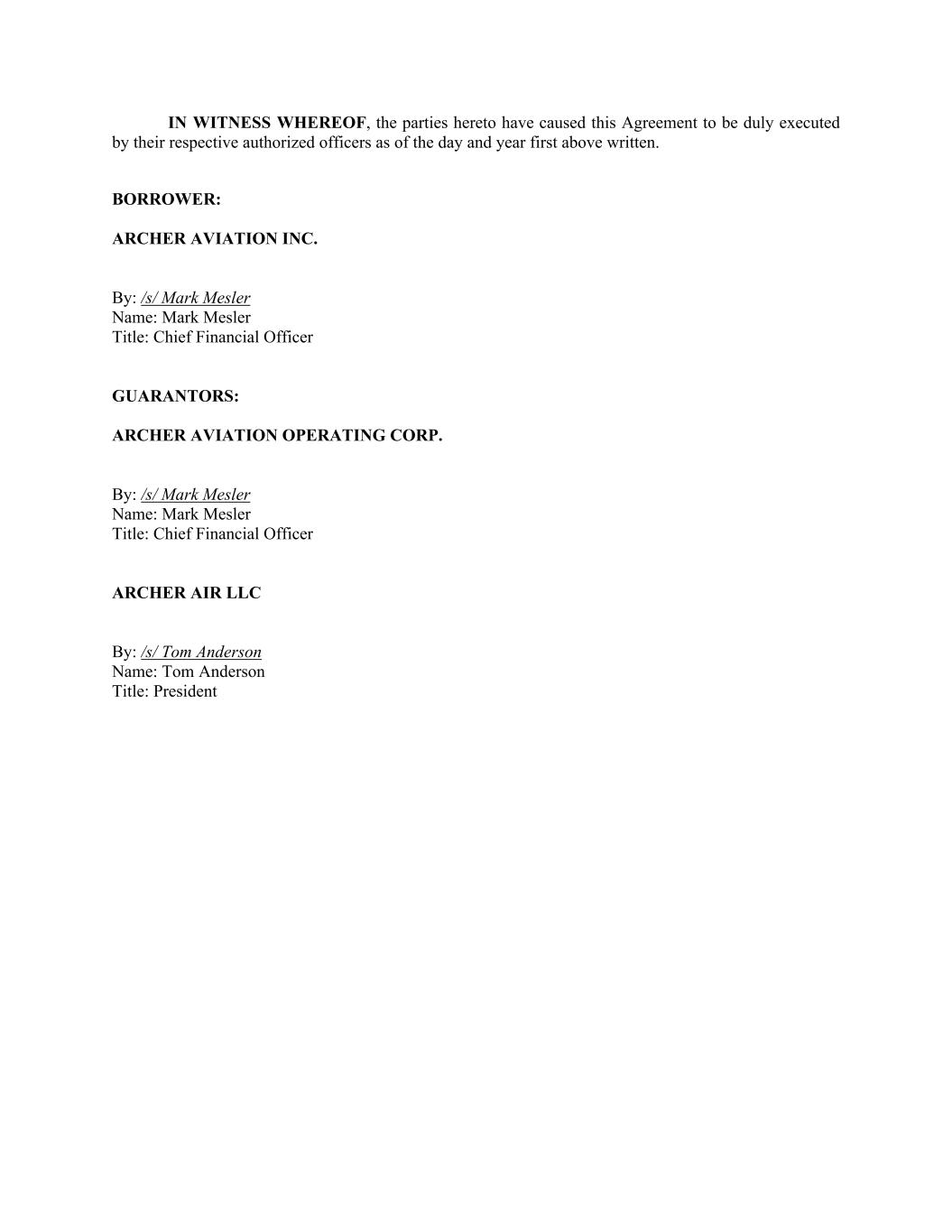
IN WITNESS WHEREOF, the parties hereto have caused this Agreement to be duly executed by their respective authorized officers as of the day and year first above written. BORROWER: ARCHER AVIATION INC. By: /s/ Mark Mesler Name: Mark Mesler Title: Chief Financial Officer GUARANTORS: ARCHER AVIATION OPERATING CORP. By: /s/ Mark Mesler Name: Mark Mesler Title: Chief Financial Officer ARCHER AIR LLC By: /s/ Tom Anderson Name: Tom Anderson Title: President

ADMINISTRATIVE SYNOVUS BANK, AGENT and LENDER: as Administrative Agent and as a Lender By: /s/ Michael Spencer Name: Michael Spencer Title: Senior Vice President

Schedule I Commitment Amounts

Schedule 4.15 Subsidiaries

Schedule 4.17-1 Business Locations; Taxpayer Identification Number and Organizational Identification Number

Schedule 4.17-2 Past Names / Structural Changes in Past Five Years

Schedule 7.1 Outstanding Indebtedness

Schedule 7.3 Existing Liens

Schedule 7.4 Existing Investments

EXHIBIT 2.3 FORM OF ADVANCE REQUEST

Schedule 1 Archer Covington Project Draw

EXHIBIT 2.7 FORM OF DDT A-1 LOAN NOTE

EXHIBIT 2.17 (1-4) FORM OF TAX COMPLIANCE CERTIFICATES

EXHIBIT 5.1 FORM OF COMPLIANCE CERTIFICATE

EXHIBIT 5.10 FORM OF GUARANTOR JOINDER

EXHIBIT 11.4 FORM OF ASSIGNMENT AND ASSUMPTION
EX-10.36
4
exhibit1036.htm
EX-10.36
exhibit1036
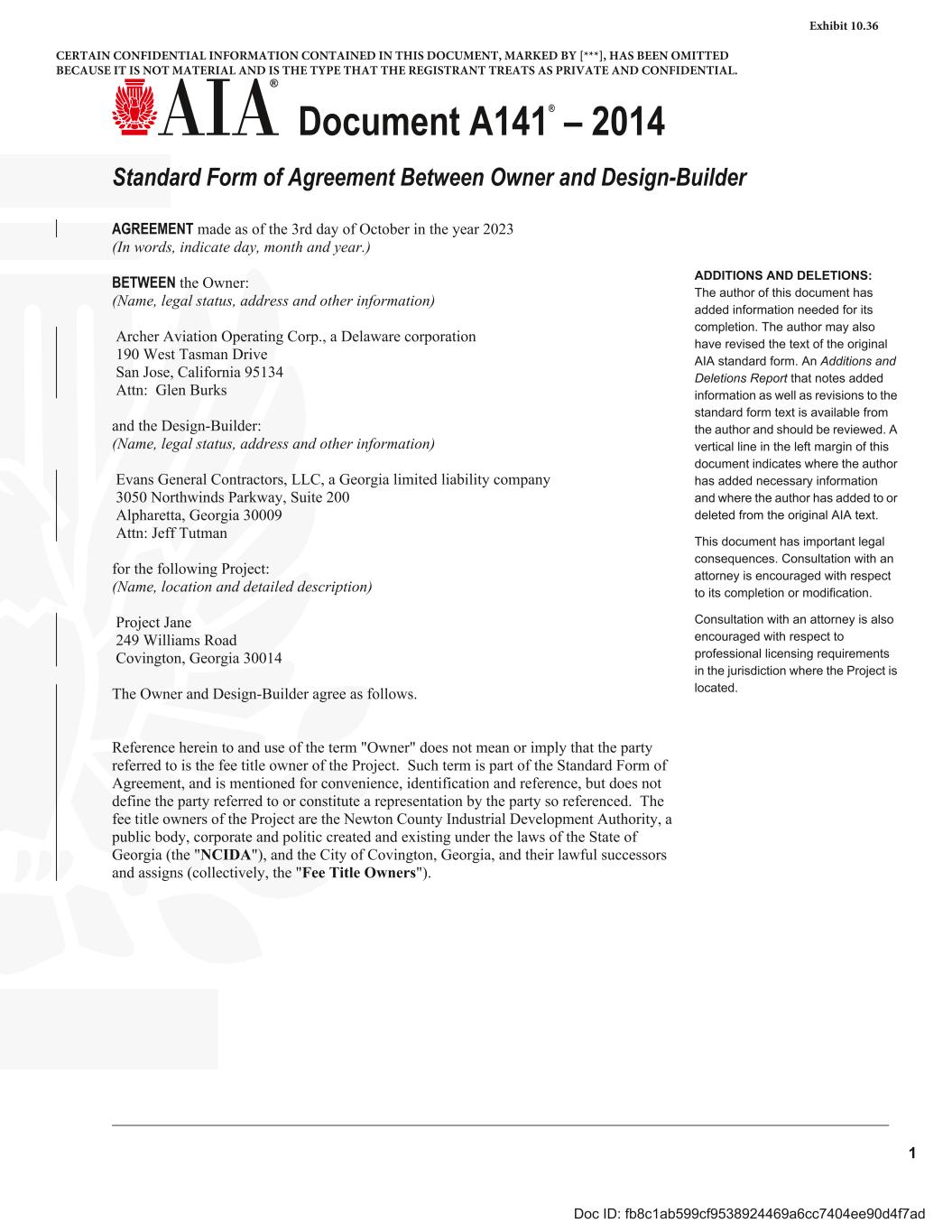
Document A141® – 2014 Standard Form of Agreement Between Owner and Design-Builder 1 ADDITIONS AND DELETIONS: The author of this document has added information needed for its completion. The author may also have revised the text of the original AIA standard form. An Additions and Deletions Report that notes added information as well as revisions to the standard form text is available from the author and should be reviewed. A vertical line in the left margin of this document indicates where the author has added necessary information and where the author has added to or deleted from the original AIA text. This document has important legal consequences. Consultation with an attorney is encouraged with respect to its completion or modification. Consultation with an attorney is also encouraged with respect to professional licensing requirements in the jurisdiction where the Project is located. AGREEMENT made as of the 3rd day of October in the year 2023 (In words, indicate day, month and year.) BETWEEN the Owner: (Name, legal status, address and other information) Archer Aviation Operating Corp., a Delaware corporation 190 West Tasman Drive San Jose, California 95134 Attn: Glen Burks and the Design-Builder: (Name, legal status, address and other information) Evans General Contractors, LLC, a Georgia limited liability company 3050 Northwinds Parkway, Suite 200 Alpharetta, Georgia 30009 Attn: Jeff Tutman for the following Project: (Name, location and detailed description) Project Jane 249 Williams Road Covington, Georgia 30014 The Owner and Design-Builder agree as follows. Reference herein to and use of the term "Owner" does not mean or imply that the party referred to is the fee title owner of the Project. Such term is part of the Standard Form of Agreement, and is mentioned for convenience, identification and reference, but does not define the party referred to or constitute a representation by the party so referenced. The fee title owners of the Project are the Newton County Industrial Development Authority, a public body, corporate and politic created and existing under the laws of the State of Georgia (the "NCIDA"), and the City of Covington, Georgia, and their lawful successors and assigns (collectively, the "Fee Title Owners"). Doc ID: fb8c1ab599cf9538924469a6cc7404ee90d4f7ad 36 CONFIDENTIAL INFORMATION CONTAINED IN THIS DOCUMENT, MARKED BY [***], HAS BEEN OMITTED IS THE TYPE THAT THE REGISTRANT TREATS AS PRIVATE AND CONFIDENTIAL.
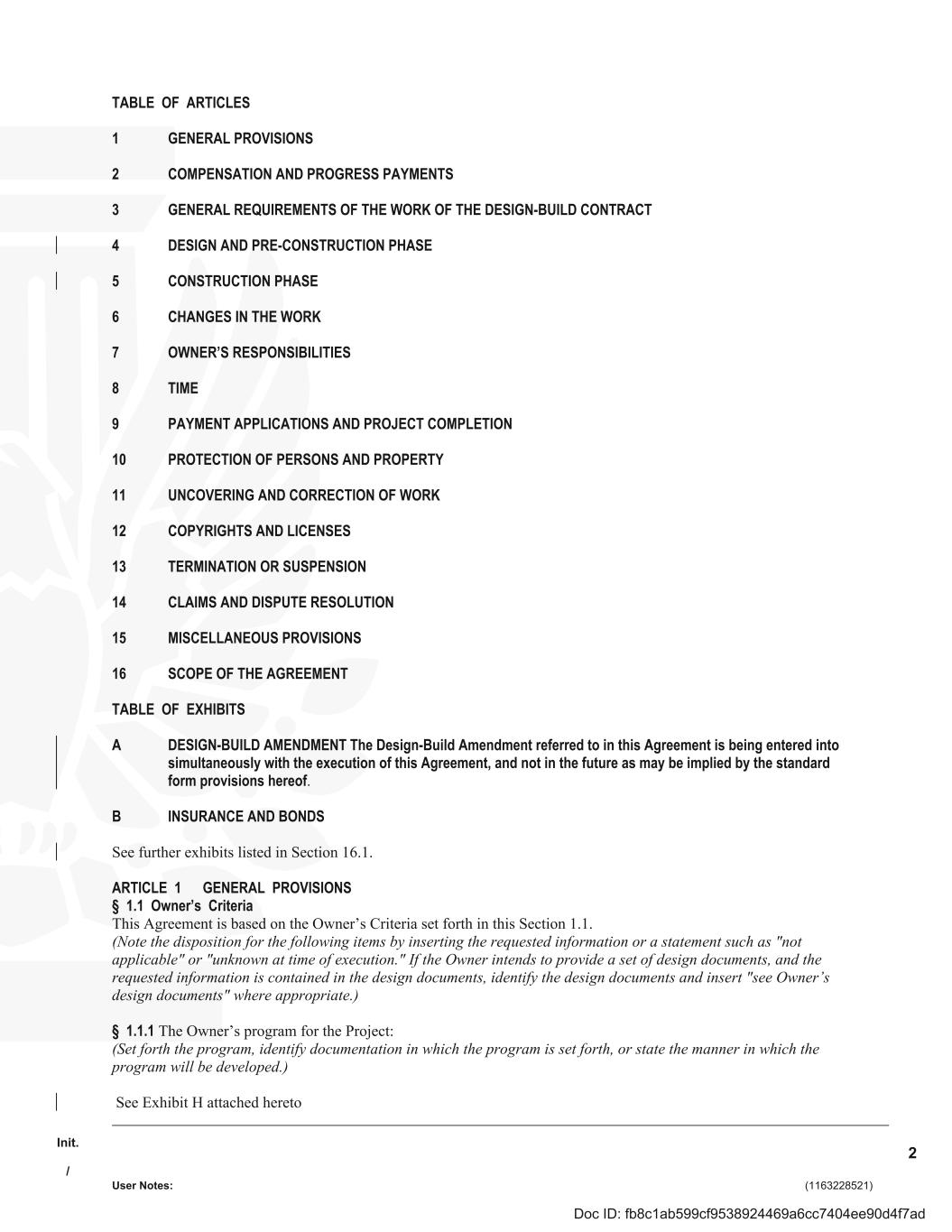
Init. / User Notes: (1163228521) 2 TABLE OF ARTICLES 1 GENERAL PROVISIONS 2 COMPENSATION AND PROGRESS PAYMENTS 3 GENERAL REQUIREMENTS OF THE WORK OF THE DESIGN-BUILD CONTRACT 4 DESIGN AND PRE-CONSTRUCTION PHASE 5 CONSTRUCTION PHASE 6 CHANGES IN THE WORK 7 OWNER’S RESPONSIBILITIES 8 TIME 9 PAYMENT APPLICATIONS AND PROJECT COMPLETION 10 PROTECTION OF PERSONS AND PROPERTY 11 UNCOVERING AND CORRECTION OF WORK 12 COPYRIGHTS AND LICENSES 13 TERMINATION OR SUSPENSION 14 CLAIMS AND DISPUTE RESOLUTION 15 MISCELLANEOUS PROVISIONS 16 SCOPE OF THE AGREEMENT TABLE OF EXHIBITS A DESIGN-BUILD AMENDMENT The Design-Build Amendment referred to in this Agreement is being entered into simultaneously with the execution of this Agreement, and not in the future as may be implied by the standard form provisions hereof. B INSURANCE AND BONDS See further exhibits listed in Section 16.1. ARTICLE 1 GENERAL PROVISIONS § 1.1 Owner’s Criteria This Agreement is based on the Owner’s Criteria set forth in this Section 1.1. (Note the disposition for the following items by inserting the requested information or a statement such as "not applicable" or "unknown at time of execution." If the Owner intends to provide a set of design documents, and the requested information is contained in the design documents, identify the design documents and insert "see Owner’s design documents" where appropriate.) § 1.1.1 The Owner’s program for the Project: (Set forth the program, identify documentation in which the program is set forth, or state the manner in which the program will be developed.) See Exhibit H attached hereto Doc ID: fb8c1ab599cf9538924469a6cc7404ee90d4f7ad
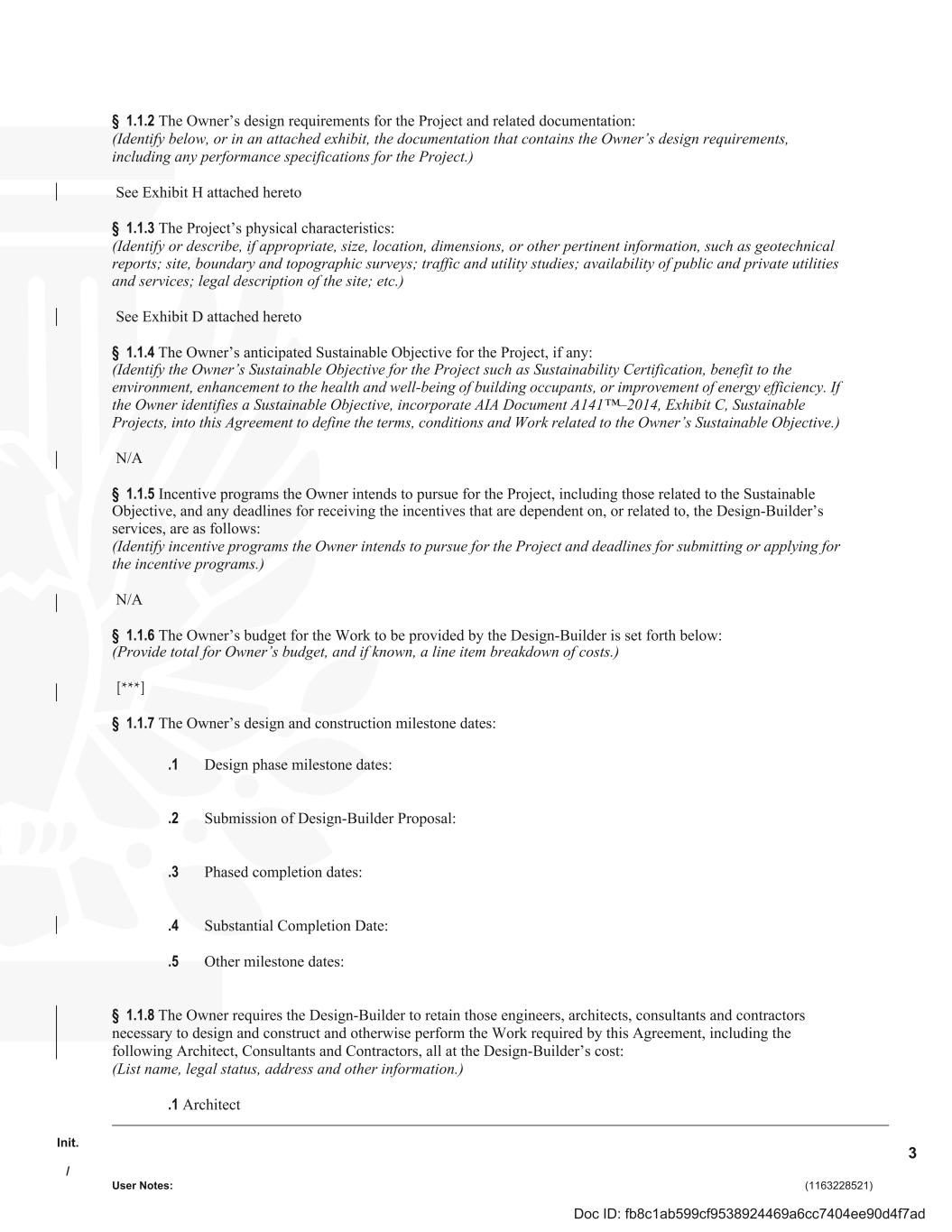
Init. / User Notes: (1163228521) 3 § 1.1.2 The Owner’s design requirements for the Project and related documentation: (Identify below, or in an attached exhibit, the documentation that contains the Owner’s design requirements, including any performance specifications for the Project.) See Exhibit H attached hereto § 1.1.3 The Project’s physical characteristics: (Identify or describe, if appropriate, size, location, dimensions, or other pertinent information, such as geotechnical reports; site, boundary and topographic surveys; traffic and utility studies; availability of public and private utilities and services; legal description of the site; etc.) See Exhibit D attached hereto § 1.1.4 The Owner’s anticipated Sustainable Objective for the Project, if any: (Identify the Owner’s Sustainable Objective for the Project such as Sustainability Certification, benefit to the environment, enhancement to the health and well-being of building occupants, or improvement of energy efficiency. If the Owner identifies a Sustainable Objective, incorporate AIA Document A141™–2014, Exhibit C, Sustainable Projects, into this Agreement to define the terms, conditions and Work related to the Owner’s Sustainable Objective.) N/A § 1.1.5 Incentive programs the Owner intends to pursue for the Project, including those related to the Sustainable Objective, and any deadlines for receiving the incentives that are dependent on, or related to, the Design-Builder’s services, are as follows: (Identify incentive programs the Owner intends to pursue for the Project and deadlines for submitting or applying for the incentive programs.) N/A § 1.1.6 The Owner’s budget for the Work to be provided by the Design-Builder is set forth below: (Provide total for Owner’s budget, and if known, a line item breakdown of costs.) [***] § 1.1.7 The Owner’s design and construction milestone dates: .1 Design phase milestone dates: .2 Submission of Design-Builder Proposal: .3 Phased completion dates: .4 Substantial Completion Date: .5 Other milestone dates: § 1.1.8 The Owner requires the Design-Builder to retain those engineers, architects, consultants and contractors necessary to design and construct and otherwise perform the Work required by this Agreement, including the following Architect, Consultants and Contractors, all at the Design-Builder’s cost: (List name, legal status, address and other information.) .1 Architect Doc ID: fb8c1ab599cf9538924469a6cc7404ee90d4f7ad
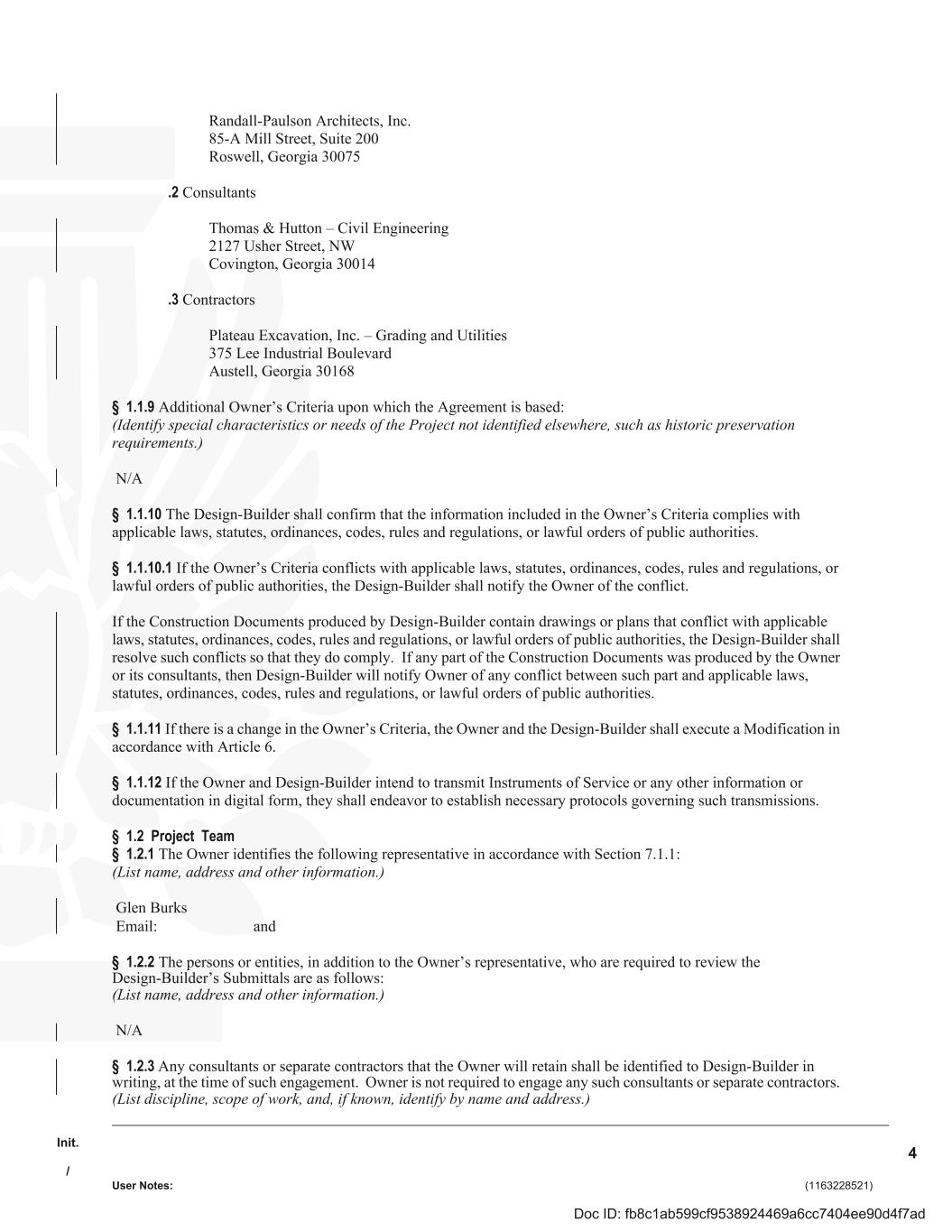
Init. / User Notes: (1163228521) 4 Randall-Paulson Architects, Inc. 85-A Mill Street, Suite 200 Roswell, Georgia 30075 .2 Consultants Thomas & Hutton – Civil Engineering 2127 Usher Street, NW Covington, Georgia 30014 .3 Contractors Plateau Excavation, Inc. – Grading and Utilities 375 Lee Industrial Boulevard Austell, Georgia 30168 § 1.1.9 Additional Owner’s Criteria upon which the Agreement is based: (Identify special characteristics or needs of the Project not identified elsewhere, such as historic preservation requirements.) N/A § 1.1.10 The Design-Builder shall confirm that the information included in the Owner’s Criteria complies with applicable laws, statutes, ordinances, codes, rules and regulations, or lawful orders of public authorities. § 1.1.10.1 If the Owner’s Criteria conflicts with applicable laws, statutes, ordinances, codes, rules and regulations, or lawful orders of public authorities, the Design-Builder shall notify the Owner of the conflict. If the Construction Documents produced by Design-Builder contain drawings or plans that conflict with applicable laws, statutes, ordinances, codes, rules and regulations, or lawful orders of public authorities, the Design-Builder shall resolve such conflicts so that they do comply. If any part of the Construction Documents was produced by the Owner or its consultants, then Design-Builder will notify Owner of any conflict between such part and applicable laws, statutes, ordinances, codes, rules and regulations, or lawful orders of public authorities. § 1.1.11 If there is a change in the Owner’s Criteria, the Owner and the Design-Builder shall execute a Modification in accordance with Article 6. § 1.1.12 If the Owner and Design-Builder intend to transmit Instruments of Service or any other information or documentation in digital form, they shall endeavor to establish necessary protocols governing such transmissions. § 1.2 Project Team § 1.2.1 The Owner identifies the following representative in accordance with Section 7.1.1: (List name, address and other information.) Glen Burks Email: and § 1.2.2 The persons or entities, in addition to the Owner’s representative, who are required to review the Design-Builder’s Submittals are as follows: (List name, address and other information.) N/A § 1.2.3 Any consultants or separate contractors that the Owner will retain shall be identified to Design-Builder in writing, at the time of such engagement. Owner is not required to engage any such consultants or separate contractors. (List discipline, scope of work, and, if known, identify by name and address.) Doc ID: fb8c1ab599cf9538924469a6cc7404ee90d4f7ad
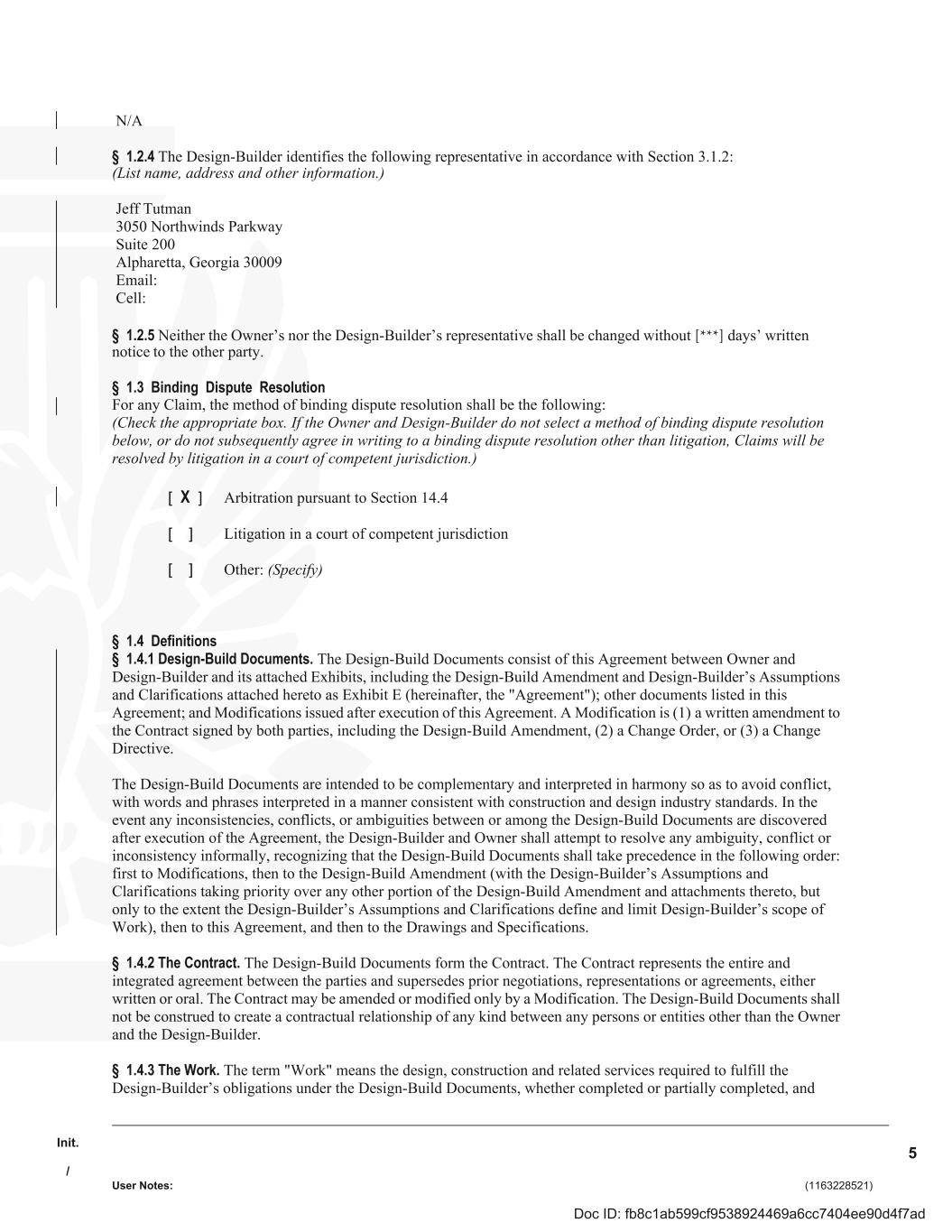
Init. / User Notes: (1163228521) 5 N/A § 1.2.4 The Design-Builder identifies the following representative in accordance with Section 3.1.2: (List name, address and other information.) Jeff Tutman 3050 Northwinds Parkway Suite 200 Alpharetta, Georgia 30009 Email: Cell: § 1.2.5 Neither the Owner’s nor the Design-Builder’s representative shall be changed without [***] days’ written notice to the other party. § 1.3 Binding Dispute Resolution For any Claim, the method of binding dispute resolution shall be the following: (Check the appropriate box. If the Owner and Design-Builder do not select a method of binding dispute resolution below, or do not subsequently agree in writing to a binding dispute resolution other than litigation, Claims will be resolved by litigation in a court of competent jurisdiction.) [ X ] Arbitration pursuant to Section 14.4 [ ] Litigation in a court of competent jurisdiction [ ] Other: (Specify) § 1.4 Definitions § 1.4.1 Design-Build Documents. The Design-Build Documents consist of this Agreement between Owner and Design-Builder and its attached Exhibits, including the Design-Build Amendment and Design-Builder’s Assumptions and Clarifications attached hereto as Exhibit E (hereinafter, the "Agreement"); other documents listed in this Agreement; and Modifications issued after execution of this Agreement. A Modification is (1) a written amendment to the Contract signed by both parties, including the Design-Build Amendment, (2) a Change Order, or (3) a Change Directive. The Design-Build Documents are intended to be complementary and interpreted in harmony so as to avoid conflict, with words and phrases interpreted in a manner consistent with construction and design industry standards. In the event any inconsistencies, conflicts, or ambiguities between or among the Design-Build Documents are discovered after execution of the Agreement, the Design-Builder and Owner shall attempt to resolve any ambiguity, conflict or inconsistency informally, recognizing that the Design-Build Documents shall take precedence in the following order: first to Modifications, then to the Design-Build Amendment (with the Design-Builder’s Assumptions and Clarifications taking priority over any other portion of the Design-Build Amendment and attachments thereto, but only to the extent the Design-Builder’s Assumptions and Clarifications define and limit Design-Builder’s scope of Work), then to this Agreement, and then to the Drawings and Specifications. § 1.4.2 The Contract. The Design-Build Documents form the Contract. The Contract represents the entire and integrated agreement between the parties and supersedes prior negotiations, representations or agreements, either written or oral. The Contract may be amended or modified only by a Modification. The Design-Build Documents shall not be construed to create a contractual relationship of any kind between any persons or entities other than the Owner and the Design-Builder. § 1.4.3 The Work. The term "Work" means the design, construction and related services required to fulfill the Design-Builder’s obligations under the Design-Build Documents, whether completed or partially completed, and Doc ID: fb8c1ab599cf9538924469a6cc7404ee90d4f7ad
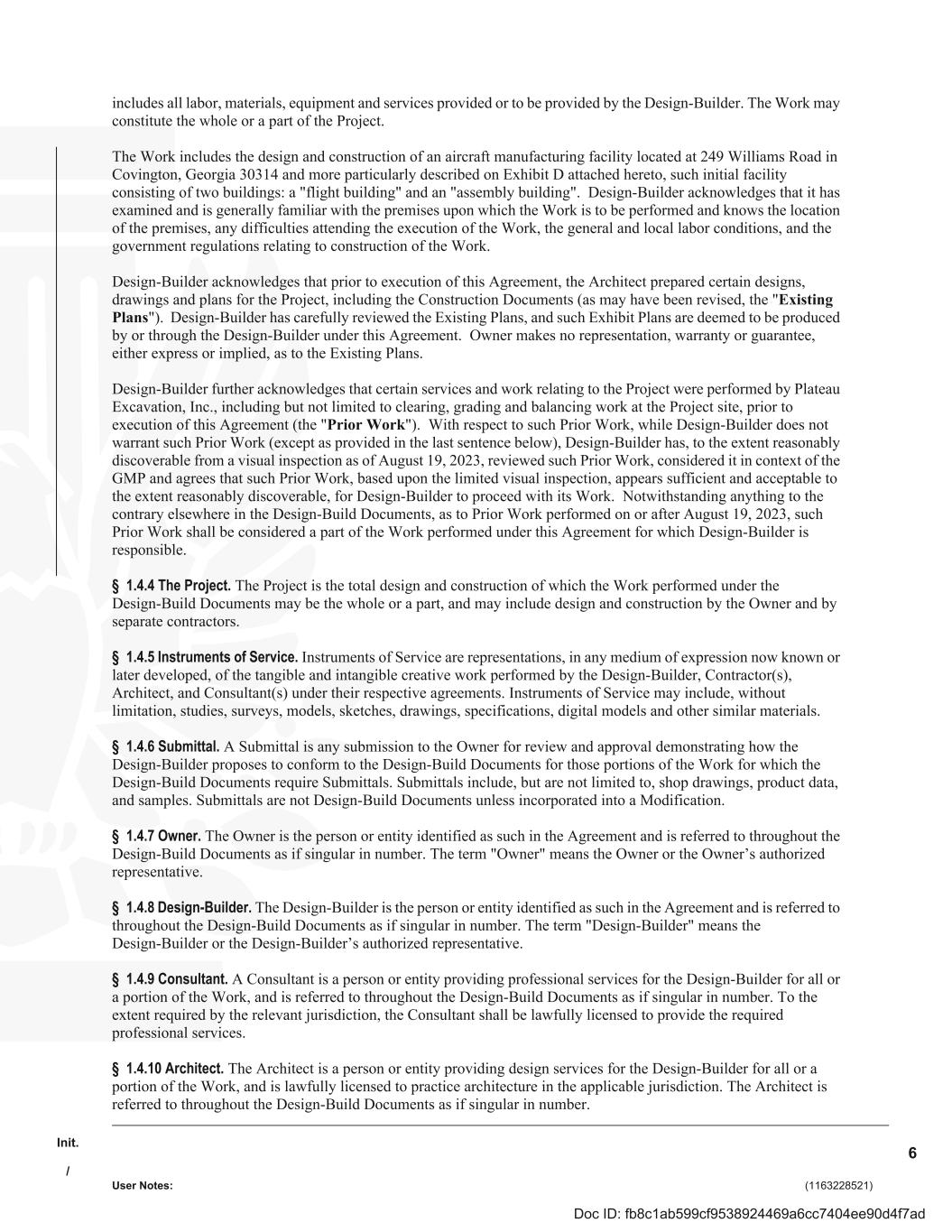
Init. / User Notes: (1163228521) 6 includes all labor, materials, equipment and services provided or to be provided by the Design-Builder. The Work may constitute the whole or a part of the Project. The Work includes the design and construction of an aircraft manufacturing facility located at 249 Williams Road in Covington, Georgia 30314 and more particularly described on Exhibit D attached hereto, such initial facility consisting of two buildings: a "flight building" and an "assembly building". Design-Builder acknowledges that it has examined and is generally familiar with the premises upon which the Work is to be performed and knows the location of the premises, any difficulties attending the execution of the Work, the general and local labor conditions, and the government regulations relating to construction of the Work. Design-Builder acknowledges that prior to execution of this Agreement, the Architect prepared certain designs, drawings and plans for the Project, including the Construction Documents (as may have been revised, the "Existing Plans"). Design-Builder has carefully reviewed the Existing Plans, and such Exhibit Plans are deemed to be produced by or through the Design-Builder under this Agreement. Owner makes no representation, warranty or guarantee, either express or implied, as to the Existing Plans. Design-Builder further acknowledges that certain services and work relating to the Project were performed by Plateau Excavation, Inc., including but not limited to clearing, grading and balancing work at the Project site, prior to execution of this Agreement (the "Prior Work"). With respect to such Prior Work, while Design-Builder does not warrant such Prior Work (except as provided in the last sentence below), Design-Builder has, to the extent reasonably discoverable from a visual inspection as of August 19, 2023, reviewed such Prior Work, considered it in context of the GMP and agrees that such Prior Work, based upon the limited visual inspection, appears sufficient and acceptable to the extent reasonably discoverable, for Design-Builder to proceed with its Work. Notwithstanding anything to the contrary elsewhere in the Design-Build Documents, as to Prior Work performed on or after August 19, 2023, such Prior Work shall be considered a part of the Work performed under this Agreement for which Design-Builder is responsible. § 1.4.4 The Project. The Project is the total design and construction of which the Work performed under the Design-Build Documents may be the whole or a part, and may include design and construction by the Owner and by separate contractors. § 1.4.5 Instruments of Service. Instruments of Service are representations, in any medium of expression now known or later developed, of the tangible and intangible creative work performed by the Design-Builder, Contractor(s), Architect, and Consultant(s) under their respective agreements. Instruments of Service may include, without limitation, studies, surveys, models, sketches, drawings, specifications, digital models and other similar materials. § 1.4.6 Submittal. A Submittal is any submission to the Owner for review and approval demonstrating how the Design-Builder proposes to conform to the Design-Build Documents for those portions of the Work for which the Design-Build Documents require Submittals. Submittals include, but are not limited to, shop drawings, product data, and samples. Submittals are not Design-Build Documents unless incorporated into a Modification. § 1.4.7 Owner. The Owner is the person or entity identified as such in the Agreement and is referred to throughout the Design-Build Documents as if singular in number. The term "Owner" means the Owner or the Owner’s authorized representative. § 1.4.8 Design-Builder. The Design-Builder is the person or entity identified as such in the Agreement and is referred to throughout the Design-Build Documents as if singular in number. The term "Design-Builder" means the Design-Builder or the Design-Builder’s authorized representative. § 1.4.9 Consultant. A Consultant is a person or entity providing professional services for the Design-Builder for all or a portion of the Work, and is referred to throughout the Design-Build Documents as if singular in number. To the extent required by the relevant jurisdiction, the Consultant shall be lawfully licensed to provide the required professional services. § 1.4.10 Architect. The Architect is a person or entity providing design services for the Design-Builder for all or a portion of the Work, and is lawfully licensed to practice architecture in the applicable jurisdiction. The Architect is referred to throughout the Design-Build Documents as if singular in number. Doc ID: fb8c1ab599cf9538924469a6cc7404ee90d4f7ad
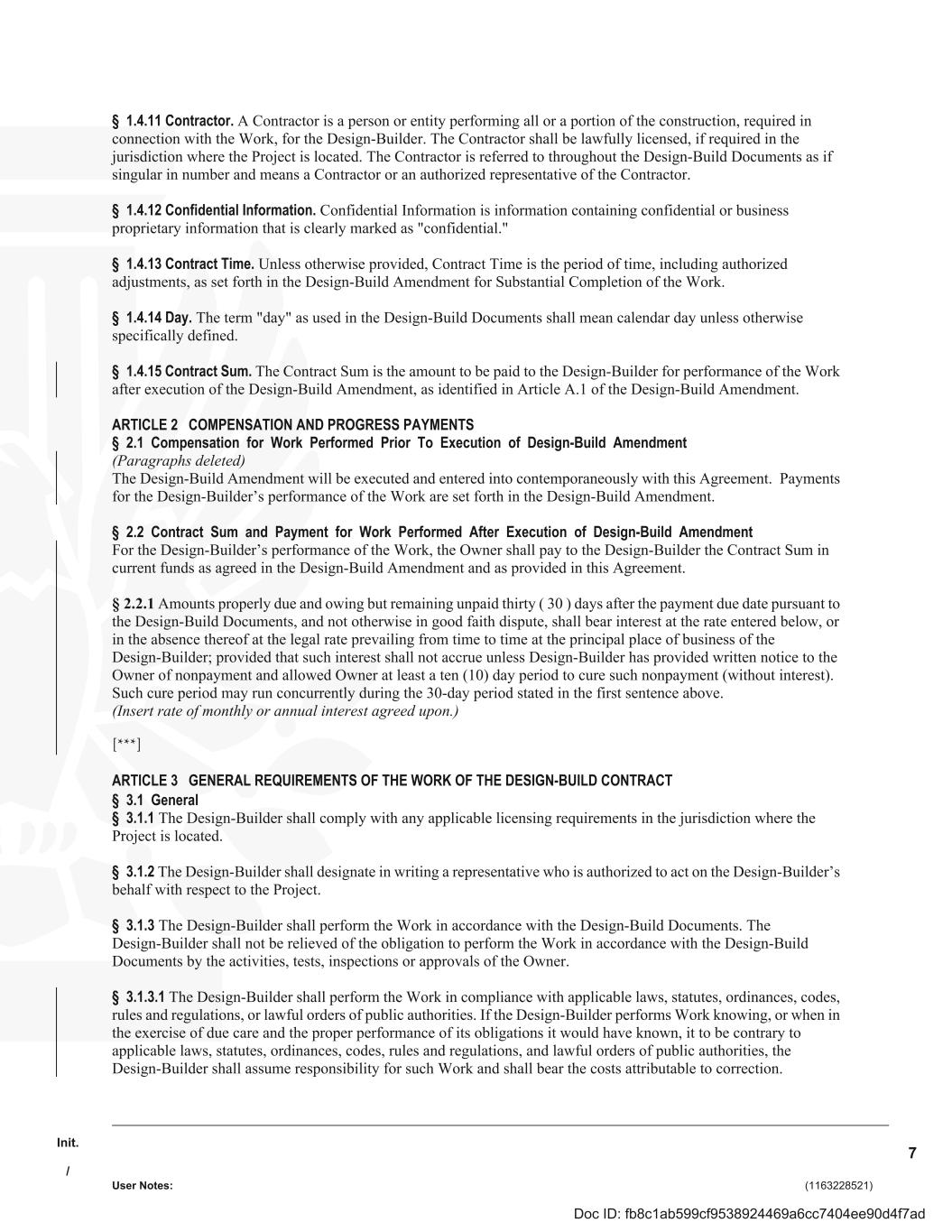
Init. / User Notes: (1163228521) 7 § 1.4.11 Contractor. A Contractor is a person or entity performing all or a portion of the construction, required in connection with the Work, for the Design-Builder. The Contractor shall be lawfully licensed, if required in the jurisdiction where the Project is located. The Contractor is referred to throughout the Design-Build Documents as if singular in number and means a Contractor or an authorized representative of the Contractor. § 1.4.12 Confidential Information. Confidential Information is information containing confidential or business proprietary information that is clearly marked as "confidential." § 1.4.13 Contract Time. Unless otherwise provided, Contract Time is the period of time, including authorized adjustments, as set forth in the Design-Build Amendment for Substantial Completion of the Work. § 1.4.14 Day. The term "day" as used in the Design-Build Documents shall mean calendar day unless otherwise specifically defined. § 1.4.15 Contract Sum. The Contract Sum is the amount to be paid to the Design-Builder for performance of the Work after execution of the Design-Build Amendment, as identified in Article A.1 of the Design-Build Amendment. ARTICLE 2 COMPENSATION AND PROGRESS PAYMENTS § 2.1 Compensation for Work Performed Prior To Execution of Design-Build Amendment (Paragraphs deleted) The Design-Build Amendment will be executed and entered into contemporaneously with this Agreement. Payments for the Design-Builder’s performance of the Work are set forth in the Design-Build Amendment. § 2.2 Contract Sum and Payment for Work Performed After Execution of Design-Build Amendment For the Design-Builder’s performance of the Work, the Owner shall pay to the Design-Builder the Contract Sum in current funds as agreed in the Design-Build Amendment and as provided in this Agreement. § 2.2.1 Amounts properly due and owing but remaining unpaid thirty ( 30 ) days after the payment due date pursuant to the Design-Build Documents, and not otherwise in good faith dispute, shall bear interest at the rate entered below, or in the absence thereof at the legal rate prevailing from time to time at the principal place of business of the Design-Builder; provided that such interest shall not accrue unless Design-Builder has provided written notice to the Owner of nonpayment and allowed Owner at least a ten (10) day period to cure such nonpayment (without interest). Such cure period may run concurrently during the 30-day period stated in the first sentence above. (Insert rate of monthly or annual interest agreed upon.) [***] ARTICLE 3 GENERAL REQUIREMENTS OF THE WORK OF THE DESIGN-BUILD CONTRACT § 3.1 General § 3.1.1 The Design-Builder shall comply with any applicable licensing requirements in the jurisdiction where the Project is located. § 3.1.2 The Design-Builder shall designate in writing a representative who is authorized to act on the Design-Builder’s behalf with respect to the Project. § 3.1.3 The Design-Builder shall perform the Work in accordance with the Design-Build Documents. The Design-Builder shall not be relieved of the obligation to perform the Work in accordance with the Design-Build Documents by the activities, tests, inspections or approvals of the Owner. § 3.1.3.1 The Design-Builder shall perform the Work in compliance with applicable laws, statutes, ordinances, codes, rules and regulations, or lawful orders of public authorities. If the Design-Builder performs Work knowing, or when in the exercise of due care and the proper performance of its obligations it would have known, it to be contrary to applicable laws, statutes, ordinances, codes, rules and regulations, and lawful orders of public authorities, the Design-Builder shall assume responsibility for such Work and shall bear the costs attributable to correction. Doc ID: fb8c1ab599cf9538924469a6cc7404ee90d4f7ad
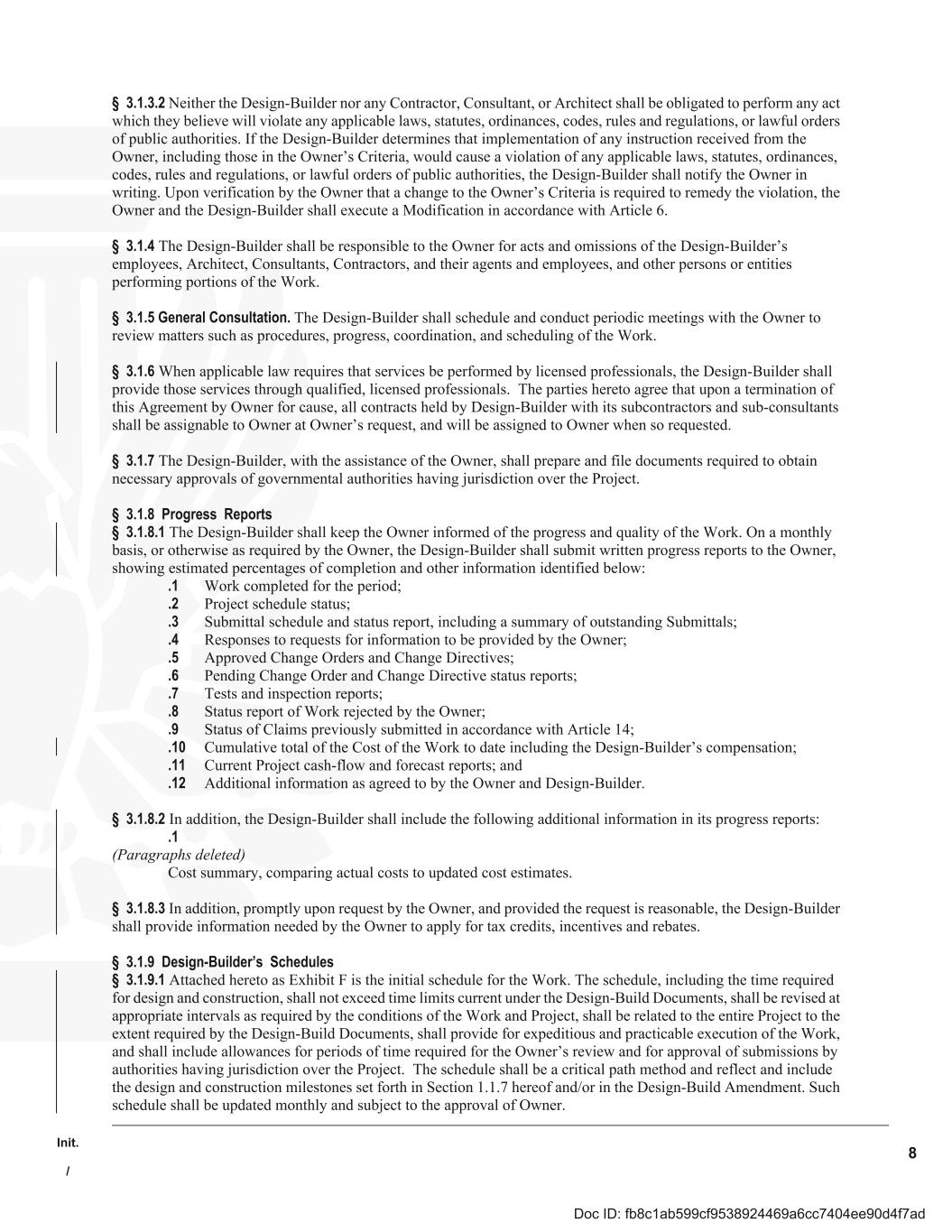
Init. / 8 § 3.1.3.2 Neither the Design-Builder nor any Contractor, Consultant, or Architect shall be obligated to perform any act which they believe will violate any applicable laws, statutes, ordinances, codes, rules and regulations, or lawful orders of public authorities. If the Design-Builder determines that implementation of any instruction received from the Owner, including those in the Owner’s Criteria, would cause a violation of any applicable laws, statutes, ordinances, codes, rules and regulations, or lawful orders of public authorities, the Design-Builder shall notify the Owner in writing. Upon verification by the Owner that a change to the Owner’s Criteria is required to remedy the violation, the Owner and the Design-Builder shall execute a Modification in accordance with Article 6. § 3.1.4 The Design-Builder shall be responsible to the Owner for acts and omissions of the Design-Builder’s employees, Architect, Consultants, Contractors, and their agents and employees, and other persons or entities performing portions of the Work. § 3.1.5 General Consultation. The Design-Builder shall schedule and conduct periodic meetings with the Owner to review matters such as procedures, progress, coordination, and scheduling of the Work. § 3.1.6 When applicable law requires that services be performed by licensed professionals, the Design-Builder shall provide those services through qualified, licensed professionals. The parties hereto agree that upon a termination of this Agreement by Owner for cause, all contracts held by Design-Builder with its subcontractors and sub-consultants shall be assignable to Owner at Owner’s request, and will be assigned to Owner when so requested. § 3.1.7 The Design-Builder, with the assistance of the Owner, shall prepare and file documents required to obtain necessary approvals of governmental authorities having jurisdiction over the Project. § 3.1.8 Progress Reports § 3.1.8.1 The Design-Builder shall keep the Owner informed of the progress and quality of the Work. On a monthly basis, or otherwise as required by the Owner, the Design-Builder shall submit written progress reports to the Owner, showing estimated percentages of completion and other information identified below: .1 Work completed for the period; .2 Project schedule status; .3 Submittal schedule and status report, including a summary of outstanding Submittals; .4 Responses to requests for information to be provided by the Owner; .5 Approved Change Orders and Change Directives; .6 Pending Change Order and Change Directive status reports; .7 Tests and inspection reports; .8 Status report of Work rejected by the Owner; .9 Status of Claims previously submitted in accordance with Article 14; .10 Cumulative total of the Cost of the Work to date including the Design-Builder’s compensation; .11 Current Project cash-flow and forecast reports; and .12 Additional information as agreed to by the Owner and Design-Builder. § 3.1.8.2 In addition, the Design-Builder shall include the following additional information in its progress reports: .1 (Paragraphs deleted) Cost summary, comparing actual costs to updated cost estimates. § 3.1.8.3 In addition, promptly upon request by the Owner, and provided the request is reasonable, the Design-Builder shall provide information needed by the Owner to apply for tax credits, incentives and rebates. § 3.1.9 Design-Builder’s Schedules § 3.1.9.1 Attached hereto as Exhibit F is the initial schedule for the Work. The schedule, including the time required for design and construction, shall not exceed time limits current under the Design-Build Documents, shall be revised at appropriate intervals as required by the conditions of the Work and Project, shall be related to the entire Project to the extent required by the Design-Build Documents, shall provide for expeditious and practicable execution of the Work, and shall include allowances for periods of time required for the Owner’s review and for approval of submissions by authorities having jurisdiction over the Project. The schedule shall be a critical path method and reflect and include the design and construction milestones set forth in Section 1.1.7 hereof and/or in the Design-Build Amendment. Such schedule shall be updated monthly and subject to the approval of Owner. Doc ID: fb8c1ab599cf9538924469a6cc7404ee90d4f7ad
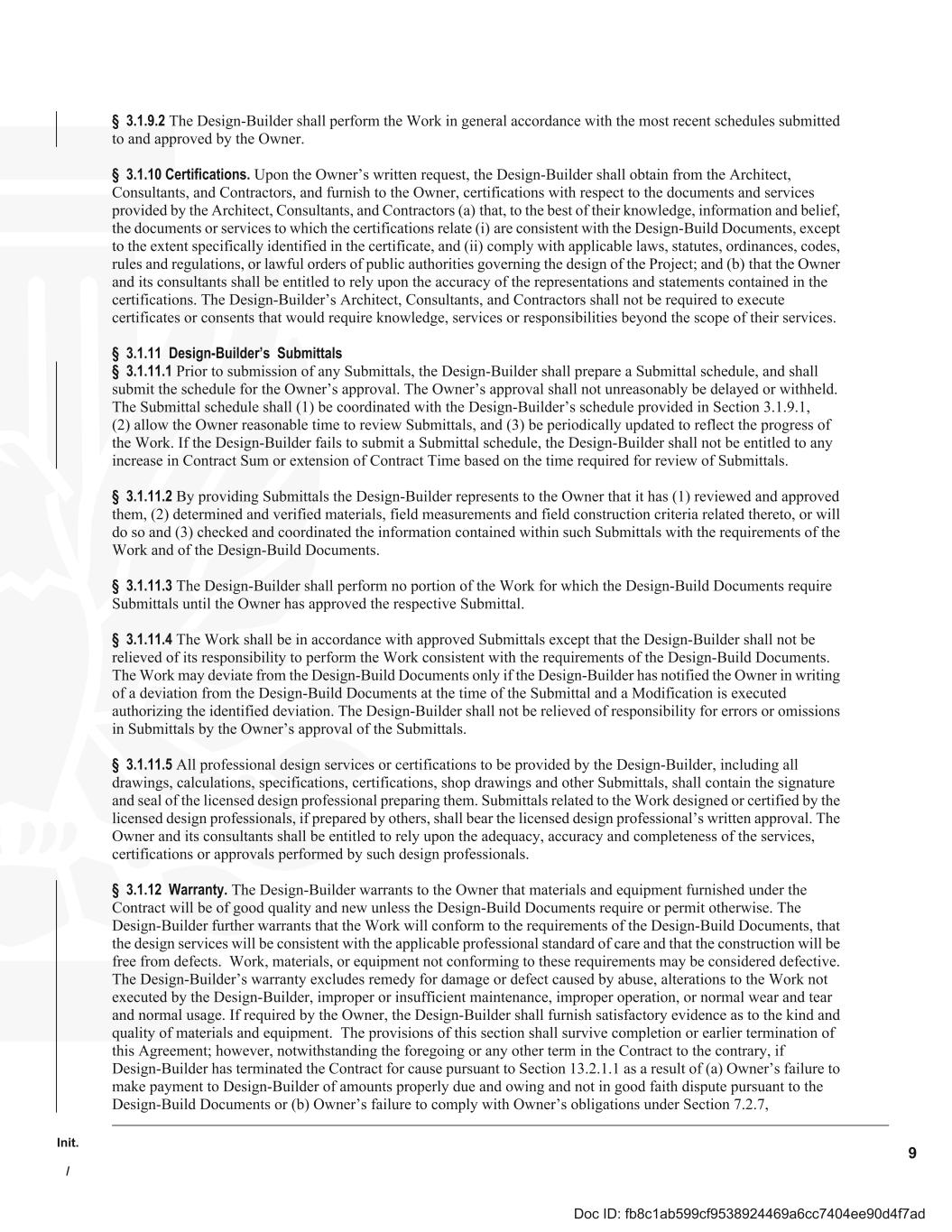
Init. / 9 § 3.1.9.2 The Design-Builder shall perform the Work in general accordance with the most recent schedules submitted to and approved by the Owner. § 3.1.10 Certifications. Upon the Owner’s written request, the Design-Builder shall obtain from the Architect, Consultants, and Contractors, and furnish to the Owner, certifications with respect to the documents and services provided by the Architect, Consultants, and Contractors (a) that, to the best of their knowledge, information and belief, the documents or services to which the certifications relate (i) are consistent with the Design-Build Documents, except to the extent specifically identified in the certificate, and (ii) comply with applicable laws, statutes, ordinances, codes, rules and regulations, or lawful orders of public authorities governing the design of the Project; and (b) that the Owner and its consultants shall be entitled to rely upon the accuracy of the representations and statements contained in the certifications. The Design-Builder’s Architect, Consultants, and Contractors shall not be required to execute certificates or consents that would require knowledge, services or responsibilities beyond the scope of their services. § 3.1.11 Design-Builder’s Submittals § 3.1.11.1 Prior to submission of any Submittals, the Design-Builder shall prepare a Submittal schedule, and shall submit the schedule for the Owner’s approval. The Owner’s approval shall not unreasonably be delayed or withheld. The Submittal schedule shall (1) be coordinated with the Design-Builder’s schedule provided in Section 3.1.9.1, (2) allow the Owner reasonable time to review Submittals, and (3) be periodically updated to reflect the progress of the Work. If the Design-Builder fails to submit a Submittal schedule, the Design-Builder shall not be entitled to any increase in Contract Sum or extension of Contract Time based on the time required for review of Submittals. § 3.1.11.2 By providing Submittals the Design-Builder represents to the Owner that it has (1) reviewed and approved them, (2) determined and verified materials, field measurements and field construction criteria related thereto, or will do so and (3) checked and coordinated the information contained within such Submittals with the requirements of the Work and of the Design-Build Documents. § 3.1.11.3 The Design-Builder shall perform no portion of the Work for which the Design-Build Documents require Submittals until the Owner has approved the respective Submittal. § 3.1.11.4 The Work shall be in accordance with approved Submittals except that the Design-Builder shall not be relieved of its responsibility to perform the Work consistent with the requirements of the Design-Build Documents. The Work may deviate from the Design-Build Documents only if the Design-Builder has notified the Owner in writing of a deviation from the Design-Build Documents at the time of the Submittal and a Modification is executed authorizing the identified deviation. The Design-Builder shall not be relieved of responsibility for errors or omissions in Submittals by the Owner’s approval of the Submittals. § 3.1.11.5 All professional design services or certifications to be provided by the Design-Builder, including all drawings, calculations, specifications, certifications, shop drawings and other Submittals, shall contain the signature and seal of the licensed design professional preparing them. Submittals related to the Work designed or certified by the licensed design professionals, if prepared by others, shall bear the licensed design professional’s written approval. The Owner and its consultants shall be entitled to rely upon the adequacy, accuracy and completeness of the services, certifications or approvals performed by such design professionals. § 3.1.12 Warranty. The Design-Builder warrants to the Owner that materials and equipment furnished under the Contract will be of good quality and new unless the Design-Build Documents require or permit otherwise. The Design-Builder further warrants that the Work will conform to the requirements of the Design-Build Documents, that the design services will be consistent with the applicable professional standard of care and that the construction will be free from defects. Work, materials, or equipment not conforming to these requirements may be considered defective. The Design-Builder’s warranty excludes remedy for damage or defect caused by abuse, alterations to the Work not executed by the Design-Builder, improper or insufficient maintenance, improper operation, or normal wear and tear and normal usage. If required by the Owner, the Design-Builder shall furnish satisfactory evidence as to the kind and quality of materials and equipment. The provisions of this section shall survive completion or earlier termination of this Agreement; however, notwithstanding the foregoing or any other term in the Contract to the contrary, if Design-Builder has terminated the Contract for cause pursuant to Section 13.2.1.1 as a result of (a) Owner’s failure to make payment to Design-Builder of amounts properly due and owing and not in good faith dispute pursuant to the Design-Build Documents or (b) Owner’s failure to comply with Owner’s obligations under Section 7.2.7, Doc ID: fb8c1ab599cf9538924469a6cc7404ee90d4f7ad
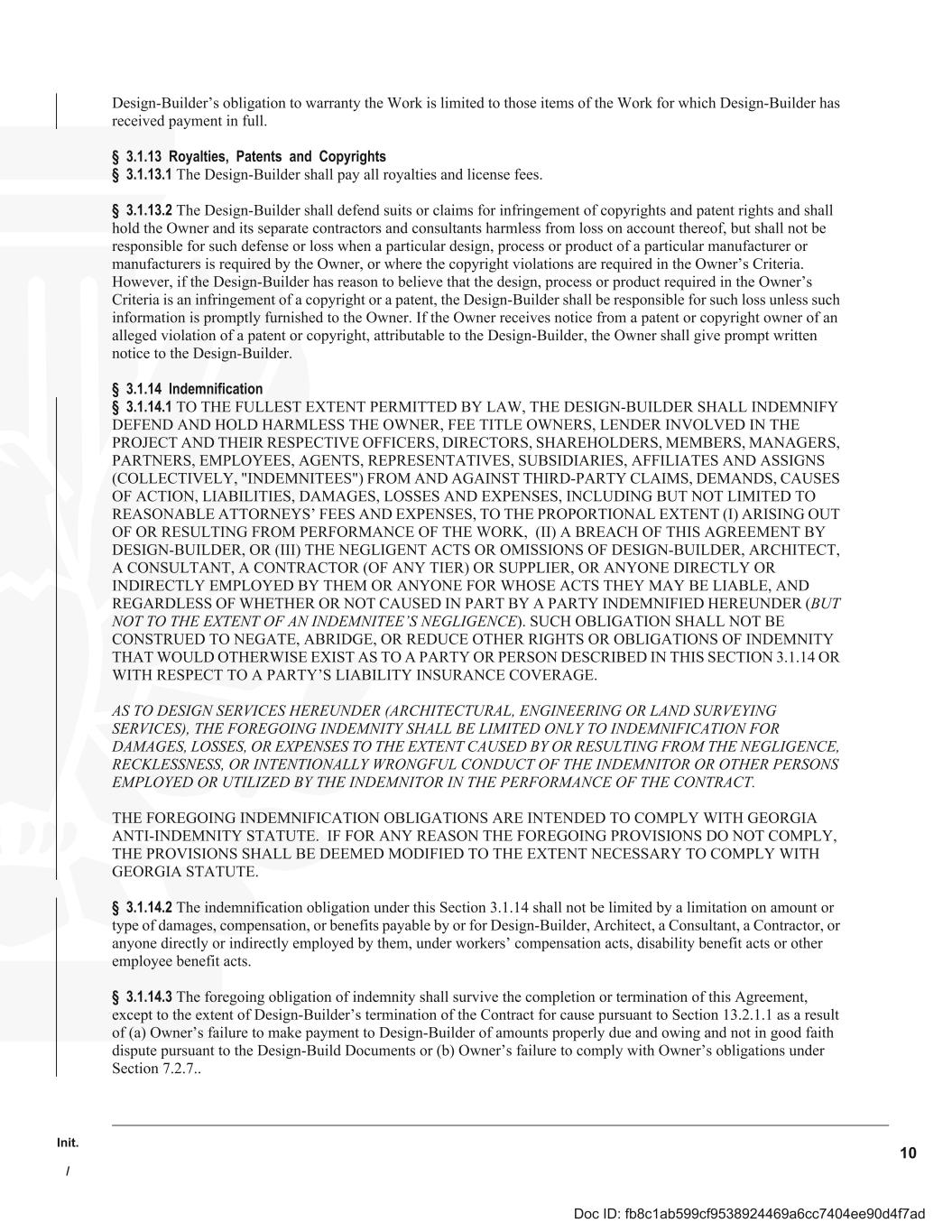
Init. / 10 Design-Builder’s obligation to warranty the Work is limited to those items of the Work for which Design-Builder has received payment in full. § 3.1.13 Royalties, Patents and Copyrights § 3.1.13.1 The Design-Builder shall pay all royalties and license fees. § 3.1.13.2 The Design-Builder shall defend suits or claims for infringement of copyrights and patent rights and shall hold the Owner and its separate contractors and consultants harmless from loss on account thereof, but shall not be responsible for such defense or loss when a particular design, process or product of a particular manufacturer or manufacturers is required by the Owner, or where the copyright violations are required in the Owner’s Criteria. However, if the Design-Builder has reason to believe that the design, process or product required in the Owner’s Criteria is an infringement of a copyright or a patent, the Design-Builder shall be responsible for such loss unless such information is promptly furnished to the Owner. If the Owner receives notice from a patent or copyright owner of an alleged violation of a patent or copyright, attributable to the Design-Builder, the Owner shall give prompt written notice to the Design-Builder. § 3.1.14 Indemnification § 3.1.14.1 TO THE FULLEST EXTENT PERMITTED BY LAW, THE DESIGN-BUILDER SHALL INDEMNIFY DEFEND AND HOLD HARMLESS THE OWNER, FEE TITLE OWNERS, LENDER INVOLVED IN THE PROJECT AND THEIR RESPECTIVE OFFICERS, DIRECTORS, SHAREHOLDERS, MEMBERS, MANAGERS, PARTNERS, EMPLOYEES, AGENTS, REPRESENTATIVES, SUBSIDIARIES, AFFILIATES AND ASSIGNS (COLLECTIVELY, "INDEMNITEES") FROM AND AGAINST THIRD-PARTY CLAIMS, DEMANDS, CAUSES OF ACTION, LIABILITIES, DAMAGES, LOSSES AND EXPENSES, INCLUDING BUT NOT LIMITED TO REASONABLE ATTORNEYS’ FEES AND EXPENSES, TO THE PROPORTIONAL EXTENT (I) ARISING OUT OF OR RESULTING FROM PERFORMANCE OF THE WORK, (II) A BREACH OF THIS AGREEMENT BY DESIGN-BUILDER, OR (III) THE NEGLIGENT ACTS OR OMISSIONS OF DESIGN-BUILDER, ARCHITECT, A CONSULTANT, A CONTRACTOR (OF ANY TIER) OR SUPPLIER, OR ANYONE DIRECTLY OR INDIRECTLY EMPLOYED BY THEM OR ANYONE FOR WHOSE ACTS THEY MAY BE LIABLE, AND REGARDLESS OF WHETHER OR NOT CAUSED IN PART BY A PARTY INDEMNIFIED HEREUNDER (BUT NOT TO THE EXTENT OF AN INDEMNITEE’S NEGLIGENCE). SUCH OBLIGATION SHALL NOT BE CONSTRUED TO NEGATE, ABRIDGE, OR REDUCE OTHER RIGHTS OR OBLIGATIONS OF INDEMNITY THAT WOULD OTHERWISE EXIST AS TO A PARTY OR PERSON DESCRIBED IN THIS SECTION 3.1.14 OR WITH RESPECT TO A PARTY’S LIABILITY INSURANCE COVERAGE. AS TO DESIGN SERVICES HEREUNDER (ARCHITECTURAL, ENGINEERING OR LAND SURVEYING SERVICES), THE FOREGOING INDEMNITY SHALL BE LIMITED ONLY TO INDEMNIFICATION FOR DAMAGES, LOSSES, OR EXPENSES TO THE EXTENT CAUSED BY OR RESULTING FROM THE NEGLIGENCE, RECKLESSNESS, OR INTENTIONALLY WRONGFUL CONDUCT OF THE INDEMNITOR OR OTHER PERSONS EMPLOYED OR UTILIZED BY THE INDEMNITOR IN THE PERFORMANCE OF THE CONTRACT. THE FOREGOING INDEMNIFICATION OBLIGATIONS ARE INTENDED TO COMPLY WITH GEORGIA ANTI-INDEMNITY STATUTE. IF FOR ANY REASON THE FOREGOING PROVISIONS DO NOT COMPLY, THE PROVISIONS SHALL BE DEEMED MODIFIED TO THE EXTENT NECESSARY TO COMPLY WITH GEORGIA STATUTE. § 3.1.14.2 The indemnification obligation under this Section 3.1.14 shall not be limited by a limitation on amount or type of damages, compensation, or benefits payable by or for Design-Builder, Architect, a Consultant, a Contractor, or anyone directly or indirectly employed by them, under workers’ compensation acts, disability benefit acts or other employee benefit acts. § 3.1.14.3 The foregoing obligation of indemnity shall survive the completion or termination of this Agreement, except to the extent of Design-Builder’s termination of the Contract for cause pursuant to Section 13.2.1.1 as a result of (a) Owner’s failure to make payment to Design-Builder of amounts properly due and owing and not in good faith dispute pursuant to the Design-Build Documents or (b) Owner’s failure to comply with Owner’s obligations under Section 7.2.7.. Doc ID: fb8c1ab599cf9538924469a6cc7404ee90d4f7ad
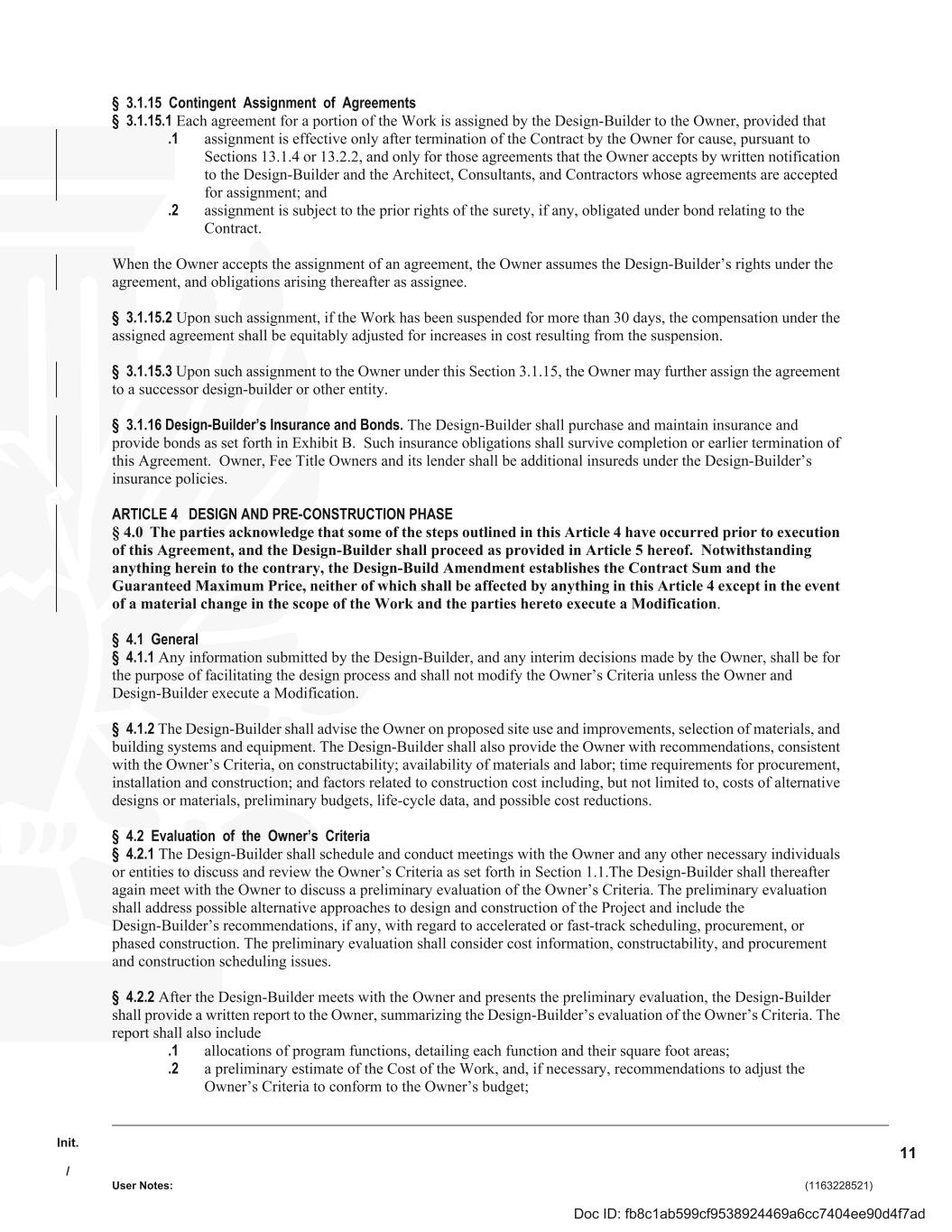
Init. / User Notes: (1163228521) 11 § 3.1.15 Contingent Assignment of Agreements § 3.1.15.1 Each agreement for a portion of the Work is assigned by the Design-Builder to the Owner, provided that .1 assignment is effective only after termination of the Contract by the Owner for cause, pursuant to Sections 13.1.4 or 13.2.2, and only for those agreements that the Owner accepts by written notification to the Design-Builder and the Architect, Consultants, and Contractors whose agreements are accepted for assignment; and .2 assignment is subject to the prior rights of the surety, if any, obligated under bond relating to the Contract. When the Owner accepts the assignment of an agreement, the Owner assumes the Design-Builder’s rights under the agreement, and obligations arising thereafter as assignee. § 3.1.15.2 Upon such assignment, if the Work has been suspended for more than 30 days, the compensation under the assigned agreement shall be equitably adjusted for increases in cost resulting from the suspension. § 3.1.15.3 Upon such assignment to the Owner under this Section 3.1.15, the Owner may further assign the agreement to a successor design-builder or other entity. § 3.1.16 Design-Builder’s Insurance and Bonds. The Design-Builder shall purchase and maintain insurance and provide bonds as set forth in Exhibit B. Such insurance obligations shall survive completion or earlier termination of this Agreement. Owner, Fee Title Owners and its lender shall be additional insureds under the Design-Builder’s insurance policies. ARTICLE 4 DESIGN AND PRE-CONSTRUCTION PHASE § 4.0 The parties acknowledge that some of the steps outlined in this Article 4 have occurred prior to execution of this Agreement, and the Design-Builder shall proceed as provided in Article 5 hereof. Notwithstanding anything herein to the contrary, the Design-Build Amendment establishes the Contract Sum and the Guaranteed Maximum Price, neither of which shall be affected by anything in this Article 4 except in the event of a material change in the scope of the Work and the parties hereto execute a Modification. § 4.1 General § 4.1.1 Any information submitted by the Design-Builder, and any interim decisions made by the Owner, shall be for the purpose of facilitating the design process and shall not modify the Owner’s Criteria unless the Owner and Design-Builder execute a Modification. § 4.1.2 The Design-Builder shall advise the Owner on proposed site use and improvements, selection of materials, and building systems and equipment. The Design-Builder shall also provide the Owner with recommendations, consistent with the Owner’s Criteria, on constructability; availability of materials and labor; time requirements for procurement, installation and construction; and factors related to construction cost including, but not limited to, costs of alternative designs or materials, preliminary budgets, life-cycle data, and possible cost reductions. § 4.2 Evaluation of the Owner’s Criteria § 4.2.1 The Design-Builder shall schedule and conduct meetings with the Owner and any other necessary individuals or entities to discuss and review the Owner’s Criteria as set forth in Section 1.1.The Design-Builder shall thereafter again meet with the Owner to discuss a preliminary evaluation of the Owner’s Criteria. The preliminary evaluation shall address possible alternative approaches to design and construction of the Project and include the Design-Builder’s recommendations, if any, with regard to accelerated or fast-track scheduling, procurement, or phased construction. The preliminary evaluation shall consider cost information, constructability, and procurement and construction scheduling issues. § 4.2.2 After the Design-Builder meets with the Owner and presents the preliminary evaluation, the Design-Builder shall provide a written report to the Owner, summarizing the Design-Builder’s evaluation of the Owner’s Criteria. The report shall also include .1 allocations of program functions, detailing each function and their square foot areas; .2 a preliminary estimate of the Cost of the Work, and, if necessary, recommendations to adjust the Owner’s Criteria to conform to the Owner’s budget; Doc ID: fb8c1ab599cf9538924469a6cc7404ee90d4f7ad
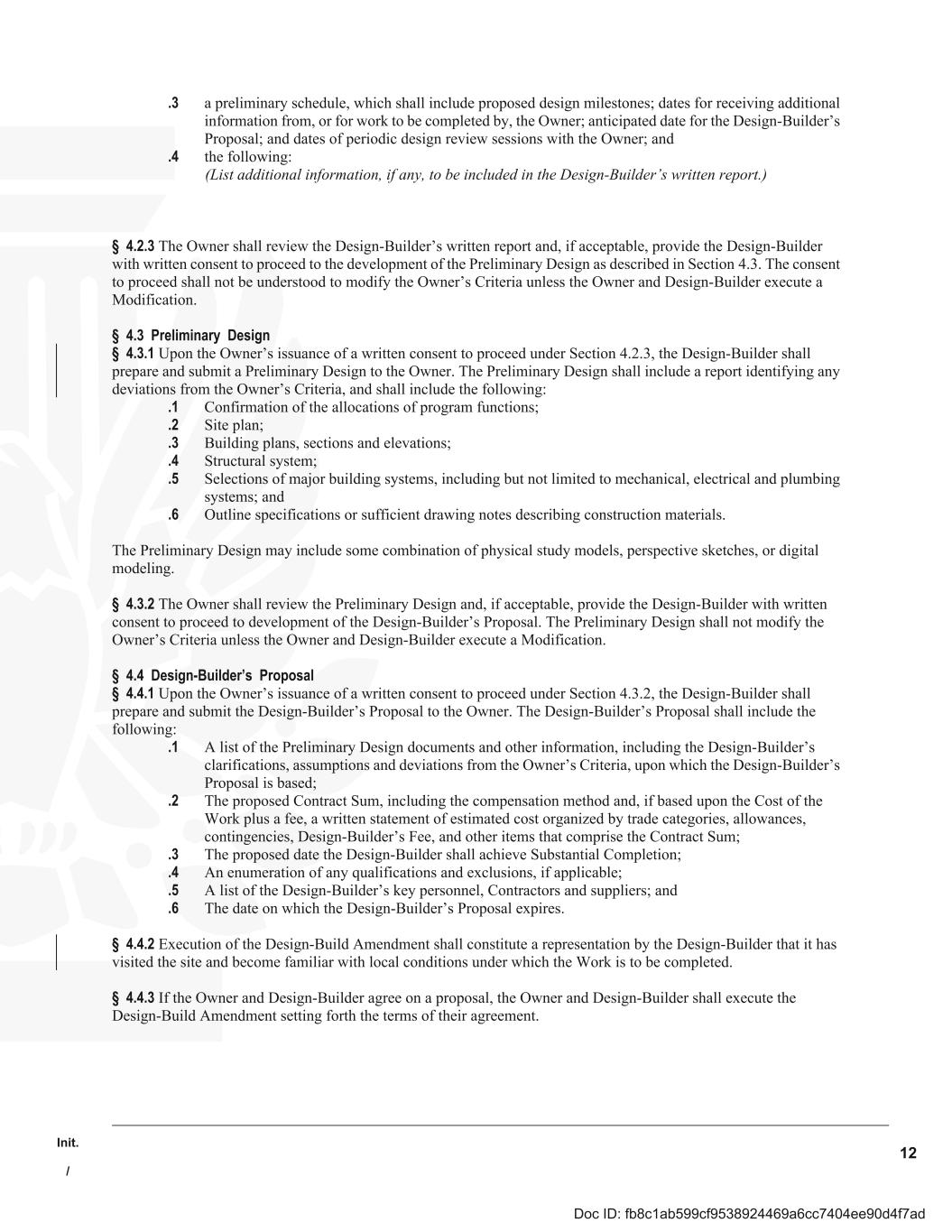
Init. / 12 .3 a preliminary schedule, which shall include proposed design milestones; dates for receiving additional information from, or for work to be completed by, the Owner; anticipated date for the Design-Builder’s Proposal; and dates of periodic design review sessions with the Owner; and .4 the following: (List additional information, if any, to be included in the Design-Builder’s written report.) § 4.2.3 The Owner shall review the Design-Builder’s written report and, if acceptable, provide the Design-Builder with written consent to proceed to the development of the Preliminary Design as described in Section 4.3. The consent to proceed shall not be understood to modify the Owner’s Criteria unless the Owner and Design-Builder execute a Modification. § 4.3 Preliminary Design § 4.3.1 Upon the Owner’s issuance of a written consent to proceed under Section 4.2.3, the Design-Builder shall prepare and submit a Preliminary Design to the Owner. The Preliminary Design shall include a report identifying any deviations from the Owner’s Criteria, and shall include the following: .1 Confirmation of the allocations of program functions; .2 Site plan; .3 Building plans, sections and elevations; .4 Structural system; .5 Selections of major building systems, including but not limited to mechanical, electrical and plumbing systems; and .6 Outline specifications or sufficient drawing notes describing construction materials. The Preliminary Design may include some combination of physical study models, perspective sketches, or digital modeling. § 4.3.2 The Owner shall review the Preliminary Design and, if acceptable, provide the Design-Builder with written consent to proceed to development of the Design-Builder’s Proposal. The Preliminary Design shall not modify the Owner’s Criteria unless the Owner and Design-Builder execute a Modification. § 4.4 Design-Builder’s Proposal § 4.4.1 Upon the Owner’s issuance of a written consent to proceed under Section 4.3.2, the Design-Builder shall prepare and submit the Design-Builder’s Proposal to the Owner. The Design-Builder’s Proposal shall include the following: .1 A list of the Preliminary Design documents and other information, including the Design-Builder’s clarifications, assumptions and deviations from the Owner’s Criteria, upon which the Design-Builder’s Proposal is based; .2 The proposed Contract Sum, including the compensation method and, if based upon the Cost of the Work plus a fee, a written statement of estimated cost organized by trade categories, allowances, contingencies, Design-Builder’s Fee, and other items that comprise the Contract Sum; .3 The proposed date the Design-Builder shall achieve Substantial Completion; .4 An enumeration of any qualifications and exclusions, if applicable; .5 A list of the Design-Builder’s key personnel, Contractors and suppliers; and .6 The date on which the Design-Builder’s Proposal expires. § 4.4.2 Execution of the Design-Build Amendment shall constitute a representation by the Design-Builder that it has visited the site and become familiar with local conditions under which the Work is to be completed. § 4.4.3 If the Owner and Design-Builder agree on a proposal, the Owner and Design-Builder shall execute the Design-Build Amendment setting forth the terms of their agreement. Doc ID: fb8c1ab599cf9538924469a6cc7404ee90d4f7ad
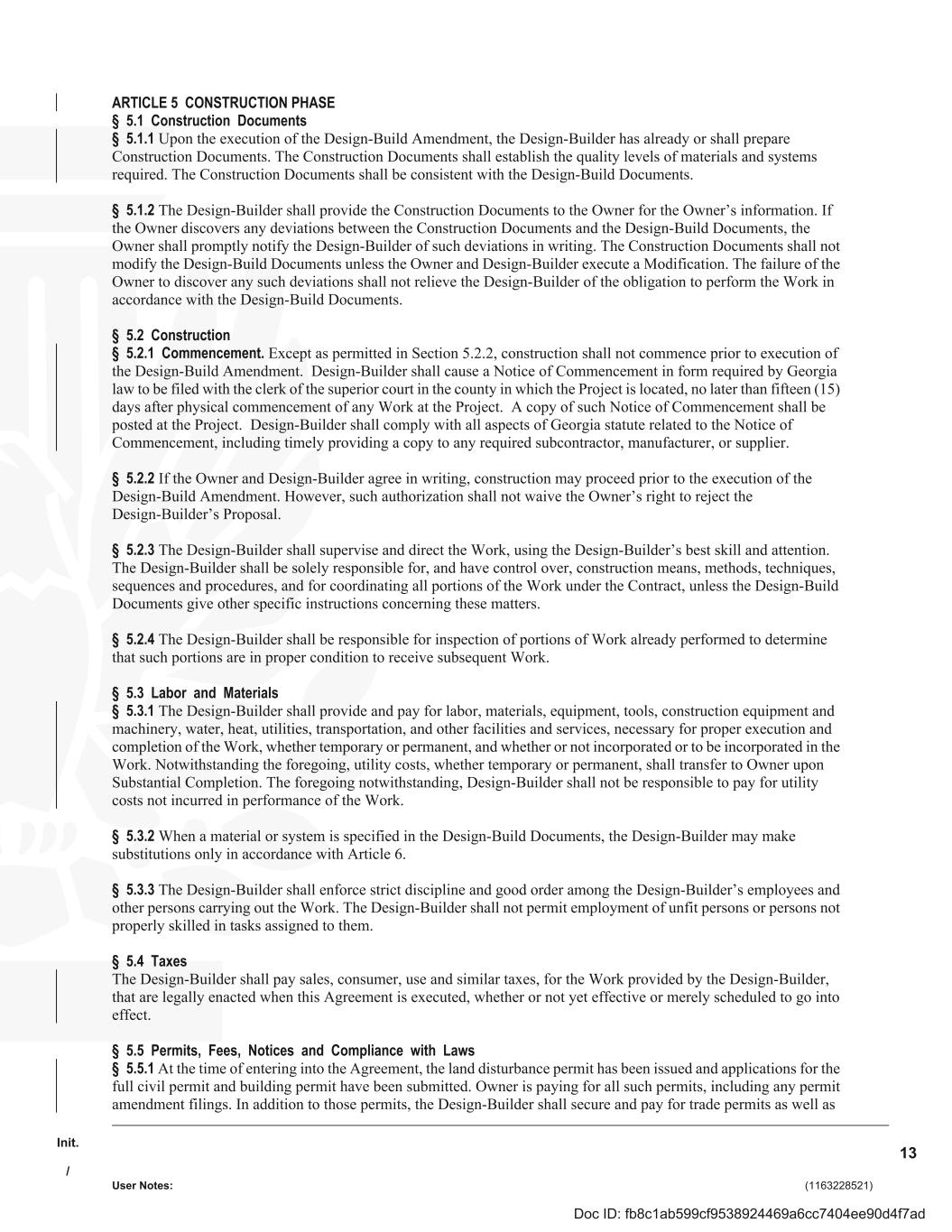
Init. / User Notes: (1163228521) 13 ARTICLE 5 CONSTRUCTION PHASE § 5.1 Construction Documents § 5.1.1 Upon the execution of the Design-Build Amendment, the Design-Builder has already or shall prepare Construction Documents. The Construction Documents shall establish the quality levels of materials and systems required. The Construction Documents shall be consistent with the Design-Build Documents. § 5.1.2 The Design-Builder shall provide the Construction Documents to the Owner for the Owner’s information. If the Owner discovers any deviations between the Construction Documents and the Design-Build Documents, the Owner shall promptly notify the Design-Builder of such deviations in writing. The Construction Documents shall not modify the Design-Build Documents unless the Owner and Design-Builder execute a Modification. The failure of the Owner to discover any such deviations shall not relieve the Design-Builder of the obligation to perform the Work in accordance with the Design-Build Documents. § 5.2 Construction § 5.2.1 Commencement. Except as permitted in Section 5.2.2, construction shall not commence prior to execution of the Design-Build Amendment. Design-Builder shall cause a Notice of Commencement in form required by Georgia law to be filed with the clerk of the superior court in the county in which the Project is located, no later than fifteen (15) days after physical commencement of any Work at the Project. A copy of such Notice of Commencement shall be posted at the Project. Design-Builder shall comply with all aspects of Georgia statute related to the Notice of Commencement, including timely providing a copy to any required subcontractor, manufacturer, or supplier. § 5.2.2 If the Owner and Design-Builder agree in writing, construction may proceed prior to the execution of the Design-Build Amendment. However, such authorization shall not waive the Owner’s right to reject the Design-Builder’s Proposal. § 5.2.3 The Design-Builder shall supervise and direct the Work, using the Design-Builder’s best skill and attention. The Design-Builder shall be solely responsible for, and have control over, construction means, methods, techniques, sequences and procedures, and for coordinating all portions of the Work under the Contract, unless the Design-Build Documents give other specific instructions concerning these matters. § 5.2.4 The Design-Builder shall be responsible for inspection of portions of Work already performed to determine that such portions are in proper condition to receive subsequent Work. § 5.3 Labor and Materials § 5.3.1 The Design-Builder shall provide and pay for labor, materials, equipment, tools, construction equipment and machinery, water, heat, utilities, transportation, and other facilities and services, necessary for proper execution and completion of the Work, whether temporary or permanent, and whether or not incorporated or to be incorporated in the Work. Notwithstanding the foregoing, utility costs, whether temporary or permanent, shall transfer to Owner upon Substantial Completion. The foregoing notwithstanding, Design-Builder shall not be responsible to pay for utility costs not incurred in performance of the Work. § 5.3.2 When a material or system is specified in the Design-Build Documents, the Design-Builder may make substitutions only in accordance with Article 6. § 5.3.3 The Design-Builder shall enforce strict discipline and good order among the Design-Builder’s employees and other persons carrying out the Work. The Design-Builder shall not permit employment of unfit persons or persons not properly skilled in tasks assigned to them. § 5.4 Taxes The Design-Builder shall pay sales, consumer, use and similar taxes, for the Work provided by the Design-Builder, that are legally enacted when this Agreement is executed, whether or not yet effective or merely scheduled to go into effect. § 5.5 Permits, Fees, Notices and Compliance with Laws § 5.5.1 At the time of entering into the Agreement, the land disturbance permit has been issued and applications for the full civil permit and building permit have been submitted. Owner is paying for all such permits, including any permit amendment filings. In addition to those permits, the Design-Builder shall secure and pay for trade permits as well as Doc ID: fb8c1ab599cf9538924469a6cc7404ee90d4f7ad
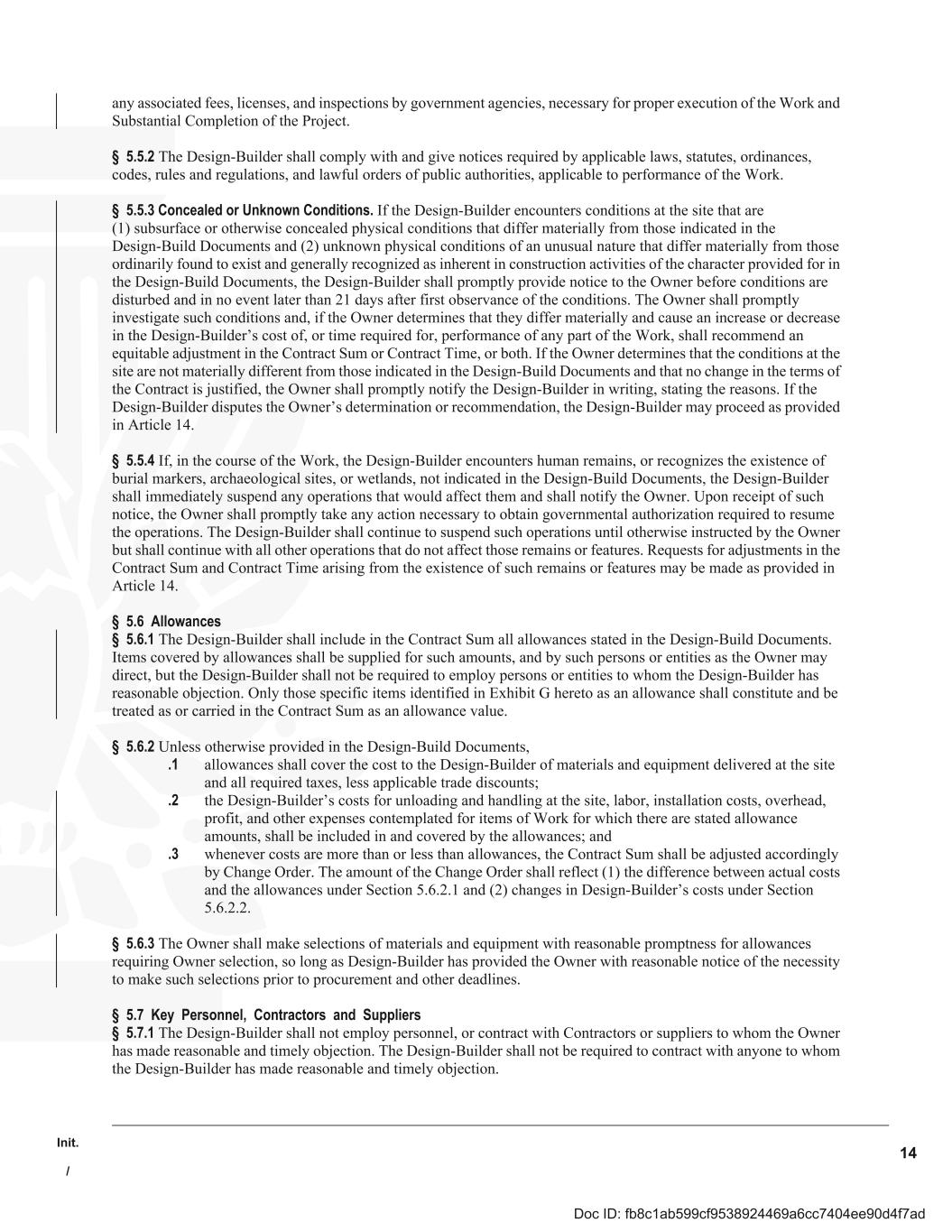
Init. / 14 any associated fees, licenses, and inspections by government agencies, necessary for proper execution of the Work and Substantial Completion of the Project. § 5.5.2 The Design-Builder shall comply with and give notices required by applicable laws, statutes, ordinances, codes, rules and regulations, and lawful orders of public authorities, applicable to performance of the Work. § 5.5.3 Concealed or Unknown Conditions. If the Design-Builder encounters conditions at the site that are (1) subsurface or otherwise concealed physical conditions that differ materially from those indicated in the Design-Build Documents and (2) unknown physical conditions of an unusual nature that differ materially from those ordinarily found to exist and generally recognized as inherent in construction activities of the character provided for in the Design-Build Documents, the Design-Builder shall promptly provide notice to the Owner before conditions are disturbed and in no event later than 21 days after first observance of the conditions. The Owner shall promptly investigate such conditions and, if the Owner determines that they differ materially and cause an increase or decrease in the Design-Builder’s cost of, or time required for, performance of any part of the Work, shall recommend an equitable adjustment in the Contract Sum or Contract Time, or both. If the Owner determines that the conditions at the site are not materially different from those indicated in the Design-Build Documents and that no change in the terms of the Contract is justified, the Owner shall promptly notify the Design-Builder in writing, stating the reasons. If the Design-Builder disputes the Owner’s determination or recommendation, the Design-Builder may proceed as provided in Article 14. § 5.5.4 If, in the course of the Work, the Design-Builder encounters human remains, or recognizes the existence of burial markers, archaeological sites, or wetlands, not indicated in the Design-Build Documents, the Design-Builder shall immediately suspend any operations that would affect them and shall notify the Owner. Upon receipt of such notice, the Owner shall promptly take any action necessary to obtain governmental authorization required to resume the operations. The Design-Builder shall continue to suspend such operations until otherwise instructed by the Owner but shall continue with all other operations that do not affect those remains or features. Requests for adjustments in the Contract Sum and Contract Time arising from the existence of such remains or features may be made as provided in Article 14. § 5.6 Allowances § 5.6.1 The Design-Builder shall include in the Contract Sum all allowances stated in the Design-Build Documents. Items covered by allowances shall be supplied for such amounts, and by such persons or entities as the Owner may direct, but the Design-Builder shall not be required to employ persons or entities to whom the Design-Builder has reasonable objection. Only those specific items identified in Exhibit G hereto as an allowance shall constitute and be treated as or carried in the Contract Sum as an allowance value. § 5.6.2 Unless otherwise provided in the Design-Build Documents, .1 allowances shall cover the cost to the Design-Builder of materials and equipment delivered at the site and all required taxes, less applicable trade discounts; .2 the Design-Builder’s costs for unloading and handling at the site, labor, installation costs, overhead, profit, and other expenses contemplated for items of Work for which there are stated allowance amounts, shall be included in and covered by the allowances; and .3 whenever costs are more than or less than allowances, the Contract Sum shall be adjusted accordingly by Change Order. The amount of the Change Order shall reflect (1) the difference between actual costs and the allowances under Section 5.6.2.1 and (2) changes in Design-Builder’s costs under Section 5.6.2.2. § 5.6.3 The Owner shall make selections of materials and equipment with reasonable promptness for allowances requiring Owner selection, so long as Design-Builder has provided the Owner with reasonable notice of the necessity to make such selections prior to procurement and other deadlines. § 5.7 Key Personnel, Contractors and Suppliers § 5.7.1 The Design-Builder shall not employ personnel, or contract with Contractors or suppliers to whom the Owner has made reasonable and timely objection. The Design-Builder shall not be required to contract with anyone to whom the Design-Builder has made reasonable and timely objection. Doc ID: fb8c1ab599cf9538924469a6cc7404ee90d4f7ad
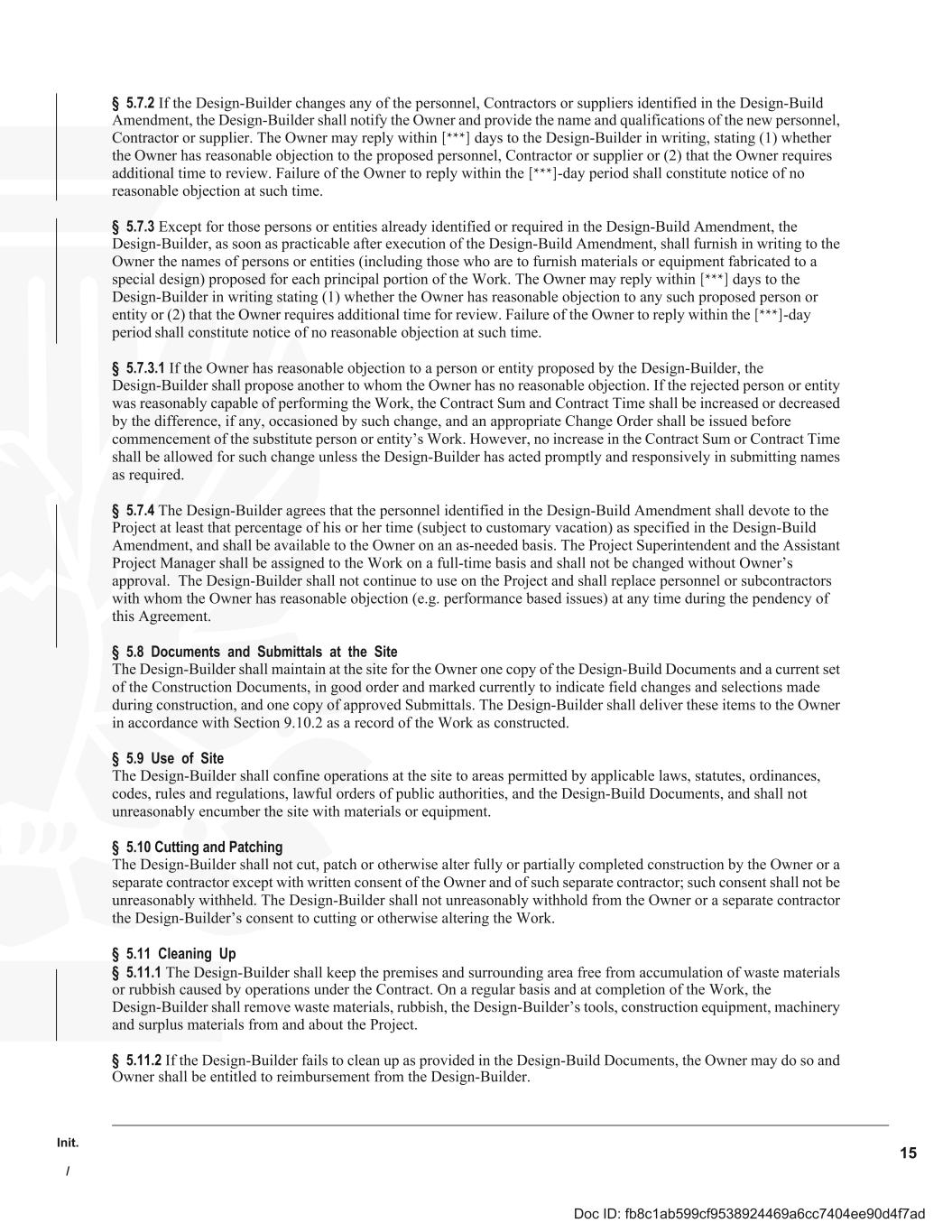
Init. / 15 § 5.7.2 If the Design-Builder changes any of the personnel, Contractors or suppliers identified in the Design-Build Amendment, the Design-Builder shall notify the Owner and provide the name and qualifications of the new personnel, Contractor or supplier. The Owner may reply within [***] days to the Design-Builder in writing, stating (1) whether the Owner has reasonable objection to the proposed personnel, Contractor or supplier or (2) that the Owner requires additional time to review. Failure of the Owner to reply within the [***]-day period shall constitute notice of no reasonable objection at such time. § 5.7.3 Except for those persons or entities already identified or required in the Design-Build Amendment, the Design-Builder, as soon as practicable after execution of the Design-Build Amendment, shall furnish in writing to the Owner the names of persons or entities (including those who are to furnish materials or equipment fabricated to a special design) proposed for each principal portion of the Work. The Owner may reply within [***] days to the Design-Builder in writing stating (1) whether the Owner has reasonable objection to any such proposed person or entity or (2) that the Owner requires additional time for review. Failure of the Owner to reply within the [***]-day period shall constitute notice of no reasonable objection at such time. § 5.7.3.1 If the Owner has reasonable objection to a person or entity proposed by the Design-Builder, the Design-Builder shall propose another to whom the Owner has no reasonable objection. If the rejected person or entity was reasonably capable of performing the Work, the Contract Sum and Contract Time shall be increased or decreased by the difference, if any, occasioned by such change, and an appropriate Change Order shall be issued before commencement of the substitute person or entity’s Work. However, no increase in the Contract Sum or Contract Time shall be allowed for such change unless the Design-Builder has acted promptly and responsively in submitting names as required. § 5.7.4 The Design-Builder agrees that the personnel identified in the Design-Build Amendment shall devote to the Project at least that percentage of his or her time (subject to customary vacation) as specified in the Design-Build Amendment, and shall be available to the Owner on an as-needed basis. The Project Superintendent and the Assistant Project Manager shall be assigned to the Work on a full-time basis and shall not be changed without Owner’s approval. The Design-Builder shall not continue to use on the Project and shall replace personnel or subcontractors with whom the Owner has reasonable objection (e.g. performance based issues) at any time during the pendency of this Agreement. § 5.8 Documents and Submittals at the Site The Design-Builder shall maintain at the site for the Owner one copy of the Design-Build Documents and a current set of the Construction Documents, in good order and marked currently to indicate field changes and selections made during construction, and one copy of approved Submittals. The Design-Builder shall deliver these items to the Owner in accordance with Section 9.10.2 as a record of the Work as constructed. § 5.9 Use of Site The Design-Builder shall confine operations at the site to areas permitted by applicable laws, statutes, ordinances, codes, rules and regulations, lawful orders of public authorities, and the Design-Build Documents, and shall not unreasonably encumber the site with materials or equipment. § 5.10 Cutting and Patching The Design-Builder shall not cut, patch or otherwise alter fully or partially completed construction by the Owner or a separate contractor except with written consent of the Owner and of such separate contractor; such consent shall not be unreasonably withheld. The Design-Builder shall not unreasonably withhold from the Owner or a separate contractor the Design-Builder’s consent to cutting or otherwise altering the Work. § 5.11 Cleaning Up § 5.11.1 The Design-Builder shall keep the premises and surrounding area free from accumulation of waste materials or rubbish caused by operations under the Contract. On a regular basis and at completion of the Work, the Design-Builder shall remove waste materials, rubbish, the Design-Builder’s tools, construction equipment, machinery and surplus materials from and about the Project. § 5.11.2 If the Design-Builder fails to clean up as provided in the Design-Build Documents, the Owner may do so and Owner shall be entitled to reimbursement from the Design-Builder. Doc ID: fb8c1ab599cf9538924469a6cc7404ee90d4f7ad
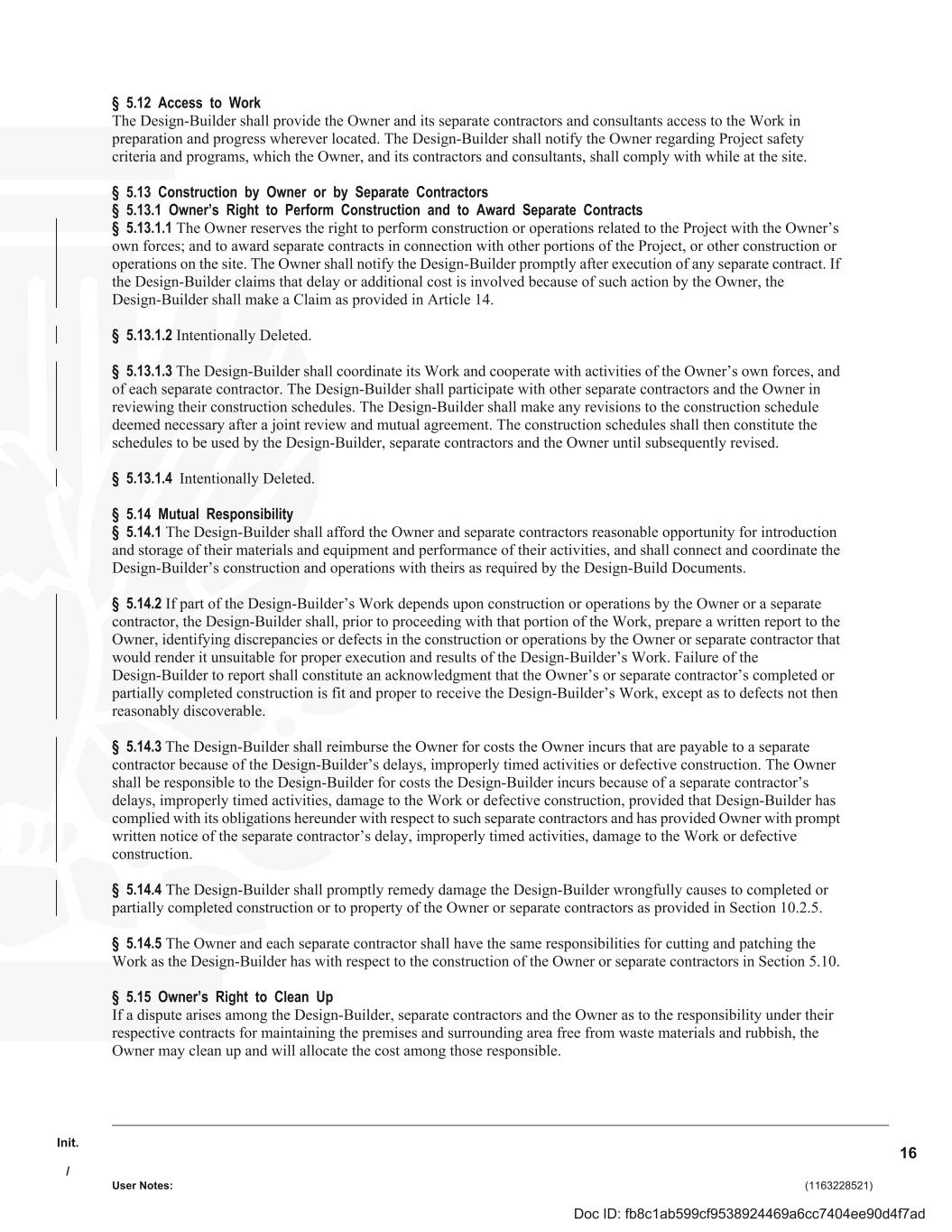
Init. / User Notes: (1163228521) 16 § 5.12 Access to Work The Design-Builder shall provide the Owner and its separate contractors and consultants access to the Work in preparation and progress wherever located. The Design-Builder shall notify the Owner regarding Project safety criteria and programs, which the Owner, and its contractors and consultants, shall comply with while at the site. § 5.13 Construction by Owner or by Separate Contractors § 5.13.1 Owner’s Right to Perform Construction and to Award Separate Contracts § 5.13.1.1 The Owner reserves the right to perform construction or operations related to the Project with the Owner’s own forces; and to award separate contracts in connection with other portions of the Project, or other construction or operations on the site. The Owner shall notify the Design-Builder promptly after execution of any separate contract. If the Design-Builder claims that delay or additional cost is involved because of such action by the Owner, the Design-Builder shall make a Claim as provided in Article 14. § 5.13.1.2 Intentionally Deleted. § 5.13.1.3 The Design-Builder shall coordinate its Work and cooperate with activities of the Owner’s own forces, and of each separate contractor. The Design-Builder shall participate with other separate contractors and the Owner in reviewing their construction schedules. The Design-Builder shall make any revisions to the construction schedule deemed necessary after a joint review and mutual agreement. The construction schedules shall then constitute the schedules to be used by the Design-Builder, separate contractors and the Owner until subsequently revised. § 5.13.1.4 Intentionally Deleted. § 5.14 Mutual Responsibility § 5.14.1 The Design-Builder shall afford the Owner and separate contractors reasonable opportunity for introduction and storage of their materials and equipment and performance of their activities, and shall connect and coordinate the Design-Builder’s construction and operations with theirs as required by the Design-Build Documents. § 5.14.2 If part of the Design-Builder’s Work depends upon construction or operations by the Owner or a separate contractor, the Design-Builder shall, prior to proceeding with that portion of the Work, prepare a written report to the Owner, identifying discrepancies or defects in the construction or operations by the Owner or separate contractor that would render it unsuitable for proper execution and results of the Design-Builder’s Work. Failure of the Design-Builder to report shall constitute an acknowledgment that the Owner’s or separate contractor’s completed or partially completed construction is fit and proper to receive the Design-Builder’s Work, except as to defects not then reasonably discoverable. § 5.14.3 The Design-Builder shall reimburse the Owner for costs the Owner incurs that are payable to a separate contractor because of the Design-Builder’s delays, improperly timed activities or defective construction. The Owner shall be responsible to the Design-Builder for costs the Design-Builder incurs because of a separate contractor’s delays, improperly timed activities, damage to the Work or defective construction, provided that Design-Builder has complied with its obligations hereunder with respect to such separate contractors and has provided Owner with prompt written notice of the separate contractor’s delay, improperly timed activities, damage to the Work or defective construction. § 5.14.4 The Design-Builder shall promptly remedy damage the Design-Builder wrongfully causes to completed or partially completed construction or to property of the Owner or separate contractors as provided in Section 10.2.5. § 5.14.5 The Owner and each separate contractor shall have the same responsibilities for cutting and patching the Work as the Design-Builder has with respect to the construction of the Owner or separate contractors in Section 5.10. § 5.15 Owner’s Right to Clean Up If a dispute arises among the Design-Builder, separate contractors and the Owner as to the responsibility under their respective contracts for maintaining the premises and surrounding area free from waste materials and rubbish, the Owner may clean up and will allocate the cost among those responsible. Doc ID: fb8c1ab599cf9538924469a6cc7404ee90d4f7ad
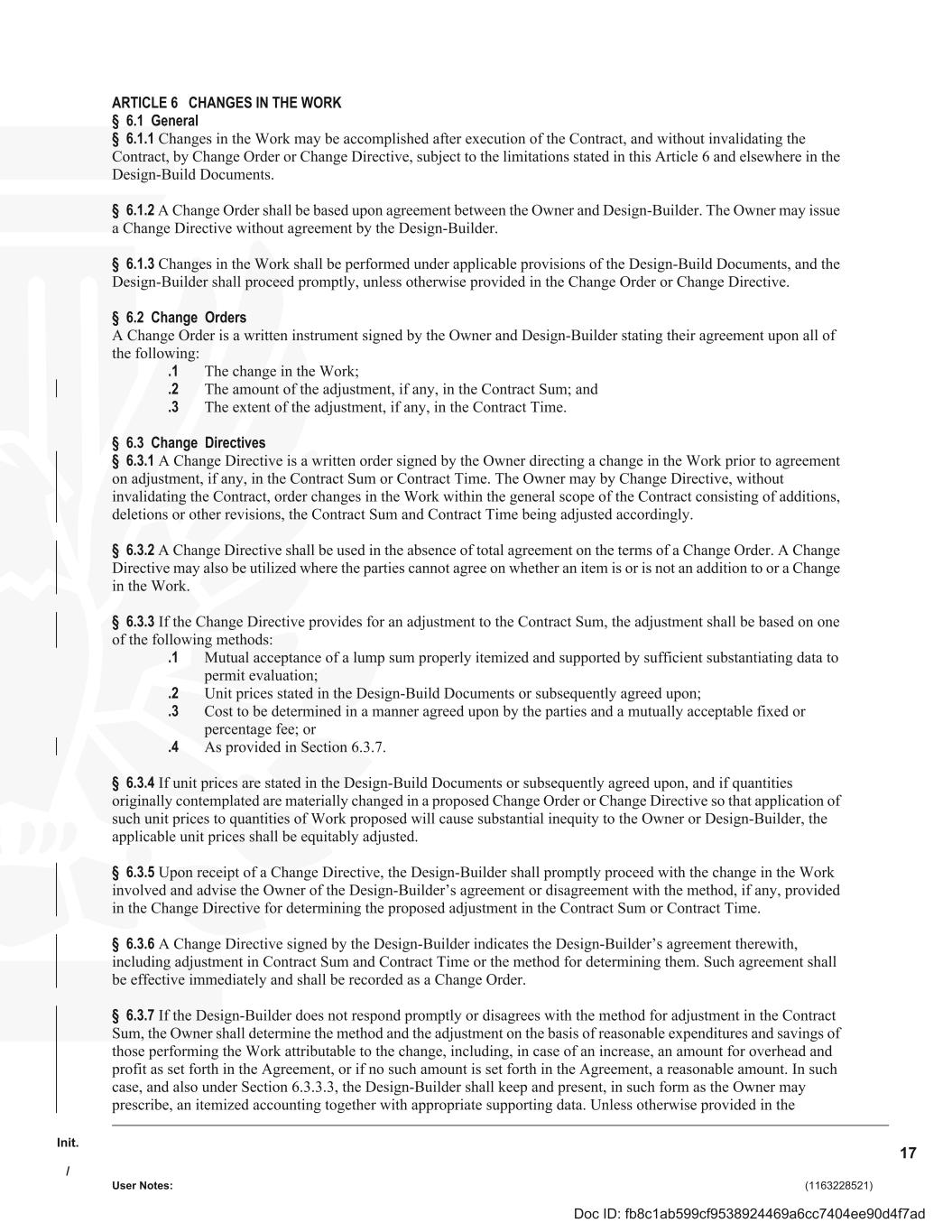
Init. / User Notes: (1163228521) 17 ARTICLE 6 CHANGES IN THE WORK § 6.1 General § 6.1.1 Changes in the Work may be accomplished after execution of the Contract, and without invalidating the Contract, by Change Order or Change Directive, subject to the limitations stated in this Article 6 and elsewhere in the Design-Build Documents. § 6.1.2 A Change Order shall be based upon agreement between the Owner and Design-Builder. The Owner may issue a Change Directive without agreement by the Design-Builder. § 6.1.3 Changes in the Work shall be performed under applicable provisions of the Design-Build Documents, and the Design-Builder shall proceed promptly, unless otherwise provided in the Change Order or Change Directive. § 6.2 Change Orders A Change Order is a written instrument signed by the Owner and Design-Builder stating their agreement upon all of the following: .1 The change in the Work; .2 The amount of the adjustment, if any, in the Contract Sum; and .3 The extent of the adjustment, if any, in the Contract Time. § 6.3 Change Directives § 6.3.1 A Change Directive is a written order signed by the Owner directing a change in the Work prior to agreement on adjustment, if any, in the Contract Sum or Contract Time. The Owner may by Change Directive, without invalidating the Contract, order changes in the Work within the general scope of the Contract consisting of additions, deletions or other revisions, the Contract Sum and Contract Time being adjusted accordingly. § 6.3.2 A Change Directive shall be used in the absence of total agreement on the terms of a Change Order. A Change Directive may also be utilized where the parties cannot agree on whether an item is or is not an addition to or a Change in the Work. § 6.3.3 If the Change Directive provides for an adjustment to the Contract Sum, the adjustment shall be based on one of the following methods: .1 Mutual acceptance of a lump sum properly itemized and supported by sufficient substantiating data to permit evaluation; .2 Unit prices stated in the Design-Build Documents or subsequently agreed upon; .3 Cost to be determined in a manner agreed upon by the parties and a mutually acceptable fixed or percentage fee; or .4 As provided in Section 6.3.7. § 6.3.4 If unit prices are stated in the Design-Build Documents or subsequently agreed upon, and if quantities originally contemplated are materially changed in a proposed Change Order or Change Directive so that application of such unit prices to quantities of Work proposed will cause substantial inequity to the Owner or Design-Builder, the applicable unit prices shall be equitably adjusted. § 6.3.5 Upon receipt of a Change Directive, the Design-Builder shall promptly proceed with the change in the Work involved and advise the Owner of the Design-Builder’s agreement or disagreement with the method, if any, provided in the Change Directive for determining the proposed adjustment in the Contract Sum or Contract Time. § 6.3.6 A Change Directive signed by the Design-Builder indicates the Design-Builder’s agreement therewith, including adjustment in Contract Sum and Contract Time or the method for determining them. Such agreement shall be effective immediately and shall be recorded as a Change Order. § 6.3.7 If the Design-Builder does not respond promptly or disagrees with the method for adjustment in the Contract Sum, the Owner shall determine the method and the adjustment on the basis of reasonable expenditures and savings of those performing the Work attributable to the change, including, in case of an increase, an amount for overhead and profit as set forth in the Agreement, or if no such amount is set forth in the Agreement, a reasonable amount. In such case, and also under Section 6.3.3.3, the Design-Builder shall keep and present, in such form as the Owner may prescribe, an itemized accounting together with appropriate supporting data. Unless otherwise provided in the Doc ID: fb8c1ab599cf9538924469a6cc7404ee90d4f7ad
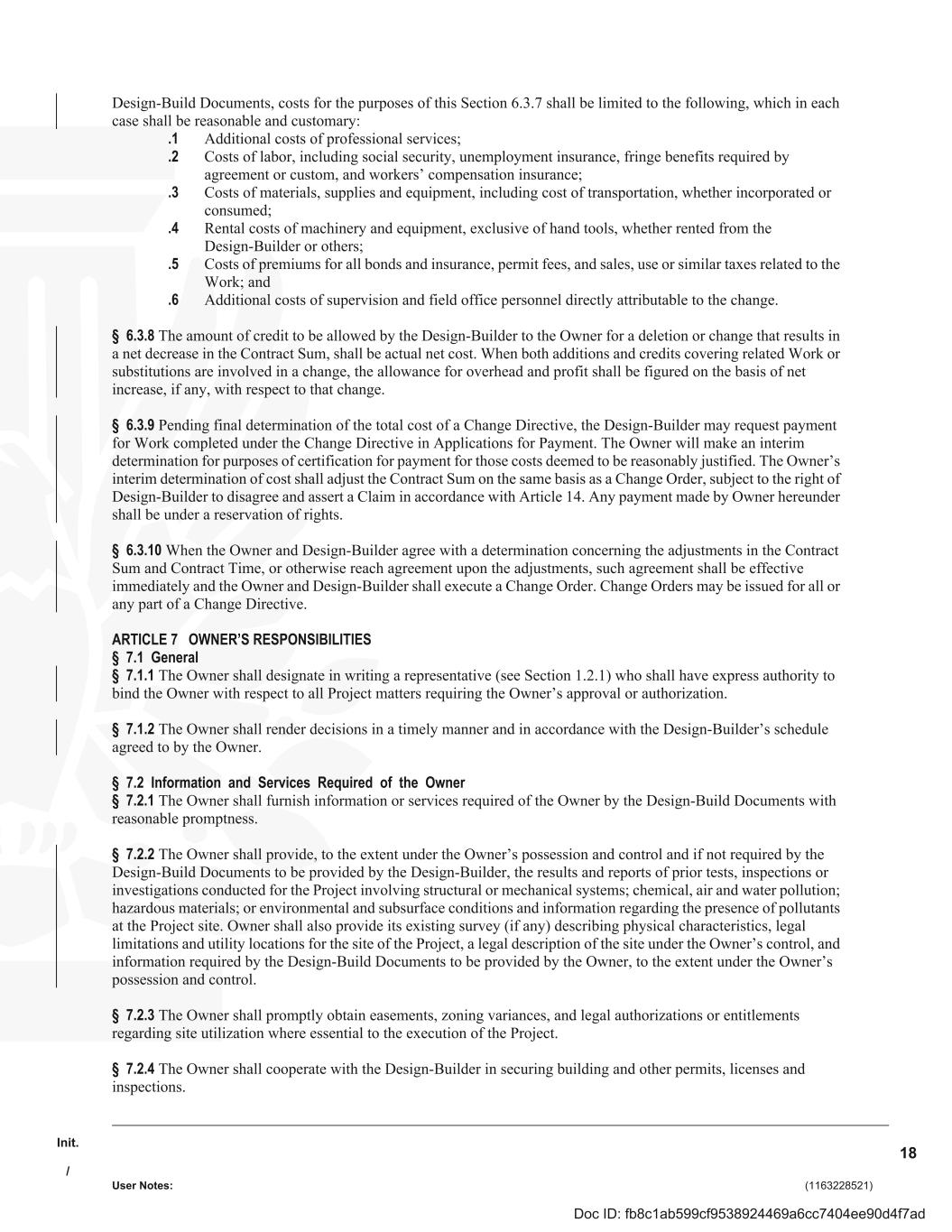
Init. / User Notes: (1163228521) 18 Design-Build Documents, costs for the purposes of this Section 6.3.7 shall be limited to the following, which in each case shall be reasonable and customary: .1 Additional costs of professional services; .2 Costs of labor, including social security, unemployment insurance, fringe benefits required by agreement or custom, and workers’ compensation insurance; .3 Costs of materials, supplies and equipment, including cost of transportation, whether incorporated or consumed; .4 Rental costs of machinery and equipment, exclusive of hand tools, whether rented from the Design-Builder or others; .5 Costs of premiums for all bonds and insurance, permit fees, and sales, use or similar taxes related to the Work; and .6 Additional costs of supervision and field office personnel directly attributable to the change. § 6.3.8 The amount of credit to be allowed by the Design-Builder to the Owner for a deletion or change that results in a net decrease in the Contract Sum, shall be actual net cost. When both additions and credits covering related Work or substitutions are involved in a change, the allowance for overhead and profit shall be figured on the basis of net increase, if any, with respect to that change. § 6.3.9 Pending final determination of the total cost of a Change Directive, the Design-Builder may request payment for Work completed under the Change Directive in Applications for Payment. The Owner will make an interim determination for purposes of certification for payment for those costs deemed to be reasonably justified. The Owner’s interim determination of cost shall adjust the Contract Sum on the same basis as a Change Order, subject to the right of Design-Builder to disagree and assert a Claim in accordance with Article 14. Any payment made by Owner hereunder shall be under a reservation of rights. § 6.3.10 When the Owner and Design-Builder agree with a determination concerning the adjustments in the Contract Sum and Contract Time, or otherwise reach agreement upon the adjustments, such agreement shall be effective immediately and the Owner and Design-Builder shall execute a Change Order. Change Orders may be issued for all or any part of a Change Directive. ARTICLE 7 OWNER’S RESPONSIBILITIES § 7.1 General § 7.1.1 The Owner shall designate in writing a representative (see Section 1.2.1) who shall have express authority to bind the Owner with respect to all Project matters requiring the Owner’s approval or authorization. § 7.1.2 The Owner shall render decisions in a timely manner and in accordance with the Design-Builder’s schedule agreed to by the Owner. § 7.2 Information and Services Required of the Owner § 7.2.1 The Owner shall furnish information or services required of the Owner by the Design-Build Documents with reasonable promptness. § 7.2.2 The Owner shall provide, to the extent under the Owner’s possession and control and if not required by the Design-Build Documents to be provided by the Design-Builder, the results and reports of prior tests, inspections or investigations conducted for the Project involving structural or mechanical systems; chemical, air and water pollution; hazardous materials; or environmental and subsurface conditions and information regarding the presence of pollutants at the Project site. Owner shall also provide its existing survey (if any) describing physical characteristics, legal limitations and utility locations for the site of the Project, a legal description of the site under the Owner’s control, and information required by the Design-Build Documents to be provided by the Owner, to the extent under the Owner’s possession and control. § 7.2.3 The Owner shall promptly obtain easements, zoning variances, and legal authorizations or entitlements regarding site utilization where essential to the execution of the Project. § 7.2.4 The Owner shall cooperate with the Design-Builder in securing building and other permits, licenses and inspections. Doc ID: fb8c1ab599cf9538924469a6cc7404ee90d4f7ad
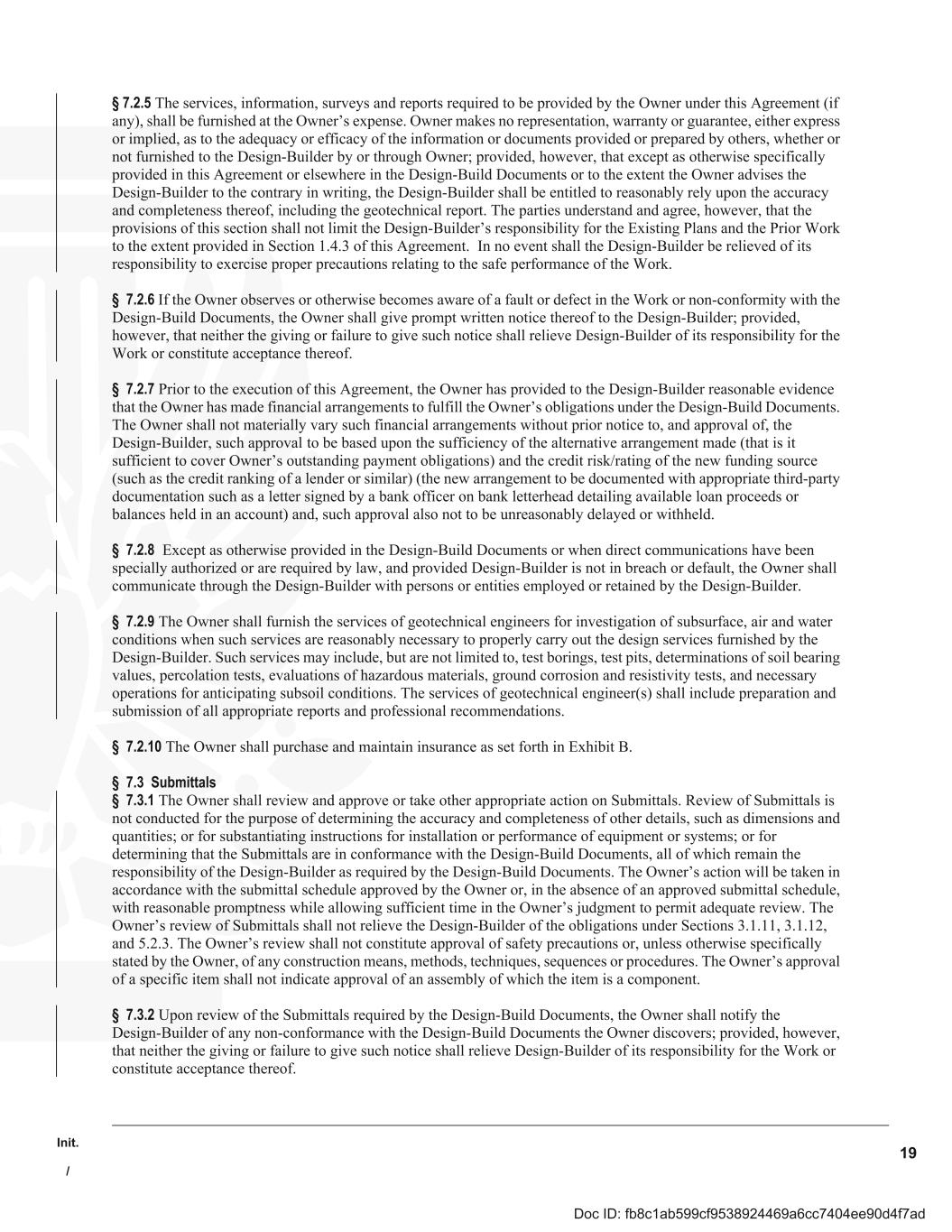
Init. / 19 § 7.2.5 The services, information, surveys and reports required to be provided by the Owner under this Agreement (if any), shall be furnished at the Owner’s expense. Owner makes no representation, warranty or guarantee, either express or implied, as to the adequacy or efficacy of the information or documents provided or prepared by others, whether or not furnished to the Design-Builder by or through Owner; provided, however, that except as otherwise specifically provided in this Agreement or elsewhere in the Design-Build Documents or to the extent the Owner advises the Design-Builder to the contrary in writing, the Design-Builder shall be entitled to reasonably rely upon the accuracy and completeness thereof, including the geotechnical report. The parties understand and agree, however, that the provisions of this section shall not limit the Design-Builder’s responsibility for the Existing Plans and the Prior Work to the extent provided in Section 1.4.3 of this Agreement. In no event shall the Design-Builder be relieved of its responsibility to exercise proper precautions relating to the safe performance of the Work. § 7.2.6 If the Owner observes or otherwise becomes aware of a fault or defect in the Work or non-conformity with the Design-Build Documents, the Owner shall give prompt written notice thereof to the Design-Builder; provided, however, that neither the giving or failure to give such notice shall relieve Design-Builder of its responsibility for the Work or constitute acceptance thereof. § 7.2.7 Prior to the execution of this Agreement, the Owner has provided to the Design-Builder reasonable evidence that the Owner has made financial arrangements to fulfill the Owner’s obligations under the Design-Build Documents. The Owner shall not materially vary such financial arrangements without prior notice to, and approval of, the Design-Builder, such approval to be based upon the sufficiency of the alternative arrangement made (that is it sufficient to cover Owner’s outstanding payment obligations) and the credit risk/rating of the new funding source (such as the credit ranking of a lender or similar) (the new arrangement to be documented with appropriate third-party documentation such as a letter signed by a bank officer on bank letterhead detailing available loan proceeds or balances held in an account) and, such approval also not to be unreasonably delayed or withheld. § 7.2.8 Except as otherwise provided in the Design-Build Documents or when direct communications have been specially authorized or are required by law, and provided Design-Builder is not in breach or default, the Owner shall communicate through the Design-Builder with persons or entities employed or retained by the Design-Builder. § 7.2.9 The Owner shall furnish the services of geotechnical engineers for investigation of subsurface, air and water conditions when such services are reasonably necessary to properly carry out the design services furnished by the Design-Builder. Such services may include, but are not limited to, test borings, test pits, determinations of soil bearing values, percolation tests, evaluations of hazardous materials, ground corrosion and resistivity tests, and necessary operations for anticipating subsoil conditions. The services of geotechnical engineer(s) shall include preparation and submission of all appropriate reports and professional recommendations. § 7.2.10 The Owner shall purchase and maintain insurance as set forth in Exhibit B. § 7.3 Submittals § 7.3.1 The Owner shall review and approve or take other appropriate action on Submittals. Review of Submittals is not conducted for the purpose of determining the accuracy and completeness of other details, such as dimensions and quantities; or for substantiating instructions for installation or performance of equipment or systems; or for determining that the Submittals are in conformance with the Design-Build Documents, all of which remain the responsibility of the Design-Builder as required by the Design-Build Documents. The Owner’s action will be taken in accordance with the submittal schedule approved by the Owner or, in the absence of an approved submittal schedule, with reasonable promptness while allowing sufficient time in the Owner’s judgment to permit adequate review. The Owner’s review of Submittals shall not relieve the Design-Builder of the obligations under Sections 3.1.11, 3.1.12, and 5.2.3. The Owner’s review shall not constitute approval of safety precautions or, unless otherwise specifically stated by the Owner, of any construction means, methods, techniques, sequences or procedures. The Owner’s approval of a specific item shall not indicate approval of an assembly of which the item is a component. § 7.3.2 Upon review of the Submittals required by the Design-Build Documents, the Owner shall notify the Design-Builder of any non-conformance with the Design-Build Documents the Owner discovers; provided, however, that neither the giving or failure to give such notice shall relieve Design-Builder of its responsibility for the Work or constitute acceptance thereof. Doc ID: fb8c1ab599cf9538924469a6cc7404ee90d4f7ad
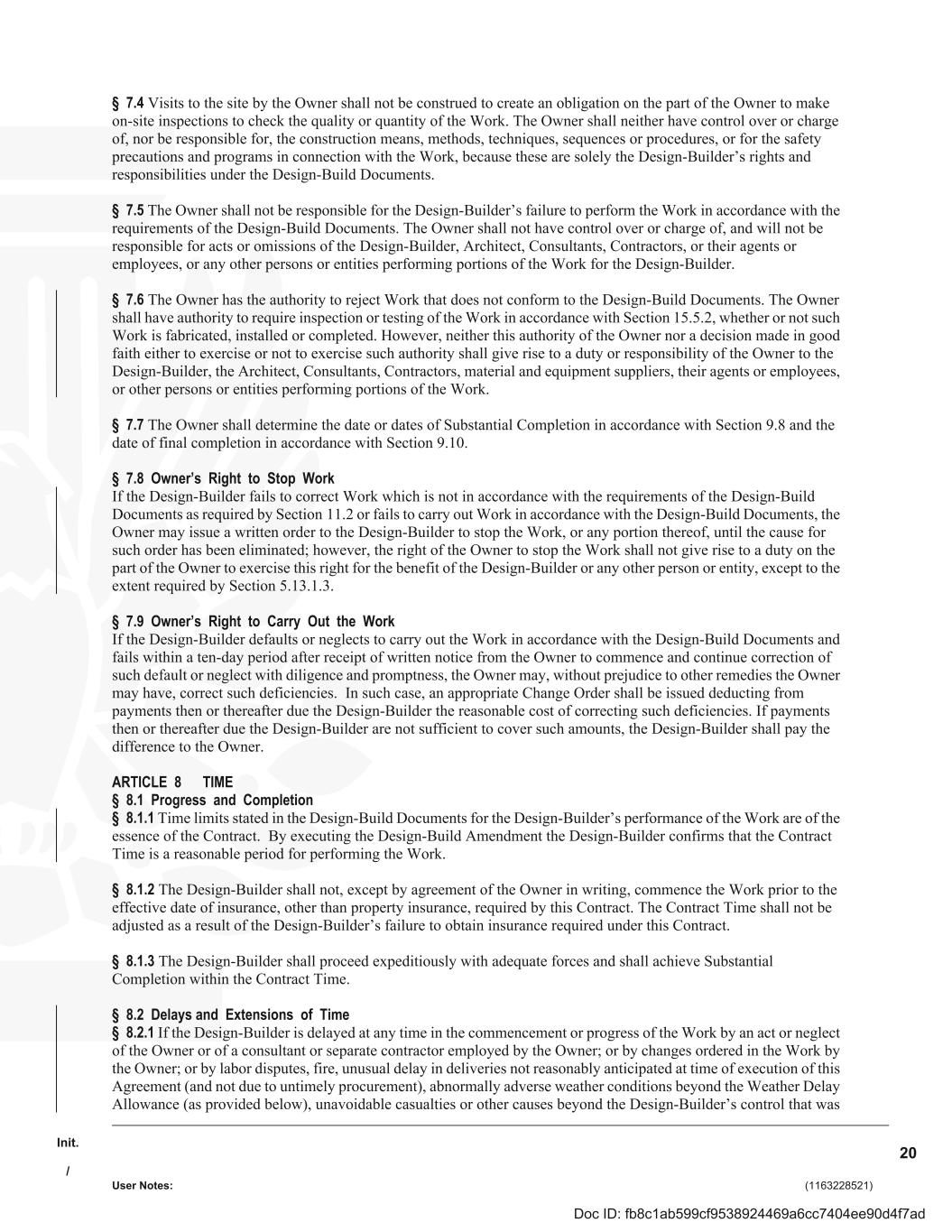
Init. / User Notes: (1163228521) 20 § 7.4 Visits to the site by the Owner shall not be construed to create an obligation on the part of the Owner to make on-site inspections to check the quality or quantity of the Work. The Owner shall neither have control over or charge of, nor be responsible for, the construction means, methods, techniques, sequences or procedures, or for the safety precautions and programs in connection with the Work, because these are solely the Design-Builder’s rights and responsibilities under the Design-Build Documents. § 7.5 The Owner shall not be responsible for the Design-Builder’s failure to perform the Work in accordance with the requirements of the Design-Build Documents. The Owner shall not have control over or charge of, and will not be responsible for acts or omissions of the Design-Builder, Architect, Consultants, Contractors, or their agents or employees, or any other persons or entities performing portions of the Work for the Design-Builder. § 7.6 The Owner has the authority to reject Work that does not conform to the Design-Build Documents. The Owner shall have authority to require inspection or testing of the Work in accordance with Section 15.5.2, whether or not such Work is fabricated, installed or completed. However, neither this authority of the Owner nor a decision made in good faith either to exercise or not to exercise such authority shall give rise to a duty or responsibility of the Owner to the Design-Builder, the Architect, Consultants, Contractors, material and equipment suppliers, their agents or employees, or other persons or entities performing portions of the Work. § 7.7 The Owner shall determine the date or dates of Substantial Completion in accordance with Section 9.8 and the date of final completion in accordance with Section 9.10. § 7.8 Owner’s Right to Stop Work If the Design-Builder fails to correct Work which is not in accordance with the requirements of the Design-Build Documents as required by Section 11.2 or fails to carry out Work in accordance with the Design-Build Documents, the Owner may issue a written order to the Design-Builder to stop the Work, or any portion thereof, until the cause for such order has been eliminated; however, the right of the Owner to stop the Work shall not give rise to a duty on the part of the Owner to exercise this right for the benefit of the Design-Builder or any other person or entity, except to the extent required by Section 5.13.1.3. § 7.9 Owner’s Right to Carry Out the Work If the Design-Builder defaults or neglects to carry out the Work in accordance with the Design-Build Documents and fails within a ten-day period after receipt of written notice from the Owner to commence and continue correction of such default or neglect with diligence and promptness, the Owner may, without prejudice to other remedies the Owner may have, correct such deficiencies. In such case, an appropriate Change Order shall be issued deducting from payments then or thereafter due the Design-Builder the reasonable cost of correcting such deficiencies. If payments then or thereafter due the Design-Builder are not sufficient to cover such amounts, the Design-Builder shall pay the difference to the Owner. ARTICLE 8 TIME § 8.1 Progress and Completion § 8.1.1 Time limits stated in the Design-Build Documents for the Design-Builder’s performance of the Work are of the essence of the Contract. By executing the Design-Build Amendment the Design-Builder confirms that the Contract Time is a reasonable period for performing the Work. § 8.1.2 The Design-Builder shall not, except by agreement of the Owner in writing, commence the Work prior to the effective date of insurance, other than property insurance, required by this Contract. The Contract Time shall not be adjusted as a result of the Design-Builder’s failure to obtain insurance required under this Contract. § 8.1.3 The Design-Builder shall proceed expeditiously with adequate forces and shall achieve Substantial Completion within the Contract Time. § 8.2 Delays and Extensions of Time § 8.2.1 If the Design-Builder is delayed at any time in the commencement or progress of the Work by an act or neglect of the Owner or of a consultant or separate contractor employed by the Owner; or by changes ordered in the Work by the Owner; or by labor disputes, fire, unusual delay in deliveries not reasonably anticipated at time of execution of this Agreement (and not due to untimely procurement), abnormally adverse weather conditions beyond the Weather Delay Allowance (as provided below), unavoidable casualties or other causes beyond the Design-Builder’s control that was Doc ID: fb8c1ab599cf9538924469a6cc7404ee90d4f7ad
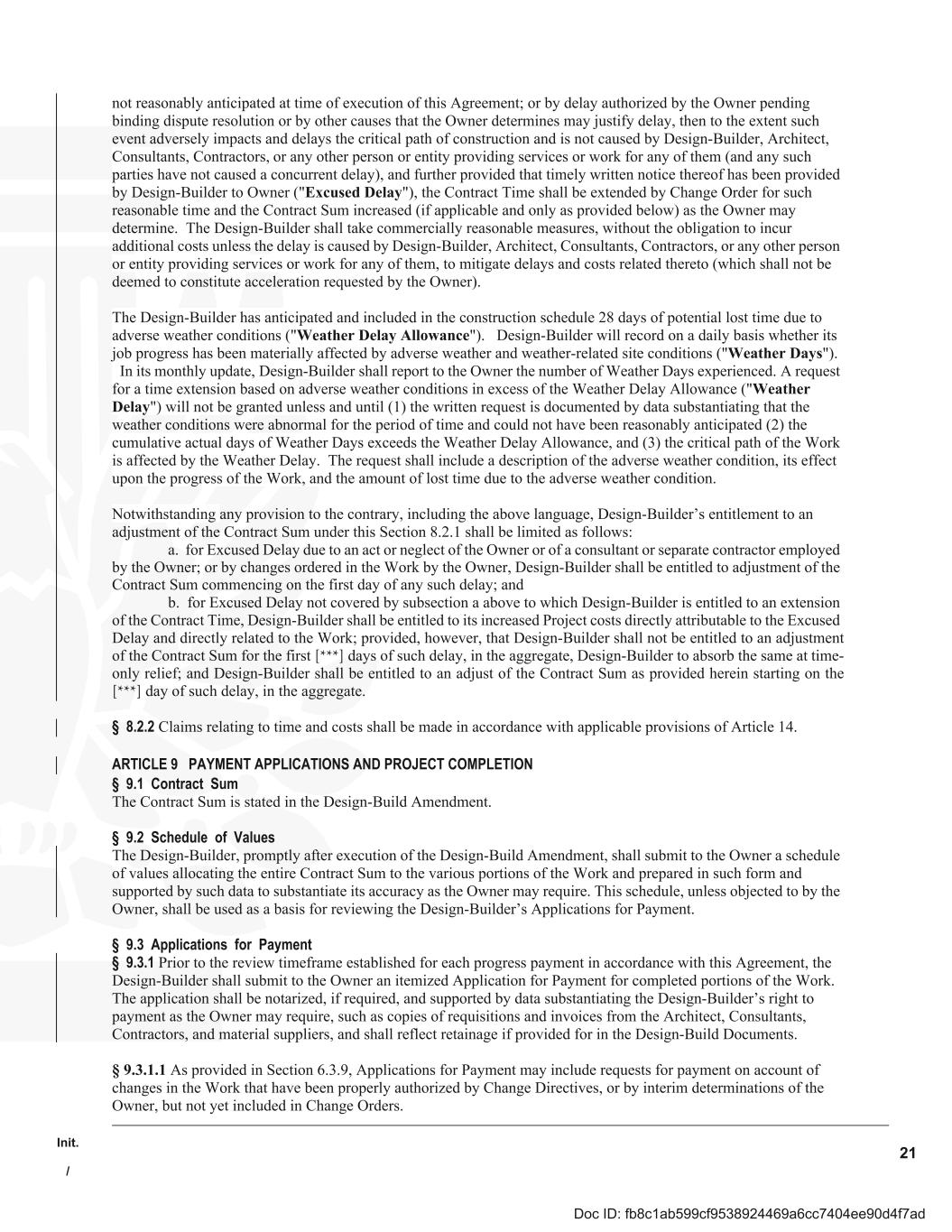
Init. / 21 not reasonably anticipated at time of execution of this Agreement; or by delay authorized by the Owner pending binding dispute resolution or by other causes that the Owner determines may justify delay, then to the extent such event adversely impacts and delays the critical path of construction and is not caused by Design-Builder, Architect, Consultants, Contractors, or any other person or entity providing services or work for any of them (and any such parties have not caused a concurrent delay), and further provided that timely written notice thereof has been provided by Design-Builder to Owner ("Excused Delay"), the Contract Time shall be extended by Change Order for such reasonable time and the Contract Sum increased (if applicable and only as provided below) as the Owner may determine. The Design-Builder shall take commercially reasonable measures, without the obligation to incur additional costs unless the delay is caused by Design-Builder, Architect, Consultants, Contractors, or any other person or entity providing services or work for any of them, to mitigate delays and costs related thereto (which shall not be deemed to constitute acceleration requested by the Owner). The Design-Builder has anticipated and included in the construction schedule 28 days of potential lost time due to adverse weather conditions ("Weather Delay Allowance"). Design-Builder will record on a daily basis whether its job progress has been materially affected by adverse weather and weather-related site conditions ("Weather Days"). In its monthly update, Design-Builder shall report to the Owner the number of Weather Days experienced. A request for a time extension based on adverse weather conditions in excess of the Weather Delay Allowance ("Weather Delay") will not be granted unless and until (1) the written request is documented by data substantiating that the weather conditions were abnormal for the period of time and could not have been reasonably anticipated (2) the cumulative actual days of Weather Days exceeds the Weather Delay Allowance, and (3) the critical path of the Work is affected by the Weather Delay. The request shall include a description of the adverse weather condition, its effect upon the progress of the Work, and the amount of lost time due to the adverse weather condition. Notwithstanding any provision to the contrary, including the above language, Design-Builder’s entitlement to an adjustment of the Contract Sum under this Section 8.2.1 shall be limited as follows: a. for Excused Delay due to an act or neglect of the Owner or of a consultant or separate contractor employed by the Owner; or by changes ordered in the Work by the Owner, Design-Builder shall be entitled to adjustment of the Contract Sum commencing on the first day of any such delay; and b. for Excused Delay not covered by subsection a above to which Design-Builder is entitled to an extension of the Contract Time, Design-Builder shall be entitled to its increased Project costs directly attributable to the Excused Delay and directly related to the Work; provided, however, that Design-Builder shall not be entitled to an adjustment of the Contract Sum for the first [***] days of such delay, in the aggregate, Design-Builder to absorb the same at time- only relief; and Design-Builder shall be entitled to an adjust of the Contract Sum as provided herein starting on the [***] day of such delay, in the aggregate. § 8.2.2 Claims relating to time and costs shall be made in accordance with applicable provisions of Article 14. ARTICLE 9 PAYMENT APPLICATIONS AND PROJECT COMPLETION § 9.1 Contract Sum The Contract Sum is stated in the Design-Build Amendment. § 9.2 Schedule of Values The Design-Builder, promptly after execution of the Design-Build Amendment, shall submit to the Owner a schedule of values allocating the entire Contract Sum to the various portions of the Work and prepared in such form and supported by such data to substantiate its accuracy as the Owner may require. This schedule, unless objected to by the Owner, shall be used as a basis for reviewing the Design-Builder’s Applications for Payment. § 9.3 Applications for Payment § 9.3.1 Prior to the review timeframe established for each progress payment in accordance with this Agreement, the Design-Builder shall submit to the Owner an itemized Application for Payment for completed portions of the Work. The application shall be notarized, if required, and supported by data substantiating the Design-Builder’s right to payment as the Owner may require, such as copies of requisitions and invoices from the Architect, Consultants, Contractors, and material suppliers, and shall reflect retainage if provided for in the Design-Build Documents. § 9.3.1.1 As provided in Section 6.3.9, Applications for Payment may include requests for payment on account of changes in the Work that have been properly authorized by Change Directives, or by interim determinations of the Owner, but not yet included in Change Orders. Doc ID: fb8c1ab599cf9538924469a6cc7404ee90d4f7ad
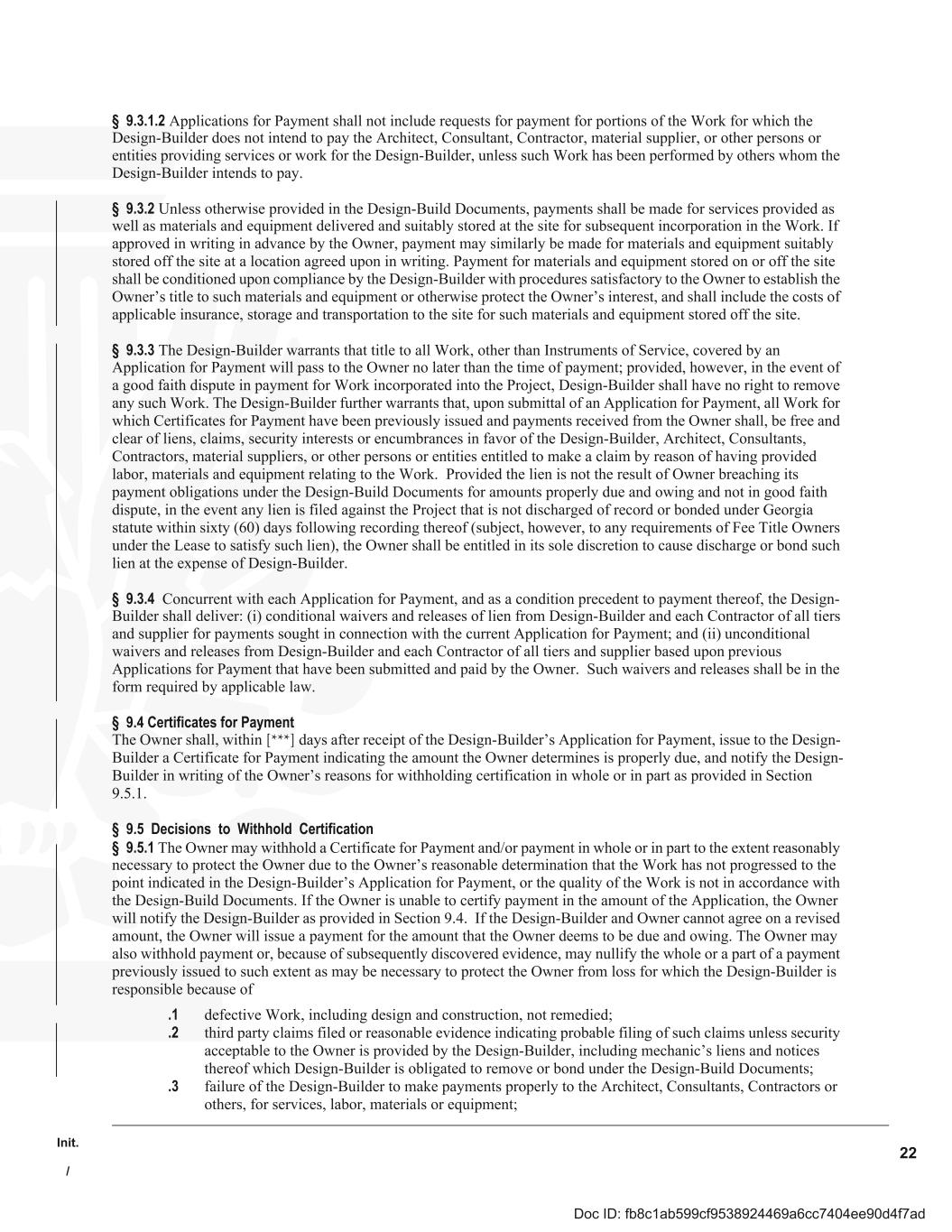
Init. / 22 § 9.3.1.2 Applications for Payment shall not include requests for payment for portions of the Work for which the Design-Builder does not intend to pay the Architect, Consultant, Contractor, material supplier, or other persons or entities providing services or work for the Design-Builder, unless such Work has been performed by others whom the Design-Builder intends to pay. § 9.3.2 Unless otherwise provided in the Design-Build Documents, payments shall be made for services provided as well as materials and equipment delivered and suitably stored at the site for subsequent incorporation in the Work. If approved in writing in advance by the Owner, payment may similarly be made for materials and equipment suitably stored off the site at a location agreed upon in writing. Payment for materials and equipment stored on or off the site shall be conditioned upon compliance by the Design-Builder with procedures satisfactory to the Owner to establish the Owner’s title to such materials and equipment or otherwise protect the Owner’s interest, and shall include the costs of applicable insurance, storage and transportation to the site for such materials and equipment stored off the site. § 9.3.3 The Design-Builder warrants that title to all Work, other than Instruments of Service, covered by an Application for Payment will pass to the Owner no later than the time of payment; provided, however, in the event of a good faith dispute in payment for Work incorporated into the Project, Design-Builder shall have no right to remove any such Work. The Design-Builder further warrants that, upon submittal of an Application for Payment, all Work for which Certificates for Payment have been previously issued and payments received from the Owner shall, be free and clear of liens, claims, security interests or encumbrances in favor of the Design-Builder, Architect, Consultants, Contractors, material suppliers, or other persons or entities entitled to make a claim by reason of having provided labor, materials and equipment relating to the Work. Provided the lien is not the result of Owner breaching its payment obligations under the Design-Build Documents for amounts properly due and owing and not in good faith dispute, in the event any lien is filed against the Project that is not discharged of record or bonded under Georgia statute within sixty (60) days following recording thereof (subject, however, to any requirements of Fee Title Owners under the Lease to satisfy such lien), the Owner shall be entitled in its sole discretion to cause discharge or bond such lien at the expense of Design-Builder. § 9.3.4 Concurrent with each Application for Payment, and as a condition precedent to payment thereof, the Design- Builder shall deliver: (i) conditional waivers and releases of lien from Design-Builder and each Contractor of all tiers and supplier for payments sought in connection with the current Application for Payment; and (ii) unconditional waivers and releases from Design-Builder and each Contractor of all tiers and supplier based upon previous Applications for Payment that have been submitted and paid by the Owner. Such waivers and releases shall be in the form required by applicable law. § 9.4 Certificates for Payment The Owner shall, within [***] days after receipt of the Design-Builder’s Application for Payment, issue to the Design- Builder a Certificate for Payment indicating the amount the Owner determines is properly due, and notify the Design- Builder in writing of the Owner’s reasons for withholding certification in whole or in part as provided in Section 9.5.1. § 9.5 Decisions to Withhold Certification § 9.5.1 The Owner may withhold a Certificate for Payment and/or payment in whole or in part to the extent reasonably necessary to protect the Owner due to the Owner’s reasonable determination that the Work has not progressed to the point indicated in the Design-Builder’s Application for Payment, or the quality of the Work is not in accordance with the Design-Build Documents. If the Owner is unable to certify payment in the amount of the Application, the Owner will notify the Design-Builder as provided in Section 9.4. If the Design-Builder and Owner cannot agree on a revised amount, the Owner will issue a payment for the amount that the Owner deems to be due and owing. The Owner may also withhold payment or, because of subsequently discovered evidence, may nullify the whole or a part of a payment previously issued to such extent as may be necessary to protect the Owner from loss for which the Design-Builder is responsible because of .1 defective Work, including design and construction, not remedied; .2 third party claims filed or reasonable evidence indicating probable filing of such claims unless security acceptable to the Owner is provided by the Design-Builder, including mechanic’s liens and notices thereof which Design-Builder is obligated to remove or bond under the Design-Build Documents; .3 failure of the Design-Builder to make payments properly to the Architect, Consultants, Contractors or others, for services, labor, materials or equipment; Doc ID: fb8c1ab599cf9538924469a6cc7404ee90d4f7ad
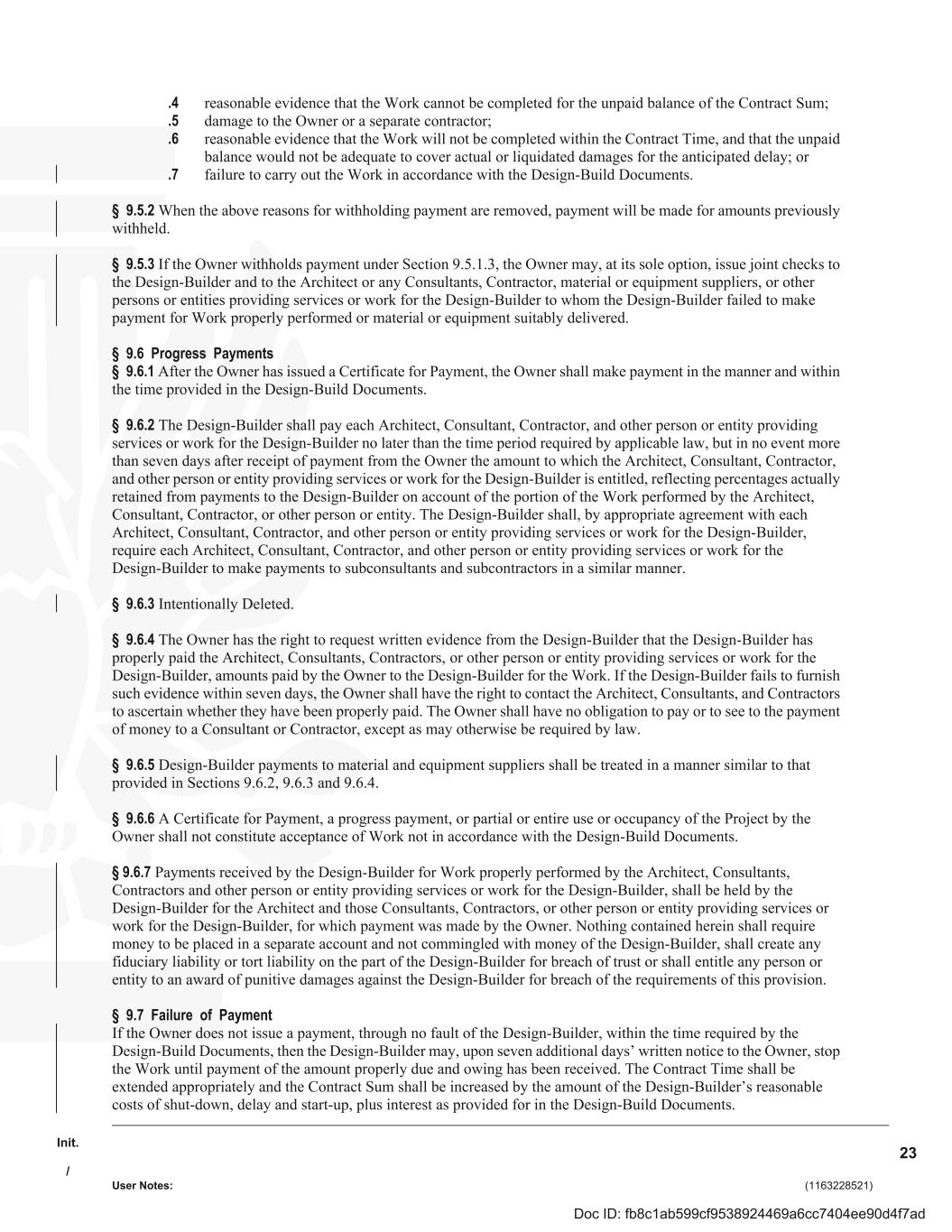
Init. / User Notes: (1163228521) 23 .4 reasonable evidence that the Work cannot be completed for the unpaid balance of the Contract Sum; .5 damage to the Owner or a separate contractor; .6 reasonable evidence that the Work will not be completed within the Contract Time, and that the unpaid balance would not be adequate to cover actual or liquidated damages for the anticipated delay; or .7 failure to carry out the Work in accordance with the Design-Build Documents. § 9.5.2 When the above reasons for withholding payment are removed, payment will be made for amounts previously withheld. § 9.5.3 If the Owner withholds payment under Section 9.5.1.3, the Owner may, at its sole option, issue joint checks to the Design-Builder and to the Architect or any Consultants, Contractor, material or equipment suppliers, or other persons or entities providing services or work for the Design-Builder to whom the Design-Builder failed to make payment for Work properly performed or material or equipment suitably delivered. § 9.6 Progress Payments § 9.6.1 After the Owner has issued a Certificate for Payment, the Owner shall make payment in the manner and within the time provided in the Design-Build Documents. § 9.6.2 The Design-Builder shall pay each Architect, Consultant, Contractor, and other person or entity providing services or work for the Design-Builder no later than the time period required by applicable law, but in no event more than seven days after receipt of payment from the Owner the amount to which the Architect, Consultant, Contractor, and other person or entity providing services or work for the Design-Builder is entitled, reflecting percentages actually retained from payments to the Design-Builder on account of the portion of the Work performed by the Architect, Consultant, Contractor, or other person or entity. The Design-Builder shall, by appropriate agreement with each Architect, Consultant, Contractor, and other person or entity providing services or work for the Design-Builder, require each Architect, Consultant, Contractor, and other person or entity providing services or work for the Design-Builder to make payments to subconsultants and subcontractors in a similar manner. § 9.6.3 Intentionally Deleted. § 9.6.4 The Owner has the right to request written evidence from the Design-Builder that the Design-Builder has properly paid the Architect, Consultants, Contractors, or other person or entity providing services or work for the Design-Builder, amounts paid by the Owner to the Design-Builder for the Work. If the Design-Builder fails to furnish such evidence within seven days, the Owner shall have the right to contact the Architect, Consultants, and Contractors to ascertain whether they have been properly paid. The Owner shall have no obligation to pay or to see to the payment of money to a Consultant or Contractor, except as may otherwise be required by law. § 9.6.5 Design-Builder payments to material and equipment suppliers shall be treated in a manner similar to that provided in Sections 9.6.2, 9.6.3 and 9.6.4. § 9.6.6 A Certificate for Payment, a progress payment, or partial or entire use or occupancy of the Project by the Owner shall not constitute acceptance of Work not in accordance with the Design-Build Documents. § 9.6.7 Payments received by the Design-Builder for Work properly performed by the Architect, Consultants, Contractors and other person or entity providing services or work for the Design-Builder, shall be held by the Design-Builder for the Architect and those Consultants, Contractors, or other person or entity providing services or work for the Design-Builder, for which payment was made by the Owner. Nothing contained herein shall require money to be placed in a separate account and not commingled with money of the Design-Builder, shall create any fiduciary liability or tort liability on the part of the Design-Builder for breach of trust or shall entitle any person or entity to an award of punitive damages against the Design-Builder for breach of the requirements of this provision. § 9.7 Failure of Payment If the Owner does not issue a payment, through no fault of the Design-Builder, within the time required by the Design-Build Documents, then the Design-Builder may, upon seven additional days’ written notice to the Owner, stop the Work until payment of the amount properly due and owing has been received. The Contract Time shall be extended appropriately and the Contract Sum shall be increased by the amount of the Design-Builder’s reasonable costs of shut-down, delay and start-up, plus interest as provided for in the Design-Build Documents. Doc ID: fb8c1ab599cf9538924469a6cc7404ee90d4f7ad
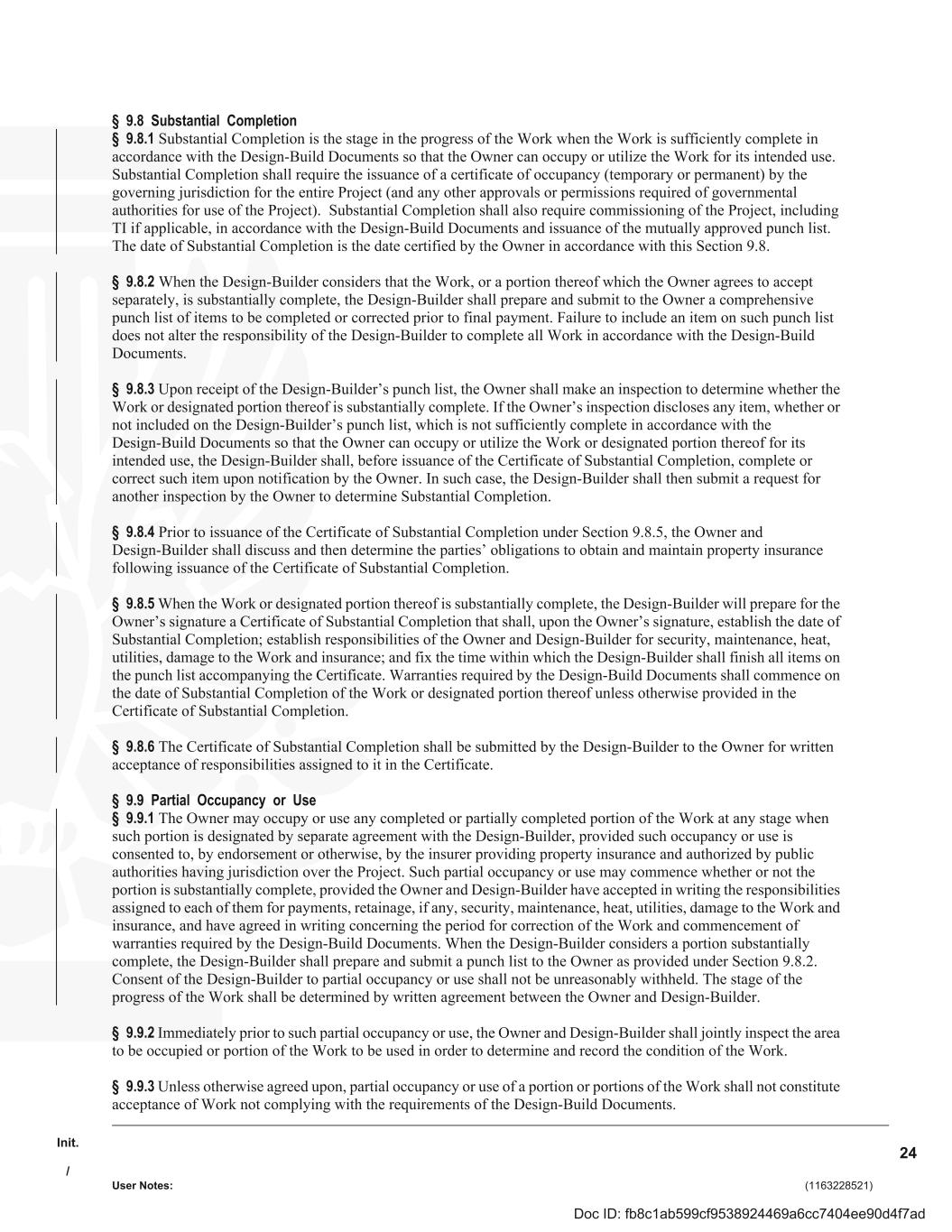
Init. / User Notes: (1163228521) 24 § 9.8 Substantial Completion § 9.8.1 Substantial Completion is the stage in the progress of the Work when the Work is sufficiently complete in accordance with the Design-Build Documents so that the Owner can occupy or utilize the Work for its intended use. Substantial Completion shall require the issuance of a certificate of occupancy (temporary or permanent) by the governing jurisdiction for the entire Project (and any other approvals or permissions required of governmental authorities for use of the Project). Substantial Completion shall also require commissioning of the Project, including TI if applicable, in accordance with the Design-Build Documents and issuance of the mutually approved punch list. The date of Substantial Completion is the date certified by the Owner in accordance with this Section 9.8. § 9.8.2 When the Design-Builder considers that the Work, or a portion thereof which the Owner agrees to accept separately, is substantially complete, the Design-Builder shall prepare and submit to the Owner a comprehensive punch list of items to be completed or corrected prior to final payment. Failure to include an item on such punch list does not alter the responsibility of the Design-Builder to complete all Work in accordance with the Design-Build Documents. § 9.8.3 Upon receipt of the Design-Builder’s punch list, the Owner shall make an inspection to determine whether the Work or designated portion thereof is substantially complete. If the Owner’s inspection discloses any item, whether or not included on the Design-Builder’s punch list, which is not sufficiently complete in accordance with the Design-Build Documents so that the Owner can occupy or utilize the Work or designated portion thereof for its intended use, the Design-Builder shall, before issuance of the Certificate of Substantial Completion, complete or correct such item upon notification by the Owner. In such case, the Design-Builder shall then submit a request for another inspection by the Owner to determine Substantial Completion. § 9.8.4 Prior to issuance of the Certificate of Substantial Completion under Section 9.8.5, the Owner and Design-Builder shall discuss and then determine the parties’ obligations to obtain and maintain property insurance following issuance of the Certificate of Substantial Completion. § 9.8.5 When the Work or designated portion thereof is substantially complete, the Design-Builder will prepare for the Owner’s signature a Certificate of Substantial Completion that shall, upon the Owner’s signature, establish the date of Substantial Completion; establish responsibilities of the Owner and Design-Builder for security, maintenance, heat, utilities, damage to the Work and insurance; and fix the time within which the Design-Builder shall finish all items on the punch list accompanying the Certificate. Warranties required by the Design-Build Documents shall commence on the date of Substantial Completion of the Work or designated portion thereof unless otherwise provided in the Certificate of Substantial Completion. § 9.8.6 The Certificate of Substantial Completion shall be submitted by the Design-Builder to the Owner for written acceptance of responsibilities assigned to it in the Certificate. § 9.9 Partial Occupancy or Use § 9.9.1 The Owner may occupy or use any completed or partially completed portion of the Work at any stage when such portion is designated by separate agreement with the Design-Builder, provided such occupancy or use is consented to, by endorsement or otherwise, by the insurer providing property insurance and authorized by public authorities having jurisdiction over the Project. Such partial occupancy or use may commence whether or not the portion is substantially complete, provided the Owner and Design-Builder have accepted in writing the responsibilities assigned to each of them for payments, retainage, if any, security, maintenance, heat, utilities, damage to the Work and insurance, and have agreed in writing concerning the period for correction of the Work and commencement of warranties required by the Design-Build Documents. When the Design-Builder considers a portion substantially complete, the Design-Builder shall prepare and submit a punch list to the Owner as provided under Section 9.8.2. Consent of the Design-Builder to partial occupancy or use shall not be unreasonably withheld. The stage of the progress of the Work shall be determined by written agreement between the Owner and Design-Builder. § 9.9.2 Immediately prior to such partial occupancy or use, the Owner and Design-Builder shall jointly inspect the area to be occupied or portion of the Work to be used in order to determine and record the condition of the Work. § 9.9.3 Unless otherwise agreed upon, partial occupancy or use of a portion or portions of the Work shall not constitute acceptance of Work not complying with the requirements of the Design-Build Documents. Doc ID: fb8c1ab599cf9538924469a6cc7404ee90d4f7ad
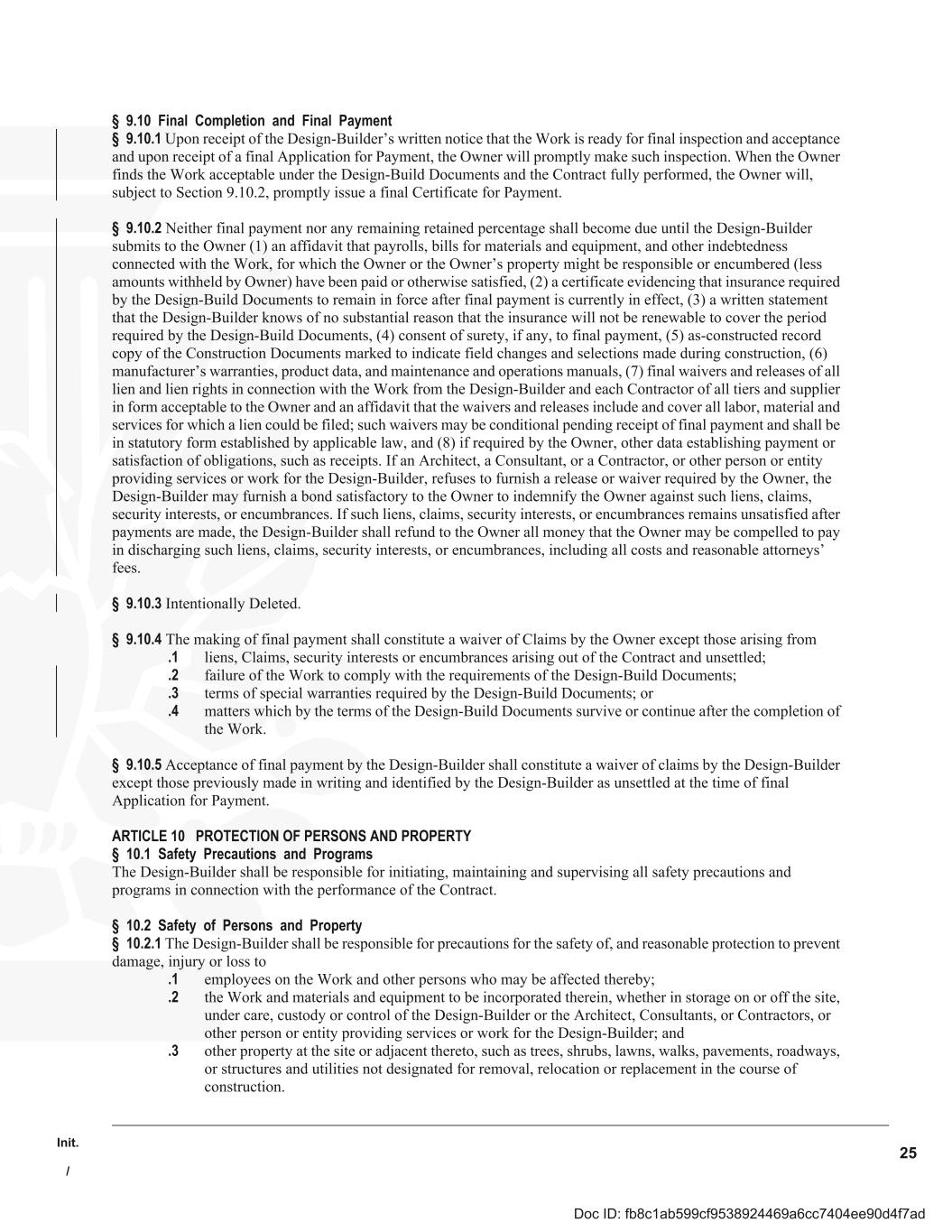
Init. / 25 § 9.10 Final Completion and Final Payment § 9.10.1 Upon receipt of the Design-Builder’s written notice that the Work is ready for final inspection and acceptance and upon receipt of a final Application for Payment, the Owner will promptly make such inspection. When the Owner finds the Work acceptable under the Design-Build Documents and the Contract fully performed, the Owner will, subject to Section 9.10.2, promptly issue a final Certificate for Payment. § 9.10.2 Neither final payment nor any remaining retained percentage shall become due until the Design-Builder submits to the Owner (1) an affidavit that payrolls, bills for materials and equipment, and other indebtedness connected with the Work, for which the Owner or the Owner’s property might be responsible or encumbered (less amounts withheld by Owner) have been paid or otherwise satisfied, (2) a certificate evidencing that insurance required by the Design-Build Documents to remain in force after final payment is currently in effect, (3) a written statement that the Design-Builder knows of no substantial reason that the insurance will not be renewable to cover the period required by the Design-Build Documents, (4) consent of surety, if any, to final payment, (5) as-constructed record copy of the Construction Documents marked to indicate field changes and selections made during construction, (6) manufacturer’s warranties, product data, and maintenance and operations manuals, (7) final waivers and releases of all lien and lien rights in connection with the Work from the Design-Builder and each Contractor of all tiers and supplier in form acceptable to the Owner and an affidavit that the waivers and releases include and cover all labor, material and services for which a lien could be filed; such waivers may be conditional pending receipt of final payment and shall be in statutory form established by applicable law, and (8) if required by the Owner, other data establishing payment or satisfaction of obligations, such as receipts. If an Architect, a Consultant, or a Contractor, or other person or entity providing services or work for the Design-Builder, refuses to furnish a release or waiver required by the Owner, the Design-Builder may furnish a bond satisfactory to the Owner to indemnify the Owner against such liens, claims, security interests, or encumbrances. If such liens, claims, security interests, or encumbrances remains unsatisfied after payments are made, the Design-Builder shall refund to the Owner all money that the Owner may be compelled to pay in discharging such liens, claims, security interests, or encumbrances, including all costs and reasonable attorneys’ fees. § 9.10.3 Intentionally Deleted. § 9.10.4 The making of final payment shall constitute a waiver of Claims by the Owner except those arising from .1 liens, Claims, security interests or encumbrances arising out of the Contract and unsettled; .2 failure of the Work to comply with the requirements of the Design-Build Documents; .3 terms of special warranties required by the Design-Build Documents; or .4 matters which by the terms of the Design-Build Documents survive or continue after the completion of the Work. § 9.10.5 Acceptance of final payment by the Design-Builder shall constitute a waiver of claims by the Design-Builder except those previously made in writing and identified by the Design-Builder as unsettled at the time of final Application for Payment. ARTICLE 10 PROTECTION OF PERSONS AND PROPERTY § 10.1 Safety Precautions and Programs The Design-Builder shall be responsible for initiating, maintaining and supervising all safety precautions and programs in connection with the performance of the Contract. § 10.2 Safety of Persons and Property § 10.2.1 The Design-Builder shall be responsible for precautions for the safety of, and reasonable protection to prevent damage, injury or loss to .1 employees on the Work and other persons who may be affected thereby; .2 the Work and materials and equipment to be incorporated therein, whether in storage on or off the site, under care, custody or control of the Design-Builder or the Architect, Consultants, or Contractors, or other person or entity providing services or work for the Design-Builder; and .3 other property at the site or adjacent thereto, such as trees, shrubs, lawns, walks, pavements, roadways, or structures and utilities not designated for removal, relocation or replacement in the course of construction. Doc ID: fb8c1ab599cf9538924469a6cc7404ee90d4f7ad
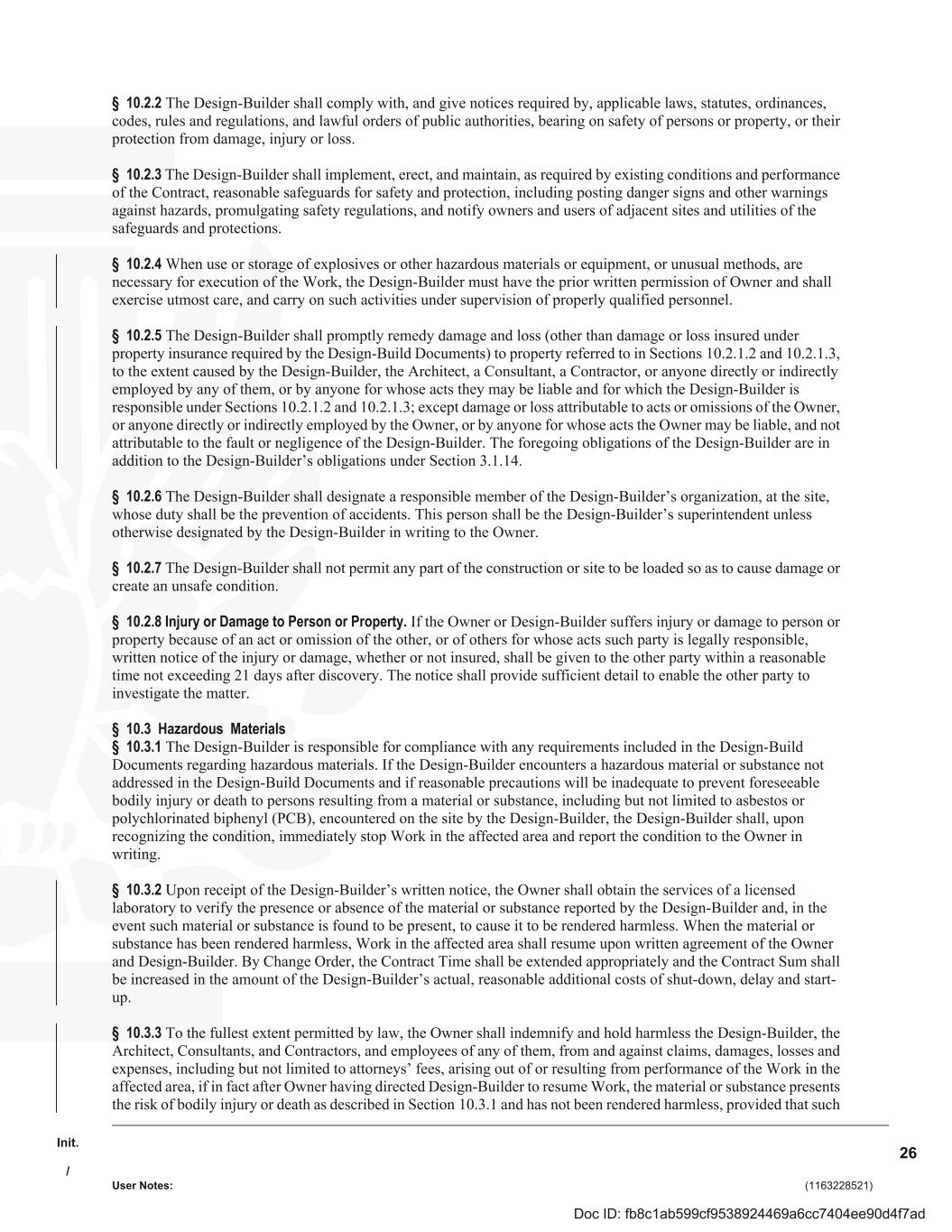
Init. / User Notes: (1163228521) 26 § 10.2.2 The Design-Builder shall comply with, and give notices required by, applicable laws, statutes, ordinances, codes, rules and regulations, and lawful orders of public authorities, bearing on safety of persons or property, or their protection from damage, injury or loss. § 10.2.3 The Design-Builder shall implement, erect, and maintain, as required by existing conditions and performance of the Contract, reasonable safeguards for safety and protection, including posting danger signs and other warnings against hazards, promulgating safety regulations, and notify owners and users of adjacent sites and utilities of the safeguards and protections. § 10.2.4 When use or storage of explosives or other hazardous materials or equipment, or unusual methods, are necessary for execution of the Work, the Design-Builder must have the prior written permission of Owner and shall exercise utmost care, and carry on such activities under supervision of properly qualified personnel. § 10.2.5 The Design-Builder shall promptly remedy damage and loss (other than damage or loss insured under property insurance required by the Design-Build Documents) to property referred to in Sections 10.2.1.2 and 10.2.1.3, to the extent caused by the Design-Builder, the Architect, a Consultant, a Contractor, or anyone directly or indirectly employed by any of them, or by anyone for whose acts they may be liable and for which the Design-Builder is responsible under Sections 10.2.1.2 and 10.2.1.3; except damage or loss attributable to acts or omissions of the Owner, or anyone directly or indirectly employed by the Owner, or by anyone for whose acts the Owner may be liable, and not attributable to the fault or negligence of the Design-Builder. The foregoing obligations of the Design-Builder are in addition to the Design-Builder’s obligations under Section 3.1.14. § 10.2.6 The Design-Builder shall designate a responsible member of the Design-Builder’s organization, at the site, whose duty shall be the prevention of accidents. This person shall be the Design-Builder’s superintendent unless otherwise designated by the Design-Builder in writing to the Owner. § 10.2.7 The Design-Builder shall not permit any part of the construction or site to be loaded so as to cause damage or create an unsafe condition. § 10.2.8 Injury or Damage to Person or Property. If the Owner or Design-Builder suffers injury or damage to person or property because of an act or omission of the other, or of others for whose acts such party is legally responsible, written notice of the injury or damage, whether or not insured, shall be given to the other party within a reasonable time not exceeding 21 days after discovery. The notice shall provide sufficient detail to enable the other party to investigate the matter. § 10.3 Hazardous Materials § 10.3.1 The Design-Builder is responsible for compliance with any requirements included in the Design-Build Documents regarding hazardous materials. If the Design-Builder encounters a hazardous material or substance not addressed in the Design-Build Documents and if reasonable precautions will be inadequate to prevent foreseeable bodily injury or death to persons resulting from a material or substance, including but not limited to asbestos or polychlorinated biphenyl (PCB), encountered on the site by the Design-Builder, the Design-Builder shall, upon recognizing the condition, immediately stop Work in the affected area and report the condition to the Owner in writing. § 10.3.2 Upon receipt of the Design-Builder’s written notice, the Owner shall obtain the services of a licensed laboratory to verify the presence or absence of the material or substance reported by the Design-Builder and, in the event such material or substance is found to be present, to cause it to be rendered harmless. When the material or substance has been rendered harmless, Work in the affected area shall resume upon written agreement of the Owner and Design-Builder. By Change Order, the Contract Time shall be extended appropriately and the Contract Sum shall be increased in the amount of the Design-Builder’s actual, reasonable additional costs of shut-down, delay and start- up. § 10.3.3 To the fullest extent permitted by law, the Owner shall indemnify and hold harmless the Design-Builder, the Architect, Consultants, and Contractors, and employees of any of them, from and against claims, damages, losses and expenses, including but not limited to attorneys’ fees, arising out of or resulting from performance of the Work in the affected area, if in fact after Owner having directed Design-Builder to resume Work, the material or substance presents the risk of bodily injury or death as described in Section 10.3.1 and has not been rendered harmless, provided that such Doc ID: fb8c1ab599cf9538924469a6cc7404ee90d4f7ad
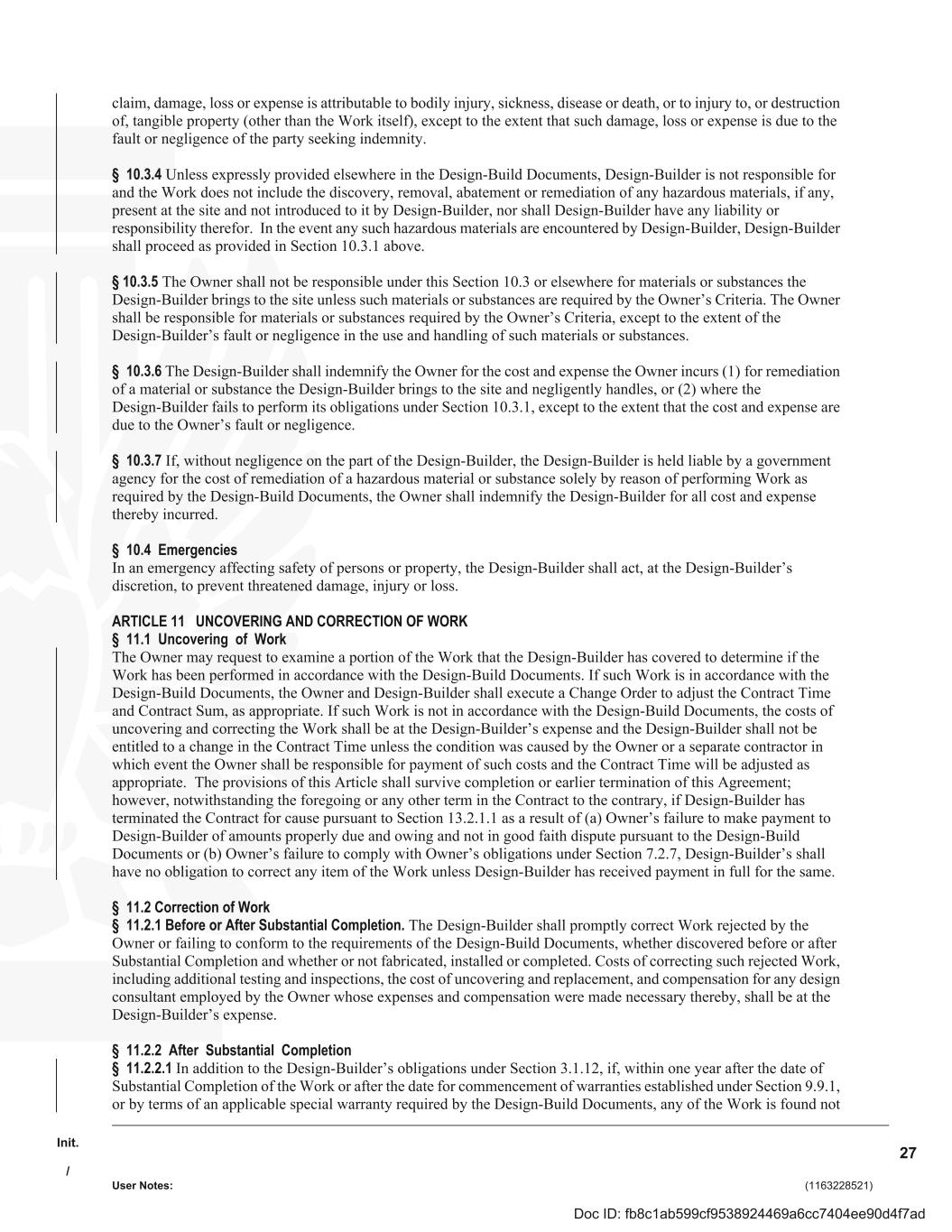
Init. / User Notes: (1163228521) 27 claim, damage, loss or expense is attributable to bodily injury, sickness, disease or death, or to injury to, or destruction of, tangible property (other than the Work itself), except to the extent that such damage, loss or expense is due to the fault or negligence of the party seeking indemnity. § 10.3.4 Unless expressly provided elsewhere in the Design-Build Documents, Design-Builder is not responsible for and the Work does not include the discovery, removal, abatement or remediation of any hazardous materials, if any, present at the site and not introduced to it by Design-Builder, nor shall Design-Builder have any liability or responsibility therefor. In the event any such hazardous materials are encountered by Design-Builder, Design-Builder shall proceed as provided in Section 10.3.1 above. § 10.3.5 The Owner shall not be responsible under this Section 10.3 or elsewhere for materials or substances the Design-Builder brings to the site unless such materials or substances are required by the Owner’s Criteria. The Owner shall be responsible for materials or substances required by the Owner’s Criteria, except to the extent of the Design-Builder’s fault or negligence in the use and handling of such materials or substances. § 10.3.6 The Design-Builder shall indemnify the Owner for the cost and expense the Owner incurs (1) for remediation of a material or substance the Design-Builder brings to the site and negligently handles, or (2) where the Design-Builder fails to perform its obligations under Section 10.3.1, except to the extent that the cost and expense are due to the Owner’s fault or negligence. § 10.3.7 If, without negligence on the part of the Design-Builder, the Design-Builder is held liable by a government agency for the cost of remediation of a hazardous material or substance solely by reason of performing Work as required by the Design-Build Documents, the Owner shall indemnify the Design-Builder for all cost and expense thereby incurred. § 10.4 Emergencies In an emergency affecting safety of persons or property, the Design-Builder shall act, at the Design-Builder’s discretion, to prevent threatened damage, injury or loss. ARTICLE 11 UNCOVERING AND CORRECTION OF WORK § 11.1 Uncovering of Work The Owner may request to examine a portion of the Work that the Design-Builder has covered to determine if the Work has been performed in accordance with the Design-Build Documents. If such Work is in accordance with the Design-Build Documents, the Owner and Design-Builder shall execute a Change Order to adjust the Contract Time and Contract Sum, as appropriate. If such Work is not in accordance with the Design-Build Documents, the costs of uncovering and correcting the Work shall be at the Design-Builder’s expense and the Design-Builder shall not be entitled to a change in the Contract Time unless the condition was caused by the Owner or a separate contractor in which event the Owner shall be responsible for payment of such costs and the Contract Time will be adjusted as appropriate. The provisions of this Article shall survive completion or earlier termination of this Agreement; however, notwithstanding the foregoing or any other term in the Contract to the contrary, if Design-Builder has terminated the Contract for cause pursuant to Section 13.2.1.1 as a result of (a) Owner’s failure to make payment to Design-Builder of amounts properly due and owing and not in good faith dispute pursuant to the Design-Build Documents or (b) Owner’s failure to comply with Owner’s obligations under Section 7.2.7, Design-Builder’s shall have no obligation to correct any item of the Work unless Design-Builder has received payment in full for the same. § 11.2 Correction of Work § 11.2.1 Before or After Substantial Completion. The Design-Builder shall promptly correct Work rejected by the Owner or failing to conform to the requirements of the Design-Build Documents, whether discovered before or after Substantial Completion and whether or not fabricated, installed or completed. Costs of correcting such rejected Work, including additional testing and inspections, the cost of uncovering and replacement, and compensation for any design consultant employed by the Owner whose expenses and compensation were made necessary thereby, shall be at the Design-Builder’s expense. § 11.2.2 After Substantial Completion § 11.2.2.1 In addition to the Design-Builder’s obligations under Section 3.1.12, if, within one year after the date of Substantial Completion of the Work or after the date for commencement of warranties established under Section 9.9.1, or by terms of an applicable special warranty required by the Design-Build Documents, any of the Work is found not Doc ID: fb8c1ab599cf9538924469a6cc7404ee90d4f7ad
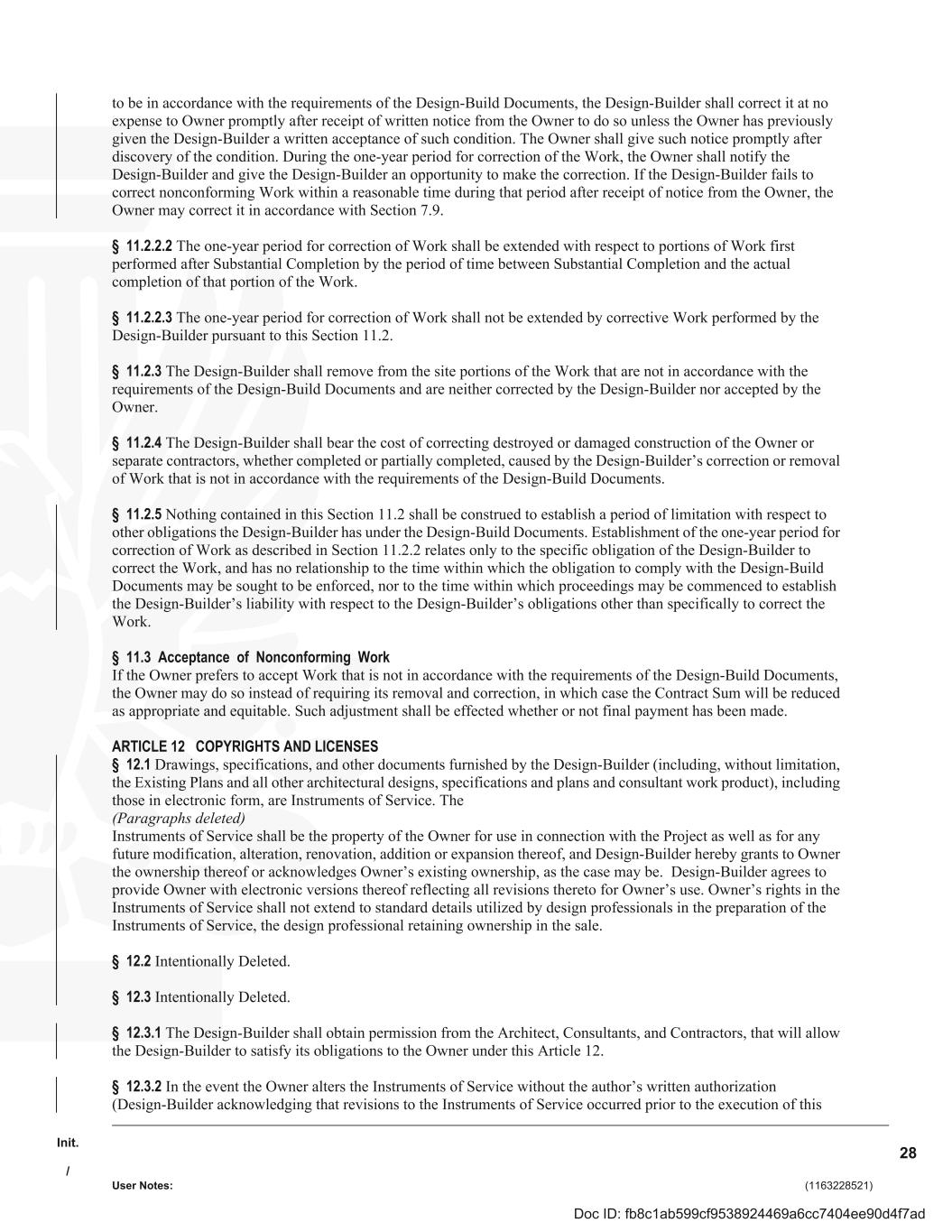
Init. / User Notes: (1163228521) 28 to be in accordance with the requirements of the Design-Build Documents, the Design-Builder shall correct it at no expense to Owner promptly after receipt of written notice from the Owner to do so unless the Owner has previously given the Design-Builder a written acceptance of such condition. The Owner shall give such notice promptly after discovery of the condition. During the one-year period for correction of the Work, the Owner shall notify the Design-Builder and give the Design-Builder an opportunity to make the correction. If the Design-Builder fails to correct nonconforming Work within a reasonable time during that period after receipt of notice from the Owner, the Owner may correct it in accordance with Section 7.9. § 11.2.2.2 The one-year period for correction of Work shall be extended with respect to portions of Work first performed after Substantial Completion by the period of time between Substantial Completion and the actual completion of that portion of the Work. § 11.2.2.3 The one-year period for correction of Work shall not be extended by corrective Work performed by the Design-Builder pursuant to this Section 11.2. § 11.2.3 The Design-Builder shall remove from the site portions of the Work that are not in accordance with the requirements of the Design-Build Documents and are neither corrected by the Design-Builder nor accepted by the Owner. § 11.2.4 The Design-Builder shall bear the cost of correcting destroyed or damaged construction of the Owner or separate contractors, whether completed or partially completed, caused by the Design-Builder’s correction or removal of Work that is not in accordance with the requirements of the Design-Build Documents. § 11.2.5 Nothing contained in this Section 11.2 shall be construed to establish a period of limitation with respect to other obligations the Design-Builder has under the Design-Build Documents. Establishment of the one-year period for correction of Work as described in Section 11.2.2 relates only to the specific obligation of the Design-Builder to correct the Work, and has no relationship to the time within which the obligation to comply with the Design-Build Documents may be sought to be enforced, nor to the time within which proceedings may be commenced to establish the Design-Builder’s liability with respect to the Design-Builder’s obligations other than specifically to correct the Work. § 11.3 Acceptance of Nonconforming Work If the Owner prefers to accept Work that is not in accordance with the requirements of the Design-Build Documents, the Owner may do so instead of requiring its removal and correction, in which case the Contract Sum will be reduced as appropriate and equitable. Such adjustment shall be effected whether or not final payment has been made. ARTICLE 12 COPYRIGHTS AND LICENSES § 12.1 Drawings, specifications, and other documents furnished by the Design-Builder (including, without limitation, the Existing Plans and all other architectural designs, specifications and plans and consultant work product), including those in electronic form, are Instruments of Service. The (Paragraphs deleted) Instruments of Service shall be the property of the Owner for use in connection with the Project as well as for any future modification, alteration, renovation, addition or expansion thereof, and Design-Builder hereby grants to Owner the ownership thereof or acknowledges Owner’s existing ownership, as the case may be. Design-Builder agrees to provide Owner with electronic versions thereof reflecting all revisions thereto for Owner’s use. Owner’s rights in the Instruments of Service shall not extend to standard details utilized by design professionals in the preparation of the Instruments of Service, the design professional retaining ownership in the sale. § 12.2 Intentionally Deleted. § 12.3 Intentionally Deleted. § 12.3.1 The Design-Builder shall obtain permission from the Architect, Consultants, and Contractors, that will allow the Design-Builder to satisfy its obligations to the Owner under this Article 12. § 12.3.2 In the event the Owner alters the Instruments of Service without the author’s written authorization (Design-Builder acknowledging that revisions to the Instruments of Service occurred prior to the execution of this Doc ID: fb8c1ab599cf9538924469a6cc7404ee90d4f7ad
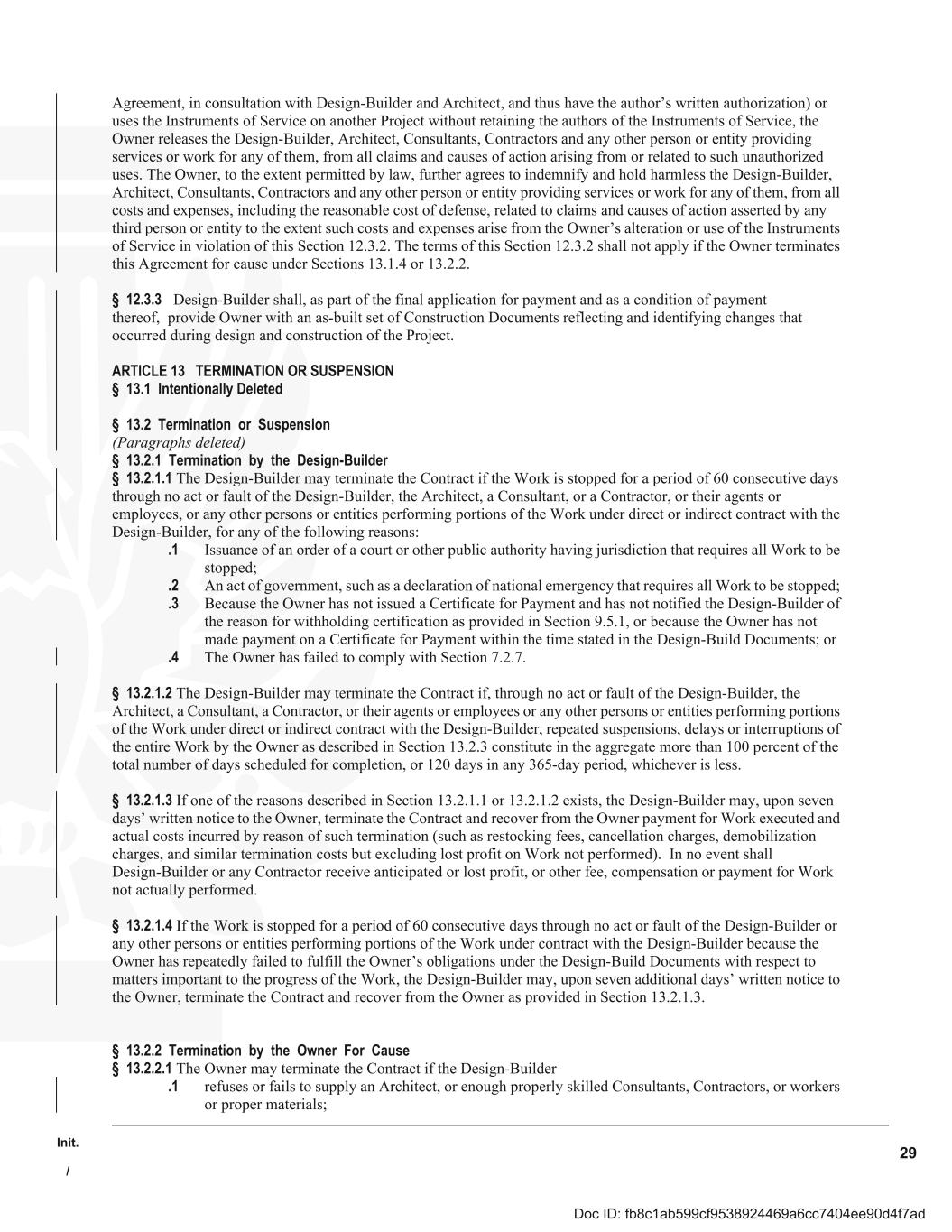
Init. / 29 Agreement, in consultation with Design-Builder and Architect, and thus have the author’s written authorization) or uses the Instruments of Service on another Project without retaining the authors of the Instruments of Service, the Owner releases the Design-Builder, Architect, Consultants, Contractors and any other person or entity providing services or work for any of them, from all claims and causes of action arising from or related to such unauthorized uses. The Owner, to the extent permitted by law, further agrees to indemnify and hold harmless the Design-Builder, Architect, Consultants, Contractors and any other person or entity providing services or work for any of them, from all costs and expenses, including the reasonable cost of defense, related to claims and causes of action asserted by any third person or entity to the extent such costs and expenses arise from the Owner’s alteration or use of the Instruments of Service in violation of this Section 12.3.2. The terms of this Section 12.3.2 shall not apply if the Owner terminates this Agreement for cause under Sections 13.1.4 or 13.2.2. § 12.3.3 Design-Builder shall, as part of the final application for payment and as a condition of payment thereof, provide Owner with an as-built set of Construction Documents reflecting and identifying changes that occurred during design and construction of the Project. ARTICLE 13 TERMINATION OR SUSPENSION § 13.1 Intentionally Deleted § 13.2 Termination or Suspension (Paragraphs deleted) § 13.2.1 Termination by the Design-Builder § 13.2.1.1 The Design-Builder may terminate the Contract if the Work is stopped for a period of 60 consecutive days through no act or fault of the Design-Builder, the Architect, a Consultant, or a Contractor, or their agents or employees, or any other persons or entities performing portions of the Work under direct or indirect contract with the Design-Builder, for any of the following reasons: .1 Issuance of an order of a court or other public authority having jurisdiction that requires all Work to be stopped; .2 An act of government, such as a declaration of national emergency that requires all Work to be stopped; .3 Because the Owner has not issued a Certificate for Payment and has not notified the Design-Builder of the reason for withholding certification as provided in Section 9.5.1, or because the Owner has not made payment on a Certificate for Payment within the time stated in the Design-Build Documents; or .4 The Owner has failed to comply with Section 7.2.7. § 13.2.1.2 The Design-Builder may terminate the Contract if, through no act or fault of the Design-Builder, the Architect, a Consultant, a Contractor, or their agents or employees or any other persons or entities performing portions of the Work under direct or indirect contract with the Design-Builder, repeated suspensions, delays or interruptions of the entire Work by the Owner as described in Section 13.2.3 constitute in the aggregate more than 100 percent of the total number of days scheduled for completion, or 120 days in any 365-day period, whichever is less. § 13.2.1.3 If one of the reasons described in Section 13.2.1.1 or 13.2.1.2 exists, the Design-Builder may, upon seven days’ written notice to the Owner, terminate the Contract and recover from the Owner payment for Work executed and actual costs incurred by reason of such termination (such as restocking fees, cancellation charges, demobilization charges, and similar termination costs but excluding lost profit on Work not performed). In no event shall Design-Builder or any Contractor receive anticipated or lost profit, or other fee, compensation or payment for Work not actually performed. § 13.2.1.4 If the Work is stopped for a period of 60 consecutive days through no act or fault of the Design-Builder or any other persons or entities performing portions of the Work under contract with the Design-Builder because the Owner has repeatedly failed to fulfill the Owner’s obligations under the Design-Build Documents with respect to matters important to the progress of the Work, the Design-Builder may, upon seven additional days’ written notice to the Owner, terminate the Contract and recover from the Owner as provided in Section 13.2.1.3. § 13.2.2 Termination by the Owner For Cause § 13.2.2.1 The Owner may terminate the Contract if the Design-Builder .1 refuses or fails to supply an Architect, or enough properly skilled Consultants, Contractors, or workers or proper materials; Doc ID: fb8c1ab599cf9538924469a6cc7404ee90d4f7ad
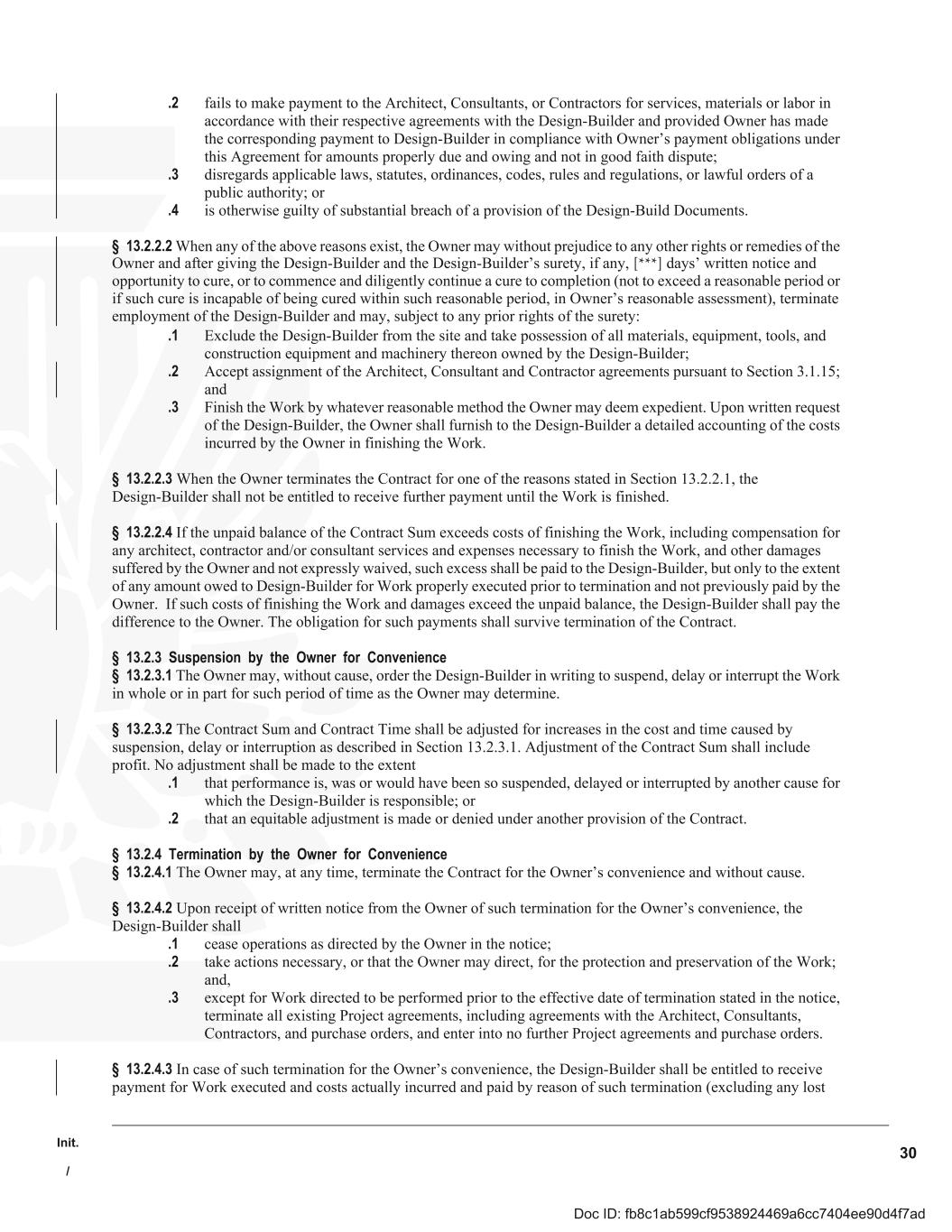
Init. / 30 .2 fails to make payment to the Architect, Consultants, or Contractors for services, materials or labor in accordance with their respective agreements with the Design-Builder and provided Owner has made the corresponding payment to Design-Builder in compliance with Owner’s payment obligations under this Agreement for amounts properly due and owing and not in good faith dispute; .3 disregards applicable laws, statutes, ordinances, codes, rules and regulations, or lawful orders of a public authority; or .4 is otherwise guilty of substantial breach of a provision of the Design-Build Documents. § 13.2.2.2 When any of the above reasons exist, the Owner may without prejudice to any other rights or remedies of the Owner and after giving the Design-Builder and the Design-Builder’s surety, if any, [***] days’ written notice and opportunity to cure, or to commence and diligently continue a cure to completion (not to exceed a reasonable period or if such cure is incapable of being cured within such reasonable period, in Owner’s reasonable assessment), terminate employment of the Design-Builder and may, subject to any prior rights of the surety: .1 Exclude the Design-Builder from the site and take possession of all materials, equipment, tools, and construction equipment and machinery thereon owned by the Design-Builder; .2 Accept assignment of the Architect, Consultant and Contractor agreements pursuant to Section 3.1.15; and .3 Finish the Work by whatever reasonable method the Owner may deem expedient. Upon written request of the Design-Builder, the Owner shall furnish to the Design-Builder a detailed accounting of the costs incurred by the Owner in finishing the Work. § 13.2.2.3 When the Owner terminates the Contract for one of the reasons stated in Section 13.2.2.1, the Design-Builder shall not be entitled to receive further payment until the Work is finished. § 13.2.2.4 If the unpaid balance of the Contract Sum exceeds costs of finishing the Work, including compensation for any architect, contractor and/or consultant services and expenses necessary to finish the Work, and other damages suffered by the Owner and not expressly waived, such excess shall be paid to the Design-Builder, but only to the extent of any amount owed to Design-Builder for Work properly executed prior to termination and not previously paid by the Owner. If such costs of finishing the Work and damages exceed the unpaid balance, the Design-Builder shall pay the difference to the Owner. The obligation for such payments shall survive termination of the Contract. § 13.2.3 Suspension by the Owner for Convenience § 13.2.3.1 The Owner may, without cause, order the Design-Builder in writing to suspend, delay or interrupt the Work in whole or in part for such period of time as the Owner may determine. § 13.2.3.2 The Contract Sum and Contract Time shall be adjusted for increases in the cost and time caused by suspension, delay or interruption as described in Section 13.2.3.1. Adjustment of the Contract Sum shall include profit. No adjustment shall be made to the extent .1 that performance is, was or would have been so suspended, delayed or interrupted by another cause for which the Design-Builder is responsible; or .2 that an equitable adjustment is made or denied under another provision of the Contract. § 13.2.4 Termination by the Owner for Convenience § 13.2.4.1 The Owner may, at any time, terminate the Contract for the Owner’s convenience and without cause. § 13.2.4.2 Upon receipt of written notice from the Owner of such termination for the Owner’s convenience, the Design-Builder shall .1 cease operations as directed by the Owner in the notice; .2 take actions necessary, or that the Owner may direct, for the protection and preservation of the Work; and, .3 except for Work directed to be performed prior to the effective date of termination stated in the notice, terminate all existing Project agreements, including agreements with the Architect, Consultants, Contractors, and purchase orders, and enter into no further Project agreements and purchase orders. § 13.2.4.3 In case of such termination for the Owner’s convenience, the Design-Builder shall be entitled to receive payment for Work executed and costs actually incurred and paid by reason of such termination (excluding any lost Doc ID: fb8c1ab599cf9538924469a6cc7404ee90d4f7ad
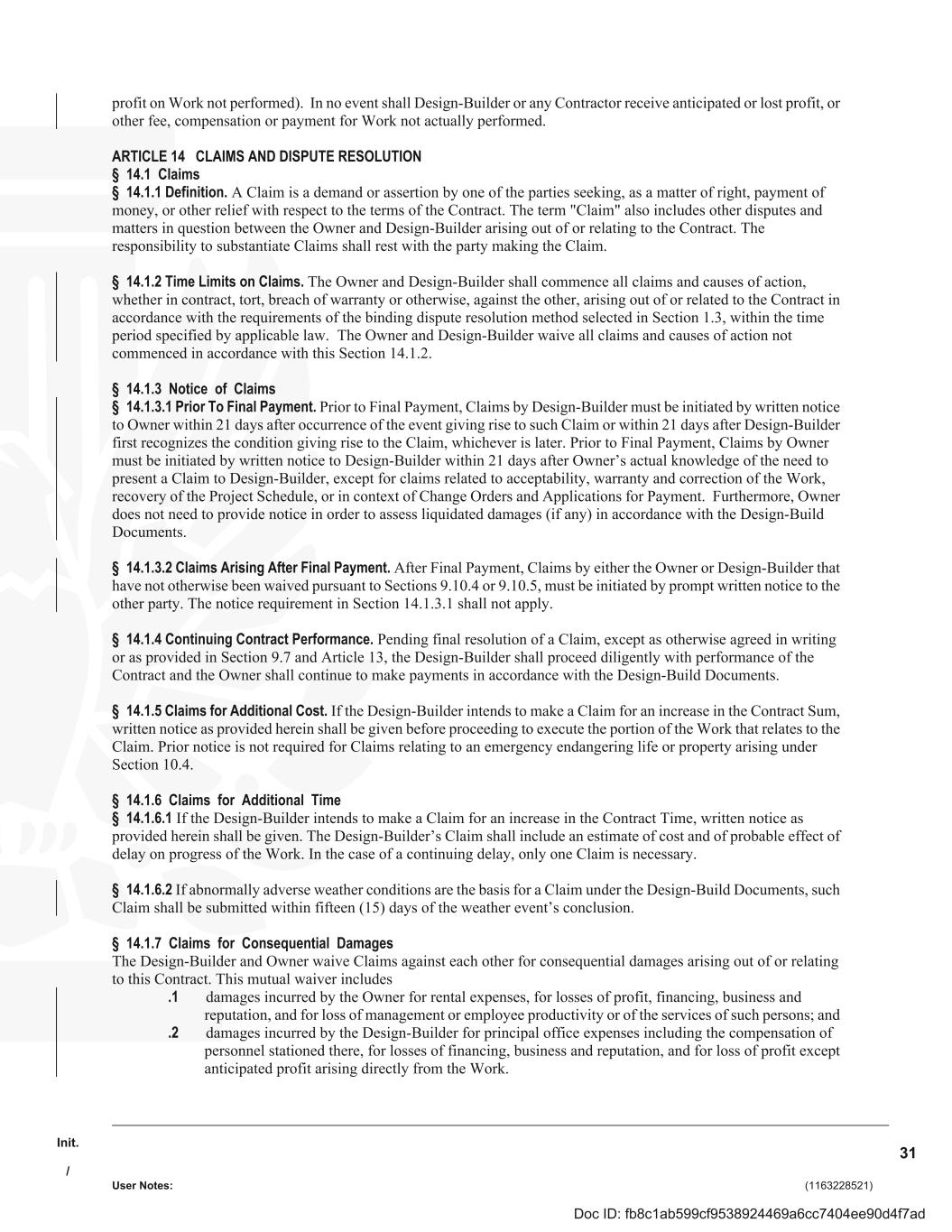
Init. / User Notes: (1163228521) 31 profit on Work not performed). In no event shall Design-Builder or any Contractor receive anticipated or lost profit, or other fee, compensation or payment for Work not actually performed. ARTICLE 14 CLAIMS AND DISPUTE RESOLUTION § 14.1 Claims § 14.1.1 Definition. A Claim is a demand or assertion by one of the parties seeking, as a matter of right, payment of money, or other relief with respect to the terms of the Contract. The term "Claim" also includes other disputes and matters in question between the Owner and Design-Builder arising out of or relating to the Contract. The responsibility to substantiate Claims shall rest with the party making the Claim. § 14.1.2 Time Limits on Claims. The Owner and Design-Builder shall commence all claims and causes of action, whether in contract, tort, breach of warranty or otherwise, against the other, arising out of or related to the Contract in accordance with the requirements of the binding dispute resolution method selected in Section 1.3, within the time period specified by applicable law. The Owner and Design-Builder waive all claims and causes of action not commenced in accordance with this Section 14.1.2. § 14.1.3 Notice of Claims § 14.1.3.1 Prior To Final Payment. Prior to Final Payment, Claims by Design-Builder must be initiated by written notice to Owner within 21 days after occurrence of the event giving rise to such Claim or within 21 days after Design-Builder first recognizes the condition giving rise to the Claim, whichever is later. Prior to Final Payment, Claims by Owner must be initiated by written notice to Design-Builder within 21 days after Owner’s actual knowledge of the need to present a Claim to Design-Builder, except for claims related to acceptability, warranty and correction of the Work, recovery of the Project Schedule, or in context of Change Orders and Applications for Payment. Furthermore, Owner does not need to provide notice in order to assess liquidated damages (if any) in accordance with the Design-Build Documents. § 14.1.3.2 Claims Arising After Final Payment. After Final Payment, Claims by either the Owner or Design-Builder that have not otherwise been waived pursuant to Sections 9.10.4 or 9.10.5, must be initiated by prompt written notice to the other party. The notice requirement in Section 14.1.3.1 shall not apply. § 14.1.4 Continuing Contract Performance. Pending final resolution of a Claim, except as otherwise agreed in writing or as provided in Section 9.7 and Article 13, the Design-Builder shall proceed diligently with performance of the Contract and the Owner shall continue to make payments in accordance with the Design-Build Documents. § 14.1.5 Claims for Additional Cost. If the Design-Builder intends to make a Claim for an increase in the Contract Sum, written notice as provided herein shall be given before proceeding to execute the portion of the Work that relates to the Claim. Prior notice is not required for Claims relating to an emergency endangering life or property arising under Section 10.4. § 14.1.6 Claims for Additional Time § 14.1.6.1 If the Design-Builder intends to make a Claim for an increase in the Contract Time, written notice as provided herein shall be given. The Design-Builder’s Claim shall include an estimate of cost and of probable effect of delay on progress of the Work. In the case of a continuing delay, only one Claim is necessary. § 14.1.6.2 If abnormally adverse weather conditions are the basis for a Claim under the Design-Build Documents, such Claim shall be submitted within fifteen (15) days of the weather event’s conclusion. § 14.1.7 Claims for Consequential Damages The Design-Builder and Owner waive Claims against each other for consequential damages arising out of or relating to this Contract. This mutual waiver includes .1 damages incurred by the Owner for rental expenses, for losses of profit, financing, business and reputation, and for loss of management or employee productivity or of the services of such persons; and .2 damages incurred by the Design-Builder for principal office expenses including the compensation of personnel stationed there, for losses of financing, business and reputation, and for loss of profit except anticipated profit arising directly from the Work. Doc ID: fb8c1ab599cf9538924469a6cc7404ee90d4f7ad
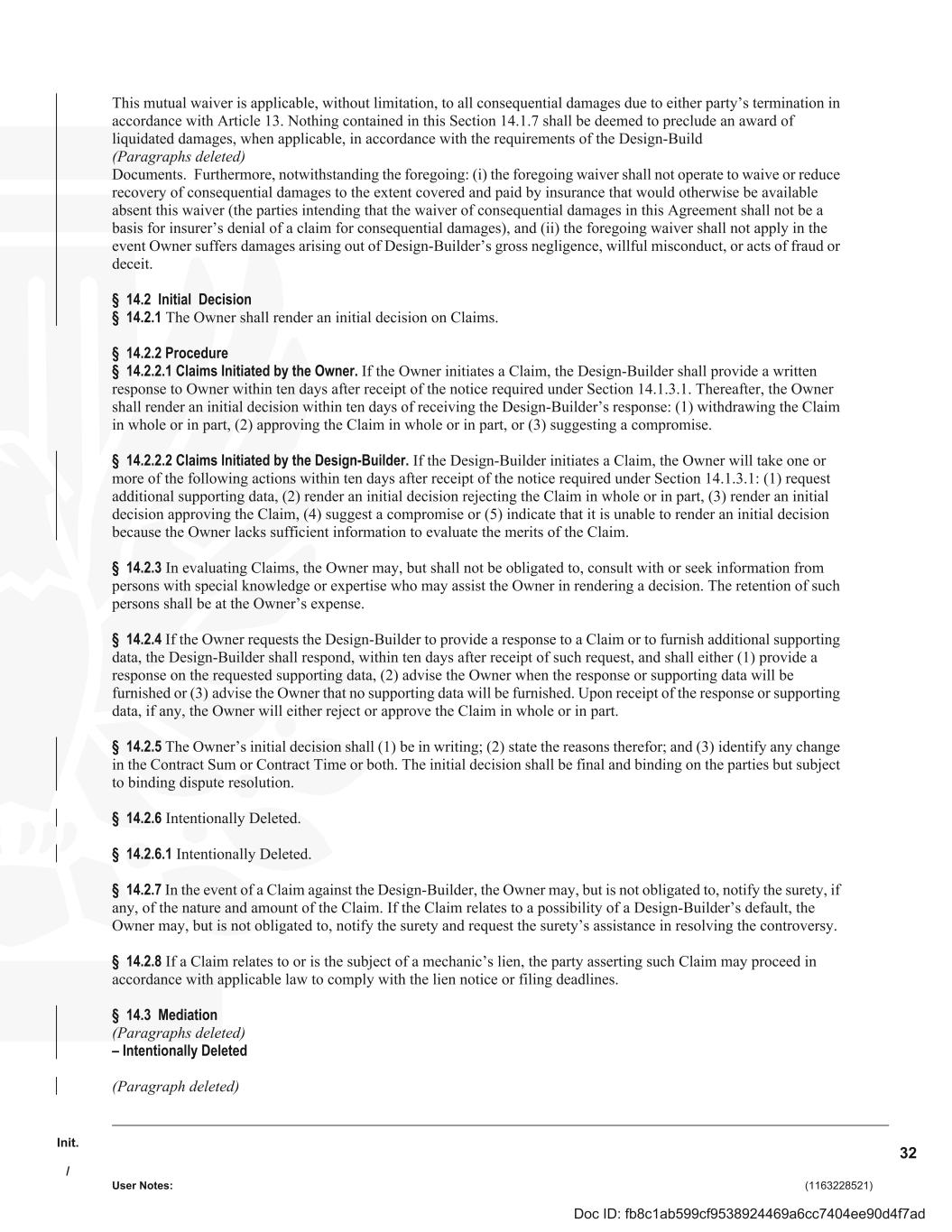
Init. / User Notes: (1163228521) 32 This mutual waiver is applicable, without limitation, to all consequential damages due to either party’s termination in accordance with Article 13. Nothing contained in this Section 14.1.7 shall be deemed to preclude an award of liquidated damages, when applicable, in accordance with the requirements of the Design-Build (Paragraphs deleted) Documents. Furthermore, notwithstanding the foregoing: (i) the foregoing waiver shall not operate to waive or reduce recovery of consequential damages to the extent covered and paid by insurance that would otherwise be available absent this waiver (the parties intending that the waiver of consequential damages in this Agreement shall not be a basis for insurer’s denial of a claim for consequential damages), and (ii) the foregoing waiver shall not apply in the event Owner suffers damages arising out of Design-Builder’s gross negligence, willful misconduct, or acts of fraud or deceit. § 14.2 Initial Decision § 14.2.1 The Owner shall render an initial decision on Claims. § 14.2.2 Procedure § 14.2.2.1 Claims Initiated by the Owner. If the Owner initiates a Claim, the Design-Builder shall provide a written response to Owner within ten days after receipt of the notice required under Section 14.1.3.1. Thereafter, the Owner shall render an initial decision within ten days of receiving the Design-Builder’s response: (1) withdrawing the Claim in whole or in part, (2) approving the Claim in whole or in part, or (3) suggesting a compromise. § 14.2.2.2 Claims Initiated by the Design-Builder. If the Design-Builder initiates a Claim, the Owner will take one or more of the following actions within ten days after receipt of the notice required under Section 14.1.3.1: (1) request additional supporting data, (2) render an initial decision rejecting the Claim in whole or in part, (3) render an initial decision approving the Claim, (4) suggest a compromise or (5) indicate that it is unable to render an initial decision because the Owner lacks sufficient information to evaluate the merits of the Claim. § 14.2.3 In evaluating Claims, the Owner may, but shall not be obligated to, consult with or seek information from persons with special knowledge or expertise who may assist the Owner in rendering a decision. The retention of such persons shall be at the Owner’s expense. § 14.2.4 If the Owner requests the Design-Builder to provide a response to a Claim or to furnish additional supporting data, the Design-Builder shall respond, within ten days after receipt of such request, and shall either (1) provide a response on the requested supporting data, (2) advise the Owner when the response or supporting data will be furnished or (3) advise the Owner that no supporting data will be furnished. Upon receipt of the response or supporting data, if any, the Owner will either reject or approve the Claim in whole or in part. § 14.2.5 The Owner’s initial decision shall (1) be in writing; (2) state the reasons therefor; and (3) identify any change in the Contract Sum or Contract Time or both. The initial decision shall be final and binding on the parties but subject to binding dispute resolution. § 14.2.6 Intentionally Deleted. § 14.2.6.1 Intentionally Deleted. § 14.2.7 In the event of a Claim against the Design-Builder, the Owner may, but is not obligated to, notify the surety, if any, of the nature and amount of the Claim. If the Claim relates to a possibility of a Design-Builder’s default, the Owner may, but is not obligated to, notify the surety and request the surety’s assistance in resolving the controversy. § 14.2.8 If a Claim relates to or is the subject of a mechanic’s lien, the party asserting such Claim may proceed in accordance with applicable law to comply with the lien notice or filing deadlines. § 14.3 Mediation (Paragraphs deleted) – Intentionally Deleted (Paragraph deleted) Doc ID: fb8c1ab599cf9538924469a6cc7404ee90d4f7ad
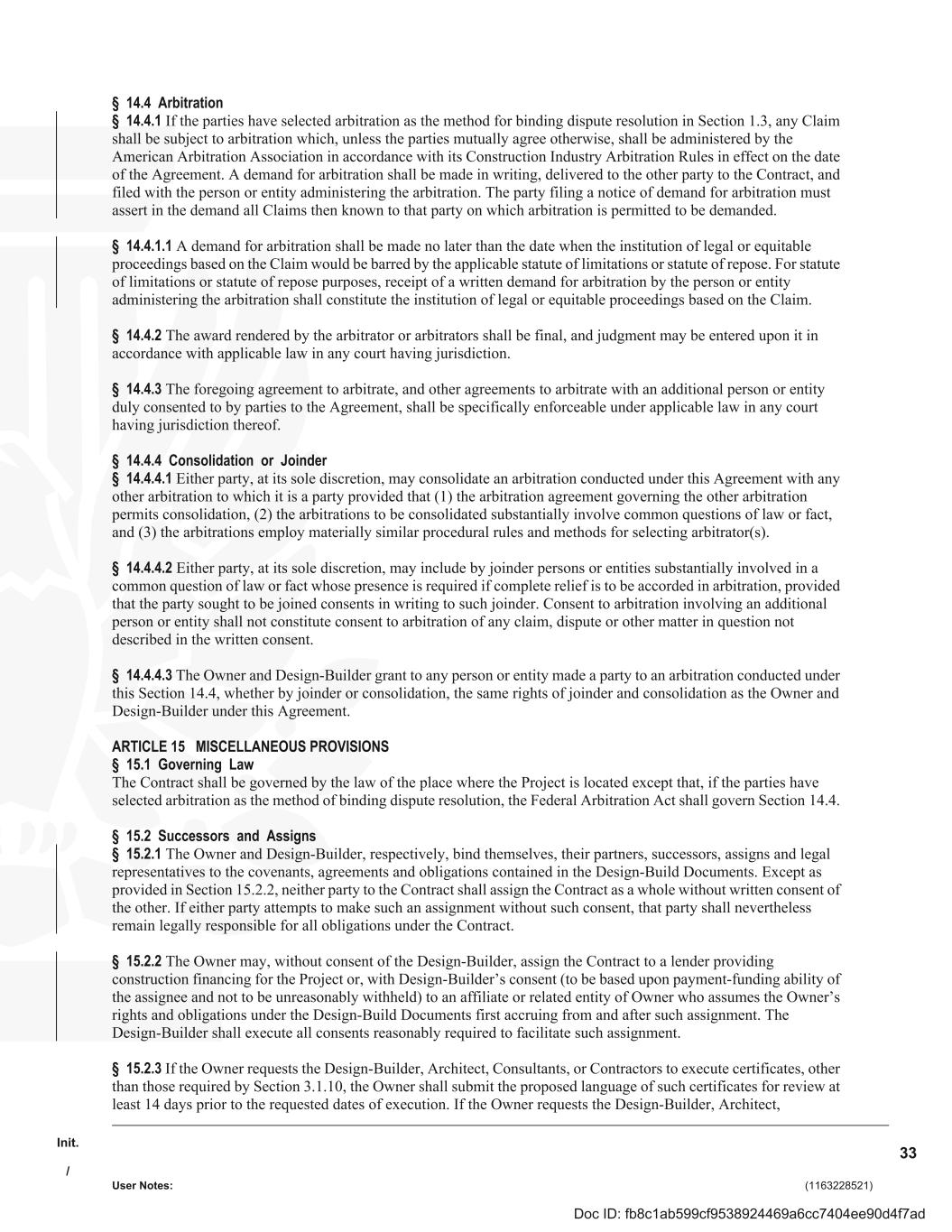
Init. / User Notes: (1163228521) 33 § 14.4 Arbitration § 14.4.1 If the parties have selected arbitration as the method for binding dispute resolution in Section 1.3, any Claim shall be subject to arbitration which, unless the parties mutually agree otherwise, shall be administered by the American Arbitration Association in accordance with its Construction Industry Arbitration Rules in effect on the date of the Agreement. A demand for arbitration shall be made in writing, delivered to the other party to the Contract, and filed with the person or entity administering the arbitration. The party filing a notice of demand for arbitration must assert in the demand all Claims then known to that party on which arbitration is permitted to be demanded. § 14.4.1.1 A demand for arbitration shall be made no later than the date when the institution of legal or equitable proceedings based on the Claim would be barred by the applicable statute of limitations or statute of repose. For statute of limitations or statute of repose purposes, receipt of a written demand for arbitration by the person or entity administering the arbitration shall constitute the institution of legal or equitable proceedings based on the Claim. § 14.4.2 The award rendered by the arbitrator or arbitrators shall be final, and judgment may be entered upon it in accordance with applicable law in any court having jurisdiction. § 14.4.3 The foregoing agreement to arbitrate, and other agreements to arbitrate with an additional person or entity duly consented to by parties to the Agreement, shall be specifically enforceable under applicable law in any court having jurisdiction thereof. § 14.4.4 Consolidation or Joinder § 14.4.4.1 Either party, at its sole discretion, may consolidate an arbitration conducted under this Agreement with any other arbitration to which it is a party provided that (1) the arbitration agreement governing the other arbitration permits consolidation, (2) the arbitrations to be consolidated substantially involve common questions of law or fact, and (3) the arbitrations employ materially similar procedural rules and methods for selecting arbitrator(s). § 14.4.4.2 Either party, at its sole discretion, may include by joinder persons or entities substantially involved in a common question of law or fact whose presence is required if complete relief is to be accorded in arbitration, provided that the party sought to be joined consents in writing to such joinder. Consent to arbitration involving an additional person or entity shall not constitute consent to arbitration of any claim, dispute or other matter in question not described in the written consent. § 14.4.4.3 The Owner and Design-Builder grant to any person or entity made a party to an arbitration conducted under this Section 14.4, whether by joinder or consolidation, the same rights of joinder and consolidation as the Owner and Design-Builder under this Agreement. ARTICLE 15 MISCELLANEOUS PROVISIONS § 15.1 Governing Law The Contract shall be governed by the law of the place where the Project is located except that, if the parties have selected arbitration as the method of binding dispute resolution, the Federal Arbitration Act shall govern Section 14.4. § 15.2 Successors and Assigns § 15.2.1 The Owner and Design-Builder, respectively, bind themselves, their partners, successors, assigns and legal representatives to the covenants, agreements and obligations contained in the Design-Build Documents. Except as provided in Section 15.2.2, neither party to the Contract shall assign the Contract as a whole without written consent of the other. If either party attempts to make such an assignment without such consent, that party shall nevertheless remain legally responsible for all obligations under the Contract. § 15.2.2 The Owner may, without consent of the Design-Builder, assign the Contract to a lender providing construction financing for the Project or, with Design-Builder’s consent (to be based upon payment-funding ability of the assignee and not to be unreasonably withheld) to an affiliate or related entity of Owner who assumes the Owner’s rights and obligations under the Design-Build Documents first accruing from and after such assignment. The Design-Builder shall execute all consents reasonably required to facilitate such assignment. § 15.2.3 If the Owner requests the Design-Builder, Architect, Consultants, or Contractors to execute certificates, other than those required by Section 3.1.10, the Owner shall submit the proposed language of such certificates for review at least 14 days prior to the requested dates of execution. If the Owner requests the Design-Builder, Architect, Doc ID: fb8c1ab599cf9538924469a6cc7404ee90d4f7ad
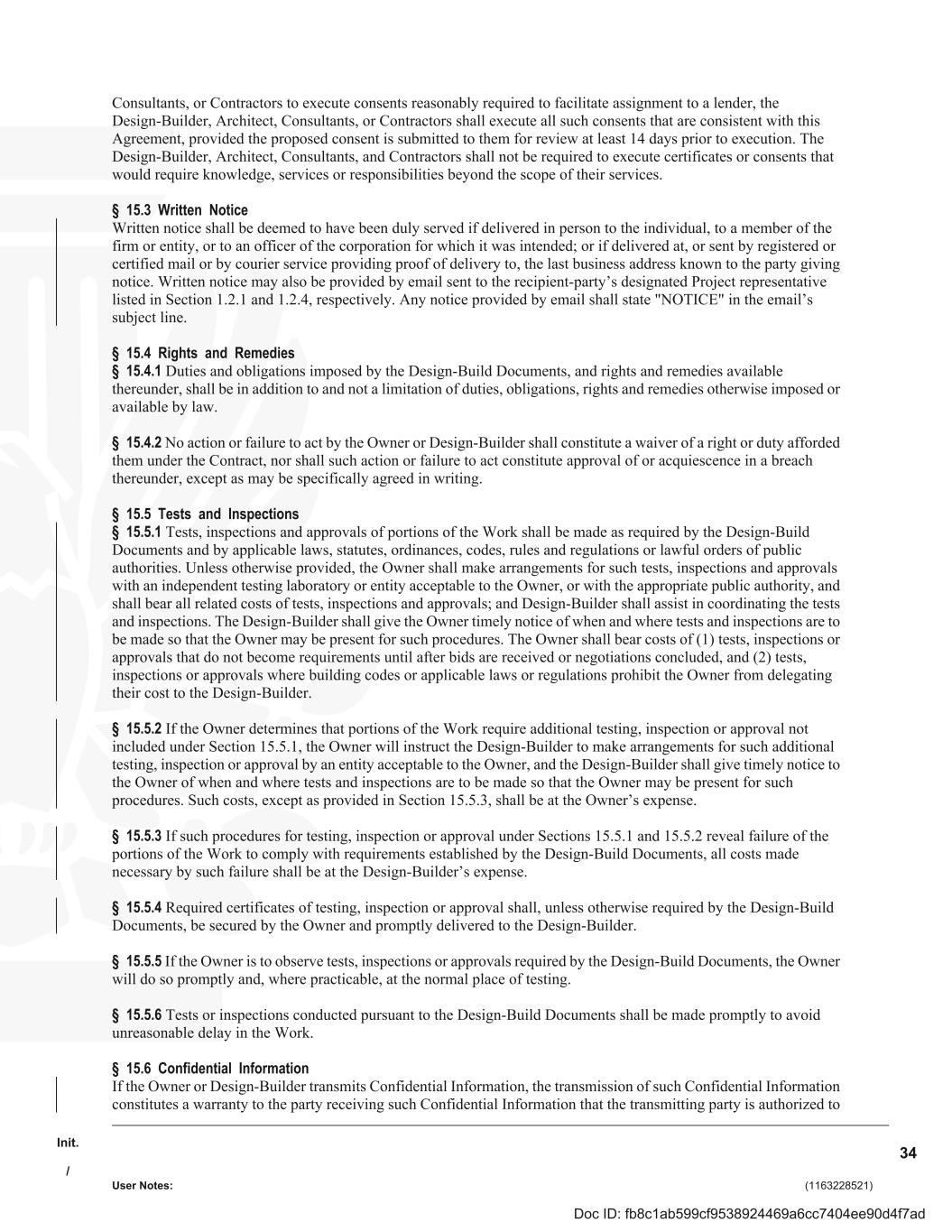
Init. / User Notes: (1163228521) 34 Consultants, or Contractors to execute consents reasonably required to facilitate assignment to a lender, the Design-Builder, Architect, Consultants, or Contractors shall execute all such consents that are consistent with this Agreement, provided the proposed consent is submitted to them for review at least 14 days prior to execution. The Design-Builder, Architect, Consultants, and Contractors shall not be required to execute certificates or consents that would require knowledge, services or responsibilities beyond the scope of their services. § 15.3 Written Notice Written notice shall be deemed to have been duly served if delivered in person to the individual, to a member of the firm or entity, or to an officer of the corporation for which it was intended; or if delivered at, or sent by registered or certified mail or by courier service providing proof of delivery to, the last business address known to the party giving notice. Written notice may also be provided by email sent to the recipient-party’s designated Project representative listed in Section 1.2.1 and 1.2.4, respectively. Any notice provided by email shall state "NOTICE" in the email’s subject line. § 15.4 Rights and Remedies § 15.4.1 Duties and obligations imposed by the Design-Build Documents, and rights and remedies available thereunder, shall be in addition to and not a limitation of duties, obligations, rights and remedies otherwise imposed or available by law. § 15.4.2 No action or failure to act by the Owner or Design-Builder shall constitute a waiver of a right or duty afforded them under the Contract, nor shall such action or failure to act constitute approval of or acquiescence in a breach thereunder, except as may be specifically agreed in writing. § 15.5 Tests and Inspections § 15.5.1 Tests, inspections and approvals of portions of the Work shall be made as required by the Design-Build Documents and by applicable laws, statutes, ordinances, codes, rules and regulations or lawful orders of public authorities. Unless otherwise provided, the Owner shall make arrangements for such tests, inspections and approvals with an independent testing laboratory or entity acceptable to the Owner, or with the appropriate public authority, and shall bear all related costs of tests, inspections and approvals; and Design-Builder shall assist in coordinating the tests and inspections. The Design-Builder shall give the Owner timely notice of when and where tests and inspections are to be made so that the Owner may be present for such procedures. The Owner shall bear costs of (1) tests, inspections or approvals that do not become requirements until after bids are received or negotiations concluded, and (2) tests, inspections or approvals where building codes or applicable laws or regulations prohibit the Owner from delegating their cost to the Design-Builder. § 15.5.2 If the Owner determines that portions of the Work require additional testing, inspection or approval not included under Section 15.5.1, the Owner will instruct the Design-Builder to make arrangements for such additional testing, inspection or approval by an entity acceptable to the Owner, and the Design-Builder shall give timely notice to the Owner of when and where tests and inspections are to be made so that the Owner may be present for such procedures. Such costs, except as provided in Section 15.5.3, shall be at the Owner’s expense. § 15.5.3 If such procedures for testing, inspection or approval under Sections 15.5.1 and 15.5.2 reveal failure of the portions of the Work to comply with requirements established by the Design-Build Documents, all costs made necessary by such failure shall be at the Design-Builder’s expense. § 15.5.4 Required certificates of testing, inspection or approval shall, unless otherwise required by the Design-Build Documents, be secured by the Owner and promptly delivered to the Design-Builder. § 15.5.5 If the Owner is to observe tests, inspections or approvals required by the Design-Build Documents, the Owner will do so promptly and, where practicable, at the normal place of testing. § 15.5.6 Tests or inspections conducted pursuant to the Design-Build Documents shall be made promptly to avoid unreasonable delay in the Work. § 15.6 Confidential Information If the Owner or Design-Builder transmits Confidential Information, the transmission of such Confidential Information constitutes a warranty to the party receiving such Confidential Information that the transmitting party is authorized to Doc ID: fb8c1ab599cf9538924469a6cc7404ee90d4f7ad
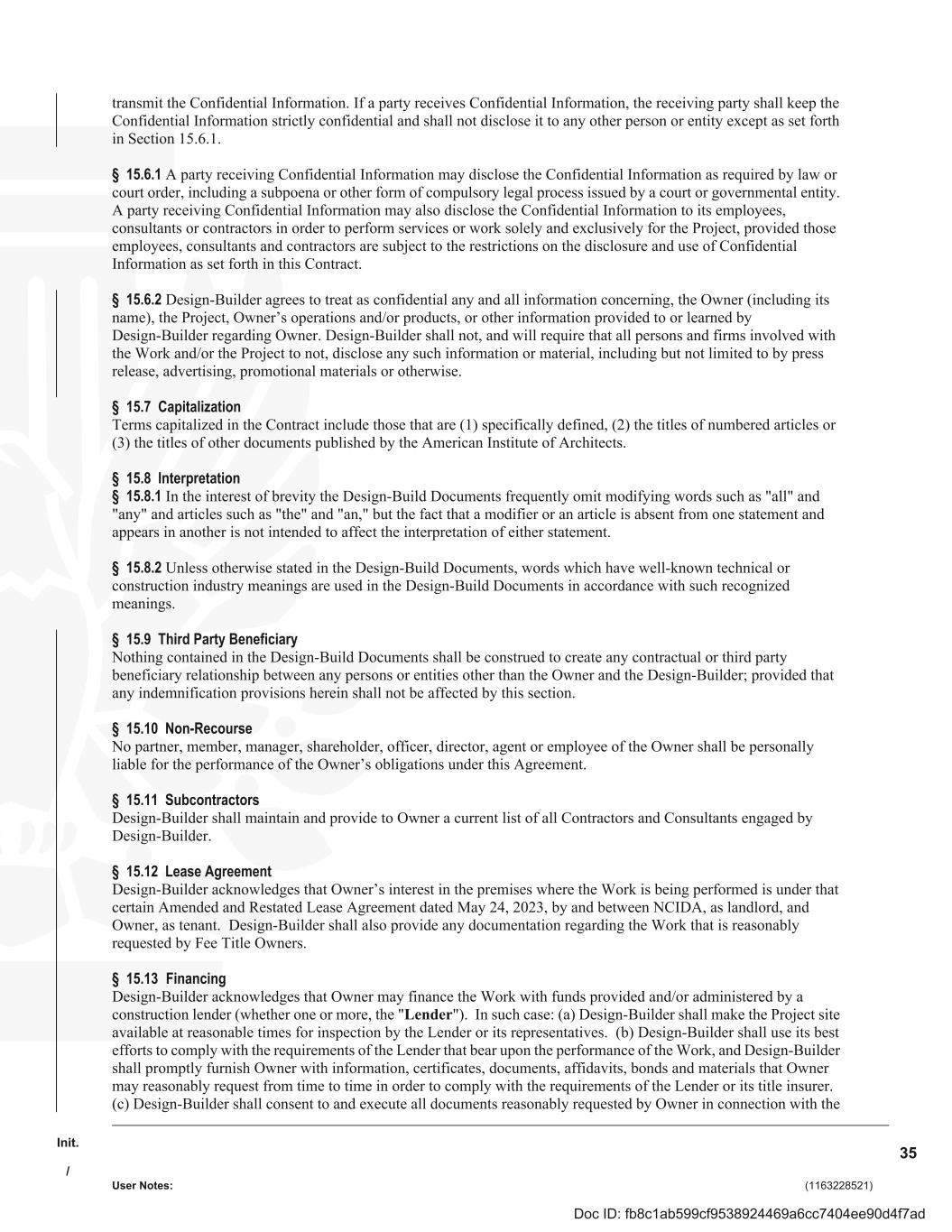
Init. / User Notes: (1163228521) 35 transmit the Confidential Information. If a party receives Confidential Information, the receiving party shall keep the Confidential Information strictly confidential and shall not disclose it to any other person or entity except as set forth in Section 15.6.1. § 15.6.1 A party receiving Confidential Information may disclose the Confidential Information as required by law or court order, including a subpoena or other form of compulsory legal process issued by a court or governmental entity. A party receiving Confidential Information may also disclose the Confidential Information to its employees, consultants or contractors in order to perform services or work solely and exclusively for the Project, provided those employees, consultants and contractors are subject to the restrictions on the disclosure and use of Confidential Information as set forth in this Contract. § 15.6.2 Design-Builder agrees to treat as confidential any and all information concerning, the Owner (including its name), the Project, Owner’s operations and/or products, or other information provided to or learned by Design-Builder regarding Owner. Design-Builder shall not, and will require that all persons and firms involved with the Work and/or the Project to not, disclose any such information or material, including but not limited to by press release, advertising, promotional materials or otherwise. § 15.7 Capitalization Terms capitalized in the Contract include those that are (1) specifically defined, (2) the titles of numbered articles or (3) the titles of other documents published by the American Institute of Architects. § 15.8 Interpretation § 15.8.1 In the interest of brevity the Design-Build Documents frequently omit modifying words such as "all" and "any" and articles such as "the" and "an," but the fact that a modifier or an article is absent from one statement and appears in another is not intended to affect the interpretation of either statement. § 15.8.2 Unless otherwise stated in the Design-Build Documents, words which have well-known technical or construction industry meanings are used in the Design-Build Documents in accordance with such recognized meanings. § 15.9 Third Party Beneficiary Nothing contained in the Design-Build Documents shall be construed to create any contractual or third party beneficiary relationship between any persons or entities other than the Owner and the Design-Builder; provided that any indemnification provisions herein shall not be affected by this section. § 15.10 Non-Recourse No partner, member, manager, shareholder, officer, director, agent or employee of the Owner shall be personally liable for the performance of the Owner’s obligations under this Agreement. § 15.11 Subcontractors Design-Builder shall maintain and provide to Owner a current list of all Contractors and Consultants engaged by Design-Builder. § 15.12 Lease Agreement Design-Builder acknowledges that Owner’s interest in the premises where the Work is being performed is under that certain Amended and Restated Lease Agreement dated May 24, 2023, by and between NCIDA, as landlord, and Owner, as tenant. Design-Builder shall also provide any documentation regarding the Work that is reasonably requested by Fee Title Owners. § 15.13 Financing Design-Builder acknowledges that Owner may finance the Work with funds provided and/or administered by a construction lender (whether one or more, the "Lender"). In such case: (a) Design-Builder shall make the Project site available at reasonable times for inspection by the Lender or its representatives. (b) Design-Builder shall use its best efforts to comply with the requirements of the Lender that bear upon the performance of the Work, and Design-Builder shall promptly furnish Owner with information, certificates, documents, affidavits, bonds and materials that Owner may reasonably request from time to time in order to comply with the requirements of the Lender or its title insurer. (c) Design-Builder shall consent to and execute all documents reasonably requested by Owner in connection with the Doc ID: fb8c1ab599cf9538924469a6cc7404ee90d4f7ad
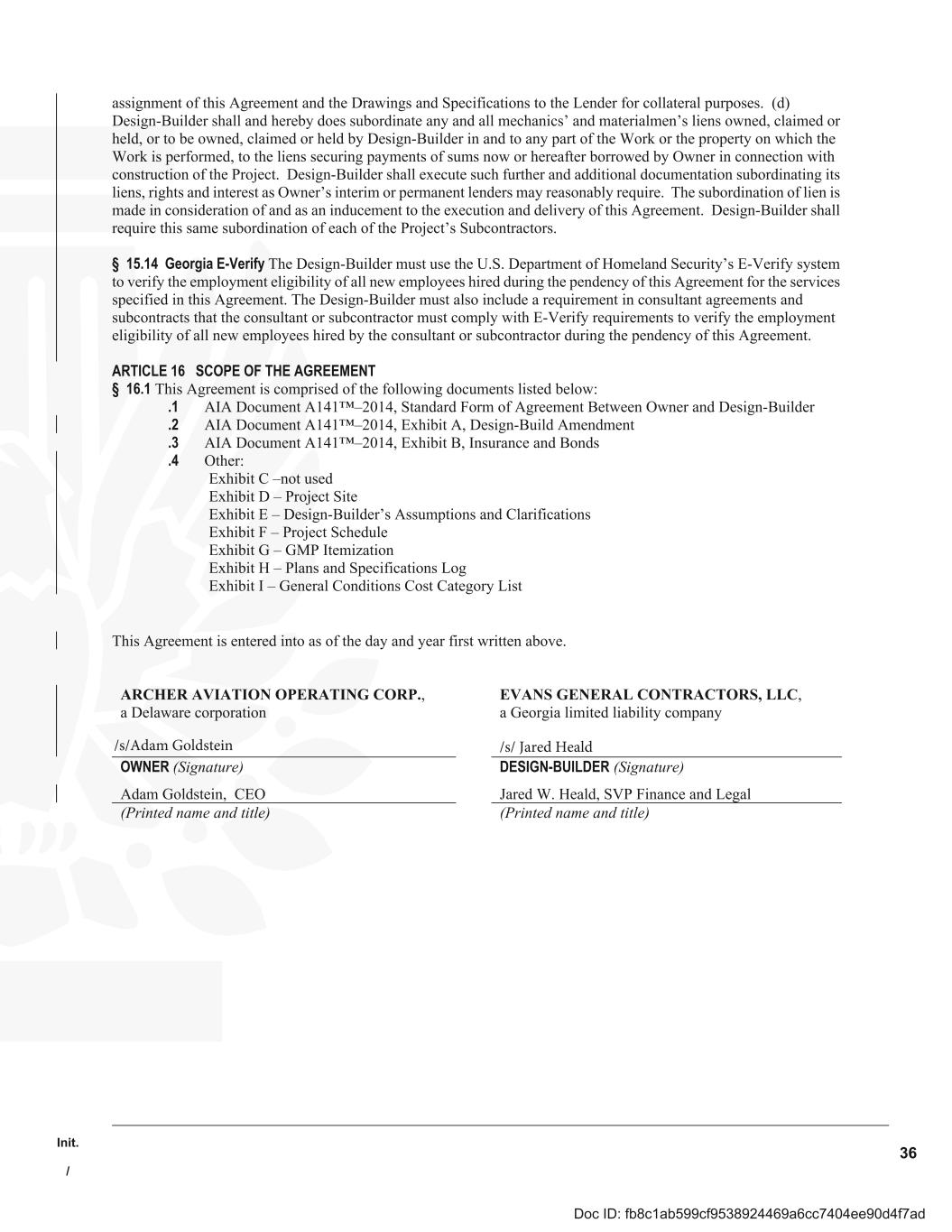
Init. / 36 assignment of this Agreement and the Drawings and Specifications to the Lender for collateral purposes. (d) Design-Builder shall and hereby does subordinate any and all mechanics’ and materialmen’s liens owned, claimed or held, or to be owned, claimed or held by Design-Builder in and to any part of the Work or the property on which the Work is performed, to the liens securing payments of sums now or hereafter borrowed by Owner in connection with construction of the Project. Design-Builder shall execute such further and additional documentation subordinating its liens, rights and interest as Owner’s interim or permanent lenders may reasonably require. The subordination of lien is made in consideration of and as an inducement to the execution and delivery of this Agreement. Design-Builder shall require this same subordination of each of the Project’s Subcontractors. § 15.14 Georgia E-Verify The Design-Builder must use the U.S. Department of Homeland Security’s E-Verify system to verify the employment eligibility of all new employees hired during the pendency of this Agreement for the services specified in this Agreement. The Design-Builder must also include a requirement in consultant agreements and subcontracts that the consultant or subcontractor must comply with E-Verify requirements to verify the employment eligibility of all new employees hired by the consultant or subcontractor during the pendency of this Agreement. ARTICLE 16 SCOPE OF THE AGREEMENT § 16.1 This Agreement is comprised of the following documents listed below: .1 AIA Document A141™–2014, Standard Form of Agreement Between Owner and Design-Builder .2 AIA Document A141™–2014, Exhibit A, Design-Build Amendment .3 AIA Document A141™–2014, Exhibit B, Insurance and Bonds .4 Other: Exhibit C –not used Exhibit D – Project Site Exhibit E – Design-Builder’s Assumptions and Clarifications Exhibit F – Project Schedule Exhibit G – GMP Itemization Exhibit H – Plans and Specifications Log Exhibit I – General Conditions Cost Category List This Agreement is entered into as of the day and year first written above. ARCHER AVIATION OPERATING CORP., a Delaware corporation EVANS GENERAL CONTRACTORS, LLC, a Georgia limited liability company OWNER (Signature) DESIGN-BUILDER (Signature) Adam Goldstein, CEO Jared W. Heald, SVP Finance and Legal (Printed name and title) (Printed name and title) Doc ID: fb8c1ab599cf9538924469a6cc7404ee90d4f7ad
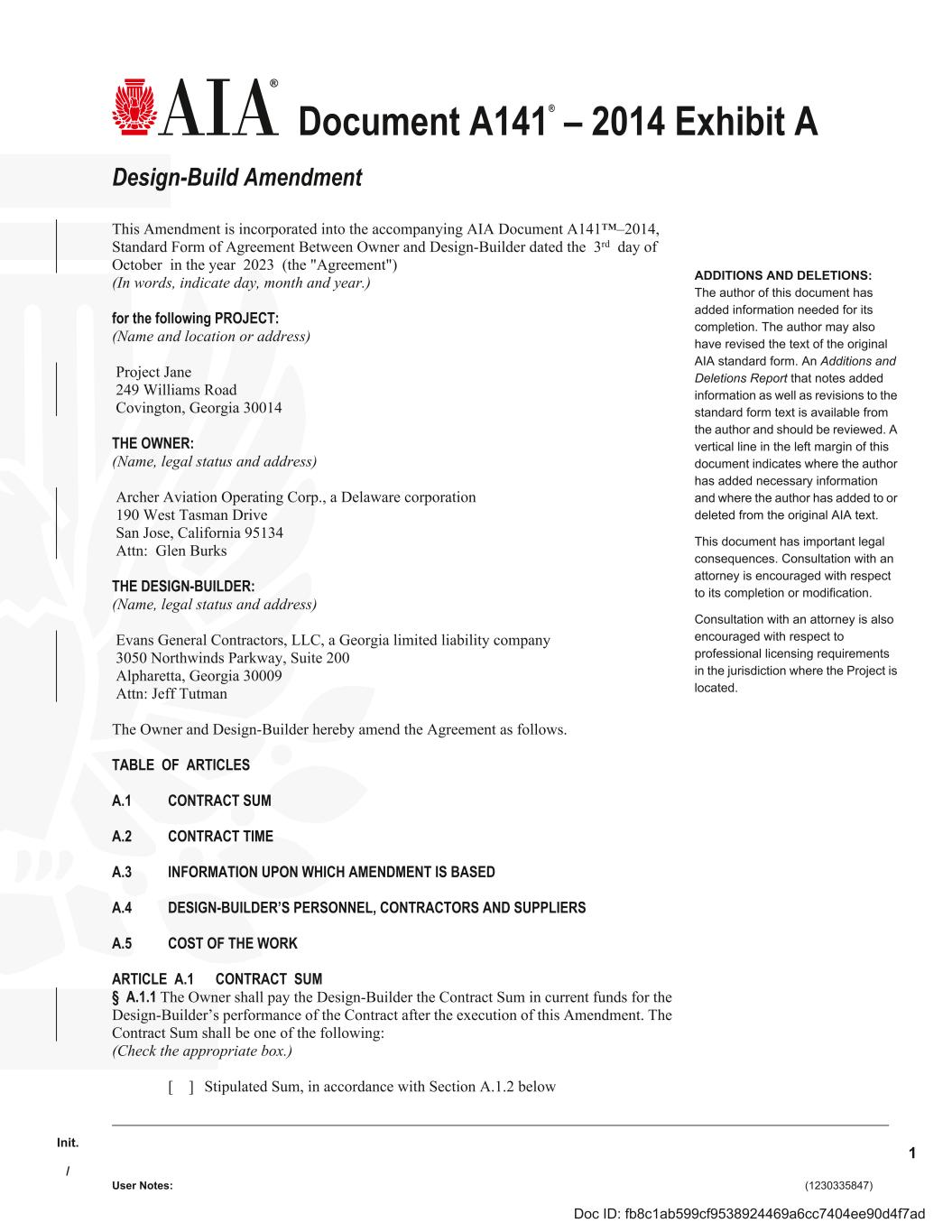
Document A141® – 2014 Exhibit A Design-Build Amendment Init. / User Notes: (1230335847) 1 ADDITIONS AND DELETIONS: The author of this document has added information needed for its completion. The author may also have revised the text of the original AIA standard form. An Additions and Deletions Report that notes added information as well as revisions to the standard form text is available from the author and should be reviewed. A vertical line in the left margin of this document indicates where the author has added necessary information and where the author has added to or deleted from the original AIA text. This document has important legal consequences. Consultation with an attorney is encouraged with respect to its completion or modification. Consultation with an attorney is also encouraged with respect to professional licensing requirements in the jurisdiction where the Project is located. This Amendment is incorporated into the accompanying AIA Document A141™–2014, Standard Form of Agreement Between Owner and Design-Builder dated the 3rd day of October in the year 2023 (the "Agreement") (In words, indicate day, month and year.) for the following PROJECT: (Name and location or address) Project Jane 249 Williams Road Covington, Georgia 30014 THE OWNER: (Name, legal status and address) Archer Aviation Operating Corp., a Delaware corporation 190 West Tasman Drive San Jose, California 95134 Attn: Glen Burks THE DESIGN-BUILDER: (Name, legal status and address) Evans General Contractors, LLC, a Georgia limited liability company 3050 Northwinds Parkway, Suite 200 Alpharetta, Georgia 30009 Attn: Jeff Tutman The Owner and Design-Builder hereby amend the Agreement as follows. TABLE OF ARTICLES A.1 CONTRACT SUM A.2 CONTRACT TIME A.3 INFORMATION UPON WHICH AMENDMENT IS BASED A.4 DESIGN-BUILDER’S PERSONNEL, CONTRACTORS AND SUPPLIERS A.5 COST OF THE WORK ARTICLE A.1 CONTRACT SUM § A.1.1 The Owner shall pay the Design-Builder the Contract Sum in current funds for the Design-Builder’s performance of the Contract after the execution of this Amendment. The Contract Sum shall be one of the following: (Check the appropriate box.) [ ] Stipulated Sum, in accordance with Section A.1.2 below Doc ID: fb8c1ab599cf9538924469a6cc7404ee90d4f7ad
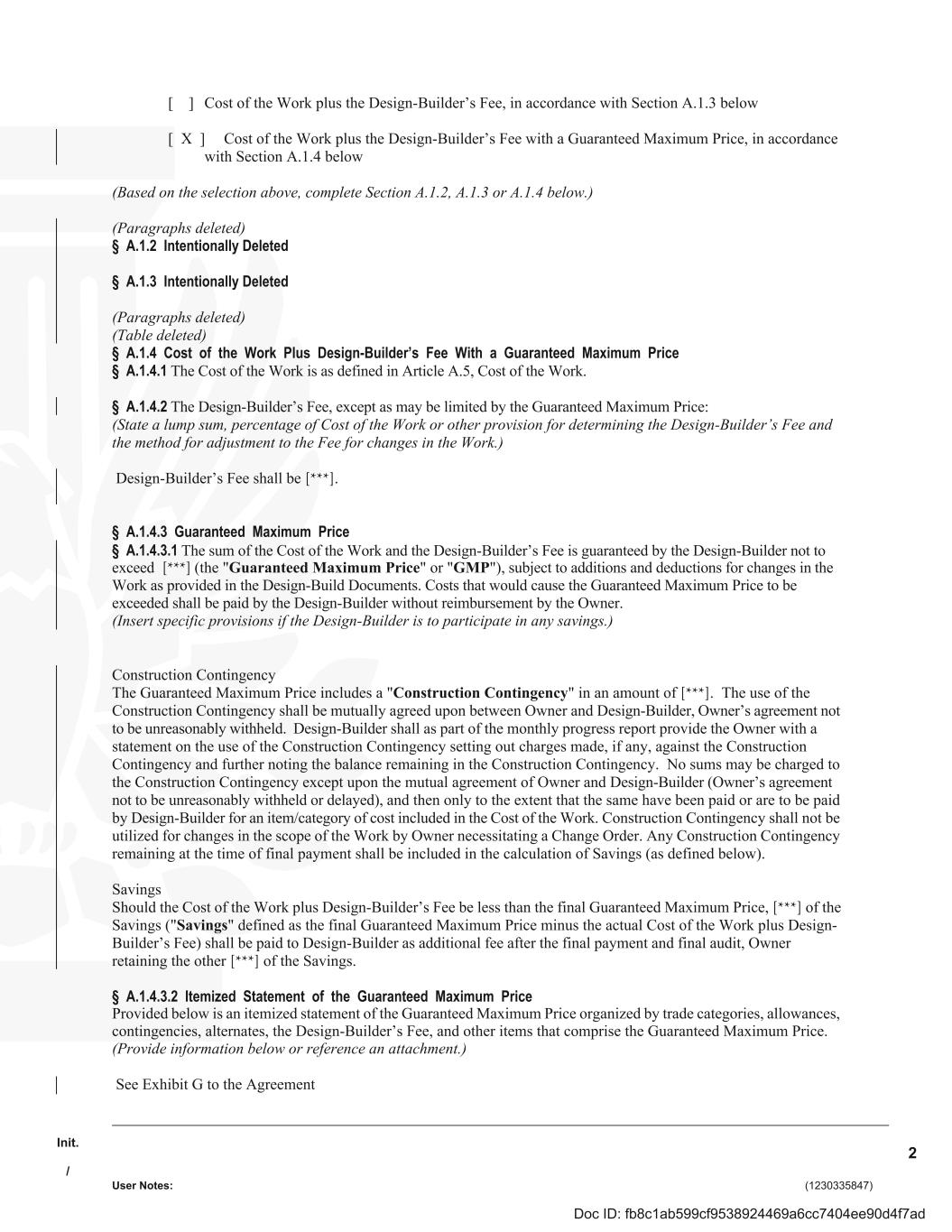
Init. / User Notes: (1230335847) 2 [ ] Cost of the Work plus the Design-Builder’s Fee, in accordance with Section A.1.3 below [ X ] Cost of the Work plus the Design-Builder’s Fee with a Guaranteed Maximum Price, in accordance with Section A.1.4 below (Based on the selection above, complete Section A.1.2, A.1.3 or A.1.4 below.) (Paragraphs deleted) § A.1.2 Intentionally Deleted § A.1.3 Intentionally Deleted (Paragraphs deleted) (Table deleted) § A.1.4 Cost of the Work Plus Design-Builder’s Fee With a Guaranteed Maximum Price § A.1.4.1 The Cost of the Work is as defined in Article A.5, Cost of the Work. § A.1.4.2 The Design-Builder’s Fee, except as may be limited by the Guaranteed Maximum Price: (State a lump sum, percentage of Cost of the Work or other provision for determining the Design-Builder’s Fee and the method for adjustment to the Fee for changes in the Work.) Design-Builder’s Fee shall be [***]. § A.1.4.3 Guaranteed Maximum Price § A.1.4.3.1 The sum of the Cost of the Work and the Design-Builder’s Fee is guaranteed by the Design-Builder not to exceed [***] (the "Guaranteed Maximum Price" or "GMP"), subject to additions and deductions for changes in the Work as provided in the Design-Build Documents. Costs that would cause the Guaranteed Maximum Price to be exceeded shall be paid by the Design-Builder without reimbursement by the Owner. (Insert specific provisions if the Design-Builder is to participate in any savings.) Construction Contingency The Guaranteed Maximum Price includes a "Construction Contingency" in an amount of [***]. The use of the Construction Contingency shall be mutually agreed upon between Owner and Design-Builder, Owner’s agreement not to be unreasonably withheld. Design-Builder shall as part of the monthly progress report provide the Owner with a statement on the use of the Construction Contingency setting out charges made, if any, against the Construction Contingency and further noting the balance remaining in the Construction Contingency. No sums may be charged to the Construction Contingency except upon the mutual agreement of Owner and Design-Builder (Owner’s agreement not to be unreasonably withheld or delayed), and then only to the extent that the same have been paid or are to be paid by Design-Builder for an item/category of cost included in the Cost of the Work. Construction Contingency shall not be utilized for changes in the scope of the Work by Owner necessitating a Change Order. Any Construction Contingency remaining at the time of final payment shall be included in the calculation of Savings (as defined below). Savings Should the Cost of the Work plus Design-Builder’s Fee be less than the final Guaranteed Maximum Price, [***] of the Savings ("Savings" defined as the final Guaranteed Maximum Price minus the actual Cost of the Work plus Design- Builder’s Fee) shall be paid to Design-Builder as additional fee after the final payment and final audit, Owner retaining the other [***] of the Savings. § A.1.4.3.2 Itemized Statement of the Guaranteed Maximum Price Provided below is an itemized statement of the Guaranteed Maximum Price organized by trade categories, allowances, contingencies, alternates, the Design-Builder’s Fee, and other items that comprise the Guaranteed Maximum Price. (Provide information below or reference an attachment.) See Exhibit G to the Agreement Doc ID: fb8c1ab599cf9538924469a6cc7404ee90d4f7ad
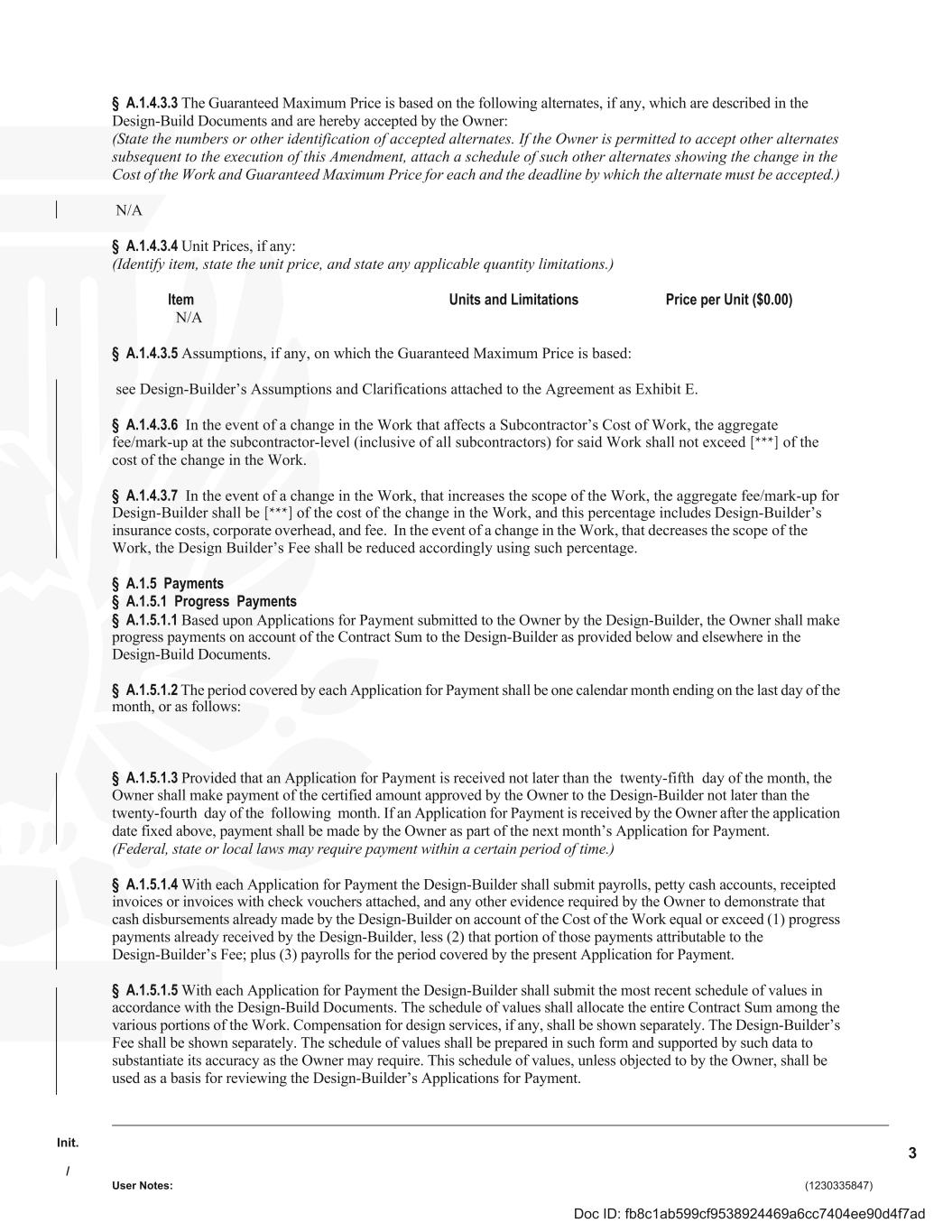
Init. / User Notes: (1230335847) 3 § A.1.4.3.3 The Guaranteed Maximum Price is based on the following alternates, if any, which are described in the Design-Build Documents and are hereby accepted by the Owner: (State the numbers or other identification of accepted alternates. If the Owner is permitted to accept other alternates subsequent to the execution of this Amendment, attach a schedule of such other alternates showing the change in the Cost of the Work and Guaranteed Maximum Price for each and the deadline by which the alternate must be accepted.) N/A § A.1.4.3.4 Unit Prices, if any: (Identify item, state the unit price, and state any applicable quantity limitations.) Item Units and Limitations Price per Unit ($0.00) N/A § A.1.4.3.5 Assumptions, if any, on which the Guaranteed Maximum Price is based: see Design-Builder’s Assumptions and Clarifications attached to the Agreement as Exhibit E. § A.1.4.3.6 In the event of a change in the Work that affects a Subcontractor’s Cost of Work, the aggregate fee/mark-up at the subcontractor-level (inclusive of all subcontractors) for said Work shall not exceed [***] of the cost of the change in the Work. § A.1.4.3.7 In the event of a change in the Work, that increases the scope of the Work, the aggregate fee/mark-up for Design-Builder shall be [***] of the cost of the change in the Work, and this percentage includes Design-Builder’s insurance costs, corporate overhead, and fee. In the event of a change in the Work, that decreases the scope of the Work, the Design Builder’s Fee shall be reduced accordingly using such percentage. § A.1.5 Payments § A.1.5.1 Progress Payments § A.1.5.1.1 Based upon Applications for Payment submitted to the Owner by the Design-Builder, the Owner shall make progress payments on account of the Contract Sum to the Design-Builder as provided below and elsewhere in the Design-Build Documents. § A.1.5.1.2 The period covered by each Application for Payment shall be one calendar month ending on the last day of the month, or as follows: § A.1.5.1.3 Provided that an Application for Payment is received not later than the twenty-fifth day of the month, the Owner shall make payment of the certified amount approved by the Owner to the Design-Builder not later than the twenty-fourth day of the following month. If an Application for Payment is received by the Owner after the application date fixed above, payment shall be made by the Owner as part of the next month’s Application for Payment. (Federal, state or local laws may require payment within a certain period of time.) § A.1.5.1.4 With each Application for Payment the Design-Builder shall submit payrolls, petty cash accounts, receipted invoices or invoices with check vouchers attached, and any other evidence required by the Owner to demonstrate that cash disbursements already made by the Design-Builder on account of the Cost of the Work equal or exceed (1) progress payments already received by the Design-Builder, less (2) that portion of those payments attributable to the Design-Builder’s Fee; plus (3) payrolls for the period covered by the present Application for Payment. § A.1.5.1.5 With each Application for Payment the Design-Builder shall submit the most recent schedule of values in accordance with the Design-Build Documents. The schedule of values shall allocate the entire Contract Sum among the various portions of the Work. Compensation for design services, if any, shall be shown separately. The Design-Builder’s Fee shall be shown separately. The schedule of values shall be prepared in such form and supported by such data to substantiate its accuracy as the Owner may require. This schedule of values, unless objected to by the Owner, shall be used as a basis for reviewing the Design-Builder’s Applications for Payment. Doc ID: fb8c1ab599cf9538924469a6cc7404ee90d4f7ad
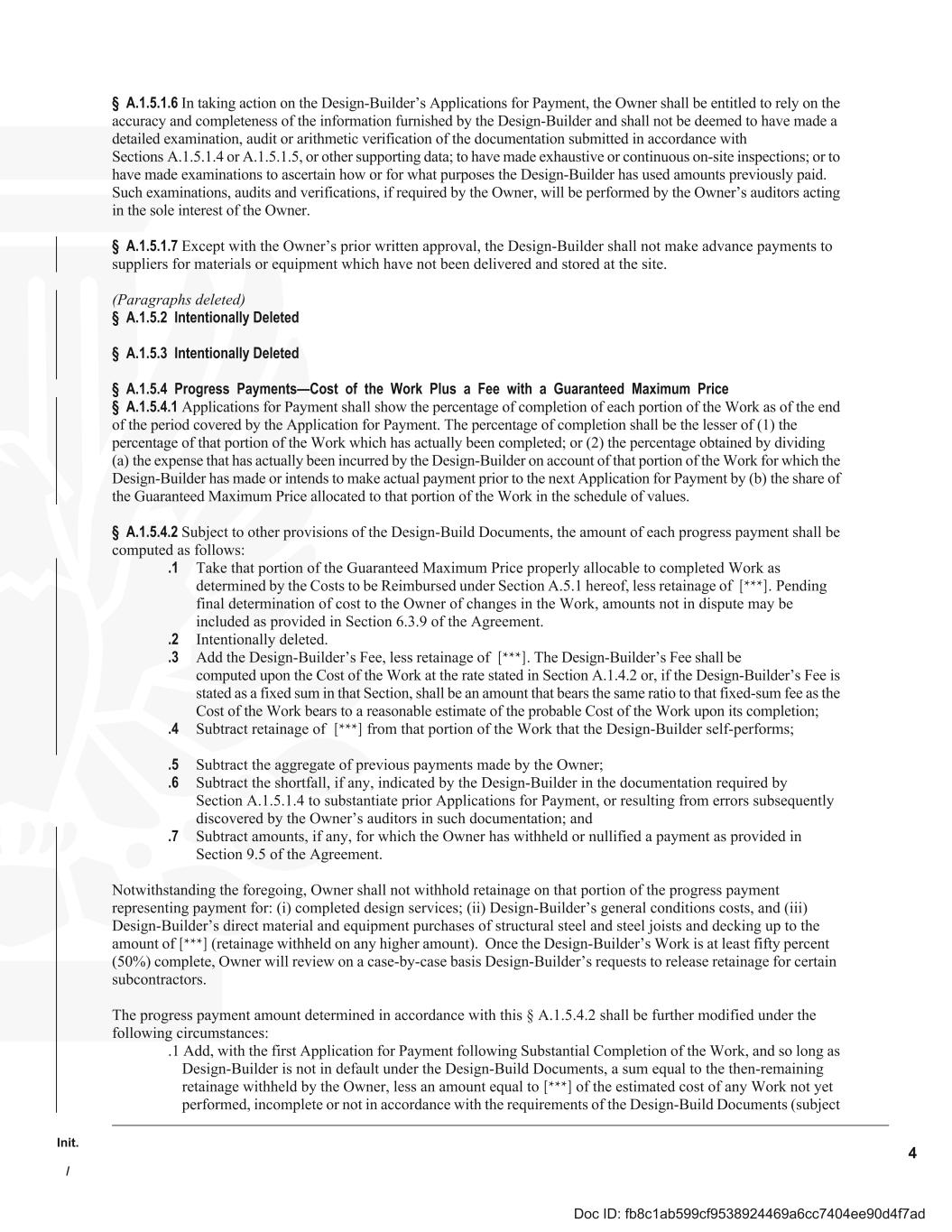
Init. / 4 § A.1.5.1.6 In taking action on the Design-Builder’s Applications for Payment, the Owner shall be entitled to rely on the accuracy and completeness of the information furnished by the Design-Builder and shall not be deemed to have made a detailed examination, audit or arithmetic verification of the documentation submitted in accordance with Sections A.1.5.1.4 or A.1.5.1.5, or other supporting data; to have made exhaustive or continuous on-site inspections; or to have made examinations to ascertain how or for what purposes the Design-Builder has used amounts previously paid. Such examinations, audits and verifications, if required by the Owner, will be performed by the Owner’s auditors acting in the sole interest of the Owner. § A.1.5.1.7 Except with the Owner’s prior written approval, the Design-Builder shall not make advance payments to suppliers for materials or equipment which have not been delivered and stored at the site. (Paragraphs deleted) § A.1.5.2 Intentionally Deleted § A.1.5.3 Intentionally Deleted § A.1.5.4 Progress Payments—Cost of the Work Plus a Fee with a Guaranteed Maximum Price § A.1.5.4.1 Applications for Payment shall show the percentage of completion of each portion of the Work as of the end of the period covered by the Application for Payment. The percentage of completion shall be the lesser of (1) the percentage of that portion of the Work which has actually been completed; or (2) the percentage obtained by dividing (a) the expense that has actually been incurred by the Design-Builder on account of that portion of the Work for which the Design-Builder has made or intends to make actual payment prior to the next Application for Payment by (b) the share of the Guaranteed Maximum Price allocated to that portion of the Work in the schedule of values. § A.1.5.4.2 Subject to other provisions of the Design-Build Documents, the amount of each progress payment shall be computed as follows: .1 Take that portion of the Guaranteed Maximum Price properly allocable to completed Work as determined by the Costs to be Reimbursed under Section A.5.1 hereof, less retainage of [***]. Pending final determination of cost to the Owner of changes in the Work, amounts not in dispute may be included as provided in Section 6.3.9 of the Agreement. .2 Intentionally deleted. .3 Add the Design-Builder’s Fee, less retainage of [***]. The Design-Builder’s Fee shall be computed upon the Cost of the Work at the rate stated in Section A.1.4.2 or, if the Design-Builder’s Fee is stated as a fixed sum in that Section, shall be an amount that bears the same ratio to that fixed-sum fee as the Cost of the Work bears to a reasonable estimate of the probable Cost of the Work upon its completion; .4 Subtract retainage of [***] from that portion of the Work that the Design-Builder self-performs; .5 Subtract the aggregate of previous payments made by the Owner; .6 Subtract the shortfall, if any, indicated by the Design-Builder in the documentation required by Section A.1.5.1.4 to substantiate prior Applications for Payment, or resulting from errors subsequently discovered by the Owner’s auditors in such documentation; and .7 Subtract amounts, if any, for which the Owner has withheld or nullified a payment as provided in Section 9.5 of the Agreement. Notwithstanding the foregoing, Owner shall not withhold retainage on that portion of the progress payment representing payment for: (i) completed design services; (ii) Design-Builder’s general conditions costs, and (iii) Design-Builder’s direct material and equipment purchases of structural steel and steel joists and decking up to the amount of [***] (retainage withheld on any higher amount). Once the Design-Builder’s Work is at least fifty percent (50%) complete, Owner will review on a case-by-case basis Design-Builder’s requests to release retainage for certain subcontractors. The progress payment amount determined in accordance with this § A.1.5.4.2 shall be further modified under the following circumstances: .1 Add, with the first Application for Payment following Substantial Completion of the Work, and so long as Design-Builder is not in default under the Design-Build Documents, a sum equal to the then-remaining retainage withheld by the Owner, less an amount equal to [***] of the estimated cost of any Work not yet performed, incomplete or not in accordance with the requirements of the Design-Build Documents (subject Doc ID: fb8c1ab599cf9538924469a6cc7404ee90d4f7ad
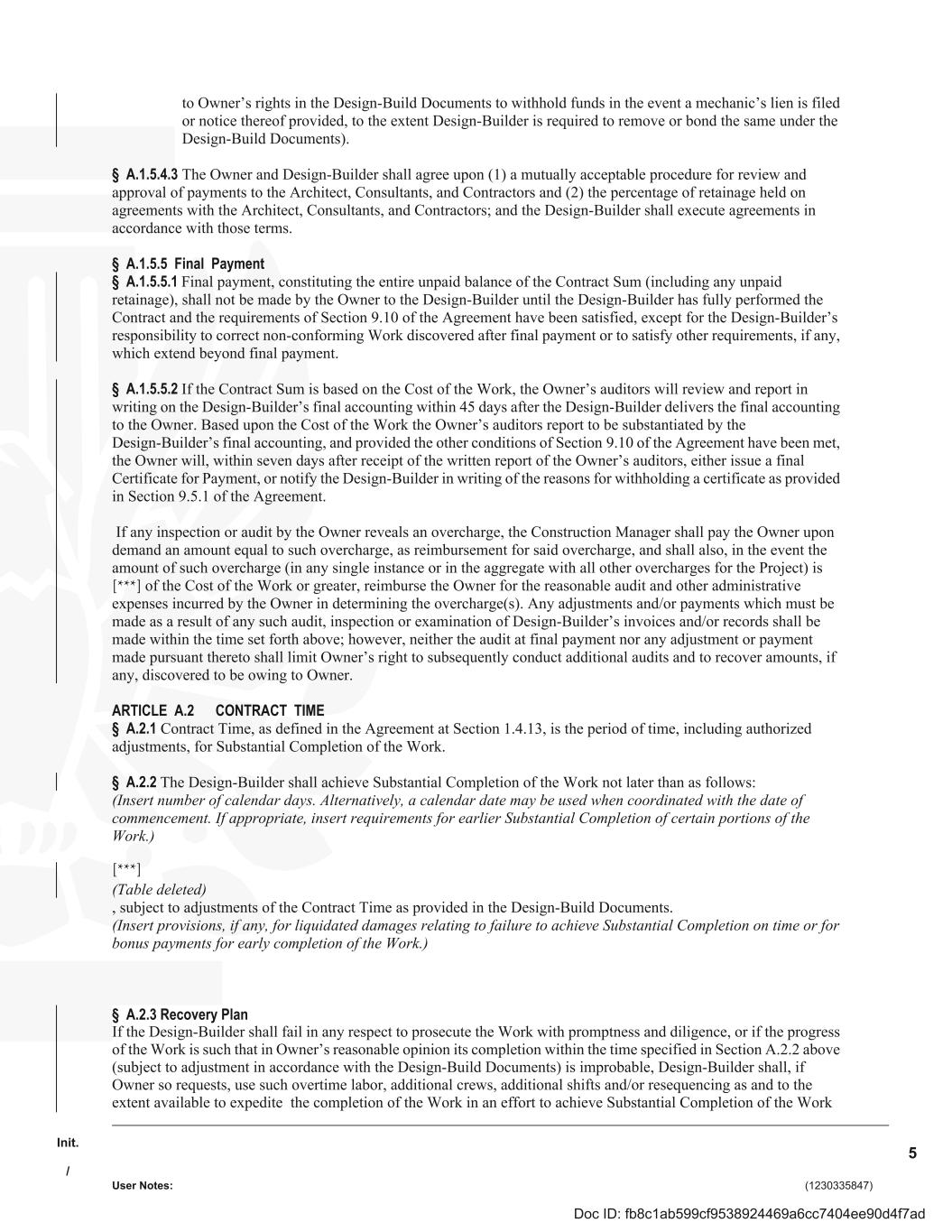
Init. / User Notes: (1230335847) 5 to Owner’s rights in the Design-Build Documents to withhold funds in the event a mechanic’s lien is filed or notice thereof provided, to the extent Design-Builder is required to remove or bond the same under the Design-Build Documents). § A.1.5.4.3 The Owner and Design-Builder shall agree upon (1) a mutually acceptable procedure for review and approval of payments to the Architect, Consultants, and Contractors and (2) the percentage of retainage held on agreements with the Architect, Consultants, and Contractors; and the Design-Builder shall execute agreements in accordance with those terms. § A.1.5.5 Final Payment § A.1.5.5.1 Final payment, constituting the entire unpaid balance of the Contract Sum (including any unpaid retainage), shall not be made by the Owner to the Design-Builder until the Design-Builder has fully performed the Contract and the requirements of Section 9.10 of the Agreement have been satisfied, except for the Design-Builder’s responsibility to correct non-conforming Work discovered after final payment or to satisfy other requirements, if any, which extend beyond final payment. § A.1.5.5.2 If the Contract Sum is based on the Cost of the Work, the Owner’s auditors will review and report in writing on the Design-Builder’s final accounting within 45 days after the Design-Builder delivers the final accounting to the Owner. Based upon the Cost of the Work the Owner’s auditors report to be substantiated by the Design-Builder’s final accounting, and provided the other conditions of Section 9.10 of the Agreement have been met, the Owner will, within seven days after receipt of the written report of the Owner’s auditors, either issue a final Certificate for Payment, or notify the Design-Builder in writing of the reasons for withholding a certificate as provided in Section 9.5.1 of the Agreement. If any inspection or audit by the Owner reveals an overcharge, the Construction Manager shall pay the Owner upon demand an amount equal to such overcharge, as reimbursement for said overcharge, and shall also, in the event the amount of such overcharge (in any single instance or in the aggregate with all other overcharges for the Project) is [***] of the Cost of the Work or greater, reimburse the Owner for the reasonable audit and other administrative expenses incurred by the Owner in determining the overcharge(s). Any adjustments and/or payments which must be made as a result of any such audit, inspection or examination of Design-Builder’s invoices and/or records shall be made within the time set forth above; however, neither the audit at final payment nor any adjustment or payment made pursuant thereto shall limit Owner’s right to subsequently conduct additional audits and to recover amounts, if any, discovered to be owing to Owner. ARTICLE A.2 CONTRACT TIME § A.2.1 Contract Time, as defined in the Agreement at Section 1.4.13, is the period of time, including authorized adjustments, for Substantial Completion of the Work. § A.2.2 The Design-Builder shall achieve Substantial Completion of the Work not later than as follows: (Insert number of calendar days. Alternatively, a calendar date may be used when coordinated with the date of commencement. If appropriate, insert requirements for earlier Substantial Completion of certain portions of the Work.) [***] (Table deleted) , subject to adjustments of the Contract Time as provided in the Design-Build Documents. (Insert provisions, if any, for liquidated damages relating to failure to achieve Substantial Completion on time or for bonus payments for early completion of the Work.) § A.2.3 Recovery Plan If the Design-Builder shall fail in any respect to prosecute the Work with promptness and diligence, or if the progress of the Work is such that in Owner’s reasonable opinion its completion within the time specified in Section A.2.2 above (subject to adjustment in accordance with the Design-Build Documents) is improbable, Design-Builder shall, if Owner so requests, use such overtime labor, additional crews, additional shifts and/or resequencing as and to the extent available to expedite the completion of the Work in an effort to achieve Substantial Completion of the Work Doc ID: fb8c1ab599cf9538924469a6cc7404ee90d4f7ad
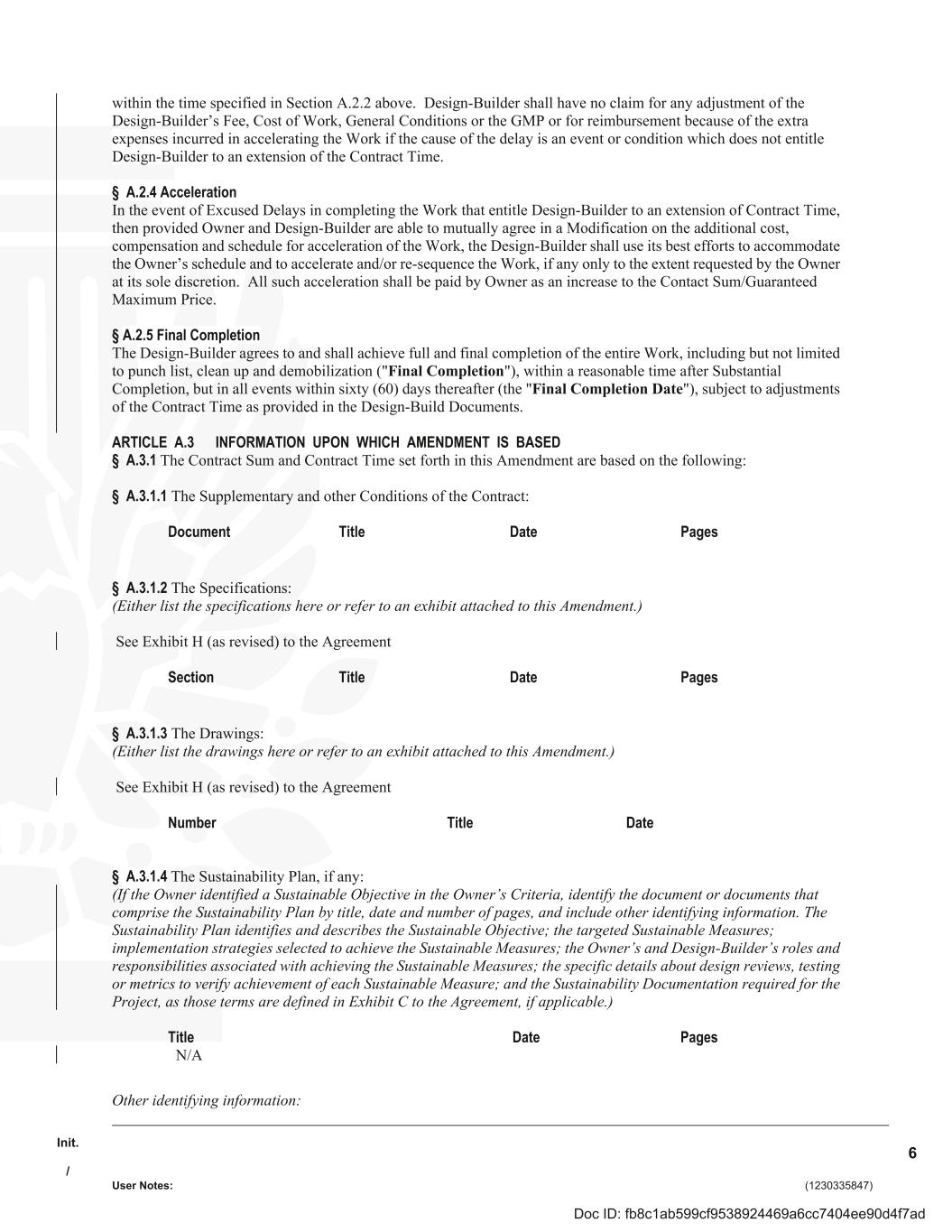
Init. / User Notes: (1230335847) 6 within the time specified in Section A.2.2 above. Design-Builder shall have no claim for any adjustment of the Design-Builder’s Fee, Cost of Work, General Conditions or the GMP or for reimbursement because of the extra expenses incurred in accelerating the Work if the cause of the delay is an event or condition which does not entitle Design-Builder to an extension of the Contract Time. § A.2.4 Acceleration In the event of Excused Delays in completing the Work that entitle Design-Builder to an extension of Contract Time, then provided Owner and Design-Builder are able to mutually agree in a Modification on the additional cost, compensation and schedule for acceleration of the Work, the Design-Builder shall use its best efforts to accommodate the Owner’s schedule and to accelerate and/or re-sequence the Work, if any only to the extent requested by the Owner at its sole discretion. All such acceleration shall be paid by Owner as an increase to the Contact Sum/Guaranteed Maximum Price. § A.2.5 Final Completion The Design-Builder agrees to and shall achieve full and final completion of the entire Work, including but not limited to punch list, clean up and demobilization ("Final Completion"), within a reasonable time after Substantial Completion, but in all events within sixty (60) days thereafter (the "Final Completion Date"), subject to adjustments of the Contract Time as provided in the Design-Build Documents. ARTICLE A.3 INFORMATION UPON WHICH AMENDMENT IS BASED § A.3.1 The Contract Sum and Contract Time set forth in this Amendment are based on the following: § A.3.1.1 The Supplementary and other Conditions of the Contract: Document Title Date Pages § A.3.1.2 The Specifications: (Either list the specifications here or refer to an exhibit attached to this Amendment.) See Exhibit H (as revised) to the Agreement Section Title Date Pages § A.3.1.3 The Drawings: (Either list the drawings here or refer to an exhibit attached to this Amendment.) See Exhibit H (as revised) to the Agreement Number Title Date § A.3.1.4 The Sustainability Plan, if any: (If the Owner identified a Sustainable Objective in the Owner’s Criteria, identify the document or documents that comprise the Sustainability Plan by title, date and number of pages, and include other identifying information. The Sustainability Plan identifies and describes the Sustainable Objective; the targeted Sustainable Measures; implementation strategies selected to achieve the Sustainable Measures; the Owner’s and Design-Builder’s roles and responsibilities associated with achieving the Sustainable Measures; the specific details about design reviews, testing or metrics to verify achievement of each Sustainable Measure; and the Sustainability Documentation required for the Project, as those terms are defined in Exhibit C to the Agreement, if applicable.) Title Date Pages N/A Other identifying information: Doc ID: fb8c1ab599cf9538924469a6cc7404ee90d4f7ad
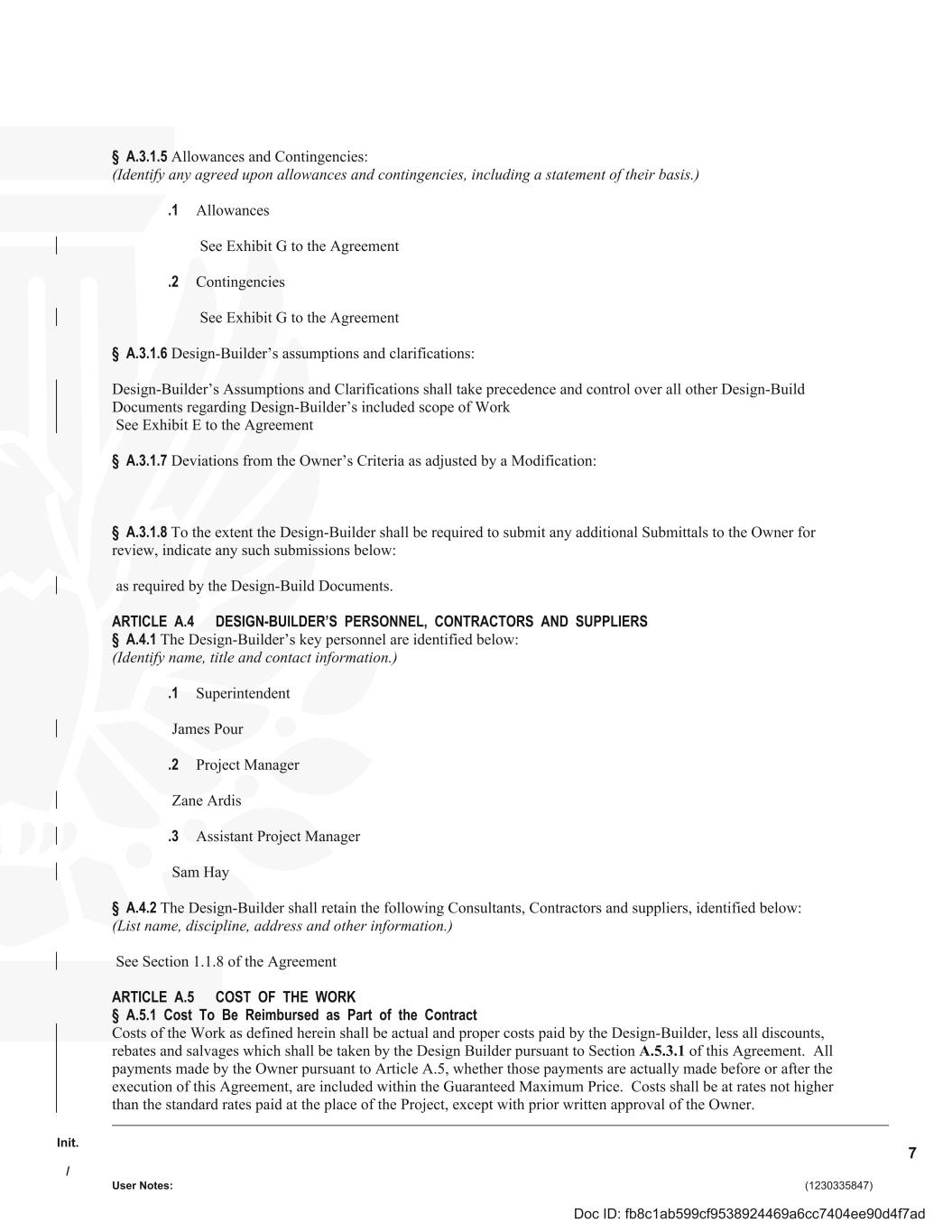
Init. / User Notes: (1230335847) 7 § A.3.1.5 Allowances and Contingencies: (Identify any agreed upon allowances and contingencies, including a statement of their basis.) .1 Allowances See Exhibit G to the Agreement .2 Contingencies See Exhibit G to the Agreement § A.3.1.6 Design-Builder’s assumptions and clarifications: Design-Builder’s Assumptions and Clarifications shall take precedence and control over all other Design-Build Documents regarding Design-Builder’s included scope of Work See Exhibit E to the Agreement § A.3.1.7 Deviations from the Owner’s Criteria as adjusted by a Modification: § A.3.1.8 To the extent the Design-Builder shall be required to submit any additional Submittals to the Owner for review, indicate any such submissions below: as required by the Design-Build Documents. ARTICLE A.4 DESIGN-BUILDER’S PERSONNEL, CONTRACTORS AND SUPPLIERS § A.4.1 The Design-Builder’s key personnel are identified below: (Identify name, title and contact information.) .1 Superintendent James Pour .2 Project Manager Zane Ardis .3 Assistant Project Manager Sam Hay § A.4.2 The Design-Builder shall retain the following Consultants, Contractors and suppliers, identified below: (List name, discipline, address and other information.) See Section 1.1.8 of the Agreement ARTICLE A.5 COST OF THE WORK § A.5.1 Cost To Be Reimbursed as Part of the Contract Costs of the Work as defined herein shall be actual and proper costs paid by the Design-Builder, less all discounts, rebates and salvages which shall be taken by the Design Builder pursuant to Section A.5.3.1 of this Agreement. All payments made by the Owner pursuant to Article A.5, whether those payments are actually made before or after the execution of this Agreement, are included within the Guaranteed Maximum Price. Costs shall be at rates not higher than the standard rates paid at the place of the Project, except with prior written approval of the Owner. Doc ID: fb8c1ab599cf9538924469a6cc7404ee90d4f7ad
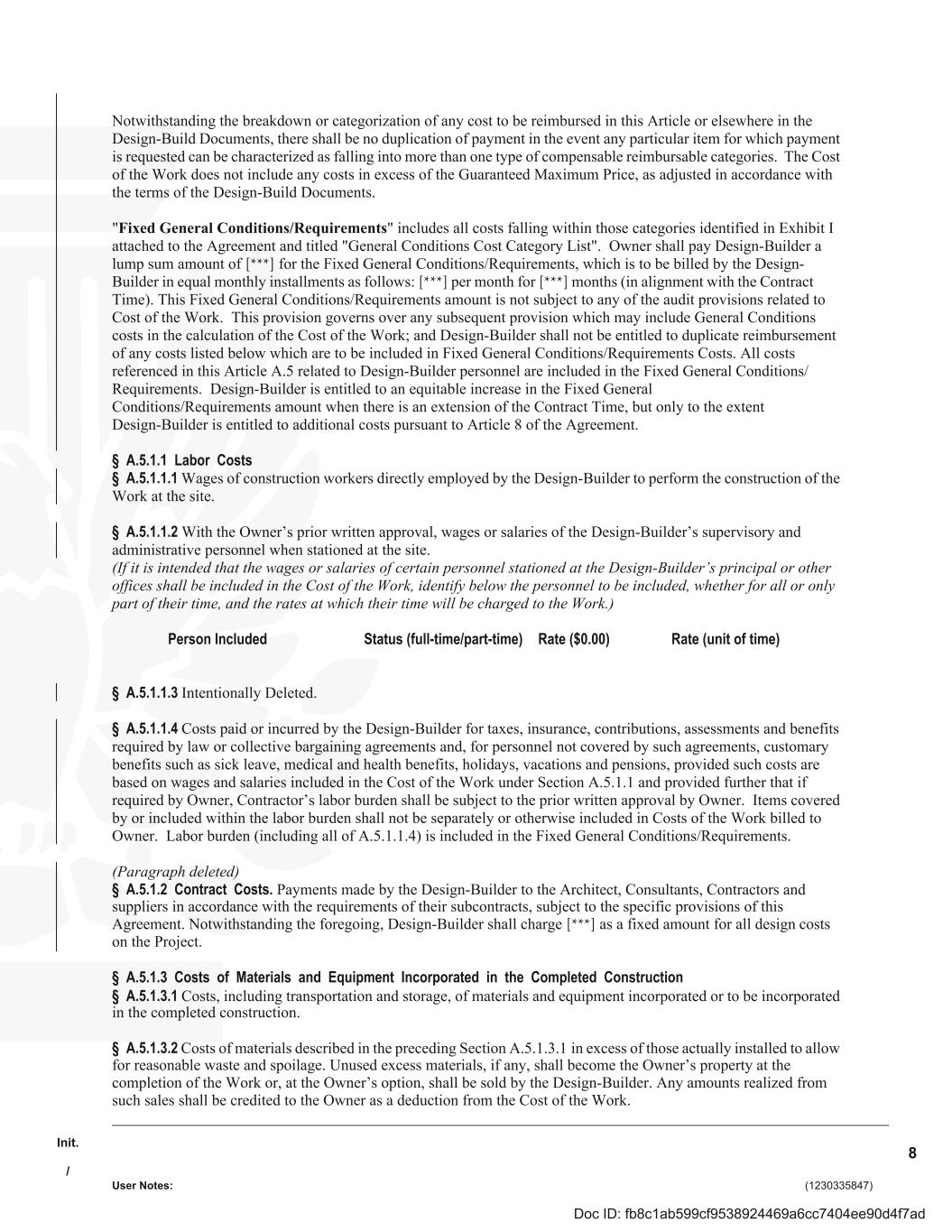
Init. / User Notes: (1230335847) 8 Notwithstanding the breakdown or categorization of any cost to be reimbursed in this Article or elsewhere in the Design-Build Documents, there shall be no duplication of payment in the event any particular item for which payment is requested can be characterized as falling into more than one type of compensable reimbursable categories. The Cost of the Work does not include any costs in excess of the Guaranteed Maximum Price, as adjusted in accordance with the terms of the Design-Build Documents. "Fixed General Conditions/Requirements" includes all costs falling within those categories identified in Exhibit I attached to the Agreement and titled "General Conditions Cost Category List". Owner shall pay Design-Builder a lump sum amount of [***] for the Fixed General Conditions/Requirements, which is to be billed by the Design- Builder in equal monthly installments as follows: [***] per month for [***] months (in alignment with the Contract Time). This Fixed General Conditions/Requirements amount is not subject to any of the audit provisions related to Cost of the Work. This provision governs over any subsequent provision which may include General Conditions costs in the calculation of the Cost of the Work; and Design-Builder shall not be entitled to duplicate reimbursement of any costs listed below which are to be included in Fixed General Conditions/Requirements Costs. All costs referenced in this Article A.5 related to Design-Builder personnel are included in the Fixed General Conditions/ Requirements. Design-Builder is entitled to an equitable increase in the Fixed General Conditions/Requirements amount when there is an extension of the Contract Time, but only to the extent Design-Builder is entitled to additional costs pursuant to Article 8 of the Agreement. § A.5.1.1 Labor Costs § A.5.1.1.1 Wages of construction workers directly employed by the Design-Builder to perform the construction of the Work at the site. § A.5.1.1.2 With the Owner’s prior written approval, wages or salaries of the Design-Builder’s supervisory and administrative personnel when stationed at the site. (If it is intended that the wages or salaries of certain personnel stationed at the Design-Builder’s principal or other offices shall be included in the Cost of the Work, identify below the personnel to be included, whether for all or only part of their time, and the rates at which their time will be charged to the Work.) Person Included Status (full-time/part-time) Rate ($0.00) Rate (unit of time) § A.5.1.1.3 Intentionally Deleted. § A.5.1.1.4 Costs paid or incurred by the Design-Builder for taxes, insurance, contributions, assessments and benefits required by law or collective bargaining agreements and, for personnel not covered by such agreements, customary benefits such as sick leave, medical and health benefits, holidays, vacations and pensions, provided such costs are based on wages and salaries included in the Cost of the Work under Section A.5.1.1 and provided further that if required by Owner, Contractor’s labor burden shall be subject to the prior written approval by Owner. Items covered by or included within the labor burden shall not be separately or otherwise included in Costs of the Work billed to Owner. Labor burden (including all of A.5.1.1.4) is included in the Fixed General Conditions/Requirements. (Paragraph deleted) § A.5.1.2 Contract Costs. Payments made by the Design-Builder to the Architect, Consultants, Contractors and suppliers in accordance with the requirements of their subcontracts, subject to the specific provisions of this Agreement. Notwithstanding the foregoing, Design-Builder shall charge [***] as a fixed amount for all design costs on the Project. § A.5.1.3 Costs of Materials and Equipment Incorporated in the Completed Construction § A.5.1.3.1 Costs, including transportation and storage, of materials and equipment incorporated or to be incorporated in the completed construction. § A.5.1.3.2 Costs of materials described in the preceding Section A.5.1.3.1 in excess of those actually installed to allow for reasonable waste and spoilage. Unused excess materials, if any, shall become the Owner’s property at the completion of the Work or, at the Owner’s option, shall be sold by the Design-Builder. Any amounts realized from such sales shall be credited to the Owner as a deduction from the Cost of the Work. Doc ID: fb8c1ab599cf9538924469a6cc7404ee90d4f7ad
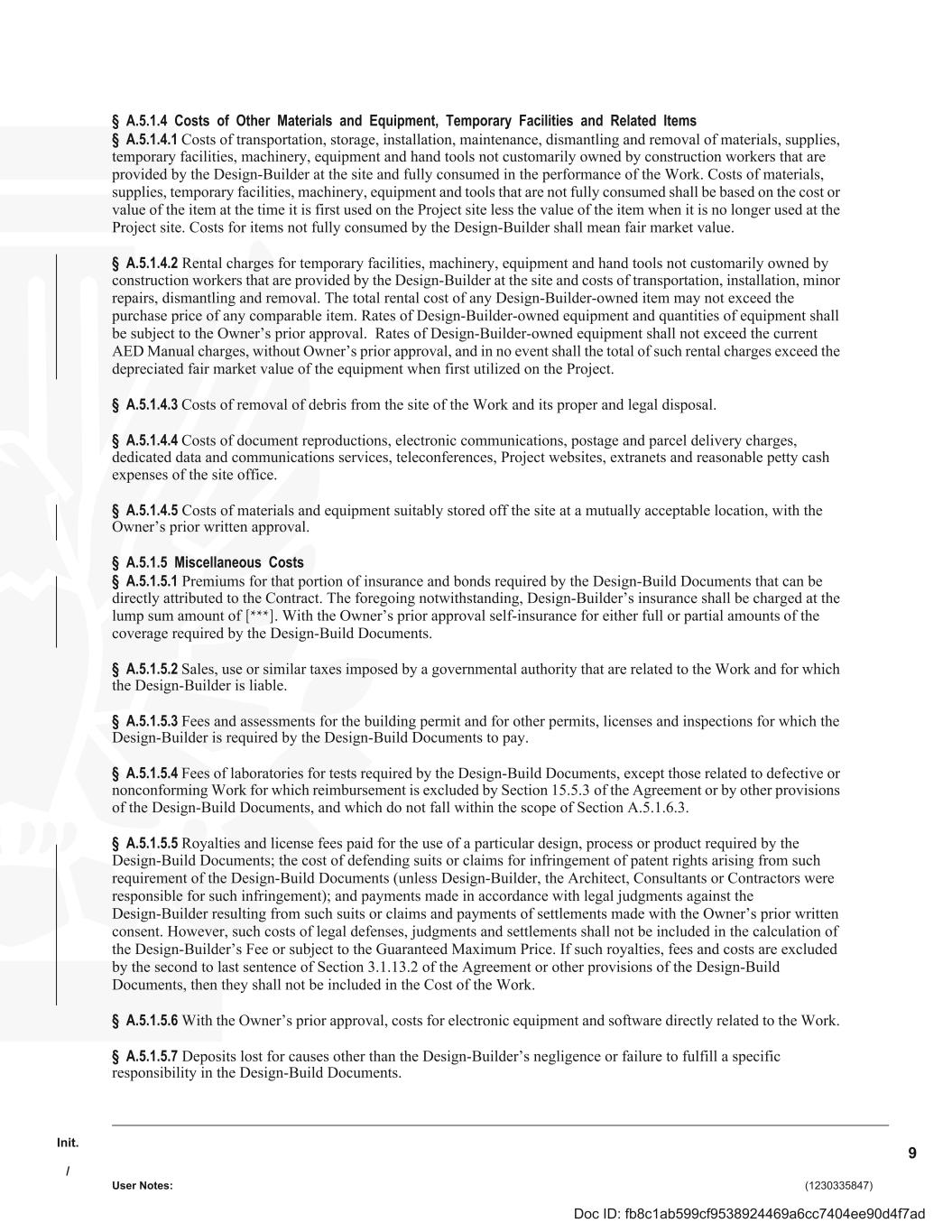
Init. / User Notes: (1230335847) 9 § A.5.1.4 Costs of Other Materials and Equipment, Temporary Facilities and Related Items § A.5.1.4.1 Costs of transportation, storage, installation, maintenance, dismantling and removal of materials, supplies, temporary facilities, machinery, equipment and hand tools not customarily owned by construction workers that are provided by the Design-Builder at the site and fully consumed in the performance of the Work. Costs of materials, supplies, temporary facilities, machinery, equipment and tools that are not fully consumed shall be based on the cost or value of the item at the time it is first used on the Project site less the value of the item when it is no longer used at the Project site. Costs for items not fully consumed by the Design-Builder shall mean fair market value. § A.5.1.4.2 Rental charges for temporary facilities, machinery, equipment and hand tools not customarily owned by construction workers that are provided by the Design-Builder at the site and costs of transportation, installation, minor repairs, dismantling and removal. The total rental cost of any Design-Builder-owned item may not exceed the purchase price of any comparable item. Rates of Design-Builder-owned equipment and quantities of equipment shall be subject to the Owner’s prior approval. Rates of Design-Builder-owned equipment shall not exceed the current AED Manual charges, without Owner’s prior approval, and in no event shall the total of such rental charges exceed the depreciated fair market value of the equipment when first utilized on the Project. § A.5.1.4.3 Costs of removal of debris from the site of the Work and its proper and legal disposal. § A.5.1.4.4 Costs of document reproductions, electronic communications, postage and parcel delivery charges, dedicated data and communications services, teleconferences, Project websites, extranets and reasonable petty cash expenses of the site office. § A.5.1.4.5 Costs of materials and equipment suitably stored off the site at a mutually acceptable location, with the Owner’s prior written approval. § A.5.1.5 Miscellaneous Costs § A.5.1.5.1 Premiums for that portion of insurance and bonds required by the Design-Build Documents that can be directly attributed to the Contract. The foregoing notwithstanding, Design-Builder’s insurance shall be charged at the lump sum amount of [***]. With the Owner’s prior approval self-insurance for either full or partial amounts of the coverage required by the Design-Build Documents. § A.5.1.5.2 Sales, use or similar taxes imposed by a governmental authority that are related to the Work and for which the Design-Builder is liable. § A.5.1.5.3 Fees and assessments for the building permit and for other permits, licenses and inspections for which the Design-Builder is required by the Design-Build Documents to pay. § A.5.1.5.4 Fees of laboratories for tests required by the Design-Build Documents, except those related to defective or nonconforming Work for which reimbursement is excluded by Section 15.5.3 of the Agreement or by other provisions of the Design-Build Documents, and which do not fall within the scope of Section A.5.1.6.3. § A.5.1.5.5 Royalties and license fees paid for the use of a particular design, process or product required by the Design-Build Documents; the cost of defending suits or claims for infringement of patent rights arising from such requirement of the Design-Build Documents (unless Design-Builder, the Architect, Consultants or Contractors were responsible for such infringement); and payments made in accordance with legal judgments against the Design-Builder resulting from such suits or claims and payments of settlements made with the Owner’s prior written consent. However, such costs of legal defenses, judgments and settlements shall not be included in the calculation of the Design-Builder’s Fee or subject to the Guaranteed Maximum Price. If such royalties, fees and costs are excluded by the second to last sentence of Section 3.1.13.2 of the Agreement or other provisions of the Design-Build Documents, then they shall not be included in the Cost of the Work. § A.5.1.5.6 With the Owner’s prior approval, costs for electronic equipment and software directly related to the Work. § A.5.1.5.7 Deposits lost for causes other than the Design-Builder’s negligence or failure to fulfill a specific responsibility in the Design-Build Documents. Doc ID: fb8c1ab599cf9538924469a6cc7404ee90d4f7ad
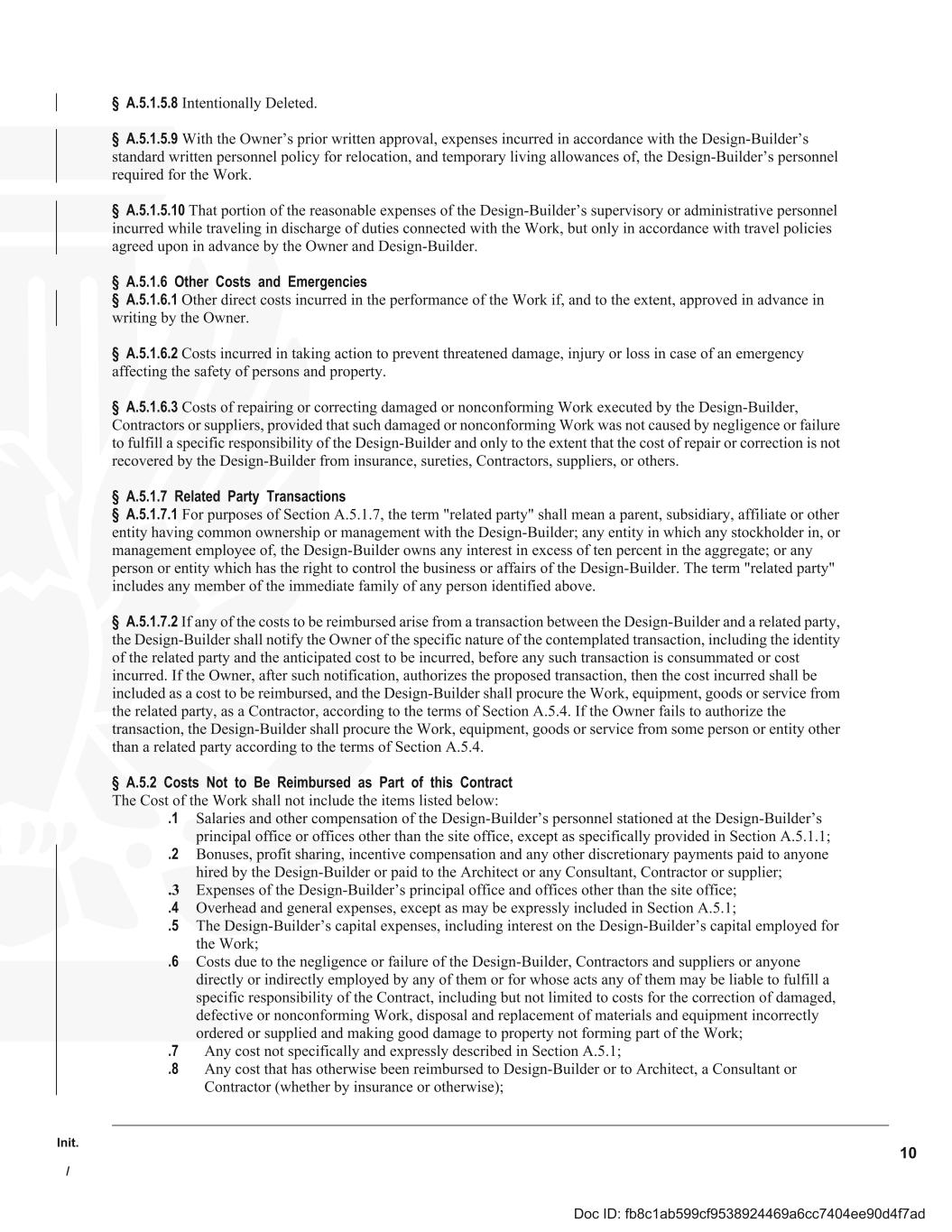
Init. / 10 § A.5.1.5.8 Intentionally Deleted. § A.5.1.5.9 With the Owner’s prior written approval, expenses incurred in accordance with the Design-Builder’s standard written personnel policy for relocation, and temporary living allowances of, the Design-Builder’s personnel required for the Work. § A.5.1.5.10 That portion of the reasonable expenses of the Design-Builder’s supervisory or administrative personnel incurred while traveling in discharge of duties connected with the Work, but only in accordance with travel policies agreed upon in advance by the Owner and Design-Builder. § A.5.1.6 Other Costs and Emergencies § A.5.1.6.1 Other direct costs incurred in the performance of the Work if, and to the extent, approved in advance in writing by the Owner. § A.5.1.6.2 Costs incurred in taking action to prevent threatened damage, injury or loss in case of an emergency affecting the safety of persons and property. § A.5.1.6.3 Costs of repairing or correcting damaged or nonconforming Work executed by the Design-Builder, Contractors or suppliers, provided that such damaged or nonconforming Work was not caused by negligence or failure to fulfill a specific responsibility of the Design-Builder and only to the extent that the cost of repair or correction is not recovered by the Design-Builder from insurance, sureties, Contractors, suppliers, or others. § A.5.1.7 Related Party Transactions § A.5.1.7.1 For purposes of Section A.5.1.7, the term "related party" shall mean a parent, subsidiary, affiliate or other entity having common ownership or management with the Design-Builder; any entity in which any stockholder in, or management employee of, the Design-Builder owns any interest in excess of ten percent in the aggregate; or any person or entity which has the right to control the business or affairs of the Design-Builder. The term "related party" includes any member of the immediate family of any person identified above. § A.5.1.7.2 If any of the costs to be reimbursed arise from a transaction between the Design-Builder and a related party, the Design-Builder shall notify the Owner of the specific nature of the contemplated transaction, including the identity of the related party and the anticipated cost to be incurred, before any such transaction is consummated or cost incurred. If the Owner, after such notification, authorizes the proposed transaction, then the cost incurred shall be included as a cost to be reimbursed, and the Design-Builder shall procure the Work, equipment, goods or service from the related party, as a Contractor, according to the terms of Section A.5.4. If the Owner fails to authorize the transaction, the Design-Builder shall procure the Work, equipment, goods or service from some person or entity other than a related party according to the terms of Section A.5.4. § A.5.2 Costs Not to Be Reimbursed as Part of this Contract The Cost of the Work shall not include the items listed below: .1 Salaries and other compensation of the Design-Builder’s personnel stationed at the Design-Builder’s principal office or offices other than the site office, except as specifically provided in Section A.5.1.1; .2 Bonuses, profit sharing, incentive compensation and any other discretionary payments paid to anyone hired by the Design-Builder or paid to the Architect or any Consultant, Contractor or supplier; .3 Expenses of the Design-Builder’s principal office and offices other than the site office; .4 Overhead and general expenses, except as may be expressly included in Section A.5.1; .5 The Design-Builder’s capital expenses, including interest on the Design-Builder’s capital employed for the Work; .6 Costs due to the negligence or failure of the Design-Builder, Contractors and suppliers or anyone directly or indirectly employed by any of them or for whose acts any of them may be liable to fulfill a specific responsibility of the Contract, including but not limited to costs for the correction of damaged, defective or nonconforming Work, disposal and replacement of materials and equipment incorrectly ordered or supplied and making good damage to property not forming part of the Work; .7 Any cost not specifically and expressly described in Section A.5.1; .8 Any cost that has otherwise been reimbursed to Design-Builder or to Architect, a Consultant or Contractor (whether by insurance or otherwise); Doc ID: fb8c1ab599cf9538924469a6cc7404ee90d4f7ad
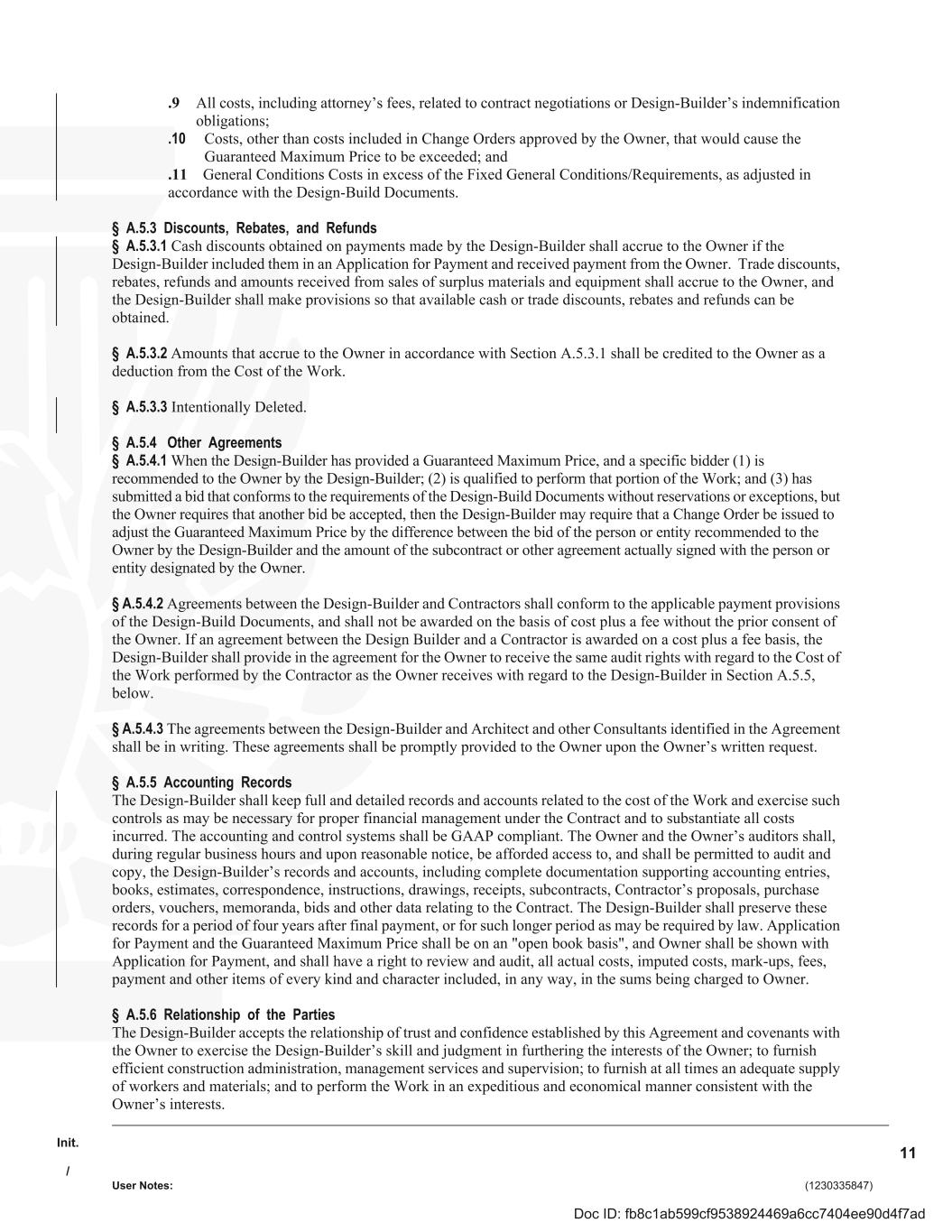
Init. / User Notes: (1230335847) 11 .9 All costs, including attorney’s fees, related to contract negotiations or Design-Builder’s indemnification obligations; .10 Costs, other than costs included in Change Orders approved by the Owner, that would cause the Guaranteed Maximum Price to be exceeded; and .11 General Conditions Costs in excess of the Fixed General Conditions/Requirements, as adjusted in accordance with the Design-Build Documents. § A.5.3 Discounts, Rebates, and Refunds § A.5.3.1 Cash discounts obtained on payments made by the Design-Builder shall accrue to the Owner if the Design-Builder included them in an Application for Payment and received payment from the Owner. Trade discounts, rebates, refunds and amounts received from sales of surplus materials and equipment shall accrue to the Owner, and the Design-Builder shall make provisions so that available cash or trade discounts, rebates and refunds can be obtained. § A.5.3.2 Amounts that accrue to the Owner in accordance with Section A.5.3.1 shall be credited to the Owner as a deduction from the Cost of the Work. § A.5.3.3 Intentionally Deleted. § A.5.4 Other Agreements § A.5.4.1 When the Design-Builder has provided a Guaranteed Maximum Price, and a specific bidder (1) is recommended to the Owner by the Design-Builder; (2) is qualified to perform that portion of the Work; and (3) has submitted a bid that conforms to the requirements of the Design-Build Documents without reservations or exceptions, but the Owner requires that another bid be accepted, then the Design-Builder may require that a Change Order be issued to adjust the Guaranteed Maximum Price by the difference between the bid of the person or entity recommended to the Owner by the Design-Builder and the amount of the subcontract or other agreement actually signed with the person or entity designated by the Owner. § A.5.4.2 Agreements between the Design-Builder and Contractors shall conform to the applicable payment provisions of the Design-Build Documents, and shall not be awarded on the basis of cost plus a fee without the prior consent of the Owner. If an agreement between the Design Builder and a Contractor is awarded on a cost plus a fee basis, the Design-Builder shall provide in the agreement for the Owner to receive the same audit rights with regard to the Cost of the Work performed by the Contractor as the Owner receives with regard to the Design-Builder in Section A.5.5, below. § A.5.4.3 The agreements between the Design-Builder and Architect and other Consultants identified in the Agreement shall be in writing. These agreements shall be promptly provided to the Owner upon the Owner’s written request. § A.5.5 Accounting Records The Design-Builder shall keep full and detailed records and accounts related to the cost of the Work and exercise such controls as may be necessary for proper financial management under the Contract and to substantiate all costs incurred. The accounting and control systems shall be GAAP compliant. The Owner and the Owner’s auditors shall, during regular business hours and upon reasonable notice, be afforded access to, and shall be permitted to audit and copy, the Design-Builder’s records and accounts, including complete documentation supporting accounting entries, books, estimates, correspondence, instructions, drawings, receipts, subcontracts, Contractor’s proposals, purchase orders, vouchers, memoranda, bids and other data relating to the Contract. The Design-Builder shall preserve these records for a period of four years after final payment, or for such longer period as may be required by law. Application for Payment and the Guaranteed Maximum Price shall be on an "open book basis", and Owner shall be shown with Application for Payment, and shall have a right to review and audit, all actual costs, imputed costs, mark-ups, fees, payment and other items of every kind and character included, in any way, in the sums being charged to Owner. § A.5.6 Relationship of the Parties The Design-Builder accepts the relationship of trust and confidence established by this Agreement and covenants with the Owner to exercise the Design-Builder’s skill and judgment in furthering the interests of the Owner; to furnish efficient construction administration, management services and supervision; to furnish at all times an adequate supply of workers and materials; and to perform the Work in an expeditious and economical manner consistent with the Owner’s interests. Doc ID: fb8c1ab599cf9538924469a6cc7404ee90d4f7ad
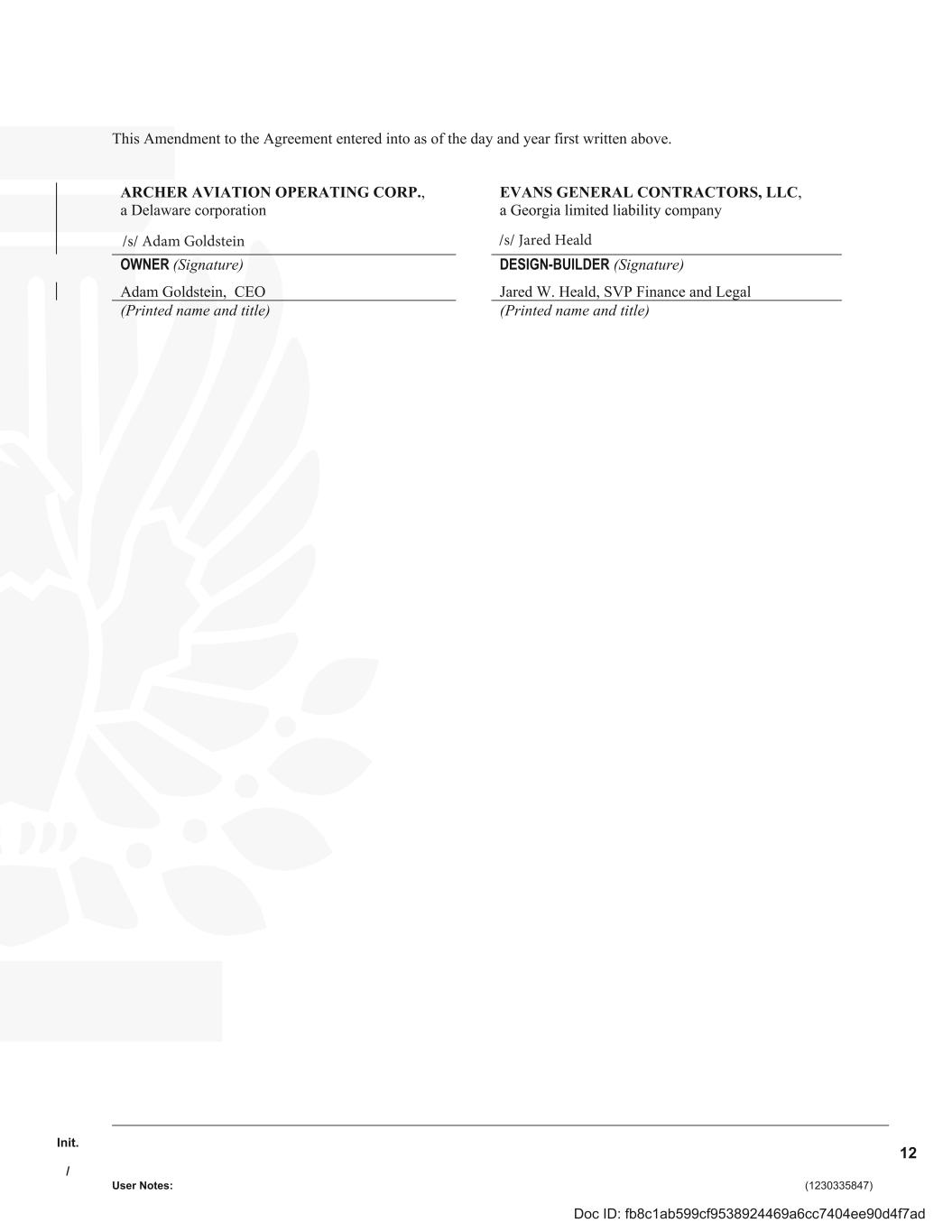
Init. / User Notes: (1230335847) 12 This Amendment to the Agreement entered into as of the day and year first written above. ARCHER AVIATION OPERATING CORP., a Delaware corporation EVANS GENERAL CONTRACTORS, LLC, a Georgia limited liability company OWNER (Signature) DESIGN-BUILDER (Signature) Adam Goldstein, CEO Jared W. Heald, SVP Finance and Legal (Printed name and title) (Printed name and title) Doc ID: fb8c1ab599cf9538924469a6cc7404ee90d4f7ad /s/ Adam Goldstein /s/ Jared Heald

Exhibit B Insurance and Bonds

Exhibit C Not Used

3 Exhibit D Project Site

4 Exhibit E Clarifications

5 Exhibit F

6 Exhibit G GMP Itemization

7 Exhibit H Drawing Log

8 Exhibit I Flight Ops & Production
EX-21.1
5
exhibit211-fy23.htm
EX-21.1
Document
Archer Aviation Inc.
List of Subsidiaries
|
|
|
|
|
|
| Subsidiary |
Jurisdiction |
| Archer Aviation Operating Corp. |
Delaware |
| Archer Air LLC |
Delaware |
| San Francisco Helicopters, LLC |
California |
| Archer Aviation Brasil LTDA, a Brazil limited liability company |
Brazil |
|
|
|
|
|
|
|
|
|
|
|
|
|
|
EX-23.1
6
exhibit231.htm
EX-23.1
Document
CONSENT OF INDEPENDENT REGISTERED PUBLIC ACCOUNTING FIRM
We hereby consent to the incorporation by reference in the Registration Statements on Form S-3 (Nos. 333-260121, 333-273996 and 333-275465) and Form S-8 (Nos. 333-261547, 333-263544, 333-265955 and 333-270569) of Archer Aviation Inc. of our report dated February 29, 2024 relating to the financial statements and the effectiveness of internal control over financial reporting, which appears in this Form 10-K.
/s/ PricewaterhouseCoopers LLP
Irvine, California
February 29, 2024
EX-31.1
7
exhibit311-fy23.htm
EX-31.1
Document
CERTIFICATION OF PRINCIPAL EXECUTIVE OFFICER PURSUANT TO RULE 13a-14(a) OR 15d-14(a) OF THE SECURITIES EXCHANGE ACT OF 1934, AS ADOPTED PURSUANT TO SECTION 302 OF THE SARBANES-OXLEY ACT OF 2002
I, Adam Goldstein, certify that:
1.I have reviewed this report on Form 10-K for the year ended December 31, 2023 of Archer Aviation Inc.;
2.Based on my knowledge, this report does not contain any untrue statement of a material fact or omit to state a material fact necessary to make the statements made, in light of the circumstances under which such statements were made, not misleading with respect to the period covered by this report;
3.Based on my knowledge, the financial statements, and other financial information included in this report, fairly present in all material respects the financial condition, results of operations and cash flows of the registrant as of, and for, the periods presented in this report;
4.The registrant’s other certifying officer and I are responsible for establishing and maintaining disclosure controls and procedures (as defined in Exchange Act Rules 13a-15(e) and 15d-15(e)) and internal control over financial reporting (as defined in Exchange Act Rules 13a-15(f) and 15d-15(f)) for the registrant and have:
a)Designed such disclosure controls and procedures, or caused such disclosure controls and procedures to be designed under our supervision, to ensure that material information relating to the registrant, including its consolidated subsidiaries, is made known to us by others within those entities, particularly during the period in which this report is being prepared;
b)Designed such internal control over financial reporting, or caused such internal control over financial reporting to be designed under our supervision, to provide reasonable assurance regarding the reliability of financial reporting and the preparation of financial statements for external purposes in accordance with generally accepted accounting principles;
c)Evaluated the effectiveness of the registrant’s disclosure controls and procedures and presented in this report our conclusions about the effectiveness of the disclosure controls and procedures, as of the end of the period covered by this report based on such evaluation; and
d)Disclosed in this report any change in the registrant’s internal control over financial reporting that occurred during the registrant’s most recent fiscal quarter (the registrant’s fourth fiscal quarter in the case of an annual report) that has materially affected, or is reasonably likely to materially affect, the registrant’s internal control over financial reporting; and
5.The registrant’s other certifying officer and I have disclosed, based on our most recent evaluation of internal control over financial reporting, to the registrant’s auditors and the audit committee of the registrant’s board of directors (or persons performing the equivalent functions):
a)All significant deficiencies and material weaknesses in the design or operation of internal control over financial reporting which are reasonably likely to adversely affect the registrant’s ability to record, process, summarize and report financial information; and
b)Any fraud, whether or not material, that involves management or other employees who have a significant role in the registrant’s internal control over financial reporting.
Date: February 29, 2024
|
|
|
|
| /s/ Adam Goldstein |
| Adam Goldstein |
| Chief Executive Officer |
| (Principal Executive Officer) |
EX-31.2
8
exhibit312-fy23.htm
EX-31.2
Document
CERTIFICATION OF PRINCIPAL FINANCIAL OFFICER PURSUANT TO RULE 13a-14(a) OR 15d-14(a) OF THE SECURITIES EXCHANGE ACT OF 1934, AS ADOPTED PURSUANT TO SECTION 302 OF THE SARBANES-OXLEY ACT OF 2002
I, Mark Mesler, certify that:
1.I have reviewed this report on Form 10-K for the year ended December 31, 2023 of Archer Aviation Inc.;
2.Based on my knowledge, this report does not contain any untrue statement of a material fact or omit to state a material fact necessary to make the statements made, in light of the circumstances under which such statements were made, not misleading with respect to the period covered by this report;
3.Based on my knowledge, the financial statements, and other financial information included in this report, fairly present in all material respects the financial condition, results of operations and cash flows of the registrant as of, and for, the periods presented in this report;
4.The registrant’s other certifying officer and I are responsible for establishing and maintaining disclosure controls and procedures (as defined in Exchange Act Rules 13a-15(e) and 15d-15(e)) and internal control over financial reporting (as defined in Exchange Act Rules 13a-15(f) and 15d-15(f)) for the registrant and have:
a)Designed such disclosure controls and procedures, or caused such disclosure controls and procedures to be designed under our supervision, to ensure that material information relating to the registrant, including its consolidated subsidiaries, is made known to us by others within those entities, particularly during the period in which this report is being prepared;
b)Designed such internal control over financial reporting, or caused such internal control over financial reporting to be designed under our supervision, to provide reasonable assurance regarding the reliability of financial reporting and the preparation of financial statements for external purposes in accordance with generally accepted accounting principles;
c)Evaluated the effectiveness of the registrant’s disclosure controls and procedures and presented in this report our conclusions about the effectiveness of the disclosure controls and procedures, as of the end of the period covered by this report based on such evaluation; and
d)Disclosed in this report any change in the registrant’s internal control over financial reporting that occurred during the registrant’s most recent fiscal quarter (the registrant’s fourth fiscal quarter in the case of an annual report) that has materially affected, or is reasonably likely to materially affect, the registrant’s internal control over financial reporting; and
5.The registrant’s other certifying officer and I have disclosed, based on our most recent evaluation of internal control over financial reporting, to the registrant’s auditors and the audit committee of the registrant’s board of directors (or persons performing the equivalent functions):
a)All significant deficiencies and material weaknesses in the design or operation of internal control over financial reporting which are reasonably likely to adversely affect the registrant’s ability to record, process, summarize and report financial information; and
b)Any fraud, whether or not material, that involves management or other employees who have a significant role in the registrant’s internal control over financial reporting.
Date: February 29, 2024
|
|
|
|
| /s/ Mark Mesler |
| Mark Mesler |
Chief Financial Officer |
| (Principal Financial Officer) |
EX-32.1
9
exhibit321-fy23.htm
EX-32.1
Document
CERTIFICATION OF PRINCIPAL EXECUTIVE OFFICER PURSUANT TO 18 U.S.C. SECTION 1350, AS ADOPTED PURSUANT TO SECTION 906 OF THE SARBANES-OXLEY ACT OF 2002
In connection with the Annual Report of Archer Aviation Inc. (the “Company”) on Form 10-K for the year ended December 31, 2023, as filed with the Securities and Exchange Commission on the date hereof (the “Report”), I certify, pursuant to Rule 13a-14(b) of the Securities Exchange Act of 1934, as amended (the “Exchange Act”), and 18 U.S.C. Section 1350, as adopted pursuant to Section 906 of the Sarbanes-Oxley Act of 2002, that, to the best of my knowledge:
1.the Report fully complies with the requirements of Section 13(a) or 15(d) of the Securities Exchange Act of 1934; and
2.the information contained in the Report fairly presents, in all material respects, the financial condition and results of operations of the Company.
Date: February 29, 2024
|
|
|
|
| /s/ Adam Goldstein |
| Adam Goldstein |
Chief Executive Officer |
| (Principal Executive Officer) |
This certification accompanies the Report to which it relates, is not deemed filed with the Securities and Exchange Commission and is not to be incorporated by reference into any filing of the Company under the Securities Act of 1933, as amended, or the Exchange Act (whether made before or after the date of the Report), irrespective of any general incorporation language contained in such filing.
EX-32.2
10
exhibit322-fy23.htm
EX-32.2
Document
CERTIFICATION OF PRINCIPAL FINANCIAL OFFICER PURSUANT TO 18 U.S.C. SECTION 1350, AS ADOPTED PURSUANT TO SECTION 906 OF THE SARBANES-OXLEY ACT OF 2002
In connection with the Annual Report of Archer Aviation Inc. (the “Company”) on Form 10-K for the year ended December 31, 2023, as filed with the Securities and Exchange Commission on the date hereof (the “Report”), I certify, pursuant to Rule 13a-14(b) of the Securities Exchange Act of 1934, as amended (the “Exchange Act”), and 18 U.S.C. Section 1350, as adopted pursuant to Section 906 of the Sarbanes-Oxley Act of 2002, that, to the best of my knowledge:
1.the Report fully complies with the requirements of Section 13(a) or 15(d) of the Securities Exchange Act of 1934; and
2.the information contained in the Report fairly presents, in all material respects, the financial condition and results of operations of the Company.
Date: February 29, 2024
|
|
|
|
| /s/ Mark Mesler |
| Mark Mesler |
| Chief Financial Officer |
| (Principal Financial Officer) |
This certification accompanies the Report to which it relates, is not deemed filed with the Securities and Exchange Commission and is not to be incorporated by reference into any filing of the Company under the Securities Act of 1933, as amended, or the Exchange Act (whether made before or after the date of the Report), irrespective of any general incorporation language contained in such filing.
EX-97.1
11
ex971.htm
EX-97.1
Document
Archer Aviation Inc.
Compensation Recovery Policy
(Adopted November 1, 2023)
The Board has determined that it is in the best interests of the Company and its stockholders to adopt this Policy enabling the Company to recover from specified current and former Company executives certain incentive-based compensation in the event of an accounting restatement resulting from material noncompliance with any financial reporting requirements under the federal securities laws. Capitalized terms are defined in Section 14.
This Policy is designed to comply with Rule 10D-1 of the Exchange Act and shall become effective on the Effective Date and shall apply to Incentive-Based Compensation Received by Covered Persons on or after the Listing Rule Effective Date.
1.Administration
This Policy shall be administered by the Administrator. The Administrator is authorized to interpret and construe this Policy and to make all determinations necessary, appropriate, or advisable for the administration of this Policy. The Administrator may retain, at the Company’s expense, outside legal counsel and such compensation, tax or other consultants as it may determine are advisable for the purposes of administering this Policy.
2.Covered Persons and Applicable Compensation
This Policy applies to any Incentive-Based Compensation Received by a person (a) after beginning service as a Covered Person; (b) who served as a Covered Person at any time during the performance period for that Incentive-Based Compensation; and (c) was a Covered Person during the Clawback Period.
However, recovery is not required with respect to:
i.Incentive-Based Compensation Received prior to an individual becoming a Covered Person, even if the individual served as a Covered Person during the Clawback Period.
ii.Incentive-Based Compensation Received prior to the Listing Rule Effective Date.
iii.Incentive-Based Compensation Received prior to the Clawback Period.
iv.Incentive-Based Compensation Received while the Company did not have a class of listed securities on a national securities exchange or a national securities association, including the Exchange.
The Administrator will not consider the Covered Person’s responsibility or fault or lack thereof in enforcing this Policy with respect to recoupment under the Final Rules.
3.Triggering Event
Subject to and in accordance with the provisions of this Policy, if there is a Triggering Event, the Administrator shall require a Covered Person to reimburse or forfeit to the Company the Recoupment Amount applicable to such Covered Person. A Company’s obligation to recover the Recoupment Amount is not dependent on if or when the restated financial statements are filed.
If the Administrator determines that the Covered Person engaged in any fraud or intentional misconduct that materially contributes to or causes economic loss to the Company, this may be independently considered a Triggering Event, as determined by the Administrator in its sole discretion. In such case, the Company will use reasonable efforts to recover from such Covered Person up to 100% (as determined by the Administrator in its sole discretion to be appropriate based on the conduct involved) of the Incentive-Based Compensation, not just the Recoupment Amount.
4.Calculation of Recoupment Amount
The Recoupment Amount will be calculated in accordance with the Final Rules, as provided in the Calculation Guidelines attached hereto as Exhibit B.
5.Method of Recoupment
Subject to compliance with the Final Rules and applicable law, the Administrator will determine, in its sole discretion, the method for recouping the Recoupment Amount hereunder which may include, without limitation:
i.Requiring reimbursement or forfeiture of the pre-tax amount of cash Incentive-Based Compensation previously paid;
ii.Offsetting the Recoupment Amount from any compensation otherwise owed by the Company to the Covered Person, including without limitation, any prior cash incentive payments, executive retirement benefits, wages, equity grants or other amounts payable by the Company to the Covered Person in the future;
iii.Seeking recovery of any gain realized on the vesting, exercise, settlement, cash sale, transfer, or other disposition of any equity-based awards; and/or
iv.Taking any other remedial and recovery action permitted by law, as determined by the Administrator.
6.Arbitration
To the fullest extent permitted by law, any disputes under this Policy shall be submitted to mandatory binding arbitration (the “Arbitrable Claims”), governed by the Federal Arbitration Act (the “FAA”). Further, to the fullest extent permitted by law, no class or collective actions can be asserted in arbitration or otherwise. All claims, whether in arbitration or otherwise, must be brought solely in the Covered Person’s individual capacity, and not as a plaintiff or class member in any purported class or collective proceeding.
SUBJECT TO THE ABOVE PROVISO, ANY RIGHTS THAT A COVERED PERSON MAY HAVE TO TRIAL BY JURY IN REGARD TO ARBITRABLE CLAIMS ARE WAIVED. ANY RIGHTS THAT A COVERED PERSON MAY HAVE TO PURSUE OR PARTICIPATE IN A CLASS OR COLLECTIVE ACTION PERTAINING TO ANY CLAIMS BETWEEN A COVERED PERSON AND THE COMPANY ARE WAIVED.
The Covered Person is not restricted from filing administrative claims that may be brought before any government agency where, as a matter of law, the Covered Person’s ability to file such claims may not be restricted.
However, to the fullest extent permitted by law, arbitration shall be the exclusive remedy for the subject matter of such administrative claims. The arbitration shall be conducted in San Jose, California through JAMS before a single neutral arbitrator, in accordance with the JAMS Comprehensive Arbitration Rules and Procedures then in effect, provided however, that the FAA, including its procedural provisions for compelling arbitration, shall govern and apply to this Arbitration provision. The arbitrator shall issue a written decision that contains the essential findings and conclusions on which the decision is based. If, for any reason, any term of this Arbitration provision is held to be invalid or unenforceable, all other valid terms and conditions herein shall be severable in nature and remain fully enforceable.
7.Recovery Process; Impracticability
Actions by the Administrator to recover the Recoupment Amount will be reasonably prompt.
The Administrator must cause the Company to recover the Recoupment Amount unless the Administrator shall have previously determined that recovery is impracticable and one of the following conditions is met:
i.The direct expense paid to a third party to assist in enforcing this Policy would exceed the amount to be recovered; before concluding that it would be impracticable to recover any amount of erroneously awarded Incentive-Based Compensation based on expense of enforcement, the Company must make a reasonable attempt to recover such erroneously awarded Incentive-Based Compensation, document such reasonable attempt(s) to recover, and provide that documentation to the Exchange;
ii.Recovery would violate home country law where that law was adopted prior to November 28, 2022; before concluding that it would be impracticable to recover any amount of erroneously awarded Incentive-Based Compensation based on violation of home country law, the Company must obtain an opinion of home country counsel, acceptable to the Exchange, that recovery would result in such a violation, and must provide such opinion to the Exchange; or
iii.Recovery would likely cause an otherwise tax-qualified retirement plan, under which benefits are broadly available to employees of the Company, to fail to meet the requirements of 26 U.S.C. 401(a)(13) or 26 U.S.C. 411(a) and regulations thereunder.
8.Non-Exclusivity
The Administrator intends that this Policy will be applied to the fullest extent of the law. Without limitation to any broader or alternate clawback authorized in any written document with a Covered Person, (i) the Administrator may require that any employment agreement, equity award agreement, or similar agreement entered into on or after the Effective Date shall, as a condition to the grant of any benefit thereunder, require a Covered Person to agree to abide by the terms of this Policy, and (ii) this Policy will nonetheless apply to Incentive-Based Compensation as required by the Final Rules, whether or not specifically referenced in those arrangements. Any right of recoupment under this Policy is in addition to, and not in lieu of, any other remedies or rights of recoupment that may be available to the Company pursuant to the terms of any other clawback policy of the Company as then in effect, or any similar policy in any employment agreement, equity award agreement, or similar agreement and any other legal remedies or regulations available or applicable to the Company (including SOX 304). If recovery is required under both SOX 304 and this Policy, any amounts recovered pursuant to SOX 304 may, in the Administrator’s discretion, be credited toward the amount recovered under this Policy, or vice versa.
9.No Indemnification
The Company shall not indemnify any Covered Persons against (i) the loss of erroneously awarded Incentive-Based Compensation or any adverse tax consequences associated with any incorrectly awarded Incentive-Based Compensation or any recoupment hereunder, or (ii) any claims relating to the Company enforcement of its rights under this Policy. For the avoidance of doubt, this prohibition on indemnification will also prohibit the Company from reimbursing or paying any premium or payment of any third-party insurance policy to fund potential recovery obligations obtained by the Covered Person directly. No Covered Person will seek or retain any such prohibited indemnification or reimbursement.
Further, the Company shall not enter into any agreement that exempts any Incentive-Based Compensation from the application of this Policy or that waives the Company’s right to recovery of any erroneously awarded Incentive-Based Compensation and this Policy shall supersede any such agreement (whether entered into before, on or after the Effective Date).
10.Covered Person Acknowledgement and Agreement
All Covered Persons subject to this Policy must acknowledge their understanding of, and agreement to comply with, the Policy by executing the certification attached hereto as Exhibit A. Notwithstanding the foregoing, this Policy will apply to Covered Persons whether or not they execute such certification.
11.Successors
This Policy shall be binding and enforceable against all Covered Persons and their beneficiaries, heirs, executors, administrators or other legal representatives and shall inure to the benefit of any successor to the Company.
12.Interpretation of Policy
To the extent there is any ambiguity between this Policy and the Final Rules, this Policy shall be interpreted so that it complies with the Final Rules. If any provision of this Policy, or the application of such provision to any Covered Person or circumstance, shall be held invalid, the remainder of this Policy, or the application of such provision to Covered Persons or circumstances other than those as to which it is held invalid, shall not be affected thereby.
In the event any provision of this Policy is inconsistent with any requirement of any Final Rules, the Administrator, in its sole discretion, shall amend and administer this Policy and bring it into compliance with such rules.
Any determination under this Policy by the Administrator shall be conclusive and binding on the applicable Covered Person. Determinations of the Administrator need not be uniform with respect to Covered Persons or from one payment or grant to another.
13.Amendments; Termination
The Administrator may make any amendments to this Policy as required under applicable law, rules and regulations, or as otherwise determined by the Administrator in its sole discretion.
The Administrator may terminate this Policy at any time.
14.Definitions
“Administrator” means the Compensation Committee of the Board, or in the absence of a committee of independent directors responsible for executive compensation decisions, a majority of the independent directors serving on the Board.
“Board” means the Board of Directors of the Company.
“Clawback Measurement Date” is the earlier to occur of:
i.The date the Board, a committee of the Board, or the officer or officers of the Company authorized to take such action if Board action is not required, concludes, or reasonably should have concluded, that the Company is required to prepare an accounting restatement as described in this Policy; or
ii.The date a court, regulator, or other legally authorized body directs the Company to prepare an accounting restatement as described in this Policy.
“Clawback Period” means the three (3) completed fiscal years immediately prior to the Clawback Measurement Date and any transition period between the last day of the Company’s previous fiscal year end and the first day of its new fiscal year (that results from a change in the Company’s fiscal year) within or immediately following such three (3)-year period; provided that any transition period between the last day of the Company’s previous fiscal year end and the first day of its new fiscal year that comprises a period of 9 to 12 months will be deemed a completed fiscal year.
“Company” means Archer Aviation Inc., a Delaware corporation, or any successor corporation.
“Covered Person” means any Executive Officer (as defined in the Final Rules), including, but not limited to, those persons who are or have been determined to be “officers” of the Company within the meaning of Section 16 of Rule 16a-1(f) of the rules promulgated under the Exchange Act, and “executive officers” of the Company within the meaning of Item 401(b) of Regulation S-K, Rule 3b-7 promulgated under the Exchange Act, and Rule 405 promulgated under the Securities Act of 1933, as amended; provided that the Administrator may identify additional employees who shall be treated as Covered Persons for the purposes of this Policy with prospective effect, in accordance with the Final Rules.
“Effective Date” means November 1, 2023, the date the Policy was adopted by the Board.
“Exchange” means the New York Stock Exchange or any other national securities exchange or national securities association in the United States on which the Company has listed its securities for trading.
“Exchange Act” means the Securities Exchange Act of 1934, as amended.
“Final Rules” means the final rules promulgated by the SEC under Section 954 of the Dodd-Frank Act, Rule 10D-1 and Exchange listing standards, as may be amended from time to time.
“Financial Reporting Measure” are measures that are determined and presented in accordance with the accounting principles used in preparing the Company’s financial statements, and any measures that are derived wholly or in part from such measures. Stock price and TSR are also financial reporting measures. A financial reporting measure need not be presented within the financial statements or included in a filing with the SEC.
“Incentive-Based Compensation” means compensation that is granted, earned or vested based wholly or in part on the attainment of any Financial Reporting Measure. Examples of “Incentive-Based Compensation” include, but are not limited to: non-equity incentive plan awards that are earned based wholly or in part on satisfying a Financial Reporting Measure performance goal; bonuses paid from a “bonus pool,” the size of which is determined based wholly or in part on satisfying a Financial Reporting Measure performance goal; other cash awards based on satisfaction of a Financial Reporting Measure performance goal; restricted stock, restricted stock units, performance share units, stock options, and SARs that are granted or become vested based wholly or in part on satisfying a Financial Reporting Measure goal; and proceeds received upon the sale of shares acquired through an incentive plan that were granted or vested based wholly or in part on satisfying a Financial Reporting Measure goal. “Incentive-Based Compensation” excludes, for example, time-based awards such as stock options or restricted stock units that are granted or vest solely upon completion of a service period; awards based on non-financial strategic or operating metrics such as the consummation of a merger or achievement of non-financial business goals; service-based retention bonuses; discretionary compensation; and salary.
“Listing Rule Effective Date” means the effective date of the listing standards of the Exchange on which the Company’s securities are listed.
“Policy” means this Compensation Recovery Policy.
Incentive-Based Compensation is deemed “Received” in the Company’s fiscal period during which the relevant Financial Reporting Measure specified in the Incentive-Based Compensation award is attained, irrespective of whether the payment or grant occurs on a later date or if there are additional vesting or payment requirements, such as time-based vesting or certification or approval by the Compensation Committee or Board, that have not yet been satisfied.
“Recoupment Amount” means the amount of Incentive-Based Compensation Received by the Covered Person based on the financial statements prior to the restatement that exceeds the amount such Covered Person would have received had the Incentive-Based Compensation been determined based on the financial restatement, computed without regard to any taxes paid (i.e., gross of taxes withheld).
“SARs” means stock appreciation rights.
“SEC” means the U.S. Securities and Exchange Commission.
“SOX 304” means Section 304 of the Sarbanes-Oxley Act of 2002.
“Triggering Event” means any event in which the Company is required to prepare an accounting restatement due to the material noncompliance of the Company with any financial reporting requirement under the securities laws, including any required accounting restatement to correct an error in previously issued financial statements that is material to the previously issued financial statements, or that would result in a material misstatement if the error were corrected in the current period or left uncorrected in the current period.
“TSR” means total stockholder return.
EXHIBIT A
Certification
I certify that:
1.I have read and understand the Company’s Compensation Recovery Policy (the “Policy”). I understand that the Chief Legal Officer is available to answer any questions I have regarding the Policy.
2.I understand that the Policy applies to all of my existing and future compensation-related agreements with the Company, whether or not explicitly stated therein.
3.I agree that notwithstanding the Company’s certificate of incorporation, bylaws, and any agreement I have with the Company, including any indemnity agreement I have with the Company, I will not be entitled to, and will not seek indemnification from the Company for, any amounts recovered or recoverable by the Company in accordance with the Policy.
4.I understand and agree that in the event of a conflict between the Policy and the foregoing agreements and understandings on the one hand, and any prior, existing or future agreement, arrangement or understanding, whether oral or written, with respect to the subject matter of the Policy and this Certification, on the other hand, the terms of the Policy and this Certification shall control, and the terms of this Certification shall supersede any provision of such an agreement, arrangement or understanding to the extent of such conflict with respect to the subject matter of the Policy and this Certification; provided that, in accordance with Section 8 of the Policy, nothing herein limits any other remedies or rights of recoupment that may be available to the Company.
5.I agree to abide by the terms of the Policy, including, without limitation, by returning any erroneously awarded Incentive-Based Compensation to the Company to the extent required by, and in a manner permitted by, the Policy.
Signature:
Name:
Title:
Date:
EXHIBIT B
Calculation Guidelines
For the purposes of calculating the Recoupment Amount:
i.For cash awards not paid from bonus pools, the erroneously awarded compensation is the difference between the amount of the cash award (whether payable as a lump sum or over time) that was received and the amount that should have been received applying the restated Financial Reporting Measure.
ii.For cash awards paid from bonus pools, the erroneously awarded compensation is the pro rata portion of any deficiency that results from the aggregate bonus pool that is reduced based on applying the restated Financial Reporting Measure.
iii.For equity awards, if the shares, options, restricted stock units, or SARs are still held at the time of recovery, the erroneously awarded compensation is the number of such securities received in excess of the number that should have been received applying the restated Financial Reporting Measure (or the value of that excess number). If the options or SARs have been exercised, but the underlying shares have not been sold, the erroneously awarded compensation is the number of shares underlying the excess options or SARs (or the value thereof). If the underlying shares have been sold, the Company may recoup proceeds received from the sale of shares.
iv.For Incentive-Based Compensation based on stock price or TSR, where the amount of erroneously awarded compensation is not subject to mathematical recalculation directly from the information in an accounting restatement:
a.The amount must be based on a reasonable estimate of the effect of the accounting restatement on the stock price or TSR upon which the Incentive-Based Compensation was Received; and
b.The Company must maintain documentation of the determination of that reasonable estimate and the Company must provide such documentation to the Exchange in all cases.









































































































































































